|
|
|

|
|
2025 (vol. 25)
|
|
The peri-Alpine Paleogene Red Molasse of southeastern France - I. Esparron syncline and Esclangon area (Alpes-de-Haute-Provence)
Serge FERRY, Philippe SORREL, Philippe GRANDJEAN & Sylvain AUGIER
| HTML  | PDF
| PDF  [8,448 KB]
| DOI: 10.2110/carnets.2025.2511 [8,448 KB]
| DOI: 10.2110/carnets.2025.2511
|
|
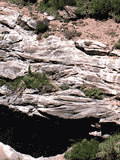 Abstract: The Paleogene succession of the Esparron syncline consists of three superimposed stratigraphic units, in ascending order: (1) a lacustrine-palustrine-dominated basal unit (BU) bearing channels filled by limestone breccias at base, (2) fluvial deposits of the lower Molasse Rouge Formation (MR1), and (3) well-rounded polygenic conglomerates, bearing Alpine "green rocks" and radiolarites overlain by red clays in the upper Molasse Rouge Formation (MR2). Abstract: The Paleogene succession of the Esparron syncline consists of three superimposed stratigraphic units, in ascending order: (1) a lacustrine-palustrine-dominated basal unit (BU) bearing channels filled by limestone breccias at base, (2) fluvial deposits of the lower Molasse Rouge Formation (MR1), and (3) well-rounded polygenic conglomerates, bearing Alpine "green rocks" and radiolarites overlain by red clays in the upper Molasse Rouge Formation (MR2).
Breccia deposits of the basal unit represent a multi-channeled torrential system generally sloping to the northeast. However, the regional extent and character of the BU is difficult to determine due to its truncation by the basal surface of MR1. Around the northwestern termination of the Esparron syncline the succession is complete and 200 m thick. Basal breccias of the BU pass upward to reddish fluvial overbank mudstones, then to grayish lacustrine-palustrine limestones, and back to reddish silty claystones. Field data suggest that this unit cannot be proximal deposits of the "Nummulitic foreland basin", but is younger, just predating deposition of the MR1, likely in the late Rupelian. These also cannot be proximal deposits of MR1, as formerly suggested. They constitute a fully distinct tectono-stratigraphic sequence whose deposition cannot be understood without a broad regional synthesis (in
preparation).
Along the southern flank of the syncline, MR1 has a sheet geometry featuring amalgamated fluvial point bar deposits at the base, which are overlain by the deposits of a large fluvial fan prograding to the west. MR1 deposits abruptly pinch out along the northern flank of the syncline, and are interpreted as having filled a paleovalley that roughly matches the E-W orientation of the
syncline.
South of the syncline, in the Esclangon and Hautes Duyes areas, the same succession is found but the meandering fluvial deposits of Esparron are lacking at the base of MR1. Here, MR1 deposits are represented by fluvial fan deposits prograding to the west, but have a more proximal character than at Esparron. In this area, the MR1unit is capped by the Molasse Grise (MG), which represents a flattening of the depositional profile after the progradation of the underlying fluvial fan.
Across the entire region, MR2 deposits are thin, and likely truncated by the main Digne thrust. They are deposited disconformably on top of either MR1 or directly on folded Mesozoic deposits, suggesting that erosion and tectonic activity occurred between deposition of MR1 and MR2. The occurrence of well-rounded pebbles of Alpine "green rocks" and radiolarites in the basal fluvial conglomerate of MR2 indicates that the system had a large watershed that encroached the inner Alps, probably during uplift of the latter.
In the Ainac area, the braided fluvial facies at the base of MR2 acquired a more distal character with channels filled by either conglomerates or a more sand-prone facies.
The vertical facies trend in MR1 and MR2 suggests that a low-gradient fluvial setting was followed by regional uplift responsible for the progradation of fluvial fans. The two stratigraphic units are therefore regarded as tectono-stratigraphic sequences, in response to changes in the Alpine stress regime. With unit 1 (BU), the Molasse Rouge is therefore composed of three independent
sequences.
Finally, the ages of the MR1 and MR2 deposits are revised, both to Chattian and probably not extending into the Aquitanian, as previously reported for the MR2.
Geometric relationships suggest that the three continental Paleogene sequences record a changing depositional setting controlled by both active tectonics and intervening periods of quiescence in a time interval grossly bracketing the late Rupelian and the
Chattian.
|
|
Carnets Geol., vol. 25, no. 11, p. 219-253
Online since October 17, 2025
|
|
Lower and lower Middle Jurassic foraminiferal assemblages and calcareous algae from the southern margin of the Central High Atlas, Morocco
Mohammed ETTAKI, Mohammed-Saïd BOUAOUDA, Michel SEPTFONTAINE, El Hassane CHELLAI, Abdallah MILHI, Radouan EL BAMIKI & Valery J. VUKS
| HTML  | PDF
| PDF  [2,781 KB]
| DOI: 10.2110/carnets.2025.2510 [2,781 KB]
| DOI: 10.2110/carnets.2025.2510
|
|
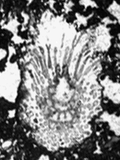 Abstract: The Lower and lower Middle Jurassic carbonates from the southern margin
of the Moroccan High Atlas yielded well-preserved foraminifers and calcareous
algae. The identification of these microfossils,
based on thin-section observations, allowed us to define seven
successive micropaleontological assemblages with ages from the early Sinemurian
to the early Bajocian. These micropaleontological assemblages, relatively well
calibrated by ammonites and brachiopods, were compared with the larger
foraminiferal biozonation of Septfontaine (1984)
for the Moroccan Tethys domain. A new biozone with Palaeodasycladus
mediterraneus is introduced to characterize the upper Pliensbachian (Algovianum
Zone) to lower Toarcian interval. Abstract: The Lower and lower Middle Jurassic carbonates from the southern margin
of the Moroccan High Atlas yielded well-preserved foraminifers and calcareous
algae. The identification of these microfossils,
based on thin-section observations, allowed us to define seven
successive micropaleontological assemblages with ages from the early Sinemurian
to the early Bajocian. These micropaleontological assemblages, relatively well
calibrated by ammonites and brachiopods, were compared with the larger
foraminiferal biozonation of Septfontaine (1984)
for the Moroccan Tethys domain. A new biozone with Palaeodasycladus
mediterraneus is introduced to characterize the upper Pliensbachian (Algovianum
Zone) to lower Toarcian interval.
|
|
Carnets Geol., vol. 25, no. 10, p. 201-217
Online since October 14, 2025
|
|
The Deshayesitidae (Ammonoidea, Ancyloceratina) in the lower Aptian (Lower Cretaceous) of the Les Ferres Aptian Basin (southeastern France)
Stéphane BERSAC & Didier BERT
| HTML  | PDF
| PDF  [2,818 KB]
| DOI: 10.2110/carnets.2025.2509 [2,818 KB]
| DOI: 10.2110/carnets.2025.2509
|
|
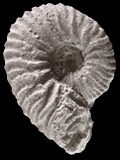 Abstract: In the present work, we study 335 specimens of Deshayesitidae (Ammonoidea) from
the vicinity of the village of Les Ferres (SE France). The Deshayesitidae is the
current key family for the ammonite biostratigraphy of the lower Aptian (Lower
Cretaceous). Despite poorly preserved, the studied material could have been
identified at species rank in most cases and allowed establishing the
biostratigraphic frame of the lower Aptian of the study area. The results are as
follows: (1) the studied samples range from the Deshayesites forbesi Zone
to the Dufrenoyia furcata Zone; (2) their ontogenetic sequence is
described; (3) their evolutionary patterns are consistent with those observed in
other samples of Deshayesitidae; (4) no dimorphism is conspicuous; (5) the
identified taxa are, from earliest to latest: Deshayesites sp. (Deshayesites
forbesi Zone, rounded ventral area probably without smooth siphonal band), Deshayesites
multicostatus Swinnerton, 1935 (index of subzone, intermediate smooth
siphonal band then rounded ventral area), Deshayesites grandis Spath, 1930 (index of subzone, longer smooth siphonal band then subtabulate ventral
area on phragmocone), Dufrenoyia furcata (J. de C. Sowerby, 1836)
(index of subzone and zone, even longer smooth siphonal band then subtabulate
ventral area, onset of rounded to claviform latero-ventral
tubercles in inner whorls) and Dufrenoyia dufrenoyi (Orbigny,
1841) (index of subzone, even more longer smooth siphonal band, latero-ventral
tubercles claviform only). Abstract: In the present work, we study 335 specimens of Deshayesitidae (Ammonoidea) from
the vicinity of the village of Les Ferres (SE France). The Deshayesitidae is the
current key family for the ammonite biostratigraphy of the lower Aptian (Lower
Cretaceous). Despite poorly preserved, the studied material could have been
identified at species rank in most cases and allowed establishing the
biostratigraphic frame of the lower Aptian of the study area. The results are as
follows: (1) the studied samples range from the Deshayesites forbesi Zone
to the Dufrenoyia furcata Zone; (2) their ontogenetic sequence is
described; (3) their evolutionary patterns are consistent with those observed in
other samples of Deshayesitidae; (4) no dimorphism is conspicuous; (5) the
identified taxa are, from earliest to latest: Deshayesites sp. (Deshayesites
forbesi Zone, rounded ventral area probably without smooth siphonal band), Deshayesites
multicostatus Swinnerton, 1935 (index of subzone, intermediate smooth
siphonal band then rounded ventral area), Deshayesites grandis Spath, 1930 (index of subzone, longer smooth siphonal band then subtabulate ventral
area on phragmocone), Dufrenoyia furcata (J. de C. Sowerby, 1836)
(index of subzone and zone, even longer smooth siphonal band then subtabulate
ventral area, onset of rounded to claviform latero-ventral
tubercles in inner whorls) and Dufrenoyia dufrenoyi (Orbigny,
1841) (index of subzone, even more longer smooth siphonal band, latero-ventral
tubercles claviform only).
|
|
Carnets Geol., vol. 25, no. 9, p. 177-200
Online since June 7, 2025
|
|
The first record of a possible 'priapulid' from the lower Cambrian (Series 2) of Estonia
Olev VINN, Magdy EL HEDENY, Mansour I. ALMANSOUR, Saleh ALFARRAJ & Ursula TOOM
| HTML  | PDF
| PDF  [573 KB]
| DOI: 10.2110/carnets.2025.2508 [573 KB]
| DOI: 10.2110/carnets.2025.2508
|
|
 Abstract: The
Yunnanpriapulus? sp. can be
divided into three distinct parts: an anterior introvert, a slightly constricted
elongated neck, and a slightly bulbous elongated posterior trunk. The fossil is
preserved as a three-dimensional cast in the fine-grained sandstone and is
oriented parallel to the bedding plane. Rapid burial helped protect the organism
from scavengers and decay and provided the opportunity for fossilization via
pyritization. The preservation of the specimen on a bedding plane resulted from
the post-mortem transportation of the dead animal, likely due to a storm event.
The priapulid likely hunted other worms for food. The similarity of the Estonian
specimen to the Chinese species suggests that there may have been some faunal
exchange between the remote continents of Baltica and South China in the early
Cambrian. Abstract: The
Yunnanpriapulus? sp. can be
divided into three distinct parts: an anterior introvert, a slightly constricted
elongated neck, and a slightly bulbous elongated posterior trunk. The fossil is
preserved as a three-dimensional cast in the fine-grained sandstone and is
oriented parallel to the bedding plane. Rapid burial helped protect the organism
from scavengers and decay and provided the opportunity for fossilization via
pyritization. The preservation of the specimen on a bedding plane resulted from
the post-mortem transportation of the dead animal, likely due to a storm event.
The priapulid likely hunted other worms for food. The similarity of the Estonian
specimen to the Chinese species suggests that there may have been some faunal
exchange between the remote continents of Baltica and South China in the early
Cambrian.
|
|
Carnets Geol., vol. 25, no. 8, p. 169-175
Online since June 2, 2025
|
|
Microfossil and nannofossil analysis of the Upper Cretaceous to Lower Paleogene interval from two wells in the locality of the U.K. North Sea 'Silverpit Crater'
David J. JUTSON, Michael D. BIDGOOD & Ben JOHNSON
| HTML  | PDF
| PDF  [1,541 KB]
| DOI: 10.2110/carnets.2025.2507 [1,541 KB]
| DOI: 10.2110/carnets.2025.2507
|
|
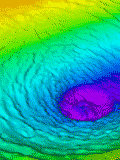 Abstract: Micropaleontological and nannopaleontological analyses have
been carried out on ditch cuttings samples from two wells (Arco British 43/24-3
and British Gas 43/25-1), which penetrated the 'Silverpit Crater' structure in
the Southern North Sea Basin (UK Sector). A stratigraphic gap (within the limits
of resolution imposed by sampling constraints) has been identified between
chalky limestones of Maastrichtian age, which are overlain by sediments of
latest Paleocene age or younger. Accepting an impact-origin for the structure,
the gap represents an impact-event, which occurred almost certainly post
Cretaceous and Early Paleocene times and thus probably within the Late
Paleocene, close to the Paleocene-Eocene boundary, ruling out an association with the K/P
extinction impact. In well 43/25-1 a short interval of mixed microfaunas and
nannofloras was observed, which is suggested as being related to 'resurgence
deposits' entering the crater immediately after the impact-event. Abstract: Micropaleontological and nannopaleontological analyses have
been carried out on ditch cuttings samples from two wells (Arco British 43/24-3
and British Gas 43/25-1), which penetrated the 'Silverpit Crater' structure in
the Southern North Sea Basin (UK Sector). A stratigraphic gap (within the limits
of resolution imposed by sampling constraints) has been identified between
chalky limestones of Maastrichtian age, which are overlain by sediments of
latest Paleocene age or younger. Accepting an impact-origin for the structure,
the gap represents an impact-event, which occurred almost certainly post
Cretaceous and Early Paleocene times and thus probably within the Late
Paleocene, close to the Paleocene-Eocene boundary, ruling out an association with the K/P
extinction impact. In well 43/25-1 a short interval of mixed microfaunas and
nannofloras was observed, which is suggested as being related to 'resurgence
deposits' entering the crater immediately after the impact-event.
|
|
Carnets Geol., vol. 25, no. 7, p. 155-167
Online since May 27, 2025
|
|
Symbiosis between bryozoans with erect cribrate colonies and rugose corals from the lower Katian (Upper Ordovician) of Estonia
Olev VINN, Andrej ERNST, Mark A. WILSON & Ursula TOOM
| HTML  | PDF
| PDF  [625 KB]
| DOI: 10.2110/carnets.2025.2506 [625 KB]
| DOI: 10.2110/carnets.2025.2506
|
|
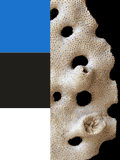 Abstract: Specimens of the rugose coral Streptelasma?
sp. are found intergrown with a host bryozoan Oanduellina
bella in the lower Katian of Estonia. Rugosa also occur in the bryozoan Proavella proava. This is the earliest and only
known record of endobiotic rugose symbionts in cryptostome bryozoans from the
Late Ordovician of Baltica. The erect bryozoan colonies provided symbiotic Rugosa with both a higher and more advantageous tier for feeding in the
water column and a hard substrate that these encrusting Rugosa required. The
rugose corals may have protected the bryozoans with their stinging cells against
predators. The lack of malformations in the bryozoan zooid architecture and
their normal dimensions around the Rugosa show that the relationship between
the Rugosa and bryozoans could have been mutualistic, which is similar to
many other Rugosa-bryozoan associations in the Late Ordovician of Baltica,
although the exact nature of this association remains uncertain. Abstract: Specimens of the rugose coral Streptelasma?
sp. are found intergrown with a host bryozoan Oanduellina
bella in the lower Katian of Estonia. Rugosa also occur in the bryozoan Proavella proava. This is the earliest and only
known record of endobiotic rugose symbionts in cryptostome bryozoans from the
Late Ordovician of Baltica. The erect bryozoan colonies provided symbiotic Rugosa with both a higher and more advantageous tier for feeding in the
water column and a hard substrate that these encrusting Rugosa required. The
rugose corals may have protected the bryozoans with their stinging cells against
predators. The lack of malformations in the bryozoan zooid architecture and
their normal dimensions around the Rugosa show that the relationship between
the Rugosa and bryozoans could have been mutualistic, which is similar to
many other Rugosa-bryozoan associations in the Late Ordovician of Baltica,
although the exact nature of this association remains uncertain.
|
|
Carnets Geol., vol. 25, no. 6, p. 147-154
Online since April 1, 2025
|
|
The Aptian-Albian of the Costa Blanca (SE Spain): Implications for identifying the Aptian/Albian boundary in the neritic zone within the Tethys realm
Bruno R.C. GRANIER, Emmanuel ROBERT & Joanaitz PÉREZ-MALO
| HTML  | PDF
| PDF  [7,771 KB]
| DOI: 10.2110/carnets.2025.2505
[7,771 KB]
| DOI: 10.2110/carnets.2025.2505
|
|
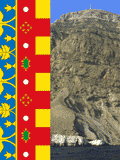 Abstract: The
Aptian-Albian interval of the Costa Blanca (SE Spain) has been
studied to provide new insights into the evolution of the neritic domain of
carbonate platforms in the Tethys. Three areas have been re-examined: Serra
Gelada, Puig Campana, and Cabeçó d'Or. The biozonations of large benthic
foraminifers (LBF) have been revised based on ammonite biostratigraphy. Updated
ammonite datings and stratigraphic revisions reveal that several LBF and
calcareous algae (CA) taxa previously attributed to the late Aptian actually
originated in the early Albian. These findings correct and refine the
calibration of LBF and CA biozones and ranges with standard ammonite zones.
Furthermore, the identification of a significant local hiatus during the middle
Albian at Cabeçó d'Or is likely linked to halokinesis. Abstract: The
Aptian-Albian interval of the Costa Blanca (SE Spain) has been
studied to provide new insights into the evolution of the neritic domain of
carbonate platforms in the Tethys. Three areas have been re-examined: Serra
Gelada, Puig Campana, and Cabeçó d'Or. The biozonations of large benthic
foraminifers (LBF) have been revised based on ammonite biostratigraphy. Updated
ammonite datings and stratigraphic revisions reveal that several LBF and
calcareous algae (CA) taxa previously attributed to the late Aptian actually
originated in the early Albian. These findings correct and refine the
calibration of LBF and CA biozones and ranges with standard ammonite zones.
Furthermore, the identification of a significant local hiatus during the middle
Albian at Cabeçó d'Or is likely linked to halokinesis.
|
|
Carnets Geol., vol. 25, no. 5, p. 109-145
Online since February 15, 2025
|
|
Calcareous green algae (Dasycladales, Halimedaceae) from the Upper Cretaceous of the western Tarim Basin, NW China: Systematic palaeontology, microfacies, and palaeobiogeographic significance
Felix SCHLAGINTWEIT, Yiwei XU & Shijie ZHANG
| HTML  | PDF
| PDF  [4,161 KB]
| DOI: 10.2110/carnets.2025.2504
[4,161 KB]
| DOI: 10.2110/carnets.2025.2504
|
|
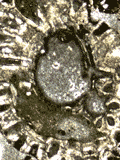 Abstract: Few stratigraphical and micropalaeontological data are available from
Upper Cretaceous shallow-water marine carbonates of the southwestern Tarim
Basin, western China. The present study provides new data about the microfauna
and calcareous algae of the Cenomanian-Turonian Kukebai Formation and the
Campanian Yigeziya Formation. The investigated bioclastic carbonates yield a
rather poorly diversified microfauna (benthic foraminifers) contrasting with a
relatively well diversified assemblage of dasycladalean green algae comprising
16 taxa. For several taxa, the available material does only allow for an open
taxonomic treatment. A new species is described herein as Morelletpora sinica. These
calcareous algae are supplemented by debris of halimedacean algae (Arabicodium?
sp.). Occurrences of calcareous algae and larger benthic foraminifers in
Cenomanian and Campanian carbonates coincide with two major transgressions
reported from the Tarim Basin. The observed faunal and phycological elements
indicate a direct connection between the Neotethys and the Tarim epicontinental
sea. The lack of several typical Cenomanian (e.g., alveolinoids,
orbitolinids) and Campanian larger benthic foraminifers in the studied material
is striking. Abstract: Few stratigraphical and micropalaeontological data are available from
Upper Cretaceous shallow-water marine carbonates of the southwestern Tarim
Basin, western China. The present study provides new data about the microfauna
and calcareous algae of the Cenomanian-Turonian Kukebai Formation and the
Campanian Yigeziya Formation. The investigated bioclastic carbonates yield a
rather poorly diversified microfauna (benthic foraminifers) contrasting with a
relatively well diversified assemblage of dasycladalean green algae comprising
16 taxa. For several taxa, the available material does only allow for an open
taxonomic treatment. A new species is described herein as Morelletpora sinica. These
calcareous algae are supplemented by debris of halimedacean algae (Arabicodium?
sp.). Occurrences of calcareous algae and larger benthic foraminifers in
Cenomanian and Campanian carbonates coincide with two major transgressions
reported from the Tarim Basin. The observed faunal and phycological elements
indicate a direct connection between the Neotethys and the Tarim epicontinental
sea. The lack of several typical Cenomanian (e.g., alveolinoids,
orbitolinids) and Campanian larger benthic foraminifers in the studied material
is striking.
|
|
Carnets Geol., vol. 25, no. 4, p. 89-108
Online since Febuary 3, 2025
|
|
Itierella melognensis n.gen., n.sp., and Paradicostella hautevillelompnesensis n.gen., n.sp. (Ammonoidea, Neocomitidae, Neocomitinae), two new upper Valanginian trituberculated ammonoids from the Jura Mountains, eastern France
Antoine PICTET, Bruno HUGON & Gustavo PIERANGELINI
| HTML  | PDF
| PDF  [1,987 KB]
| DOI: 10.2110/carnets.2025.2503
[1,987 KB]
| DOI: 10.2110/carnets.2025.2503
|
|
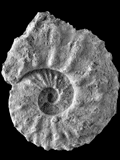 Abstract: Several
ammonoid specimens from the upper Valanginian (Lower Cretaceous) sedimentary
succession of Hauteville-Lompnes, Department of Ain, eastern France, are
assigned to the new genera and species Itierella melognensis n.gen.,
n.sp., and Paradicostella hautevillelompnesensis n.gen., n.sp. Specimens
collected in the past were misidentified as Acanthodiscus Uhlig,
1905, and erroneously assigned to the lowermost part of the Hauterivian stage.
The revision of the Marnes de Mélogne,
along with the collection of a rich associated ammonite fauna, allows Itierella
to be recognized as a latest Valanginian homeomorphic form of the
genus Acanthodiscus,
and Paradicostella as closely related to the genus Dicostella
Busnardo, 1966. The Marnes de Mélogne
are revised as mostly belonging to the upper Saynoceras verrucosum to Criosarasinella
furcillata ammonite zones (uppermost Valanginian), while their uppermost
metre is assigned to the Acanthodiscus
radiatus Zone (lowermost Hauterivian). Abstract: Several
ammonoid specimens from the upper Valanginian (Lower Cretaceous) sedimentary
succession of Hauteville-Lompnes, Department of Ain, eastern France, are
assigned to the new genera and species Itierella melognensis n.gen.,
n.sp., and Paradicostella hautevillelompnesensis n.gen., n.sp. Specimens
collected in the past were misidentified as Acanthodiscus Uhlig,
1905, and erroneously assigned to the lowermost part of the Hauterivian stage.
The revision of the Marnes de Mélogne,
along with the collection of a rich associated ammonite fauna, allows Itierella
to be recognized as a latest Valanginian homeomorphic form of the
genus Acanthodiscus,
and Paradicostella as closely related to the genus Dicostella
Busnardo, 1966. The Marnes de Mélogne
are revised as mostly belonging to the upper Saynoceras verrucosum to Criosarasinella
furcillata ammonite zones (uppermost Valanginian), while their uppermost
metre is assigned to the Acanthodiscus
radiatus Zone (lowermost Hauterivian).
|
|
Carnets Geol., vol. 25, no. 3, p. 73-87
Online since January 15, 2025
|
|
Nomenclatural Note, p.
88
|
|
Rectifying a substantial biostratigraphic error: There are no Hauterivian calpionellids in Busot (Alicante, Spain)
Bruno R.C. GRANIER, José Miguel ANDREU RODES, Mohamed BENZAGGAGH, Joachim BLAU, Éric BÖKER, Antonio ESTÉVEZ RUBIO, Bruno FERRÉ, Bernard C. LAMBERT, Agostino MARINI, Eric MONTEIL, Stéphane REBOULET & Aurélien VIRGONE
| HTML  | PDF
| PDF  [7,887 KB]
| DOI: 10.2110/carnets.2025.2502 [7,887 KB]
| DOI: 10.2110/carnets.2025.2502
|
|
 Abstract: Earlier
misidentifications of ammonites from Busot (SE Spain) led to two incorrect
hypotheses regarding calpionellids, which are today attributed to the Calpionellopsis
Zone (D) of the upper Berriasian. The first
hypothesis suggested that some calpionellid species survived into Hauterivian
times, while the second hypothesis proposed that these calpionellids were
reworked into Hauterivian strata. However, the revision of the ammonitic
material collected in 1993-1994, along with the study of new material collected
in 2024, suggests a late Berriasian age, as the ammonite assemblages likely correspond
to the Fauriella boissieri and Tirnovella alpillensis Standard Ammonites zones.
Nannofossil assemblages and the presence of Octahedronoides tethysianus
further support this dating. This reassessment calls for a reexamination of
claims regarding the occurrence of calpionellids in strata younger than the
Valanginian in the literature. Abstract: Earlier
misidentifications of ammonites from Busot (SE Spain) led to two incorrect
hypotheses regarding calpionellids, which are today attributed to the Calpionellopsis
Zone (D) of the upper Berriasian. The first
hypothesis suggested that some calpionellid species survived into Hauterivian
times, while the second hypothesis proposed that these calpionellids were
reworked into Hauterivian strata. However, the revision of the ammonitic
material collected in 1993-1994, along with the study of new material collected
in 2024, suggests a late Berriasian age, as the ammonite assemblages likely correspond
to the Fauriella boissieri and Tirnovella alpillensis Standard Ammonites zones.
Nannofossil assemblages and the presence of Octahedronoides tethysianus
further support this dating. This reassessment calls for a reexamination of
claims regarding the occurrence of calpionellids in strata younger than the
Valanginian in the literature.
|
|
Carnets Geol., vol. 25, no. 2, p. 29-72
Online since December 25, 2024
|
|
Aragonite neomorphism via intrafabric dissolution and calcite precipitation, not thin films
Arthur SALLER
| HTML  | PDF
| PDF  [7,408 KB]
| DOI: 10.2110/carnets.2025.2501 [7,408 KB]
| DOI: 10.2110/carnets.2025.2501
|
|
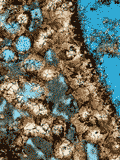 Abstract: Since the
1970's, aragonite neomorphism (conversion of aragonite to calcite with partial
retention of original internal structure) has been attributed to thin diagenetic
films, often in meteoric water. Pleistocene material from Enewetak, the Bahamas
and eastern Yucatan show the transition from aragonite to calcite "in progress".
Original aragonitic material includes coral, Halimeda, molluscs (especially
gastropods) and ooids. In all three areas, aragonite commonly shows partial
intrafabric dissolution. In many cases, calcite crystals grew over that highly
microporous aragonite to create calcite with partial retention of the original
depositional fabric, creating neomorphosed (calcitized) aragonite. Geochemical data support
this scenario. Carbon and oxygen isotopic compositions of the neomorphic
calcites are similar to sparry meteoric calcite cements indicating crystals
precipitated from similar waters as the cements. Stable carbon isotopes and Mg
concentrations in neomorphic calcites are different from their aragonitic
precursors and are not consistent with the thin-film model, which assumes a
semi-closed system. Approximately 40 of the 95 Pleistocene Enewetak samples have
aragonite with intrafabric dissolution adjacent to calcitized (neomorphic)
aragonite. Neomorphosed (calcitized) aragonite was not observed immediately
adjacent to unaltered aragonite (i.e., separated by what would have been a thin film) in any Enewetak
samples. This supports aragonite neomorphism by a two-stage process (intrafabric
dissolution followed by calcite precipitation) rather than by thin films.
Variations in concentration of inclusions in neomorphosed aragonite are similar
to variations of relict material in aragonite with partial intrafabric
dissolution and span a continuum from abundant aragonitic inclusions in
neomorphic spar to inclusion-free calcite cement. Abstract: Since the
1970's, aragonite neomorphism (conversion of aragonite to calcite with partial
retention of original internal structure) has been attributed to thin diagenetic
films, often in meteoric water. Pleistocene material from Enewetak, the Bahamas
and eastern Yucatan show the transition from aragonite to calcite "in progress".
Original aragonitic material includes coral, Halimeda, molluscs (especially
gastropods) and ooids. In all three areas, aragonite commonly shows partial
intrafabric dissolution. In many cases, calcite crystals grew over that highly
microporous aragonite to create calcite with partial retention of the original
depositional fabric, creating neomorphosed (calcitized) aragonite. Geochemical data support
this scenario. Carbon and oxygen isotopic compositions of the neomorphic
calcites are similar to sparry meteoric calcite cements indicating crystals
precipitated from similar waters as the cements. Stable carbon isotopes and Mg
concentrations in neomorphic calcites are different from their aragonitic
precursors and are not consistent with the thin-film model, which assumes a
semi-closed system. Approximately 40 of the 95 Pleistocene Enewetak samples have
aragonite with intrafabric dissolution adjacent to calcitized (neomorphic)
aragonite. Neomorphosed (calcitized) aragonite was not observed immediately
adjacent to unaltered aragonite (i.e., separated by what would have been a thin film) in any Enewetak
samples. This supports aragonite neomorphism by a two-stage process (intrafabric
dissolution followed by calcite precipitation) rather than by thin films.
Variations in concentration of inclusions in neomorphosed aragonite are similar
to variations of relict material in aragonite with partial intrafabric
dissolution and span a continuum from abundant aragonitic inclusions in
neomorphic spar to inclusion-free calcite cement.
|
|
Carnets Geol., vol. 25, no. 1, p. 1-28
Online since December 20, 2024
|

|
|
2024 (vol. 24)
|
|
Radiolarian and planktonic foraminiferal biochronology of the Soğukçam Limestone Group, Elmadağ Olistostrome, and Unaz Formation (Ankara region, central Türkiye): Insights into the Cretaceous evolution of the Sakarya Continent and overlying units
U. Kağan K. TEKIN, Bilal SARI, Alaettin TUNCER, Kaan SAYIT, Cengiz OKUYUCU & Çağrı GÜZGÜN
| HTML  | PDF
| PDF  [12,225 KB]
| DOI: 10.2110/carnets.2024.2413 [12,225 KB]
| DOI: 10.2110/carnets.2024.2413
|
|
 Abstract: The Ankara region (central Türkiye) comprises a part of
the Sakarya Terrane and the accretionary remnants inherited from the Izmir-Ankara-Erzincan (IAE) branch of the Northern Neotethys. The Sakarya Terrane is characterized by a pre-Jurassic basement overlain
by Jurassic-Cretaceous sedimentary assemblages, collectively known as the Sakarya Continent Cover. In this study, we aim to elucidate the Jurassic-Cretaceous evolution of the Sakarya Terrane through detailed
geological mapping in the regions of Haymana, Yakacık, north of Alagöz and west of Memlik, located to the west and southwest of Ankara city, central Türkiye. By analyzing radiolarian and planktonic
foraminiferal assemblages, we provide precise dating for three key lithological units: the Soğukçam Limestone Group (part of the Sakarya Continent Cover), the Elmadağ Olistostrome, and the Unaz
Formation (from the overlying units). The oldest rock unit exposed in the Haymana region, south of Ankara city, is the Bilecik Limestone Group, consisting of Tithonian to lower Berriasian platform carbonates.
A drowning unconformity separates the Bilecik Limestone Group from the overlying middle Berriasian-uppermost Albian Soğukçam Limestone Group, which has been elevated to "group" status in this study.
The Soğukçam Limestone Group is subdivided into two formations -the Seyran Formation and the Akkaya Formation- separated by a disconformity surface. The Seyran Formation, at the base, consists of middle Berriasian
limestone breccia in a micritic pelagic matrix, and upper Berriasian-lower Aptian micritic clayey, cherty pelagic limestones with abundant and diverse radiolarians in its upper part. The disconformity between the Seyran
and Akkaya formations represents a small depositional gap corresponding to the middle to late Aptian. The lower part of the Akkaya Formation contains lower to middle Albian debris flow deposits while the upper part is
composed of clayey pelagic limestones rich in glauconite and planktonic foraminifers, dating to the latest Albian. Overall, the Akkaya Formation is roughly assigned to the Albian stage. Abstract: The Ankara region (central Türkiye) comprises a part of
the Sakarya Terrane and the accretionary remnants inherited from the Izmir-Ankara-Erzincan (IAE) branch of the Northern Neotethys. The Sakarya Terrane is characterized by a pre-Jurassic basement overlain
by Jurassic-Cretaceous sedimentary assemblages, collectively known as the Sakarya Continent Cover. In this study, we aim to elucidate the Jurassic-Cretaceous evolution of the Sakarya Terrane through detailed
geological mapping in the regions of Haymana, Yakacık, north of Alagöz and west of Memlik, located to the west and southwest of Ankara city, central Türkiye. By analyzing radiolarian and planktonic
foraminiferal assemblages, we provide precise dating for three key lithological units: the Soğukçam Limestone Group (part of the Sakarya Continent Cover), the Elmadağ Olistostrome, and the Unaz
Formation (from the overlying units). The oldest rock unit exposed in the Haymana region, south of Ankara city, is the Bilecik Limestone Group, consisting of Tithonian to lower Berriasian platform carbonates.
A drowning unconformity separates the Bilecik Limestone Group from the overlying middle Berriasian-uppermost Albian Soğukçam Limestone Group, which has been elevated to "group" status in this study.
The Soğukçam Limestone Group is subdivided into two formations -the Seyran Formation and the Akkaya Formation- separated by a disconformity surface. The Seyran Formation, at the base, consists of middle Berriasian
limestone breccia in a micritic pelagic matrix, and upper Berriasian-lower Aptian micritic clayey, cherty pelagic limestones with abundant and diverse radiolarians in its upper part. The disconformity between the Seyran
and Akkaya formations represents a small depositional gap corresponding to the middle to late Aptian. The lower part of the Akkaya Formation contains lower to middle Albian debris flow deposits while the upper part is
composed of clayey pelagic limestones rich in glauconite and planktonic foraminifers, dating to the latest Albian. Overall, the Akkaya Formation is roughly assigned to the Albian stage.
The Akkaya Formation within the
Soğukçam Limestone Group is unconformably overlain by the Coniacian Elmadağ Olistostrome, which also covers the ophiolitic mélange of the IAE Ocean (containing Turonian radiolarian blocks) to the west of the
Memlik region. The basal part of the Elmadağ Olistostrome is characterized by an unstratified, loosely-packed, gray- to beige-colored carbonate matrix, while its upper part features stratified, highly-sheared gray-
to beige-colored clayey carbonate/marl matrix with embedded carbonate blocks. These blocks, dated through radiolarians and planktonic foraminifers, range from the early Callovian to Coniacian. These blocks, observed in
the Haymana, north of Alagöz, and Yakacık regions, primarily originated from the underlying Soğukçam Limestone Group. The Elmadağ Olistostrome was likely deposited in a peripheral foreland flysch basin,
resembling trench-like settings, in front of the southward-moving nappes derived from the Neotethys Intra-Pontide Ocean. This olistostrome is unconformably overlain by the Unaz Formation, which represents the lowermost
unit of the fore-arc basin within the Galatean Arc and is present in all four studied regions. The Unaz Formation mainly consists of thin-bedded, gray- to red-colored clayey limestones with abundant planktonic foraminifers,
along with red- to pink-colored marls. In the northern part (west of Memlik), the Unaz Formation also includes basal clastics. Based on its characteristic planktonic foraminiferal assemblages, the formation is dated to the
late Santonian and correlates well with the type locality in the Pontides, northwestern Türkiye. Following this sequence, a brief period of continental arc magmatism occurred in the Santonian-Campanian, accompanied by the
deposition of fore-arc sediments (the Haymana Formation, consisting of clastics) during the Campanian-Maastrichtian interval.
In this study, an abundant, well-preserved, and diverse radiolarian microfauna (146 taxa,
including fourteen new species and four new subspecies from the early Hauterivian to early Aptian, Early Cretaceous) were recovered from the clayey micritic limestones of the Seyran Formation in the Soğukçam
Limestone Group. The vertical distributions of these radiolarians and their age correlations with previous studies are also documented.
|
|
Carnets Geol., vol. 24, no. 13, p. 187-263
Online since December 10, 2024
|
|
Nomenclatural Note, p.
264
|
|
A new subfamily classification of the Coskinolinidae Moullade, 1965, Middle Jurassic-Paleogene Larger Benthic Foraminifera
Felix SCHLAGINTWEIT
| HTML  | PDF
| PDF  [728 KB]
| DOI: 10.2110/carnets.2024.2412 [728 KB]
| DOI: 10.2110/carnets.2024.2412
|
|
 Abstract: The Coskinolinidae are a family of Middle Jurassic to Paleogene, typically
orbitoliniform, Larger Benthic Foraminifera (LBF) characterized by a pseudokeriothecal
wall structure. The type genus, Coskinolina Stache,
1875, lacks an
exoskeleton (i.e., beams, rafters), resulting in an undivided marginal
chamber zone. However, other taxa within the family, such as the Upper
Cretaceous Lepinoconus Cruz-Abad et al., 2017, or the
Paleogene Coleiconus Hottinger & Drobne,
1980, are
genera with vertical partitions (beams) that subdivide the marginal chamber
zone. In the currently accepted classification of agglutinated benthic
foraminifera, the nature of the exoskeleton is a criterion for distinction at subfamily level, e.g., Cyclamminidae Marie,
1941. Thus, here, the
presence or absence of an exoskeleton in the marginal chamber lumen is treated
as a criterion at the subfamily level within the classification of the
Coskinolinidae, leading to a division into two subfamilies: the Coskinolininae Moullade,
1965 (lacking an exoskeleton), and the newly proposed Coleiconinae subfam. nov.
(with an exoskeleton of vertical partitions), as exemplified by Coleiconus
Hottinger & Drobne, 1980. Abstract: The Coskinolinidae are a family of Middle Jurassic to Paleogene, typically
orbitoliniform, Larger Benthic Foraminifera (LBF) characterized by a pseudokeriothecal
wall structure. The type genus, Coskinolina Stache,
1875, lacks an
exoskeleton (i.e., beams, rafters), resulting in an undivided marginal
chamber zone. However, other taxa within the family, such as the Upper
Cretaceous Lepinoconus Cruz-Abad et al., 2017, or the
Paleogene Coleiconus Hottinger & Drobne,
1980, are
genera with vertical partitions (beams) that subdivide the marginal chamber
zone. In the currently accepted classification of agglutinated benthic
foraminifera, the nature of the exoskeleton is a criterion for distinction at subfamily level, e.g., Cyclamminidae Marie,
1941. Thus, here, the
presence or absence of an exoskeleton in the marginal chamber lumen is treated
as a criterion at the subfamily level within the classification of the
Coskinolinidae, leading to a division into two subfamilies: the Coskinolininae Moullade,
1965 (lacking an exoskeleton), and the newly proposed Coleiconinae subfam. nov.
(with an exoskeleton of vertical partitions), as exemplified by Coleiconus
Hottinger & Drobne, 1980.
|
|
Carnets Geol., vol. 24, no. 12, p. 179-186
Online since November 30, 2024
|
|
Nomenclatural Note, p.
134
|
|
Extraordinary trilobite collected by František Pošepný discovered after 140 years
Oldřich FATKA
| HTML  | PDF
| PDF  [390 KB]
| DOI: 10.2110/carnets.2024.2411 [390 KB]
| DOI: 10.2110/carnets.2024.2411
|
|
 Abstract: This
extraordinary specimen, a well-preserved articulated thorax of a large specimen
of the middle Cambrian paradoxidid trilobite Paradoxides (Hydrocephalus)
minor (Boeck, 1827), was collected by the notable geologist František
Pošepný during an excursion to the Hřebeny mountain range, Czech
Republic, in the 1890s, and was thought to have been lost for nearly 140 years.
The trilobite originates from the Brdlavka locality, one of the easternmost
outcrops of the Jince Formation. There is no fossil
collected at this locality housed in institutional and private collections.
The recent discovery of this fossil in the Geological Pavilion of the Technical
University of Ostrava, Czech Republic, enabled its assignment to the common
species Paradoxides (Hydrocephalus) minor (Boeck,
1827). This species confirms the occurrence of the middle levels of the middle
Cambrian Jince Formation at the Brdlavka locality. Abstract: This
extraordinary specimen, a well-preserved articulated thorax of a large specimen
of the middle Cambrian paradoxidid trilobite Paradoxides (Hydrocephalus)
minor (Boeck, 1827), was collected by the notable geologist František
Pošepný during an excursion to the Hřebeny mountain range, Czech
Republic, in the 1890s, and was thought to have been lost for nearly 140 years.
The trilobite originates from the Brdlavka locality, one of the easternmost
outcrops of the Jince Formation. There is no fossil
collected at this locality housed in institutional and private collections.
The recent discovery of this fossil in the Geological Pavilion of the Technical
University of Ostrava, Czech Republic, enabled its assignment to the common
species Paradoxides (Hydrocephalus) minor (Boeck,
1827). This species confirms the occurrence of the middle levels of the middle
Cambrian Jince Formation at the Brdlavka locality.
|
|
Carnets Geol., vol. 24, no. 11, p. 173-178
Online since October 31, 2024
|
|
A larger benthic foraminiferal zonation for the Cenozoic of the Americas
Simon F. MITCHELL, Edward ROBINSON, Ercan ÖZCAN, Mark M. JIANG & Natalie ROBINSON
| HTML  | PDF
| PDF  [762 KB]
| DOI: 10.2110/carnets.2024.2410 [762 KB]
| DOI: 10.2110/carnets.2024.2410
|
|
 Abstract: The Cenozoic of the Americas does not have a zonation based on Larger Benthic
Foraminifera (LBF) unlike the Tethys where there is a shallow-water benthic
zonation. Although there were faunal exchanges, the different evolutionary
patterns between the Americas and the Tethys require separate zonations. We have
calibrated LBF, stratigraphic distributions and events in the Americas using
calcareous nannoflora (Paleocene-Eocene), planktic foraminifers
(Oligocene-Miocene) and published strontium (Sr) isotope values. We define 29 zones spanning the
Paleocene to Recent based on changing LBF assemblages and evolving lineages,
with some zonal boundaries related to global or local palaeoenvironmental
events. This will allow correlation across carbonate platforms in the tropical Americas
at a higher resolution than previously possible. Abstract: The Cenozoic of the Americas does not have a zonation based on Larger Benthic
Foraminifera (LBF) unlike the Tethys where there is a shallow-water benthic
zonation. Although there were faunal exchanges, the different evolutionary
patterns between the Americas and the Tethys require separate zonations. We have
calibrated LBF, stratigraphic distributions and events in the Americas using
calcareous nannoflora (Paleocene-Eocene), planktic foraminifers
(Oligocene-Miocene) and published strontium (Sr) isotope values. We define 29 zones spanning the
Paleocene to Recent based on changing LBF assemblages and evolving lineages,
with some zonal boundaries related to global or local palaeoenvironmental
events. This will allow correlation across carbonate platforms in the tropical Americas
at a higher resolution than previously possible.
|
|
Carnets Geol., vol. 24, no. 10, p. 163-172
Online since October 31, 2024
|
|
Shell injuries in Densepustula Lazarev, 1982, Pennsylvanian productidine brachiopod from the Donets Basin, Ukraine
Vitaly DERNOV
| HTML  | PDF
| PDF  [1,669 KB]
| DOI: 10.2110/carnets.2024.2409 [1,669 KB]
| DOI: 10.2110/carnets.2024.2409
|
|
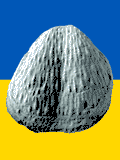 Abstract: Nine injured ventral valves of productidine brachiopods belonging to the genus
Densepustula Lazarev, 1982, from the Mospyne, Smolyanynivka, Belaya Kalitva, and
Kamensk formations (Upper Bashkirian-lower Moscovian, Lower and Middle Pennsylvanian) of the Donets Basin (eastern Ukraine)
were studied. Three morphological types of damage traces have been recognized: Type A) longitudinal,
sublongitudinal, and transversal thin straight or sinuous furrows, about 5-7 mm
long and 0.5-1.5 mm thick; Type B) rounded and ellipsoidal pits, about 3-4 mm in
diameter, located on the umbo, the anterior margin of the ventral valve, and the lateral slopes of the ventral valve;
and Type C) irregularly-shaped dimples on the anterior margin and in the sulcus, 2-3 mm in size. These injuries are present
on 9 out of 61 (15%) of ventral valves studied, but entirely absent from dorsal
valves (0 out of 25). The most likely producers of these damage traces
are cartilaginous fishes and parasites of unclear affinity. Abstract: Nine injured ventral valves of productidine brachiopods belonging to the genus
Densepustula Lazarev, 1982, from the Mospyne, Smolyanynivka, Belaya Kalitva, and
Kamensk formations (Upper Bashkirian-lower Moscovian, Lower and Middle Pennsylvanian) of the Donets Basin (eastern Ukraine)
were studied. Three morphological types of damage traces have been recognized: Type A) longitudinal,
sublongitudinal, and transversal thin straight or sinuous furrows, about 5-7 mm
long and 0.5-1.5 mm thick; Type B) rounded and ellipsoidal pits, about 3-4 mm in
diameter, located on the umbo, the anterior margin of the ventral valve, and the lateral slopes of the ventral valve;
and Type C) irregularly-shaped dimples on the anterior margin and in the sulcus, 2-3 mm in size. These injuries are present
on 9 out of 61 (15%) of ventral valves studied, but entirely absent from dorsal
valves (0 out of 25). The most likely producers of these damage traces
are cartilaginous fishes and parasites of unclear affinity.
|
|
Carnets Geol., vol. 24, no. 9, p. 143-162
Online since September 20, 2024
|
|
Tooth marks of the Great White Shark from a Pliocene outcrop of the Northern Apennines (Castell'Arquato, Italy)
Alessandro FRESCHI & Simone CAU
| HTML  | PDF
| PDF  [596 KB]
| DOI: 10.2110/carnets.2024.2408 [596 KB]
| DOI: 10.2110/carnets.2024.2408
|
|
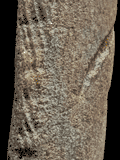 Abstract: We
describe and analyze a rib fragment of a small cetacean from the Castell'Arquato
Plio-Pleistocene Basin (Northern Apennines, Italy) that displays various tooth
marks featuring parallel striations similar to those left by the serrated tooth
of the extant white shark, Carcharodon carcharias. The discovery
locality,
known as "Buca della Balena", was an inner-shelf marine setting where sharks
may have scavenged on drifting cetacean carcasses in Piacenzian times. The high
number of marks found on the small bone fragment suggests multiple bites by one
or more shark individuals. The rib fragment studied is one of the few
osteological specimens from the Pliocene of the Mediterranean Basin to preserve
white shark tooth marks. Abstract: We
describe and analyze a rib fragment of a small cetacean from the Castell'Arquato
Plio-Pleistocene Basin (Northern Apennines, Italy) that displays various tooth
marks featuring parallel striations similar to those left by the serrated tooth
of the extant white shark, Carcharodon carcharias. The discovery
locality,
known as "Buca della Balena", was an inner-shelf marine setting where sharks
may have scavenged on drifting cetacean carcasses in Piacenzian times. The high
number of marks found on the small bone fragment suggests multiple bites by one
or more shark individuals. The rib fragment studied is one of the few
osteological specimens from the Pliocene of the Mediterranean Basin to preserve
white shark tooth marks.
|
|
Carnets Geol., vol. 24, no. 8, p. 135-141
Online since July 24, 2024
|
|
Octahedronoides tethysianus n.gen., n.sp., enigmatic clusters of microspheres at the Jurassic-Cretaceous transition
Bruno R.C. GRANIER
| HTML  | PDF
| PDF  [1,821 KB]
| DOI: 10.2110/carnets.2024.2407 [1,821 KB]
| DOI: 10.2110/carnets.2024.2407
|
|
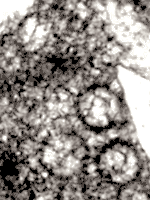 Abstract: In
the literature, numerous accounts exist of microspheres scattered in the pelagic
environments of the Tethys realm at the Jurassic-Cretaceous transition. These
microspheres are commonly associated with genera such as Cadosina, Colomisphaera,
or Stomiosphaera, and attributed to calcareous dinocysts. On the
other hand, there are few records of the microsphere, initially described as Cadosina
minuta Borza, 1980, which are arranged
in small clusters, likely comprising six cells. This distinctive grouping
and its architecture preclude attribution to the calcareous dinocysts. A new
genus and a new species (as Octahedronoides tethysianus n.gen., n.sp.) are introduced to define these
clusters of leiospheres, which are here reascribed to the acritarchs. Abstract: In
the literature, numerous accounts exist of microspheres scattered in the pelagic
environments of the Tethys realm at the Jurassic-Cretaceous transition. These
microspheres are commonly associated with genera such as Cadosina, Colomisphaera,
or Stomiosphaera, and attributed to calcareous dinocysts. On the
other hand, there are few records of the microsphere, initially described as Cadosina
minuta Borza, 1980, which are arranged
in small clusters, likely comprising six cells. This distinctive grouping
and its architecture preclude attribution to the calcareous dinocysts. A new
genus and a new species (as Octahedronoides tethysianus n.gen., n.sp.) are introduced to define these
clusters of leiospheres, which are here reascribed to the acritarchs.
|
|
Carnets Geol., vol. 24, no. 7, p. 127-133
Online since May 8, 2024
|
|
A new fossil psychodomorphan fly from Lower Barremian Lebanese amber elucidates the relationship of the Tanyderinae stat. nov. within the Psychodidae
Dany AZAR, Sibelle MAKSOUD, Di-Ying HUANG, Mounir MAALOUF & Chen-Yang CAI
| HTML  | PDF
| PDF  [1,304 KB]
| DOI: 10.2110/carnets.2024.2406 [1,304 KB]
| DOI: 10.2110/carnets.2024.2406
|
|
 Abstract: A new species, †Nannotanyderus granieri sp. nov.,
belonging to the Tanyderidae (Diptera, Nematocera), from Lower Barremian amber
of Bqaatouta (Lebanon), is characterized, described, figured, and its
taxononomic position discussed. The possible confusion regarding the attribution of new fossils to either the Tanyderidae or the Psychodidae,
in addition to the results of recent molecular phylogenies, have led us to re-evaluate
the taxonomic position of the Tanyderidae and to consider it as a subfamily
within the Psychodidae. The fossil described herein is a tiny tanyderine sensu
nov. species, and the second one belonging to the genus Nannotanyderus
from Lebanese amber. A tentative molecular phylogeny of recent Psychodidae and
an exhaustive catalogue of fossil Tanyderinae stat. nov. are provided. Abstract: A new species, †Nannotanyderus granieri sp. nov.,
belonging to the Tanyderidae (Diptera, Nematocera), from Lower Barremian amber
of Bqaatouta (Lebanon), is characterized, described, figured, and its
taxononomic position discussed. The possible confusion regarding the attribution of new fossils to either the Tanyderidae or the Psychodidae,
in addition to the results of recent molecular phylogenies, have led us to re-evaluate
the taxonomic position of the Tanyderidae and to consider it as a subfamily
within the Psychodidae. The fossil described herein is a tiny tanyderine sensu
nov. species, and the second one belonging to the genus Nannotanyderus
from Lebanese amber. A tentative molecular phylogeny of recent Psychodidae and
an exhaustive catalogue of fossil Tanyderinae stat. nov. are provided.
|
|
Carnets Geol., vol. 24, no. 6, p. 113-125
Online since April 1, 2024
|
|
Nomenclatural Note, p.
126
|
|
The Kalkowsky Project - Chapter VI. A panorama of synsedimentary broken ooids
Bruno R.C. GRANIER & Philippe LAPOINTE
| HTML  | PDF
| PDF  [3,988 KB]
| DOI: 10.2110/carnets.2024.2405
[3,988 KB]
| DOI: 10.2110/carnets.2024.2405
|
|
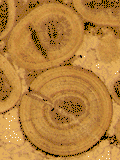 Abstract: Broken
ooids are known to occur in both aragonitic and calcitic ooids with radial
fabrics. In the literature, it has been suggested that synsedimentary breakage could be related to
attrition/mechanical impacts, hypersalinity, or desiccation. However, this paper demonstrates that none of the aforementioned phenomena provides a valid
explanation. Although the exact process remains unknown (potentially involving some synsedimentary
recrystallization), it is shown that: 1) the breakage is genetically linked to the radial
fabrics; 2) the ratio of ooid breakages increases with the relative thickness of the radial cortical
layers; 3) fracture growth in broken ooids proceeds centripetally. Abstract: Broken
ooids are known to occur in both aragonitic and calcitic ooids with radial
fabrics. In the literature, it has been suggested that synsedimentary breakage could be related to
attrition/mechanical impacts, hypersalinity, or desiccation. However, this paper demonstrates that none of the aforementioned phenomena provides a valid
explanation. Although the exact process remains unknown (potentially involving some synsedimentary
recrystallization), it is shown that: 1) the breakage is genetically linked to the radial
fabrics; 2) the ratio of ooid breakages increases with the relative thickness of the radial cortical
layers; 3) fracture growth in broken ooids proceeds centripetally.
|
|
Carnets Geol., vol. 24, no. 5, p. 91-112
Online since February 29, 2024
|
|
A new record of ground sloth in the Ribeira de Iguape valley, southeastern Brazil
Artur CHAHUD, Gabriella da C. PEREIRA, Paulo R. de O. COSTA & Mercedes OKUMURA
| HTML  | PDF
| PDF  [377 KB]
| DOI: 10.2110/carnets.2024.2404
[377 KB]
| DOI: 10.2110/carnets.2024.2404
|
|
 Abstract: In the early 1980s, an assemblage of extinct and extant
vertebrates was collected from the Abismo Ponta de Flecha, a vertical cave in southern São Paulo, Brazil, for archaeological, geological, and paleontological analyses. While materials identified as
ground sloths have been referenced in earlier publications, they have never been thoroughly described. In this study, we provide the first detailed description of a large, previously unidentified taxon
found in Brazil, interpreted herein as belonging to the family Nothrotheriidae. Although direct dating of the specimen was not possible, other dated occurrences from the Ribeira de Iguape Valley
suggest that it may have inhabited the region during the Late Pleistocene, coinciding with the local presence of a dense forest cover. Abstract: In the early 1980s, an assemblage of extinct and extant
vertebrates was collected from the Abismo Ponta de Flecha, a vertical cave in southern São Paulo, Brazil, for archaeological, geological, and paleontological analyses. While materials identified as
ground sloths have been referenced in earlier publications, they have never been thoroughly described. In this study, we provide the first detailed description of a large, previously unidentified taxon
found in Brazil, interpreted herein as belonging to the family Nothrotheriidae. Although direct dating of the specimen was not possible, other dated occurrences from the Ribeira de Iguape Valley
suggest that it may have inhabited the region during the Late Pleistocene, coinciding with the local presence of a dense forest cover.
|
|
Carnets Geol., vol. 24, no. 4, p. 83-89
Online since January 31, 2024
|
|
The Kalkowsky Project - Chapter V. Asymmetric ooids from the Yacoraite Formation (Argentina)
Bruno R.C. GRANIER & Philippe LAPOINTE
| HTML  | PDF
| PDF  [2,420 KB]
| DOI: 10.2110/carnets.2024.2403
[2,420 KB]
| DOI: 10.2110/carnets.2024.2403
|
|
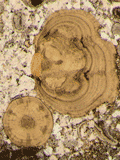 Abstract: Asymmetric ooids
are documented in a brackish Maastrichtian to Danian paleolake in NW Argentina.
Their distinctive asymmetric growth pattern is likely related to an uneven
distribution of the Extracellular Polymeric Substances (EPS) around the coated
allochem, within which calcite fibers (i.e., the 'fibrite') have grown. This
pattern is unlikely to be mistaken for that of other 'eccentric' ooids, such as
wobbly ooids, spiny ooids, hiatus ooids, half-moon ooids, 'broken' ooids sensu
lato, or collapsed oomolds (referred to as 'distorted' ooids). Abstract: Asymmetric ooids
are documented in a brackish Maastrichtian to Danian paleolake in NW Argentina.
Their distinctive asymmetric growth pattern is likely related to an uneven
distribution of the Extracellular Polymeric Substances (EPS) around the coated
allochem, within which calcite fibers (i.e., the 'fibrite') have grown. This
pattern is unlikely to be mistaken for that of other 'eccentric' ooids, such as
wobbly ooids, spiny ooids, hiatus ooids, half-moon ooids, 'broken' ooids sensu
lato, or collapsed oomolds (referred to as 'distorted' ooids).
|
|
Carnets Geol., vol. 24, no. 3, p. 75-82
Online since January 20, 2024
|
|
The Central South Atlantic: The origin of its waters, its evolution and effects beyond
Ricardo L.M. AZEVEDO, Rogério L. ANTUNES, Mauro D.R. BRUNO, Thomas R. FAIRCHILD & Dimas DIAS-BRITO
| HTML  | PDF
| PDF  [3,554 KB]
| DOI: 10.2110/carnets.2024.2402 [3,554 KB]
| DOI: 10.2110/carnets.2024.2402
|
|
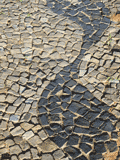 Abstract: The primitive sea that occupied the
Central South Atlantic (CSA), part of the intra-Gondwana rift during the Early
Cretaceous, allowed precipitation of an extensive and thick layer of evaporites,
the Ibura Salt, followed by the deposition of a prominent Albian carbonate
package. Although the shallow platform facies do not contain classical benthic
Tethys markers, the pelagic open sea carbonates are essentially dominated by
planktonic elements coming from the Tethys Realm. This condition led some
researchers to think that Tethys waters also contributed to salt formation, an
idea that clashes with the geotectonic model of northward separation of Africa
and South America and ingression of predominantly Austral marine waters. Now, a new controversy arises as to the age of this salt layer when trying to position
bio-events and lithological and chemostratigraphic markers from these rocks with
respect to established data for the Global Boundary Stratotype Section and Point for the
Aptian/Albian boundary (GSSP-Alb). Biochronostratigraphic information on
planktonic foraminifera points to an Aptian age as opposed to the earliest
Albian traditionally accepted for the carbonate section that overlies the giant
salt layer. On the other hand, stratigraphic and geochronological data suggest
an age of 113 Ma for the base of the salt, very near to the 113.2 ± 0.1 Ma
arbitrated for the GSSP-Alb. In this study, we adopt the base of the evaporite
bed as the Aptian/Albian boundary in the CSA, Equatorial South Atlantic (ESA),
and northeastern Brazilian interior basins (BNE) as well. Based on these
criteria, a broad review and the integration of available information have led to new
interpretations regarding the earliest phase of these segments of the South
Atlantic and adjacent areas. Initially, during the Aptian-Albian transition, an
ephemeral interior sea within Brazil, drawing its waters from the north, would
have contributed to salt deposition in the intra-Gondwana rift (evaporitic
stage of the CSA). Afterward, but still within the earliest Albian, the
evaporitic system evolved into a carbonate gulf when the northern barrier, the
Exception Zone (EZ), disappeared. The lagoonal circulation pattern that then
formed in the CSA created a hypersaline and warm outflow plume that swept across
the marine bottom of the ESA and part of the Tethys Sea. Paleoceanographic
events registered at Site 545, Mazagan Plateau, support this new hypothesis and
illustrate the potential complexity of correlation of organic-rich deposits in
which local influences have been greater than global ones. This long, narrow,
and continuous carbonate gulf disappeared at the end of the Albian with the
arrival of southern waters from the Meridional South Atlantic (MSA), and the
South Atlantic became consolidated as a proto-ocean. Abstract: The primitive sea that occupied the
Central South Atlantic (CSA), part of the intra-Gondwana rift during the Early
Cretaceous, allowed precipitation of an extensive and thick layer of evaporites,
the Ibura Salt, followed by the deposition of a prominent Albian carbonate
package. Although the shallow platform facies do not contain classical benthic
Tethys markers, the pelagic open sea carbonates are essentially dominated by
planktonic elements coming from the Tethys Realm. This condition led some
researchers to think that Tethys waters also contributed to salt formation, an
idea that clashes with the geotectonic model of northward separation of Africa
and South America and ingression of predominantly Austral marine waters. Now, a new controversy arises as to the age of this salt layer when trying to position
bio-events and lithological and chemostratigraphic markers from these rocks with
respect to established data for the Global Boundary Stratotype Section and Point for the
Aptian/Albian boundary (GSSP-Alb). Biochronostratigraphic information on
planktonic foraminifera points to an Aptian age as opposed to the earliest
Albian traditionally accepted for the carbonate section that overlies the giant
salt layer. On the other hand, stratigraphic and geochronological data suggest
an age of 113 Ma for the base of the salt, very near to the 113.2 ± 0.1 Ma
arbitrated for the GSSP-Alb. In this study, we adopt the base of the evaporite
bed as the Aptian/Albian boundary in the CSA, Equatorial South Atlantic (ESA),
and northeastern Brazilian interior basins (BNE) as well. Based on these
criteria, a broad review and the integration of available information have led to new
interpretations regarding the earliest phase of these segments of the South
Atlantic and adjacent areas. Initially, during the Aptian-Albian transition, an
ephemeral interior sea within Brazil, drawing its waters from the north, would
have contributed to salt deposition in the intra-Gondwana rift (evaporitic
stage of the CSA). Afterward, but still within the earliest Albian, the
evaporitic system evolved into a carbonate gulf when the northern barrier, the
Exception Zone (EZ), disappeared. The lagoonal circulation pattern that then
formed in the CSA created a hypersaline and warm outflow plume that swept across
the marine bottom of the ESA and part of the Tethys Sea. Paleoceanographic
events registered at Site 545, Mazagan Plateau, support this new hypothesis and
illustrate the potential complexity of correlation of organic-rich deposits in
which local influences have been greater than global ones. This long, narrow,
and continuous carbonate gulf disappeared at the end of the Albian with the
arrival of southern waters from the Meridional South Atlantic (MSA), and the
South Atlantic became consolidated as a proto-ocean.
|
|
Carnets Geol., vol. 24, no. 2, p. 29-74
Online since January 20, 2024
|
|
Paleoenvironmental changes preceding the onset of the Messinian
salinity crisis in the western Mediterranean Sea (pre-evaporitic Messinian of
the Melilla-Nador Basin, NE Morocco)
Hanane BAHAJ, Nadia BARHOUN, Naima BACHIRI TAOUFIQ, Jihad RAHMOUNA, Soukaina TARGHI, Naima BERRY, Jean-Pierre SUC & Speranta-Maria POPESCU
| HTML  | PDF
| PDF  [1,534 KB]
| DOI: 10.2110/carnets.2024.2401
[1,534 KB]
| DOI: 10.2110/carnets.2024.2401
|
|
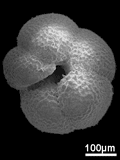 Abstract: In order to contribute
to the understanding of the evolution of marine and continental environments, preceding the onset of the Messinian salinity crisis in the western Mediterranean, we
conducted an integrated study of the pre-evaporitic Messinian sedimentary series in the Melilla-Nador basin. Three sections have been carried out in the marl-diatomite
series and were the subject of a detailed biostratigraphic and palynological study. The study of planktonic foraminifera, pollen, dinocysts, and palynofacies allowed us
to characterize the evolution of these environments. From 6.83 to 6.52 Ma, the marine environment was relatively open, calm, probably subject to the action of upwellings
and received periodic continental inputs. Starting 6.52 Ma, the abundance and diversity of planktonic foraminifera decreased. Continental inputs gradually dominate,
alternating with marine ones, and reflecting a succession between proximal and distal neritic environments. The surface water conditions were warm. After 6.35 Ma, began
the degradation of marine conditions. The continental environment shows an open vegetal landscape dominated by herbaceous plants, reflecting a tropical to arid
subtropical climate, slightly less dry than that of the South Rifian Corridor. Abstract: In order to contribute
to the understanding of the evolution of marine and continental environments, preceding the onset of the Messinian salinity crisis in the western Mediterranean, we
conducted an integrated study of the pre-evaporitic Messinian sedimentary series in the Melilla-Nador basin. Three sections have been carried out in the marl-diatomite
series and were the subject of a detailed biostratigraphic and palynological study. The study of planktonic foraminifera, pollen, dinocysts, and palynofacies allowed us
to characterize the evolution of these environments. From 6.83 to 6.52 Ma, the marine environment was relatively open, calm, probably subject to the action of upwellings
and received periodic continental inputs. Starting 6.52 Ma, the abundance and diversity of planktonic foraminifera decreased. Continental inputs gradually dominate,
alternating with marine ones, and reflecting a succession between proximal and distal neritic environments. The surface water conditions were warm. After 6.35 Ma, began
the degradation of marine conditions. The continental environment shows an open vegetal landscape dominated by herbaceous plants, reflecting a tropical to arid
subtropical climate, slightly less dry than that of the South Rifian Corridor.
This study confirms the existence of several parameters that contributed to the
deposition of the cyclical marl-diatomite series: on the one hand, the hot and dry climate favored the reduction of the plant landscape and therefore erosion
(continental inputs); on the other, the tectonics (volcanism and uplift).
|
|
Carnets Geol., vol. 24, no. 1, p. 1-27
Online since January 17, 2024
|

|
|
2023 (vol. 23)
|
|
Chapter 1 - Preliminary investigations on the Zard Formation at its type locality (North Khorasan Province, Iran)
Bruno GRANIER, Seyedeh Saeideh S. MORTAZAVI, Morteza TAHERPOUR-KHALIL-ABAD & Farokh GHAEMI
| HTML  | PDF
| PDF  [5,168 KB]
| DOI: 10.2110/carnets.2023.2309 [5,168 KB]
| DOI: 10.2110/carnets.2023.2309
|
|
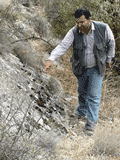 Abstract: This chapter presents a revision of the Zard Formation in its type area, i.e.,
in the North Khorasan Province (Iran), including at its type locality. It
comprises a description of the sedimentological and micropaleontological
criteria that permit it to be distinguished from the Mozduran Formation (below)
and the Tirgan Formation (above). At its type locality, its lower boundary is a
heavily bored surface. Actually, both contacts with the framing formations
correspond to transgressive surfaces, which imply that this lithostratigraphic
unit is an Unconformity-Bounded Unit. With respect to biostratigraphy, this
formation contains a few second-order markers: Holosporella sugdeni, Kopetdagaria
sphaerica, and Torinosuella peneropliformis, which are also found in
the unit above, i.e., in the Tirgan Formation. Because the latter
contains markers that first appear in the Barremian: Bakalovaella elitzae, Pseudoactinoporella
iranica, and Balkhania balkhanica, but also Montseciella
arabica, the total range of which spans the Upper Barremian, the Zard
Formation (i.e., the Zardian regional stage) should partly covers the
Hauterivian to Barremian interval. Finally, although it cannot be definitely
excluded that the lowermost part of the Zard Formation could be Valanginian in age, this option still
requires proper documentation. Abstract: This chapter presents a revision of the Zard Formation in its type area, i.e.,
in the North Khorasan Province (Iran), including at its type locality. It
comprises a description of the sedimentological and micropaleontological
criteria that permit it to be distinguished from the Mozduran Formation (below)
and the Tirgan Formation (above). At its type locality, its lower boundary is a
heavily bored surface. Actually, both contacts with the framing formations
correspond to transgressive surfaces, which imply that this lithostratigraphic
unit is an Unconformity-Bounded Unit. With respect to biostratigraphy, this
formation contains a few second-order markers: Holosporella sugdeni, Kopetdagaria
sphaerica, and Torinosuella peneropliformis, which are also found in
the unit above, i.e., in the Tirgan Formation. Because the latter
contains markers that first appear in the Barremian: Bakalovaella elitzae, Pseudoactinoporella
iranica, and Balkhania balkhanica, but also Montseciella
arabica, the total range of which spans the Upper Barremian, the Zard
Formation (i.e., the Zardian regional stage) should partly covers the
Hauterivian to Barremian interval. Finally, although it cannot be definitely
excluded that the lowermost part of the Zard Formation could be Valanginian in age, this option still
requires proper documentation.
|
|
Carnets Geol., vol. 23, no. 9, p. 161-189
Online since September 10, 2023
|
|
A new pseudolepidinid foraminifer, Hanovolepidina browni gen. nov. sp. nov., from the middle Eocene (mid-Lutetian) of Jamaica and its significance
Simon F. MITCHELL
| HTML  | PDF
| PDF  [3,090 KB]
| DOI: 10.2110/carnets.2023.2308 [3,090 KB]
| DOI: 10.2110/carnets.2023.2308
|
|
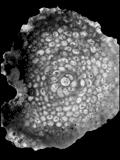 Abstract: The new larger
benthic foraminifer, Hanovolepidina
browni gen. nov. sp. nov., is described from the Chapelton Formation (mid-Lutetian, middle Eocene, ABZ7) of Jamaica. The genus shows the characteristic
transition from a single to double equatorial layer about mid-way across the
radius as seen in axial sections that characterises the family Pseudolepidinidae.
Equatorial sections show the embryo followed by 4 or 5 spiral rotaliid chambers
with the last chamber giving rise to a primary spiral and secondary (counter-)
spiral of equatorial chambers. The presence of a long rotaliid stage suggests a
more primitive form that Pseudolepidina,
and Hanovolepidina gen. nov. differs
also from the latter in lacking the extra principal accessory chamber seen in
axial section. Hanovolepidina gen.
nov. is provisionally suggested as an ancestor of the late Eocene Triplalepidina.
The new discovery demonstrates a greater diversity of the family
Pseudolpeidinidae in the Caribbean that previously recorded, although
occurrences of this family are very restricted stratigraphically suggesting that
it may appear in the region due to migration events. Abstract: The new larger
benthic foraminifer, Hanovolepidina
browni gen. nov. sp. nov., is described from the Chapelton Formation (mid-Lutetian, middle Eocene, ABZ7) of Jamaica. The genus shows the characteristic
transition from a single to double equatorial layer about mid-way across the
radius as seen in axial sections that characterises the family Pseudolepidinidae.
Equatorial sections show the embryo followed by 4 or 5 spiral rotaliid chambers
with the last chamber giving rise to a primary spiral and secondary (counter-)
spiral of equatorial chambers. The presence of a long rotaliid stage suggests a
more primitive form that Pseudolepidina,
and Hanovolepidina gen. nov. differs
also from the latter in lacking the extra principal accessory chamber seen in
axial section. Hanovolepidina gen.
nov. is provisionally suggested as an ancestor of the late Eocene Triplalepidina.
The new discovery demonstrates a greater diversity of the family
Pseudolpeidinidae in the Caribbean that previously recorded, although
occurrences of this family are very restricted stratigraphically suggesting that
it may appear in the region due to migration events.
|
|
Carnets Geol., vol. 23, no. 8, p. 149-159
Online since August 27, 2023
|
|
Nomenclatural Note, p.
160
|
|
Hiatuses and redeposits in the Tithonian-Berriasian transition at Le Chouet (Les Près, La Drôme, SE France): Sedimentological and biostratigraphical implications
Bruno R.C. GRANIER, Serge FERRY & Mohamed BENZAGGAGH
| HTML  | PDF
| PDF  [4,420 KB]
| DOI: 10.2110/carnets.2023.2307 [4,420 KB]
| DOI: 10.2110/carnets.2023.2307
|
|
 Abstract: Our new study of the Tithonian and lower Berriasian
succession of Le Chouet (Les Près, La Drôme, France) better characterizes the
lithological succession, the macro- and microfacies, and the stratigraphic
ranges of some microfossils mostly calibrated on the calpionellid biozonation.
On the lithological side, the Tithonian strata are dominantly characterized by
thick-bedded breccias representing debris flows and related calciturbidites
whereas the Berriasian strata are typically white limestones that also comprises
scattered intercalations of thin-bedded breccias and calciturbitides (including
cryptic mud calciturbidites). In thin sections, these white limestones display
mud- to wackestone textures and their allochems are mostly tiny bioclasts (e.g.,
radiolarians, calpionellids, saccocomids). Breccias are lithoclastic rudstones
and/or floatstones with a matrix similar to the calciturbidites. Their
lithoclasts are either extraclasts sensu stricto (i.e., material
derived from updip shallow-water areas) or pseudointraclasts, representing
reworked subautochthonous material (i.e., mud- and wackestone lithoclasts
with radiolarians, saccocomids and/or calpionellids). In addition to the
erosional features observed at the bases of the gravity flows, these
pseudointraclasts document the intensity of submarine erosion. Locally they help
to estimate the depths of erosion updip of the deposit. A number of bioclasts
are reworked from updip shallow-water areas; among them, it is worth mentioning
the foraminifer Protopeneroplis ultragranulata (Gorbatchik), the
first occurrence of which is dated to late early Tithonian. Saccocomids are part
of the dominating pelagic biota reported from the lower and lower upper
Tithonian interval whereas calpionellids replace them in the uppermost Tithonian
to lower Berriasian interval. Intervals with saccocomids characteristic of zones
4-5 and zones 6-7 are respectively ascribed here to the lower Tithonian (4-5)
and pro parte to the upper Tithonian (6-7). The biozonation of the calpionellid group sensu
lato allows identification of the Boneti Subzone of the chitinoidellids, the
Crassicollaria Zone with its four subzones (A0-A3), and the Alpina Zone with its
first subzone (B1). On the basis of biostratigraphical and sedimentological data
(including the rates of sedimentation), most zonal boundaries are located at the
erosional bases of breccia or turbidite layers and thus coincide with hiatuses. Abstract: Our new study of the Tithonian and lower Berriasian
succession of Le Chouet (Les Près, La Drôme, France) better characterizes the
lithological succession, the macro- and microfacies, and the stratigraphic
ranges of some microfossils mostly calibrated on the calpionellid biozonation.
On the lithological side, the Tithonian strata are dominantly characterized by
thick-bedded breccias representing debris flows and related calciturbidites
whereas the Berriasian strata are typically white limestones that also comprises
scattered intercalations of thin-bedded breccias and calciturbitides (including
cryptic mud calciturbidites). In thin sections, these white limestones display
mud- to wackestone textures and their allochems are mostly tiny bioclasts (e.g.,
radiolarians, calpionellids, saccocomids). Breccias are lithoclastic rudstones
and/or floatstones with a matrix similar to the calciturbidites. Their
lithoclasts are either extraclasts sensu stricto (i.e., material
derived from updip shallow-water areas) or pseudointraclasts, representing
reworked subautochthonous material (i.e., mud- and wackestone lithoclasts
with radiolarians, saccocomids and/or calpionellids). In addition to the
erosional features observed at the bases of the gravity flows, these
pseudointraclasts document the intensity of submarine erosion. Locally they help
to estimate the depths of erosion updip of the deposit. A number of bioclasts
are reworked from updip shallow-water areas; among them, it is worth mentioning
the foraminifer Protopeneroplis ultragranulata (Gorbatchik), the
first occurrence of which is dated to late early Tithonian. Saccocomids are part
of the dominating pelagic biota reported from the lower and lower upper
Tithonian interval whereas calpionellids replace them in the uppermost Tithonian
to lower Berriasian interval. Intervals with saccocomids characteristic of zones
4-5 and zones 6-7 are respectively ascribed here to the lower Tithonian (4-5)
and pro parte to the upper Tithonian (6-7). The biozonation of the calpionellid group sensu
lato allows identification of the Boneti Subzone of the chitinoidellids, the
Crassicollaria Zone with its four subzones (A0-A3), and the Alpina Zone with its
first subzone (B1). On the basis of biostratigraphical and sedimentological data
(including the rates of sedimentation), most zonal boundaries are located at the
erosional bases of breccia or turbidite layers and thus coincide with hiatuses.
|
|
Carnets Geol., vol. 23, no. 7, p. 123-147
Online since June 27, 2023
|
|
Gzhelian (latest Carboniferous) Pseudoacutella partoazari foraminiferal assemblage from the Tabas Block (Central Iran)
Hamed YARAHMADZAHI & Daniel VACHARD
| HTML  | PDF
| PDF  [1,906 KB]
| DOI: 10.2110/carnets.2023.2306 [1,906 KB]
| DOI: 10.2110/carnets.2023.2306
|
|
 Abstract: A foraminiferal assemblage is reported from the Zaladou Formation in the Tabas
Block (Shishtu Section), Central Iran. This assemblage comprises 16 species
belonging to 14 genera, and encompasses the fusulinids Pseudoacutella
partoazari, Grovesella tabasensis, Gr. aff. australis, Gr.
sphaerica, Gr. sphaerica var. quadrata, Gr.
cf. staffelloides, Schubertina sp., Schubertella sp., and
the smaller foraminifers Eotuberitina sp., Lasiodiscus tenuis, Raphconilia
cf. minor, R. multihelicis, R. modificata, Tetrataxis
cf. parviconica, Globivalvulina ex gr. bulloides, Gl. graeca, Calcivertella heathi, Tansillites
sp., Palaeonubecularia? sp., Hemigordiellina sp., Nodosinelloides
longa, and N. longissima. The age of this assemblage is
considered to be Gzhelian. The assemblage is dominated by the fusulinid Pseudoacutella
partoazari with a low total diversity of smaller foraminifers. This
assemblage is compared to similar assemblages in other parts of Iran and well as
the USA. An evolutionary lineage of Pseudoacutella partoazari is
also proposed. It is confirmed that Pseudonovella differs from Pseudoacutella
by the periphery rounded-carinate (carinate in Pseudoacutella),
pseudochomata less developed, and the type of coiling (Pseudoacutella is
truly planispiral involute). Pseudonovella is suggested here as the
ancestor of Pseudoacutella. This assemblage bears one unusual attribute,
the overwhelming dominance of the fusulinid Pseudoacutella and the
relatively low total diversity, compared with similar foraminifera from Alborz,
Sanandaj-Sirjan, Sabzevar and central Iran, which present warm and humid
conditions during the Late Carboniferous. Abstract: A foraminiferal assemblage is reported from the Zaladou Formation in the Tabas
Block (Shishtu Section), Central Iran. This assemblage comprises 16 species
belonging to 14 genera, and encompasses the fusulinids Pseudoacutella
partoazari, Grovesella tabasensis, Gr. aff. australis, Gr.
sphaerica, Gr. sphaerica var. quadrata, Gr.
cf. staffelloides, Schubertina sp., Schubertella sp., and
the smaller foraminifers Eotuberitina sp., Lasiodiscus tenuis, Raphconilia
cf. minor, R. multihelicis, R. modificata, Tetrataxis
cf. parviconica, Globivalvulina ex gr. bulloides, Gl. graeca, Calcivertella heathi, Tansillites
sp., Palaeonubecularia? sp., Hemigordiellina sp., Nodosinelloides
longa, and N. longissima. The age of this assemblage is
considered to be Gzhelian. The assemblage is dominated by the fusulinid Pseudoacutella
partoazari with a low total diversity of smaller foraminifers. This
assemblage is compared to similar assemblages in other parts of Iran and well as
the USA. An evolutionary lineage of Pseudoacutella partoazari is
also proposed. It is confirmed that Pseudonovella differs from Pseudoacutella
by the periphery rounded-carinate (carinate in Pseudoacutella),
pseudochomata less developed, and the type of coiling (Pseudoacutella is
truly planispiral involute). Pseudonovella is suggested here as the
ancestor of Pseudoacutella. This assemblage bears one unusual attribute,
the overwhelming dominance of the fusulinid Pseudoacutella and the
relatively low total diversity, compared with similar foraminifera from Alborz,
Sanandaj-Sirjan, Sabzevar and central Iran, which present warm and humid
conditions during the Late Carboniferous.
|
|
Carnets Geol., vol. 23, no. 6, p. 107-122
Online since June 30, 2023
|
|
The first record of Middle Jurassic serpulids from SE Turkey, equatorial Tethys
Olev VINN & İzzet HOŞGÖR
| HTML  | PDF
| PDF  [846 KB]
| DOI: 10.2110/carnets.2023.2305 [846 KB]
| DOI: 10.2110/carnets.2023.2305
|
|
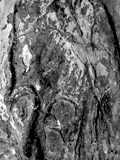 Abstract: The
Jurassic platform margin succession in the Hezan area, called the "Hezan
Unit" (Diyarbakır), on the north of the Arabian platform in southeastern
Turkey includes five formations of carbonate-dominated rocks. The most
interesting is the upper part of the Hezan unit (the Kuran Formation) that
contains unique layers of oolitic and clayey limestone. A first record of the calcareous
polychaete tubeworm Propomatoceros
lumbricalis is described from the Middle Jurassic
lower part of the Kuran Formation of the Hezan area. Most knowledge of fossil
serpulids is centered on European material, and little has been done on Middle
East fossil calcareous tubes. The taxonomic information recorded as a result of
this study will add to our understanding of the biogeographic history of the Middle
Jurassic calcareous polychaete associations and help to
interpret the structure and paleoecology of its marine communities. Abstract: The
Jurassic platform margin succession in the Hezan area, called the "Hezan
Unit" (Diyarbakır), on the north of the Arabian platform in southeastern
Turkey includes five formations of carbonate-dominated rocks. The most
interesting is the upper part of the Hezan unit (the Kuran Formation) that
contains unique layers of oolitic and clayey limestone. A first record of the calcareous
polychaete tubeworm Propomatoceros
lumbricalis is described from the Middle Jurassic
lower part of the Kuran Formation of the Hezan area. Most knowledge of fossil
serpulids is centered on European material, and little has been done on Middle
East fossil calcareous tubes. The taxonomic information recorded as a result of
this study will add to our understanding of the biogeographic history of the Middle
Jurassic calcareous polychaete associations and help to
interpret the structure and paleoecology of its marine communities.
|
|
Carnets Geol., vol. 23, no. 5, p. 97-105
Online since June 30, 2023
|
|
Upper Triassic (Norian-Rhaetian) Foraminifera from the Nayband Formation of the Lut Block (Garm Ab section, Northeast Iran)
Fatemeh AMIRHASSANKHANI, Baba SENOWBARI-DARYAN & Koorosh RASHIDI
| HTML  | PDF
| PDF  [3,997 KB]
| DOI: 10.2110/carnets.2023.2304
[3,997 KB]
| DOI: 10.2110/carnets.2023.2304
|
|
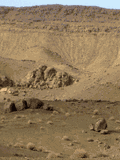 Abstract: Studies of Nayband Formation from the Garm Ab
section in Lut Block in Central Iran led to the identification of 26
foraminiferal taxa. Nine species are reported from Iran for the first time: Involutina ex
gr. liassica (Jones),
Involutina sp., Lamelliconus permodiscoides (Oberhauser),
Palaeolituonella cf. meridionalis (Luperto), Palaeolituonella
cf. angulata Senowbari-Daryan & Cacciatore, Gaudryinella
cf. kotlensis Trifonova, Ammobaculites eumorphos Kristan-Tollmann,
Frondicularia rhaetica Kristan-Tollmann, Frondicularia cf.
xiphoidea Kristan-Tollmann, and Orthotrinacria ? expansa
(Zaninetti et al.). The taxa
restrict the Upper Triassic interval to probably just the Rhaetian. Based
on the foraminifera and their abundance, three different association-types could
be distinguished, i.e., the Decapoalina schaeferae-Miliolipora
cuvillieri, Trocholina turris-Agathammina
iranica and Involutina ex gr. liassica-Trocholina
umbo associations. Comparisons of
foraminiferal associations in different parts of central Iran, such as 1)
Hassan Abad section, SW of Ferdows in Lut Block, 2) the type locality of the
Nayband Formation in Tabas Block, NE of Esfahan in the eastern part of Central
Domain Block, and 3) the Garm Ab section in Lut Block, indicate
that the hyaline foraminifers are most abundant in the Garm Ab. Besides, in
the Lut Block, the reef environments in the Garm Ab section are deeper water
than those of the Hassan Abad section. The association of Trocholina
umbo with Miliolipora cuvillieri is similar to the foraminiferal
association from the NE of Esfahan and shows similar conditions in Lut Block and
Central Domain Block. The two assemblages of hyaline foraminifers, especially
the new report of Involutina and Trocholina, prove to be Rhaetian in
age. Abstract: Studies of Nayband Formation from the Garm Ab
section in Lut Block in Central Iran led to the identification of 26
foraminiferal taxa. Nine species are reported from Iran for the first time: Involutina ex
gr. liassica (Jones),
Involutina sp., Lamelliconus permodiscoides (Oberhauser),
Palaeolituonella cf. meridionalis (Luperto), Palaeolituonella
cf. angulata Senowbari-Daryan & Cacciatore, Gaudryinella
cf. kotlensis Trifonova, Ammobaculites eumorphos Kristan-Tollmann,
Frondicularia rhaetica Kristan-Tollmann, Frondicularia cf.
xiphoidea Kristan-Tollmann, and Orthotrinacria ? expansa
(Zaninetti et al.). The taxa
restrict the Upper Triassic interval to probably just the Rhaetian. Based
on the foraminifera and their abundance, three different association-types could
be distinguished, i.e., the Decapoalina schaeferae-Miliolipora
cuvillieri, Trocholina turris-Agathammina
iranica and Involutina ex gr. liassica-Trocholina
umbo associations. Comparisons of
foraminiferal associations in different parts of central Iran, such as 1)
Hassan Abad section, SW of Ferdows in Lut Block, 2) the type locality of the
Nayband Formation in Tabas Block, NE of Esfahan in the eastern part of Central
Domain Block, and 3) the Garm Ab section in Lut Block, indicate
that the hyaline foraminifers are most abundant in the Garm Ab. Besides, in
the Lut Block, the reef environments in the Garm Ab section are deeper water
than those of the Hassan Abad section. The association of Trocholina
umbo with Miliolipora cuvillieri is similar to the foraminiferal
association from the NE of Esfahan and shows similar conditions in Lut Block and
Central Domain Block. The two assemblages of hyaline foraminifers, especially
the new report of Involutina and Trocholina, prove to be Rhaetian in
age.
|
|
Carnets Geol., vol. 23, no. 4, p. 77-95
Online since April 1, 2023
|
|
Late Miocene biostratigraphy and paleoenvironment of
the Sais Basin (southern Rifian Corridor, Morocco): New insights from the
Moulay Yakoub area
Soukaina TARGHI, Nadia BARHOUN, Naima BACHIRI TAOUFIQ, Mohamed ACHAB, Rachid ESSAMOUD, Hanane BAHAJ, Jihad RAHMOUNA & Naima BERRY
| HTML  | PDF
| PDF  [1,318 KB]
| DOI: 10.2110/carnets.2023.2303
[1,318 KB]
| DOI: 10.2110/carnets.2023.2303
|
|
 Abstract: During the Late Miocene, the Rifian Corridor was one of the two main corridors allowing exchanges between the Atlantic and the Mediterranean Seas. Sedimentary records
accumulated along this corridor and specifically, in the Sais Basin, constitute case-study material for understanding the impact of the South Rifian Corridor on the evolution of the fauna, phytoplankton and environment during the Late Miocene. In order to reconstruct the evolution of marine paleoenvironments in the Moulay Yakoub region and to compare this evolution with other areas of the Sais basin, we conducted an integrated biostratigraphic and palynological study of the Upper Miocene of
borehole KA 102. High-resolution biostratigraphy based on planktonic foraminifera revised and defined the chronostratigraphic framework of the
Upper Miocene sedimentary series of the Moulay Yakoub region providing an age of 7.8 Ma to 6.52 Ma (Late Tortonian to Early Messinian). In the Late Tortonian, the planktonic foraminiferal assemblages suggest an open and relatively deep marine environment. At the
Tortonian/Messinian boundary, planktonic foraminiferal and dinoflagellate associations, as well as distal indices, suggest a relatively deep and neritic distal marine environment with a decrease in diversity and an increase in reworked taxa. Surface waters are warm with a minor cooling trend observed just below this boundary. In comparison to previously studied sections in the Sais Basin, the Lower Messinian is characterized by a deeper and more distal marine environment. However, proximal trends and warm surface water conditions persisted in all studied areas from the basin during this period. Abstract: During the Late Miocene, the Rifian Corridor was one of the two main corridors allowing exchanges between the Atlantic and the Mediterranean Seas. Sedimentary records
accumulated along this corridor and specifically, in the Sais Basin, constitute case-study material for understanding the impact of the South Rifian Corridor on the evolution of the fauna, phytoplankton and environment during the Late Miocene. In order to reconstruct the evolution of marine paleoenvironments in the Moulay Yakoub region and to compare this evolution with other areas of the Sais basin, we conducted an integrated biostratigraphic and palynological study of the Upper Miocene of
borehole KA 102. High-resolution biostratigraphy based on planktonic foraminifera revised and defined the chronostratigraphic framework of the
Upper Miocene sedimentary series of the Moulay Yakoub region providing an age of 7.8 Ma to 6.52 Ma (Late Tortonian to Early Messinian). In the Late Tortonian, the planktonic foraminiferal assemblages suggest an open and relatively deep marine environment. At the
Tortonian/Messinian boundary, planktonic foraminiferal and dinoflagellate associations, as well as distal indices, suggest a relatively deep and neritic distal marine environment with a decrease in diversity and an increase in reworked taxa. Surface waters are warm with a minor cooling trend observed just below this boundary. In comparison to previously studied sections in the Sais Basin, the Lower Messinian is characterized by a deeper and more distal marine environment. However, proximal trends and warm surface water conditions persisted in all studied areas from the basin during this period.
|
|
Carnets Geol., vol. 23, no. 3, p. 53-75
Online since April 1, 2023
|
|
Peculiar tube-like bivalve with densely packed concave tabulae (Štramberk Limestone, Tithonian-Berriasian)
Olev VINN, Bogusław KOŁODZIEJ & Zuzana KOZLOVÁ
| HTML  | PDF
| PDF  [1,263 KB]
| DOI: 10.2110/carnets.2023.2302 [1,263 KB]
| DOI: 10.2110/carnets.2023.2302
|
|
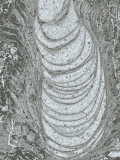 Abstract: The fossils described here are from the Tithonian-lower Berriasian Štramberk
Limestone of the Czech Republic. The specimens consist of densely packed,
straight to slightly curved short tubes. Each tube is composed of a single valve
rather than two valves. Some tubes show constrictions in the wall, generally
on just one side. The lumen is almost completely filled with numerous densely
packed slightly to strongly concave tabulae. In some tubes, the tabulae form
complete internal floors while in others they connect to the wall with another
tabula or seal the concavity in the underlying tabula. The tubes somewhat
resemble tubeworms, rudists, vermetids and calcareous algae. However, based on
morphological similarities such as the tube-like morphology in longitudinal
section and the shapes of the lamellae and tabulae, these tubes resemble oysters
described from the Albian of Brazil. Accordingly, we infer that the Štramberk
tubes represent oysters or oyster-related bivalves. Abstract: The fossils described here are from the Tithonian-lower Berriasian Štramberk
Limestone of the Czech Republic. The specimens consist of densely packed,
straight to slightly curved short tubes. Each tube is composed of a single valve
rather than two valves. Some tubes show constrictions in the wall, generally
on just one side. The lumen is almost completely filled with numerous densely
packed slightly to strongly concave tabulae. In some tubes, the tabulae form
complete internal floors while in others they connect to the wall with another
tabula or seal the concavity in the underlying tabula. The tubes somewhat
resemble tubeworms, rudists, vermetids and calcareous algae. However, based on
morphological similarities such as the tube-like morphology in longitudinal
section and the shapes of the lamellae and tabulae, these tubes resemble oysters
described from the Albian of Brazil. Accordingly, we infer that the Štramberk
tubes represent oysters or oyster-related bivalves.
|
|
Carnets Geol., vol. 23, no. 2, p. 43-51
Online since February 15, 2023
|
|
Issues in the identification of the Aptian/Albian boundary in South Atlantic basins and beyond
Ricardo L.M. AZEVEDO, Rogério L. ANTUNES & Mauro D.R. BRUNO
| HTML  | PDF
| PDF  [2,009 KB]
| DOI: 10.2110/carnets.2023.2301 [2,009 KB]
| DOI: 10.2110/carnets.2023.2301
|
|
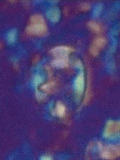 Abstract: The use of taxonomic-phylogenetic criteria established for planktonic foraminifera in the
2000's and the definition of the Albian Global Stratotype Section Point (GSSP-Alb) have resulted in a major change in the interpretation of the carbonate sections overlying the giant layer of salt present in basins of the South Central Atlantic (CSA) and their equivalent strata in the Equatorial South Atlantic
(ESA), and interior of northeastern Brazil (BNE). These post-salt carbonates have long been considered Albian in age, but they contain a planktonic foraminifera association characteristically Aptian. Great conflicts arise, however, when this faunal association is compared with biostratigraphic successions based on other fossil groups or with lithostratigraphic and geochronological data. Controversies similar to those observed at sites 363 and 364 of the Deep Sea Drilling Project (DSDP) leg 40, drilled almost 45 years ago, have resurfaced. Thus, it is paradoxical that the remarkable disappearance of large species of planktonic foraminifera, associated with the top of the Paraticinella rohri
Zone (of the upper Aptian), occurred stratigraphically above a typical Albian calcareous nannofossil
succession (as the First Stratigraphic Occurrences of Hayesites albiensis, Tranolithus orionatus, Axopodorhabdus biramiculatus, and Eiffellithus turriseiffelli)
or the FOs of three known species of pelagic calcispheres, all assumed to be of Albian
age. Another notorious conflict lies in the fact that these carbonates rest directly on the salt layer onlapping the South Atlantic Middle Barrier
(SAMB), where trachyandesite has been dated at 113.2 ± 0.1 Ma, identical to the value established for the GSSP-Alb. Detailed examination of 16 stratigraphic sections from around the world shows that the difficulties of fully applying the GSSP-Alb criteria are not limited to the CSA,
ESA, and BNE basins. The explanation of these controversies may lie in the specific conditions of the water mass of the primitive South Atlantic that may have influenced morphological alterations or affected the temporal amplitude of taxa. But until geochronological,
biostratigraphic, and lithostratigraphic incompatibilities can be clarified, it is here recommended to use the base of the evaporitic layer as the reference for the Aptian/Albian transition in CSA,
ESA, and BNE basins. Abstract: The use of taxonomic-phylogenetic criteria established for planktonic foraminifera in the
2000's and the definition of the Albian Global Stratotype Section Point (GSSP-Alb) have resulted in a major change in the interpretation of the carbonate sections overlying the giant layer of salt present in basins of the South Central Atlantic (CSA) and their equivalent strata in the Equatorial South Atlantic
(ESA), and interior of northeastern Brazil (BNE). These post-salt carbonates have long been considered Albian in age, but they contain a planktonic foraminifera association characteristically Aptian. Great conflicts arise, however, when this faunal association is compared with biostratigraphic successions based on other fossil groups or with lithostratigraphic and geochronological data. Controversies similar to those observed at sites 363 and 364 of the Deep Sea Drilling Project (DSDP) leg 40, drilled almost 45 years ago, have resurfaced. Thus, it is paradoxical that the remarkable disappearance of large species of planktonic foraminifera, associated with the top of the Paraticinella rohri
Zone (of the upper Aptian), occurred stratigraphically above a typical Albian calcareous nannofossil
succession (as the First Stratigraphic Occurrences of Hayesites albiensis, Tranolithus orionatus, Axopodorhabdus biramiculatus, and Eiffellithus turriseiffelli)
or the FOs of three known species of pelagic calcispheres, all assumed to be of Albian
age. Another notorious conflict lies in the fact that these carbonates rest directly on the salt layer onlapping the South Atlantic Middle Barrier
(SAMB), where trachyandesite has been dated at 113.2 ± 0.1 Ma, identical to the value established for the GSSP-Alb. Detailed examination of 16 stratigraphic sections from around the world shows that the difficulties of fully applying the GSSP-Alb criteria are not limited to the CSA,
ESA, and BNE basins. The explanation of these controversies may lie in the specific conditions of the water mass of the primitive South Atlantic that may have influenced morphological alterations or affected the temporal amplitude of taxa. But until geochronological,
biostratigraphic, and lithostratigraphic incompatibilities can be clarified, it is here recommended to use the base of the evaporitic layer as the reference for the Aptian/Albian transition in CSA,
ESA, and BNE basins.
|
|
Carnets Geol., vol. 23, no. 1, p. 1-42
Online since January 1, 2023
|

|
|
2022 (vol. 22)
|
|
New larger benthic foraminifera from the subsurface Lower
to Middle Eocene Oldsmar Formation of southeastern Florida (USA)
Edward ROBINSON & Kevin J. CUNNINGHAM
| HTML  | PDF
| PDF  [1.719 KB]
| DOI: 10.2110/carnets.2022.2221
[1.719 KB]
| DOI: 10.2110/carnets.2022.2221
|
|
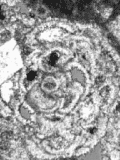 Abstract: We describe two larger benthic foraminiferal taxa collected from wells drilled in the subsurface Eocene rocks of southeastern Florida that are new to peninsular Florida and the Caribbean region. Saudia floridana
n.sp. is characteristic of a foraminiferal assemblage, along with Helicostegina gyralis, wide forms of the Cushmania americana group, and Gunteria floridana, in an upper part of the Oldsmar Formation. Globogypsinoides browardensis
n.gen. n.sp. occurs in a second foraminiferal assemblage, along with Borelis cf. floridanus, Coskinolina cf. yucatanensis, and as-yet undescribed large
rotaliids, in a middle part of the Oldsmar Formation. The foraminiferal assemblage of the middle Oldsmar unit is
ascribed an Ypresian age and the assemblage of the upper Oldsmar unit a Lutetian age. These two assemblages indicate inner shelf water depths of 40 m or less on the Florida Platform during the Early to Middle Eocene deposition of the middle to upper part of the Oldsmar Formation. Abstract: We describe two larger benthic foraminiferal taxa collected from wells drilled in the subsurface Eocene rocks of southeastern Florida that are new to peninsular Florida and the Caribbean region. Saudia floridana
n.sp. is characteristic of a foraminiferal assemblage, along with Helicostegina gyralis, wide forms of the Cushmania americana group, and Gunteria floridana, in an upper part of the Oldsmar Formation. Globogypsinoides browardensis
n.gen. n.sp. occurs in a second foraminiferal assemblage, along with Borelis cf. floridanus, Coskinolina cf. yucatanensis, and as-yet undescribed large
rotaliids, in a middle part of the Oldsmar Formation. The foraminiferal assemblage of the middle Oldsmar unit is
ascribed an Ypresian age and the assemblage of the upper Oldsmar unit a Lutetian age. These two assemblages indicate inner shelf water depths of 40 m or less on the Florida Platform during the Early to Middle Eocene deposition of the middle to upper part of the Oldsmar Formation.
|
|
Carnets Geol., vol. 22, no. 21, p. 857-865
Online since December 25, 2022
|
|
Nomenclatural Note, p.
866
|
|
Just a different place to graze? An unusual occurrence of the echinoid
feeding trace Gnathichnus pentax on a marine vertebrate coprolite (Miocene,
Italy) and its palaeoethological implications
Alberto COLLARETA, Emanuele PERI, Stephen J. GODFREY & Giovanni BIANUCCI
| HTML  | PDF
| PDF  [486 KB]
| DOI: 10.2110/carnets.2022.2220
[486 KB]
| DOI: 10.2110/carnets.2022.2220
|
|
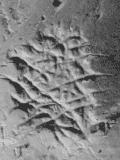 Abstract: Faeces produced by marine vertebrates and
macro-invertebrates contain sufficient organic matter to represent a usable food
source for a wide array of macroscopic animals. In some extant marine
environments, coprophagy even represents a crucial trophic interaction in food
webs. In ancient ecosystems, coprophagy by macroscopic animals is occasionally
exemplified by coprolites that exhibit biting traces or burrows. Here, we report
Gnathichnus pentax on an exquisitely preserved vertebrate-bitten vertebrate
coprolite from the marine calcareous deposits of the Pietra leccese (Miocene,
southern Italy). This unusual occurrence is interpreted as evidence of the
feeding activity of a regular echinoid; in particular, it may represent either
exploratory coprophagy or the browsing of an algal (microbial) film that locally
developed on the exterior of the faeces. Strengthening the former interpretation,
the development of microbial communities on submerged faeces often leads to
their destruction; furthermore, some extant Antarctic echinoderms are well known
to ordinarily feed on vertebrate faeces, and coprophagy is believed to be fairly
widespread among sea urchins. Supporting the algal browsing hypothesis, in turn,
only a limited area of the external surface of the faeces was subject to grazing,
and the resulting trace is neatly defined, which suggest that the feeding sea
urchin targeted a precise location on the dung's exterior when the latter was
already rather firm. To our knowledge, the G. pentax
specimen studied here represents the first published record of this ichnotaxon
on a coprolite. Abstract: Faeces produced by marine vertebrates and
macro-invertebrates contain sufficient organic matter to represent a usable food
source for a wide array of macroscopic animals. In some extant marine
environments, coprophagy even represents a crucial trophic interaction in food
webs. In ancient ecosystems, coprophagy by macroscopic animals is occasionally
exemplified by coprolites that exhibit biting traces or burrows. Here, we report
Gnathichnus pentax on an exquisitely preserved vertebrate-bitten vertebrate
coprolite from the marine calcareous deposits of the Pietra leccese (Miocene,
southern Italy). This unusual occurrence is interpreted as evidence of the
feeding activity of a regular echinoid; in particular, it may represent either
exploratory coprophagy or the browsing of an algal (microbial) film that locally
developed on the exterior of the faeces. Strengthening the former interpretation,
the development of microbial communities on submerged faeces often leads to
their destruction; furthermore, some extant Antarctic echinoderms are well known
to ordinarily feed on vertebrate faeces, and coprophagy is believed to be fairly
widespread among sea urchins. Supporting the algal browsing hypothesis, in turn,
only a limited area of the external surface of the faeces was subject to grazing,
and the resulting trace is neatly defined, which suggest that the feeding sea
urchin targeted a precise location on the dung's exterior when the latter was
already rather firm. To our knowledge, the G. pentax
specimen studied here represents the first published record of this ichnotaxon
on a coprolite.
|
|
Carnets Geol., vol. 22, no. 20, p. 847-855
Online since December 25, 2022
|
|
Miocene-Holocene paleoenvironmental changes in the Tinto River estuary (SW Spain) evidenced by
sedimentology, geochemistry and fauna
Manuel ABAD, Marta ARROYO, Francisco RUIZ, María Luz GONZÁLEZ-REGALADO, Joaquín RODRÍGUEZ VIDAL, Luis Miguel CÁCERES, Tatiana IZQUIERDO, Antonio TOSCANO, Paula GÓMEZ, Gabriel GÓMEZ & Verónica ROMERO
| HTML  | PDF
| PDF  [1,307 KB]
| DOI: 10.2110/carnets.2022.2219
[1,307 KB]
| DOI: 10.2110/carnets.2022.2219
|
|
 Abstract: This
paper investigates the paleoenvironmental evolution of a long core extracted in
a small cove located in the Tinto-Odiel estuary (SW Spain). The
inferred reconstruction is supported by sedimentological, geochemical,
paleontological data and dating. Seven phases have been identified, with the transit
from Late Neogene marine environments to a subrecent freshwater pond and
a final anthropic filling. On the basis of these data, this area was flooded during
the maximum of the MIS-1 transgression (6.5-5.2 cal. kyr BP), with the temporary
presence of a subtidal channel with phanerogam meadows. During this evolution,
three geochemical peaks have been detected, which correspond to 1) the first
evidence of mining activities (~4.5 cal. kyr BP), 2) an interval of intensive
mining (1850-1960) and 3) an industrial period (1966-1985), affected by the dumping of highly polluting waste into this estuary. Abstract: This
paper investigates the paleoenvironmental evolution of a long core extracted in
a small cove located in the Tinto-Odiel estuary (SW Spain). The
inferred reconstruction is supported by sedimentological, geochemical,
paleontological data and dating. Seven phases have been identified, with the transit
from Late Neogene marine environments to a subrecent freshwater pond and
a final anthropic filling. On the basis of these data, this area was flooded during
the maximum of the MIS-1 transgression (6.5-5.2 cal. kyr BP), with the temporary
presence of a subtidal channel with phanerogam meadows. During this evolution,
three geochemical peaks have been detected, which correspond to 1) the first
evidence of mining activities (~4.5 cal. kyr BP), 2) an interval of intensive
mining (1850-1960) and 3) an industrial period (1966-1985), affected by the dumping of highly polluting waste into this estuary.
|
|
Carnets Geol., vol. 22, no. 19, p. 825-845
Online since December 25, 2022
|
|
Pliocene bivalves (Pteriomorphia) of Algiers Sahel (Algeria): Systematics and palaeoecology
Sabiha TALMAT, Madani BENYOUCEF, Bruno FERRÉ, Sabrina BOUZEGUELLA & Fatma-Zohra OUCHENE
| HTML  | PDF
| PDF  [2,394 KB]
| DOI: 10.2110/carnets.2022.2218
[2,394 KB]
| DOI: 10.2110/carnets.2022.2218
|
|
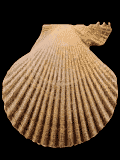 Abstract: A hundred specimens of pteriomorph bivalves
were collected from the marine deposits of the marly-sandy formations of Algiers
Sahel, which correspond to transitional facies between the Piacenzian deep marly
deposits and the Astian molassic deposits. They are herein analysed from a
systematic, taphonomic, palaeoecological and paleoenvironmental point of view.
The preliminary inventory list consists of 27 species belonging to eight
families: Arcidae, Nuculidae, Glycymeridae, Spondylidae, Pectinidae,
Plicatulidae, Gryphaeidae, and Ostreidae. Two sedimentary units with different
bivalve biodiversity are recognized: the first: a shallow infralittoral unit
characterised by large Flabellipecten alessii, Aequipecten angelonii,
Ostrea lamellosa and O. edulis; the second: A deeper unit of
circalittoral environment mainly includes Amusium cristatum. These
bivalve shells display sclerobiont traces. Bioerosion traces are mostly
assignable to clionid sponges (Entobia isp.), polychaete worms (Maeandropolydora
isp. and Caulostrepsis isp.), bivalves (Gastrochaenolites isp.)
and predatory gastropods (Oichnus isp.). Identified encrusting organisms
are juvenile oyster shells, cirripedes, polychaete worms (serpulids), and
indeterminate bryozoans. Analysis of boring and encrusting traces indicate a
progressive environmental change from a relative high energy setting to a lower
energy and deeper water setting, and correspond to a shallow sea with
well-oxygenated waters. Abstract: A hundred specimens of pteriomorph bivalves
were collected from the marine deposits of the marly-sandy formations of Algiers
Sahel, which correspond to transitional facies between the Piacenzian deep marly
deposits and the Astian molassic deposits. They are herein analysed from a
systematic, taphonomic, palaeoecological and paleoenvironmental point of view.
The preliminary inventory list consists of 27 species belonging to eight
families: Arcidae, Nuculidae, Glycymeridae, Spondylidae, Pectinidae,
Plicatulidae, Gryphaeidae, and Ostreidae. Two sedimentary units with different
bivalve biodiversity are recognized: the first: a shallow infralittoral unit
characterised by large Flabellipecten alessii, Aequipecten angelonii,
Ostrea lamellosa and O. edulis; the second: A deeper unit of
circalittoral environment mainly includes Amusium cristatum. These
bivalve shells display sclerobiont traces. Bioerosion traces are mostly
assignable to clionid sponges (Entobia isp.), polychaete worms (Maeandropolydora
isp. and Caulostrepsis isp.), bivalves (Gastrochaenolites isp.)
and predatory gastropods (Oichnus isp.). Identified encrusting organisms
are juvenile oyster shells, cirripedes, polychaete worms (serpulids), and
indeterminate bryozoans. Analysis of boring and encrusting traces indicate a
progressive environmental change from a relative high energy setting to a lower
energy and deeper water setting, and correspond to a shallow sea with
well-oxygenated waters.
|
|
Carnets Geol., vol. 22, no. 18, p. 795-824
Online since December 25, 2022
|
|
Calcareous nannofossils of the uppermost Bedoulian and lower Gargasian of La Tuilière - St-Saturnin-lès-Apt (area of the Aptian stratotype, Vaucluse, SE France)
Bernard C. LAMBERT
| HTML  | PDF
| PDF  [3,071 KB]
| DOI: 10.2110/carnets.2022.2217
[3,071 KB]
| DOI: 10.2110/carnets.2022.2217
|
|
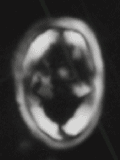 Abstract: An 148 m composite section located in the Gargas area
stratotype in southeastern France has been studied for its calcareous
nannofossil content. The four sections span the upper Bedoulian to lower
Gargasian with the stadial boundary located within the basal section south of
the village of Clavaillan. A total of 75 samples was processed to inventory
taxonomy and stratigraphic distributions. Abstract: An 148 m composite section located in the Gargas area
stratotype in southeastern France has been studied for its calcareous
nannofossil content. The four sections span the upper Bedoulian to lower
Gargasian with the stadial boundary located within the basal section south of
the village of Clavaillan. A total of 75 samples was processed to inventory
taxonomy and stratigraphic distributions.
Eprolithus floralis is present at the base of the stratigraphic succession. The lowest
occurrence of this species, which marks the base of Subzone NC7A, has been
documented in the uppermost lower Aptian (Bedoulian) in other sections in
southeastern France. The highest occurrence of the genus Micrantholithus
has been utilized to delineate the base of Subzone NC7B. This subzonal boundary
was placed at 48 m in the Les Gays I section (113.5 m in the composite) below
the lowest occurrence of the foraminifer Globigerinelloides
ferreolensis in the suprajacent sample (50 m). The lowest
occurrence of Braarudosphaera africana
is identified as a regional biohorizon in lower Subzone NC7A and a local proxy
for the Bedoulian/Gargasian boundary. This event was placed at 15.5 m in the
Clavaillan section at the base of the Dufrenoyia furcata Zone and within the
"Niveau Blanc inférieur" marker bed (NB1).
The genus Nannoconus is abundant to very
abundant in all samples examined. Taxonomic rigor has resulted in the
recognition of five main morphologic groups (A-E), including all but one of the
15 species discriminated over this relatively short stratigraphic interval. Four
main Nannoconus assemblage biozones - with one subdivision - have been
distinguished through semi-quantitative analyses and organized relative to these
taxonomic groupings. Assemblage Biozone B is restricted to the Bedoulian and has
been correlated to the lower portion of Subzone NC7A
(i.e., NC7A1). Assemblage biozones GI
and GII (A-B) have been correlated to the upper portion of Subzone NC7A
(i.e., NC7A2) and Biozone GIII to
Subzone NC7B within the Gargasian.
Assipetra is another solution-resistant genus included in semi-quantitative
analyses, where both its species were separated into small and large forms based
on a size of 10 μm. The highest percentages of large morphotypes are within
the Bedoulian in the lower 10.5 m of the Clavaillan section, roughly coeval to
an acme of large Assipetra observed in the basal portion of the Serre
Chaitieu section in the nearby Vocontian Basin.
|
|
Carnets Geol., vol. 22, no. 17, p. 745-793
Online since November 11, 2022
|
|
Palaeoentomological (fossil insects) outcrops in Lebanon
Sibelle MAKSOUD, Bruno R.C. GRANIER & Dany AZAR
| HTML  | PDF
| PDF  [7,133 KB]
| DOI: 10.2110/carnets.2022.2216
[7,133 KB]
| DOI: 10.2110/carnets.2022.2216
|
|
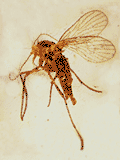 Abstract: With 35 Cretaceous outcrops yielding fossil
insects, either in amber or as rock (marls, limestones, cinerite, or dysodile)
impressions-compressions (adpressions), Lebanon has continuously contributed
significantly to the advance of palaeoentomology and to our understanding of
entomological evolution and palaeobiodiversity. Compared to its small surface
area, this country can be considered among the richest of fossil insect
outcrops. This is due to its geological history and mainly to its forest, fluvial -
lacustrine tropical and proximal marine subtropical palaeoenvironments plus
Peritethys equatorial and subequatorial palaeogeography during the Lower and
"Middle" Cretaceous. Herein, an exhaustive review of all outcrops with
insects is given. A list of all fossil insects described from Lebanon is
provided. Abstract: With 35 Cretaceous outcrops yielding fossil
insects, either in amber or as rock (marls, limestones, cinerite, or dysodile)
impressions-compressions (adpressions), Lebanon has continuously contributed
significantly to the advance of palaeoentomology and to our understanding of
entomological evolution and palaeobiodiversity. Compared to its small surface
area, this country can be considered among the richest of fossil insect
outcrops. This is due to its geological history and mainly to its forest, fluvial -
lacustrine tropical and proximal marine subtropical palaeoenvironments plus
Peritethys equatorial and subequatorial palaeogeography during the Lower and
"Middle" Cretaceous. Herein, an exhaustive review of all outcrops with
insects is given. A list of all fossil insects described from Lebanon is
provided.
|
|
Carnets Geol., vol. 22, no. 16, p. 699-743
Online since September 14, 2022
|
|
A new discoid heliolitid (Proporidae) from the Upper Ordovician of the Baltic area: Morphology and modalities of increase
Yves PLUSQUELLEC, Jaap EYZENGA & Percy S.F. van KEULEN
| HTML  | PDF
| PDF  [1,242 KB]
| DOI: 10.2110/carnets.2022.2215
[1,242 KB]
| DOI: 10.2110/carnets.2022.2215
|
|
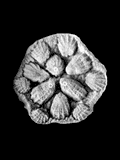 Abstract: A species of Proporidae (Heliolitida) forming very small, discoid coralla, is fully described. It is mainly preserved in natural moulds in the Öjlemyr chert, an erratic silicified limestone found in Eridanos deposits surfacing in the west and north-east of the Dutch Overijssel-province and adjoining German area, generally accepted to be Uppermost Katian. The material is assigned to the rehabilitated
Pinacopora Nicholson & Etheridge,
1878, a genus closely allied to
Propora Milne-Edwards & Haime, 1849, and a new species,
Pinacopora baltica is named. The main feature of this species, besides the characteristics of the genus and the biometric data, is the presence of wide, short, and convex septal ridges bearing scattered septal spines, alternating with narrow interseptal furrows. For the first time in heliolitids a pleurodictyoid pattern of growth is described. Only two species of
Pinacopora are recorded:
P. baltica n. sp. (Upper Ordovician) and
P. grayi Nicholson & Etheridge,
1878 (Lower Silurian), respectively from Baltica and Laurentia. Abstract: A species of Proporidae (Heliolitida) forming very small, discoid coralla, is fully described. It is mainly preserved in natural moulds in the Öjlemyr chert, an erratic silicified limestone found in Eridanos deposits surfacing in the west and north-east of the Dutch Overijssel-province and adjoining German area, generally accepted to be Uppermost Katian. The material is assigned to the rehabilitated
Pinacopora Nicholson & Etheridge,
1878, a genus closely allied to
Propora Milne-Edwards & Haime, 1849, and a new species,
Pinacopora baltica is named. The main feature of this species, besides the characteristics of the genus and the biometric data, is the presence of wide, short, and convex septal ridges bearing scattered septal spines, alternating with narrow interseptal furrows. For the first time in heliolitids a pleurodictyoid pattern of growth is described. Only two species of
Pinacopora are recorded:
P. baltica n. sp. (Upper Ordovician) and
P. grayi Nicholson & Etheridge,
1878 (Lower Silurian), respectively from Baltica and Laurentia.
|
|
Carnets Geol., vol. 22, no. 15, p. 685-698
Online since September 14, 2022
|
|
Nomenclatural Note, p.
684
|
|
Tethysian, Tethyan or ... Tethys Ocean and Tethys
Bruno GRANIER
| HTML  | PDF
| PDF  [125 KB]
| DOI: 10.2110/carnets.2022.22EN1 [125 KB]
| DOI: 10.2110/carnets.2022.22EN1
|
|
 Abstract: Tethys is a stand-alone modern noun, which does not require a qualifier in the English language. The use of the qualifiers Tethyan or Tethysian should be strongly discouraged. Taxa the names of which comprise the stem -tethy- are named after the Greek Goddess; those the names of which bear the stem -tethys- are named after the German (Suess, 1901), French (Suess, 1902) and English (Suess, 1908) Tethys Ocean. There was too much confusion on these two last points. Abstract: Tethys is a stand-alone modern noun, which does not require a qualifier in the English language. The use of the qualifiers Tethyan or Tethysian should be strongly discouraged. Taxa the names of which comprise the stem -tethy- are named after the Greek Goddess; those the names of which bear the stem -tethys- are named after the German (Suess, 1901), French (Suess, 1902) and English (Suess, 1908) Tethys Ocean. There was too much confusion on these two last points.
|
|
Thanks to our German-speaking readers (Olaf Elicki, Mike
Reich, Torsten Scheyer, Ekbert Seibertz, ...)
for having reported some grammatical errors: for instance, in the first
table, one should read "(die)
Tethys" instead of "(der) Tethys". [2022-08-12]
|
|
Carnets Geol., vol. 22, Editorial Note 1, p. 681-683
Online since August 10, 2022
|
|
The Lower Cretaceous Tuburan Limestone of Cebu Island, Philippines: Microfacies, micropalaeontology, biostratigraphy, and palaeogeographic perspectives
Jerali RODRIGO & Felix SCHLAGINTWEIT
| HTML  | PDF
| PDF  [4,570 KB]
| DOI: 10.2110/carnets.2022.2214 [4,570 KB]
| DOI: 10.2110/carnets.2022.2214
|
|
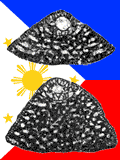 Abstract: The occurrence of orbitolinid-bearing shallow water limestone blocks
(Tuburan Limestone) incorporated into the volcanic series from
Cebu Island, Central Philippines, has been known since the 1950's. Taxonomic studies
including solid biostratigraphic data however are lacking or not substantiated.
Herein we report the occurrence of Mesorbitolina
texana (Roemer), transitional forms between M.
texana and M. subconcava (Leymerie),
Mesorbitolina birmanica (Sahni),
Palaeodictyoconus actinostoma Arnaud-Vanneau
& Schroeder, Neorbitolinopsis
conica (Matsumaru), Paracoskinolina
sp. and other benthic foraminifera (Akcaya,
Praechrysalidina, Vercorsella)
indicating a latest Aptian age. The previously accepted Late Albian age for the
Tuburan Limestone based on Neorbitolinopsis conulus (Douvillé) is rejected herein and
suggested as a misidentification with the recently revised Aptian - Lower Albian
Neorbitolinopsis conica (Matsumaru).
The general poverty of Lower Cretaceous dictyoconids in the Tuburan Limestone is
interpreted as being caused by the lack of suitable extensive lagoonal facies
that is generally typical for carbonate platforms of passive continental
margins.
The observed microfacies types instead refer to external platform margin
settings with corals, stromatoporoids, sclerosponges (e.g., Acanthochaetetes),
and planktic foraminifera. The recovered (micro) fauna from Cebu Island shows
striking similarities to assemblages reported from Western and Mid-Pacific
guyots but with indicated younger ages (up to the late Albian) based on data
that - in our opinion - do not stand up to close scrutiny. Finally, a model
is proposed interpreting the Tuburan Limestone from Cebu Island as remnants of a
former carbonate cover of a guyot that originated as a volcanic island in the
Western-Central Pacific, and later became incorporated into an accretionary
wedge/mélange zone due to subduction-collisional processes. Abstract: The occurrence of orbitolinid-bearing shallow water limestone blocks
(Tuburan Limestone) incorporated into the volcanic series from
Cebu Island, Central Philippines, has been known since the 1950's. Taxonomic studies
including solid biostratigraphic data however are lacking or not substantiated.
Herein we report the occurrence of Mesorbitolina
texana (Roemer), transitional forms between M.
texana and M. subconcava (Leymerie),
Mesorbitolina birmanica (Sahni),
Palaeodictyoconus actinostoma Arnaud-Vanneau
& Schroeder, Neorbitolinopsis
conica (Matsumaru), Paracoskinolina
sp. and other benthic foraminifera (Akcaya,
Praechrysalidina, Vercorsella)
indicating a latest Aptian age. The previously accepted Late Albian age for the
Tuburan Limestone based on Neorbitolinopsis conulus (Douvillé) is rejected herein and
suggested as a misidentification with the recently revised Aptian - Lower Albian
Neorbitolinopsis conica (Matsumaru).
The general poverty of Lower Cretaceous dictyoconids in the Tuburan Limestone is
interpreted as being caused by the lack of suitable extensive lagoonal facies
that is generally typical for carbonate platforms of passive continental
margins.
The observed microfacies types instead refer to external platform margin
settings with corals, stromatoporoids, sclerosponges (e.g., Acanthochaetetes),
and planktic foraminifera. The recovered (micro) fauna from Cebu Island shows
striking similarities to assemblages reported from Western and Mid-Pacific
guyots but with indicated younger ages (up to the late Albian) based on data
that - in our opinion - do not stand up to close scrutiny. Finally, a model
is proposed interpreting the Tuburan Limestone from Cebu Island as remnants of a
former carbonate cover of a guyot that originated as a volcanic island in the
Western-Central Pacific, and later became incorporated into an accretionary
wedge/mélange zone due to subduction-collisional processes.
|
|
Carnets Geol., vol. 22, no. 14, p. 631-679
Online since August 10, 2022
|
|
Tithonian-Hauterivian chronostratigraphy (latest Jurassic-Early Cretaceous), Mediterranean-Caucasian Subrealm and southern Andes: A stratigraphic experiment and Time Scale
Robert W. SCOTT
| HTML  | PDF
| PDF  [1,106 KB]
| DOI: 10.2110/carnets.2022.2213 [1,106 KB]
| DOI: 10.2110/carnets.2022.2213
|
|
 Abstract: New radioisotopic dates of Tithonian-Hauterivian strata in the Neuquén Basin
significantly recalibrate Early Cretaceous numerical ages. In order to evaluate
the implications of these revised ages, a graphic correlation experiment of
twenty-three Andean Tithonian to Hauterivian sections integrated the ranges of
254 species, sequence boundaries, polarity chrons, and radioisotopic ages that
compose the ANDESCS DB. This database accurately reproduces the order of Andean
ammonite zones and places them in a relative metric scale of a composite
reference section. The ranges in the ANDESCS DB were correlated with the LOK2016
DB that comprises Tithonian-Albian ammonites, calpionellids, nannofossils, and
polarity chrons in Mediterranean-Caucasian Subrealm stage reference sections. In
2017 these ranges were calibrated to GTS2016 mega-annums (MA). Although most Andean
ammonoids were endemic to the Indo-Pacific Subrealm, nannofossils, calpionellids
and polarity chrons were present in both areas. Abstract: New radioisotopic dates of Tithonian-Hauterivian strata in the Neuquén Basin
significantly recalibrate Early Cretaceous numerical ages. In order to evaluate
the implications of these revised ages, a graphic correlation experiment of
twenty-three Andean Tithonian to Hauterivian sections integrated the ranges of
254 species, sequence boundaries, polarity chrons, and radioisotopic ages that
compose the ANDESCS DB. This database accurately reproduces the order of Andean
ammonite zones and places them in a relative metric scale of a composite
reference section. The ranges in the ANDESCS DB were correlated with the LOK2016
DB that comprises Tithonian-Albian ammonites, calpionellids, nannofossils, and
polarity chrons in Mediterranean-Caucasian Subrealm stage reference sections. In
2017 these ranges were calibrated to GTS2016 mega-annums (MA). Although most Andean
ammonoids were endemic to the Indo-Pacific Subrealm, nannofossils, calpionellids
and polarity chrons were present in both areas.
This
stratigraphic experiment correlates base Berriasian as defined in France within
the Substeueroceras koeneni Zone. In Andean sections this boundary is
correlated with the Crassicolaria/Calpionella zone boundary dated at
about 141 Ma. The base of the Valanginian defined by Calpionellites
darderi correlates with the Neocomites wichmanni Zone of the
Neuquén Basin (NB) recalibrated at 139.50 Ma, which is confirmed by multiple
dates in Argentina, Mexico, Tibet, and elsewhere. The base Hauterivian
correlates with base of Holcoptychites neuquensis Zone in the NB
recalibrated at 131 Ma. Top of Hauterivian is in the Sabaudiella riverorum
Zone in the NB and is dated at 127 Ma below an unconformity.
Previous
cyclostratigraphic astrochronologic cycles are averaged and calibrate the
duration of the Tithonian at 5.67 myr, the Berriasian at 5.27 myr, the
Valanginian at 5.30 myr, and the Hauterivian at 5.60 myr. The age of each
stage is recalibrated by adding revised durations to the most common age of
base Valanginian of 139.5 Ma. These ages revise the Berriasian to Hauterivian
stages time scale, and the ages of stage boundaries are on average 2.8 myr
longer than proposed by the new Neuquén Basin radioisotopic dates.
|
|
Carnets Geol., vol. 22, no. 13, p. 619-660
Online since August 1, 2022
|
|
Priabonian non-geniculate coralline algae from the Central Carpathian Paleogene Basin
Juraj HRABOVSKÝ & Dušan STAREK
| HTML  | PDF
| PDF  [8,002 KB]
| DOI: 10.2110/carnets.2022.2212 [8,002 KB]
| DOI: 10.2110/carnets.2022.2212
|
|
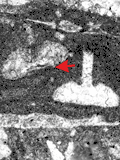 Abstract: Encrusting coralline algae are important rock-building organisms of the
lower Priabonian limestones from the Central Carpathian Paleogene Basin. Despite the effort of early palaeontologists, former classifications lacked many diagnostic characteristics and modern taxonomic concepts,
which hinders their use for modern palaeontological interpretations. The situation is further complicated as recent DNA analyses of extant coralline algae
highlight the limits of the morpho-anatomical classification and identify many coralline algal genera which can
also be recognized in the fossil record. Because palaeontology deals exclusively with the morpho-anatomical characteristics, a synthesis of the new discoveries in molecular phylogenetic analyses with morphology-based palaeontological classifications is necessary. Our palaeontological study based on published investigations on coralline molecular genetics enabled: 1)
the identification of seventeen coralline algal morphological species grouped in six genera: Sporolithon lugeonii, Sporolithon nummuliticum, Sporolithon
sp. 1, Sporolithon sp. 2, Lithothamnion camarasae, Lithothamnion cf. corallioides, Lithothamnion prascoi, Lithothamnion cf. ramosissimum, Lithothamnion roveretoi, Lithothamnion sp., Phymatolithon sp., Mesophyllum fructiferum, Mesophyllum cf. engelhartii, Mesophyllum sp., Chamberlainium lemoinei, Lithoporella melobesioides,
and Lithoporella cf. minus ; 2) the description of Chamberlainium lemoinei (Miranda) comb. nov. known from
the Bartonian, and 3) the identification of a unique encrusting coralline alga tentatively assigned to the genus Lithothamnion. Abstract: Encrusting coralline algae are important rock-building organisms of the
lower Priabonian limestones from the Central Carpathian Paleogene Basin. Despite the effort of early palaeontologists, former classifications lacked many diagnostic characteristics and modern taxonomic concepts,
which hinders their use for modern palaeontological interpretations. The situation is further complicated as recent DNA analyses of extant coralline algae
highlight the limits of the morpho-anatomical classification and identify many coralline algal genera which can
also be recognized in the fossil record. Because palaeontology deals exclusively with the morpho-anatomical characteristics, a synthesis of the new discoveries in molecular phylogenetic analyses with morphology-based palaeontological classifications is necessary. Our palaeontological study based on published investigations on coralline molecular genetics enabled: 1)
the identification of seventeen coralline algal morphological species grouped in six genera: Sporolithon lugeonii, Sporolithon nummuliticum, Sporolithon
sp. 1, Sporolithon sp. 2, Lithothamnion camarasae, Lithothamnion cf. corallioides, Lithothamnion prascoi, Lithothamnion cf. ramosissimum, Lithothamnion roveretoi, Lithothamnion sp., Phymatolithon sp., Mesophyllum fructiferum, Mesophyllum cf. engelhartii, Mesophyllum sp., Chamberlainium lemoinei, Lithoporella melobesioides,
and Lithoporella cf. minus ; 2) the description of Chamberlainium lemoinei (Miranda) comb. nov. known from
the Bartonian, and 3) the identification of a unique encrusting coralline alga tentatively assigned to the genus Lithothamnion.
|
|
Carnets Geol., vol. 22, no. 12, p. 567-617
Online since August 1, 2022
|
|
A larger benthic foraminiferal zonation for the Eocene of the Caribbean and central American region
Simon F. MITCHELL, Edward ROBINSON, Ercan ÖZCAN, Mark M. JIANG & Natalie ROBINSON
| HTML  | PDF
| PDF  [43,031 KB]
| DOI: 10.2110/carnets.2022.2211 [43,031 KB]
| DOI: 10.2110/carnets.2022.2211
|
|
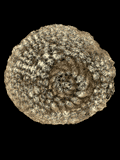 Abstract: We have undertaken a study of the larger benthic foraminifera
(LBF) of the Eocene of Jamaica that involved collecting free specimens and calibrating their occurrence against chronostratigraphy using calcareous nannofossils identified from sample splits or adjacent samples. The
results have been plotted stratigraphically and allow a detailed zonation of the Eocene (14 zones) to be developed based largely on lepidocyclinids and similar forms. The zonation can be shown to be applicable to the Americas extending from northern South America, to Central America, the Caribbean and southern North America. The LBF biostratigraphy is based on the evolution of various groups. Three zones are recognized in the
Ypresian, six zones in the Lutetian, three zones in the Bartonian, and two zones in the
Priabonian. In order to classify the LBF we have revised the important groups used for the zonation scheme that occur in the Eocene and figure numerous examples. Our revision rearranges described genera into evolutionary, monophyletic clades to which we give the hierarchy of family and subfamily. We provide remarks on published taxa explaining how they are recognized and describe all the new taxa (two families, one subfamily, four genera and five species). The following families, genera and species are new: Butterliniana gen.
nov., Helicosteginidae fam. nov., Helicostegina minor sp. nov., Helicostegina jamaicensis sp.
nov., Helicostegina jeannemairae sp. nov., Pseudolepidinidae fam. nov., Orbitoininae
subfam. nov., Planorbitoinella gen. nov., Polyorbitoinella gen.
nov., Polyorbitoinella lilyfieldensis sp. nov., Orbitoina wrighti sp.
nov., and Nephronummulites gen. nov. Abstract: We have undertaken a study of the larger benthic foraminifera
(LBF) of the Eocene of Jamaica that involved collecting free specimens and calibrating their occurrence against chronostratigraphy using calcareous nannofossils identified from sample splits or adjacent samples. The
results have been plotted stratigraphically and allow a detailed zonation of the Eocene (14 zones) to be developed based largely on lepidocyclinids and similar forms. The zonation can be shown to be applicable to the Americas extending from northern South America, to Central America, the Caribbean and southern North America. The LBF biostratigraphy is based on the evolution of various groups. Three zones are recognized in the
Ypresian, six zones in the Lutetian, three zones in the Bartonian, and two zones in the
Priabonian. In order to classify the LBF we have revised the important groups used for the zonation scheme that occur in the Eocene and figure numerous examples. Our revision rearranges described genera into evolutionary, monophyletic clades to which we give the hierarchy of family and subfamily. We provide remarks on published taxa explaining how they are recognized and describe all the new taxa (two families, one subfamily, four genera and five species). The following families, genera and species are new: Butterliniana gen.
nov., Helicosteginidae fam. nov., Helicostegina minor sp. nov., Helicostegina jamaicensis sp.
nov., Helicostegina jeannemairae sp. nov., Pseudolepidinidae fam. nov., Orbitoininae
subfam. nov., Planorbitoinella gen. nov., Polyorbitoinella gen.
nov., Polyorbitoinella lilyfieldensis sp. nov., Orbitoina wrighti sp.
nov., and Nephronummulites gen. nov.
|
|
Carnets Geol., vol. 22, no. 11, p. 409-565
Online since July 1, 2022
|
|
Nomenclatural Note, p.
566
|
|
Discussion of Laya et al. (2021), Dissolution of ooids in seawater-derived fluids - an example from Lower Permian re-sedimented carbonates, West Texas, USA [Sedimentology 68(6), 2671-2706]
Bruno R.C. GRANIER & Christopher G.St.C. KENDALL
| HTML  | PDF
| PDF  [5,065 KB]
| DOI: 10.2110/carnets.2022.2210 [5,065 KB]
| DOI: 10.2110/carnets.2022.2210
|
|
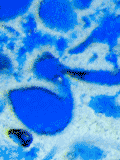 Abstract: This
discussion reassesses earlier interpretations of calcareous turbidites from the
subsurface Spraberry Formation of the Happy Field (Garza County, NW Texas). It is based on routine petrographic analyses
with a standard microscope. The succession of diagenetic products in this deep
water setting were a little initial cementation by low magnesian calcite (LMC)
and then the partial or complete leaching of both aragonite and high magnesian
calcite (HMC) allochems facilitated by the presence of a residual primary
intergranular porosity. This contradicts Laya et al.'s (2021)
claim that cementation left no residual intergranular porosity so further
leaching of the ooids would not have been possible. Instead the study made for
this discussion with the same thin sections found residual primary intergranular
porosity remains as evidenced by some of their photomicrographs. Most thin
sections with porous grainstones have 1) collapsed molds that exhibit evidence
of little initial cementation and 2) measured permeability values that range from some
mD to some tens of mD. Isopachous LMC cements occur in almost all thin sections
lining the margins of most intergranular pores. As these cements do not fully
fill the pores, there is permeable well-connected residual primary porosity with
no significant LMC cement in the secondary moldic porosity. Compaction affects
the allochems and, where these are partially leached, intergranular and moldic
porosities. Dissolution of aragonite (a major component) and HMC (possibly a
minor component) was probably not coeval. The order of paragenetic sequence of
this discussion study was: 1) LMC cementation; 2) aragonite leaching facilitated
by oxidation of the organic matter in the "biocrystals" of bioclasts
and oolitic cortices; 3) compactional brecciation, which was first mechanical,
and then chemical causing local collapse of the molds of some of the largest
pores. It was governed by cementation
initially in a shallow burial diagenetic setting and then leaching whereas
chemical compaction marks a slightly deeper burial diagenetic setting. The final
event was marked by oil migration into the Happy Field reservoirs, freezing the
calcium carbonate diagenesis. The theory of Laya et al. (2021) of
the leaching of ooids in directly "seawater-derived fluids" is unsupported by
the paragenetic sequence described above. Abstract: This
discussion reassesses earlier interpretations of calcareous turbidites from the
subsurface Spraberry Formation of the Happy Field (Garza County, NW Texas). It is based on routine petrographic analyses
with a standard microscope. The succession of diagenetic products in this deep
water setting were a little initial cementation by low magnesian calcite (LMC)
and then the partial or complete leaching of both aragonite and high magnesian
calcite (HMC) allochems facilitated by the presence of a residual primary
intergranular porosity. This contradicts Laya et al.'s (2021)
claim that cementation left no residual intergranular porosity so further
leaching of the ooids would not have been possible. Instead the study made for
this discussion with the same thin sections found residual primary intergranular
porosity remains as evidenced by some of their photomicrographs. Most thin
sections with porous grainstones have 1) collapsed molds that exhibit evidence
of little initial cementation and 2) measured permeability values that range from some
mD to some tens of mD. Isopachous LMC cements occur in almost all thin sections
lining the margins of most intergranular pores. As these cements do not fully
fill the pores, there is permeable well-connected residual primary porosity with
no significant LMC cement in the secondary moldic porosity. Compaction affects
the allochems and, where these are partially leached, intergranular and moldic
porosities. Dissolution of aragonite (a major component) and HMC (possibly a
minor component) was probably not coeval. The order of paragenetic sequence of
this discussion study was: 1) LMC cementation; 2) aragonite leaching facilitated
by oxidation of the organic matter in the "biocrystals" of bioclasts
and oolitic cortices; 3) compactional brecciation, which was first mechanical,
and then chemical causing local collapse of the molds of some of the largest
pores. It was governed by cementation
initially in a shallow burial diagenetic setting and then leaching whereas
chemical compaction marks a slightly deeper burial diagenetic setting. The final
event was marked by oil migration into the Happy Field reservoirs, freezing the
calcium carbonate diagenesis. The theory of Laya et al. (2021) of
the leaching of ooids in directly "seawater-derived fluids" is unsupported by
the paragenetic sequence described above.
|
|
Editorial notice:
Following
the reading of a paper authored by J.C. Laya et al. in the journal
Sedimentology, the authors submitted on 02-Nov-2021 a first discussion
manuscript based on analogues. On 09-Nov-2021, this first manuscript was
returned with harsh comments from three editors and ascribed the label "Reject
& Resubmit". On 07-Mar-2022, the first author (BRCG)
received a parcel with 40 thin sections to examine over a two weeks period. He
was charged significant import taxes for this "scientific material".
On 14-May-2022, the authors submitted a new discussion manuscript based on that
same material that was studied by J.C. Laya et al. On 07-Jun-2022
this second manuscript was ascribed the label "Immediate Reject"
without having any preliminary editorial reading. In the meantime, a claimant
allegedly accused the first author (BRCG) of "serious breaches in academic
publishing ethics" because he posted some photomicrographs of the material
on a social network. On 05-Apr-2022 and again on 18-May-2022, this claimant addressed
complains to the " Université
de Bretagne Occidentale", an action that may be characterised as slander or
defamation. Note that the authors were kindly granted the written permission to
publish this discussion paper and another paper by the legitimate owner of the
Happy Spraberry field, which also owns all material derived from any of their
materials (e.g., cores). It looks like there is no evidence that it was the case for the other parties.
|
|
Carnets Geol., vol. 22, no. 10, p. 395-408
Online since June 19, 2022
|
|
A rare ammonite assemblage in the Romaniceras ornatissimum Zone (Middle Turonian) from the Uchaux Massif, Vaucluse, France
Francis AMÉDRO, Cyril BAUDOUIN, Gérard DELANOY, Christian DEVALQUE & Francis ROBASZYNSKI
| HTML  | PDF
| PDF  [8,119 KB]
| DOI: 10.2110/carnets.2022.2209 [8,119 KB]
| DOI: 10.2110/carnets.2022.2209
|
|
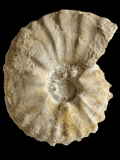 Abstract: The Uchaux Massif (Vaucluse, SE France) is one of the rare places in Europe where ammonites collecting can be led from a high middle Turonian through Late Turonian. That incited Alcide d'Orbigny in 1852 to quote Uchaux as "the French type of the Turonian stage" to complement the Saumur, Tourtenay, Montrichard and Tours localities mentionned in 1842 when the stage was created. In 2014, the monograph by Robaszynski et al. synthetized and actualized the informations available on the litho- and biostratigraphy of the Turonian from the Uchaux Massif. More recently, a new outcrop at Mondragon, in a place named Prés Morel, exposes the whole carbonate siltstones with Spongia of the Peyras Member (UL3). Were collected : Lewesiceras peramplum (Mantell, 1822), Romaniceras (Romaniceras) marigniacum Amédro & Châtelier, 2020, R. (Yubariceras) ornatissimum (Stoliczka, 1864), R. (Y.) kanei Jones, 1938, Collignoniceras woollgari regulare (Haas, 1946), C. carolinum (Orbigny, 1841), C. papale (Orbigny, 1841), C. turoniense (Orbigny, 1841) and a new species of Collignoniceras : C. rhodanicum Amédro, Baudouin & Delanoy sp. nov. This assemblage, unprecedented in the studied area, is characteristic of the Romaniceras ornatissimum
Zone which is the third of the four ammonite zones of the middle Turonian (Tm 3). At the top of this third zone, the surprise was to find the Romaniceras marigniacum bio-horizon defined in 2020 in the southern part of the Paris Basin at the top of the Tuffeau de Bourré and at the base of the Tuffeau Jaune de Touraine. Moreover, we now think that the Peyras Member has to be fully assigned to the Romaniceras ornatissimum
Zone. Lastly, the assemblage includes a rich population of Collignoniceras carolinum (24 specimens), the most important known to-day over the world. All these ammonites allow to know the spectrum of their morphological variations and show a dimorphism through the existence of micro- and macroconchs. Abstract: The Uchaux Massif (Vaucluse, SE France) is one of the rare places in Europe where ammonites collecting can be led from a high middle Turonian through Late Turonian. That incited Alcide d'Orbigny in 1852 to quote Uchaux as "the French type of the Turonian stage" to complement the Saumur, Tourtenay, Montrichard and Tours localities mentionned in 1842 when the stage was created. In 2014, the monograph by Robaszynski et al. synthetized and actualized the informations available on the litho- and biostratigraphy of the Turonian from the Uchaux Massif. More recently, a new outcrop at Mondragon, in a place named Prés Morel, exposes the whole carbonate siltstones with Spongia of the Peyras Member (UL3). Were collected : Lewesiceras peramplum (Mantell, 1822), Romaniceras (Romaniceras) marigniacum Amédro & Châtelier, 2020, R. (Yubariceras) ornatissimum (Stoliczka, 1864), R. (Y.) kanei Jones, 1938, Collignoniceras woollgari regulare (Haas, 1946), C. carolinum (Orbigny, 1841), C. papale (Orbigny, 1841), C. turoniense (Orbigny, 1841) and a new species of Collignoniceras : C. rhodanicum Amédro, Baudouin & Delanoy sp. nov. This assemblage, unprecedented in the studied area, is characteristic of the Romaniceras ornatissimum
Zone which is the third of the four ammonite zones of the middle Turonian (Tm 3). At the top of this third zone, the surprise was to find the Romaniceras marigniacum bio-horizon defined in 2020 in the southern part of the Paris Basin at the top of the Tuffeau de Bourré and at the base of the Tuffeau Jaune de Touraine. Moreover, we now think that the Peyras Member has to be fully assigned to the Romaniceras ornatissimum
Zone. Lastly, the assemblage includes a rich population of Collignoniceras carolinum (24 specimens), the most important known to-day over the world. All these ammonites allow to know the spectrum of their morphological variations and show a dimorphism through the existence of micro- and macroconchs.
|
|
Carnets Geol., vol. 22, no. 9, p. 333-393
Online since July 1, 2022
|
|
The Kalkowsky Project - Chapter IV. Case study of the Happy Spraberry oil reservoirs in NW Texas (with a micropaleontologic and biostratigraphic supplement): Collapsed molds should not be treated as a category of distorted ooids
Bruno R.C. GRANIER, Christopher G.St.C. KENDALL & Daniel VACHARD
| HTML  | PDF
| PDF  [6,180 KB]
| DOI: 10.2110/carnets.2022.2208 [6,180 KB]
| DOI: 10.2110/carnets.2022.2208
|
|
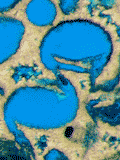 Abstract: The
subsurface upper Spraberry Formation in NW Texas is dominantly composed of
calcareous turbidites and debris-flows. The petrographic analysis of its porous grain-supported fabrics revealed the presence of
controversial superimposed compaction fabrics, sometimes referred to as "distorted
ooids". Based on the paragenetic sequence, it is demonstrated that these
allochems were not distorted. In fact, the related zigzag and silcrow (§) patterns
result from the collapse of molds, either oomolds or biomolds, in response to
mechanical compaction of the fragile framework made up of isopachous Low-Mg
Calcite cement surrounding these empty molds. As a side finding, this
stratigraphic unit, which was said to be late Kungurian in age, is proved to
be nearly 7 millions of year older. Abstract: The
subsurface upper Spraberry Formation in NW Texas is dominantly composed of
calcareous turbidites and debris-flows. The petrographic analysis of its porous grain-supported fabrics revealed the presence of
controversial superimposed compaction fabrics, sometimes referred to as "distorted
ooids". Based on the paragenetic sequence, it is demonstrated that these
allochems were not distorted. In fact, the related zigzag and silcrow (§) patterns
result from the collapse of molds, either oomolds or biomolds, in response to
mechanical compaction of the fragile framework made up of isopachous Low-Mg
Calcite cement surrounding these empty molds. As a side finding, this
stratigraphic unit, which was said to be late Kungurian in age, is proved to
be nearly 7 millions of year older.
|
|
Carnets Geol., vol. 22, no. 8, p. 311-332
Online since June 2, 2022
|
|
Taxonomy of the fossil calcareous algae: Revision of genera Physoporella Steinmann and Oligoporella Pia (Dasycladales)
Tonći GRGASOVIĆ
| HTML  | PDF
| PDF  [31,142 KB]
| DOI: 10.2110/carnets.2022.2207 [31,142 KB]
| DOI: 10.2110/carnets.2022.2207
|
|
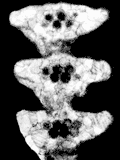 Abstract: The taxonomic classification and mutual distinction of the genera Physoporella Steinmann and Oligoporella Pia (Dasycladales, green algae) have proven problematic and that has impeded their use in stratigraphy and other studies. The presence of single whorls of piriform laterals in Physoporella and double whorls in Oligoporella is considered as the main characteristic that separates these genera. According to that, diagnoses of genera and all species and varieties are changed or supplemented, and detailed descriptions are given. For this purpose the type-material from Pia's collection was re-examined and its redocumentation and reinterpretation performed. Additional information was obtained from abundant material from Croatia (Ivanščica Mt, Medvednica Mt, Žumberak Mt, Lika, Dalmatia). Only a few taxa were examined based on literature data. For all species and varieties reconstructions are given. Taxa from the Permian of East Asia are only briefly described. Among the investigated taxa, some of them have a structure that significantly differs from that present in the type species of the genera Physoporella and Oligoporella. They are separated into two new genera Ardeiporella and Neophysoporella. The revised genera Physoporella and Oligoporella, together with the newly established ones, give a clearer picture of phylogenetic relations. Abstract: The taxonomic classification and mutual distinction of the genera Physoporella Steinmann and Oligoporella Pia (Dasycladales, green algae) have proven problematic and that has impeded their use in stratigraphy and other studies. The presence of single whorls of piriform laterals in Physoporella and double whorls in Oligoporella is considered as the main characteristic that separates these genera. According to that, diagnoses of genera and all species and varieties are changed or supplemented, and detailed descriptions are given. For this purpose the type-material from Pia's collection was re-examined and its redocumentation and reinterpretation performed. Additional information was obtained from abundant material from Croatia (Ivanščica Mt, Medvednica Mt, Žumberak Mt, Lika, Dalmatia). Only a few taxa were examined based on literature data. For all species and varieties reconstructions are given. Taxa from the Permian of East Asia are only briefly described. Among the investigated taxa, some of them have a structure that significantly differs from that present in the type species of the genera Physoporella and Oligoporella. They are separated into two new genera Ardeiporella and Neophysoporella. The revised genera Physoporella and Oligoporella, together with the newly established ones, give a clearer picture of phylogenetic relations.
|
|
Carnets Geol., vol. 22, no. 7, p. 171-310
Online since June 4, 2022
|
|
The report of a rare deformed eagle ray (Myliobatiformes: Myliobatidae) tooth plate from the Neogene of Calvert Cliffs, Maryland, U.S.A.
Stephen J. GODFREY, David J. BOHASKA & John MAISEY
| HTML  | PDF
| PDF  [937 KB]
| DOI: 10.2110/carnets.2022.2206 [937 KB]
| DOI: 10.2110/carnets.2022.2206
|
|
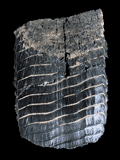 Abstract: An isolated and deformed
lower tooth plate of an eagle ray (Aetomylaeus
sp., Myliobatidae, Myliobatiformes) is reported herein from the Miocene deposits
along Calvert Cliffs, Maryland, U.S.A. Deformed myliobatid tooth plates like
this, either fossil or modern, are exceedingly rare. All medial teeth are
deformed/skewed such that the right side of each tooth forms an angle of about
10 degrees to the transverse axis of the dental plate. The skewed abnormal form
of the teeth in USNM PAL 726325
is not thought to be the result of modern or taphonomic deformation. Rather, the
deformity exhibited by USNM PAL 726325
gives every indication that successive similarly deformed teeth came about as a
result of a persistent anatomical deformity of the dental lamina. From the
consistency in the deformed shape of each tooth, it would appear as though the
dental lamina retained this anomalous shape at least throughout the time
represented by the age of the tooth plate. If this interpretation is correct,
the deformity was not fatal and did not significantly impair the functionality
of the tooth pavement over a protracted part (or all) of the individual's life
span. Abstract: An isolated and deformed
lower tooth plate of an eagle ray (Aetomylaeus
sp., Myliobatidae, Myliobatiformes) is reported herein from the Miocene deposits
along Calvert Cliffs, Maryland, U.S.A. Deformed myliobatid tooth plates like
this, either fossil or modern, are exceedingly rare. All medial teeth are
deformed/skewed such that the right side of each tooth forms an angle of about
10 degrees to the transverse axis of the dental plate. The skewed abnormal form
of the teeth in USNM PAL 726325
is not thought to be the result of modern or taphonomic deformation. Rather, the
deformity exhibited by USNM PAL 726325
gives every indication that successive similarly deformed teeth came about as a
result of a persistent anatomical deformity of the dental lamina. From the
consistency in the deformed shape of each tooth, it would appear as though the
dental lamina retained this anomalous shape at least throughout the time
represented by the age of the tooth plate. If this interpretation is correct,
the deformity was not fatal and did not significantly impair the functionality
of the tooth pavement over a protracted part (or all) of the individual's life
span.
|
|
Carnets Geol., vol. 22, no. 6, p. 161-169
Online since May 10, 2022
|
|
The Kalkowsky Project - Chapter III. Significance of primary radial fabrics associated with ancient partly leached or recrystallized calcareous ooids
Bruno R.C. GRANIER & Philippe LAPOINTE
| HTML  | PDF
| PDF  [1,851 KB]
| DOI: 10.2110/carnets.2022.2205 [1,851 KB]
| DOI: 10.2110/carnets.2022.2205
|
|
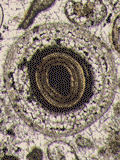 Abstract: Calcitic ooids and bothryoids from
the Yacoraite Formation in the provinces of Jujuy and Salta (Argentina) display
radial fabrics pointing to their primarily high-Mg calcite (HMC) nature. The
present publication documents some specimens that are partly or fully leached
or recrystallized, which raises fundamental questions about the validity of
some concepts, such as the very existence of the so-called "two-phase"/"bimineralic"
ooids. It is assumed here that the organic content in the oolitic cortices
(and, subsequently, its degree of oxidation) is the key to explaining some
differential diagenetic alterations. Abstract: Calcitic ooids and bothryoids from
the Yacoraite Formation in the provinces of Jujuy and Salta (Argentina) display
radial fabrics pointing to their primarily high-Mg calcite (HMC) nature. The
present publication documents some specimens that are partly or fully leached
or recrystallized, which raises fundamental questions about the validity of
some concepts, such as the very existence of the so-called "two-phase"/"bimineralic"
ooids. It is assumed here that the organic content in the oolitic cortices
(and, subsequently, its degree of oxidation) is the key to explaining some
differential diagenetic alterations.
|
|
Carnets Geol., vol. 22, no. 5, p. 149-160
Online since March 4, 2022
|
|
Adult morphologies of Puzosia quenstedti (Parona & Bonarelli, 1897) (Ammonoidea, Desmoceratidae) in the Albian of the South-East of France. Taxonomic implications
Jean-Louis Latil LATIL, Gérard DELANOY & Pierre DELATTRE
| HTML  | PDF
| PDF  [5,643 KB]
| DOI: 10.2110/carnets.2022.2204 [5,643 KB]
| DOI: 10.2110/carnets.2022.2204
|
|
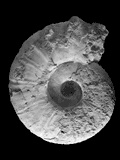 Abstract: Several adult specimens belonging to the genus Puzosia
Bayle, 1878, were collected in the Albian of Lieuche
(Alpes-Maritimes, France). Comparison with material from the condensed Albian levels of La Balme
de Rencurel (Isère, France), in particular those described and figured by Jacob
(1908), has highlighted a morphological link between the adult forms from
Lieuche and the incomplete specimens from the condensed levels of the Lower-Middle Albian of
south-eastern France and to identify them as Puzosia quenstedti (Parona
& Bonarelli, 1897).
These new details on the ontogenetic development of this species also allow new perspectives in
the taxonomic treatment of Albian Puzosia species. A modified diagnosis of Puzosia
quenstedti is proposed. Abstract: Several adult specimens belonging to the genus Puzosia
Bayle, 1878, were collected in the Albian of Lieuche
(Alpes-Maritimes, France). Comparison with material from the condensed Albian levels of La Balme
de Rencurel (Isère, France), in particular those described and figured by Jacob
(1908), has highlighted a morphological link between the adult forms from
Lieuche and the incomplete specimens from the condensed levels of the Lower-Middle Albian of
south-eastern France and to identify them as Puzosia quenstedti (Parona
& Bonarelli, 1897).
These new details on the ontogenetic development of this species also allow new perspectives in
the taxonomic treatment of Albian Puzosia species. A modified diagnosis of Puzosia
quenstedti is proposed.
The presence of Douvilleiceras sp. juv. aff. D. mammillatum (Schlotheim,
1813) in superimposed overlying levels allows assignation of a Lower Albian (Douvilleiceras
mammillatum Superzone) to a basal Middle Albian age (Hoplites dentatus Zone).
|
|
Carnets Geol., vol. 22, no. 4, p. 119-147
Online since February 28, 2022
|
|
The Kalkowsky Project - Chapter II. Wobbly ooids in a stromatolite from the Yacoraite Formation (Argentina)
Bruno R.C. GRANIER & Philippe LAPOINTE
| HTML  | PDF
| PDF  [1,375 KB]
| DOI: 10.2110/carnets.2022.2203 [1,375 KB]
| DOI: 10.2110/carnets.2022.2203
|
|
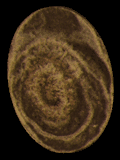 Abstract: Eccentric ooids are described from a brackish
Maastrichtian paleolake in NW Argentina. The first report of such atypical
coated grains was from marine Upper Jurassic strata in SE Poland. Because their
growth pattern is not likely to be confused with that of other
"eccentric" ooids, such as asymmetric ooids, hiatus ooids, half-moon
ooids, or "broken" ooids, it is suggested here to name them
"wobbly ooids". Abstract: Eccentric ooids are described from a brackish
Maastrichtian paleolake in NW Argentina. The first report of such atypical
coated grains was from marine Upper Jurassic strata in SE Poland. Because their
growth pattern is not likely to be confused with that of other
"eccentric" ooids, such as asymmetric ooids, hiatus ooids, half-moon
ooids, or "broken" ooids, it is suggested here to name them
"wobbly ooids".
|
|
Carnets Geol., vol. 22, no. 3, p. 111-117
Online since February 15, 2022
|
|
The genera Roloboceras Casey, 1954, and Megatyloceras Humphrey, 1949 (Ammonoidea, Ancyloceratina, Douvilleiceratidae), from the Lower Aptian of Ardèche (SE France) - Taxonomic and biostratigraphic implications
Gérard DELANOY, Cyril BAUDOUIN, Antoine PICTET, Josep MORENO-BEDMAR, Camille FRAU & Bertrand MATRION
| HTML  | PDF
| PDF  [11,947 KB]
| DOI: 10.2110/carnets.2022.2202 [11,947 KB]
| DOI: 10.2110/carnets.2022.2202
|
|
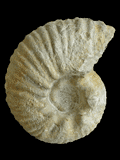 Abstract: The
Lower Aptian marine deposits from southern Ardèche (South-East of France) yield
a rich ammonite fauna of the sub-family Roloboceratinae Casey,
1961, which dates the upper Deshayesites
forbesi Zone (Roloboceras hambrovi
Subzone pro parte ?). The systematic study of this Roloboceratinae fauna
has improved our knowledge of Megatyloceras
coronatum Rouchadzé, 1933, type species of Megatyloceras Humphrey,
1949, as well as a better understanding of the genus thanks to the examination
of the species from the Anglo-Paris Basin. A new species, M.
leteilensis sp. nov. is introduced, and a description of M.
transiens Casey, 1961, provided, with clarifications on its possible
stratigraphic position. This study also establishes that the "species" Megatyloceras
ricordeanum (Orbigny, 1850) represents only a growth stage shared by
several species of Megatyloceras which is doubtfully a true taxon
and must, therefore, be considered as a nomen dubium.
The hypothesis of sexual dimorphism in Roloboceras
Casey, 1954, and Megatyloceras
is advanced. The study of this Roloboceratinae fauna highlights their
heterogeneous distribution throughout Lower Aptian deposits of Ardèche, showing
a direct correlation with bathymetric range. The biostratigraphical distribution
of both genera on the Languedoc platform shows that Roloboceras is
present from the uppermost C2 segment to the C4 segment of the stable
carbon-isotope record, while Megatyloceras is limited to the middle C4
segment up to the lowermost C6 segment. Both genera coexist during the C4
segment. Abstract: The
Lower Aptian marine deposits from southern Ardèche (South-East of France) yield
a rich ammonite fauna of the sub-family Roloboceratinae Casey,
1961, which dates the upper Deshayesites
forbesi Zone (Roloboceras hambrovi
Subzone pro parte ?). The systematic study of this Roloboceratinae fauna
has improved our knowledge of Megatyloceras
coronatum Rouchadzé, 1933, type species of Megatyloceras Humphrey,
1949, as well as a better understanding of the genus thanks to the examination
of the species from the Anglo-Paris Basin. A new species, M.
leteilensis sp. nov. is introduced, and a description of M.
transiens Casey, 1961, provided, with clarifications on its possible
stratigraphic position. This study also establishes that the "species" Megatyloceras
ricordeanum (Orbigny, 1850) represents only a growth stage shared by
several species of Megatyloceras which is doubtfully a true taxon
and must, therefore, be considered as a nomen dubium.
The hypothesis of sexual dimorphism in Roloboceras
Casey, 1954, and Megatyloceras
is advanced. The study of this Roloboceratinae fauna highlights their
heterogeneous distribution throughout Lower Aptian deposits of Ardèche, showing
a direct correlation with bathymetric range. The biostratigraphical distribution
of both genera on the Languedoc platform shows that Roloboceras is
present from the uppermost C2 segment to the C4 segment of the stable
carbon-isotope record, while Megatyloceras is limited to the middle C4
segment up to the lowermost C6 segment. Both genera coexist during the C4
segment.
|
|
Carnets Geol., vol. 22, no. 2, p. 7-109
Online since February 17, 2022
|
|
Nomenclatural Note, p.
110
|
|
Comments on a small sabretooth cat in the Abismo Ponta de Flecha Cave, Vale do Ribeira, southeastern Brazil
Artur CHAHUD
| HTML  | PDF
| PDF  [448 KB]
| DOI: 10.2110/carnets.2022.2201 [448 KB]
| DOI: 10.2110/carnets.2022.2201
|
|
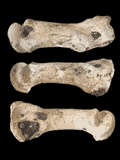 Abstract: Vale do Ribeira, in southeastern Brazil, is known for its many
caves that contain osteological material, including remains that have been
referred to several extinct species. The sabertooth cat Smilodon populator was a large predator that inhabited South America
during the Quaternary. A specimen that is represented in the Abismo Ponta de
Flecha Cave by small forelimb bones (metacarpals and phalanges) is commented
here. The metacarpals display morphological characteristics of S.
populator, but are smaller than those of S.
fatalis and larger than those of S.
gracilis. This specimen is amongst the smallest ever found specimen of S.
populator and is comparable in size to an adult lion. Abstract: Vale do Ribeira, in southeastern Brazil, is known for its many
caves that contain osteological material, including remains that have been
referred to several extinct species. The sabertooth cat Smilodon populator was a large predator that inhabited South America
during the Quaternary. A specimen that is represented in the Abismo Ponta de
Flecha Cave by small forelimb bones (metacarpals and phalanges) is commented
here. The metacarpals display morphological characteristics of S.
populator, but are smaller than those of S.
fatalis and larger than those of S.
gracilis. This specimen is amongst the smallest ever found specimen of S.
populator and is comparable in size to an adult lion.
|
|
Carnets Geol., vol. 22, no. 1, p. 1-6
Online since January 17, 2022
|

|
|
2021 (vol. 21)
|
|
A possible crawling paracomatulid crinoid from the Lower Jurassic of central Italy
Riccardo MANNI & Rolando DI NARDO
| HTML  | PDF
| PDF  [725 KB]
| DOI: 10.2110/carnets.2021.2119 [725 KB]
| DOI: 10.2110/carnets.2021.2119
|
|
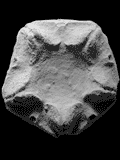 Abstract: A new paracomatulid crinoid, Tiburtocrinus
toarcensis gen. et sp. nov., is described from the Lower Jurassic of Tivoli
(central Apennines, Italy). This type of stemless crinoids has never previously
been recorded in Italy, and this report bridges a significant gap.
Morphofunctional analysis of the radial facets suggests that Tiburtocrinus
toarcensis gen. et sp. nov. may have been a crawling paracomatulid, very
different from other paracomatulids that probably swam. Abstract: A new paracomatulid crinoid, Tiburtocrinus
toarcensis gen. et sp. nov., is described from the Lower Jurassic of Tivoli
(central Apennines, Italy). This type of stemless crinoids has never previously
been recorded in Italy, and this report bridges a significant gap.
Morphofunctional analysis of the radial facets suggests that Tiburtocrinus
toarcensis gen. et sp. nov. may have been a crawling paracomatulid, very
different from other paracomatulids that probably swam.
|
|
Carnets Geol., vol. 21, no. 19, p. 523-532
Online since December 25, 2021
|
|
Nomenclatural Note, p.
234
|
|
Biostratigraphic distribution of orbitolinids in the ammonite biozones (Urgonian platform of southeastern France). Part 2: Barremian p.p.
Bruno GRANIER, Bernard CLAVEL, Robert BUSNARDO, Jean CHAROLLAIS, Pierre DESJACQUES & Didier BERT
| HTML  | PDF
| PDF  [27,925 KB]
| DOI: 10.2110/carnets.2021.2118 [27,925 KB]
| DOI: 10.2110/carnets.2021.2118
|
|
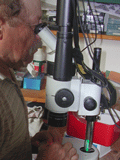 Abstract:
The biostratigraphic distribution of orbitolinids for the Barremian of SE France proposed hereafter is calibrated on the ammonite
biozonation. This work is based on the study of eleven sections with orbitolinids associated to macrofossils (ammonites and/or
echinids) significant in terms of biostratigraphy or overlain with levels bearing the above macrofossils. Abstract:
The biostratigraphic distribution of orbitolinids for the Barremian of SE France proposed hereafter is calibrated on the ammonite
biozonation. This work is based on the study of eleven sections with orbitolinids associated to macrofossils (ammonites and/or
echinids) significant in terms of biostratigraphy or overlain with levels bearing the above macrofossils.
|
|
Carnets Geol., vol. 21, no. 18, p. 399-521
Online since October 24, 2021
|
|
The ichnospecies Linichnus bromleyi on a Miocene baleen whale radius preserving multiple shark bite-shake traces suggests scavenging
Stephen J. GODFREY & Annie J. LOWRY
| HTML  | PDF
| PDF  [508 KB]
| DOI: 10.2110/carnets.2021.2117 [508 KB]
| DOI: 10.2110/carnets.2021.2117
|
|
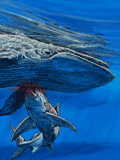 Abstract: An isolated Miocene baleen whale left radius was marked repeatedly by
shark bite-shake traces. The radius probably derives from the Plum Point Member
of the Calvert Formation, Calvert Cliffs, Calvert County, Maryland, U.S.A. At
least three successive bite-shake traces marking the
radius, made by multiple teeth, are attributed to the trace fossil Linichnus
bromleyi. These bite-shake traces
consisting of shallow, thin arching gouges on a radius, likely indicate
scavenging rather than active predation. The most likely means of producing the
bundle of L. bromleyi within each of
the three sets of traces would be through repeated biting as the shark
re-positioned the prey in its mouth or, perhaps, by a shark species with
multiple functional teeth within its tooth row. If the bite traces were
produced by a non-serrated tooth (as they appear to have been), then the most
likely candidate would be Carcharodon hastalis. Abstract: An isolated Miocene baleen whale left radius was marked repeatedly by
shark bite-shake traces. The radius probably derives from the Plum Point Member
of the Calvert Formation, Calvert Cliffs, Calvert County, Maryland, U.S.A. At
least three successive bite-shake traces marking the
radius, made by multiple teeth, are attributed to the trace fossil Linichnus
bromleyi. These bite-shake traces
consisting of shallow, thin arching gouges on a radius, likely indicate
scavenging rather than active predation. The most likely means of producing the
bundle of L. bromleyi within each of
the three sets of traces would be through repeated biting as the shark
re-positioned the prey in its mouth or, perhaps, by a shark species with
multiple functional teeth within its tooth row. If the bite traces were
produced by a non-serrated tooth (as they appear to have been), then the most
likely candidate would be Carcharodon hastalis.
|
|
Carnets Geol., vol. 21, no. 17, p. 391-398
Online since October 24, 2021
|
|
Corrigendum, p.
202: An error was made in the spelling of the family name of one of the artists who created Figure 2. The correct spelling of his family name is "Schumaker".
|
|
New genera and species of ostracods from the El Ma El Abiod Miocene Basin (Tébessa, NE Algeria)
Francesco SCIUTO & Abdelhakim BENKHEDDA
| HTML  | PDF
| PDF  [10,561 KB]
| DOI: 10.2110/carnets.2021.2116 [10,561 KB]
| DOI: 10.2110/carnets.2021.2116
|
|
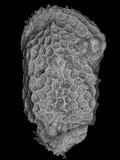 Abstract: Two new ostracod genera
of the family Trachyleberididae Sylvester-Bradley, 1948,
each based on a new species, are described and commented here. The specimens were collected in Tortonian
sediments cropping out at El Hadjra Safra in the El Ma El Abiod basin (region of
Tébessa, north-eastern Algeria). Abstract: Two new ostracod genera
of the family Trachyleberididae Sylvester-Bradley, 1948,
each based on a new species, are described and commented here. The specimens were collected in Tortonian
sediments cropping out at El Hadjra Safra in the El Ma El Abiod basin (region of
Tébessa, north-eastern Algeria).
|
|
Carnets Geol., vol. 21, no. 16, p. 383-390
Online since October 24, 2021
|
|
Nomenclatural Note, p.
180
|
|
The late Berriasian early evolutionary burst of the Orbitolinidae: New insights into taxonomy, origin, diversification and phylogeny of the family based on data from eastern Serbia
Felix SCHLAGINTWEIT & Ioan I. BUCUR
| HTML  | PDF
| PDF  [3,583 KB]
| DOI: 10.2110/carnets.2021.2115 [3,583 KB]
| DOI: 10.2110/carnets.2021.2115
|
|
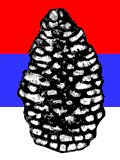 Abstract: New data from the Carpatho-Balkanides of eastern Serbia evidence the more or less
near-simultaneous "explosive" first appearances of several genera of the
Orbitolinidae in the late Berriasian. Most of the observed taxa were previously
recorded from strata not older than the Late Hauterivian (= classical Urgonian
of southeastern France), evidence that these ages refer to local
first appearance data. The diversified assemblage from Serbia includes
representatives of the subfamilies Dictyoconinae: genera Cribellopsis
Arnaud-Vanneau, Montseciella
Cherchi & Schroeder, Orbitolinopsis
Henson, Urgonina Foury
& Moullade, Valserina Schroeder
& Conrad, Vanneauina Schlagintweit,
and Dictyorbitolininae: genus Paracoskinolina
Moullade. Representatives of the Orbitolininae (with complex embryo) have
not been observed. They appeared later in the fossil record seemingly during the
Late Hauterivian-early Barremian. All together 17 taxa are reported, of which three in open nomenclature. A new species is described as Cribellopsis
sudari n. sp. The majority of the observed species display medium- to
high-conical tests and a rather simple exoskeleton lacking horizontal partitions
(rafters). The new data contradict a phylogenetic evolution of distinct genera
displaying different internal test structures one after the other in time (=
ancestor-descendant relationships) as postulated by some authors. The
explosive radiation ("early burst") of the Orbitolinidae in the late Berriasian is accompanied by the first appearance date of several other large
benthic foraminifera including mostly agglutinating (e.g.,
Ammocycloloculina, Choffatella, Drevennia, Eclusia,
Moulladella, Pfenderina,
Pseudotextulariella) but also complex porcelaneous taxa (Pavlovcevina)
providing evidence for a bioevent in this time period that exceeds the number of
taxa originating in the previous (Tithonian) and the following stage (Valanginian).
The early evolutionary history of the Orbitolinidae can be considered a
classical example of adaptive radiation within the clade's history. Abstract: New data from the Carpatho-Balkanides of eastern Serbia evidence the more or less
near-simultaneous "explosive" first appearances of several genera of the
Orbitolinidae in the late Berriasian. Most of the observed taxa were previously
recorded from strata not older than the Late Hauterivian (= classical Urgonian
of southeastern France), evidence that these ages refer to local
first appearance data. The diversified assemblage from Serbia includes
representatives of the subfamilies Dictyoconinae: genera Cribellopsis
Arnaud-Vanneau, Montseciella
Cherchi & Schroeder, Orbitolinopsis
Henson, Urgonina Foury
& Moullade, Valserina Schroeder
& Conrad, Vanneauina Schlagintweit,
and Dictyorbitolininae: genus Paracoskinolina
Moullade. Representatives of the Orbitolininae (with complex embryo) have
not been observed. They appeared later in the fossil record seemingly during the
Late Hauterivian-early Barremian. All together 17 taxa are reported, of which three in open nomenclature. A new species is described as Cribellopsis
sudari n. sp. The majority of the observed species display medium- to
high-conical tests and a rather simple exoskeleton lacking horizontal partitions
(rafters). The new data contradict a phylogenetic evolution of distinct genera
displaying different internal test structures one after the other in time (=
ancestor-descendant relationships) as postulated by some authors. The
explosive radiation ("early burst") of the Orbitolinidae in the late Berriasian is accompanied by the first appearance date of several other large
benthic foraminifera including mostly agglutinating (e.g.,
Ammocycloloculina, Choffatella, Drevennia, Eclusia,
Moulladella, Pfenderina,
Pseudotextulariella) but also complex porcelaneous taxa (Pavlovcevina)
providing evidence for a bioevent in this time period that exceeds the number of
taxa originating in the previous (Tithonian) and the following stage (Valanginian).
The early evolutionary history of the Orbitolinidae can be considered a
classical example of adaptive radiation within the clade's history.
|
|
Carnets Geol., vol. 21, no. 15, p. 343-382
Online since August 17, 2021
|
|
Nomenclatural Note, p.
136
|
|
Rudist bivalves (Hippuritoidea) from the Clifton Limestone (Lower Campanian) of western Jamaica and a reassessment of the genus Vaccinites in the Americas
Simon F. MITCHELL
| HTML  | PDF
| PDF  [3,583 KB]
| DOI: 10.2110/carnets.2021.2114 [3,583 KB]
| DOI: 10.2110/carnets.2021.2114
|
|
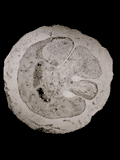 Abstract: The lower Campanian (Upper Cretaceous) Clifton Limestone of Jamaica yields three
species of hippuritid bivalve: Barrettia
ruseae Chubb, Whitfieldiella luceae sp. nov. and Vaccinites vermunti Mac Gillavry,
and the plagioptychid: Plagioptychus
sp. The hippuritids are described in detail using statistics. Barrettia
ruseae is demonstrated to be a more primitive species of Barrettia
than B. monilifera Woodward
or B. multilirata Whitfield,
and the species Whitfieldiella luceae
is shown to be a more primitive species of Whitfieldiella
than W. gigas Chubb.
The specimens of Vaccinites from the
Clifton Limestone are compared with populations of Vaccinites from elsewhere in the Americas, and five species (probably
representing a single evolutionary lineage) are recognized: V.
alencasteri sp. nov. (?late Turonian-?Coniacian), V.
martini Mac Gillavry (probably early
to mid Santonian), V. macgillavryi Palmer
(probably mid to late Santonian), V.
vermunti Mac Gillavry (earliest
Campanian), and V. temazcali sp. nov. (late early Campanian). The Vaccinites
species can be distinguished using statistical techniques. The ages of the
Clifton Limestone and the five Vaccinites
species are reviewed. This research demonstrates the value of using hippuritids
for biostratigraphy in the Upper Cretaceous of the Americas. Abstract: The lower Campanian (Upper Cretaceous) Clifton Limestone of Jamaica yields three
species of hippuritid bivalve: Barrettia
ruseae Chubb, Whitfieldiella luceae sp. nov. and Vaccinites vermunti Mac Gillavry,
and the plagioptychid: Plagioptychus
sp. The hippuritids are described in detail using statistics. Barrettia
ruseae is demonstrated to be a more primitive species of Barrettia
than B. monilifera Woodward
or B. multilirata Whitfield,
and the species Whitfieldiella luceae
is shown to be a more primitive species of Whitfieldiella
than W. gigas Chubb.
The specimens of Vaccinites from the
Clifton Limestone are compared with populations of Vaccinites from elsewhere in the Americas, and five species (probably
representing a single evolutionary lineage) are recognized: V.
alencasteri sp. nov. (?late Turonian-?Coniacian), V.
martini Mac Gillavry (probably early
to mid Santonian), V. macgillavryi Palmer
(probably mid to late Santonian), V.
vermunti Mac Gillavry (earliest
Campanian), and V. temazcali sp. nov. (late early Campanian). The Vaccinites
species can be distinguished using statistical techniques. The ages of the
Clifton Limestone and the five Vaccinites
species are reviewed. This research demonstrates the value of using hippuritids
for biostratigraphy in the Upper Cretaceous of the Americas.
|
|
Carnets Geol., vol. 21, no. 14, p. 315-341
Online since July 7, 2021
|
|
Nomenclatural Note, p. 342
|
|
Kimmeridgian and early Tithonian cephalopods from the Kisújbánya Limestone Formation, Zengővárkony (Mecsek Mountains, southern Hungary), their faunal composition, palaeobiogeographic affinities, and taphonomic character
László BUJTOR, Richárd ALBRECHT, Csaba FARKAS, Bertalan MAKÓ, Dávid MARÓTI & Ákos MIKLÓSY
| HTML  | PDF
| PDF  [3,000 KB]
| DOI: 10.2110/carnets.2021.2113 [3,000 KB]
| DOI: 10.2110/carnets.2021.2113
|
|
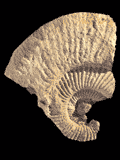 Abstract: A new collection at Zengővárkony
(Mecsek Mountains, Hungary) provided a rich and diverse but poorly preserved cephalopod-dominated fossil assemblage representing the Kimmeridgian and the lower Tithonian. The material
came from mixed scree, soil, and amongst roots affected by weathering processes having been exposed to the elements for a long time. The nautiloid Pseudaganides strambergensis
is the first record from the Mecsek Mountains. Due to the weathering, the ammonite fauna consists of mainly fragmentary and dissolved individuals that comprises 528 specimens belonging
to 34 species and 30 genera out of which 20 species and 15 genera are reported for the first time from the Mecsek Mountains. The fauna includes specimens of known taxa. No new taxa are
introduced. Based on the comparison with other faunas, this assemblage most closely resembles the fauna of the Venetian Alps (Italy). Additional faunal elements include aptychi
(Laevaptychus latus, Lamellaptychus murocostatus), belemnites (Hibolithes semisulcatus), and an indetermined brachiopod. The first record of Spiraserpula spirolinites,
an encrusting fossil polychaete preserved on the internal mould of a Taramelliceras shell fragment indicates favourable bottom conditions for the epifauna. The presence of
Aspidoceras caletanum, Gravesia aff. gigas, and Pseudowaagenia inerme indicates faunal connections with the Submediterranean Province of the Tethys, which is
in line with the tectonic and palaeogeographical position of the Mecsek Zone during the Late Jurassic. The ammonite assemblage represents elements of five Tethysian ammonite zones of the
Kimmeridgian and Tithonian. The lower Kimmeridgian Herbichi Zone is indicated by Streblites tenuilobatus and Praesimoceras herbichi. The upper Kimmeridgian Acanthicum Zone
is indicated by Aspidoceras acanthicum, and the Cavouri Zone by Mesosimoceras cavouri and Aspidoceras caletanum. The upper Kimmeridgian Beckeri Zone is suggested by
Hybonoticeras pressulum and Pseudowaagenia inerme. Whereas Gravesia aff. gigas, Lithacoceras aff. siliceum, and Malagasites? denseplicatus
are faunal elements characterising the Early Tithonian Hybonotum Zone. Phylloceratid and lytoceratid specimens account only for 12% of the fauna, while the majority of the specimens belong
to the Oppeliidae and Ataxioceratidae (60%). Abstract: A new collection at Zengővárkony
(Mecsek Mountains, Hungary) provided a rich and diverse but poorly preserved cephalopod-dominated fossil assemblage representing the Kimmeridgian and the lower Tithonian. The material
came from mixed scree, soil, and amongst roots affected by weathering processes having been exposed to the elements for a long time. The nautiloid Pseudaganides strambergensis
is the first record from the Mecsek Mountains. Due to the weathering, the ammonite fauna consists of mainly fragmentary and dissolved individuals that comprises 528 specimens belonging
to 34 species and 30 genera out of which 20 species and 15 genera are reported for the first time from the Mecsek Mountains. The fauna includes specimens of known taxa. No new taxa are
introduced. Based on the comparison with other faunas, this assemblage most closely resembles the fauna of the Venetian Alps (Italy). Additional faunal elements include aptychi
(Laevaptychus latus, Lamellaptychus murocostatus), belemnites (Hibolithes semisulcatus), and an indetermined brachiopod. The first record of Spiraserpula spirolinites,
an encrusting fossil polychaete preserved on the internal mould of a Taramelliceras shell fragment indicates favourable bottom conditions for the epifauna. The presence of
Aspidoceras caletanum, Gravesia aff. gigas, and Pseudowaagenia inerme indicates faunal connections with the Submediterranean Province of the Tethys, which is
in line with the tectonic and palaeogeographical position of the Mecsek Zone during the Late Jurassic. The ammonite assemblage represents elements of five Tethysian ammonite zones of the
Kimmeridgian and Tithonian. The lower Kimmeridgian Herbichi Zone is indicated by Streblites tenuilobatus and Praesimoceras herbichi. The upper Kimmeridgian Acanthicum Zone
is indicated by Aspidoceras acanthicum, and the Cavouri Zone by Mesosimoceras cavouri and Aspidoceras caletanum. The upper Kimmeridgian Beckeri Zone is suggested by
Hybonoticeras pressulum and Pseudowaagenia inerme. Whereas Gravesia aff. gigas, Lithacoceras aff. siliceum, and Malagasites? denseplicatus
are faunal elements characterising the Early Tithonian Hybonotum Zone. Phylloceratid and lytoceratid specimens account only for 12% of the fauna, while the majority of the specimens belong
to the Oppeliidae and Ataxioceratidae (60%).
|
|
Carnets Geol., vol. 21, no. 13, p. 265-314
Online since July 4, 2021
|
|
The Cretaceous nautiloid genus Anglonautilus Spath, 1927, in France
Cyril BAUDOUIN, Gérard DELANOY, Jens LEHMANN, Camille FRAU, Roland GONNET & Jean VERMEULEN
| HTML  | PDF
| PDF  [4,157 KB]
| DOI: 10.2110/carnets.2021.2112 [4,157 KB]
| DOI: 10.2110/carnets.2021.2112
|
|
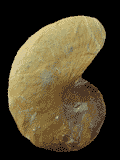 Abstract: The occurrence of the nautiloid genus Anglonautilus Spath
in France was limited to the report of Anglonautilus
dorsoplicatus (Wiedmann)
from the Albian of Escragnolles (Alpes-Maritimes) and Anglonautilus sp. from the Aptian of Les Ferres (Alpes-Maritimes).
Here we document the presence of the successive species Anglonautilus
praeundulatus Lehmann et al., Anglonautilus
undulatus (Sowerby) and Anglonautilus
dorsoplicatus (Wiedmann) from the Cretaceous of France. The
stratigraphic range of Anglonautilus
Spath, hitherto unknown before Aptian times is extended downward
to the Hauterivian. The Hauterivian species Nautilus
begudensis Kilian & Reboul, sometimes assigned to the genus Anglonautilus
Spath, is revised and re-assigned to the genus Cymatoceras
Hyatt. Abstract: The occurrence of the nautiloid genus Anglonautilus Spath
in France was limited to the report of Anglonautilus
dorsoplicatus (Wiedmann)
from the Albian of Escragnolles (Alpes-Maritimes) and Anglonautilus sp. from the Aptian of Les Ferres (Alpes-Maritimes).
Here we document the presence of the successive species Anglonautilus
praeundulatus Lehmann et al., Anglonautilus
undulatus (Sowerby) and Anglonautilus
dorsoplicatus (Wiedmann) from the Cretaceous of France. The
stratigraphic range of Anglonautilus
Spath, hitherto unknown before Aptian times is extended downward
to the Hauterivian. The Hauterivian species Nautilus
begudensis Kilian & Reboul, sometimes assigned to the genus Anglonautilus
Spath, is revised and re-assigned to the genus Cymatoceras
Hyatt.
|
|
Carnets Geol., vol. 21, no. 12, p. 235-263
Online since June 24, 2021
|
|
New insights into the depositional environment and stratigraphic position of the Gugu Breccia (Pădurea Craiului Mountains, Romania)
Traian SUCIU, George PLEŞ, Tudor TĂMAŞ, Ioan I. BUCUR, Emanoil SĂSĂRAN & Ioan COCIUBA
| HTML  | PDF
| PDF  [3,293 KB]
| DOI: 10.2110/carnets.2021.2111 [3,293 KB]
| DOI: 10.2110/carnets.2021.2111
|
|
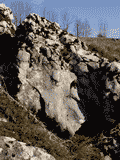 Abstract: The study of the carbonate clasts
and matrix of a problematic sedimentary formation (the Gugu Breccia) from the Pădurea
Craiului Mountains reveals new information concerning its depositional
environment and stratigraphic position. The identified microfacies and
micropaleontological assemblages demonstrate that all the sampled limestone
clasts from the Gugu Breccia represent remnants of a fragmented Urgonian-type carbonate platform. The Barremian age of the
clasts suggests that the stratigraphic position of the Gugu Breccia at its type
locality could be uppermost Barremian-lowermost Aptian, a fact demonstrated
also by the absence of elements from Lower Cretaceous carbonate platforms higher
in the stratigraphic column (e.g., Aptian or Albian) of the Bihor Unit. The sedimentological
observations together with the matrix mineralogy bring new
arguments for the recognition of terrigenous input during the formation of the
Gugu Breccia. Abstract: The study of the carbonate clasts
and matrix of a problematic sedimentary formation (the Gugu Breccia) from the Pădurea
Craiului Mountains reveals new information concerning its depositional
environment and stratigraphic position. The identified microfacies and
micropaleontological assemblages demonstrate that all the sampled limestone
clasts from the Gugu Breccia represent remnants of a fragmented Urgonian-type carbonate platform. The Barremian age of the
clasts suggests that the stratigraphic position of the Gugu Breccia at its type
locality could be uppermost Barremian-lowermost Aptian, a fact demonstrated
also by the absence of elements from Lower Cretaceous carbonate platforms higher
in the stratigraphic column (e.g., Aptian or Albian) of the Bihor Unit. The sedimentological
observations together with the matrix mineralogy bring new
arguments for the recognition of terrigenous input during the formation of the
Gugu Breccia.
|
|
Carnets Geol., vol. 21, no. 11, p. 215-233
Online since June 24, 2021
|
|
Another thermophilic "Miocene survivor" from the Italian Pliocene: A geologically young occurrence of the pelagic eagle ray Aetobatus in the Euro-Mediterranean region
Alberto COLLARETA, Marco MERELLA, Simone CASATI, Giovanni COLETTI & Andrea DI CENCIO
| HTML  | PDF
| PDF  [669 KB]
| DOI: 10.2110/carnets.2021.2110 [669 KB]
| DOI: 10.2110/carnets.2021.2110
|
|
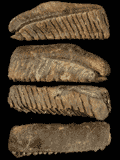 Abstract: Aetobatus
(Myliobatiformes: Aetobatidae) is a living genus of eagle rays that occurs in
shallow-marine, tropical and subtropical environments of the Atlantic, Pacific,
and Indian Oceans. Nowadays, Aetobatus does not inhabit the cool- to
warm-temperate European and Mediterranean waters, though it is known from this
broad region by virtue of several fossil teeth ranging chronostratigraphically
from the lower Palaeogene to the upper Neogene. The present paper reports on a
fossil aetobatid tooth discovered in mid-Pliocene (upper Zanclean to lower
Piacenzian, 3.82-3.19 Ma) marine deposits exposed in the vicinities of Certaldo
(Tuscany, Italy) and identified as belonging to †Aetobatus cf.
cappettai. This specimen comprises the youngest occurrence of Aetobatus
along the coasts of mainland Europe; furthermore, together with previous finds
from roughly coeval deposits of Mallorca (Balearic Islands, Spain), it
represents the most recent record of this genus in the whole Euro-Mediterranean
region. In light of the environmental preferences of extant Aetobatus
spp., our discovery suggests palaeoenvironmental conditions favourable to the
persistence of tropical/subtropical taxa of "Miocene survivors" along
the Pliocene coasts of Tuscany. In addition, it raises the question of whether
or not the Messinian Salinity Crisis really resulted in the complete collapse of
the Mediterranean marine biota and in the subsequent recolonisation of the
Mediterranean Basin from the adjoining Atlantic waters and/or scattered marginal
intrabasinal refugia at the beginning of the Pliocene. The possibility of Aetobatus
recolonising the Mediterranean Sea through the Suez Canal in the near future is
discussed. Abstract: Aetobatus
(Myliobatiformes: Aetobatidae) is a living genus of eagle rays that occurs in
shallow-marine, tropical and subtropical environments of the Atlantic, Pacific,
and Indian Oceans. Nowadays, Aetobatus does not inhabit the cool- to
warm-temperate European and Mediterranean waters, though it is known from this
broad region by virtue of several fossil teeth ranging chronostratigraphically
from the lower Palaeogene to the upper Neogene. The present paper reports on a
fossil aetobatid tooth discovered in mid-Pliocene (upper Zanclean to lower
Piacenzian, 3.82-3.19 Ma) marine deposits exposed in the vicinities of Certaldo
(Tuscany, Italy) and identified as belonging to †Aetobatus cf.
cappettai. This specimen comprises the youngest occurrence of Aetobatus
along the coasts of mainland Europe; furthermore, together with previous finds
from roughly coeval deposits of Mallorca (Balearic Islands, Spain), it
represents the most recent record of this genus in the whole Euro-Mediterranean
region. In light of the environmental preferences of extant Aetobatus
spp., our discovery suggests palaeoenvironmental conditions favourable to the
persistence of tropical/subtropical taxa of "Miocene survivors" along
the Pliocene coasts of Tuscany. In addition, it raises the question of whether
or not the Messinian Salinity Crisis really resulted in the complete collapse of
the Mediterranean marine biota and in the subsequent recolonisation of the
Mediterranean Basin from the adjoining Atlantic waters and/or scattered marginal
intrabasinal refugia at the beginning of the Pliocene. The possibility of Aetobatus
recolonising the Mediterranean Sea through the Suez Canal in the near future is
discussed.
|
|
Carnets Geol., vol. 21, no. 10, p. 203-214
Online since June 24, 2021
|
|
The Kalkowsky Project - Chapter I. Ooid - stromatoid relationship in a stromatolite from the Maiz Gordo Fm (Argentina)
Bruno R.C. GRANIER & Philippe LAPOINTE
| HTML  | PDF
| PDF  [1,742 KB]
| DOI: 10.2110/carnets.2021.2109 [1,742 KB]
| DOI: 10.2110/carnets.2021.2109
|
|
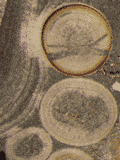 Abstract: The
comparative study of oolites and stromatolites demonstrates striking
similarities between Kalkowsky's German Triassic material (drawn from the
scientific literature) and our Argentinian Paleogene material. However, the
latter better illustrates that ooids and stromatoids, hence oolites and
stromatolites, which share the same dual (i.e., organic and mineral)
nature, are merely the end-members of a continuum of microbial carbonate
structures. Abstract: The
comparative study of oolites and stromatolites demonstrates striking
similarities between Kalkowsky's German Triassic material (drawn from the
scientific literature) and our Argentinian Paleogene material. However, the
latter better illustrates that ooids and stromatoids, hence oolites and
stromatolites, which share the same dual (i.e., organic and mineral)
nature, are merely the end-members of a continuum of microbial carbonate
structures.
|
|
Carnets Geol., vol. 21, no. 9, p. 193-201
Online since June 14, 2021
|
|
Messinian ostracodes from the western Betic Strait (SW Spain)
Verónica ROMERO, Francisco RUIZ, María Luz GONZÁLEZ-REGALADO, Josep TOSQUELLA, Manuel ABAD, Tatiana IZQUIERDO, Antonio TOSCANO & Paula GÓMEZ
| HTML  | PDF
| PDF  [620 KB]
| DOI: 10.2110/carnets.2021.2108 [620 KB]
| DOI: 10.2110/carnets.2021.2108
|
|
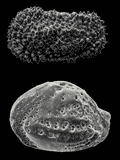 Abstract: During the Neogene, the Betic Strait was one of the gateways that connected the Atlantic Ocean and the Mediterranean Sea. In this paper, we have analyzed the ostracod faunas of samples collected from sediments crossed by a long borehole in southwestern Spain. These sediments were deposited in the Betic strait just before the Messinian Salinity Crisis. During the middle Messinian (6.8-6.0 Ma), the scarce and low diversified ostracod assemblages (Krithe, Parakrithe, Henryhowella) are typical of upper bathyal palaeoenvironments (200-400 m water depth). This period includes a short transition (6.26-6.25 Ma) to outer neritic palaeoenvironments, coinciding with a glaciation and characterized by the presence of Acanthocythereis hystrix (Reuss, 1850) and the disappearance of Krithe and Parakrithe. The most abundant species have a wide biostratigraphic distribution, most of them ranging from the Tortonian until the Holocene. Abstract: During the Neogene, the Betic Strait was one of the gateways that connected the Atlantic Ocean and the Mediterranean Sea. In this paper, we have analyzed the ostracod faunas of samples collected from sediments crossed by a long borehole in southwestern Spain. These sediments were deposited in the Betic strait just before the Messinian Salinity Crisis. During the middle Messinian (6.8-6.0 Ma), the scarce and low diversified ostracod assemblages (Krithe, Parakrithe, Henryhowella) are typical of upper bathyal palaeoenvironments (200-400 m water depth). This period includes a short transition (6.26-6.25 Ma) to outer neritic palaeoenvironments, coinciding with a glaciation and characterized by the presence of Acanthocythereis hystrix (Reuss, 1850) and the disappearance of Krithe and Parakrithe. The most abundant species have a wide biostratigraphic distribution, most of them ranging from the Tortonian until the Holocene.
|
|
Carnets Geol., vol. 21, no. 8, p. 181-192
Online since April 1, 2021
|
|
Jurassian brachiopods of the Valanginian - Hauterivian interval. Their contribution to the dating of the Salima Formation in Mount Lebanon
Yves ALMÉRAS, Serge FERRY, Bruno R.C. GRANIER & Yann MERRAN
| HTML  | PDF
| PDF  [1,734 KB]
| DOI: 10.2110/carnets.2021.2107 [1,734 KB]
| DOI: 10.2110/carnets.2021.2107
|
|
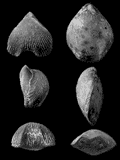 Abstract: The
Jurassian French or Swiss outcrops of the lowermost Cretaceous (Valanginian or Hauterivian) yield numerous brachiopod species including
3 species: Lamellaerhynchia
desori (Loriol in Pictet & Campiche,
1872), Sulcirhynchia valangiensis (Loriol, 1864), and Terebratulina
arzierensis (Loriol, 1864), which are not found in Lebanon. The fossiliferous site of the Salima Formation at
Zeghrine, a locality close to Bikfaya (Mount Lebanon), yields an assemblage made of Belothyris pseudojurensis
(Leymerie, 1842), Lamellaerhynchia
hauteriviensis Burri,
1953, Loriolithyris valdensis (Loriol, 1868), Lor. latifrons
(Pictet, 1872), Sellithyris carteroniana (Orbigny, 1847),
and Terebratulina biauriculata Orbigny, 1850; all are also present
in Jurassian localities. On the basis of the study
of its brachiopod assemblage, the Salima Formation is therefore ascribed an
undifferentiated Valanginian age. Abstract: The
Jurassian French or Swiss outcrops of the lowermost Cretaceous (Valanginian or Hauterivian) yield numerous brachiopod species including
3 species: Lamellaerhynchia
desori (Loriol in Pictet & Campiche,
1872), Sulcirhynchia valangiensis (Loriol, 1864), and Terebratulina
arzierensis (Loriol, 1864), which are not found in Lebanon. The fossiliferous site of the Salima Formation at
Zeghrine, a locality close to Bikfaya (Mount Lebanon), yields an assemblage made of Belothyris pseudojurensis
(Leymerie, 1842), Lamellaerhynchia
hauteriviensis Burri,
1953, Loriolithyris valdensis (Loriol, 1868), Lor. latifrons
(Pictet, 1872), Sellithyris carteroniana (Orbigny, 1847),
and Terebratulina biauriculata Orbigny, 1850; all are also present
in Jurassian localities. On the basis of the study
of its brachiopod assemblage, the Salima Formation is therefore ascribed an
undifferentiated Valanginian age.
|
|
Carnets Geol., vol. 21, no. 7, p. 163-179
Online since March 24, 2021
|
|
First record of late Campanian paleoceanographic and paleoclimatic changes, Arabian Platform, Mazidag-Mardin area, SE Turkey
İsmail Ömer YILMAZ, Izzet HOŞGÖR, Sevinç ÖZKAN-ALTINER, Michael WAGREICH & Jiří KVAČEK
| HTML  | PDF
| PDF  [1,897 KB]
| DOI: 10.2110/carnets.2021.2106 [1,897 KB]
| DOI: 10.2110/carnets.2021.2106
|
|
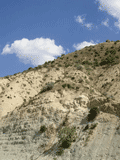 Abstract: The
sedimentology, geochemistry and paleontology of the pelagic upper Campanian
Maastrichtian Bozova Formation in the "Mazidag" (Mazıdağı)
- Mardin area, SE Turkey, reveal
paleoceanographic and paleoecological changes for the first time. A 119.25
m-thick composite stratigraphic section is characterized by alternating marls,
clayey limestones, shales, and black shales; no coarse siliciclastic admixture
or turbidite intercalations were recorded in the section. Biostratigraphic data
indicate the presence of the Radotruncana
calcarata Zone, and the UC15de/UC16 nannofossil zones. Stable isotope and
elemental geochemical analyses have been carried out in the studied section. The
isotope curves display similar patterns compared to reference curves from
European and Chinese basins in the same interval. The prominent negative carbon
isotope excursion determined in the upper interval can be correlated with the
Late Campanian Event. Proxy elements display generally two relative rising
trends in productivity from the lower part and the middle part of the
succession. The lower part of the section records relatively more dysoxic/anoxic
conditions and coincides with common black shale beds. Abstract: The
sedimentology, geochemistry and paleontology of the pelagic upper Campanian
Maastrichtian Bozova Formation in the "Mazidag" (Mazıdağı)
- Mardin area, SE Turkey, reveal
paleoceanographic and paleoecological changes for the first time. A 119.25
m-thick composite stratigraphic section is characterized by alternating marls,
clayey limestones, shales, and black shales; no coarse siliciclastic admixture
or turbidite intercalations were recorded in the section. Biostratigraphic data
indicate the presence of the Radotruncana
calcarata Zone, and the UC15de/UC16 nannofossil zones. Stable isotope and
elemental geochemical analyses have been carried out in the studied section. The
isotope curves display similar patterns compared to reference curves from
European and Chinese basins in the same interval. The prominent negative carbon
isotope excursion determined in the upper interval can be correlated with the
Late Campanian Event. Proxy elements display generally two relative rising
trends in productivity from the lower part and the middle part of the
succession. The lower part of the section records relatively more dysoxic/anoxic
conditions and coincides with common black shale beds.
The presence of both diverse planktonic foraminifera and calcareous nannofossils in
the studied interval indicates
a fully marine, warm-water, low-latitude Tethysian oceanic environment. In
addition, the plant fossils derived from the nearby land mass indicate that a
tropical humid climate was similar to that in northeast Australia. Therefore,
warm water, tropical humid atmospheric conditions developed in the studied area
causing the rise in productivity, precipitation and transportation of plant
debris into offshore environments.
|
|
Carnets Geol., vol. 21, no. 6, p. 137-162
Online since March 24, 2021
|
|
Bioerosion in Ostrea lamellosa shells from the Messinian of the Tafna basin (NW Algeria)
Mohammed N. NAIMI, Olev VINN & Amine CHERIF
| HTML  | PDF
| PDF  [1,139 KB]
| DOI: 10.2110/carnets.2021.2105 [1,139 KB]
| DOI: 10.2110/carnets.2021.2105
|
|
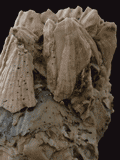 Abstract: Bioerosional trace fossils (borings) are reported for the first time in
Algeria. Three ichnotaxa observed
in the shells of Ostrea lamellosa from the lower Messinian (upper
Miocene)
deposits of the Tafna basin (NW Algeria) are described. The ichnotaxa are Entobia
cf. geometrica, Gastrochaenolites cf. torpedo and Trypanites
isp.. Ostrea lamellosa shells are encrusted by balanid barnacles which are
bored by Trypanites isp.. The ichnoassemblage is assigned to the Trypanites
ichnofacies. Besides the bioerosion and encrustation described herein,
specimens permitted the identification of the different phases of the Messinian
transgression across the Souk el Khemis shoal. Abstract: Bioerosional trace fossils (borings) are reported for the first time in
Algeria. Three ichnotaxa observed
in the shells of Ostrea lamellosa from the lower Messinian (upper
Miocene)
deposits of the Tafna basin (NW Algeria) are described. The ichnotaxa are Entobia
cf. geometrica, Gastrochaenolites cf. torpedo and Trypanites
isp.. Ostrea lamellosa shells are encrusted by balanid barnacles which are
bored by Trypanites isp.. The ichnoassemblage is assigned to the Trypanites
ichnofacies. Besides the bioerosion and encrustation described herein,
specimens permitted the identification of the different phases of the Messinian
transgression across the Souk el Khemis shoal.
|
|
Carnets Geol., vol. 21, no. 5, p. 127-135
Online since February 28, 2021
|
|
Mediterranean Neocomian belemnites, part 5: Valanginian temporal distribution and zonation (and some lithological remarks)
Nico M.M. JANSSEN
| HTML  | PDF
| PDF  [5,238 KB]
| DOI: 10.2110/carnets.2021.2104 [5,238 KB]
| DOI: 10.2110/carnets.2021.2104
|
|
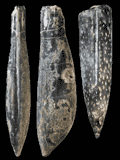 Abstract: A zonation based on the temporal distribution of belemnites is presented for the
Valanginian and its boundaries. It is calibrated on ammonite controlled and bed-by-bed
correlated sections from the pre-Vocontian Basin (southeast France). Three new sections are introduced
herein that have previously not been investigated. All
together, seven zones and six subzones are introduced. In addition, both within
the Vocontian area, as well as outside (Bulgaria, Crimea, Czech
Republic, France, Hungary, Morocco, Romania, Slovakia, Spain, Switzerland), differences regarding the spatial
distribution of belemnites are investigated. Also, in two addenda, some
remarks are given regarding lithological oddities. Abstract: A zonation based on the temporal distribution of belemnites is presented for the
Valanginian and its boundaries. It is calibrated on ammonite controlled and bed-by-bed
correlated sections from the pre-Vocontian Basin (southeast France). Three new sections are introduced
herein that have previously not been investigated. All
together, seven zones and six subzones are introduced. In addition, both within
the Vocontian area, as well as outside (Bulgaria, Crimea, Czech
Republic, France, Hungary, Morocco, Romania, Slovakia, Spain, Switzerland), differences regarding the spatial
distribution of belemnites are investigated. Also, in two addenda, some
remarks are given regarding lithological oddities.
|
|
Carnets Geol., vol. 21, no. 4, p. 67-126
Online since February 28, 2021
|
|
Revision of Ostrea (Gigantostrea) gigantica Solander var. oligoplana Sacco and Ostrea (Ostrea) isseli Rovereto (Oligocene, Tertiary Piedmont Basin, NW Italy)
Maria Cristina BONCI, Davide DAGNINO, Andrea MANDARINO, Aaron MAZZINI & Michele PIAZZA
| HTML  | PDF
| PDF  [1,573 KB]
| DOI: 10.2110/carnets.2021.2103 [1,573 KB]
| DOI: 10.2110/carnets.2021.2103
|
|
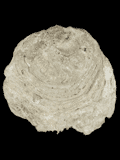 Abstract: The aim of this paper is the revision and redocumentation
of Ostrea (Gigantostrea) gigantica Solander
var. oligoplana Sacco, 1897, Ostrea (Ostrea) isseli n. denom. Rovereto,
1897, and Ostrea
(Ostrea) isseli n. denom. var. elongata
Rovereto, 1897. These taxa are from the Oligocene
strata of the Molare Formation (Tertiary Piedmont Basin, southern Piedmont -
central Liguria, NW Italy). The syntypes of O. (G.)
gigantica var. oligoplana are in
the "Collezione Bellardi e Sacco", at the Museo
Regionale di Scienze Naturali di Torino; the syntypes of O. (O.)
isseli and O. (O.)
isseli var. elongata are in the "Collezione BTP" (BTP Collection, at the
Dipartimento di Scienze della Terra, dell'Ambiente e della Vita - DISTAV - of
the Università di Genova). The var. oligoplana is here moved to the species rank and allocated to the
genus Pycnodonte Fischer von Waldheim, 1835. O. (O.)
isseli and O. (O.)
isseli var. elongata are
recognized as junior synonyms of the Sacco's taxon. Rovereto
(1897) compared his new species with Ostrea
subgigantea Raulin & Delbos,
1855, a poorly known taxon,
that is here figured for the first time and shown to represent a species
different from P. oligoplana (Sacco, 1897). Abstract: The aim of this paper is the revision and redocumentation
of Ostrea (Gigantostrea) gigantica Solander
var. oligoplana Sacco, 1897, Ostrea (Ostrea) isseli n. denom. Rovereto,
1897, and Ostrea
(Ostrea) isseli n. denom. var. elongata
Rovereto, 1897. These taxa are from the Oligocene
strata of the Molare Formation (Tertiary Piedmont Basin, southern Piedmont -
central Liguria, NW Italy). The syntypes of O. (G.)
gigantica var. oligoplana are in
the "Collezione Bellardi e Sacco", at the Museo
Regionale di Scienze Naturali di Torino; the syntypes of O. (O.)
isseli and O. (O.)
isseli var. elongata are in the "Collezione BTP" (BTP Collection, at the
Dipartimento di Scienze della Terra, dell'Ambiente e della Vita - DISTAV - of
the Università di Genova). The var. oligoplana is here moved to the species rank and allocated to the
genus Pycnodonte Fischer von Waldheim, 1835. O. (O.)
isseli and O. (O.)
isseli var. elongata are
recognized as junior synonyms of the Sacco's taxon. Rovereto
(1897) compared his new species with Ostrea
subgigantea Raulin & Delbos,
1855, a poorly known taxon,
that is here figured for the first time and shown to represent a species
different from P. oligoplana (Sacco, 1897).
|
|
Carnets Geol., vol. 21, no. 3, p. 55-66
Online since February 24, 2021
|
|
Systematic revision and evolution of the Tithonian family Chitinoidellidae Trejo, 1975
Mohamed BENZAGGAGH
| HTML  | PDF
| PDF  [1,884 KB]
| DOI: 10.2110/carnets.2021.2102 [1,884 KB]
| DOI: 10.2110/carnets.2021.2102
|
|
 Abstract: Several new genera and species of the family Chitinoidellidae Trejo,
1975, were erected
by Pop (1997, 1998a, 1998b). Some of these taxa are justified, but others are inadequately defined, and require revision. I discuss herein the non-validity of some taxa and propose a new systematic classification and an evolutionary framework for the family Chitinoidellidae, with two subfamilies:
1) Dobeninae, which include small-sized chitinoidellids, with the genera Borziella Pop,
1997, Carpathella Pop, 1998a, Daciella Pop,
1998a (amended), Dobenilla n. gen., and Popiella Reháková,
2002, and
2) Bonetinae, which includes larger-sized chitinoidellids, with the genera Bermudeziella n. gen., Bonetilla n. gen., and Furrazolaia n. gen.. These two families are separated in time. Small species of the subfamily Dobeninae characterise the Dobeni Subzone (Ponti ammonite Zone) and disappear immediately before the occurrence of the larger specimens of the subfamily Bonetinae, which characterise the Boneti Subzone (Microcanthum p.p. ammonite Zone). Abstract: Several new genera and species of the family Chitinoidellidae Trejo,
1975, were erected
by Pop (1997, 1998a, 1998b). Some of these taxa are justified, but others are inadequately defined, and require revision. I discuss herein the non-validity of some taxa and propose a new systematic classification and an evolutionary framework for the family Chitinoidellidae, with two subfamilies:
1) Dobeninae, which include small-sized chitinoidellids, with the genera Borziella Pop,
1997, Carpathella Pop, 1998a, Daciella Pop,
1998a (amended), Dobenilla n. gen., and Popiella Reháková,
2002, and
2) Bonetinae, which includes larger-sized chitinoidellids, with the genera Bermudeziella n. gen., Bonetilla n. gen., and Furrazolaia n. gen.. These two families are separated in time. Small species of the subfamily Dobeninae characterise the Dobeni Subzone (Ponti ammonite Zone) and disappear immediately before the occurrence of the larger specimens of the subfamily Bonetinae, which characterise the Boneti Subzone (Microcanthum p.p. ammonite Zone).
|
|
Carnets Geol., vol. 21, no. 2, p. 27-53
Online since February 15, 2021
|
|
Nomenclatural Note, p. 54
|
|
Apianella nom. nov. (Dasycladales, Triploporellaceae): New name for the preoccupied
algal genus Apinella Granier et al., 1986
Bruno GRANIER & François MICHAUD
| PDF  [123 KB]
| DOI: 10.2110/carnets.2021.21NN1 [123 KB]
| DOI: 10.2110/carnets.2021.21NN1
|
|
Carnets Geol., vol. 21, Nomenclatural Note 1, p. 26
Online since January 21, 2021
|
|
Bacinella, a discrete type of Mesozoic calcimicrobial structure
Bruno R.C. GRANIER
| HTML  | PDF
| PDF  [3,800 KB]
| DOI: 10.2110/carnets.2021.2101 [3,800 KB]
| DOI: 10.2110/carnets.2021.2101
|
|
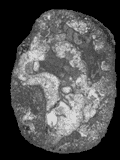 Abstract: The controversy surrounding Bacinella
irregularis Radoičić, 1959, and Lithocodium aggregatum
Elliott, 1956, has involved both sedimentologists and paleontologists.
Arguments to exclude them from the Codiaceae are reviewed. The same arguments
may be advanced to exclude their ascription to most other organisms. The only
hypothesis resisting all elements of disproof is that of a consortium involving
microbial communities. Accordingly, these structures are treated here as
biosedimentary structures, namely bacinella structures, and not as taxa. One of the features
specific to the organisms that built these structures is their strong corroding ability, as
shown by the examples of fossils partly or fully cannibalized. This represents
one state of corrosion beyond surficial etching and borings. Besides their capacity to corrode calcareous substrates, these
microbial organisms formed nodules or oncoids and even built biostromes, which, depending on their stage of development, may
have formed soft, firm or even hard substrates. However, to our knowledge, microbial
communities contributing to bacinella
structures never built up any bioherm. To complete this summary review, a
building-block model that coherently takes into account most architectural
variations is presented in the form of a figure sketch. The endolithic
foraminifer Troglotella incrustans, which is commonly found associated with bacinella structures, is
not an encruster or a borer. Lastly, contrary to certain erroneous hypotheses, no
major bacinella episode has been ever found coeval with any significant Oceanic Anoxic Event. Abstract: The controversy surrounding Bacinella
irregularis Radoičić, 1959, and Lithocodium aggregatum
Elliott, 1956, has involved both sedimentologists and paleontologists.
Arguments to exclude them from the Codiaceae are reviewed. The same arguments
may be advanced to exclude their ascription to most other organisms. The only
hypothesis resisting all elements of disproof is that of a consortium involving
microbial communities. Accordingly, these structures are treated here as
biosedimentary structures, namely bacinella structures, and not as taxa. One of the features
specific to the organisms that built these structures is their strong corroding ability, as
shown by the examples of fossils partly or fully cannibalized. This represents
one state of corrosion beyond surficial etching and borings. Besides their capacity to corrode calcareous substrates, these
microbial organisms formed nodules or oncoids and even built biostromes, which, depending on their stage of development, may
have formed soft, firm or even hard substrates. However, to our knowledge, microbial
communities contributing to bacinella
structures never built up any bioherm. To complete this summary review, a
building-block model that coherently takes into account most architectural
variations is presented in the form of a figure sketch. The endolithic
foraminifer Troglotella incrustans, which is commonly found associated with bacinella structures, is
not an encruster or a borer. Lastly, contrary to certain erroneous hypotheses, no
major bacinella episode has been ever found coeval with any significant Oceanic Anoxic Event.
|
|
Carnets Geol., vol. 21, no. 1, p. 1-25
Online since January 21, 2021
|

|
|
2020 (vol. 20)
|
|
The biosignature of sparite permits the distinction between gravitational cement and endostromatolites
Bruno R.C. GRANIER
| HTML  | PDF
| PDF  [2,953 KB]
| DOI: 10.2110/carnets.2020.2020 [2,953 KB]
| DOI: 10.2110/carnets.2020.2020
|
|
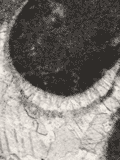 Abstract: Following
a brief summary of some fundamentals in carbonate sedimentology (sedimentary petrography) that highlights the
significance of organic matter, some examples of biocrystals in carbonate
grains/particles, such as bioclasts or ooids, are provided as
an introductory chapter to a discussion on gravitational cements versus
endostromatolites. The gravitational cements, either marine (fibrous) or
continental (dog-tooth), are made of hyaline (i.e., translucent)
sparitic crystals whereas endostromatolites are made of colored sparitic
crystals and/or micrite. Gravitational cements forms in the vadose zone
whereas endostromatolites grow in small rock cavities in the
marine phreatic zone. As such the latter can grow centripetally in all directions (not
only downward). Abstract: Following
a brief summary of some fundamentals in carbonate sedimentology (sedimentary petrography) that highlights the
significance of organic matter, some examples of biocrystals in carbonate
grains/particles, such as bioclasts or ooids, are provided as
an introductory chapter to a discussion on gravitational cements versus
endostromatolites. The gravitational cements, either marine (fibrous) or
continental (dog-tooth), are made of hyaline (i.e., translucent)
sparitic crystals whereas endostromatolites are made of colored sparitic
crystals and/or micrite. Gravitational cements forms in the vadose zone
whereas endostromatolites grow in small rock cavities in the
marine phreatic zone. As such the latter can grow centripetally in all directions (not
only downward).
|
|
Carnets Geol., vol. 20, no. 20, p. 407-419
Online since November 20, 2020
|
|
The Mesozoic scleractinian genus Adelocoenia (Stylinidae) and its Jurassic species
Bernard LATHUILIÈRE , Rosemarie C. BARON-SZABO, Sylvain CHARBONNIER & Jean-Michel PACAUD
| HTML  | PDF
| PDF  [4,677 KB]
| DOI: 10.2110/carnets.2020.2019 [4,677 KB]
| DOI: 10.2110/carnets.2020.2019
|
|
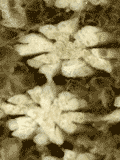 Abstract: The genus Adelocoenia Orbigny,
1849, is revised and a neotype is
designated for its type species Astrea
castellum Michelin, 1844. For various reasons that lie in the
taxonomic history of scleractinian corals, it has become a difficult task to
reliably assign Mesozoic corals having the combined features of plocoid
corallite integration and the absence of a columella. Therefore, many such
genera are in need of revision, one of which is Adelocoenia. In addition to the revision of the type species,
Jurassic species grouped within Adelocoenia
are revised using type material when it was possible. Many new synonymies are
proposed based mainly on characters such as symmetry and dimensions of skeletal
features. Another consequence is that most species previously grouped with Pseudocoenia
Orbigny are transferred to Adelocoenia.
Furthermore, we present a clarified view of the paleogeographical and
stratigraphical distributional patterns of the genus Adelocoenia, according to which Adelocoenia
had its first appearance during the Early Jurassic, represented by a single
specimen known from the Sinemurian of France. Subsequently, this genus had a
significant increase in both distribution and diversity during the Middle
Jurassic. The pinnacle of its success followed in the Late Jurassic during which
Adelocoenia had its greatest
morphological disparity and taxonomical diversity, and its largest geographical
distribution. The genus survived in the Cretaceous record. Throughout its
history, Adelocoenia predominantly
occurred in inner platform environments that were located in low latitudes. Abstract: The genus Adelocoenia Orbigny,
1849, is revised and a neotype is
designated for its type species Astrea
castellum Michelin, 1844. For various reasons that lie in the
taxonomic history of scleractinian corals, it has become a difficult task to
reliably assign Mesozoic corals having the combined features of plocoid
corallite integration and the absence of a columella. Therefore, many such
genera are in need of revision, one of which is Adelocoenia. In addition to the revision of the type species,
Jurassic species grouped within Adelocoenia
are revised using type material when it was possible. Many new synonymies are
proposed based mainly on characters such as symmetry and dimensions of skeletal
features. Another consequence is that most species previously grouped with Pseudocoenia
Orbigny are transferred to Adelocoenia.
Furthermore, we present a clarified view of the paleogeographical and
stratigraphical distributional patterns of the genus Adelocoenia, according to which Adelocoenia
had its first appearance during the Early Jurassic, represented by a single
specimen known from the Sinemurian of France. Subsequently, this genus had a
significant increase in both distribution and diversity during the Middle
Jurassic. The pinnacle of its success followed in the Late Jurassic during which
Adelocoenia had its greatest
morphological disparity and taxonomical diversity, and its largest geographical
distribution. The genus survived in the Cretaceous record. Throughout its
history, Adelocoenia predominantly
occurred in inner platform environments that were located in low latitudes.
|
|
Carnets Geol., vol. 20, no. 19, p. 367-406
Online since November 11, 2020
|
|
Exceptionally well-preserved silicified hippuritid rudist bivalves from the lower Maastrichtian of Puerto Rico
Simon F. MITCHELL
| HTML  | PDF
| PDF  [5,339 KB]
| DOI: 10.2110/carnets.2020.2018 [5,339 KB]
| DOI: 10.2110/carnets.2020.2018
|
|
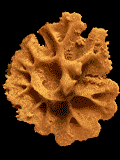 Abstract: Exceptionally
well-preserved (silicified) hippuritid rudists occur in the El Rayo Formation (lower
Maastrichtian) of south-western Puerto Rico. Three species belonging to three
different genera are present: Caribbea
muellerreidi (Vermunt), Laluzia
peruviana (Gerth) and Parastroma
guitarti (Palmer). Acid digestion of the limestones has resulted in a
collection with numerous three-dimensional left and right valves many with the
preservation of the minute details of the pore system. The morphological
features of each species are described, and many features are illustrated for
the first time. The new material, coupled with descriptions from other studies,
demonstrates that six genera of endemic hippuritids evolved in two separate
radiations in the New World: an older radiation of forms that had pallial canals
in their left valves (Barrettia, Whitfieldiella
and Parastroma) and a younger
radiation of forms lacking pallial canals in their left valves (Laluzia, Caribbea and Praebarrettia).
The exquisite preservation also reveals that in these endemic New World
hippuritids the sockets for the teeth consisted of slots into which ribs on the
teeth fitted; this contrasts with Old World hippuritids that have true sockets
formed from upfolds of the tabulae for the teeth. The distinctive morphology of
the tooth sockets is here used to define a monophyletic subfamily for which the
name Barrettiinae Chubb is available. Abstract: Exceptionally
well-preserved (silicified) hippuritid rudists occur in the El Rayo Formation (lower
Maastrichtian) of south-western Puerto Rico. Three species belonging to three
different genera are present: Caribbea
muellerreidi (Vermunt), Laluzia
peruviana (Gerth) and Parastroma
guitarti (Palmer). Acid digestion of the limestones has resulted in a
collection with numerous three-dimensional left and right valves many with the
preservation of the minute details of the pore system. The morphological
features of each species are described, and many features are illustrated for
the first time. The new material, coupled with descriptions from other studies,
demonstrates that six genera of endemic hippuritids evolved in two separate
radiations in the New World: an older radiation of forms that had pallial canals
in their left valves (Barrettia, Whitfieldiella
and Parastroma) and a younger
radiation of forms lacking pallial canals in their left valves (Laluzia, Caribbea and Praebarrettia).
The exquisite preservation also reveals that in these endemic New World
hippuritids the sockets for the teeth consisted of slots into which ribs on the
teeth fitted; this contrasts with Old World hippuritids that have true sockets
formed from upfolds of the tabulae for the teeth. The distinctive morphology of
the tooth sockets is here used to define a monophyletic subfamily for which the
name Barrettiinae Chubb is available.
|
|
Carnets Geol., vol. 20, no. 18, p. 333-366
Online since November 11, 2020
|
|
Messinian Lago-Mare ostracods from Tunisia
Rim TEMANI, Francesco SCIUTO & Hayet K. AMMAR
| HTML  | PDF
| PDF  [1,121 KB]
| DOI: 10.2110/carnets.2020.2017 [1,121 KB]
| DOI: 10.2110/carnets.2020.2017
|
|
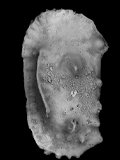 Abstract: Micropalaeontological analyses were performed on two stratigraphical
sections sampled in upper Messinian deposits outcropping in eastern Tunisia,
allowing us to identify some sedimentary levels with high concentrations of
fresh or brackish water ostracods, which can be referred to the Lago-Mare fauna. Some of these species can be considered
Paratethysian, or rather as species that spread in the Mediterranean area starting from
the Paratethys areas, while others show Paratethysian affinity. The Lago-Mare
fauna is little known in the south Mediterranean regions and the
present article provides new data on its geographic distribution. Abstract: Micropalaeontological analyses were performed on two stratigraphical
sections sampled in upper Messinian deposits outcropping in eastern Tunisia,
allowing us to identify some sedimentary levels with high concentrations of
fresh or brackish water ostracods, which can be referred to the Lago-Mare fauna. Some of these species can be considered
Paratethysian, or rather as species that spread in the Mediterranean area starting from
the Paratethys areas, while others show Paratethysian affinity. The Lago-Mare
fauna is little known in the south Mediterranean regions and the
present article provides new data on its geographic distribution.
Of the two sections sampled,
the first one, the Wadi El Kebir section, is located in the south eastern part of the Cape Bon Peninsula and
shows horizons dominated by Cyprideis
agrigentina and Cyprideis ex
C. torosa group; the second one, the Salakta section, is located in the
Sahel region and shows a level with a very rich Lago-Mare ostracod fauna
consisting essentially of Amnicythere
propinqua, Mediocytherideis punctata,
and Ilyocypris gibba.
|
|
Carnets Geol., vol. 20, no. 17, p. 315-331
Online since October 14, 2020
|
|
First authentic record of the freshwater turtle Mauremys from the Upper Pliocene of Italy,
with a new occurrence of the rarely reported ichnotaxon Thatchtelithichnus holmani
Alberto COLLARETA, Simone CASATI, Marco A.L. ZUFFI & Andrea DI CENCIO
| HTML  | PDF
| PDF  [1,078 KB]
| DOI: 10.2110/carnets.2020.2016 [1,078 KB]
| DOI: 10.2110/carnets.2020.2016
|
|
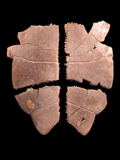 Abstract: Nowadays, the living species of the terrapin genus Mauremys (Testudinoidea:
Geoemydidae) are mostly found in eastern Asia, but three of them inhabit the Western Palearctic ecozone.
In Italy, occurrences of living individuals of Mauremys are interpreted
as records of alien species; however, a growing fossil record demonstrates that this
genus has inhabited Italy as recently
as the Late Pleistocene. We report on a new fossil specimen of Mauremys
from the Upper Pliocene (Piacenzian) marginal-marine deposits of Tuscany
(central Italy). This find, consisting of a partial plastron and a loose neural,
represents the second authentic report of Mauremys from the Italian
Pliocene, as well as the first one from the Piacenzian of Italy. Therefore, it
is a significant fossil that fills a gap in the chronostratigraphic distribution
of Italian fossil Mauremys, helping – together with the Lower Pliocene
holotype of Mauremys portisi – to bridge the rich Miocene and
Pleistocene segments of this record. Moreover, two unusual scars observed on the
external surface of the studied plastron are here referred to the ichnospecies Thatchtelithichnus
holmani. These traces represent one of the few records worldwide of this
rarely identified ichnospecies, as well as its geologically youngest published
occurrence. Hypotheses regarding the origin of the Thatchtelithichnus
traces are reevaluated, and an origin as attachment scars of aquatic
ectoparasites (possibly ticks, leeches, or flukes) is reaffirmed as
probable in cases of traces occurring on the exterior of the plastral bones of turtles. Abstract: Nowadays, the living species of the terrapin genus Mauremys (Testudinoidea:
Geoemydidae) are mostly found in eastern Asia, but three of them inhabit the Western Palearctic ecozone.
In Italy, occurrences of living individuals of Mauremys are interpreted
as records of alien species; however, a growing fossil record demonstrates that this
genus has inhabited Italy as recently
as the Late Pleistocene. We report on a new fossil specimen of Mauremys
from the Upper Pliocene (Piacenzian) marginal-marine deposits of Tuscany
(central Italy). This find, consisting of a partial plastron and a loose neural,
represents the second authentic report of Mauremys from the Italian
Pliocene, as well as the first one from the Piacenzian of Italy. Therefore, it
is a significant fossil that fills a gap in the chronostratigraphic distribution
of Italian fossil Mauremys, helping – together with the Lower Pliocene
holotype of Mauremys portisi – to bridge the rich Miocene and
Pleistocene segments of this record. Moreover, two unusual scars observed on the
external surface of the studied plastron are here referred to the ichnospecies Thatchtelithichnus
holmani. These traces represent one of the few records worldwide of this
rarely identified ichnospecies, as well as its geologically youngest published
occurrence. Hypotheses regarding the origin of the Thatchtelithichnus
traces are reevaluated, and an origin as attachment scars of aquatic
ectoparasites (possibly ticks, leeches, or flukes) is reaffirmed as
probable in cases of traces occurring on the exterior of the plastral bones of turtles.
|
|
Carnets Geol., vol. 20, no. 16, p. 301-313
Online since October 14, 2020
|
|
Additional data on post-Paleozoic sea-lilies (Crinoidea, Echinodermata) from the Outer Carpathians of the Czech Republic and Poland
Mariusz A. SALAMON, Miroslav BUBÍK, Bruno FERRÉ, Andrzej SZYDŁO, Piotr NESCIERUK, Bartosz J. PŁACHNO, Tomasz BRACHANIEC & Karolina PASZCZA
| HTML  | PDF
| PDF  [1,067 KB]
| DOI: 10.2110/carnets.2020.2015 [1,067 KB]
| DOI: 10.2110/carnets.2020.2015
|
|
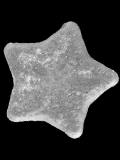 Abstract: Jurassic (Tithonian) and Lower Cretaceous (Berriasian/Valanginian-Hauterivian)
strata of the Vendryně and Cieszyn Limestones formations in the Czech
Republic and Poland are locally rich in crinoid remains, consisting of whole
cups, isolated cup elements, brachial plates, columnals and pluricolumnals,
cirrals, and holdfasts. They are assigned to isocrinids (Isocrinida: Isocrinus
cf. amblyscalaris, Isocrinida
indet.), cyrtocrinids (Cyrtocrinida: Eugeniacrinites sp.,
Phyllocrinus sp., Gammarocrinites sp.,
Hemicrinus tithonicus, Plicatocrinus
hexagonus, Cyrtocrinida indet.), millericrinids (Millericrinida:
Millericrinida indet.), and thiolliericrinids (Comatulida, Thiolliericrinidae:
Thiolliericrinidae gen. et sp. indet.). Late Cretaceous (Maastrichtian) and
Paleogene (Paleocene-Oligocene) crinoids from the Subsilesian Unit are recorded
as individual remains belonging to: Isocrinida indet., Cyrtocrinida indet.,
bourgueticrinids (Comatulida, Bourgueticrinina: Bourgueticrinina fam. et gen.
indet.) and roveacrinids (Roveacrinida, Roveacrinidae gen. et sp. indet.).
Roveacrinids were retrieved only from Maastrichtian samples. Despite the
conclusions previously presented that isocrinids of the Outer Flysch Carpathians
dominated around the Jurassic-Cretaceous boundary due to the very shallow
sedimentary environment of these strata, we can now conclude that they were
common and associated with cyrtocrinids in all types of environments. It is also
worth mentioning that cyrtocrinids and isocrinids occur in Paleogene sediments
that were deposited in extremely shallow environments. On the other hand, many
literature data suggested that Cretaceous (by mid-Cretaceous) isocrinids
migrated to deep-water areas, as a response to an increase in the number of
predators during the so-called Mesozoic marine revolution. Abstract: Jurassic (Tithonian) and Lower Cretaceous (Berriasian/Valanginian-Hauterivian)
strata of the Vendryně and Cieszyn Limestones formations in the Czech
Republic and Poland are locally rich in crinoid remains, consisting of whole
cups, isolated cup elements, brachial plates, columnals and pluricolumnals,
cirrals, and holdfasts. They are assigned to isocrinids (Isocrinida: Isocrinus
cf. amblyscalaris, Isocrinida
indet.), cyrtocrinids (Cyrtocrinida: Eugeniacrinites sp.,
Phyllocrinus sp., Gammarocrinites sp.,
Hemicrinus tithonicus, Plicatocrinus
hexagonus, Cyrtocrinida indet.), millericrinids (Millericrinida:
Millericrinida indet.), and thiolliericrinids (Comatulida, Thiolliericrinidae:
Thiolliericrinidae gen. et sp. indet.). Late Cretaceous (Maastrichtian) and
Paleogene (Paleocene-Oligocene) crinoids from the Subsilesian Unit are recorded
as individual remains belonging to: Isocrinida indet., Cyrtocrinida indet.,
bourgueticrinids (Comatulida, Bourgueticrinina: Bourgueticrinina fam. et gen.
indet.) and roveacrinids (Roveacrinida, Roveacrinidae gen. et sp. indet.).
Roveacrinids were retrieved only from Maastrichtian samples. Despite the
conclusions previously presented that isocrinids of the Outer Flysch Carpathians
dominated around the Jurassic-Cretaceous boundary due to the very shallow
sedimentary environment of these strata, we can now conclude that they were
common and associated with cyrtocrinids in all types of environments. It is also
worth mentioning that cyrtocrinids and isocrinids occur in Paleogene sediments
that were deposited in extremely shallow environments. On the other hand, many
literature data suggested that Cretaceous (by mid-Cretaceous) isocrinids
migrated to deep-water areas, as a response to an increase in the number of
predators during the so-called Mesozoic marine revolution.
|
|
Carnets Geol., vol. 20, no. 15, p. 283-299
Online since October 14, 2020
|
|
Lectotype designation for Orbitolinopsis flandrini Moullade, 1960 (Foraminifera): The missing piece of a taxonomic puzzle
Felix SCHLAGINTWEIT, Ioan I. BUCUR & François LE COZE
| HTML  | PDF
| PDF  [1,370 KB]
| DOI: 10.2110/carnets.2020.2014 [1,370 KB]
| DOI: 10.2110/carnets.2020.2014
|
|
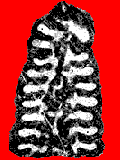 Abstract: Orbitolinopsis
flandrini Moullade, 1960, was described from Lower Cretaceous Urgonian
limestones of southeastern France without the designation of a holotype. It represents
a valid taxon since the selection of a holotype is only obligatory for taxa
established after 1999 (ICZN, 4th edition, article 72.3). Today the
original description is considered to be a mixture of several taxa belonging to Orbitolinopsis Henson,
1948/Cribellopsis Arnaud-Vanneau,
1980 (transverse sections with
cupules/septules in the central zone) and Drevennia
Arnaud-Vanneau, 1980 (axial sections with an axial "columella-like"
column). The short and in any case insufficient original description of O.
flandrini, however, stressed the presence of a columellar-like central test
as the main characteristic feature. In fact, the majority of the (sub)axial
sections showing an axial column (lacking in Orbitolinopsis)
are considered to belong to Drevennia
(Family Pfenderinidae). Therefore, the new combination Drevennia flandrini (Moullade,
1960) is proposed and a
lectotype herein designated from the original illustrations. Drevennia
ecougensis, the type-species of the genus, is found to be a subjective
junior synonym of the latter. New finds from Serbia and Spain extend the
stratigraphic range of D. flandrini,
from the upper Berriasian to the lowermost upper Aptian. The first occurrences
of Drevennia, Dobrogelina Neagu, 1979, Pfenderina Henson,
1948, and Moulladella Bucur & Schlagintweit,
2018, in the upper Berriasian give evidence for an adaptive radiation of the
Pfenderinidae during the time reported and from other, mostly complex larger
benthic foraminifera (e.g., Orbitolinidae). Abstract: Orbitolinopsis
flandrini Moullade, 1960, was described from Lower Cretaceous Urgonian
limestones of southeastern France without the designation of a holotype. It represents
a valid taxon since the selection of a holotype is only obligatory for taxa
established after 1999 (ICZN, 4th edition, article 72.3). Today the
original description is considered to be a mixture of several taxa belonging to Orbitolinopsis Henson,
1948/Cribellopsis Arnaud-Vanneau,
1980 (transverse sections with
cupules/septules in the central zone) and Drevennia
Arnaud-Vanneau, 1980 (axial sections with an axial "columella-like"
column). The short and in any case insufficient original description of O.
flandrini, however, stressed the presence of a columellar-like central test
as the main characteristic feature. In fact, the majority of the (sub)axial
sections showing an axial column (lacking in Orbitolinopsis)
are considered to belong to Drevennia
(Family Pfenderinidae). Therefore, the new combination Drevennia flandrini (Moullade,
1960) is proposed and a
lectotype herein designated from the original illustrations. Drevennia
ecougensis, the type-species of the genus, is found to be a subjective
junior synonym of the latter. New finds from Serbia and Spain extend the
stratigraphic range of D. flandrini,
from the upper Berriasian to the lowermost upper Aptian. The first occurrences
of Drevennia, Dobrogelina Neagu, 1979, Pfenderina Henson,
1948, and Moulladella Bucur & Schlagintweit,
2018, in the upper Berriasian give evidence for an adaptive radiation of the
Pfenderinidae during the time reported and from other, mostly complex larger
benthic foraminifera (e.g., Orbitolinidae).
|
|
Carnets Geol., vol. 20, no. 14, p. 273-282
Online since September 21, 2020
|
|
Stratigraphic and taxonomic considerations on the Late Cretaceous rudist fauna of Aksai Chin (Western Tibet, China) from the De Filippi Collection
Jingeng SHA, Simone FABBI, Riccardo CESTARI & Lorenzo CONSORTI
| HTML  | PDF
| PDF  [3,300 KB]
| DOI: 10.2110/carnets.2020.2013 [3,300 KB]
| DOI: 10.2110/carnets.2020.2013
|
|
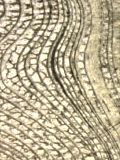 Abstract: The rudist fauna collected in western Tibet in the Aksai Chin area by the De Filippi expedition in 1914 has been reprised and
redescribed. This fauna is composed of Radiolites cf. lusitanicus, Radiolites sp., Gorjanovicia cf. endrissi,
? Sauvagesia sp., Sphaerulites sp., Durania sp., and Gyropleura sp. The rudist-bearing beds belong to the Tielongtan Group of the Tianshuihai
terrane. The Turonian-? Coniacian Xiloqzung Formation (Fm.) bear the older rudists (Radiolites cf. lusitanicus, Radiolites sp., Sphaerulites sp., Durania sp.),
whereas younger ages have been determined through microfossil analysis which, compared with the western Neotethys records, suggests an early-mid Campanian age. This allowed to ascribe the younger rudists of the collection (Gorjanovicia cf. endrissi,
? Sauvagesia sp., Gyropleura sp., Radiolites sp.) to the Dongloqzung Formation. Our data confirm that rudist-bearing facies in the Tielongtan Group extend at least up to the middle Campanian. The Aksai Chin rudist assemblage should belong to the Southwestern Asian assemblage of the Eastern Mediterranean
Subprovince. Abstract: The rudist fauna collected in western Tibet in the Aksai Chin area by the De Filippi expedition in 1914 has been reprised and
redescribed. This fauna is composed of Radiolites cf. lusitanicus, Radiolites sp., Gorjanovicia cf. endrissi,
? Sauvagesia sp., Sphaerulites sp., Durania sp., and Gyropleura sp. The rudist-bearing beds belong to the Tielongtan Group of the Tianshuihai
terrane. The Turonian-? Coniacian Xiloqzung Formation (Fm.) bear the older rudists (Radiolites cf. lusitanicus, Radiolites sp., Sphaerulites sp., Durania sp.),
whereas younger ages have been determined through microfossil analysis which, compared with the western Neotethys records, suggests an early-mid Campanian age. This allowed to ascribe the younger rudists of the collection (Gorjanovicia cf. endrissi,
? Sauvagesia sp., Gyropleura sp., Radiolites sp.) to the Dongloqzung Formation. Our data confirm that rudist-bearing facies in the Tielongtan Group extend at least up to the middle Campanian. The Aksai Chin rudist assemblage should belong to the Southwestern Asian assemblage of the Eastern Mediterranean
Subprovince.
|
|
Carnets Geol., vol. 20, no. 13, p. 249-272
Online since September 21, 2020
|
|
Moldavite finds in Middle Miocene (Langhian Stage) deposits of southwestern Poland
Tomasz BRACHANIEC
| HTML  | PDF
| PDF  [510 KB]
| DOI: 10.2110/carnets.2020.2012 [510 KB]
| DOI: 10.2110/carnets.2020.2012
|
|
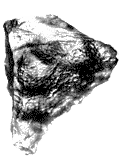 Abstract: Most of the Ries tektites (moldavites) were deposited in sediments
clearly postdating the Ries crater formation. This suggests secondary deposition
for these ejected glasses. Only a few sedimentary formations known to contain
these tektites are of Middle Miocene age and coeval with the Ries event. One is
the Poznańska Formation, which is exposed across southwestern Poland. These
mud deposits formed in the Middle Miocene (Langhian Stage). New moldavites,
described in this report were found in the Poznańska Formation and weigh
from 0.851 to 0.907 g. The North Stanisław sandpit, where the tektite
specimens were found, is located 490 km from the Ries structure. These
finds agree with the numerical simulation modelling of the ejection of these
moldavites up to 600 km away from the source crater. Abstract: Most of the Ries tektites (moldavites) were deposited in sediments
clearly postdating the Ries crater formation. This suggests secondary deposition
for these ejected glasses. Only a few sedimentary formations known to contain
these tektites are of Middle Miocene age and coeval with the Ries event. One is
the Poznańska Formation, which is exposed across southwestern Poland. These
mud deposits formed in the Middle Miocene (Langhian Stage). New moldavites,
described in this report were found in the Poznańska Formation and weigh
from 0.851 to 0.907 g. The North Stanisław sandpit, where the tektite
specimens were found, is located 490 km from the Ries structure. These
finds agree with the numerical simulation modelling of the ejection of these
moldavites up to 600 km away from the source crater.
|
|
Carnets Geol., vol. 20, no. 12, p. 241-247
Online since June 30, 2020
|
|
Chamberlainium pentagonum (Conti) comb. nov. and Spongites fruticulosus (Corallinales, Rhodophyta) in the Miocene carbonates of the western Mediterranean
Giovanni COLETTI, Juraj HRABOVSKÝ & Daniela BASSO
| HTML  | PDF
| PDF  [1,526 KB]
| DOI: 10.4267/2042/70837 [1,526 KB]
| DOI: 10.4267/2042/70837
|
|
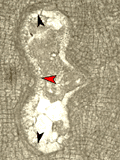 Abstract: Molecular phylogenetic
analyses discovered an unexpected biodiversity of coralline algae in modern oceans. This species richness is unlikely to be an exclusive characteristic of recent
ecosystems. With the aim to investigate fossil coralline biodiversity, a large dataset of western Mediterranean Miocene specimens, previously identified as
Spongites fruticulosus (and synonymized taxa), have been revised based on the current taxonomic framework. The analysis recognized two distinct groups. The first
group includes the specimens fitting within the current description of S. fruticulosus. The second group consists of Chamberlainium pentagonum comb.
nov., the first fossil representative of the genus. This species has been separated from S. fruticulosus on the basis of its smaller conceptacles and its thinner
conceptacle roof. The very same characters have been highlighted by modern molecular phylogenetic analyses for separating Chamberlainium from Spongites.
Chamberlainium pentagonum, similarly to the fossil specimens of Spongites fruticulosus, occurs in most of the investigated area and the two species coexist
in several localities, indicating a similar and broad ecological tolerance for both taxa. These results suggest that Miocene coralline algal biodiversity is probably underestimated
and prove the convenience of using large datasets for the study of fossil coralline algae. Abstract: Molecular phylogenetic
analyses discovered an unexpected biodiversity of coralline algae in modern oceans. This species richness is unlikely to be an exclusive characteristic of recent
ecosystems. With the aim to investigate fossil coralline biodiversity, a large dataset of western Mediterranean Miocene specimens, previously identified as
Spongites fruticulosus (and synonymized taxa), have been revised based on the current taxonomic framework. The analysis recognized two distinct groups. The first
group includes the specimens fitting within the current description of S. fruticulosus. The second group consists of Chamberlainium pentagonum comb.
nov., the first fossil representative of the genus. This species has been separated from S. fruticulosus on the basis of its smaller conceptacles and its thinner
conceptacle roof. The very same characters have been highlighted by modern molecular phylogenetic analyses for separating Chamberlainium from Spongites.
Chamberlainium pentagonum, similarly to the fossil specimens of Spongites fruticulosus, occurs in most of the investigated area and the two species coexist
in several localities, indicating a similar and broad ecological tolerance for both taxa. These results suggest that Miocene coralline algal biodiversity is probably underestimated
and prove the convenience of using large datasets for the study of fossil coralline algae.
|
|
Carnets Geol., vol. 20, no. 11, p. 223-240
Online since May 30, 2020
|
|
First occurrence of the problematic vetulicolian Skeemella clavula in the Cambrian Marjum Formation of Utah, USA
Julien KIMMIG, Wade W. LEIBACH & Bruce S. LIEBERMAN
| HTML  | PDF
| PDF  [798 KB]
| DOI: 10.4267/2042/70836 [798 KB]
| DOI: 10.4267/2042/70836
|
|
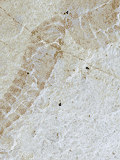 Abstract: The Cambrian Marjum
Formation of western Utah (USA) preserves a diverse soft-bodied fauna from the
upper Drumian that is slightly younger than the well-known Burgess Shale. While
the Marjum is dominated by arthropods, animals belonging to a variety of phyla
have been found. Here, we document the second occurrence of the rare, enigmatic
taxon Skeemella clavula, which was previously thought to be restricted to
the Pierson Cove Formation of the Drum Mountains. The occurrence in the Marjum
represents a new preservational setting, as well as a slightly younger deposit.
The new specimens also expand the number of known specimens to three. In
addition, they improve understanding of the morphology of this representative of
the problematic phylum Vetulicolia. Abstract: The Cambrian Marjum
Formation of western Utah (USA) preserves a diverse soft-bodied fauna from the
upper Drumian that is slightly younger than the well-known Burgess Shale. While
the Marjum is dominated by arthropods, animals belonging to a variety of phyla
have been found. Here, we document the second occurrence of the rare, enigmatic
taxon Skeemella clavula, which was previously thought to be restricted to
the Pierson Cove Formation of the Drum Mountains. The occurrence in the Marjum
represents a new preservational setting, as well as a slightly younger deposit.
The new specimens also expand the number of known specimens to three. In
addition, they improve understanding of the morphology of this representative of
the problematic phylum Vetulicolia.
|
|
Carnets Geol., vol. 20, no. 10, p. 215-221
Online since May 30, 2020
|
|
Metacuvillierinella sireli n. sp., a Campanian Rhapydioninidae (Foraminifera), from southeast Turkey. New considerations on the endoskeleton and particularities of the family, with a specialized lexicon
Jean-Jacques FLEURY & Recep ÖZKAN
| HTML  | PDF
| PDF  [4,532 KB]
| DOI: 10.4267/2042/70793 [4,532 KB]
| DOI: 10.4267/2042/70793
|
|
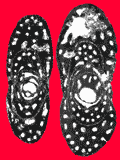 Abstract: The family Rhapydioninidae is a part of the superfamily Alveolinacea. The main
characteristic of this superfamily is its endoskeleton with each chamber
divided into tubular chamberlets,
fundamentally parallel to the coiling direction, and only connected in an
undivided space located in the anterior part of the chamber: The preseptal space. The
family Rhapydioninidae is distinguished by the coexistence of two sets of
chamberlets: Primary chamberlets, which are isolated by partitions ("cloisonnettes"),
forming a unique layer at the chamber periphery, and secondary chamberlets pierced in a more or less compact mass, the
central endoskeleton (by no way homologous of the "couche basale", sometimes
called flosculinisation or columella in some Alveolinidae). Two particular
modes of organization of the secondary chamberlets occur, the Basal
Secondary Chamberlets-Scattered
Secondary Chamberlets structure
(BSC-SSC) and the Confluent
structure; they constitute
supplementary features that distinguish this family from other groups. Abstract: The family Rhapydioninidae is a part of the superfamily Alveolinacea. The main
characteristic of this superfamily is its endoskeleton with each chamber
divided into tubular chamberlets,
fundamentally parallel to the coiling direction, and only connected in an
undivided space located in the anterior part of the chamber: The preseptal space. The
family Rhapydioninidae is distinguished by the coexistence of two sets of
chamberlets: Primary chamberlets, which are isolated by partitions ("cloisonnettes"),
forming a unique layer at the chamber periphery, and secondary chamberlets pierced in a more or less compact mass, the
central endoskeleton (by no way homologous of the "couche basale", sometimes
called flosculinisation or columella in some Alveolinidae). Two particular
modes of organization of the secondary chamberlets occur, the Basal
Secondary Chamberlets-Scattered
Secondary Chamberlets structure
(BSC-SSC) and the Confluent
structure; they constitute
supplementary features that distinguish this family from other groups.
The BSC-SSC
structure (a new name for a previously well-known organization of
chamberlets in the genus Pseudochubbina
and Cuvillierinella salentina) is the object of a large inventory
undertaken among the known taxa of the Rhapydioninidae. It leads to the
observation that this particular endoskeleton is found in the various
subfamilies on both sides of the Atlantic and cannot be used as a feature of
taxonomic significance within the group. However, it is not observed in
apparently "primitive" taxa equipped with chamberlets of large
isodiametric diameter which display a "fishnet" appearance. The confluent structure is a new name for the helicoidal structure,
which is also widespread within the family.
Metacuvillierinella sireli n. sp.,
of Campanian age, is described from outcrop and subsurface limestones in
southeast Anatolia, Turkey. The new taxon is a Rhapydioninidae based on its
test architecture and endoskeleton. As a species, it is clearly distinct
because of its initial planispiral coiling of A generation tests, its both
pseudoplanispiral generations with an advolute final stage and its thin
chamberlets showing an obvious BSC-SSC structure. The generic attribution
appears more uncertain: The faint dimorphism between generations and the
persisting pseudoplanispiral-advolute final stage are only known in the genus Metacuvillierinella.
But M. decastroi, the type species,
displays a small proloculus in the A forms, a miliolid juvenile stage, and an
endoskeleton of "fishnet" appearance (cryptic BSC-SSC structure), which
give it a particular character, appearing as being "primitive". This
contrasts with the relatively large proloculus in the A forms,
pseudoplanispiral coiling and the obvious BSC-SSC structure of the new taxon.
Thus, all these features being subjected to evolution, the faint generational
differences and the pseudoplanispiral-advolute coiling seem sufficient to
suggest the affinities between the two taxa. The new taxon is, nevertheless,
clearly more "advanced", which could be interpreted as a clue for a higher
standing, possibly compatible with a new genus. This is not undertaken here,
in consideration of the unknown "radiance" (small variations in several
well-disseminated populations and/or other species of the same kind) of the
new taxon with the present state of knowledge.
Additionally, with a review of the BSC-SSC structure, the various genera of the family
Rhapydioninidae are revisited, namely Pseudochubbina,
Cuvillierinella, Murciella, Sigalveolina, Cyclopseudedomia, Sellialveolina,
Rhapydionina, Fanrhapydionina, Chubbina, Praechubbina, Raadshoovenia,
Neomurciella, Twaraina; special attention is reserved to the Euro-Asiatic
genus Pseudedomia, of which the
original material and, consequently, the consecutive interpretative
identifications, appear doubtful. New sections of Subalveolina dordonica and Fleuryana
adriatica are figured.
The conclusion deals mainly with the criteria used for distinguishing various
systematic levels within the family. The classical differentiation between "specific" and "generic"
characters, if eventually convenient for simple or inadequately known groups, seems
unsuited for a complex and well known family like this one.
A more pragmatic mode of working is proposed,
using any character as a simple element without any meaning by itself, but to
be understood and interpreted among the others, that is to say in the
evolutionary perspective of the whole group.
A lexicon of the used terms in Rhapydioninidae and closely related taxa in given in an appendix.
|
|
Carnets Geol., vol. 20, no. 9, p. 165-213
Online since May 11, 2020
|
|
Impact of the Anoxic Oceanic Event II on the evolution of ostracods in the Cenomanian-Turonian deposits of the Tinrhert Basin (SE Algeria)
Soumia TCHENAR, Bruno FERRÉ, Mohammed ADACI, Djamila ZAOUI, Madani BENYOUCEF, Mustapha BENSALAH & Touria KENTRI
| HTML  | PDF
| PDF  [1,382 KB]
| DOI: 10.4267/2042/70792 [1,382 KB]
| DOI: 10.4267/2042/70792
|
|
 Abstract: Around the Cenomanian/Turonian
boundary in the Tinrhert Basin, ostracods are seldom found in most of the
sampled levels. The assemblages show no specific diversity, their frequency not
exceeding 4% of the whole microfauna. Their 'climactic' presence, both
qualitatively and quantitatively, is observed at the base of the lower Turonian,
where ostracod assemblages are dominated by the genera Cythereis, Paracypris,
and Cytherella. Abstract: Around the Cenomanian/Turonian
boundary in the Tinrhert Basin, ostracods are seldom found in most of the
sampled levels. The assemblages show no specific diversity, their frequency not
exceeding 4% of the whole microfauna. Their 'climactic' presence, both
qualitatively and quantitatively, is observed at the base of the lower Turonian,
where ostracod assemblages are dominated by the genera Cythereis, Paracypris,
and Cytherella.
In order to interpret this data, we document a paleoecological study supported
by evidence compiled from five geological sections, dealing with the respective
impact of sedimentological conditions (quartz, gypsum and pyrite), and sea-level fluctuations.
|
|
Carnets Geol., vol. 20, no. 8, p. 145-164
Online since May 11, 2020
|
|
A report on the 12th International Symposium on Fossil Algae (Lucknow, India - September 16-18, 2019)
Daniela BASSO, Arindam CHAKRABORTY & Amit K. GHOSH
| HTML  | PDF
| PDF  [2,175 KB] [2,175 KB]
|
|
Carnets Geol., vol. 20, Meeting Review 1, p. 141-144
Online since May 11, 2020
|
|
New occurrences of Modulidae (Mollusca: Gastropoda) from European Eocene, Oligocene and Miocene deposits: Data from 19th century collections
Pierre LOZOUET, Bruno CAHUZAC & Laurent CHARLES
| HTML  | PDF
| PDF  [1,285 KB]
| DOI: 10.4267/2042/70761 [1,285 KB]
| DOI: 10.4267/2042/70761
|
|
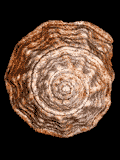 Abstract: A re-examination of the historical collections
deposited at the Bordeaux Museum of Natural History and the Faculty of Sciences
of the University of Bordeaux made it possible to identify new taxa of Modulidae in the Oligocene and Miocene of the Aquitaine Basin.
These Modulidae belong to the American groups Modulus
modulus and Trochomodulus. In
addition, three new species are described: Modulus
benoisti sp. nov. (Serravallian), Trochomodulus
stampinicus sp. nov. (Rupelian),
which is close to Trochomodulus
sublaevigatus (Orbigny, 1852), a Chattian species, and Incisilabium
trochiformis sp. nov. (Priabonian).
The latter is the oldest known Modulidae, together with Incisilabium
parisiensis (Deshayes, 1832) (Middle
Eocene) that was previously classified in the Trochidae. These results show
that the paleobiogeography and origin of the family Modulidae need to be
reconsidered. Abstract: A re-examination of the historical collections
deposited at the Bordeaux Museum of Natural History and the Faculty of Sciences
of the University of Bordeaux made it possible to identify new taxa of Modulidae in the Oligocene and Miocene of the Aquitaine Basin.
These Modulidae belong to the American groups Modulus
modulus and Trochomodulus. In
addition, three new species are described: Modulus
benoisti sp. nov. (Serravallian), Trochomodulus
stampinicus sp. nov. (Rupelian),
which is close to Trochomodulus
sublaevigatus (Orbigny, 1852), a Chattian species, and Incisilabium
trochiformis sp. nov. (Priabonian).
The latter is the oldest known Modulidae, together with Incisilabium
parisiensis (Deshayes, 1832) (Middle
Eocene) that was previously classified in the Trochidae. These results show
that the paleobiogeography and origin of the family Modulidae need to be
reconsidered.
|
|
Carnets Geol., vol. 20, no. 7, p. 125-139
Online since March 17, 2020
|
|
Full restoration of marine conditions after the late Messinian Mediterranean Lago-Mare phase in Licodia Eubea and Villafranca Tirrena areas (east Sicily)
Francesco SCIUTO & Angela BALDANZA
| HTML  | PDF
| PDF  [691 KB]
| DOI: 10.4267/2042/70760 [691 KB]
| DOI: 10.4267/2042/70760
|
|
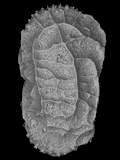 Abstract: After the Upper Messinian Mediterranean Lago-Mare phase, at the
end of the Messinian salinity crisis, the Mediterranean basin was characterized by a
return to normal marine conditions starting with the Lower Pliocene (Zanclean).
In this period, remarkably thick layers of calcareous pelitic sediments, very rich
in planktonic foraminifers and nannofossils, were widely deposited in the Mediterranean
basin. The calcareous pelitic deposits of Sicily (Trubi Formation), as well as in other
Mediterranean regions, were deposited conformably on the pre-Pliocene substrate, which
is mainly represented by Messinian evaporites or by the post-evaporitic Lago-Mare
facies. We have analysed samples taken from the lower portion of the Trubi Formation
(Zanclean), just above the Messinian facies, collected from Licodia Eubea and
Villafranca Tirrena areas (eastern Sicily). Micropalaentological assemblages consist of
benthic and planktonic foraminifers and a typical deep-water ostracod fauna. The
microfossil association and the stratigraphy of the Messinian-Pliocene transitional
layers, supported by calcareous nannoplankton data, demonstrate not only rapid sea-level rise in this sector of the Mediterranean region, but also that this event,
occurred without producing erosional features, unlike at other sites (e.g.,
Strait of Gibraltar). Abstract: After the Upper Messinian Mediterranean Lago-Mare phase, at the
end of the Messinian salinity crisis, the Mediterranean basin was characterized by a
return to normal marine conditions starting with the Lower Pliocene (Zanclean).
In this period, remarkably thick layers of calcareous pelitic sediments, very rich
in planktonic foraminifers and nannofossils, were widely deposited in the Mediterranean
basin. The calcareous pelitic deposits of Sicily (Trubi Formation), as well as in other
Mediterranean regions, were deposited conformably on the pre-Pliocene substrate, which
is mainly represented by Messinian evaporites or by the post-evaporitic Lago-Mare
facies. We have analysed samples taken from the lower portion of the Trubi Formation
(Zanclean), just above the Messinian facies, collected from Licodia Eubea and
Villafranca Tirrena areas (eastern Sicily). Micropalaentological assemblages consist of
benthic and planktonic foraminifers and a typical deep-water ostracod fauna. The
microfossil association and the stratigraphy of the Messinian-Pliocene transitional
layers, supported by calcareous nannoplankton data, demonstrate not only rapid sea-level rise in this sector of the Mediterranean region, but also that this event,
occurred without producing erosional features, unlike at other sites (e.g.,
Strait of Gibraltar).
|
|
Carnets Geol., vol. 20, no. 6, p. 107-123
Online since March 17, 2020
|
|
A rhinopristiform sawfish (genus Pristis) from the middle Eocene (Lutetian) of southern Peru and its regional implications
Alberto COLLARETA, Luz TEJADA-MEDINA, César CHACALTANA-BUDIEL, Walter LANDINI, Alí ALTAMIRANO-SIERRA, Mario URBINA-SCHMITT & Giovanni BIANUCCI
| HTML  | PDF
| PDF  [1,180 KB]
| DOI: 10.4267/2042/70759 [1,180 KB]
| DOI: 10.4267/2042/70759
|
|
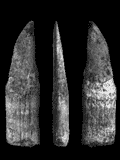 Abstract: Modern sawfishes (Rhinopristiformes: Pristidae) are circumglobally distributed in warm waters and
are common in proximal marine and even freshwater habitats. The fossil record of
modern pristid genera (i.e., Pristis and Anoxypristis) dates back to the early Eocene and is mostly represented by isolated
rostral spines and oral teeth, with phosphatised rostra representing exceptional
occurrences. Here, we report on a partial pristid rostrum, exhibiting several
articulated rostral spines, from middle Eocene strata of the Paracas Formation (Yumaque Member) exposed in the southern Peruvian East Pisco Basin. This finely
preserved specimen shows anatomical structures that are unlikely to leave a
fossil record, e.g., the paracentral grooves that extend along the ventral surface of the
rostrum. Based on the morphology of the rostral spines, this fossil sawfish is
here identified as belonging to Pristis. To our knowledge, this discovery represents the geologically oldest known
occurrence of Pristidae from the Pacific Coast of South America. Although the
fossil record of pristids from the East Pisco Basin spans from the middle Eocene
to the late Miocene, sawfishes are no longer present in the modern cool,
upwelling-influenced coastal waters of southern Peru. Given the ecological
preferences of the extant members of Pristis, the occurrence of this genus in the Paracas deposits suggests that
middle Eocene nearshore waters in southern Peru were warmer than today. The
eventual disappearance of pristids from the coastal waters off southern Peru
might be interpreted as reflecting the late Cenozoic trend of strengthening of
the Humboldt Current. Abstract: Modern sawfishes (Rhinopristiformes: Pristidae) are circumglobally distributed in warm waters and
are common in proximal marine and even freshwater habitats. The fossil record of
modern pristid genera (i.e., Pristis and Anoxypristis) dates back to the early Eocene and is mostly represented by isolated
rostral spines and oral teeth, with phosphatised rostra representing exceptional
occurrences. Here, we report on a partial pristid rostrum, exhibiting several
articulated rostral spines, from middle Eocene strata of the Paracas Formation (Yumaque Member) exposed in the southern Peruvian East Pisco Basin. This finely
preserved specimen shows anatomical structures that are unlikely to leave a
fossil record, e.g., the paracentral grooves that extend along the ventral surface of the
rostrum. Based on the morphology of the rostral spines, this fossil sawfish is
here identified as belonging to Pristis. To our knowledge, this discovery represents the geologically oldest known
occurrence of Pristidae from the Pacific Coast of South America. Although the
fossil record of pristids from the East Pisco Basin spans from the middle Eocene
to the late Miocene, sawfishes are no longer present in the modern cool,
upwelling-influenced coastal waters of southern Peru. Given the ecological
preferences of the extant members of Pristis, the occurrence of this genus in the Paracas deposits suggests that
middle Eocene nearshore waters in southern Peru were warmer than today. The
eventual disappearance of pristids from the coastal waters off southern Peru
might be interpreted as reflecting the late Cenozoic trend of strengthening of
the Humboldt Current.
|
|
Carnets Geol., vol. 20, no. 5, p. 91-105
Online since March 17, 2020
|
|
Identification of a Romaniceras (Romaniceras) marigniacum sp. nov. ammonite biohorizon (Middle Turonian) at the base of the Tuffeau Jaune de Touraine (France)
Francis AMÉDRO, Francis ROBASZYNSKI, Hervé CHÂTELIER, Patrice FERCHAUD & Bertrand MATRION
| HTML  | PDF
| PDF  [3,838 KB]
| DOI: 10.4267/2042/70720 [3,838 KB]
| DOI: 10.4267/2042/70720
|
|
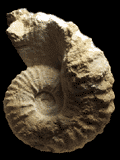 Abstract:
In the south of the Paris Basin, along the Loire and
Cher valleys, the Tuffeau Jaune de Touraine Formation was traditionally
attributed to the Late Turonian by the presence of rare Romaniceras
deverianum (Orbigny, 1841). Moreover, the several metres of tempestites at the base of the
formation never yielded ammonites. Today, in southern Touraine, more than 150
ammonites were collected from the base of the Tuffeau Jaune de Touraine and in
the highest part of the underlying Tuffeau de Bourré bring new significant
data: the lower part of the Tuffeau Jaune de Touraine remain in the Romaniceras
ornatissimum zone,
Middle Turonian in age (Tm 3). Furthermore, the discovery in that biohorizon of
the new species Romaniceras (R.) marigniacum Amédro & Châtelier sp.
nov. is indicative of the highest part of
the R. ornatissimum zone (high Tm3). Other species are associated to the R. marigniacum biohorizon as: Romaniceras
(Yubariceras) ornatissimum (Stoliczka, 1864), Masiaposites cf. kennedyi Amédro & Devalque, 2014, Collignoniceras
woollgari regulare (Haas, 1946), C. turoniense (Sornay,
1951) and Collignoniceras
vigennum Amédro & Châtelier
sp. nov. Abstract:
In the south of the Paris Basin, along the Loire and
Cher valleys, the Tuffeau Jaune de Touraine Formation was traditionally
attributed to the Late Turonian by the presence of rare Romaniceras
deverianum (Orbigny, 1841). Moreover, the several metres of tempestites at the base of the
formation never yielded ammonites. Today, in southern Touraine, more than 150
ammonites were collected from the base of the Tuffeau Jaune de Touraine and in
the highest part of the underlying Tuffeau de Bourré bring new significant
data: the lower part of the Tuffeau Jaune de Touraine remain in the Romaniceras
ornatissimum zone,
Middle Turonian in age (Tm 3). Furthermore, the discovery in that biohorizon of
the new species Romaniceras (R.) marigniacum Amédro & Châtelier sp.
nov. is indicative of the highest part of
the R. ornatissimum zone (high Tm3). Other species are associated to the R. marigniacum biohorizon as: Romaniceras
(Yubariceras) ornatissimum (Stoliczka, 1864), Masiaposites cf. kennedyi Amédro & Devalque, 2014, Collignoniceras
woollgari regulare (Haas, 1946), C. turoniense (Sornay,
1951) and Collignoniceras
vigennum Amédro & Châtelier
sp. nov.
With regard to the top of
the Tuffeau de Bourré Formation, it yielded about fifty specimens of ammonites
but the assemblage is different to that found in the type locality of Bourré-Montrichard
in the Cher valley. The material collected near the Vienne and Creuse junction
includes : Lewesiceras
peramplum (Mantell, 1822), Romaniceras (Y.) ornatissimum (Stoliczka,
1864),
Collignoniceras woollgari regulare (Haas, 1946), C. canthus (Orbigny,
1856) and C. turoniense (Sornay, 1951). The species Collignoniceras
papale (Orbigny, 1841), which represents one third of the Bourré collection is apparently
absent whereas three new species belonging to the same genus are identified as : C. hourqueigi Amédro & Châtelier sp.
nov., C. badilleti Amédro & Châtelier
sp. nov. and Collignoniceras sp. A.
|
|
Carnets Geol., vol. 20, no. 4, p. 37-89
Online since February 22, 2020
|
|
A new Cassiduloid (Echinodermata, Echinoidea) in the Albian of the Sergipe-Alagoas basin, Brazil
Cynthia L. de C. MANSO
| HTML  | PDF
| PDF  [410 KB]
| DOI: 10.4267/2042/70719 [410 KB]
| DOI: 10.4267/2042/70719
|
|
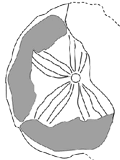 Abstract: This paper presents a new discovery of the echinoid
species Phyllobrissus humilis (Gauthier, 1875) from the Albian age Riachuelo Formation of the Sergipe-Alagoas Basin. The
only specimen obtained in the Maruim 1 outcrop expresses the main species
characteristics. Paleoecological notes and a dichotomous key are presented to
facilitate the identification of the cassiduloid species from the Cretaceous of
Sergipe-Alagoas Basin. Abstract: This paper presents a new discovery of the echinoid
species Phyllobrissus humilis (Gauthier, 1875) from the Albian age Riachuelo Formation of the Sergipe-Alagoas Basin. The
only specimen obtained in the Maruim 1 outcrop expresses the main species
characteristics. Paleoecological notes and a dichotomous key are presented to
facilitate the identification of the cassiduloid species from the Cretaceous of
Sergipe-Alagoas Basin.
|
|
Carnets Geol., vol. 20, no. 3, p. 29-35
Online since February 22, 2020
|
|
The shark-toothed dolphin Squalodon (Cetacea: Odontoceti) from the remarkable Montagna della Majella marine vertebrate assemblage (Bolognano Formation, central Italy)
Alberto COLLARETA, Andrea DI CENCIO, Renato RICCI & Giovanni BIANUCCI
| HTML  | PDF
| PDF  [847 KB]
| DOI: 10.4267/2042/70716 [847 KB]
| DOI: 10.4267/2042/70716
|
|
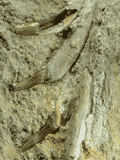 Abstract: The extinct
family Squalodontidae consists of heterodont, medium-sized odontocetes, featuring a long rostrum that houses large, procumbent incisors and
heavily ornamented postcanine teeth carrying accessory denticles, hence their
vernacular name, "shark-toothed dolphins". These longirostrine toothed
whales are often seen as bridging the anatomical gap between archaic Oligocene
odontocetes and their late Miocene to Holocene relatives. Possibly among the
major marine predators of their time, the shark-toothed dolphins are
important components of several lower Miocene marine-mammal assemblages from the
North Atlantic and Mediterranean/Paratethysian realms. In the present work, a
partial skull of Squalodontidae is described from the strata of the Bolognano
Formation cropping out in the northeastern sector of the Montagna della Majella
massif (Abruzzo, central Italy), which has previously yielded a rich lower
Miocene marine-vertebrate assemblage, including eleven taxa of elasmobranchs as
well as subordinate teleosts and very
fragmentary remains of marine reptiles and mammals. The specimen consists of the
anterodorsal portion of a rostrum, preserving parts of both premaxillae and left
maxilla, and the anteriormost seven upper left teeth. This partial skull is here
identified as belonging to the genus Squalodon, whose presence in the Montagna
della Majella vertebrate assemblage had already been tentatively proposed on the
basis of two fragmentary teeth. The paleontological significance of this find is
discussed in the broader framework of the Euromediterranean record of Squalodon. Abstract: The extinct
family Squalodontidae consists of heterodont, medium-sized odontocetes, featuring a long rostrum that houses large, procumbent incisors and
heavily ornamented postcanine teeth carrying accessory denticles, hence their
vernacular name, "shark-toothed dolphins". These longirostrine toothed
whales are often seen as bridging the anatomical gap between archaic Oligocene
odontocetes and their late Miocene to Holocene relatives. Possibly among the
major marine predators of their time, the shark-toothed dolphins are
important components of several lower Miocene marine-mammal assemblages from the
North Atlantic and Mediterranean/Paratethysian realms. In the present work, a
partial skull of Squalodontidae is described from the strata of the Bolognano
Formation cropping out in the northeastern sector of the Montagna della Majella
massif (Abruzzo, central Italy), which has previously yielded a rich lower
Miocene marine-vertebrate assemblage, including eleven taxa of elasmobranchs as
well as subordinate teleosts and very
fragmentary remains of marine reptiles and mammals. The specimen consists of the
anterodorsal portion of a rostrum, preserving parts of both premaxillae and left
maxilla, and the anteriormost seven upper left teeth. This partial skull is here
identified as belonging to the genus Squalodon, whose presence in the Montagna
della Majella vertebrate assemblage had already been tentatively proposed on the
basis of two fragmentary teeth. The paleontological significance of this find is
discussed in the broader framework of the Euromediterranean record of Squalodon.
|
|
Carnets Geol., vol. 20, no. 2, p. 19-28
Online since February 22, 2020
|
|
A critical look at Tré Maroua (Le Saix, Hautes-Alpes, France), the Berriasian GSSP candidate section
Bruno R.C. GRANIER, Serge FERRY & Mohamed BENZAGGAGH
| HTML  | PDF
| PDF  [2,966 KB]
| DOI: 10.4267/2042/70714 [2,966 KB]
| DOI: 10.4267/2042/70714
|
|
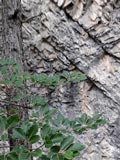 Abstract: The Tré Maroua site in SE France was recently
selected by the Berriasian Working Group (BWG) of the International
Subcommission on Cretaceous Stratigraphy (ISCS) as the candidate locality for
the reference section of the Berriasian Global Boundary Stratotype Point (GSSP).
However, on the basis of our preliminary investigation at this site and also
from field observations over a larger area, this candidate section is
paleogeographically located on a deep-water slope riddled with successive
erosional surfaces, stratigraphic hiatuses and breccias. It does not meet at
least four of the five "geological requirements for a GSSP".
Accordingly, in our opinion, its candidacy must be definitely precluded. Abstract: The Tré Maroua site in SE France was recently
selected by the Berriasian Working Group (BWG) of the International
Subcommission on Cretaceous Stratigraphy (ISCS) as the candidate locality for
the reference section of the Berriasian Global Boundary Stratotype Point (GSSP).
However, on the basis of our preliminary investigation at this site and also
from field observations over a larger area, this candidate section is
paleogeographically located on a deep-water slope riddled with successive
erosional surfaces, stratigraphic hiatuses and breccias. It does not meet at
least four of the five "geological requirements for a GSSP".
Accordingly, in our opinion, its candidacy must be definitely precluded.
|
|
Carnets Geol., vol. 20, no. 1, p. 1-17
Online since February 22, 2020
|

|
|
2019 (vol. 19)
|
|
Discussion on some previous records of Involutina hungarica (Sidó, 1952). Revision of the Jesse Harlan Johnson Collection. Part 6
Bruno GRANIER
| HTML  | PDF
| PDF  [2,044 KB]
| DOI: 10.4267/2042/70638 [2,044 KB]
| DOI: 10.4267/2042/70638
|
|
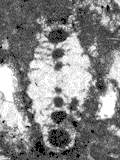 Abstract: Involutina
hungarica (Sidó,
1952) is reported from Albian strata of Texas (U.S.A.). Earlier records in the
scientific literature, where this foraminifer commonly appears under the label
"Hensonina lenticularis (Henson, 1947)", are
reevaluated. Although it is mostly cited from Albian strata, its first
occurrence could be Aptian. Abstract: Involutina
hungarica (Sidó,
1952) is reported from Albian strata of Texas (U.S.A.). Earlier records in the
scientific literature, where this foraminifer commonly appears under the label
"Hensonina lenticularis (Henson, 1947)", are
reevaluated. Although it is mostly cited from Albian strata, its first
occurrence could be Aptian.
|
|
Carnets Geol., vol. 19, no. 20, p. 445-455
Online since December 27, 2019
|
|
Ichnofossils associated with lingulide shells from the Lower Permian of Brazil
Olev VINN, Carolina ZABINI & Luiz Carlos C WEINSCHÜTZ
| HTML  | PDF
| PDF  [840 KB]
| DOI: 10.4267/2042/70636 [840 KB]
| DOI: 10.4267/2042/70636
|
|
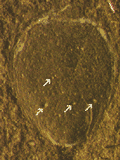 Abstract: Lingulides from Lower Permian of Brazil
(24% substrates) showed signs of bioerosion in form of multiple small shallow
pits that resemble incomplete Oichnus
paraboloides borings. A single lingulide valve showed a centrally located
large circular predatory Oichnus simplex
boring. Several lingulide shells (c. 21%) show small Arachnostega traces in their interior. The diameter of Arachnostega
burrows is relatively constant. These burrows are more similar to juvenile stages of Arachnostega gastrochaena
and do not form well-developed meshwork of tunnels. This is the first record of Arachnostega
from the interior of lingulide shells and indicates that even very small
lingulide shells were suitable substrates for cryptic organisms. Abstract: Lingulides from Lower Permian of Brazil
(24% substrates) showed signs of bioerosion in form of multiple small shallow
pits that resemble incomplete Oichnus
paraboloides borings. A single lingulide valve showed a centrally located
large circular predatory Oichnus simplex
boring. Several lingulide shells (c. 21%) show small Arachnostega traces in their interior. The diameter of Arachnostega
burrows is relatively constant. These burrows are more similar to juvenile stages of Arachnostega gastrochaena
and do not form well-developed meshwork of tunnels. This is the first record of Arachnostega
from the interior of lingulide shells and indicates that even very small
lingulide shells were suitable substrates for cryptic organisms.
|
|
Carnets Geol., vol. 19, no. 19, p. 439-444
Online since December 27, 2019
|
|
New data on the intergrowth of Rugosa-Bryozoa in the Lower Devonian of North Gondwana
Yves PLUSQUELLEC & Françoise P. BIGEY
| HTML  | PDF
| PDF  [3,864 KB]
| DOI: 10.4267/2042/70538 [3,864 KB]
| DOI: 10.4267/2042/70538
|
|
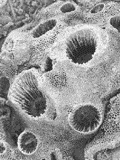 Abstract: Numerous and generally well-preserved examples of the
intergrowth Rugosa-Bryozoa from the Upper Pragian and Lower Emsian of the
Armorican Massif (Châteaulin and Laval synclinoria), France, and from the
Upper Emsian of the Ougarta Mountains, Erg Djemel, Algeria, are described. In
the Armorican Massif, the corallites of a rugosan Tryplasmatidae? are
intergrown with Ceramoporidae bryozoan close to Crepipora,
exceptionally with an unidentified Fistuliporidae (likely a new genus),
whereas in Ougarta the coral is not identifiable and is associated with a
Fistuliporidae assigned to Fistulipora.
Although mainly left in open nomenclature, the material is fully described
(structure and microstructure) and illustrated (calcitic skeleton and natural
moulds) for the first time. In addition, the presence of Ceramoporidae in the
Lower Devonian is clearly established. The evaluation of the association is
briefly discussed and a mutualistic relationship supported. Abstract: Numerous and generally well-preserved examples of the
intergrowth Rugosa-Bryozoa from the Upper Pragian and Lower Emsian of the
Armorican Massif (Châteaulin and Laval synclinoria), France, and from the
Upper Emsian of the Ougarta Mountains, Erg Djemel, Algeria, are described. In
the Armorican Massif, the corallites of a rugosan Tryplasmatidae? are
intergrown with Ceramoporidae bryozoan close to Crepipora,
exceptionally with an unidentified Fistuliporidae (likely a new genus),
whereas in Ougarta the coral is not identifiable and is associated with a
Fistuliporidae assigned to Fistulipora.
Although mainly left in open nomenclature, the material is fully described
(structure and microstructure) and illustrated (calcitic skeleton and natural
moulds) for the first time. In addition, the presence of Ceramoporidae in the
Lower Devonian is clearly established. The evaluation of the association is
briefly discussed and a mutualistic relationship supported.
|
|
Carnets Geol., vol. 19, no. 18, p. 421-437
Online since November 11, 2019
|
|
The bryozoan collection of Prof. Dr Ehrhard Voigt (1905–2004) at the Senckenberg Institute in Frankfurt. Part 3 - Ascophoran Cheilostomata and bibliography
Silviu O. MARTHA, Kei MATSUYAMA, Joachim SCHOLZ, Paul D. TAYLOR & Gero HILLMER
| HTML  | PDF
| PDF  [18,020 KB]
| DOI: 10.4267/2042/70501 [18,020 KB]
| DOI: 10.4267/2042/70501
|
|
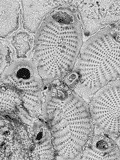 Abstract: The bryozoan collection of Prof. Dr Ehrhard Voigt (1905–2004) at the Senckenberg Research Institute in Frankfurt am Main,
Germany is a world-renowned collection of great scientific value. It is the
world's largest collection of fossil bryozoans from the Upper Cretaceous and
Paleocene and a unique archive documenting the evolution of this phylum of
marine invertebrates during this time interval in the Boreal Chalk Sea that
extended from the British Isles to the Aral Sea in Central Asia. Abstract: The bryozoan collection of Prof. Dr Ehrhard Voigt (1905–2004) at the Senckenberg Research Institute in Frankfurt am Main,
Germany is a world-renowned collection of great scientific value. It is the
world's largest collection of fossil bryozoans from the Upper Cretaceous and
Paleocene and a unique archive documenting the evolution of this phylum of
marine invertebrates during this time interval in the Boreal Chalk Sea that
extended from the British Isles to the Aral Sea in Central Asia.
The Voigt Collection contains over 300,000 specimens and was relocated to the Senckenberg
Institute in 2005 according to the bequest of Ehrhard Voigt. As a result of a
DFG-funded project, we present here a three-part type catalogue of the holotypes
and neotypes of 256 bryozoan species in the Voigt Collection, of which this is
Part 3. In total over the three parts, 247 species are re-illustrated but the
name-bearing type specimens of 20 species are missing and no material could be
found for 9 species. Two species, described as ctenostome bryozoans by Ehrhard Voigt, are questionable, while a further three 'ctenostome' species and one 'ctenostome'
genus are considered as ichnotaxa.
|
|
Carnets Geol., vol. 19, no. 17, p. 369-419
Online since October 10, 2019
|
|
Upper Jurassic-Lower Cretaceous limestones from the Hăghimaș Massif (Eastern Carpathians, Romania): Microfacies, microfossils and depositional environments
Olimpiu NEAMŢU, Ioan I. BUCUR, Răzvan UNGUREANU & Cristian Victor MIRCESCU
| HTML  | PDF
| PDF  [4,430 KB]
| DOI: 10.4267/2042/70499 [4,430 KB]
| DOI: 10.4267/2042/70499
erratum
PDF  [119 KB] [119 KB]
|
|
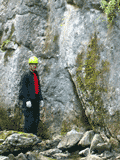 Abstract: The Hăgimaş
Massif provides important data for reconstructing the geological evolution of
the Transylvanian Carbonate Platform. This unit is present nowadays in the
basement of the Transylvanian Depression and as large-scale olistoliths, which
crop out in various locations in the Eastern Carpathians and Apuseni Mountains. They
contain a large variety of microfacies as well as microfossil assemblages partly
encompassing the Jurassic/Cretaceous boundary. This study presents a detailed
account of uppermost Jurassic-lowermost Cretaceous limestones from the Lapoş
Valley (Hăghimaş Mountains) containing two distinct successions
separated by a fault. The first succession contains platform margin and inner
platform deposits (subtidal, intertidal) whereas the second one consists of inner
platform deposits (shallow-subtidal to peritidal carbonates). The Upper Jurassic
Stramberk-type facies is overlain by lower Berriasian regressive peritidal
limestones. The upper Berriasian-? lower Valanginian consists mainly of inner
platform deposits. They contain alternating, high and low-energy carbonates with
rare calpionellids and calcispheres. The age assignment is based on a rich and
diverse micropaleontological assemblage containing similar biota reported from
other regions of the Tethysian Realm. Abstract: The Hăgimaş
Massif provides important data for reconstructing the geological evolution of
the Transylvanian Carbonate Platform. This unit is present nowadays in the
basement of the Transylvanian Depression and as large-scale olistoliths, which
crop out in various locations in the Eastern Carpathians and Apuseni Mountains. They
contain a large variety of microfacies as well as microfossil assemblages partly
encompassing the Jurassic/Cretaceous boundary. This study presents a detailed
account of uppermost Jurassic-lowermost Cretaceous limestones from the Lapoş
Valley (Hăghimaş Mountains) containing two distinct successions
separated by a fault. The first succession contains platform margin and inner
platform deposits (subtidal, intertidal) whereas the second one consists of inner
platform deposits (shallow-subtidal to peritidal carbonates). The Upper Jurassic
Stramberk-type facies is overlain by lower Berriasian regressive peritidal
limestones. The upper Berriasian-? lower Valanginian consists mainly of inner
platform deposits. They contain alternating, high and low-energy carbonates with
rare calpionellids and calcispheres. The age assignment is based on a rich and
diverse micropaleontological assemblage containing similar biota reported from
other regions of the Tethysian Realm.
|
|
Carnets Geol., vol. 19, no. 16, p. 345-368
Online since October 10, 2019
|
|
The bryozoan collection of Prof. Dr Ehrhard Voigt (1905–2004) at the Senckenberg Institute in Frankfurt. Part 2 - Ctenostomata and non-ascophoran Cheilostomata
Silviu O. MARTHA, Kei MATSUYAMA, Joachim SCHOLZ, Paul D. TAYLOR & Gero HILLMER
| HTML  | PDF
| PDF  [28,305 KB]
| DOI: 10.4267/2042/70498 [28,305 KB]
| DOI: 10.4267/2042/70498
|
|
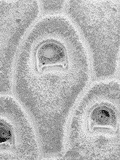 Abstract: The bryozoan collection of Prof. Dr Ehrhard Voigt (1905–2004) at the Senckenberg Research Institute in Frankfurt am Main,
Germany is a world-renowned collection of great scientific value. It is the
world's largest collection of fossil bryozoans from the Upper Cretaceous and
Paleocene and a unique archive documenting the evolution of this phylum of
marine invertebrates during this time interval in the Boreal Chalk Sea that
extended from the British Isles to the Aral Sea in Central Asia.
The Voigt
Collection contains over 300,000 specimens and was relocated to the Senckenberg
Institute in 2005 according to the bequest of Ehrhard Voigt. As a result of a
DFG-funded project, we present here a three-part type catalogue of the holotypes
and neotypes of 256 bryozoan species in the Voigt Collection, of which this is
Part 2. In total over the three parts, 247 species are re-illustrated but the
name-bearing type specimens of 20 species are missing and no material could be
found for 9 species. Two species, described as ctenostome bryozoans by Ehrhard Voigt, are questionable, while a further three 'ctenostome' species and one 'ctenostome'
genus are considered as ichnotaxa. Abstract: The bryozoan collection of Prof. Dr Ehrhard Voigt (1905–2004) at the Senckenberg Research Institute in Frankfurt am Main,
Germany is a world-renowned collection of great scientific value. It is the
world's largest collection of fossil bryozoans from the Upper Cretaceous and
Paleocene and a unique archive documenting the evolution of this phylum of
marine invertebrates during this time interval in the Boreal Chalk Sea that
extended from the British Isles to the Aral Sea in Central Asia.
The Voigt
Collection contains over 300,000 specimens and was relocated to the Senckenberg
Institute in 2005 according to the bequest of Ehrhard Voigt. As a result of a
DFG-funded project, we present here a three-part type catalogue of the holotypes
and neotypes of 256 bryozoan species in the Voigt Collection, of which this is
Part 2. In total over the three parts, 247 species are re-illustrated but the
name-bearing type specimens of 20 species are missing and no material could be
found for 9 species. Two species, described as ctenostome bryozoans by Ehrhard Voigt, are questionable, while a further three 'ctenostome' species and one 'ctenostome'
genus are considered as ichnotaxa.
|
|
Carnets Geol., vol. 19, no. 15, p. 287-344
Online since October 10, 2019
|
|
Historical review together with stratigraphical and taphonomical considerations on the upper Pleistocene deposit of Arenal de son Servera (Mallorca, Balearic Islands)
Rafel MATAMALES-ANDREU
| HTML  | PDF
| PDF  [1,165 KB]
| DOI: 10.4267/2042/70497 [1,165 KB]
| DOI: 10.4267/2042/70497
|
|
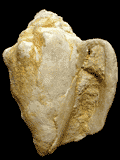 Abstract: The upper Pleistocene deposit of Arenal de son Servera
is reviewed using data from earlier works and new considerations based on its
stratigraphy and taphonomical aspects of the fossils. In the present study, five
different kinds of facies are identified: [1] palaeosols with
pebbles from the Miocene basement, [2] aeolianites, [3] foreshore deposits with
thermophilous molluscan fossil fauna, [4] palaeosols resulting from the pedogenesis
of the beach units, and [5] bioclastic channelled deposits eroding the underlaying
units. The detailed taphonomical analysis revealed that the fossils enclosed
in these rocks remained on the sea bottom for a significant amount of time, but
they were not bioeroded, perhaps because a submerged sand bar repeatedly buried
and exhumed them. In addition, the fact that Persististrombus
latus shells are in their position of maximum stability allows to
infer that they were washed up on the shore during moderately energetic events,
possibly comparable to present-day ordinary storms. These two last points could
be of interest to the field of coastal management, as they provide insight on
the scope of physical changes these systems could undergo in the present warming
of the Mediterranean. Abstract: The upper Pleistocene deposit of Arenal de son Servera
is reviewed using data from earlier works and new considerations based on its
stratigraphy and taphonomical aspects of the fossils. In the present study, five
different kinds of facies are identified: [1] palaeosols with
pebbles from the Miocene basement, [2] aeolianites, [3] foreshore deposits with
thermophilous molluscan fossil fauna, [4] palaeosols resulting from the pedogenesis
of the beach units, and [5] bioclastic channelled deposits eroding the underlaying
units. The detailed taphonomical analysis revealed that the fossils enclosed
in these rocks remained on the sea bottom for a significant amount of time, but
they were not bioeroded, perhaps because a submerged sand bar repeatedly buried
and exhumed them. In addition, the fact that Persististrombus
latus shells are in their position of maximum stability allows to
infer that they were washed up on the shore during moderately energetic events,
possibly comparable to present-day ordinary storms. These two last points could
be of interest to the field of coastal management, as they provide insight on
the scope of physical changes these systems could undergo in the present warming
of the Mediterranean.
|
|
Carnets Geol., vol. 19, no. 14, p. 277-285
Online since October 10, 2019
|
|
The bryozoan collection of Prof. Dr Ehrhard Voigt (1905–2004) at the Senckenberg Institute in Frankfurt. Part 1 - Introduction and Cyclostomata
Silviu O. MARTHA, Kei MATSUYAMA, Joachim SCHOLZ, Paul D. TAYLOR & Gero HILLMER
| HTML  | PDF
| PDF  [23,917 KB]
| DOI: 10.4267/2042/70493 [23,917 KB]
| DOI: 10.4267/2042/70493
|
|
 Abstract: The bryozoan collection of Prof. Dr Ehrhard Voigt
(1905–2004) at the Senckenberg Research Institute in Frankfurt am Main,
Germany is a world-renowned collection of great scientific value. It is the
world's largest collection of fossil bryozoans from the Upper Cretaceous and
Paleocene and a unique archive documenting the evolution of this phylum of
marine invertebrates during this time interval in the Boreal Chalk Sea that
extended from the British Isles to the Aral Sea in Central Asia. Abstract: The bryozoan collection of Prof. Dr Ehrhard Voigt
(1905–2004) at the Senckenberg Research Institute in Frankfurt am Main,
Germany is a world-renowned collection of great scientific value. It is the
world's largest collection of fossil bryozoans from the Upper Cretaceous and
Paleocene and a unique archive documenting the evolution of this phylum of
marine invertebrates during this time interval in the Boreal Chalk Sea that
extended from the British Isles to the Aral Sea in Central Asia.
The Voigt Collection contains over 300,000 specimens and was relocated to the Senckenberg
Institute in 2005 according to the bequest of Ehrhard Voigt. As a result of a
DFG-funded project, we present here a three-part type catalogue of the holotypes
and neotypes of 256 bryozoan species in the Voigt Collection, of which this is
Part 1. In total over the three parts, 247 species are re-illustrated but the
name-bearing type specimens of 20 species are missing and no material could be
found for 9 species. Two species, described as ctenostome bryozoans by Ehrhard
Voigt, are questionable, while a further three 'ctenostome' species and one 'ctenostome'
genus are considered as ichnotaxa.
|
|
Carnets Geol., vol. 19, no. 13, p. 221-275
Online since October 10, 2019
|
|
A new prospect in crinoid (Crinoidea, Echinodermata) research: An example from the Lower Jurassic of Montenegro
Mariusz A. SALAMON
| HTML  | PDF
| PDF  [935 KB]
| DOI: 10.4267/2042/70491 [935 KB]
| DOI: 10.4267/2042/70491
|
|
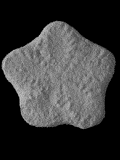 Abstract: Lower Jurassic (Hettangian-Pliensbachian)
shallow-marine ooidal limestones of southern Montenegro contain a large number
of isocrinid ossicles. They are assigned to the following taxa: Isocrinus
psilonoti (Quenstedt), Isocrinus
sp., and Pentacrinites cf. fossilis
Blumenbach. The echinoderm assemblage also yields
cyrtocrinid ossicles (Cotylederma sp., Cyrtocrinina indet.) and echinoid
spines (only spotted in thin sections); however, these elements are rare. Given
the fact that the recorded assemblage comes from a single locality, there is a
growing need for further research that will require intense sampling to compile
and complete the faunal list of crinoids and other echinoderm taxa. Abstract: Lower Jurassic (Hettangian-Pliensbachian)
shallow-marine ooidal limestones of southern Montenegro contain a large number
of isocrinid ossicles. They are assigned to the following taxa: Isocrinus
psilonoti (Quenstedt), Isocrinus
sp., and Pentacrinites cf. fossilis
Blumenbach. The echinoderm assemblage also yields
cyrtocrinid ossicles (Cotylederma sp., Cyrtocrinina indet.) and echinoid
spines (only spotted in thin sections); however, these elements are rare. Given
the fact that the recorded assemblage comes from a single locality, there is a
growing need for further research that will require intense sampling to compile
and complete the faunal list of crinoids and other echinoderm taxa.
|
|
Carnets Geol., vol. 19, no. 12, p. 211-220
Online since October 10, 2019
|
|
New findings of the genus Revalotrypa, the oldest bryozoan genus of Baltoscandia, in north-western Russia
Petr V. FEDOROV & Anna V. KOROMYSLOVA
| HTML  | PDF
| PDF  [954 KB]
| DOI: 10.4267/2042/70296 [954 KB]
| DOI: 10.4267/2042/70296
|
|
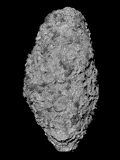 Abstract: New findings of esthonioporate bryozoans of the species Revalotrypa cf. inopinata,
representing one of the oldest bryozoans of Baltoscandia, are described from an
outcrop located in Leningrad Oblast' (north-western Russia). The colonies of
this species are very small and were extracted from limestone-cemented nodules
found in glauconitic sandstones of the lower part of the Joa Member (Paroistodus
proteus conodont zone, lowermost Floian, Lower Ordovician). Combined X-ray
microtomography and the examination of traditional thin sections under a
stereomicroscope and a light microscope were used to study the morphology of
this species. Abstract: New findings of esthonioporate bryozoans of the species Revalotrypa cf. inopinata,
representing one of the oldest bryozoans of Baltoscandia, are described from an
outcrop located in Leningrad Oblast' (north-western Russia). The colonies of
this species are very small and were extracted from limestone-cemented nodules
found in glauconitic sandstones of the lower part of the Joa Member (Paroistodus
proteus conodont zone, lowermost Floian, Lower Ordovician). Combined X-ray
microtomography and the examination of traditional thin sections under a
stereomicroscope and a light microscope were used to study the morphology of
this species.
|
|
Carnets Geol., vol. 19, no. 11, p. 199-209
Online since August 8, 2019
|
|
Abundant occurrence of Aspidiscus cristatus (Lamarck, 1801) in the "Marnes de Smail" Formation from the Batna area (NE-Algeria): Index species for the Middle Cenomanian
Sihem SALMI-LAOUAR, Bruno FERRÉ & Riadh AOUISSI
| HTML  | PDF
| PDF  [1,295 KB]
| DOI: 10.4267/2042/70294 [1,295 KB]
| DOI: 10.4267/2042/70294
|
|
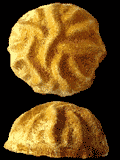 Abstract: The
Cenomanian marls of the Batna region (NE Algeria) display several fossiliferous
beds with highly diversified fauna. Among the abundant and well-preserved
fossils stands out Aspidiscus cristatus (Lamarck, 1801). This
coral taxon is assigned to the Family Latomeandridae Alloiteau, 1952, due
to the presence of pennulae and inner septal margins with slight perforations.
In the studied sections Aspidiscus cristatus is found in beds ranging
from the Cunningtoniceras inerme Zone to the Acanthoceras amphibolum
Zone, with a relative abundance within the Acanthoceras cf.
rhotomagense Zone. This species is subsequently a good marker for the
Middle Cenomanian in the Batna district. We give herein a systematic and
paleontological description and discuss the paleoenvironmental and paleogeographic
framework of this taxon. Actually the outer morphology of its test, with convex
outer surface and planar to concave inner surface, suggests an adaptation to
mud-supported, low-energy marine environments with high sedimentary rate. The
paleogeographic range of this taxon, with often larger-size specimens on the
southern and eastern margins of the Tethysian Realm, than those on the northern
margin, supports very peculiar thermal gradient and climactic zone, with
relatively warmer waters on the southern Tethysian margin during the Cenomanian,
favoring a more frequent and more effective bioerosion on fossil specimens from
southern Tethysian areas than that affecting specimens from northern Tethysian areas. Abstract: The
Cenomanian marls of the Batna region (NE Algeria) display several fossiliferous
beds with highly diversified fauna. Among the abundant and well-preserved
fossils stands out Aspidiscus cristatus (Lamarck, 1801). This
coral taxon is assigned to the Family Latomeandridae Alloiteau, 1952, due
to the presence of pennulae and inner septal margins with slight perforations.
In the studied sections Aspidiscus cristatus is found in beds ranging
from the Cunningtoniceras inerme Zone to the Acanthoceras amphibolum
Zone, with a relative abundance within the Acanthoceras cf.
rhotomagense Zone. This species is subsequently a good marker for the
Middle Cenomanian in the Batna district. We give herein a systematic and
paleontological description and discuss the paleoenvironmental and paleogeographic
framework of this taxon. Actually the outer morphology of its test, with convex
outer surface and planar to concave inner surface, suggests an adaptation to
mud-supported, low-energy marine environments with high sedimentary rate. The
paleogeographic range of this taxon, with often larger-size specimens on the
southern and eastern margins of the Tethysian Realm, than those on the northern
margin, supports very peculiar thermal gradient and climactic zone, with
relatively warmer waters on the southern Tethysian margin during the Cenomanian,
favoring a more frequent and more effective bioerosion on fossil specimens from
southern Tethysian areas than that affecting specimens from northern Tethysian areas.
|
|
Carnets Geol., vol. 19, no. 10, p. 185-197
Online since August 8, 2019
|
|
The lower Aptian ammonites of the Les Ferres Aptian Basin (Lower Cretaceous, Southeast of France). Part I: Introduction and biostratigraphy
Stéphane BERSAC & Didier BERT
| HTML  | PDF
| PDF  [4,427 KB]
| DOI: 10.4267/2042/70292 [4,427 KB]
| DOI: 10.4267/2042/70292
|
|
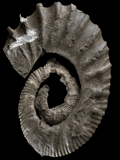 Abstract: On the southern margin of the
Vocontian Basin (SE France), for taphonomic reasons (fragmentation, reworking,
pyritization), lower Aptian (Lower Cretaceous) deposits of the interval between
the Deshayesites deshayesi and Dufrenoyia furcata zones are
usually not suitable for studying the late ontogenetic developments of ammonites
(fossil cephalopods). In the vicinity of the village of Les Ferres (Department
of the Alpes-Maritimes, SE France), a relatively thick sedimentary succession
with well-preserved ammonites, representative of the zones mentioned above, is
found in a small basin called the "Les Ferres Aptian Basin" (LFAB). The
1262 ammonites collected or studied in situ are dated from the Deshayesites
forbesi Zone through the top of the Dufrenoyia furcata Zone. This
study presents the lithostratigraphy, biostratigraphy derived from these
ammonites, and the respective range of these taxa. This is an introductory
contribution to any future palaeontological study of the lower Aptian ammonites
in the Les Ferres area. The lithologic unit overlying the Hauterivian-Aptian
limestones is introduced herein as the Les Graous Formation. It is subdivided in
three members, from bottom to top: 1) the Combe de Joinet Member, 2) the Pont de
la Cerise Member, and 3) the Les Graous Member. In addition, two remarkable
levels are identified: the Ammonitoceras level (outstandingly abundant)
and the Toxoceratoides bed. Abstract: On the southern margin of the
Vocontian Basin (SE France), for taphonomic reasons (fragmentation, reworking,
pyritization), lower Aptian (Lower Cretaceous) deposits of the interval between
the Deshayesites deshayesi and Dufrenoyia furcata zones are
usually not suitable for studying the late ontogenetic developments of ammonites
(fossil cephalopods). In the vicinity of the village of Les Ferres (Department
of the Alpes-Maritimes, SE France), a relatively thick sedimentary succession
with well-preserved ammonites, representative of the zones mentioned above, is
found in a small basin called the "Les Ferres Aptian Basin" (LFAB). The
1262 ammonites collected or studied in situ are dated from the Deshayesites
forbesi Zone through the top of the Dufrenoyia furcata Zone. This
study presents the lithostratigraphy, biostratigraphy derived from these
ammonites, and the respective range of these taxa. This is an introductory
contribution to any future palaeontological study of the lower Aptian ammonites
in the Les Ferres area. The lithologic unit overlying the Hauterivian-Aptian
limestones is introduced herein as the Les Graous Formation. It is subdivided in
three members, from bottom to top: 1) the Combe de Joinet Member, 2) the Pont de
la Cerise Member, and 3) the Les Graous Member. In addition, two remarkable
levels are identified: the Ammonitoceras level (outstandingly abundant)
and the Toxoceratoides bed.
|
|
Carnets Geol., vol. 19, no. 9, p. 149-183
Online since August 8, 2019
|
|
The nomenclatural status of Palaeothrissum inaequilobum Blainville, 1818, P. parvum Blainville, 1818, and Aeduella blainvillei (Agassiz, 1833) (Actinopterygii, Aeduellidae)
Arnaud BRIGNON
| HTML  | PDF
| PDF  [576 KB]
| DOI: 10.4267/2042/70290 [576 KB]
| DOI: 10.4267/2042/70290
|
|
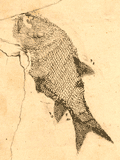 Abstract: It is shown that the species names Palaeothrissum inaequilobum Blainville,
1818, and P. parvum Blainville, 1818, from the Lower Permian
(Asselian) of Muse, near Autun (Saône-et-Loire department, France) are senior synonyms of the widely used
species name, Aeduella blainvillei (Agassiz, 1833). In the interest of nomenclatural stability, conditions exist which allow reversal of precedence as stated in Article 23.9.1 of the International Code of Zoological Nomenclature. Thus the species name Aeduella blainvillei (Agassiz,
1833) is regarded as valid, qualifying as a nomen protectum, whereas Palaeothrissum inaequilobum Blainville,
1818, and P. parvum Blainville, 1818, are invalid, qualifying as nomina oblita. Some of the specimens from the type series upon which P. inaequilobum, P. parvum and Aeduella blainvillei were erected, are identified. Abstract: It is shown that the species names Palaeothrissum inaequilobum Blainville,
1818, and P. parvum Blainville, 1818, from the Lower Permian
(Asselian) of Muse, near Autun (Saône-et-Loire department, France) are senior synonyms of the widely used
species name, Aeduella blainvillei (Agassiz, 1833). In the interest of nomenclatural stability, conditions exist which allow reversal of precedence as stated in Article 23.9.1 of the International Code of Zoological Nomenclature. Thus the species name Aeduella blainvillei (Agassiz,
1833) is regarded as valid, qualifying as a nomen protectum, whereas Palaeothrissum inaequilobum Blainville,
1818, and P. parvum Blainville, 1818, are invalid, qualifying as nomina oblita. Some of the specimens from the type series upon which P. inaequilobum, P. parvum and Aeduella blainvillei were erected, are identified.
|
|
Carnets Geol., vol. 19, no. 8, p. 141-148
Online since August 8, 2019
|
|
Observations on some Actinoporellas (Chlorophyta, Polyphysaceae). Revision of the Jacques Emberger Collection. Part 1
Bruno GRANIER
| HTML  | PDF
| PDF  [5,236 KB]
| DOI: 10.4267/2042/70196 [5,236 KB]
| DOI: 10.4267/2042/70196
|
|
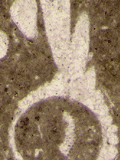 Abstract: On the occasion of the inventory of the J. Emberger Collection, specimens from the "Lower
Cretaceous" (Valanginian and Hauterivian) of Algeria, which are referable
to the genus Actinoporella (Gümbel in Alth) and which were
earlier identified to its type-species A. podolica (Alth) by Conrad
et al., are re-examined. They correspond to two discrete species, one of
which could be a junior synonym of A. podolica, a synonymy that remains
pending because it would require a new sampling at the original locality in
western Ukraine some 140 years after the original specimens, now lost, were
collected. Regarding their age ascription, they are Tithonian and/or Berriasian
in age, i.e., latest Jurassic (sensu Oppel) in age, not
earliest Cretaceous. In addition to these two Actinoporellas, a third discrete
species, initially described as Clypeina nigra (Conrad & Peybernès),
but later referred to the genus Actinoporella, is revised. New data
justify its re-ascription to the genus Bakalovaella Bucur.
Finally, it is now confirmed that both the Polyphysaceae and the modern
Dasycladaceae derive from the Diploporaceae either directly or indirectly
through the ancestral Dasycladaceae. Abstract: On the occasion of the inventory of the J. Emberger Collection, specimens from the "Lower
Cretaceous" (Valanginian and Hauterivian) of Algeria, which are referable
to the genus Actinoporella (Gümbel in Alth) and which were
earlier identified to its type-species A. podolica (Alth) by Conrad
et al., are re-examined. They correspond to two discrete species, one of
which could be a junior synonym of A. podolica, a synonymy that remains
pending because it would require a new sampling at the original locality in
western Ukraine some 140 years after the original specimens, now lost, were
collected. Regarding their age ascription, they are Tithonian and/or Berriasian
in age, i.e., latest Jurassic (sensu Oppel) in age, not
earliest Cretaceous. In addition to these two Actinoporellas, a third discrete
species, initially described as Clypeina nigra (Conrad & Peybernès),
but later referred to the genus Actinoporella, is revised. New data
justify its re-ascription to the genus Bakalovaella Bucur.
Finally, it is now confirmed that both the Polyphysaceae and the modern
Dasycladaceae derive from the Diploporaceae either directly or indirectly
through the ancestral Dasycladaceae.
|
|
Carnets Geol., vol. 19, no. 7, p. 113-139
Online since May 31, 2019
|
|
New data on some type-species of Maastrichtian-Paleocene Dasycladales (Green algae) from Iran. Part I. Pseudocymopolia Elliott, 1970
Koorosh RASHIDI & Felix SCHLAGINTWEIT
| HTML  | PDF
| PDF  [2,525 KB]
| DOI: 10.4267/2042/70194 [2,525 KB]
| DOI: 10.4267/2042/70194
|
|
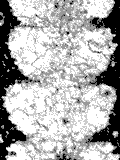 Abstract: Pseudocymopolia
anadyomenea, the type-species of the
genus, was described by Elliott (1959) from the Maastrichtian of Iraq.
Besides the type-locality, it was also recorded from the upper Maastrichtian
Tarbur Formation of Iran, from Afghanistan and Tibet. A rich but
moderately preserved material is analyzed herein, evidencing the presence of two
discrete species: P. anadyomenea and P.
acuta n. sp. The new species is characterized by its thallus morphology
displaying tapering, keeled segment margins. Besides the morphology, both are
also distinguished by biometric parameters such as the outer diameter (D), inner
diameter (d), and the d/D ratio. All other Lower Cretaceous species of Pseudocymopolia as well as the Maastrichtian P. anadyomenea have rounded segment margins. Both taxa from the
Tarbur Formation occur in inner platform quiet water depositional settings
whereas the Lower Cretaceous representatives typically characterize platform
margin deposits. Abstract: Pseudocymopolia
anadyomenea, the type-species of the
genus, was described by Elliott (1959) from the Maastrichtian of Iraq.
Besides the type-locality, it was also recorded from the upper Maastrichtian
Tarbur Formation of Iran, from Afghanistan and Tibet. A rich but
moderately preserved material is analyzed herein, evidencing the presence of two
discrete species: P. anadyomenea and P.
acuta n. sp. The new species is characterized by its thallus morphology
displaying tapering, keeled segment margins. Besides the morphology, both are
also distinguished by biometric parameters such as the outer diameter (D), inner
diameter (d), and the d/D ratio. All other Lower Cretaceous species of Pseudocymopolia as well as the Maastrichtian P. anadyomenea have rounded segment margins. Both taxa from the
Tarbur Formation occur in inner platform quiet water depositional settings
whereas the Lower Cretaceous representatives typically characterize platform
margin deposits.
|
|
Carnets Geol., vol. 19, no. 6, p. 97-111
Online since May 31, 2019
|
|
Upper Devonian Griottes Limestone in NW Sahara (Algeria): Facies, environments and geodynamic significance
Abdelkader ABBACHE, Abdelkader OUALI MEHADJI, Catherine CRÔNIER, Ahmed Hamza FELLAH, Ninon ALLAIRE & Claude MONNET
| HTML  | PDF
| PDF  [3,405 KB]
| DOI: 10.4267/2042/70192 [3,405 KB]
| DOI: 10.4267/2042/70192
|
|
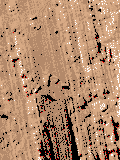 Abstract: On the NW margin of
the Algerian Sahara in the Bechar (Ben-Zireg), Ougarta (Marhouma) and
Gourara (Charouine) basins, the Upper Devonian
"griottes" nodular
limestone was deposited during the Frasnian and the Famennian. These
alternating clayey-sand-limestone
deposits are rich in ammonoids. These facies vary laterally and in
thickness in these three areas. These
facies variations are directly related to depositional environmental
conditions (hydrodynamism, basin physiography, sedimentary gaps). In the
three studied areas, the griotte facies were deposited
on a deep seabed platform and in basins under tectono-eustatic control.
In the Ben-Zireg area platform facies
are throughout the studied stratigraphic interval. In the Marhouma area,
the facies change through time first as distal ramp sedimentation
(Frasnian Ia), then shifting to an apron slope sedimentation with
allodapic facies
(Famennian II, VI and V), and
then in basinal settings (Famennian II and VI). Finally, at the end of
the
Famennian, the series ended with sandy-clay slope sedimentation (lower
member of the Ouarourout sandstone), and next platform sedimentation
(upper member of Ouarourout sandstone) topped by an
emersion surface. In the Charouine area, basin clays (hemipelagites)
dominate the
facies. The presence of asphaltene impregnations in the griotte facies
and in centimetric slabs
to metric blocks of the facies posterior to nodular limestones implies
the effects of early
diagenesis. This process played an important role in the sulphate
reduction and the anaerobic oxidation of methane (biogenic and / or
thermal). The segregation of sedimentary areas with griotte facies seems
to be
influenced by basement fragmentation. Indeed, the griotte facies closely
follow the Pan-African flexure. In Ougarta, the
"South Ougartian" fault corresponds to the extension of the
mega-lineament of Tibesti. The reactivation of Precambrian basement
faults during the
Late Devonian may have been responsible for the observed contrasting
facies. Abstract: On the NW margin of
the Algerian Sahara in the Bechar (Ben-Zireg), Ougarta (Marhouma) and
Gourara (Charouine) basins, the Upper Devonian
"griottes" nodular
limestone was deposited during the Frasnian and the Famennian. These
alternating clayey-sand-limestone
deposits are rich in ammonoids. These facies vary laterally and in
thickness in these three areas. These
facies variations are directly related to depositional environmental
conditions (hydrodynamism, basin physiography, sedimentary gaps). In the
three studied areas, the griotte facies were deposited
on a deep seabed platform and in basins under tectono-eustatic control.
In the Ben-Zireg area platform facies
are throughout the studied stratigraphic interval. In the Marhouma area,
the facies change through time first as distal ramp sedimentation
(Frasnian Ia), then shifting to an apron slope sedimentation with
allodapic facies
(Famennian II, VI and V), and
then in basinal settings (Famennian II and VI). Finally, at the end of
the
Famennian, the series ended with sandy-clay slope sedimentation (lower
member of the Ouarourout sandstone), and next platform sedimentation
(upper member of Ouarourout sandstone) topped by an
emersion surface. In the Charouine area, basin clays (hemipelagites)
dominate the
facies. The presence of asphaltene impregnations in the griotte facies
and in centimetric slabs
to metric blocks of the facies posterior to nodular limestones implies
the effects of early
diagenesis. This process played an important role in the sulphate
reduction and the anaerobic oxidation of methane (biogenic and / or
thermal). The segregation of sedimentary areas with griotte facies seems
to be
influenced by basement fragmentation. Indeed, the griotte facies closely
follow the Pan-African flexure. In Ougarta, the
"South Ougartian" fault corresponds to the extension of the
mega-lineament of Tibesti. The reactivation of Precambrian basement
faults during the
Late Devonian may have been responsible for the observed contrasting
facies.
|
|
Carnets Geol., vol. 19, no. 5, p. 71-96
Online since May 31, 2019
|
|
New stratigraphic and genetic model for the dolomitic Cretaceous Pinda reservoirs in Angola. Part II - Compelling arguments against early dolomitization and early leaching
Bruno GRANIER
| HTML  | PDF
| PDF  [3,099 KB]
| DOI: 10.4267/2042/69773 [3,099 KB]
| DOI: 10.4267/2042/69773
|
|
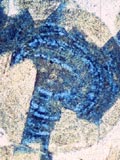 Abstract: This
is the second contribution to the stratigraphic and genetic model of the Pinda
Group. The mid-Cretaceous Pinda
Group of the Congo basin in the northern Angolan offshore is a transgressive
supersequence. Its lower part is made of Bufalo
and Pacassa facies that correspond respectively to mixed and calcareous-dolomitic
grain-dominated fabrics. Both facies were strongly diagenetically altered, mostly
by dolomitic replacement and leaching. Contrary to opinions expressed by other
authors that both styles of alteration are early diagenetic phenomena, there is
substantial evidence for a burial origin with dolomitic replacement and leaching
of calcite having started at depths not less than 150 m and 400 m, respectively. Abstract: This
is the second contribution to the stratigraphic and genetic model of the Pinda
Group. The mid-Cretaceous Pinda
Group of the Congo basin in the northern Angolan offshore is a transgressive
supersequence. Its lower part is made of Bufalo
and Pacassa facies that correspond respectively to mixed and calcareous-dolomitic
grain-dominated fabrics. Both facies were strongly diagenetically altered, mostly
by dolomitic replacement and leaching. Contrary to opinions expressed by other
authors that both styles of alteration are early diagenetic phenomena, there is
substantial evidence for a burial origin with dolomitic replacement and leaching
of calcite having started at depths not less than 150 m and 400 m, respectively.
|
|
Carnets Geol., vol. 19, no. 4, p. 47-70
Online since February 15, 2019
|
|
The "avatars" of Triloculina laevigata Orbigny, 1826, generic and specific attribution
Armelle POIGNANT
| HTML  | PDF
| PDF  [1,280 KB]
| DOI: 10.4267/2042/69756 [1,280 KB]
| DOI: 10.4267/2042/69756
|
|
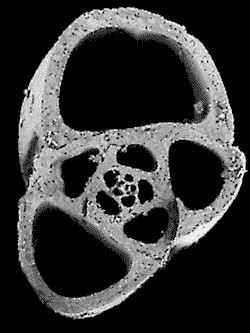 Abstract: The purpose of this study is to
clarify the problem posed by Triloculina laevigata Orbigny, 1826, nom. nud., described and figured by Fornasini in
1905. An other species, also called Triloculina
laevigata was created by Bornemann in 1855 and Orbigny's
specific name became invalid. This invalidity was only recently assessed and
numerous authors still use the original assignation. Consequently, it seems
necessary to erect a new name. After listing the various
names, revising the subgenus and genera attributed to Triloculina
laevigata, and comparing fossil and recent specimens, the name: Affinetrina alcidi Lévy et
al., 1992a, is confirmed. Abstract: The purpose of this study is to
clarify the problem posed by Triloculina laevigata Orbigny, 1826, nom. nud., described and figured by Fornasini in
1905. An other species, also called Triloculina
laevigata was created by Bornemann in 1855 and Orbigny's
specific name became invalid. This invalidity was only recently assessed and
numerous authors still use the original assignation. Consequently, it seems
necessary to erect a new name. After listing the various
names, revising the subgenus and genera attributed to Triloculina
laevigata, and comparing fossil and recent specimens, the name: Affinetrina alcidi Lévy et
al., 1992a, is confirmed.
|
|
Carnets Geol., vol. 19, no. 3, p. 35-46
Online since February 4, 2019
|
|
Uteria naghanensis n. sp. (Dasycladale) from the Upper Maastrichtian of Iran
Koorosh RASHIDI & Felix SCHLAGINTWEIT
| HTML  | PDF
| PDF  [1,498 KB]
| DOI: 10.4267/2042/69755 [1,498 KB]
| DOI: 10.4267/2042/69755
|
|
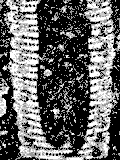 Abstract: A new dasycladalean alga is described
as Uteria naghanensis n. sp. from the
late Maastrichtian Tarbur Formation of the Zagros Zone, SW Iran. It is a small
to medium-sized, rather well calcified species with small articles each bearing
one fertile ampulla, alternating with close-set verticils of numerous sterile
laterals. Another characteristic is its comparably wide main axis. The genus Uteria
Michelin was so far only known from the Paleogene (Danian-Lutetian). The
discovery of U. naghanensis n. sp. in
inner platform wackestone of the Tarbur Fm. documents the origination of the
genus already in the uppermost Cretaceous within an area belonging to the
Arabian Plate. Abstract: A new dasycladalean alga is described
as Uteria naghanensis n. sp. from the
late Maastrichtian Tarbur Formation of the Zagros Zone, SW Iran. It is a small
to medium-sized, rather well calcified species with small articles each bearing
one fertile ampulla, alternating with close-set verticils of numerous sterile
laterals. Another characteristic is its comparably wide main axis. The genus Uteria
Michelin was so far only known from the Paleogene (Danian-Lutetian). The
discovery of U. naghanensis n. sp. in
inner platform wackestone of the Tarbur Fm. documents the origination of the
genus already in the uppermost Cretaceous within an area belonging to the
Arabian Plate.
|
|
Carnets Geol., vol. 19, no. 2, p. 21-33
Online since February 3, 2019
|
|
Reinstatement of the genus Bakalovaella Bucur, 1993 (Dasycladeae, Dasycladaceae), and a description of its earliest Cretaceous representative
Bruno R.C. GRANIER & Ioan I. BUCUR
| HTML  | PDF
| PDF  [3,082 KB]
| DOI: 10.4267/2042/69540 [3,082 KB]
| DOI: 10.4267/2042/69540
|
|
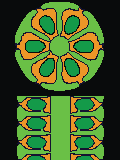 Abstract: A new
Dasycladacean species found in Hauterivian strata in Aquitaine is described. It
is ascribed to the genus Bakalovaella Bucur, 1993, which is
reinstated here. From a phylogenetic point of view, based of the
"lifting piston" model, this taxon should be part of a lineage
derived from the Diploporaceae. Abstract: A new
Dasycladacean species found in Hauterivian strata in Aquitaine is described. It
is ascribed to the genus Bakalovaella Bucur, 1993, which is
reinstated here. From a phylogenetic point of view, based of the
"lifting piston" model, this taxon should be part of a lineage
derived from the Diploporaceae.
|
|
Carnets Geol., vol. 19, no. 1, p. 1-19
Online since January 17, 2019
|

|
|
2018 (vol. 18)
|
|
Quick look evaluation of scientific research using a Research Index
Bruno GRANIER
| HTML  | PDF
| PDF  [76 KB]
| DOI: 10.2110/carnets.2018.1815 [76 KB]
| DOI: 10.2110/carnets.2018.1815
|
|
 Abstract: Although people may be reluctant to use
bibliometrics to evaluate researchers, these metrics provide invaluable parameters for peers to faithfully evaluate colleagues or subordinates. Although there are always biases
in any evaluation system, the Research Index used in the striking case documented above provides a quick and efficient tool to identify people who fail to meet their performance goals
or, on the opposite, those who overpass them. Abstract: Although people may be reluctant to use
bibliometrics to evaluate researchers, these metrics provide invaluable parameters for peers to faithfully evaluate colleagues or subordinates. Although there are always biases
in any evaluation system, the Research Index used in the striking case documented above provides a quick and efficient tool to identify people who fail to meet their performance goals
or, on the opposite, those who overpass them.
|
|
Carnets Geol., vol. 18, no. 15, p. 353-355
Online since December 31, 2018
|
|
The ammonoid fauna of the Prionocyclus germari Zone (upper Turonian, upper Cretaceous) from Rochefort-en-Valdaine (Drôme, France)
Cyril BAUDOUIN, Gérard DELANOY, Christina IFRIM & Josep A. MORENO-BEDMAR
| HTML  | PDF
| PDF  [8,174 KB]
| DOI: 10.4267/2042/69401 [8,174 KB]
| DOI: 10.4267/2042/69401
|
|
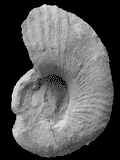 Abstract: The late Turonian ammonoid fauna of Rochefort-en-Valdaine (Drôme, France) is herein described in detail and the intraspecific variability of Vocontiiceras vocontiense Diebold et al., 2018, is studied. The ammonoid assemblage (9 taxa identified) was deposited within the Prionocyclus germari Zone, which
was defined in Germany, and is now also documented in southeastern France. Moreover, the
co-occurrence of the heteromorph ammonoids Hyphantoceras (Hyphantoceras) flexuosum (Schlüter) and Hyphantoceras (Hyphantoceras) ernsti Wiese indicates the lower part of the Prionocyclus germari Zone. Abstract: The late Turonian ammonoid fauna of Rochefort-en-Valdaine (Drôme, France) is herein described in detail and the intraspecific variability of Vocontiiceras vocontiense Diebold et al., 2018, is studied. The ammonoid assemblage (9 taxa identified) was deposited within the Prionocyclus germari Zone, which
was defined in Germany, and is now also documented in southeastern France. Moreover, the
co-occurrence of the heteromorph ammonoids Hyphantoceras (Hyphantoceras) flexuosum (Schlüter) and Hyphantoceras (Hyphantoceras) ernsti Wiese indicates the lower part of the Prionocyclus germari Zone.
|
|
Carnets Geol., vol. 18, no. 14, p. 313-351
Online since December 31, 2018
|
|
First description of rare Teichichnus burrows from carbonate rocks of the Lower Paleozoic of Estonia
Olev VINN & Ursula TOOM
| HTML  | PDF
| PDF  [3,048 KB]
| DOI: 10.4267/2042/68550 [3,048 KB]
| DOI: 10.4267/2042/68550
|
|
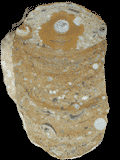 Abstract: Teichichnus
burrows occur in the Sandbian, Katian and Telychian of Estonia associated with
carbonate rocks. It is possible that Teichichnus
is more common in the Sandbian than in the Lower to Middle Ordovician and in the
Silurian. Two ichnospecies, T. rectus
and T. patens, have been identified from the Lower Paleozoic of Estonia. This is the first record of T.
patens in the Ordovician of Baltica. Teichichnus
in the Sandbian, Katian and Telychian of Estonia is restricted to the shallowest
tier levels. The rarity of Teichichnus
in the carbonate sequences of the Ordovician and Silurian of Estonia reflects
little bathymetric variability and an extremely low sedimentation rate in the
shallow epicontinental basin. Abstract: Teichichnus
burrows occur in the Sandbian, Katian and Telychian of Estonia associated with
carbonate rocks. It is possible that Teichichnus
is more common in the Sandbian than in the Lower to Middle Ordovician and in the
Silurian. Two ichnospecies, T. rectus
and T. patens, have been identified from the Lower Paleozoic of Estonia. This is the first record of T.
patens in the Ordovician of Baltica. Teichichnus
in the Sandbian, Katian and Telychian of Estonia is restricted to the shallowest
tier levels. The rarity of Teichichnus
in the carbonate sequences of the Ordovician and Silurian of Estonia reflects
little bathymetric variability and an extremely low sedimentation rate in the
shallow epicontinental basin.
|
|
Carnets Geol., vol. 18, no. 13, p. 305-312
Online since September 21, 2018
|
|
The Oligocene mollusc types of Gaetano Rovereto from Santa Giustina and Sassello (NW Italy)
Maria Cristina BONCI, Gian Mario DABOVE & Michele PIAZZA
| HTML  | PDF
| PDF  [2,074 KB]
| DOI: 10.4267/2042/68549 [2,074 KB]
| DOI: 10.4267/2042/68549
|
|
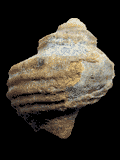 Abstract: The present paper examines the type specimens of the bivalve
and gastropod taxa described by Gaetano Rovereto in the years 1897-1914
coming from the Oligocene rocks of Santa Giustina and Sassello areas (Molare
Formation, Tertiary Piedmont Basin, Central Liguria, NW Italy). These taxa are
part of the "Collezione BTP" (BTP Collection) housed at the Dipartimento di
Scienze della Terra, dell'Ambiente e della Vita - DISTAV - of the Università
di Genova. The collecting sites reported in the Rovereto's papers and
indicated on labels have been reinvestigated in the field. 22 taxa (6 gastropods
and 16 bivalves) are revised and re-documented; 6 have been recognized as younger synonyms of other species, the others
are valid taxa. The majority of this fauna is restricted to the Oligocene time
and to the Tertiary Piedmont Basin. Abstract: The present paper examines the type specimens of the bivalve
and gastropod taxa described by Gaetano Rovereto in the years 1897-1914
coming from the Oligocene rocks of Santa Giustina and Sassello areas (Molare
Formation, Tertiary Piedmont Basin, Central Liguria, NW Italy). These taxa are
part of the "Collezione BTP" (BTP Collection) housed at the Dipartimento di
Scienze della Terra, dell'Ambiente e della Vita - DISTAV - of the Università
di Genova. The collecting sites reported in the Rovereto's papers and
indicated on labels have been reinvestigated in the field. 22 taxa (6 gastropods
and 16 bivalves) are revised and re-documented; 6 have been recognized as younger synonyms of other species, the others
are valid taxa. The majority of this fauna is restricted to the Oligocene time
and to the Tertiary Piedmont Basin.
|
|
Carnets Geol., vol. 18, no. 12, p. 281-303
Online since September 21, 2018
|
|
Campanian-Maastrichtian Rhapydioninidae in the Mediterranean area: Genera Murciella, Sigalveolina n. gen., and Cyclopseudedomia
Jean-Jacques FLEURY
| HTML  | PDF
| PDF  [9,301 KB]
| DOI: 10.4267/2042/68382 [9,301 KB]
| DOI: 10.4267/2042/68382
|
|
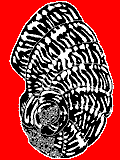 Extended
abstract: This
is the third and last part of a review of the Rhapydioninidae, benthic
foraminifera that inhabited almost alone the most central areas of carbonate
platforms of the Mediterranean realm. A global schematic table (Fig. 18 , in addition to Figs.
15-17)
shows their regional development. The stratigraphic succession of this family
seems to have been dominated by three periods of emersion (one being documented,
the others only inferred) that limit the time distribution of most of these
taxa. Thus it is doubtful that this distribution can be used with certainty in
other areas; for example the mention of "Cuvillierinella? sp."
(possibly a Metacuvillierinella?) in the Upper Maastrichtian of Iran is a
hint of such a discrepancy (Schlagintweit & Rashidi,
2016). Extended
abstract: This
is the third and last part of a review of the Rhapydioninidae, benthic
foraminifera that inhabited almost alone the most central areas of carbonate
platforms of the Mediterranean realm. A global schematic table (Fig. 18 , in addition to Figs.
15-17)
shows their regional development. The stratigraphic succession of this family
seems to have been dominated by three periods of emersion (one being documented,
the others only inferred) that limit the time distribution of most of these
taxa. Thus it is doubtful that this distribution can be used with certainty in
other areas; for example the mention of "Cuvillierinella? sp."
(possibly a Metacuvillierinella?) in the Upper Maastrichtian of Iran is a
hint of such a discrepancy (Schlagintweit & Rashidi,
2016).
Rhapydionininae and Pseudedomiinae subfamilies are summarily
considered here, either because the facts have been established previously, or
because the knowledge of them is still fragmentary. The Rhapydionininae
subfamily, summarily depicted in Figure 18,
is characterized mainly by its endoskeleton, lacking the confluent structure,
with a wide peripheral zone and a very early unrolling trend (either
cylindrical: Rhapydionina, with small proloculus, or flabelliform: Fanrhapydionina,
with large proloculus). The milioline origin of this subfamily is indicated by
species of the R. dercourti group, which are faintly streptospiral in the
initial stages of both generations (Fleury, 2014).
The Pseudedomiinae subfamily is not the subject of these studies, being
essentially represented by taxa in more Eastern regions. Besides, nothing
definite can be deduced from the minimal knowledge of the group (see review in Mavrikas
et al., 1994),
until the type of the type species is still poorly known.
Cuvillierinellinae subfamily (Fleury, 2016)
is made up of six genera, including Cuvillierinella from which the others
are clearly derived. But the origin of this genus remains uncertain. However,
the presence of Pseudonummoloculina aff. kalantarii in our samples
enables the consideration of what would be such an ancestor and how it could be
named. We can try to imagine it from a simple principle and a few observations.
The principle is the independence of evolutionary characters, commonly observed
elsewhere in the family but quite obvious in the type population of Cuvillierinella
salentina (see De Castro, 1988;
Fleury, 2016),
in which coexist the well-known type and specimens of overall same appearance,
either streptospiral and devoid of partitions, or planispiral with a highly
specialized endoskeleton. The observations are those that can be performed on
species described by various authors under the name of Pseudonummoloculina.
These organisms change from streptospiral to planispiral stage during their
development. Some have a unique "notched" opening, others a double row
of openings (and complex combinations of these two rather indistinct types) and
some have no endoskeleton while others display rudimentary partitions. Varying
combinations of these characters defy the conventional criteria of
classification, each combination (changing during the ontogenetic development)
being likely to justify a generic or specific status according to the arbitrary
ordinary standards. These organisms are however in all cases isolated in time
and most often deprived of clearly identifiable descendants (with the exception
of P. pecheuxi Fourcade & Fleury,
2001,
which is the origin of the species of Praechubbina genus). They probably
do not constitute a unique group, but represent a step in an iterative
evolution, leading members of a group of Miliolacea to the Alveolinacea, as Reichel
(1936, 1937)
and Pêcheux (2002)
conceived it and as Fleury and Fourcade
(1990)
illustrated. We are thus led to apply the generic term Pseudonummoloculina
to indicate a transitional state, that is to say an evolving stage. We are here
confronted with the fundamental difficulty of adapting a nomenclature of
creationistic essence to the perpetual reorganization of living organisms. It is
therefore futile to characterize by terminology the temporary results; the term Pseudonummoloculina
seems better to express a vague and essentially unstable notion related to the
realities of evolution, ... at least as long as evolving networks of various
known stages are not identified.
The five genera derived from Cuvillierinella have a wide range of
morphology (Fleury, 2016,
Fig. 13). Each genus is characterized by a dominant evolutionary trend,
variously associated with secondary independent features.
Metacuvillierinella and Pseudochubbina genera are
treated superficially in this text and are probably derived from Cuvillierinella
or its supposed close ancestor. Metacuvillierinella is the closest,
comparable in its young stage to typical streptospiral tests of C. salentina,
comprising an early well developed wide meshed endoskeleton. It is distinguished
by its adult advolute coiling without final uncoiling and its very low
dimorphism of generations, restricted to the initial coiling. Pseudochubbina
is linked to Cuvillierinella perisalentina, also hesitating on its
coiling mode ("Slow Axial Rotation" in Fleury,
2016),
and sharing the "Scattered Secondary Chamberlets" (Fleury,
2016),
which are the only likely criteria for the origin of this genus.
Murciella, Sigalveolina n. gen. and Cyclopseudedomia, are
reviewed here from the types and various new populations, which allows deepening
and renewing of the knowledge of them. They are all fully planispirally coiled
in the A generation and to varying degrees display an endoskeleton that
previously was called "helicoidal structure", here renamed 'confluent
structure'.
Murciella is very close to Cuvillierinella as evidenced by
the coexistence of specimens having characteristics of both types in the
population of the Cuvillierinella type species. The existence of
populations including both Cuvillierinella and Murciella, without
morphological intermediaries, as well as the existence of populations containing
only one or the other of these taxa emphasizes their independence. The six
various populations assigned to M. cuvillieri, known from Spain to the
Eastern Mediterranean sea, are likely to belong to the same zone (CsB6a) and
were never associated with species of the overlying zone. These populations
constitute a homogeneous set close to that of C. salentina appearance,
with a little wider range of the A proloculus and a finer endoskeletal mesh.
Tests of the B generation in several populations suggest that the holotype of
the type species represents this generation, which appears to be less influenced
by uncoiling than C. salentina.
Sigalveolina n. gen. has been long confused with Murciella,
too incompletely known to be distinguished before now. This new genus
characterizes younger levels (zone CsB6b). This study shows that the high degree
of confluent structure that gives its individuality coincides with a
morphological diversity illustrated by four distinct species, including a new
one, Sigalveolina reicheli. This new species probably corresponds to the
mythical material, known as "Cosinella", formerly discovered by
Schlumberger from the Italo-Slovenian border. A tests
of the four species are larger in size than those of Murciella, at
diameters of proloculus of the same order of magnitude; they are only rarely
uncoiled, with the apparent exception of Sigalveolina reicheli n. sp.,
which adopts this trend only at a very late development stage. B tests also tend
to be involute at a later stage, in contrast to the early uncoiling of previous
and next genera.
Cyclopseudedomia is characterized by a very large A proloculus and
an extremely reduced involute stage resulting in a longer uncoiled uniserial
stage. This outstanding evolutionary trend is modulated in four species,
including three already described and a new one, C. mavrikasi from the
Italo-Slovenian border and Southern Italy. This trend is well marked in tests of
both generations. In A tests, the involute part never exceeds 1.5 whorls around
a large proloculus, and the uncoiled part is either cylindrical or flabelliform.
B tests are mainly made of large evolute flabelliform flange, reaching a
discoidal stage in the type species only; these flanges are always flat and
increase in thickness very slightly towards the periphery.
Finally, it must be noted that data in Figure 18,
reduced to the A tests, are imprecise inasmuch as the genera generally include
the features of several species, which are distinguished by nuances affecting
their characters, but also because the time span of the genera and the included
species likely does not correspond to the entire period of time covered by the
zone in which they are recognized. This means that Figure 18 represents a state of schematic knowledge that can be improved only by specific
careful field studies.
|
|
Carnets Geol., vol. 18, no. 11, p. 233-280
Online since September 4, 2018
|
|
Variations in fluvial reworking of Polish moldavites induced by hydrogeological change
Tomasz BRACHANIEC
| HTML  | PDF
| PDF  [1,056 KB]
| DOI: 10.4267/2042/68186 [1,056 KB]
| DOI: 10.4267/2042/68186
|
|
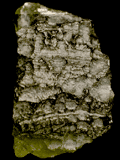 Abstract: Moldavites
as ejecta glasses are fragile and transient: they are quickly abraded in fluvial
conditions, this was confirmed by tumbling experiments. In the present study,
multiple tumbling experiments were conducted to simulate the hydrogeological
conditions of deposition of moldavites found in several different gravel pits.
These experiments threw new light on the evolution of tektites during reworking.
It appears that the original glass shape and mass as well as environmental
conditions such as river velocity and the type of sediment with which they are
associated are all important variables. However, the experiment did not simulate
other significant variables, such as the variability of environmental energy.
With given advantageous conditions, moldavite glasses could probably have
withstood dozen kilometers of reworking, but this assertion is not sufficient to
constrain the distance to their supply areas. Abstract: Moldavites
as ejecta glasses are fragile and transient: they are quickly abraded in fluvial
conditions, this was confirmed by tumbling experiments. In the present study,
multiple tumbling experiments were conducted to simulate the hydrogeological
conditions of deposition of moldavites found in several different gravel pits.
These experiments threw new light on the evolution of tektites during reworking.
It appears that the original glass shape and mass as well as environmental
conditions such as river velocity and the type of sediment with which they are
associated are all important variables. However, the experiment did not simulate
other significant variables, such as the variability of environmental energy.
With given advantageous conditions, moldavite glasses could probably have
withstood dozen kilometers of reworking, but this assertion is not sufficient to
constrain the distance to their supply areas.
|
|
Carnets Geol., vol. 18, no. 10, p. 225-232
Online since July 27, 2018
|
|
Inventory of Georges Pissarro's fossil collection from the Lutetian (middle Eocene) of Cotentin (France) kept in the Science Museum of Laval (France)
Jérôme TRÉGUIER & Jean-Michel PACAUD
| HTML  | PDF
| PDF  [669 KB]
| DOI: 10.4267/2042/68184 [669 KB]
| DOI: 10.4267/2042/68184
|
|
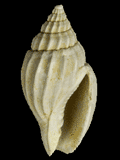 Abstract: One-hundred and fourteen samples from the Georges Pissarro's collection are kept in the
Sciences Museum of Laval. Most of these represent the molluscan fauna from
the Eocene of Cotentin (Hautteville-Bocage, Fresville and Gourbesville;
France), Loire-Atlantique (Saffré, France) and Alabama (Monroe, U.S.). They
were part of a bigger collection gathered by Maurice Cossmann and
Georges Pissarro at the end of the XIXth and the
beginning of the XXth centuries, then subsequently split in two parts. The
first one, Cossmann's, was sent to the National Museum of Natural
History in Paris. Like the Marin Defrance's collection from the Museum
of Caen, the second part, Pissarro's, was considered
lost, and then partially discovered in the Sciences Museum of Laval, giving it some
scientific significance. These samples from Cotentin have been curated and the
types and figured specimens found are illustrated herein. Abstract: One-hundred and fourteen samples from the Georges Pissarro's collection are kept in the
Sciences Museum of Laval. Most of these represent the molluscan fauna from
the Eocene of Cotentin (Hautteville-Bocage, Fresville and Gourbesville;
France), Loire-Atlantique (Saffré, France) and Alabama (Monroe, U.S.). They
were part of a bigger collection gathered by Maurice Cossmann and
Georges Pissarro at the end of the XIXth and the
beginning of the XXth centuries, then subsequently split in two parts. The
first one, Cossmann's, was sent to the National Museum of Natural
History in Paris. Like the Marin Defrance's collection from the Museum
of Caen, the second part, Pissarro's, was considered
lost, and then partially discovered in the Sciences Museum of Laval, giving it some
scientific significance. These samples from Cotentin have been curated and the
types and figured specimens found are illustrated herein.
|
|
Carnets Geol., vol. 18, no. 9, p. 205-223
Online since July 27, 2018
|
|
A palaeobiological window into the Lower Cretaceous Cupido Formation: Puerto México section, Nuevo Leon, Mexico
Felipe TORRES DE LA CRUZ, Elizabeth CHACÓN-BACA, Yesica Edith GÓMEZ-MANCHA & Tomás COSSÍO-TORRES
| HTML  | PDF
| PDF  [1,860 KB]
| DOI: 10.4267/2042/68182 [1,860 KB]
| DOI: 10.4267/2042/68182
|
|
 Abstract: A rich
geobiological record of Cretaceous biotic and abiotic interactions around the
proto-Gulf of Mexico has been preserved in the massive Cupido carbonate
platform, i.e., in a sedimentary sequence that represents a depositional period of
approximately 15 Myr. This work documents lateral facies variation on a dip slope
reef from a new outcrop in the upper part of the Cupido Formation in the state
of Nuevo Leon, Mexico. The measured transect is correlated with a stratigraphic
column logged in a nearby section. The preserved fossil biota represents
marginal reef facies dominated by abundant rudist shells such as Douvillelia
skeltoni, Toucasia sp., Offneria
sp., and Amphitrocoelus sp. associated with relatively large colonial corals
(with diameters up to 25 cm) like Stelidioseris
sp. and to a lesser extent, with stromatoporoids. Benthic foraminifers (miliolids and textularids) with associated dasycladalean algae such as Salpingorella
sp. and Terquemella spp.
dominate the microfossiliferous content in wackestones to packstones. This facies is overlain by a thin
(15-30 cm) stromatolite horizon at the upper end of the measured section. This
locality represents a new paleobiological and taphonomic window into one of the
most extensive carbonate platform system developed along the margin of the Gulf
of Mexico during the Cretaceous. Abstract: A rich
geobiological record of Cretaceous biotic and abiotic interactions around the
proto-Gulf of Mexico has been preserved in the massive Cupido carbonate
platform, i.e., in a sedimentary sequence that represents a depositional period of
approximately 15 Myr. This work documents lateral facies variation on a dip slope
reef from a new outcrop in the upper part of the Cupido Formation in the state
of Nuevo Leon, Mexico. The measured transect is correlated with a stratigraphic
column logged in a nearby section. The preserved fossil biota represents
marginal reef facies dominated by abundant rudist shells such as Douvillelia
skeltoni, Toucasia sp., Offneria
sp., and Amphitrocoelus sp. associated with relatively large colonial corals
(with diameters up to 25 cm) like Stelidioseris
sp. and to a lesser extent, with stromatoporoids. Benthic foraminifers (miliolids and textularids) with associated dasycladalean algae such as Salpingorella
sp. and Terquemella spp.
dominate the microfossiliferous content in wackestones to packstones. This facies is overlain by a thin
(15-30 cm) stromatolite horizon at the upper end of the measured section. This
locality represents a new paleobiological and taphonomic window into one of the
most extensive carbonate platform system developed along the margin of the Gulf
of Mexico during the Cretaceous.
|
|
Carnets Geol., vol. 18, no. 8, p. 187-203
Online since July 21, 2018
|
|
Phanerozoic Brachiopod Genera of China, by Rong Jiayu
(editor-in-chief), Jin Yugan, Shen Shuzhong and Zhan Renbin (eds.), 2017
Fernando ALVAREZ & John TALENT
| HTML  | PDF
| PDF  [273 KB] [273 KB]
|
|
Carnets Geol., vol. 18, Book Review 1, p. 183-186
Online since July 19, 2018
|
|
Valanginian belemnites: New taxonomical and stratigraphical observations
Nico M.M. JANSSEN
| HTML  | PDF
| PDF  [1,029 KB]
| DOI: 10.4267/2042/68153 [1,029 KB]
| DOI: 10.4267/2042/68153
|
|
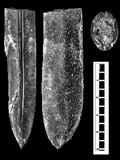 Abstract: Six new Valanginian belemnite species (Duvalia crassa sp. nov., Duvalia
elongata sp. nov., Duvalia kleini
sp. nov., Duvalia superconstricta sp.
nov., Castellanibelus vaubellensis sp.
nov., and "Hibolithes" lebresensis
sp. nov.) are described here and two species (Duvalia aff. elongata
and "Hibolithes" aff. pistilliformis
(Blainville, 1827)) are left in open nomenclature. They come from both the
distal and proximal parts of the Vocontian Basin in south-east France and the
Baetic Cordillera in south-east Spain. In addition lectotypes are selected for Castellanibelus
orbignyanus (Duval-Jouve, 1841), Castellanibelus
picteti (Mayer, 1866), and Duvalia
lata (Blainville, 1827). Abstract: Six new Valanginian belemnite species (Duvalia crassa sp. nov., Duvalia
elongata sp. nov., Duvalia kleini
sp. nov., Duvalia superconstricta sp.
nov., Castellanibelus vaubellensis sp.
nov., and "Hibolithes" lebresensis
sp. nov.) are described here and two species (Duvalia aff. elongata
and "Hibolithes" aff. pistilliformis
(Blainville, 1827)) are left in open nomenclature. They come from both the
distal and proximal parts of the Vocontian Basin in south-east France and the
Baetic Cordillera in south-east Spain. In addition lectotypes are selected for Castellanibelus
orbignyanus (Duval-Jouve, 1841), Castellanibelus
picteti (Mayer, 1866), and Duvalia
lata (Blainville, 1827).
|
|
Carnets Geol., vol. 18, no. 7, p. 167-181
Online since July 7, 2018
|
|
Heteroceras gracile sp. nov., a new species of Heteroceras Orbigny, 1849, from the upper Barremian of
Morteiron (Alpes de Haute-Provence, France)
Cyril BAUDOUIN, Gérard DELANOY, Grégoire BOURNAUD & Roland GONNET
| HTML  | PDF
| PDF  [959 KB]
| DOI: 10.4267/2042/66955 [959 KB]
| DOI: 10.4267/2042/66955
|
|
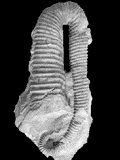 Abstract: The species Heteroceras gracile
sp. nov. is described; it is a small and slender species, with a small helix and
hamuliniform morphology, previously considered as an atypical variant of Heteroceras
baylei (Reynès, 1876). In southeast France, it is mainly known in
the Morteiron section (Alpes de Haute-Provence, France), but the species is also
present in Bulgaria and possibly in Japan. Abstract: The species Heteroceras gracile
sp. nov. is described; it is a small and slender species, with a small helix and
hamuliniform morphology, previously considered as an atypical variant of Heteroceras
baylei (Reynès, 1876). In southeast France, it is mainly known in
the Morteiron section (Alpes de Haute-Provence, France), but the species is also
present in Bulgaria and possibly in Japan.
|
|
Carnets Geol., vol. 18, no. 6, p. 155-165
Online since May 18, 2018
|
|
Is Strontium-isotope stratigraphy a reliable tool for dating shallow-marine platform carbonates at the Barremian-Aptian transition? Review of western Tethyan case studies
Camille FRAU, Jean-Pierre MASSE, Mukerrem FENERCI-MASSE, Anthony J.-B. TENDIL, Antoine PICTET & Cyprien LANTEAUME
| HTML  | PDF
| PDF  [917 KB]
| DOI: 10.4267/2042/66931 [917 KB]
| DOI: 10.4267/2042/66931
|
|
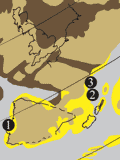 Abstract: Strontium-isotope
measurements on Lower Cretaceous marine rocks derive from belemnite material
sampled in ammonite-constrained basinal successions. A group of values with a
narrow range across the Barremian/Aptian boundary does
not allow the separation of the uppermost Barremian (Martelites sarasini ammonite zone) from the lower Aptian
pro parte (Deshayesites oglanlensis-D.
forbesi ammonite zones). Growing numbers of studies applied Sr-Isotope
Stratigraphy (SIS) on Barremian-Aptian shallow-marine sequences (Urgonian facies)
in
order to solve controversial results obtained by using different shallow-water
biological time markers. Based on re-examination of case studies, we
conclude that Sr-isotope values can neither be used to prove nor to disprove the
location of the putative Barremian/Aptian boundary based on biostratigraphy.
Pending more data available, SIS should be used with caution for dating
ammonite-free carbonate sediments in the corresponding time interval. Abstract: Strontium-isotope
measurements on Lower Cretaceous marine rocks derive from belemnite material
sampled in ammonite-constrained basinal successions. A group of values with a
narrow range across the Barremian/Aptian boundary does
not allow the separation of the uppermost Barremian (Martelites sarasini ammonite zone) from the lower Aptian
pro parte (Deshayesites oglanlensis-D.
forbesi ammonite zones). Growing numbers of studies applied Sr-Isotope
Stratigraphy (SIS) on Barremian-Aptian shallow-marine sequences (Urgonian facies)
in
order to solve controversial results obtained by using different shallow-water
biological time markers. Based on re-examination of case studies, we
conclude that Sr-isotope values can neither be used to prove nor to disprove the
location of the putative Barremian/Aptian boundary based on biostratigraphy.
Pending more data available, SIS should be used with caution for dating
ammonite-free carbonate sediments in the corresponding time interval.
|
|
Carnets Geol., vol. 18, no. 5, p. 139-154
Online since April 21, 2018
|
|
Rediscovery of the type locality of the Udoteacean alga Boueina hochstetteri Toula, 1884, in the Lower Cretaceous of Serbia
Ioan I. BUCUR, Milan N. SUDAR, Emanoil SĂSĂRAN, Divna JOVANOVIĆ, George PLEŞ & Svetlana POLAVDER
| HTML  | PDF
| PDF  [2,652 KB]
| DOI: 10.4267/2042/66509 [2,652 KB]
| DOI: 10.4267/2042/66509
|
|
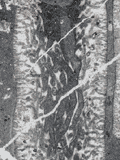 Abstract: Boueina
hochstetteri Toula
(type-species of the genus) was published by Toula (1884) in the 10th
report of his travel through the Balkan region. He considered this species to be
a problematic organism with uncertain systematic affiliation. Later, Steinmann
(1901) assigned this fossil to the calcareous algae. Our own field work
performed in the autumns of 2015 and 2016 in the Pirot area (SE Serbia) led to
re-identification of the rich Boueina
hochstetteri type level, close to the confluence of the Temska and Nišava
Rivers, the type locality of Toula. The rich Boueina
level is part of a succession of bioclastic limestones. The fragments of Boueina thalli are occasionally branched, a feature supporting the
interpretation of Boueina as an
inarticulate udoteacean alga with rare branching. Abstract: Boueina
hochstetteri Toula
(type-species of the genus) was published by Toula (1884) in the 10th
report of his travel through the Balkan region. He considered this species to be
a problematic organism with uncertain systematic affiliation. Later, Steinmann
(1901) assigned this fossil to the calcareous algae. Our own field work
performed in the autumns of 2015 and 2016 in the Pirot area (SE Serbia) led to
re-identification of the rich Boueina
hochstetteri type level, close to the confluence of the Temska and Nišava
Rivers, the type locality of Toula. The rich Boueina
level is part of a succession of bioclastic limestones. The fragments of Boueina thalli are occasionally branched, a feature supporting the
interpretation of Boueina as an
inarticulate udoteacean alga with rare branching.
|
|
Carnets Geol., vol. 18, no. 4, p. 123-137
Online since April 12, 2018
|
|
Early Cenomanian coral faunas from Nea Nikopoli (Kozani, Greece; Cretaceous)
Hannes LÖSER, Thomas STEUBER & Christian LÖSER
| HTML  | PDF
| PDF  [23,800 KB]
| DOI: 10.4267/2042/66094 [23,800 KB]
| DOI: 10.4267/2042/66094
|
|
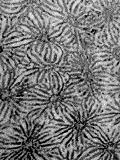 Abstract: A Lower Cenomanian marine succession rich in corals is reported from the western margin of the Pelagonian zone in central Greece. The succession starts with a coarse conglomerate followed by sandstone, nodular limestone and massive limestone. Fifteen levels contain corals with the nodular limestone being the most
species-rich. As a total, 78 species in 46 genera are described. They belong to 15 superfamilies. Three genera and four species are described as new. The new genera belong to the families Heterocoeniidae and Felixaraeidae, and the informal Plesiosmiliids. The record of six genera results in stratigraphical range extensions. The coral associations show more relationships to
Lower than to Upper Cretaceous faunas. Thirty-nine genera already existed before the Cenomanian and 33 genera continued into the Middle Cenomanian, but only 19 genera persisted into the Turonian. The coral fauna has close palaeobiogeographic relationships with mainly Boreal or North Tethyan Cenomanian faunas such as those of the Aquitanian Basin, the
Basque-Cantabrian Basin, or with faunas from the northern margin of the Rhenish Massif, but shares also species with the
Upper Aptian to Lower Albian of the Bisbee Basin in North America and with faunas of the
Lower to Middle Albian of the Northern Pyrenees. Abstract: A Lower Cenomanian marine succession rich in corals is reported from the western margin of the Pelagonian zone in central Greece. The succession starts with a coarse conglomerate followed by sandstone, nodular limestone and massive limestone. Fifteen levels contain corals with the nodular limestone being the most
species-rich. As a total, 78 species in 46 genera are described. They belong to 15 superfamilies. Three genera and four species are described as new. The new genera belong to the families Heterocoeniidae and Felixaraeidae, and the informal Plesiosmiliids. The record of six genera results in stratigraphical range extensions. The coral associations show more relationships to
Lower than to Upper Cretaceous faunas. Thirty-nine genera already existed before the Cenomanian and 33 genera continued into the Middle Cenomanian, but only 19 genera persisted into the Turonian. The coral fauna has close palaeobiogeographic relationships with mainly Boreal or North Tethyan Cenomanian faunas such as those of the Aquitanian Basin, the
Basque-Cantabrian Basin, or with faunas from the northern margin of the Rhenish Massif, but shares also species with the
Upper Aptian to Lower Albian of the Bisbee Basin in North America and with faunas of the
Lower to Middle Albian of the Northern Pyrenees.
|
|
Carnets Geol., vol. 18, no. 3, p. 23-121
Online since April 1, 2018
|
|
Fossil whale barnacles from the lower Pleistocene of Sicily shed light on the coeval Mediterranean cetacean fauna
Alberto COLLARETA, Gianni INSACCO, Agatino REITANO, Rita CATANZARITI, Mark BOSSELAERS, Marco MONTES & Giovanni BIANUCCI
| HTML  | PDF
| PDF  [2,032 KB]
| DOI: 10.4267/2042/65747 [2,032 KB]
| DOI: 10.4267/2042/65747
|
|
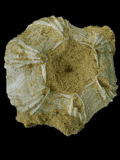 Abstract: We report on three shells
of whale barnacle (Cirripedia: Coronulidae) collected from Pleistocene
shallow-marine deposits exposed at Cinisi (northwestern Sicily, southern Italy).
These specimens are identified as belonging to the extinct species Coronula
bifida Bronn, 1831. Calcareous
nannoplankton analysis of the sediment hosting the coronulid remains places
the time of deposition between 1.93 and 1.71 Ma (i.e.,
at the Gelasian-Calabrian transition), an interval during which
another deposit rich in whale barnacles exposed in southeastern Apulia (southern
Italy) formed. Since Coronula Lamarck, 1802, is
currently found inhabiting the skin of humpback whales [Cetacea:
Balaenopteridae: Megaptera novaeangliae (Borowski, 1781)], and
considering that the detachment of extant coronulids from their hosts' skin has
been mainly observed in occurrence of cetacean breeding/calving areas, the
material here studied supports the existence of a baleen whale migration route between the central Mediterranean Sea (the putative reproductive ground)
and the North Atlantic (the putative feeding ground) around 1.8 Ma, when several
portions of present-day southern Italy were still submerged. The early
Pleistocene utilization of the epeiric seas of southern Italy as
breeding/calving areas by migrating mysticetes appears to be linked to the
severe climatic degradation that has been recognized at the Gelasian-Calabrian
transition and that is marked in the fossil record of the Mediterranean Basin by
the appearance of "northern guests" such as Arctica islandica (Linnaeus,
1767) (Bivalvia: Veneroida). The subsequent abandonment of the Mediterranean Sea by most
species of mysticetes is likely to have resulted from the progressive emergence
of shallow-water coastal environments that occurred in Calabrian and Middle
Pleistocene times. Abstract: We report on three shells
of whale barnacle (Cirripedia: Coronulidae) collected from Pleistocene
shallow-marine deposits exposed at Cinisi (northwestern Sicily, southern Italy).
These specimens are identified as belonging to the extinct species Coronula
bifida Bronn, 1831. Calcareous
nannoplankton analysis of the sediment hosting the coronulid remains places
the time of deposition between 1.93 and 1.71 Ma (i.e.,
at the Gelasian-Calabrian transition), an interval during which
another deposit rich in whale barnacles exposed in southeastern Apulia (southern
Italy) formed. Since Coronula Lamarck, 1802, is
currently found inhabiting the skin of humpback whales [Cetacea:
Balaenopteridae: Megaptera novaeangliae (Borowski, 1781)], and
considering that the detachment of extant coronulids from their hosts' skin has
been mainly observed in occurrence of cetacean breeding/calving areas, the
material here studied supports the existence of a baleen whale migration route between the central Mediterranean Sea (the putative reproductive ground)
and the North Atlantic (the putative feeding ground) around 1.8 Ma, when several
portions of present-day southern Italy were still submerged. The early
Pleistocene utilization of the epeiric seas of southern Italy as
breeding/calving areas by migrating mysticetes appears to be linked to the
severe climatic degradation that has been recognized at the Gelasian-Calabrian
transition and that is marked in the fossil record of the Mediterranean Basin by
the appearance of "northern guests" such as Arctica islandica (Linnaeus,
1767) (Bivalvia: Veneroida). The subsequent abandonment of the Mediterranean Sea by most
species of mysticetes is likely to have resulted from the progressive emergence
of shallow-water coastal environments that occurred in Calabrian and Middle
Pleistocene times.
|
|
Carnets Geol., vol. 18, no. 2, p. 9-22
Online since March 19, 2018
|
|
Hedbergella yezoana is a valid species name: Comments on the case 3620 and decision (opinion 2362) by the International Commission of Zoological Nomenclature
M. Dan GEORGESCU
| HTML  | PDF
| PDF  [623 KB]
| DOI: 10.4267/2042/64918 [623 KB]
| DOI: 10.4267/2042/64918
|
|
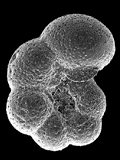 Abstract: International Commission of Zoological Nomenclature decided in September 2015 on case 3620 submitted by A. Ando (United States National Museum, Smithsonian Institution,
Washington, D.C.), which regards the status of the species Ticinella primula Luterbacher in Renz et
al., 1963, and Hedbergella trocoidea yezoana Takayanagi & Iwamoto,
1962. Decision was to place the former on the Official List of Specific Names in
Zoology and the latter on the Official Index of Rejected and Invalid Specific
Names in Zoology (ICZN, 2015, p. 227). The scientific fundamentals in the
presentation of case 3620 are weak and do not support such a decision by the
International Commission. Moreover, they create a significant disturbance of
nomenclatural stability in the Linnaean classification of the Cretaceous planktonic foraminifera. Abstract: International Commission of Zoological Nomenclature decided in September 2015 on case 3620 submitted by A. Ando (United States National Museum, Smithsonian Institution,
Washington, D.C.), which regards the status of the species Ticinella primula Luterbacher in Renz et
al., 1963, and Hedbergella trocoidea yezoana Takayanagi & Iwamoto,
1962. Decision was to place the former on the Official List of Specific Names in
Zoology and the latter on the Official Index of Rejected and Invalid Specific
Names in Zoology (ICZN, 2015, p. 227). The scientific fundamentals in the
presentation of case 3620 are weak and do not support such a decision by the
International Commission. Moreover, they create a significant disturbance of
nomenclatural stability in the Linnaean classification of the Cretaceous planktonic foraminifera.
|
|
Carnets Geol., vol. 18, no. 1, p. 1-7
Online since February 15, 2018
|

|
|
2017 (vol. 17)
|
|
Revision of the Juliette Pfender Collection. 3rd part. About some fossil green algae
Bruno GRANIER & Ioan I.BUCUR
| HTML  | PDF
| PDF  [6,036 KB]
| DOI: 10.4267/2042/64293 [6,036 KB]
| DOI: 10.4267/2042/64293
|
|
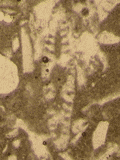 Abstract: This work is a new but minor
contribution to the récolement of Juliette Pfender's collection of
fossil green algae. It aims to establish a partial inventory of the green algae
studied by this female researcher mostly renowned for her studies on red algae.
The poor preservation of some thin sections and the scarcity of whole specimens
only rarely allow the identification of the taxa at the level below the genus. Abstract: This work is a new but minor
contribution to the récolement of Juliette Pfender's collection of
fossil green algae. It aims to establish a partial inventory of the green algae
studied by this female researcher mostly renowned for her studies on red algae.
The poor preservation of some thin sections and the scarcity of whole specimens
only rarely allow the identification of the taxa at the level below the genus.
|
|
Carnets Geol., vol. 17, no. 14, p. 251-269
Online since December 24, 2017
|
|
Additional contributions to the knowledge of the Taquaral Member, Irati Formation (Lower Permian, Paraná Basin): Taphonomy and paleoenvironmental implications
Artur CHAHUD
| HTML  | PDF
| PDF  [2,725 KB]
| DOI: 10.4267/2042/64291 [2,725 KB]
| DOI: 10.4267/2042/64291
|
|
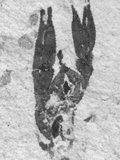 Abstract: The
silty shale facies of the Taquaral Member (Irati Formation), which is one of the
Permian units in the Brazilian Paraná Basin, is discussed here based on the
taphonomy relevant to the paleoenvironmental interpretation. The fossils are
crustaceans (Clarkecaris and other
indeterminate forms), isolated teeth, scales and bones of Actinopterygii, "Palaeonisciformes", which are the most common vertebrate remains, and also
frequent scales of Coelacanthiformes. The scales, teeth and disarticulated bones
are found together in accumulations, which may be interpreted as coprolites.
Many of the fossil crustaceans display characteristics of ecdysis. Abstract: The
silty shale facies of the Taquaral Member (Irati Formation), which is one of the
Permian units in the Brazilian Paraná Basin, is discussed here based on the
taphonomy relevant to the paleoenvironmental interpretation. The fossils are
crustaceans (Clarkecaris and other
indeterminate forms), isolated teeth, scales and bones of Actinopterygii, "Palaeonisciformes", which are the most common vertebrate remains, and also
frequent scales of Coelacanthiformes. The scales, teeth and disarticulated bones
are found together in accumulations, which may be interpreted as coprolites.
Many of the fossil crustaceans display characteristics of ecdysis.
|
|
Carnets Geol., vol. 17, no. 13, p. 243-250
Online since December 24, 2017
|
|
Cornulitids from the Upper Ordovician of northwestern Russia
Olev VINN & Anna MADISON
| HTML  | PDF
| PDF  [958 KB]
| DOI: 10.4267/2042/64289 [958 KB]
| DOI: 10.4267/2042/64289
|
|
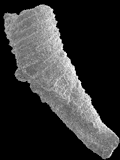 Abstract: Four
cornulitid species occur in the Rakvere Regional Stage in NW Russia. The new
species Conchicolites rossicus is here described; it is the earliest known Conchicolites
from the Ordovician of Baltica. The new species has very small tubes with sharp,
strong and regular annulations. The diversity of cornulitids in the Rakvere
Regional Stage at the Pechurki quarry is usual for the Upper Ordovician of
Baltica. The cornulitids of Pechurki quarry encrusted hard organic substrates in
a mud bottom (clay and carbonate clay) environment. Cornulites
sterlingensis occurs both in the Upper Ordovician of North America and
Baltica, which suggest a short distance between these two paleocontinents and/or
similar environmental conditions. Abstract: Four
cornulitid species occur in the Rakvere Regional Stage in NW Russia. The new
species Conchicolites rossicus is here described; it is the earliest known Conchicolites
from the Ordovician of Baltica. The new species has very small tubes with sharp,
strong and regular annulations. The diversity of cornulitids in the Rakvere
Regional Stage at the Pechurki quarry is usual for the Upper Ordovician of
Baltica. The cornulitids of Pechurki quarry encrusted hard organic substrates in
a mud bottom (clay and carbonate clay) environment. Cornulites
sterlingensis occurs both in the Upper Ordovician of North America and
Baltica, which suggest a short distance between these two paleocontinents and/or
similar environmental conditions.
|
|
Carnets Geol., vol. 17, no. 12, p. 235-241
Online since December 24, 2017
|
|
Mecaster texanus (Echinoidea) from Turonian-Coniacian strata in the Sergipe-Alagoas Basin, Brazil
Cynthia L. de C. MANSO & Wagner SOUZA-LIMA
| HTML  | PDF
| PDF  [1,325 KB]
| DOI: 10.4267/2042/64287 [1,325 KB]
| DOI: 10.4267/2042/64287
|
|
 Abstract: The spatangoid echinoid Mecaster texanus (Roemer) was first
described from the Austin Chalk in Texas (USA). In northeast Brazil, this
species was recorded from the Upper Cretaceous (Turonian-Coniacian) Jandaíra
Formation in the Potiguar Basin. Here we extend the palaeogeographical
distribution of M. texanus southwards to the Sergipe-Alagoas
Basin, where this species occurs in the Turonian-Coniacian Cotinguiba Formation.
A key to identification of spatangoids from the Cretaceous-Cenozoic sequence at
Sergipe-Alagoas is added and considerations about other spatangoid species from
that basin are presented. Abstract: The spatangoid echinoid Mecaster texanus (Roemer) was first
described from the Austin Chalk in Texas (USA). In northeast Brazil, this
species was recorded from the Upper Cretaceous (Turonian-Coniacian) Jandaíra
Formation in the Potiguar Basin. Here we extend the palaeogeographical
distribution of M. texanus southwards to the Sergipe-Alagoas
Basin, where this species occurs in the Turonian-Coniacian Cotinguiba Formation.
A key to identification of spatangoids from the Cretaceous-Cenozoic sequence at
Sergipe-Alagoas is added and considerations about other spatangoid species from
that basin are presented.
|
|
Carnets Geol., vol. 17, no. 11, p. 221-234
Online since December 24, 2017
|
|
Palynology and sedimentary environments of the Devonian from the Saida area (northwestern Algeria)
Mohammed BOUGARA, Philippe STEEMANS, Alain LE HÉRISSÉ & Frédéric BOULVAIN
| HTML  | PDF
| PDF  [1,679 KB]
| DOI: 10.4267/2042/64285 [1,679 KB]
| DOI: 10.4267/2042/64285
|
|
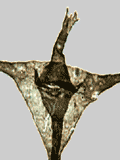 Abstract: Palynological interpretations of
both spores and acritarchs from the Devonian Tiffrit Formation located in Saïda
(North-Western Algeria) support identical conclusions. Species of spores and acritarches that appear in the upper
layers of the younger reference unit, named Boukourdène (BK1), are compatible
with a Pragian-Emsian age, based especially on the presence of the
miospores Dibolisporites wetteldorfensis, Dictyotriletes emsiensis,
D. subgranifer, Verrucosisporites polygonalis, and the
acritarchs Evittia crucistellata, E. spicifera, Fimbriaglomerella
aulerca, Florisphaeridium toyetae, and Veryhachium aff. V.
vandenbergheni. Abstract: Palynological interpretations of
both spores and acritarchs from the Devonian Tiffrit Formation located in Saïda
(North-Western Algeria) support identical conclusions. Species of spores and acritarches that appear in the upper
layers of the younger reference unit, named Boukourdène (BK1), are compatible
with a Pragian-Emsian age, based especially on the presence of the
miospores Dibolisporites wetteldorfensis, Dictyotriletes emsiensis,
D. subgranifer, Verrucosisporites polygonalis, and the
acritarchs Evittia crucistellata, E. spicifera, Fimbriaglomerella
aulerca, Florisphaeridium toyetae, and Veryhachium aff. V.
vandenbergheni.
On the basis of occurrences of
microconglomeratic levels with elements of Silurian phtanites found along the
sedimentary units of Tiffrit, we consider that Silurian sediments as well as
Lower Devonian sediments have been reworked. We thus propose a Praguian-Emsian age for the Boukourdène
units.
From
a sedimentological point of view, the Devonian sedimentary units of the Tiffrit
Massif are linked to a gravitational deposition controlled by sea
level rise and significant subsidence. Facies
seems to change along an East-West axis. The particle size, the nature of
the facies, and their extreme variability over short distances indicate a slope
apron environment of deposition.
The lithological, sedimentological and environmental characteristics of the
studied system are consistent with deposition in an active tectonic margin
setting.
|
|
Carnets Geol., vol. 17, no. 10, p. 191-219
Online since December 24, 2017
|
|
GSSP proposal for the upper Aptian substage in the Apt Basin (Vaucluse, SE France): Synthesis of the stratigraphic data
Michel MOULLADE, Guy TRONCHETTI, Christine BALME, Yves DUTOUR, Pierre ROPOLO, Gregory PRICE, Mathieu MARTINEZ & Bruno GRANIER
| HTML  | PDF
| PDF  [2,338 KB]
| DOI: 10.4267/2042/62954 [2,338 KB]
| DOI: 10.4267/2042/62954
|
|
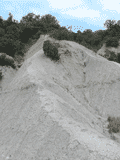 Abstract: The synthesis of the stratigraphic data collected over more than a decade in
the stratotypic area has made it possible to establish a composite section of
the "Aptian marls" from the Grandis ammonite Subzone to the base of
the Melchioris Zone, i.e., from the Schackoina
(Leupoldina) gr. cabri
foraminiferal Zone to the Globigerinelloides
algerianus Zone. This composite section includes the partial sections from
Clavaillan, South and East Pichouraz, La Tuilière, Les Gays and Gargas
(Vaucluse, SE France). In particular, our revision has shown that the marly
calcareous bed, which divides the marly series of Clavaillan and Pichouraz,
compared with the Vocontian "Niveau blanc" and thought to be unique and isochronous, corresponds in
fact to two stratigraphically distinct levels. Abstract: The synthesis of the stratigraphic data collected over more than a decade in
the stratotypic area has made it possible to establish a composite section of
the "Aptian marls" from the Grandis ammonite Subzone to the base of
the Melchioris Zone, i.e., from the Schackoina
(Leupoldina) gr. cabri
foraminiferal Zone to the Globigerinelloides
algerianus Zone. This composite section includes the partial sections from
Clavaillan, South and East Pichouraz, La Tuilière, Les Gays and Gargas
(Vaucluse, SE France). In particular, our revision has shown that the marly
calcareous bed, which divides the marly series of Clavaillan and Pichouraz,
compared with the Vocontian "Niveau blanc" and thought to be unique and isochronous, corresponds in
fact to two stratigraphically distinct levels.
The present study confirms that the visible series of marls in the stratotypic area, not
taking into account the "A1" supra-Urgonian formation of Leenhardt
(1883), includes only the uppermost terms of the Bedoulian and the lower terms
(= Lower and Middle Gargasian) of the Aptian s.s. (i.e., sensu Orbigny, 1840).
Based on the methods of integrated stratigraphy, a comparison of the
series of the Apt Basin with the contemporary terms of the Cassis-La Bédoule
Basin has also made it possible to detect and quantify important variations in
the rhythms of sedimentary accumulation between the two sectors. In the end,
the Clavaillan section, located 8 km WSW from the Gargas section, is the only
outcrop where the boundary between the Grandis Subzone and the Furcata Zone is
visible in a context which supports a proposal that this exposure be a
candidate for the GSSP of the Gargasian substage (or of the Aptian s.s. in the initial concept of the creator of the stage).
|
|
Carnets Geol., vol. 17, no. 9, p. 161-189
Online since October 20, 2017
|
|
Revision of the Barrande's specimen "Tige d'une Cystidée indéterminée" (Cambrian, Echinodermata, Eocrinoidea)
Martina NOHEJLOVÁ & Oldřich FATKA
| HTML  | PDF
| PDF  [548 KB]
| DOI: 10.4267/2042/62768 [548 KB]
| DOI: 10.4267/2042/62768
|
|
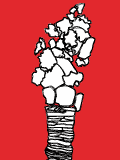 Abstract: Reexamination of the type
specimen described
by Barrande in 1887 as "Tige d'une
Cystidée indéterminée" shows that this unique specimen represents an
articulated but incomplete remnant of the gogiid eocrinoid Akadocrinus
jani Prokop. The
specimen is preserved as an external mould in shale from the mid-Cambrian Jince
Formation, and comprises a proximal part of a stem associated with a slightly
disarticulated distal portion of a theca, composed of over twenty polygonal
plates. With the exception of the basal-most plates, all other preserved thecal
plates bear ellipsoidal marginal epispires, and substantiate assignment of this
specimen to the epispire-bearing phase in ontogenetic development of Akadocrinus. Abstract: Reexamination of the type
specimen described
by Barrande in 1887 as "Tige d'une
Cystidée indéterminée" shows that this unique specimen represents an
articulated but incomplete remnant of the gogiid eocrinoid Akadocrinus
jani Prokop. The
specimen is preserved as an external mould in shale from the mid-Cambrian Jince
Formation, and comprises a proximal part of a stem associated with a slightly
disarticulated distal portion of a theca, composed of over twenty polygonal
plates. With the exception of the basal-most plates, all other preserved thecal
plates bear ellipsoidal marginal epispires, and substantiate assignment of this
specimen to the epispire-bearing phase in ontogenetic development of Akadocrinus.
|
|
Carnets Geol., vol. 17, no. 8, p. 153-160
Online since October 16, 2017
|
|
Rare rugosan-bryozoan intergrowth from the Upper Ordovician of Estonia
Olev VINN, Andrej ERNST & Ursula TOOM
| HTML  | PDF
| PDF  [1,517 KB]
| DOI: 10.4267/2042/62664 [1,517 KB]
| DOI: 10.4267/2042/62664
|
|
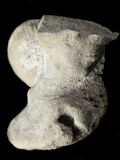 Abstract: Two
relatively large specimens of the rugosan Lambelasma
sp. are fully intergrown with the bryozoan Stigmatella
massalis colony. The intergrown specimen occurs in the Oandu Regional Stage
(lower Katian) of Estonia and constitutes the earliest record of
bryozoan-rugosan intergrowth from Baltica. Most likely this symbiotic
association was accidental. Rugosans presumably benefitted from the bryozoan,
which served as an anchor to stabilize them in hydrodynamically active waters.
The lack of malformations and no decrease in the size of bryozoan zooids near
the rugosans indicate a lack of negative effect of the rugosans on the bryozoan.
Bryozoan-rugosan symbiosis is only known from the Ordovician of Baltica and
Laurentia. Abstract: Two
relatively large specimens of the rugosan Lambelasma
sp. are fully intergrown with the bryozoan Stigmatella
massalis colony. The intergrown specimen occurs in the Oandu Regional Stage
(lower Katian) of Estonia and constitutes the earliest record of
bryozoan-rugosan intergrowth from Baltica. Most likely this symbiotic
association was accidental. Rugosans presumably benefitted from the bryozoan,
which served as an anchor to stabilize them in hydrodynamically active waters.
The lack of malformations and no decrease in the size of bryozoan zooids near
the rugosans indicate a lack of negative effect of the rugosans on the bryozoan.
Bryozoan-rugosan symbiosis is only known from the Ordovician of Baltica and
Laurentia.
|
|
Carnets Geol., vol. 17, no. 7, p. 145-151
Online since October 16, 2017
|
|
The most distal moldavite findings from Lower Silesia, Poland
Tomasz BRACHANIEC
| HTML  | PDF
| PDF  [1,366 KB]
| DOI: 10.4267/2042/62663 [1,366 KB]
| DOI: 10.4267/2042/62663
|
|
 Abstract: The
present note reports new findings of moldavites from southwestern
Poland. The material was found in the Nowa Wieś Kącka sandpit. To
date, it represents the most distal locality where moldavites have been found.
These moldavites, like other moldavites previously described from Lower Silesia,
are recovered from fluvial sands and gravels of the Gozdnica Formation. Like
other Polish moldavites, the moldavites in this study display high SiO2
contents (~77 wt.%). Their dimensions range from 9 to 11 mm in maximum diameter.
Their relatively large sizes suggest that the distribution of Polish tektites
defines a sub-strewnfield larger than previously expected. Abstract: The
present note reports new findings of moldavites from southwestern
Poland. The material was found in the Nowa Wieś Kącka sandpit. To
date, it represents the most distal locality where moldavites have been found.
These moldavites, like other moldavites previously described from Lower Silesia,
are recovered from fluvial sands and gravels of the Gozdnica Formation. Like
other Polish moldavites, the moldavites in this study display high SiO2
contents (~77 wt.%). Their dimensions range from 9 to 11 mm in maximum diameter.
Their relatively large sizes suggest that the distribution of Polish tektites
defines a sub-strewnfield larger than previously expected.
|
|
Carnets Geol., vol. 17, no. 6, p. 139-144
Online since October 16, 2017
|
|
Importance of the Quatrehomme collection (Monnaye Museum, Meung-sur-Loire) in the French palaeontological landscape
Morgane DUBIED, Charlène GILBERT, Maxime DELÉGLISE, Flavie LAURENS & Bastien MENNECART
| HTML  | PDF
| PDF  [528 KB]
| DOI: 10.4267/2042/62541 [528 KB]
| DOI: 10.4267/2042/62541
|
|
 Abstract: The Quatrehomme collection is described by
Ginsburg as "modest to very modest" and there is no accurate
inventory. In
order to highlight this collection and better understand its importance, an
inventory of the terrestrial mammal remains is in progress. In the current state
of the inventory 35 different locations were identified, mostly in the Savigné-sur-Lathan
Basin. 3,266 specimens, covering 8 of the 9 orders of terrestrial mammals found
in the Faluns, are currently registered in the data set. To date, the most
impressive published Faluns mammal collections are from Hartmann, hosted at the
volunteer "Musée du Savignéen" (Savigné-sur-Lathan) and Bourgeois
(today
splitted in different museums). While this Hartmann's collection contains 1,475
mammal remains (marine and terrestrial) and Bourgeois' one 1850
(only terrestrial), we estimate that the Quatrehomme collection encompasses more than
7,500 terrestrial specimens. It is the largest known Faluns collection of Pliopithecus
(25 specimens) and of Lagomorpha (1,355 specimens). Also, eight Tapiroidea
specimens (including a jaw with teeth) and three Chalicotherium
remains are inventoried. This collection is now being studied in detail. In the next
few years it will take a more prominent place in the French paleontological
landscape. Abstract: The Quatrehomme collection is described by
Ginsburg as "modest to very modest" and there is no accurate
inventory. In
order to highlight this collection and better understand its importance, an
inventory of the terrestrial mammal remains is in progress. In the current state
of the inventory 35 different locations were identified, mostly in the Savigné-sur-Lathan
Basin. 3,266 specimens, covering 8 of the 9 orders of terrestrial mammals found
in the Faluns, are currently registered in the data set. To date, the most
impressive published Faluns mammal collections are from Hartmann, hosted at the
volunteer "Musée du Savignéen" (Savigné-sur-Lathan) and Bourgeois
(today
splitted in different museums). While this Hartmann's collection contains 1,475
mammal remains (marine and terrestrial) and Bourgeois' one 1850
(only terrestrial), we estimate that the Quatrehomme collection encompasses more than
7,500 terrestrial specimens. It is the largest known Faluns collection of Pliopithecus
(25 specimens) and of Lagomorpha (1,355 specimens). Also, eight Tapiroidea
specimens (including a jaw with teeth) and three Chalicotherium
remains are inventoried. This collection is now being studied in detail. In the next
few years it will take a more prominent place in the French paleontological
landscape.
|
|
Carnets Geol., vol. 17, no. 5, p. 128-138
Online since September 12, 2017
|
|
New stratigraphic and genetic model for the dolomitic Cretaceous Pinda reservoirs in Angola. Part I - The Pinda of Angola, an integrated lithostratigraphic approach
Bruno GRANIER
| HTML  | PDF
| PDF  [6,754 KB]
| DOI: 10.4267/2042/62283 [6,754 KB]
| DOI: 10.4267/2042/62283
|
|
 Abstract: The Pinda Group of the Congo basin
in the northern Angolan offshore is an overall transgressive supersequence of late Aptian - ? early Cenomanian age. Due to synsedimentary salt tectonics of the underlying Loeme Salt,
the original ramp arrangement is split into discrete structures corresponding to many proven, probable and possible oil and gas plays. Where the biostratigraphic information was not
destroyed by pervasive dolomitization, the little that remains is not available to the general public because it is treated as proprietary data by the Sociedade Nacional de Combustíveis
de Angola Empresa Pública – Sonangol E.P. Only a limited set of data containing lithostratigraphic information
(e.g., some published well logs and photomicrographs of facies) is
available. The aim of this paper is to give a little more information about the Pinda stratigraphy. For instance, to be formally defined, this poorly known unit required a type section,
a shortcoming that is addressed here. The wireline log signatures of some regional seismic markers are documented because they are used to correlate wells and subdivide the Group into
formations. The microfacies corresponding to some key electrofacies as well as the porosity types are also condensed in a microphotograph catalog. Finally, few examples of typical LoC
(i.e., Line of Correlation) diagrams are displayed and interpreted. Abstract: The Pinda Group of the Congo basin
in the northern Angolan offshore is an overall transgressive supersequence of late Aptian - ? early Cenomanian age. Due to synsedimentary salt tectonics of the underlying Loeme Salt,
the original ramp arrangement is split into discrete structures corresponding to many proven, probable and possible oil and gas plays. Where the biostratigraphic information was not
destroyed by pervasive dolomitization, the little that remains is not available to the general public because it is treated as proprietary data by the Sociedade Nacional de Combustíveis
de Angola Empresa Pública – Sonangol E.P. Only a limited set of data containing lithostratigraphic information
(e.g., some published well logs and photomicrographs of facies) is
available. The aim of this paper is to give a little more information about the Pinda stratigraphy. For instance, to be formally defined, this poorly known unit required a type section,
a shortcoming that is addressed here. The wireline log signatures of some regional seismic markers are documented because they are used to correlate wells and subdivide the Group into
formations. The microfacies corresponding to some key electrofacies as well as the porosity types are also condensed in a microphotograph catalog. Finally, few examples of typical LoC
(i.e., Line of Correlation) diagrams are displayed and interpreted.
|
|
Carnets Geol., vol. 17, no. 4, p. 105-127
Online since June 25, 2017
|
|
Sedimentological investigation on Holocene deposits in the Mussafah channel (Abu Dhabi, United Arab Emirates)
Bruno GRANIER & Robert BOICHARD
| HTML  | PDF
| PDF  [21,535 KB]
| DOI: 10.4267/2042/62267 [21,535 KB]
| DOI: 10.4267/2042/62267
|
|
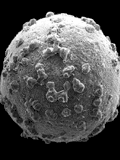 Abstract: Eight macrofacies types (5) plus subtypes (3) were identified while measuring sections along the Mussafah channel profile. These include: Abstract: Eight macrofacies types (5) plus subtypes (3) were identified while measuring sections along the Mussafah channel profile. These include:
• aeolian sands,
• microbial mat and microbial-laminated sediments,
• gypsum and enterolithic anhydrite, i.e., a diagenetic variation of the previous facies,
• muds with small pelecypods, and • its seagrass meadow version,
• Potamid sands, and • its cemented version, i.e., the Potamid beach-rock,
• washover fan coquina.
A complete set of analyses, including granulometry, mineral composition, clay composition, TOC, and identification of the allochems and the microfossils, was performed on this material. The facies and their genetic setting, i.e., the sequence of facies, provide a perspective on both the environmental and stratigraphical significance of their distribution, both lateral and vertical, and an example of the application of the Walther's law. The lower microbial mat is the mark of a transgression whereas the upper microbial mat is the mark of a forced regression. In conclusion, the sequence of facies allows identification of the last Holocene transgressive-regressive cycle that includes a forced regression, which probably dates back to 6,000 years BP.
|
|
Biostratigraphy and paleoenvironmental reconstruction of the marine lower Miocene Chechiș Formation in the Transylvanian Basin based on foraminiferal assemblages
Szabolcs-Flavius SZÉKELY, Raluca BINDIU-HAITONIC, Sorin FILIPESCU & Răzvan BERCEA
| HTML  | PDF
| PDF  [3,045 KB]
| DOI: 10.4267/2042/62041 [3,045 KB]
| DOI: 10.4267/2042/62041
|
|
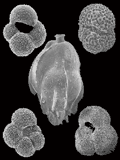 Abstract: Planktonic and benthic foraminiferal assemblages were used for biostratigraphy
and paleoenvironmental reconstruction of the marine lower Miocene Chechiș
Formation from the Gălpâia section (Sălaj county, Romania) in the
northwestern Transylvanian Basin. Planktonic foraminifera suggest an
Eggenburgian (Burdigalian) age for the deposits studied and reveal episodes of
high primary productivity and mostly cool surface waters. Benthic foraminiferal assemblages indicate paleoenvironmental deepening from outer
shelf to upper bathyal settings. Deltaic influences may be observed at the
base of the studied section in outer shelf (possibly upper bathyal)
environments with oxygenated bottom water and episodic high primary
productivity, as a consequence of nutrient input from the land. Changes in
paleobathymetry resulted in reduction of primary productivity. The benthic
assemblages from the uppermost part of the section are dominated by tubular
agglutinated foraminifera and indicate an upper bathyal setting with low
organic flux to the sea floor. The sediments of the studied section were
deposited during the late stage of the first early Miocene relative sea-level
rise in the Transylvanian Basin. Abstract: Planktonic and benthic foraminiferal assemblages were used for biostratigraphy
and paleoenvironmental reconstruction of the marine lower Miocene Chechiș
Formation from the Gălpâia section (Sălaj county, Romania) in the
northwestern Transylvanian Basin. Planktonic foraminifera suggest an
Eggenburgian (Burdigalian) age for the deposits studied and reveal episodes of
high primary productivity and mostly cool surface waters. Benthic foraminiferal assemblages indicate paleoenvironmental deepening from outer
shelf to upper bathyal settings. Deltaic influences may be observed at the
base of the studied section in outer shelf (possibly upper bathyal)
environments with oxygenated bottom water and episodic high primary
productivity, as a consequence of nutrient input from the land. Changes in
paleobathymetry resulted in reduction of primary productivity. The benthic
assemblages from the uppermost part of the section are dominated by tubular
agglutinated foraminifera and indicate an upper bathyal setting with low
organic flux to the sea floor. The sediments of the studied section were
deposited during the late stage of the first early Miocene relative sea-level
rise in the Transylvanian Basin.
|
|
Carnets Geol., vol. 17, no. 2, p. 11-37
Online since March 24, 2017
|
|
Review of the early Albian ammonites of the Montmell Formation near Marmellar (Salou-Garraf Basin, Tarragona, Catalonia, Spain)
Josep A. MORENO-BEDMAR, Emmanuel ROBERT, Rafel MATAMALES-ANDREU & Telm BOVER-ARNAL
| HTML  | PDF
| PDF  [1,482 KB]
| DOI: 10.4267/2042/62038 [1,482 KB]
| DOI: 10.4267/2042/62038
|
|
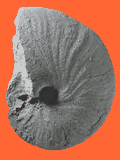 Abstract: In this work, we review the ammonites of the Montmell Formation in the Marmellar
area
housed in the collections of the Museo Geológico del Seminario de Barcelona and
the Museu de Geologia de Barcelona. This taxonomic update allows the proper
biostratigraphic analysis of the ammonite assemblage and assigns it to the early
Albian, Leymeriella tardefurcata Zone. The taxonomic analysis of all the
studied material allows us to recognize the presence of the following taxa: Uhligella
sp., Parengonoceras bassei, Hypacanthoplites
plesiotypicus, Hypacanthoplites
milletianus, Hypacanthoplites
subelegans, and Hypacanthoplites
sp. The current work is a step forward in the chronostratigraphic knowledge of
the Salou-Garraf Basin in the Catalan Coastal Ranges. Abstract: In this work, we review the ammonites of the Montmell Formation in the Marmellar
area
housed in the collections of the Museo Geológico del Seminario de Barcelona and
the Museu de Geologia de Barcelona. This taxonomic update allows the proper
biostratigraphic analysis of the ammonite assemblage and assigns it to the early
Albian, Leymeriella tardefurcata Zone. The taxonomic analysis of all the
studied material allows us to recognize the presence of the following taxa: Uhligella
sp., Parengonoceras bassei, Hypacanthoplites
plesiotypicus, Hypacanthoplites
milletianus, Hypacanthoplites
subelegans, and Hypacanthoplites
sp. The current work is a step forward in the chronostratigraphic knowledge of
the Salou-Garraf Basin in the Catalan Coastal Ranges.
|
|
Carnets Geol., vol. 17, no. 1, p. 1-10
Online since March 24, 2017
|

|
|
2016 (vol. 16)
|
|
New record of endolithic algae syn-vivo associated with an Early Cretaceous coral
Bogusław KOŁODZIEJ, Vyara IDAKIEVA, Marin IVANOV & Klaudiusz SALAMON
| HTML  | PDF
| PDF  [1,911 KB]
| DOI:
10.4267/2042/61885 [1,911 KB]
| DOI:
10.4267/2042/61885
|
|
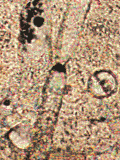 Abstract: Euendolithic microorganisms (boring endoliths) syn-vivo
associated with modern corals are commonly reported, but their fossil record is
extremely rare. This paper reports the new finding recognized in the colonial
scleractinian coral Clausastrea saltensis from
the Upper Barremian of Bulgaria. Large microborings (up to 50 µm, most ca. 15-25
µm in diameter) filled with calcite cement are distributed medially along coral
septa of some corallites. Borings were produced by microeuendoliths
growing from the skeleton interior outward during the
life of the coral host. They are compared to traces produced by
the recent oligophotic filamentous chlorophyte Ostreobium, which is known to be the most common skeleton-dwelling
alga in modern living corals and regarded as neutral or beneficial to the coral. In terms of general morphology, diameter and
distribution pattern, the borings are similar to those recently recognized in
the Early Cretaceous microsolenid coral. Abstract: Euendolithic microorganisms (boring endoliths) syn-vivo
associated with modern corals are commonly reported, but their fossil record is
extremely rare. This paper reports the new finding recognized in the colonial
scleractinian coral Clausastrea saltensis from
the Upper Barremian of Bulgaria. Large microborings (up to 50 µm, most ca. 15-25
µm in diameter) filled with calcite cement are distributed medially along coral
septa of some corallites. Borings were produced by microeuendoliths
growing from the skeleton interior outward during the
life of the coral host. They are compared to traces produced by
the recent oligophotic filamentous chlorophyte Ostreobium, which is known to be the most common skeleton-dwelling
alga in modern living corals and regarded as neutral or beneficial to the coral. In terms of general morphology, diameter and
distribution pattern, the borings are similar to those recently recognized in
the Early Cretaceous microsolenid coral.
|
|
Carnets Geol., vol. 16, no. 27, p. 633-640
Online since December 31, 2016
|
|
Early Cretaceous Toxasterid Echinoid Heteraster from the high Zagros basin, south of Iran
Mazaher YAVARI, Mehdi YAZDI, Hormoz GAHALAVAND, Hossein KAMYABI SHADAN, Mohammad Hossein ADABI & Loïc VILLIER
| HTML  | PDF
| PDF  [8,137 KB]
| DOI:
10.4267/2042/61883 [8,137 KB]
| DOI:
10.4267/2042/61883
|
|
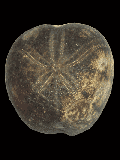 Abstract: Two species of
spatangoid echinoid belonging to Heteraster
Orbigny, 1853, are described from Lower Cretaceous deposits (Gadvan and
Dariyan formations) at the Kuh-e Gadvan and Banesh sections situated in Zagros
Mountains, south of Iran. Heteraster
couloni (Agassiz, 1839) is confirmed in the Barremian and Heteraster
delgadoi (Loriol, 1884) in the late Aptian-Albian of Iran. The
occurrences of Heteraster and other
spatangoid echinoids in Iran show a clear distinction between assemblages from
the southern and northern margins of the Tethys during the Early Cretaceous. Abstract: Two species of
spatangoid echinoid belonging to Heteraster
Orbigny, 1853, are described from Lower Cretaceous deposits (Gadvan and
Dariyan formations) at the Kuh-e Gadvan and Banesh sections situated in Zagros
Mountains, south of Iran. Heteraster
couloni (Agassiz, 1839) is confirmed in the Barremian and Heteraster
delgadoi (Loriol, 1884) in the late Aptian-Albian of Iran. The
occurrences of Heteraster and other
spatangoid echinoids in Iran show a clear distinction between assemblages from
the southern and northern margins of the Tethys during the Early Cretaceous.
|
|
Carnets Geol., vol. 16, no. 26, p. 615-632
Online since December 31, 2016
|
|
Albian and Cenomanian ammonites of the Eastern margin of the Lut block (East Iran)
Javad SHARIFI, Seyed Naser RAISOSSADAT, Maryam MORTAZAVI MEHRIZI & Maryam MOTAMEDALSHARIATI
| HTML  | PDF
| PDF  [1,301 KB]
| DOI:
10.4267/2042/61850 [1,301 KB]
| DOI:
10.4267/2042/61850
|
|
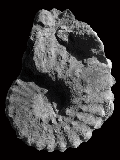 Abstract: Upper Albian and Lower Cenomanian ammonites occur on the eastern margin of the
Lut block in eastern Iran. The ammonite assemblages described herein are from
the Nimbolook and Kerch sections located west of Qayen. The following taxa are
described: Mantelliceras mantelli (J. Sowerby, 1814), Mantelliceras
saxbii (Sharpe, 1857), Mantelliceras sp. 1, Mantelliceras
sp. 2, Mantelliceras sp. 3, Sharpeiceras laticlavium (Sharpe,
1855), Sharpeiceras schlueteri (Hyatt, 1903), Puzosia (Puzosia)
mayoriana (Orbigny, 1841), Hyphoplites costosus C.W. Wright
& E.V. Wright, 1949, Mortoniceras (Mortoniceras)
cf. fallax (Breistroffer, 1940), Mantelliceras cf.
mantelli (J. Sowerby, 1814), Calycoceras (Gentoniceras)
aff. gentoni (Brongniart, 1822), Idiohamites
fremonti (Marcou, 1858), Mariella (Mariella)
sp., Mariella (Mariella)
dorsetensis (Spath, 1926), and Turrilites costatus Lamarck,
1801. The ammonite assemblages clearly indicate a late Albian-middle Cenomanian
age for the Nimbolook section and late Albian-early Cenomanian age for the Kerch
section. Abstract: Upper Albian and Lower Cenomanian ammonites occur on the eastern margin of the
Lut block in eastern Iran. The ammonite assemblages described herein are from
the Nimbolook and Kerch sections located west of Qayen. The following taxa are
described: Mantelliceras mantelli (J. Sowerby, 1814), Mantelliceras
saxbii (Sharpe, 1857), Mantelliceras sp. 1, Mantelliceras
sp. 2, Mantelliceras sp. 3, Sharpeiceras laticlavium (Sharpe,
1855), Sharpeiceras schlueteri (Hyatt, 1903), Puzosia (Puzosia)
mayoriana (Orbigny, 1841), Hyphoplites costosus C.W. Wright
& E.V. Wright, 1949, Mortoniceras (Mortoniceras)
cf. fallax (Breistroffer, 1940), Mantelliceras cf.
mantelli (J. Sowerby, 1814), Calycoceras (Gentoniceras)
aff. gentoni (Brongniart, 1822), Idiohamites
fremonti (Marcou, 1858), Mariella (Mariella)
sp., Mariella (Mariella)
dorsetensis (Spath, 1926), and Turrilites costatus Lamarck,
1801. The ammonite assemblages clearly indicate a late Albian-middle Cenomanian
age for the Nimbolook section and late Albian-early Cenomanian age for the Kerch
section.
|
|
Carnets Geol., vol. 16, no. 25, p. 591-613
Online since December 12, 2016
|
|
Upper Cretaceous non-marine ostracods from the southern High Plateaus, eastern Morocco
Bernard ANDREU, Hamid HADDOUMI & André CHARRIÈRE
| HTML  | PDF
| PDF  [3,505 KB]
| DOI:
10.4267/2042/61848 [3,505 KB]
| DOI:
10.4267/2042/61848
|
|
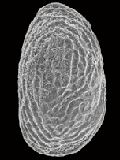 Abstract: The marls of the upper part of the Tigri Formation in the Upper
Cretaceous of the southern High Plateaus, eastern Morocco, reveal non-marine
ostracod faunas from freshwater to oligohaline environments. Despite the poor
specimen preservation, 23 species belonging to 14 genera have been recognized.
The generic assemblages show a global paleobiogeographic distribution both on
Laurasia and Gondwana. Abstract: The marls of the upper part of the Tigri Formation in the Upper
Cretaceous of the southern High Plateaus, eastern Morocco, reveal non-marine
ostracod faunas from freshwater to oligohaline environments. Despite the poor
specimen preservation, 23 species belonging to 14 genera have been recognized.
The generic assemblages show a global paleobiogeographic distribution both on
Laurasia and Gondwana.
|
|
Carnets Geol., vol. 16, no. 24, p. 569-590
Online since December 12, 2016
|
|
Evolution of Miocene siliciclastic deposits in central Tunisia: Case study of the Khechem El Artsouma section
Hanene BELGHITHI, Frédéric BOULVAIN, Chokri YAICH & Anne-Christine DA SILVA
| HTML  | PDF
| PDF  [1,255 KB]
| DOI:
10.4267/2042/61846 [1,255 KB]
| DOI:
10.4267/2042/61846
|
|
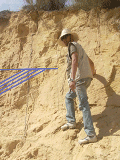 Abstract: After a NE-SW folding phase (Atlasic direction) during the Miocene, siliciclastic sediments from a deltaic environment were deposited in the south-western part of Tunisia while an internal offshore platform formed in the north-eastern part of the country. In this paper we focus on the Khechem El Artsouma Miocene section which is representative of central Tunisia deposits. This area is particularly interesting to study, because it corresponds to a transition zone between deltaic and shallow marine deposits. Facies analysis, magnetic susceptibility measurements and carbonate content measurements are combined to propose a reconstruction of the paleoenvironments and their evolution through the Miocene. Eight facies are identified, from fluviatile, swamp and evaporitic lagoon environments to shore environments. The deposits of the Ain Grab Formation (Langhian) are interpreted as transgressive, followed by the Beglia Formation (Serravalian), which are interpreted as regressive. The whole Saouaf formation (Upper Serravalian - Lower Tortonian) corresponds to a transgressive and regressive sequence. The Djebel Khechem El Artsouma section permits the proposal of a complete sedimentary model for the Miocene deposits from this central Tunisia transition zone. Abstract: After a NE-SW folding phase (Atlasic direction) during the Miocene, siliciclastic sediments from a deltaic environment were deposited in the south-western part of Tunisia while an internal offshore platform formed in the north-eastern part of the country. In this paper we focus on the Khechem El Artsouma Miocene section which is representative of central Tunisia deposits. This area is particularly interesting to study, because it corresponds to a transition zone between deltaic and shallow marine deposits. Facies analysis, magnetic susceptibility measurements and carbonate content measurements are combined to propose a reconstruction of the paleoenvironments and their evolution through the Miocene. Eight facies are identified, from fluviatile, swamp and evaporitic lagoon environments to shore environments. The deposits of the Ain Grab Formation (Langhian) are interpreted as transgressive, followed by the Beglia Formation (Serravalian), which are interpreted as regressive. The whole Saouaf formation (Upper Serravalian - Lower Tortonian) corresponds to a transgressive and regressive sequence. The Djebel Khechem El Artsouma section permits the proposal of a complete sedimentary model for the Miocene deposits from this central Tunisia transition zone.
|
|
Carnets Geol., vol. 16, no. 23, p. 557-568
Online since December 12, 2016
|
|
On the type species of Lingularia, and description of Eolingularia n. gen.
Maria Aleksandra BITNER & Christian C. EMIG
| HTML  | PDF
| PDF  [1,301 KB]
| DOI:
10.4267/2042/56006 [1,301 KB]
| DOI:
10.4267/2042/56006
|
|
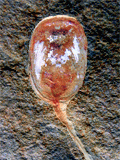 Abstract: The material under study has previously been identified as Lingula krausei, collected from glacial erratics at Cape Rozewie, Poland. All specimens come from glauconitic sandstone of Cenomanian age. Dames
(1874) identified his Lingula sp. as L. krausei which differs in shell outline from Lingula truncata. This species, dedicated to A. Krause, together with L. subovalis, is considered characteristic of the Cenomanian. Several new species and genera have recently been described or redescribed and compared to our specimens, here identified as Lingularia similis. By priority (ICZN,
1999), the type species L. similis is currently synonymized with Lingula krausei. A new genus Eolingularia, within the
Family Lingulidae, is here described, with Lingularia siberica Biernat et Emig,
1993, as type species. This new genus ranges from the Carboniferous to the Triassic in Russia, China, and Spain. Possible synonymies are discussed. Abstract: The material under study has previously been identified as Lingula krausei, collected from glacial erratics at Cape Rozewie, Poland. All specimens come from glauconitic sandstone of Cenomanian age. Dames
(1874) identified his Lingula sp. as L. krausei which differs in shell outline from Lingula truncata. This species, dedicated to A. Krause, together with L. subovalis, is considered characteristic of the Cenomanian. Several new species and genera have recently been described or redescribed and compared to our specimens, here identified as Lingularia similis. By priority (ICZN,
1999), the type species L. similis is currently synonymized with Lingula krausei. A new genus Eolingularia, within the
Family Lingulidae, is here described, with Lingularia siberica Biernat et Emig,
1993, as type species. This new genus ranges from the Carboniferous to the Triassic in Russia, China, and Spain. Possible synonymies are discussed.
|
|
Carnets Geol., vol. 16, no. 22, p. 543-555
Online since December 12, 2016
|
|
Albian rudist biostratigraphy
(Bivalvia), Comanche shelf to shelf margin, Texas
Robert W. SCOTT, Whitney CAMPBELL, Rachel HOJNACKI, Yulin WANG & Xin LAI
| HTML  | PDF
| PDF  [4,372 KB]
| DOI:
10.4267/2042/61701 [4,372 KB]
| DOI:
10.4267/2042/61701
|
|
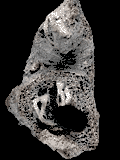 Abstract: Rudists were widespread and locally abundant carbonate producers on the Early
Cretaceous Comanche Shelf from Florida to Texas, and on Mexican atolls. As
members of the Caribbean Biogeographic Province, their early ancestors emigrated
from the Mediterranean Province and subsequently evolved independently.
Comanchean rudists formed biostromes and bioherms on the shelf interior and at
the shelf margin. Carbonate stratigraphic units of the Comanche Shelf record
rudist evolution during the Barremian through the Albian ages and an established
zonal scheme is expanded. Abstract: Rudists were widespread and locally abundant carbonate producers on the Early
Cretaceous Comanche Shelf from Florida to Texas, and on Mexican atolls. As
members of the Caribbean Biogeographic Province, their early ancestors emigrated
from the Mediterranean Province and subsequently evolved independently.
Comanchean rudists formed biostromes and bioherms on the shelf interior and at
the shelf margin. Carbonate stratigraphic units of the Comanche Shelf record
rudist evolution during the Barremian through the Albian ages and an established
zonal scheme is expanded.
This study documents new Albian rudist occurrences from the Middle-Upper Albian
Fredericksburg and Washita groups in Central and West Texas. Rudists in cores at
and directly behind the shelf margin southeast of Austin and San Antonio, Texas,
complement the rudist zonation that is integrated with ammonites and
foraminifers. These new rudist data test long-held correlations of the Edwards
Group with both the Fredericksburg and Washita groups based solely on
lithologies. Rudist and foraminifer biostratigraphy indicate that the Edwards
Group is coeval with the Fredericksburg not the Washita Group.
In West Texas sections Caprinuloidea romeri
occurs at the top of the Fredericksburg Group in the Fort Terrett Formation
approximately 3 meters below the iron-stained hardground subaerial exposure
surface. It is overlain by the Washita Group with the ammonite Eopachydiscus
marcianus Zone. Caprinuloidea romeri
is also documented from the type cored section of the Person Formation in the
upper part of the Edwards Group. These species allow a precise correlation of
the subsurface Person Formation in Central Texas with the Ft. Terrett Formation
cropping out in West Texas. This evidence together with foraminifer and ammonite
zones demonstrates that the Person Formation is coeval with Fredericksburg units
underlying the basal Washita sequence boundary Al Sb Wa1. The upper Albian
Washita Group Kimbleia and Mexicaprina caprinid zones overly the Caprinuloidea Zone and the successive Washita mortonicerid ammonite zones.
|
|
Carnets Geol., vol. 16, no. 21, p. 513-541
Online since November 11, 2016
|
|
Jurassic-Cretaceous transition on the Getic carbonate platform (Southern Carpathians, Romania): Benthic foraminifera and algae
Cristian Victor MIRCESCU, George PLEŞ, Ioan I. BUCUR & Bruno GRANIER
| HTML  | PDF
| PDF  [4,910 KB]
| DOI:
10.4267/2042/61824 [4,910 KB]
| DOI:
10.4267/2042/61824
|
|
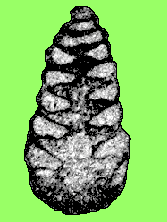 Abstract: The carbonate succession of the Piatra Craiului Massif, i.e., the eastern
part of the Getic carbonate platform (Southern Carpathians, Romania), comprises
reefal and peritidal limestones that contain a diverse microfossil assemblage
composed mainly of calcareous green algae and benthic foraminifera. The
biostratigraphically most significant benthic foraminifera found in the several
sections studied are described; some (Anchispirocyclina lusitanica, Neokilianina
rahonensis, Bramkampella arabica, Everticyclammina praekelleri)
are reported for the first time in this area. Hence, assemblages of both
foraminifera and calcareous algae characterize three biostratigraphic intervals
in the studied succession, the Kimmeridgian - lower Tithonian, the upper
Tithonian - lower Berriasian, and the upper Berriasian - ? lower Valanginian
intervals. The main microfacies types (bioclastic rudstone, coral-microbial
boundstone, bioclastic grainstone, interbedded mudstones and wackestones with
cyanobacteria nodules) as well as both the foraminifera and the calcareous algae
are paleoecological indicators that may contribute to the decipherment of the
depositional environments and to building a depositional model for the eastern
part of the Getic carbonate platform at the Late Jurassic-Early Cretaceous
transition. Abstract: The carbonate succession of the Piatra Craiului Massif, i.e., the eastern
part of the Getic carbonate platform (Southern Carpathians, Romania), comprises
reefal and peritidal limestones that contain a diverse microfossil assemblage
composed mainly of calcareous green algae and benthic foraminifera. The
biostratigraphically most significant benthic foraminifera found in the several
sections studied are described; some (Anchispirocyclina lusitanica, Neokilianina
rahonensis, Bramkampella arabica, Everticyclammina praekelleri)
are reported for the first time in this area. Hence, assemblages of both
foraminifera and calcareous algae characterize three biostratigraphic intervals
in the studied succession, the Kimmeridgian - lower Tithonian, the upper
Tithonian - lower Berriasian, and the upper Berriasian - ? lower Valanginian
intervals. The main microfacies types (bioclastic rudstone, coral-microbial
boundstone, bioclastic grainstone, interbedded mudstones and wackestones with
cyanobacteria nodules) as well as both the foraminifera and the calcareous algae
are paleoecological indicators that may contribute to the decipherment of the
depositional environments and to building a depositional model for the eastern
part of the Getic carbonate platform at the Late Jurassic-Early Cretaceous
transition.
|
|
Carnets Geol., vol. 16, no. 20, p. 491-512
Online since October 24, 2016
|
|
The Weberg and Warm
Spring Members of the Snowshoe Formation in Suplee area, Oregon: Lithofacies and
Aalenian-early Bajocian ammonoid zonation
David G. TAYLOR
| HTML  | PDF
| PDF  [2,653 KB]
| DOI:
10.4267/2042/61389 [2,653 KB]
| DOI:
10.4267/2042/61389
|
|
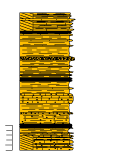 Abstract: This paper documents the stratigraphic information
upon which an ammonoid zonation from the lower part of the Snowshoe Formation in
the Suplee area was originally established (Taylor, 1988). Ammonoid ranges from 22 measured stratigraphic sections reveal about 60
ammonoid species distributed among eight zones encompassing the late Aalenian
and part of the early Bajocian stages. The
sediments are dominantly volcaniclastic and, as a result, there are numerous
tuff beds in the succession. As noted in Taylor (1982) the principal tuff
beds (herein designated as units A through F) can be used jointly with the
ammonite sequence to give precise correlations from section to section.
Utilizing the ammonoids, tuff beds, and facies in combination gives a graphic
representation of the westward transgression of the Snowshoe Formation as it
enveloped an irregular topography, and lapped onto the topographically high
Grindstone High to the west. The
ammonoid zonation is significant in that it gives a standard of reference for
the biochronology of the late Aalenian and early Bajocian ammonoids in the North
American Western Cordillera. Abstract: This paper documents the stratigraphic information
upon which an ammonoid zonation from the lower part of the Snowshoe Formation in
the Suplee area was originally established (Taylor, 1988). Ammonoid ranges from 22 measured stratigraphic sections reveal about 60
ammonoid species distributed among eight zones encompassing the late Aalenian
and part of the early Bajocian stages. The
sediments are dominantly volcaniclastic and, as a result, there are numerous
tuff beds in the succession. As noted in Taylor (1982) the principal tuff
beds (herein designated as units A through F) can be used jointly with the
ammonite sequence to give precise correlations from section to section.
Utilizing the ammonoids, tuff beds, and facies in combination gives a graphic
representation of the westward transgression of the Snowshoe Formation as it
enveloped an irregular topography, and lapped onto the topographically high
Grindstone High to the west. The
ammonoid zonation is significant in that it gives a standard of reference for
the biochronology of the late Aalenian and early Bajocian ammonoids in the North
American Western Cordillera.
|
|
Carnets Geol., vol. 16, no. 19, p. 449-490
Online since September 12, 2016
|
|
Plio-Pleistocene Ostracods from sedimentary sections along the
eastern edge of Cape Bon (Wadi Lebna section, Eastern Tunisia)
Rim TEMANI, Driss NACHITE, Francesco SCIUTO, Saloua RAZGALLAH, Ratiba BEKKALI, Khayati HAYET & Nadia GAALOUL
| HTML  | PDF
| PDF  [3,155 KB]
| DOI:
10.4267/2042/61387 [3,155 KB]
| DOI:
10.4267/2042/61387
|
|
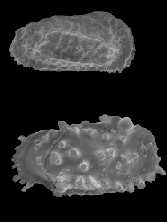 Abstract: This paper presents for the first time a detailed study
of ostracods in the Upper Pliocene-Lower Pleistocene deposits of Wadi Lebna
(Cape Bon eastern edge, northeastern Tunisia). The quantitative and qualitative
analyses document the evolution of this area from a marine environment dominated
by relatively deep or circalittoral species at the base of the succession,
passing progressively up into shallower environments, and at the top
infralittoral coastal environments. Particularly important from the ecological
point of view is the presence
in some samples of Bythocythere turgida. This species indicates
deposition of these sediments during the cold phases of the Early Pleistocene. Abstract: This paper presents for the first time a detailed study
of ostracods in the Upper Pliocene-Lower Pleistocene deposits of Wadi Lebna
(Cape Bon eastern edge, northeastern Tunisia). The quantitative and qualitative
analyses document the evolution of this area from a marine environment dominated
by relatively deep or circalittoral species at the base of the succession,
passing progressively up into shallower environments, and at the top
infralittoral coastal environments. Particularly important from the ecological
point of view is the presence
in some samples of Bythocythere turgida. This species indicates
deposition of these sediments during the cold phases of the Early Pleistocene.
|
|
Carnets Geol., vol. 16, no. 18, p. 431-447
Online since September 12, 2016
|
|
Comments on "Estimating the impact of early diagenesis on isotope records in shallow-marine carbonates: A case study from the Urgonian platform in western Swiss Jura" by A. Godet
et al. [Palaeogeography Palaeoclimatology Palaeoecology 454 (2016) 125-138]
Bruno GRANIER, Bernard CLAVEL & Jean CHAROLLAIS
| HTML  | PDF
| PDF  [806 KB]
| DOI:
10.4267/2042/61385 [806 KB]
| DOI:
10.4267/2042/61385
|
|
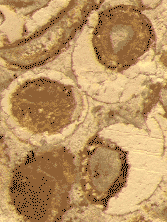 Abstract: A recent paper by Godet
et al. on Urgonian carbonates from
the Swiss Jura concluded that diagenesis may hinder chemostratigraphic
correlations of deep- to shallow-water facies. Although we agree with this
conclusion we question their arguments and interpretations. These authors
correctly identified diagenesis as the key factor, but we question the timing
of events in their paragenetic sequence. In particular, they reported the
leaching of originally calcitic oolitic cortices but failed to discuss this
puzzling feature properly. In addition, the backbone of their argument is the
stratigraphic correlation of a specific sequence from three dominantly
shallow-water sections together with a basinal reference section. However, a
reliable alternative biostratigraphic framework shows that this attempt of
long-distance correlation might be erroneous. Abstract: A recent paper by Godet
et al. on Urgonian carbonates from
the Swiss Jura concluded that diagenesis may hinder chemostratigraphic
correlations of deep- to shallow-water facies. Although we agree with this
conclusion we question their arguments and interpretations. These authors
correctly identified diagenesis as the key factor, but we question the timing
of events in their paragenetic sequence. In particular, they reported the
leaching of originally calcitic oolitic cortices but failed to discuss this
puzzling feature properly. In addition, the backbone of their argument is the
stratigraphic correlation of a specific sequence from three dominantly
shallow-water sections together with a basinal reference section. However, a
reliable alternative biostratigraphic framework shows that this attempt of
long-distance correlation might be erroneous.
|
|
Carnets Geol., vol. 16, no. 17, p. 417-429
Online since August 5, 2016
|
|
Taxonomy and distribution of the Cretaceous coral genus Eosiderastrea
Hannes LÖSER
| HTML  | PDF
| PDF  [6,545 KB]
| DOI:
10.4267/2042/60677 [6,545 KB]
| DOI:
10.4267/2042/60677
|
|
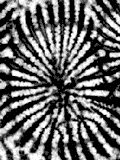 Abstract: The
new genus Eosiderastrea Löser, 2016, was established for
Cretaceous corals formerly assigned to the extant coral genus Diploastrea.
It represents the oldest member of the Family Siderastraeidae. The genus is
characterised by an astreoid arrangement, occasionally although some have a
plocoid or a cerioid calicular arrangement, and a sub-regular hexameral,
heptameral, octameral or decameral septal symmetry. The septal blades are made
of medium-sized trabeculae. Synapticulae are present. Almost a hundred
specimens were examined, among them numerous type specimens. In total, 26
Cretaceous species were separated. Fifteen species were assigned to formally
established species, three species were compared to one of these species, two
species were described as new and the remaining six species were reported in
open nomenclature. The genus occurs in the Cretaceous worldwide and ranges from
the late Valanginian to the Santonian. It shows its greatest diversity in the earliest
Aptian and early to middle Cenomanian. Abstract: The
new genus Eosiderastrea Löser, 2016, was established for
Cretaceous corals formerly assigned to the extant coral genus Diploastrea.
It represents the oldest member of the Family Siderastraeidae. The genus is
characterised by an astreoid arrangement, occasionally although some have a
plocoid or a cerioid calicular arrangement, and a sub-regular hexameral,
heptameral, octameral or decameral septal symmetry. The septal blades are made
of medium-sized trabeculae. Synapticulae are present. Almost a hundred
specimens were examined, among them numerous type specimens. In total, 26
Cretaceous species were separated. Fifteen species were assigned to formally
established species, three species were compared to one of these species, two
species were described as new and the remaining six species were reported in
open nomenclature. The genus occurs in the Cretaceous worldwide and ranges from
the late Valanginian to the Santonian. It shows its greatest diversity in the earliest
Aptian and early to middle Cenomanian.
|
|
Carnets Geol., vol. 16, no. 16, p. 383-416
Online since July 7, 2016
|
|
Ivaldiceras, a new genus of heteromorphic ammonites from the Lower Aptian of southeast France
Gérard DELANOY, Cyril BAUDOUIN, Marc BOSELLI & Emmanuel PENAGÉ
| HTML  | PDF
| PDF  [2,479 KB]
| DOI:
10.4267/2042/60676 [2,479 KB]
| DOI:
10.4267/2042/60676
|
|
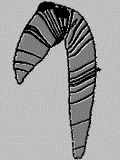 Abstract: New investigations in
the Vocontian Lower Aptian deposits resulted in the discovery of
very rare specimens of heteromorphic ammonites whose specific morphological
and ornamental features have led to the erection of Ivaldiceras
gen. nov. Represented
by a very limited number of
specimens this new genus consists
of two species: I. baratteroi gen. & sp. nov. and I. divajeuensis
gen. & sp. nov. The suprageneric
position of the new genus is
difficult to determine because of the poor preservation of its sutural elements and the
incomplete state of
the specimens. The genus is tentatively assigned to the Family Macroscaphitidae Hyatt,
1900, pending the study of better preserved material. Abstract: New investigations in
the Vocontian Lower Aptian deposits resulted in the discovery of
very rare specimens of heteromorphic ammonites whose specific morphological
and ornamental features have led to the erection of Ivaldiceras
gen. nov. Represented
by a very limited number of
specimens this new genus consists
of two species: I. baratteroi gen. & sp. nov. and I. divajeuensis
gen. & sp. nov. The suprageneric
position of the new genus is
difficult to determine because of the poor preservation of its sutural elements and the
incomplete state of
the specimens. The genus is tentatively assigned to the Family Macroscaphitidae Hyatt,
1900, pending the study of better preserved material.
|
|
Carnets Geol., vol. 16, no. 15, p. 369-381
Online since July 7, 2016
|
|
Aptian ammonites from Mazapil, Zacatecas State (north-central Mexico) studied by Burckhardt in 1906: A revision
Ricardo BARRAGÁN, Josep Anton MORENO-BEDMAR & Celestina GONZÁLEZ-ARREOLA
| HTML  | PDF
| PDF  [2,306 KB]
| DOI:
10.4267/2042/60667 [2,306 KB]
| DOI:
10.4267/2042/60667
|
|
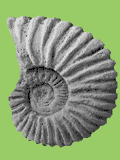 Abstract: Twelve
specimens of Aptian ammonites reported and drawn by Burckhardt in 1906,
from the Mazapil area (Zacatecas State, north-central Mexico), are reviewed for
taxonomical purposes. The work by Burckhardt was the first report
of Aptian ammonoids in Mexico. In addition, it represents the only record of
Aptian ammonites known from Zacatecas State. The taxonomic review of the
specimens allows for the recognition of Dufrenoyia
sp., Colombiceras spathi Humphrey,
Colombiceras mexicanus (Humphrey)
n. comb., Colombiceras sp., Colombiceras
spp., and Acanthohoplites aff. bigoureti
(Seunes). This ammonite assemblage is indicative of a stratigraphic
range that spans the uppermost lower Aptian to the upper Aptian interval. Abstract: Twelve
specimens of Aptian ammonites reported and drawn by Burckhardt in 1906,
from the Mazapil area (Zacatecas State, north-central Mexico), are reviewed for
taxonomical purposes. The work by Burckhardt was the first report
of Aptian ammonoids in Mexico. In addition, it represents the only record of
Aptian ammonites known from Zacatecas State. The taxonomic review of the
specimens allows for the recognition of Dufrenoyia
sp., Colombiceras spathi Humphrey,
Colombiceras mexicanus (Humphrey)
n. comb., Colombiceras sp., Colombiceras
spp., and Acanthohoplites aff. bigoureti
(Seunes). This ammonite assemblage is indicative of a stratigraphic
range that spans the uppermost lower Aptian to the upper Aptian interval.
|
|
Carnets Geol., vol. 16, no. 14, p. 355-367
Online since June 23, 2016
|
|
Possible vertebrate coprolites from the Upper Cretaceous (Coniacian) of the Sudetes Mountains (southern Poland)
Tomasz BRACHANIEC & Anna WIECZOREK
| HTML  | PDF
| PDF  [559 KB]
| DOI:
10.4267/2042/60665 [559 KB]
| DOI:
10.4267/2042/60665
|
|
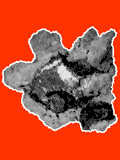 Abstract: Possible
coprolites from the Upper Cretaceous (Coniacian) of Waliszów Stary in the Sudetes
Mountains (southern Poland) are described for the first time. They are
relatively small, irregular in outline, and preserved as goethite, limonite,
siderite and hematite. Although it is difficult to identify the producer of
these coprolites, they were most probably formed by some fish. Abstract: Possible
coprolites from the Upper Cretaceous (Coniacian) of Waliszów Stary in the Sudetes
Mountains (southern Poland) are described for the first time. They are
relatively small, irregular in outline, and preserved as goethite, limonite,
siderite and hematite. Although it is difficult to identify the producer of
these coprolites, they were most probably formed by some fish.
|
|
Carnets Geol., vol. 16, no. 13, p. 349-354
Online since June 23, 2016
|
|
Late Albian cactus in shallow carbonate shelf, West Texas
Robert W. SCOTT, Zexuan WANG, Xin LAI & Yulun WANG
| HTML  | PDF
| PDF  [665 KB]
| DOI:
10.4267/2042/60122 [665 KB]
| DOI:
10.4267/2042/60122
|
|
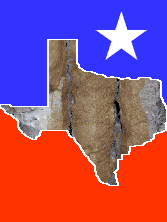 Abstract: Well-preserved vertical molds of a stalk-like fossil are in growth position in
the upper part of the Upper Albian Fort Lancaster Formation exposed in West
Texas. The Fort Lancaster Formation is the uppermost Albian carbonate unit
deposited on the shallow water Barremian-early Cenomanian Comanche shelf. The
Fort Lancaster represents one long-term transgressive-regressive cycle capped by
a regional unconformity overlain by lower Cenomanian deeper water Del Rio Shale. Abstract: Well-preserved vertical molds of a stalk-like fossil are in growth position in
the upper part of the Upper Albian Fort Lancaster Formation exposed in West
Texas. The Fort Lancaster Formation is the uppermost Albian carbonate unit
deposited on the shallow water Barremian-early Cenomanian Comanche shelf. The
Fort Lancaster represents one long-term transgressive-regressive cycle capped by
a regional unconformity overlain by lower Cenomanian deeper water Del Rio Shale.
The erect stalk-like molds are up to 1 m tall and about 6 cm in diameter. The
mold walls are composed of six pairs of angular ridges and grooves evenly spaced
at an angle of 60° to each other. The ridge crests are dotted by paired ringed
depressions with small central nodes; these negative impressions indicate the
presence of oval rings with small depressions inside of each ring. The diameter
of the stalk is the same at its base as at its top indicating that growth did
not expand the organism but extended it upward. These stalk-like organisms
appear to be rooted on disconformable bedding surfaces that were exposed to the
atmosphere. Carbon isotope data shows the classic negative shift below subaerial
contacts. Subsequently sea level rose and muddy carbonate sediment buried the
stalk. The absence of original wall material suggests that the wall was composed
of readily decayed or dissolved material such as organic matter or aragonite.
Stalk-like organisms of this size and shape are rare and potential types are
cacti, plant reeds, Porifera, or Scleractinian Cnidaria.
|
|
Carnets Geol., vol. 16, no. 12, p. 337-346
Online since May 19, 2016
|
|
The taxonomy of middle Miocene red algae from the Gârbova de Sus Formation (Transylvanian Basin, Romania)
Ramona CHELARU & Ioan I. BUCUR
| HTML  | PDF
| PDF  [3,439 KB]
| DOI:
10.4267/2042/60121 [3,439 KB]
| DOI:
10.4267/2042/60121
|
|
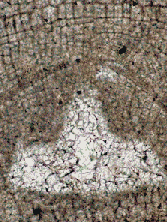 Abstract: This
study describes seventeen non-geniculate coralline algal species (orders Corallinales,
Hapalidiales and Sporolithales) from the middle Miocene (lower-middle Badenian)
red-algal limestones of the Transylvanian Basin, Gârbova
de Sus Formation. For the description and identification at species level, we
follow the common diagnostic features used for fossil species and some
characters that are used as diagnostic for modern species (roof morphology for
asexual conceptacles, the presence/absence of a layer of elongated cells below
sporangial compartments and number of cells in paraphyses for Sporolithon,
and measurements of gametangial and carposporangial conceptacles). Female
conceptacles of Spongites fruticulosus
Kützing are for the first time described in fossil material. We propose
the attribution of Lithophyllum
platticarpum Maslov to Spongites
fruticulosus Kützing as a gametangial thallus with male
conceptacles. Abstract: This
study describes seventeen non-geniculate coralline algal species (orders Corallinales,
Hapalidiales and Sporolithales) from the middle Miocene (lower-middle Badenian)
red-algal limestones of the Transylvanian Basin, Gârbova
de Sus Formation. For the description and identification at species level, we
follow the common diagnostic features used for fossil species and some
characters that are used as diagnostic for modern species (roof morphology for
asexual conceptacles, the presence/absence of a layer of elongated cells below
sporangial compartments and number of cells in paraphyses for Sporolithon,
and measurements of gametangial and carposporangial conceptacles). Female
conceptacles of Spongites fruticulosus
Kützing are for the first time described in fossil material. We propose
the attribution of Lithophyllum
platticarpum Maslov to Spongites
fruticulosus Kützing as a gametangial thallus with male
conceptacles.
|
|
Carnets Geol., vol. 16, no. 11, p. 307-336
Online since May 19, 2016
|
|
Environmental control on shell size of Middle Triassic bivalve Plagiostoma
Krzysztof R. BROM, Robert NIEDŹWIEDZKI, Tomasz BRACHANIEC, Bruno FERRÉ & Mariusz A. SALAMON
| HTML  | PDF
| PDF  [254 KB]
| DOI:
10.4267/2042/60118 [254 KB]
| DOI:
10.4267/2042/60118
|
|
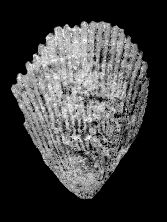 Abstract: Fossil shells of the marine bivalve Plagiostoma
striatum Schlotheim sampled from the Middle Triassic (so-called
Muschelkalk) of Poland demonstrate that, under unfavourable environmental
conditions, this species commonly occurring in Triassic German basins exhibits a
dwarfed shell. As a consequence of a marine regression episode resulting in a
significant increase of salinity and a partial emersion of seafloor these bivalves vanished. The next
transgressive pulse caused a re-emergence of these bivalves. They were initially
characterized by half-size shells than
in the population living prior to the regression episode and, subsequently,
during progressive transgression, their shells returned to
normal size. Coincidence between eustatic curve and changes in bivalve shell
size and their disappearance may be attributed also to biotic interactions, such
as a biotic collapse in primary bioproductivity or/and a competition for space
or any other resources due to shelf habitat loss during regressive periods. Abstract: Fossil shells of the marine bivalve Plagiostoma
striatum Schlotheim sampled from the Middle Triassic (so-called
Muschelkalk) of Poland demonstrate that, under unfavourable environmental
conditions, this species commonly occurring in Triassic German basins exhibits a
dwarfed shell. As a consequence of a marine regression episode resulting in a
significant increase of salinity and a partial emersion of seafloor these bivalves vanished. The next
transgressive pulse caused a re-emergence of these bivalves. They were initially
characterized by half-size shells than
in the population living prior to the regression episode and, subsequently,
during progressive transgression, their shells returned to
normal size. Coincidence between eustatic curve and changes in bivalve shell
size and their disappearance may be attributed also to biotic interactions, such
as a biotic collapse in primary bioproductivity or/and a competition for space
or any other resources due to shelf habitat loss during regressive periods.
|
|
Carnets Geol., vol. 16, no. 10, p. 297-305
Online since May 21, 2016
|
|
Lithostratigraphic, paleoenvironmental and sequential evolution of the Cenomanian-Lower Turonian in the Guir area (western Algeria)
Madani BENYOUCEF, Christian MEISTER, Kaddour MEBARKI, Émilie LÄNG, Mohammed ADACI, Lionel CAVIN, Fatima-Zohra MALTI, Djamila ZAOUI, Amine CHERIF & Mustapha BENSALAH
| HTML  | PDF
| PDF  [2,328 KB]
| DOI:
10.4267/2042/59926 [2,328 KB]
| DOI:
10.4267/2042/59926
|
|
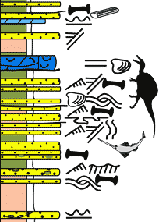 Abstract: The lithostratigraphy, paleoenvironment and sequence
stratigraphy of the Cretaceous succession outcropping at the southern foot of
the Saharan Atlas (south-western Algeria) are discussed in this work. Our current study focuses on the analysis of fifteen sections distributed
along to the northern and southern limits of the Guir Basin, between the
Ben-Zireg to the East and the Meridja-Boukais axis to the West. In this area,
three lithostratigraphic formations were identified and interpreted from an
environmental and a sequential points of view: 1 - The lower "Grès
rouges" Formation attributed to the Lower Cenomanian, is dominated by
fluvial or coastal detrital deposits; 2 - The middle "Marnes à gypse inférieures"
Formation assigned to the Lower-Middle Cenomanian is characterized by littoral
setting with some storm influences, especially towards the base; 3 - The upper
"Calcaires de Sidi Mohamed Ben Bouziane" Formation of upper
Cenomanian-early Turonian in age, is represents a laterally extensive, shallow
carbonate platform environment. The three formations constitute an overall
transgressive megasequence built of a number of transgressive-regressive minor
sequences. The opening of the deposits towards the North is confirmed by the
organization of the lithostratigraphic units and by the Tethyan
paleobiogeographic affinity of the echinoids and bivalves, and especially the
occurrence of Neolobites vibrayeanus ammonite. Abstract: The lithostratigraphy, paleoenvironment and sequence
stratigraphy of the Cretaceous succession outcropping at the southern foot of
the Saharan Atlas (south-western Algeria) are discussed in this work. Our current study focuses on the analysis of fifteen sections distributed
along to the northern and southern limits of the Guir Basin, between the
Ben-Zireg to the East and the Meridja-Boukais axis to the West. In this area,
three lithostratigraphic formations were identified and interpreted from an
environmental and a sequential points of view: 1 - The lower "Grès
rouges" Formation attributed to the Lower Cenomanian, is dominated by
fluvial or coastal detrital deposits; 2 - The middle "Marnes à gypse inférieures"
Formation assigned to the Lower-Middle Cenomanian is characterized by littoral
setting with some storm influences, especially towards the base; 3 - The upper
"Calcaires de Sidi Mohamed Ben Bouziane" Formation of upper
Cenomanian-early Turonian in age, is represents a laterally extensive, shallow
carbonate platform environment. The three formations constitute an overall
transgressive megasequence built of a number of transgressive-regressive minor
sequences. The opening of the deposits towards the North is confirmed by the
organization of the lithostratigraphic units and by the Tethyan
paleobiogeographic affinity of the echinoids and bivalves, and especially the
occurrence of Neolobites vibrayeanus ammonite.
|
|
Carnets Geol., vol. 16, no. 9, p. 271-296
Online since April 14, 2016
|
|
Some steps toward a new story for the Jurassic - Cretaceous transition in Mount Lebanon
Bruno GRANIER, Christopher TOLAND, Raymond GÈZE, Dany AZAR & Sibelle MAKSOUD
| HTML  | PDF
| PDF  [2,066 KB]
| DOI:
10.4267/2042/59924
[2,066 KB]
| DOI:
10.4267/2042/59924
|
|
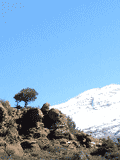 Abstract:
The stratigraphic framework of the Upper Jurassic and Lower Cretaceous strata of
Lebanon that dates back to Dubertret's publications required either
consolidation or full revision. The preliminary results of our investigations in
the Mount Lebanon region are presented here. We provide new micropaleontological
and sedimentological information on the Salima Oolitic Limestones, which is
probably an unconformity-bounded unit (possibly Early Valanginian in age), and
the "Grès du Liban" (Barremian in age). Our revised bio- and
holostratigraphic interpretations and the new age assignations lead us to
emphasize the importance of the two hiatuses in the sedimentary record below and
above the Salima, i.e., at the transition from the Jurassic to the
Cretaceous. Abstract:
The stratigraphic framework of the Upper Jurassic and Lower Cretaceous strata of
Lebanon that dates back to Dubertret's publications required either
consolidation or full revision. The preliminary results of our investigations in
the Mount Lebanon region are presented here. We provide new micropaleontological
and sedimentological information on the Salima Oolitic Limestones, which is
probably an unconformity-bounded unit (possibly Early Valanginian in age), and
the "Grès du Liban" (Barremian in age). Our revised bio- and
holostratigraphic interpretations and the new age assignations lead us to
emphasize the importance of the two hiatuses in the sedimentary record below and
above the Salima, i.e., at the transition from the Jurassic to the
Cretaceous.
|
|
Carnets Geol., vol. 16, no. 8, p. 247-269
Online since April 14, 2016
|
|
On the fossil alga Marinella lugeoni Pfender, 1939, nom. cons., and its seven unfortunate avatars. Revision of the Juliette Pfender Collection. Part 2. Revision of the Jesse Harlan Johnson Collection. Part 2
Bruno GRANIER & Dimas DIAS-BRITO
| HTML  | PDF
| PDF  [1,378 KB]
| DOI:
10.4267/2042/59922
[1,378 KB]
| DOI:
10.4267/2042/59922
|
|
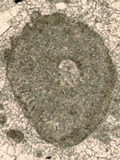 Abstract:
A review of eight lookalike fossil species led to their being synonymized. Although Marinella
lugeoni Pfender, 1939, is not the senior synonym, it is proposed to
ascribe it the status of a "nomen conservandum". The age of its
type-locality in Spain is Late Jurassic, not Early Jurassic. We also document
small Marinella lumps found in Albian-Cenomanian strata of Brazil. Abstract:
A review of eight lookalike fossil species led to their being synonymized. Although Marinella
lugeoni Pfender, 1939, is not the senior synonym, it is proposed to
ascribe it the status of a "nomen conservandum". The age of its
type-locality in Spain is Late Jurassic, not Early Jurassic. We also document
small Marinella lumps found in Albian-Cenomanian strata of Brazil.
|
|
Carnets Geol., vol. 16, no. 7, p. 231-245
Online since April 14, 2016
|
|
On the fossil alga Elianella elegans Pfender & Basse, 1948, and its so-called lookalikes, with description of Elianella brasiliana n.sp. Revision of the Juliette Pfender Collection. Part 1
Bruno GRANIER & Dimas DIAS-BRITO
| HTML  | PDF
| PDF  [2,885 KB]
| DOI:
10.4267/2042/59920 [2,885 KB]
| DOI:
10.4267/2042/59920
|
|
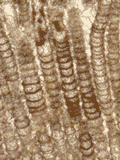 Abstract: According
to some authors, the three fossil algal forms discussed in this paper, Cordilites
cretosus (Reus, 1846), Elianella elegans Pfender & Basse,
1948, and Parachaetetes asvapatii Pia in Rao & Pia,
1936, are synonyms. However, we document that they represent three discrete
species. The genus Elianella Pfender & Basse,
1948,
gets unique features that make it easy to discriminate; we describe a new
species from Albian limestones of Brazil. The other two genera, Cordilites Počta,
1887, and Parachaetetes Deninger, 1906, share some common features,
such as having a thallus made of a lattice-network with columns
(filaments) and rows. However, on the basis of their diagnostic criteria, the
species Cordilites cretosus and Parachaetetes asvapatii should not
be confused. Abstract: According
to some authors, the three fossil algal forms discussed in this paper, Cordilites
cretosus (Reus, 1846), Elianella elegans Pfender & Basse,
1948, and Parachaetetes asvapatii Pia in Rao & Pia,
1936, are synonyms. However, we document that they represent three discrete
species. The genus Elianella Pfender & Basse,
1948,
gets unique features that make it easy to discriminate; we describe a new
species from Albian limestones of Brazil. The other two genera, Cordilites Počta,
1887, and Parachaetetes Deninger, 1906, share some common features,
such as having a thallus made of a lattice-network with columns
(filaments) and rows. However, on the basis of their diagnostic criteria, the
species Cordilites cretosus and Parachaetetes asvapatii should not
be confused.
|
|
Carnets Geol., vol. 16, no. 6, p. 213-229
Online since April 14, 2016
|
|
Revision of the Early Cretaceous genera Heminautilus Spath, 1927, and Josanautilus Martínez & Grauges, 2006 (Nautilida, Cenoceratidae)
Cyril BAUDOUIN, Gérard DELANOY, Josep Anton MORENO-BEDMAR, Antoine PICTET, Jean VERMEULEN, Gabriel CONTE, Roland GONNET, Patrick BOSELLI & Marc BOSELLI
| HTML  | PDF
| PDF  [34,156 KB]
| DOI:
10.4267/2042/58977 [34,156 KB]
| DOI:
10.4267/2042/58977
|
|
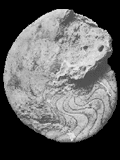 Abstract: In
spite of recent interest, the various species belonging to the genera Heminautilus Spath,
1927, and Josanautilus Martínez
& Grauges, 2006, have never been the object of a general
revision. More than 160 specimens belonging to various species of these two
genera were studied, with the aim of identifying the specific characteristics
and the stratigraphical and paleogeographical distribution of the various
species which compose them, as well as to propose a phylogeny for the group.
This study confirms the non-synonymy of Heminautilus saxbii (Morris,
1848) and H. lallierianus (Orbigny, 1841),
establishes that H. tejeriensis Martínez & Grauges, 2006, and
H. verneuilli (Vilanova, 1870) represent junior synonyms of H.
saxbii (Morris) and suggests the creation of the species H. ?
japonicus sp. nov. The
origin of the genus Heminautilus
Spath from Pseudocenoceras
Spath, 1927, proposed by Tintant, and the origin of Josanautilus
Martínez & Grauges
from Heminautilus Spath are both confirmed. Abstract: In
spite of recent interest, the various species belonging to the genera Heminautilus Spath,
1927, and Josanautilus Martínez
& Grauges, 2006, have never been the object of a general
revision. More than 160 specimens belonging to various species of these two
genera were studied, with the aim of identifying the specific characteristics
and the stratigraphical and paleogeographical distribution of the various
species which compose them, as well as to propose a phylogeny for the group.
This study confirms the non-synonymy of Heminautilus saxbii (Morris,
1848) and H. lallierianus (Orbigny, 1841),
establishes that H. tejeriensis Martínez & Grauges, 2006, and
H. verneuilli (Vilanova, 1870) represent junior synonyms of H.
saxbii (Morris) and suggests the creation of the species H. ?
japonicus sp. nov. The
origin of the genus Heminautilus
Spath from Pseudocenoceras
Spath, 1927, proposed by Tintant, and the origin of Josanautilus
Martínez & Grauges
from Heminautilus Spath are both confirmed.
|
|
Carnets Geol., vol. 16, no. 5, p. 61-212
Online since April 14, 2016
|
|
Sedimentologic study of palustrine continental carbonate deposits of the Tajerouine area, NW Tunisia
Naoufel GHANNEM, Faouzia TLILI, Chadia RIAHI & Kamel REGAYA
| HTML  | PDF
| PDF  [1,885 KB]
| DOI: 10.4267/2042/58976 [1,885 KB]
| DOI: 10.4267/2042/58976
|
|
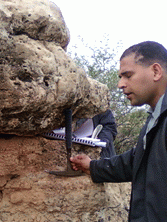 Abstract: The palustrine
limestones of Quaternary (Middle to the Late Pleistocene) age described in this
study are located in the
El Gara massif Tajerouine (Northwest of Tunisia). The study of these deposits at
different scales, both macroscopic (lithological description) and microscopic (petrography and
mineralogy), shows that they have a tabular structure and an angular unconformity
contact on the marly – calcareous series from the
Aptian-Albian. They show lateral and vertical changes in facies,
including conglomerates, limestones and stromatolites. Layer thickness tends
to increase gradually from East to West and also to the South of the study area.
Because of fluctuations in the groundwater table, these carbonates have
undergone periods of flooding and emersion, causing many pedogenic changes. The
nature of these changes was controlled by the height of emersion (nodulisation, roots traces, pseudo-microkarst).
These pedogenic changes in turn affected cementation during diagenesis (alternations
of phreatic cement), justifying the rock classification as palustrine
limestone. Abstract: The palustrine
limestones of Quaternary (Middle to the Late Pleistocene) age described in this
study are located in the
El Gara massif Tajerouine (Northwest of Tunisia). The study of these deposits at
different scales, both macroscopic (lithological description) and microscopic (petrography and
mineralogy), shows that they have a tabular structure and an angular unconformity
contact on the marly – calcareous series from the
Aptian-Albian. They show lateral and vertical changes in facies,
including conglomerates, limestones and stromatolites. Layer thickness tends
to increase gradually from East to West and also to the South of the study area.
Because of fluctuations in the groundwater table, these carbonates have
undergone periods of flooding and emersion, causing many pedogenic changes. The
nature of these changes was controlled by the height of emersion (nodulisation, roots traces, pseudo-microkarst).
These pedogenic changes in turn affected cementation during diagenesis (alternations
of phreatic cement), justifying the rock classification as palustrine
limestone.
|
|
Carnets Geol., vol. 16, no. 4, p. 43-59
Online since April 1, 2016
|
|
Lithothamnion crispatum: long-lasting species of non-geniculate coralline algae (Rhodophyta, Hapalidiales)
Giovanni COLETTI, Juraj HRABOVSKÝ & Daniela BASSO
| HTML  | PDF
| PDF  [2,096 KB]
| DOI: 10.4267/2042/58720 [2,096 KB]
| DOI: 10.4267/2042/58720
|
|
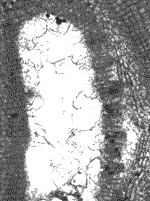 Abstract: The examination of fossil Lithothamnion specimens ranging in age from the Early Miocene to the
Pleistocene revealed the occurrence of multiporate conceptacle chambers pitted with depressions. This is the diagnostic feature of Lithothamnion crispatum, a cosmopolitan hapalidiacean with a wide depth range in
modern oceans. The comparison of the microscopic anatomy of both the fossil and
modern L. crispatum confirmed that they are conspecific. Therefore, this species has a long stratigraphic distribution starting at least 20
My ago, without significant morphological changes in either reproductive or vegetative anatomy. Abstract: The examination of fossil Lithothamnion specimens ranging in age from the Early Miocene to the
Pleistocene revealed the occurrence of multiporate conceptacle chambers pitted with depressions. This is the diagnostic feature of Lithothamnion crispatum, a cosmopolitan hapalidiacean with a wide depth range in
modern oceans. The comparison of the microscopic anatomy of both the fossil and
modern L. crispatum confirmed that they are conspecific. Therefore, this species has a long stratigraphic distribution starting at least 20
My ago, without significant morphological changes in either reproductive or vegetative anatomy.
|
|
Carnets Geol., vol. 16, no. 3, p. 27-41
Online since February 20, 2016
|
|
Insights into the permeability of polygonal faults from their intersection geometries with Linear Chimneys: a case study from the Lower Congo Basin
Sutieng HO, Daniel CARRUTHERS & Patrice IMBERT
| HTML  | PDF
| PDF  [483 KB]
| DOI: 10.4267/2042/58718 [483 KB]
| DOI: 10.4267/2042/58718
|
|
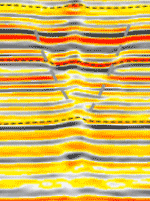 Abstract: Layer-bound arrays of polygonal compaction faults have long been considered as important migration routes for hydrocarbon fluids leaking to the surface across thick shale sequences. A classic example is the deep offshore of the Lower Congo Basin where numerous fluid-venting structures are present above a Pliocene polygonal fault system. In this paper we present a detailed seismic analysis of a newly recognised system of Quaternary-aged Linear Chimneys and their intersection geometries with pre-existing Pliocene-aged polygonal faults (PF). Most (73%) of the 209 chimneys analysed intersect the lower portions of polygonal faults and almost half of these are rooted in strata below the PF interval. This indicates that fluid (in this case gas) migrated vertically, cross-cutting polygonal faults as it ascended through the tier. This is a strong indicator that PFs did not provide viable migration pathways otherwise chimneys would terminate at the upper tip of the fault, which would be the most likely migration exit point. Only twice in the whole system of Linear Venting Systems did this occur. A sub-set of chimneys stems from or above PF planes but these are restricted to either the lower footwall or from the apex area of hanging wall. At best they are evidence of fluids migrating up the lower part of polygonal faults and exiting deep within the tier, then migrating through most of the tier in their own vertical leakage vents. These results provide strong indicators that at least within this part of the Lower Congo Basin polygonal faults were the least effective/favoured migration pathway and that it was more energy-efficient for migrating gas to hydrofracture its fine-grained overburden than to re-open polygonal faults. Abstract: Layer-bound arrays of polygonal compaction faults have long been considered as important migration routes for hydrocarbon fluids leaking to the surface across thick shale sequences. A classic example is the deep offshore of the Lower Congo Basin where numerous fluid-venting structures are present above a Pliocene polygonal fault system. In this paper we present a detailed seismic analysis of a newly recognised system of Quaternary-aged Linear Chimneys and their intersection geometries with pre-existing Pliocene-aged polygonal faults (PF). Most (73%) of the 209 chimneys analysed intersect the lower portions of polygonal faults and almost half of these are rooted in strata below the PF interval. This indicates that fluid (in this case gas) migrated vertically, cross-cutting polygonal faults as it ascended through the tier. This is a strong indicator that PFs did not provide viable migration pathways otherwise chimneys would terminate at the upper tip of the fault, which would be the most likely migration exit point. Only twice in the whole system of Linear Venting Systems did this occur. A sub-set of chimneys stems from or above PF planes but these are restricted to either the lower footwall or from the apex area of hanging wall. At best they are evidence of fluids migrating up the lower part of polygonal faults and exiting deep within the tier, then migrating through most of the tier in their own vertical leakage vents. These results provide strong indicators that at least within this part of the Lower Congo Basin polygonal faults were the least effective/favoured migration pathway and that it was more energy-efficient for migrating gas to hydrofracture its fine-grained overburden than to re-open polygonal faults.
|
|
Carnets Geol., vol. 16, no. 2, p. 17-26
Online since February 20, 2016
|
|
A simple technique to establish sequences of datums and to highlight transgressive–regressive cycles
Jean GUEX & Federico GALSTER
| HTML  | PDF
| PDF  [394 KB]
| DOI: 10.4267/2042/58207 [394 KB]
| DOI: 10.4267/2042/58207
|
|
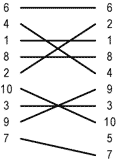 Abstract: The relative diachronism of first or last local occurrences (FOs and LOs) of fossil species may highlight transgressive/regressive cycles. A simple technique allowing the extraction of this information by means of the UAgraph program is discussed in the present paper.
The technique consists in modifying a usual database of UAgraph by augmenting it with the restricted data concerning only the FOs (or LOs) of the taxa under consideration. The resulting data set combines the information on total ranges and those concerning the FOs and LOs only. Calculating the UAs of such a duplicated database produce a range chart in which we can read the maximal ranges of all the taxa and, in addition, the biochronological dispersion of the FOs and LOs. For a given transgressive/regressive cycle, the UAs defined by the species related to sea level fluctuations migrate with time from distal to proximal sections and inversely. This trend can be detected visually by the means of the UAs reproducibility chart, output of the UAgraph program.
In a more general frame, the same holds true for species whose regional dispersion is related to specific conditions and when these conditions migrate in space with time (e.g., water temperatures and diatoms).
The above discussion is strictly related to FOs and LOs that for a given section are definitive, however well constrained ephemeral appearances and disappearances can be easily integrated in the database for the same purposes. Abstract: The relative diachronism of first or last local occurrences (FOs and LOs) of fossil species may highlight transgressive/regressive cycles. A simple technique allowing the extraction of this information by means of the UAgraph program is discussed in the present paper.
The technique consists in modifying a usual database of UAgraph by augmenting it with the restricted data concerning only the FOs (or LOs) of the taxa under consideration. The resulting data set combines the information on total ranges and those concerning the FOs and LOs only. Calculating the UAs of such a duplicated database produce a range chart in which we can read the maximal ranges of all the taxa and, in addition, the biochronological dispersion of the FOs and LOs. For a given transgressive/regressive cycle, the UAs defined by the species related to sea level fluctuations migrate with time from distal to proximal sections and inversely. This trend can be detected visually by the means of the UAs reproducibility chart, output of the UAgraph program.
In a more general frame, the same holds true for species whose regional dispersion is related to specific conditions and when these conditions migrate in space with time (e.g., water temperatures and diatoms).
The above discussion is strictly related to FOs and LOs that for a given section are definitive, however well constrained ephemeral appearances and disappearances can be easily integrated in the database for the same purposes.
|
|
Carnets Geol., vol. 16, no. 1, p. 1-16
Online since January 14, 2016
|

|
|
2015 (vol. 15)
|
|
A review of the species of the genus Hemidiadema Agassiz, 1846 (Euechinoidea, Camaradonta, Glyphocyphidae), from the Aptian (Lower Cretaceous) of Spain
Arnaud CLÉMENT
| HTML  | PDF
| PDF  [2,717 KB]
| DOI:
10.4267/2042/58204
[2,717 KB]
| DOI:
10.4267/2042/58204
|
|
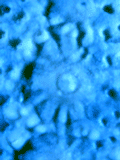 Abstract:
Specimens belonging to the genus Hemidiadema Agassiz, 1846, from Aptian (Lower Cretaceous) strata from the Spanish provinces of Castellón, Tarragona, Barcelona and Teruel –were studied. All specimens of Hemidiadema from these regions cited or described in the literature until now were related to the species Hemidiadema rugosum Agassiz, 1846. Their taxonomic revision – based on historical material and new collecting – demonstrates that these individuals do not belong to the species described by Agassiz, but represent new taxa. Three new species are proposed and described: Hemidiadema batalleri nov. sp., H. malladai nov. sp., and H. forcallensis nov. sp). The species H. rugosum Agassiz, 1846, is known by a single specimen from the Aptian of Castellón. Remarks on the paleoecology and stratigraphic and geographic distributions of these species are given. Abstract:
Specimens belonging to the genus Hemidiadema Agassiz, 1846, from Aptian (Lower Cretaceous) strata from the Spanish provinces of Castellón, Tarragona, Barcelona and Teruel –were studied. All specimens of Hemidiadema from these regions cited or described in the literature until now were related to the species Hemidiadema rugosum Agassiz, 1846. Their taxonomic revision – based on historical material and new collecting – demonstrates that these individuals do not belong to the species described by Agassiz, but represent new taxa. Three new species are proposed and described: Hemidiadema batalleri nov. sp., H. malladai nov. sp., and H. forcallensis nov. sp). The species H. rugosum Agassiz, 1846, is known by a single specimen from the Aptian of Castellón. Remarks on the paleoecology and stratigraphic and geographic distributions of these species are given.
|
|
Carnets Geol., vol. 15, no. 20, p. 279-330
Online since December 25, 2015
|
|
Distribution of Conichnus and Amphorichnus in the Lower Paleozoic of Estonia (Baltica)
Olev VINN, Mark A. WILSON & Ursula TOOM
| HTML  | PDF
| PDF  [1,137 KB]
| DOI:
10.4267/2042/58180
[1,137 KB]
| DOI:
10.4267/2042/58180
|
|
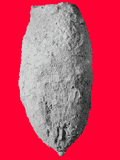 Abstract:
Conichnus conicus and Amphorichnus papillatus occur in clay-rich carbonate rocks in the Ordovician of Estonia.
Conichnus conicus also occurs in clay-rich carbonates of the early Silurian of Estonia. Lateral adjustment traces are more common in C. conicus than previously recorded. The lack of adjustment traces in Amphorichnus, together with its morphology, does not support synonymy of Conichnus and Amphorichnus. The
Conichnus conicus and Amphorichnus papillatus tracemakers preferred shallow water carbonate environments with high clay content. They were rare or did not occur in deeper water muddy environments or where shallow water carbonates accumulated. A high content of volcanic ash in the depositional environment is characteristic of both the Ordovician and Silurian maxima of
Conichnus conicus occurrence. C. conicus may have been more common in the temperate seas of Baltica than in the tropics. Abstract:
Conichnus conicus and Amphorichnus papillatus occur in clay-rich carbonate rocks in the Ordovician of Estonia.
Conichnus conicus also occurs in clay-rich carbonates of the early Silurian of Estonia. Lateral adjustment traces are more common in C. conicus than previously recorded. The lack of adjustment traces in Amphorichnus, together with its morphology, does not support synonymy of Conichnus and Amphorichnus. The
Conichnus conicus and Amphorichnus papillatus tracemakers preferred shallow water carbonate environments with high clay content. They were rare or did not occur in deeper water muddy environments or where shallow water carbonates accumulated. A high content of volcanic ash in the depositional environment is characteristic of both the Ordovician and Silurian maxima of
Conichnus conicus occurrence. C. conicus may have been more common in the temperate seas of Baltica than in the tropics.
|
|
Carnets Geol., vol. 15, no. 19, p. 269-278
Online since December 2, 2015
|
|
Selected agglutinated larger foraminifera from the Font de les Bagasses unit (early Campanian, southern Pyrenees)
Sergi ALBRICH, Carme BOIX & Esmeralda CAUS
| HTML  | PDF
| PDF  [5,455 KB]
| DOI:
10.4267/2042/57953
[5,455 KB]
| DOI:
10.4267/2042/57953
|
|
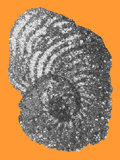 Abstract:
The Font de les Bagasses marls and marly limestones (Montsec Mountains, NE Spain) host a rich assemblage of larger foraminifera, that was described for the first time in the early 20th Century from the currently submerged locality of Tragó de Noguera (Marginal Mountains). In this paper, a detailed architectural study has been carried out on selected, agglutinated larger foraminifera, which
include Choffatella aff. rugoretis Gendrot, Hemicyclammina chalmasi (Schlumberger), Cuneolina conica
Orbigny, Cuneolina cylindrica Henson,
and Dictyopsella kiliani Munier-Chalmas. Moreover, it presents their biostratigraphic range and the range of the associated
porcellaneous and lamellar-perforate foraminifera in the study area. The
assemblage is Early Campanian in age. Abstract:
The Font de les Bagasses marls and marly limestones (Montsec Mountains, NE Spain) host a rich assemblage of larger foraminifera, that was described for the first time in the early 20th Century from the currently submerged locality of Tragó de Noguera (Marginal Mountains). In this paper, a detailed architectural study has been carried out on selected, agglutinated larger foraminifera, which
include Choffatella aff. rugoretis Gendrot, Hemicyclammina chalmasi (Schlumberger), Cuneolina conica
Orbigny, Cuneolina cylindrica Henson,
and Dictyopsella kiliani Munier-Chalmas. Moreover, it presents their biostratigraphic range and the range of the associated
porcellaneous and lamellar-perforate foraminifera in the study area. The
assemblage is Early Campanian in age.
|
|
Carnets Geol., vol. 15, no. 18, p. 245-267
Online since November 18, 2015
|
|
Tremichnus in crinoid pluricolumnals from the Silurian of western Estonia (Baltica)
Olev VINN, Mark A. WILSON, William I. AUSICH & Ursula TOOM
| HTML  | PDF
| PDF  [644 KB]
| DOI:
10.4267/2042/57951
[644 KB]
| DOI:
10.4267/2042/57951
|
|
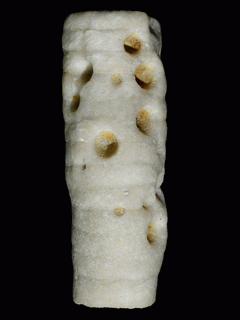 Abstract:
Quelques petites cavités attribuées à Tremichnus ont été trouvées dans des
crinoïdes provenant du Silurien d'Estonie. Ce Tremichnus
rhuddanien est le symbiote le plus ancien observé dans des segments
de tiges de crinoïdes du bouclier balte. Ces cavités correspondent
vraisemblablement à des habitats d'organismes inconnus. Tremichnus
a eu un impact négatif sur le crinoïde hôte comme en attestent
les renflements des tiges. Tremichnus est moins fréquent
dans le Silurien d'Estonie que des traces semblables dans le
Silurien du Gotland voisin. L'aspect le plus significatif de cette
étude est la rareté de cette interaction dans ces échantillons à
la différence de la plupart des échantillons du même âge
provenant d'autres localités. Ces structures ont une répartition très irrégulière. Abstract:
Quelques petites cavités attribuées à Tremichnus ont été trouvées dans des
crinoïdes provenant du Silurien d'Estonie. Ce Tremichnus
rhuddanien est le symbiote le plus ancien observé dans des segments
de tiges de crinoïdes du bouclier balte. Ces cavités correspondent
vraisemblablement à des habitats d'organismes inconnus. Tremichnus
a eu un impact négatif sur le crinoïde hôte comme en attestent
les renflements des tiges. Tremichnus est moins fréquent
dans le Silurien d'Estonie que des traces semblables dans le
Silurien du Gotland voisin. L'aspect le plus significatif de cette
étude est la rareté de cette interaction dans ces échantillons à
la différence de la plupart des échantillons du même âge
provenant d'autres localités. Ces structures ont une répartition très irrégulière.
|
|
Carnets Geol., vol. 15, no. 17, p. 239-243
Online since November 18, 2015
|
|
Scientific death-knell against databases? Errors induced by database manipulations and its consequences
Christian C. EMIG, Maria Aleksandra BITNER & Fernando ÁLVAREZ
| HTML  | PDF
| PDF  [107 KB]
| DOI:
10.4267/2042/57949
[107 KB]
| DOI:
10.4267/2042/57949
|
|
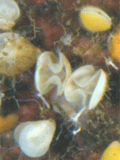 Abstract:
References to Terebratulina caputserpentis attributing its authorship to Zbyszewski, 1957, not to Linnæus, 1767, have been found in three recent publications, in the collections of the Muséum National d'Histoire naturelle de Paris and in several
online databases. The use in these databases seems to have arisen from WoRMS (World Register of Marine Species), specifically from WBD (World Brachiopoda Database) of which the three authors of this paper are the editors (authors). The page concerning T. caputserpentis (Linnæus, 1767) has been modified by WoRMS staff without the knowledge of these editors (authors). Abstract:
References to Terebratulina caputserpentis attributing its authorship to Zbyszewski, 1957, not to Linnæus, 1767, have been found in three recent publications, in the collections of the Muséum National d'Histoire naturelle de Paris and in several
online databases. The use in these databases seems to have arisen from WoRMS (World Register of Marine Species), specifically from WBD (World Brachiopoda Database) of which the three authors of this paper are the editors (authors). The page concerning T. caputserpentis (Linnæus, 1767) has been modified by WoRMS staff without the knowledge of these editors (authors).
The decrease of the specialists in systematics and their replacement by IT specialists question the scientific reliability of the online databases as well as the specimen labelling in museums. The absence of scientific rigour becomes their Achilles' heel. Several other cases of errors are quoted and developed. In spite of applications to the staff of databases in biodiversity, the situation continued degrading so much so that today these bases are reached by the Peter principle and can no longer be used for scientific requirements, except if verifying all the desired data.
|
|
Carnets Geol., vol. 15, no. 16, p. 231-238
Online since November 11, 2015
|
|
New fossiliferous sites with Barremian Charophyta in the "Grès du Liban" auct. (Lebanon), with a critical perspective regarding the nature of Munieria Deecke, 1883
Bruno GRANIER, Dany AZAR, Sibelle MAKSOUD, Raymond GÈZE & Roland HABCHI
| HTML  | PDF
| PDF  [5,904 KB]
| DOI:
10.4267/2042/57947
[5,904 KB]
| DOI:
10.4267/2042/57947
|
|
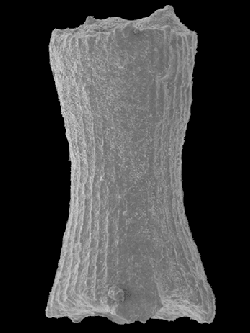 Abstract:
The "Grès du
Liban" auct. is the thick basal unit of the Lower Cretaceous series in Lebanon.
There are two key
levels in this dominantly siliciclastic unit: the "Banc de
Mréjatt" and the "Calcaire à pisolithes", the latter of which includes limestones and
marls with Charophyta. The rich charophyte assemblage described by Grambast and Lorch
(1968) from a site near Jezzine is Barremian (possibly
Early Barremian) in age, not Bedoulian as previously stated. Besides gyrogonites
and utricles, charophyte thalli are rather common; they are ascribed to two organ genera,
Munieria Deecke,
1883,
and Charaxis Harris, 1939. Based on topotypic material
(from the Pia Collection), Munieria
baconica Deecke,
1883, the type-species of the genus, is reassessed. In addition, the
species Clypeina
parvula Carozzi, 1946,
is transferred to the revised genus Munieria,
and a new species of Charaxis is
described. Abstract:
The "Grès du
Liban" auct. is the thick basal unit of the Lower Cretaceous series in Lebanon.
There are two key
levels in this dominantly siliciclastic unit: the "Banc de
Mréjatt" and the "Calcaire à pisolithes", the latter of which includes limestones and
marls with Charophyta. The rich charophyte assemblage described by Grambast and Lorch
(1968) from a site near Jezzine is Barremian (possibly
Early Barremian) in age, not Bedoulian as previously stated. Besides gyrogonites
and utricles, charophyte thalli are rather common; they are ascribed to two organ genera,
Munieria Deecke,
1883,
and Charaxis Harris, 1939. Based on topotypic material
(from the Pia Collection), Munieria
baconica Deecke,
1883, the type-species of the genus, is reassessed. In addition, the
species Clypeina
parvula Carozzi, 1946,
is transferred to the revised genus Munieria,
and a new species of Charaxis is
described.
|
|
Carnets Geol., vol. 15, no. 15, p. 199-229
Online since November 11, 2015
|
|
Palaeoenviromental and palaeogeographical traits on deep-water ostracod assemblages from the Lower Pleistocene sediments along the Ionian side of Mount Etna (Sicily, Italy)
Francesco SCIUTO
| HTML  | PDF
| PDF  [2,013 KB]
| DOI:
10.4267/2042/57945
[2,013 KB]
| DOI:
10.4267/2042/57945
|
|
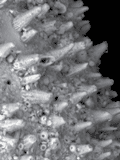 Abstract:
The ostracod associations of the Lower Pleistocene sedimentary succession cropping out at Serra San Biagio (Catania, Sicily NE) have been investigated. The ostracod fauna from nine samples is poorly diversified but well-preserved: A total of forty taxa of ostracods have been identified, thirty-three at specific level and seven at genus level or doubtful species. Thirty species are considered as constituents of the in situ original assemblages. The associations consist almost exclusively of bathyal taxa such as Bythocypris obtusata (Sars), Anchistrocheles antemacella Maddocks, Henryhowella ex H. hirta (Costa) group, Quasibuntonia radiatopora (Seguenza), Retibythere
(Bathybythere) scaberrima (Brady) and Bathycythere vansraateni Sissingh. Also the Krithe group is well-represented with Krithe compressa (Seguenza) and K. pernoides (Bornemann). Almost all species, some, particularly interesting from the palaeoecological and palaeogeographical point of view, have been here described, illustrated and commented on, including a species belonging to the genus Cytherella Jones,
1849, found in all samples of the section, which is here proposed as new. Abstract:
The ostracod associations of the Lower Pleistocene sedimentary succession cropping out at Serra San Biagio (Catania, Sicily NE) have been investigated. The ostracod fauna from nine samples is poorly diversified but well-preserved: A total of forty taxa of ostracods have been identified, thirty-three at specific level and seven at genus level or doubtful species. Thirty species are considered as constituents of the in situ original assemblages. The associations consist almost exclusively of bathyal taxa such as Bythocypris obtusata (Sars), Anchistrocheles antemacella Maddocks, Henryhowella ex H. hirta (Costa) group, Quasibuntonia radiatopora (Seguenza), Retibythere
(Bathybythere) scaberrima (Brady) and Bathycythere vansraateni Sissingh. Also the Krithe group is well-represented with Krithe compressa (Seguenza) and K. pernoides (Bornemann). Almost all species, some, particularly interesting from the palaeoecological and palaeogeographical point of view, have been here described, illustrated and commented on, including a species belonging to the genus Cytherella Jones,
1849, found in all samples of the section, which is here proposed as new.
|
|
Carnets Geol., vol. 15, no. 14, p. 179-197
Online since November 11, 2015
|
|
Review of some Aptian ammonites collected by Gaston Astre in Lleida Province, Catalonia, Spain
Josep A. MORENO-BEDMAR & Keith P. MINOR
| HTML  | PDF
| PDF  [934 KB]
| DOI:
10.4267/2042/56911
[934 KB]
| DOI:
10.4267/2042/56911
|
|
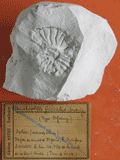 Abstract:
We study the three best preserved ammonites collected by Astre in 1924-1925 in Lleida Province, Catalonia, Spain, in order to assess their taxonomic assignment. We also include images of these ammonoids since they were not illustrated in Astre's original 1934 work. This taxonomic review allows us to identify these lower Aptian ammonites as Pseudohaploceras liptoviense, Deshayesites sp. and Dufrenoyia sp. Abstract:
We study the three best preserved ammonites collected by Astre in 1924-1925 in Lleida Province, Catalonia, Spain, in order to assess their taxonomic assignment. We also include images of these ammonoids since they were not illustrated in Astre's original 1934 work. This taxonomic review allows us to identify these lower Aptian ammonites as Pseudohaploceras liptoviense, Deshayesites sp. and Dufrenoyia sp.
|
|
Carnets Geol., vol. 15, no. 13, p. 173-178
Online since August 6, 2015
|
|
Sequence stratigraphic architecture of marine to fluvial deposits across a passive margin (Cenomanian, Atlantic margin, Morocco, Agadir transect)
Badre ESSAFRAOUI, Serge FERRY, Danièle GROSHÉNY, Nourrisaid IÇAME, Hassan EL AOULI, Moussa MASROUR, Luc G. BULOT, Yves GÉRAUD & Mohamed AOUTEM
| HTML  | PDF
| PDF  [24,372 KB]
| DOI:
10.4267/2042/56909
[24,372 KB]
| DOI:
10.4267/2042/56909
|
|
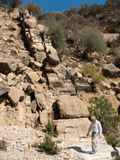 Abstract:
Seven sections, covering the upper Albian to lowermost Turonian, have been correlated from full-marine to continental-dominated deposits across a passive margin, along a transect 425 km long, from the present-day Atlantic coast to the "Pre-African Trough" between the Anti-Atlas and the High-Atlas. The thickness of the Cenomanian succession changes from around 500 metres in the fully marine sections to 250 metres in mostly continental facies in the western High-Atlas, about 150 km updip, to a few tens of metres in the Bou Tazoult area. The strata thicken again eastwards into the Pre-African Trough where they can be traced without major facies changes to the Kem Kem embayment and to the Bechar area in Algeria. Over all this eastern area, continental facies are overlain by the fully-marine shallow-water deposits of the Cenomanian-Turonian boundary interval. Abstract:
Seven sections, covering the upper Albian to lowermost Turonian, have been correlated from full-marine to continental-dominated deposits across a passive margin, along a transect 425 km long, from the present-day Atlantic coast to the "Pre-African Trough" between the Anti-Atlas and the High-Atlas. The thickness of the Cenomanian succession changes from around 500 metres in the fully marine sections to 250 metres in mostly continental facies in the western High-Atlas, about 150 km updip, to a few tens of metres in the Bou Tazoult area. The strata thicken again eastwards into the Pre-African Trough where they can be traced without major facies changes to the Kem Kem embayment and to the Bechar area in Algeria. Over all this eastern area, continental facies are overlain by the fully-marine shallow-water deposits of the Cenomanian-Turonian boundary interval.
A first major conclusion is that fluvial aggradation in high-frequency transgressive-regressive sequences is coeval with the seaward-shift of the shoreline, in accordance with the genetic sequence stratigraphic model of Galloway (1989). Both the flatness of the depositional profile and the corresponding very low energy of the marine environment during the transgressions account for the blanket of red continental clays on top of marine facies in updip depositional sequences, which is then preserved under the marine transgressive surface of the next sequence.
A second major conclusion is that the high-frequency transgressive-regressive (T-R) sequences do not look like classical parasequences bounded by transgression surfaces. They usually exhibit a surface created by a sea-level fall within the regressive half-cycle. This is interpreted in the following way: regressions did not operate through a regular seaward-shift of the shoreline, but through stepped sea-level falls. The very low slope of the depositional ramp is thought to have enhanced the sequence stratigraphic record of such stepped regressions. Short-term, high-frequency sequences are organized into medium-frequency T-R sequences (seven in the Cenomanian) which show an overall aggrading and slowly retrograding pattern along the whole transect.
Comparisons with other basins show that medium-frequency sequences do not fit
the third-order depositional sequences described elsewhere, casting doubts about
a eustatic mechanism for their deposition.
|
|
Carnets Geol., vol. 15, no. 12, p. 137-172
Online since August 6, 2015
|
|
End of a modern geological myth: there are no rudists in Brazil! Paleobiogeographic implications
Bruno GRANIER & Dimas DIAS-BRITO
| HTML  | PDF
| PDF  [1,631 KB]
| DOI:
10.4267/2042/56880
[1,631 KB]
| DOI:
10.4267/2042/56880
|
|
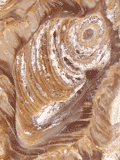 Abstract:
Out of the few records of rudists from the Cretaceous strata of the South Atlantic coastal
basins only two refer to Brazilian localities. However, petrographic analyses
demonstrate that these shells should be assigned to Ostreids or
to Pycnodontids rather than to Rudistids. More specifically, the domain considered herein, north of
the Río Grande Rise - Walvis Ridge barrier, was part of the warm-water
"tropical" realm, but it was not part of the Mesogean domain because both
Rudistids and Orbitolinas are missing. In addition, the scarcity of corals leads
us to ascribe the taphonomic assemblage to the Chloralgal facies. Neither
generalized hypersalinity or extreme sea-water temperatures seem to account for
these biotic peculiarities. Instead, our alternative hypothesis favors the
driving role played by oceanic circulation in the dispersal of the benthic organisms. Abstract:
Out of the few records of rudists from the Cretaceous strata of the South Atlantic coastal
basins only two refer to Brazilian localities. However, petrographic analyses
demonstrate that these shells should be assigned to Ostreids or
to Pycnodontids rather than to Rudistids. More specifically, the domain considered herein, north of
the Río Grande Rise - Walvis Ridge barrier, was part of the warm-water
"tropical" realm, but it was not part of the Mesogean domain because both
Rudistids and Orbitolinas are missing. In addition, the scarcity of corals leads
us to ascribe the taphonomic assemblage to the Chloralgal facies. Neither
generalized hypersalinity or extreme sea-water temperatures seem to account for
these biotic peculiarities. Instead, our alternative hypothesis favors the
driving role played by oceanic circulation in the dispersal of the benthic organisms.
|
|
Carnets Geol., vol. 15, no. 11, p. 123-136
Online since July 14, 2015
|
|
Facies, biostratigraphy, diagenesis, and depositional environments of Lower Cretaceous strata, Sierra San José section, Sonora (Mexico)
Jayagopal MADHAVARAJU, Robert W. SCOTT, Yong Il LEE, Kunjukrishnan Sathy BINCY, Carlos M. GONZÁLEZ-LEÓN & Sooriamuthu RAMASAMY
| HTML  | PDF
| PDF  [1,401 KB]
| DOI:
10.4267/2042/56879
[1,401 KB]
| DOI:
10.4267/2042/56879
|
|
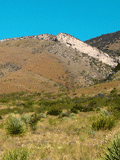 Abstract:
We used petrofacies analysis, carbon, oxygen and strontium isotope data to interpret the isotopic variations in the carbonate
rocks of the Mural Formation of Sonora (Sierra San José section), Mexico. The
petrographic study reveals a range of lithofacies from wackestone to packstone. The
analyzed limestones show significant negative δ18O values (-18.6 to -10.9 VPDB) and
δ13C values ranging from negative to positive (-2.6 to +2.5‰ VPDB). The absence of
correlation between δ13C and δ18O
values suggests a primary marine origin for the δ13C values of
limestones from the Sierra San José section. The limestones have large variations in 87Sr/86Sr
values (0.707479 to 0.708790). Higher 87Sr/86Sr ratios in
various levels of the studied section suggest that most of the sediments were
derived from the Proterozoic basement of the Caborca block during Early
Cretaceous time. A decrease in 87Sr/86Sr ratios at
certain levels indicates an influx of lesser amounts of radiogenic Sr that
could have been caused by contribution of sediments from the Triassic and Jurassic volcanic rocks. Abstract:
We used petrofacies analysis, carbon, oxygen and strontium isotope data to interpret the isotopic variations in the carbonate
rocks of the Mural Formation of Sonora (Sierra San José section), Mexico. The
petrographic study reveals a range of lithofacies from wackestone to packstone. The
analyzed limestones show significant negative δ18O values (-18.6 to -10.9 VPDB) and
δ13C values ranging from negative to positive (-2.6 to +2.5‰ VPDB). The absence of
correlation between δ13C and δ18O
values suggests a primary marine origin for the δ13C values of
limestones from the Sierra San José section. The limestones have large variations in 87Sr/86Sr
values (0.707479 to 0.708790). Higher 87Sr/86Sr ratios in
various levels of the studied section suggest that most of the sediments were
derived from the Proterozoic basement of the Caborca block during Early
Cretaceous time. A decrease in 87Sr/86Sr ratios at
certain levels indicates an influx of lesser amounts of radiogenic Sr that
could have been caused by contribution of sediments from the Triassic and Jurassic volcanic rocks.
|
|
Carnets Geol., vol. 15, no. 10, p. 103-122
Online since July 14, 2015
|
|
Cambrian fossils from the Barrandian area (Czech Republic) stored in the Musée d'Histoire Naturelle de Lille
Oldřich FATKA, Petr BUDIL, Catherine CRÔNIER, Jessie CUVELIER, Lukáš LAIBL, Thierry OUDOIRE, Marika POLECHOVÁ & Lucie FATKOVÁ
| HTML  | PDF
| PDF  [1,415 KB]
| DOI:
10.4267/2042/56878
[1,415 KB]
| DOI:
10.4267/2042/56878
|
|
 Abstract:
A complete list of fossils originating from the Cambrian of the Barrandian area
and housed in the Musée d'Histoire Naturelle de Lille is compiled. The
collection includes two agnostids, ten trilobites, one brachiopod and one
echinoderm species, all collected at ten outcrops in the Buchava Formation of
the Skryje-Týřovice Basin and most probably also
at two outcrops in the Jince Formation of the Příbram-Jince Basin. A large part of the material was
collected by Prof. Charles Barrois and Dr. Louis Dollé (both
University of Lille) during the excursion organised before the Ninth
International Geological Congress in Vienna in 1903. Other, poorly documented specimens were purchased from the
enterprise Krantz towards the end of the 19th century and in the
first years of 20th century. The geographic position and stratigraphy
of outcrops, from which the material originates, are briefly discussed. Abstract:
A complete list of fossils originating from the Cambrian of the Barrandian area
and housed in the Musée d'Histoire Naturelle de Lille is compiled. The
collection includes two agnostids, ten trilobites, one brachiopod and one
echinoderm species, all collected at ten outcrops in the Buchava Formation of
the Skryje-Týřovice Basin and most probably also
at two outcrops in the Jince Formation of the Příbram-Jince Basin. A large part of the material was
collected by Prof. Charles Barrois and Dr. Louis Dollé (both
University of Lille) during the excursion organised before the Ninth
International Geological Congress in Vienna in 1903. Other, poorly documented specimens were purchased from the
enterprise Krantz towards the end of the 19th century and in the
first years of 20th century. The geographic position and stratigraphy
of outcrops, from which the material originates, are briefly discussed.
|
|
Carnets Geol., vol. 15, no. 9, p. 89-101
Online since July 14, 2015
|
|
Lower Valanginian ammonite biostratigraphy in the Subbetic Domain (Betic Cordillera, southeastern Spain)
Miguel COMPANY & José M. TAVERA
| HTML  | PDF
| PDF  [1,459 KB]
| DOI:
10.4267/2042/56745
[1,459 KB]
| DOI:
10.4267/2042/56745
|
|
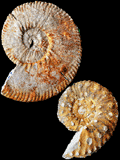 Abstract:
A new zonation for the lower Valanginian in the Betic Cordillera is presented. It is based on the study of 16 sections located near Caravaca and Cehegín (Region of Murcia).
From bottom to top, the following interval zones, defined by the first appearance of the index-species, are distinguished: Abstract:
A new zonation for the lower Valanginian in the Betic Cordillera is presented. It is based on the study of 16 sections located near Caravaca and Cehegín (Region of Murcia).
From bottom to top, the following interval zones, defined by the first appearance of the index-species, are distinguished:
● "Thurmanniceras" pertransiens Zone, which can be
subdivided into two subzones, a lower "Th." pertransiens Subzone and an upper
Vergoliceras salinarium Subzone. The latter is characterized by the disappearance of
Olcostephanus drumensis and the appearance of Luppovella superba.
● Neocomites neocomiensiformis Zone, also with two subzones, the Baronnites hirsutus Subzone below (characterized by the
appearance of "Busnardoites" subcampylotoxus and Olcostephanus
guebhardi) and the Valanginites dolioliformis Subzone above ("Busnardoites"
campylotoxus is restricted to this subzone).
● Karakaschiceras inostranzewi Zone, subdivided as well into two subzones, a lower
Karakaschiceras inostranzewi Subzone and an upper Saynoceras contestanum Subzone.
The assemblages characterizing each of these biozones can be recognized throughout the Mediterranean region.
|
|
Carnets Geol., vol. 15, no. 8, p. 71-88
Online since June 11, 2015
|
|
Some encrusted hardgrounds from the Ordovician of Estonia (Baltica)
Olev VINN & Ursula TOOM
| HTML  | PDF
| PDF  [344 KB]
| DOI:
10.4267/2042/56744
[344 KB]
| DOI:
10.4267/2042/56744
|
|
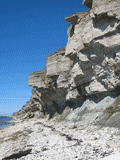 Abstract:
The Ordovician hardground faunas of Estonia are not diverse. They include echinoderm holdfasts (i.e., eocrinoids and crinoids), edrioasteroids, bryozoans (both hemispherical
trepostomes and stalked ptilodictyids) and cornulitids. The earliest hardground faunas appeared in the Dapingian (i.e., bryozoans and echinoderms). The Estonian hardground
faunas are less diverse than the North American ones. North American hardgrounds seem to be more heavily encrusted than the Estonian ones. These differences may be due to
the paleogeographic distances, different climates and different sedimentation environments of the paleocontinents. Abstract:
The Ordovician hardground faunas of Estonia are not diverse. They include echinoderm holdfasts (i.e., eocrinoids and crinoids), edrioasteroids, bryozoans (both hemispherical
trepostomes and stalked ptilodictyids) and cornulitids. The earliest hardground faunas appeared in the Dapingian (i.e., bryozoans and echinoderms). The Estonian hardground
faunas are less diverse than the North American ones. North American hardgrounds seem to be more heavily encrusted than the Estonian ones. These differences may be due to
the paleogeographic distances, different climates and different sedimentation environments of the paleocontinents.
|
|
Carnets Geol., vol. 15, no. 7, p. 63-70
Online since June 11, 2015
|
|
MayLib - a textfile-based bibliographic database for geosciences and a list of references on Devonian matters
Andreas MAY
| HTML  | PDF
| PDF  [420 KB]
| DOI:
10.4267/2042/56481 [420 KB]
| DOI:
10.4267/2042/56481
|
|
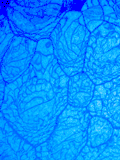 Abstract: Scientists need to manage their own collections of bibliographic data as well as exchange these data easily with
colleagues. One solution for this need is MayLib, a bibliographic database that runs on many different operating systems and does not require pre-installation of any software. MayLib is a very
small, efficient and comprehensive JAVA program that handles references to publications in
any Unicode-compatible language. It is user-friendly and not only contains the basic functions of a bibliographic
database, but also has some advanced features. Using MayLib the author has been able to create a list of references, which contains 500 periodicals and 4206 literature
references. Of these 4206 references 3191 deal with Devonian matters and 1594 references deal with corals. Abstract: Scientists need to manage their own collections of bibliographic data as well as exchange these data easily with
colleagues. One solution for this need is MayLib, a bibliographic database that runs on many different operating systems and does not require pre-installation of any software. MayLib is a very
small, efficient and comprehensive JAVA program that handles references to publications in
any Unicode-compatible language. It is user-friendly and not only contains the basic functions of a bibliographic
database, but also has some advanced features. Using MayLib the author has been able to create a list of references, which contains 500 periodicals and 4206 literature
references. Of these 4206 references 3191 deal with Devonian matters and 1594 references deal with corals.
|
|
Carnets Geol., vol. 15, no. 6, p. 59-62
Online since March 9, 2015
|
|
New faunistic data on the Pleistocene environmental evolution of the south-western edge of the Hyblean Plateau (SE Sicily)
Francesco SCIUTO, Antonietta ROSSO, Rossana SANFILIPPO & Rossana MANISCALCO
| HTML  | PDF
| PDF  [2,810 KB]
| DOI:
10.4267/2042/56401 [2,810 KB]
| DOI:
10.4267/2042/56401
|
|
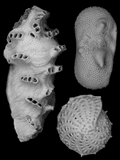 Abstract: Faunistic associations of the Lower Pleistocene sediments, out-cropping at
Cartiera Molino along the true right bank of the Ippari River (Vittoria, SE
Sicily), have been investigated. This
study integrates data obtained from the analysis of
ostracods, foraminifers, bryozoans and serpulids found within a
six metre thick sedimentary section. This multiproxy approach
allowed us to reconstruct the palaeoenvironmental evolution of this
south-western sector of the Hyblean Plateau (Comiso-Vittoria area) from
fluvially-influenced shallow marine settings, recorded in the lower portion of
the succession, to progressively shallower, transitional and brackish
environments, testified in mid levels, up to freshwater environments at the top
of the section. Abstract: Faunistic associations of the Lower Pleistocene sediments, out-cropping at
Cartiera Molino along the true right bank of the Ippari River (Vittoria, SE
Sicily), have been investigated. This
study integrates data obtained from the analysis of
ostracods, foraminifers, bryozoans and serpulids found within a
six metre thick sedimentary section. This multiproxy approach
allowed us to reconstruct the palaeoenvironmental evolution of this
south-western sector of the Hyblean Plateau (Comiso-Vittoria area) from
fluvially-influenced shallow marine settings, recorded in the lower portion of
the succession, to progressively shallower, transitional and brackish
environments, testified in mid levels, up to freshwater environments at the top
of the section.
|
|
Carnets Geol., vol. 15, no. 5, p. 41-57
Online since February 28, 2015
|
|
A reassessment of the validity and affinities of Belemnites sulcatus Miller, 1826, Belemnopsis Edwards in Gray, 1849, and Belemnopsis Bayle, 1878
Simon F. MITCHELL
| HTML  | PDF
| PDF  [172 KB]
| DOI: 10.4267/2042/56399 [172 KB]
| DOI: 10.4267/2042/56399
|
|
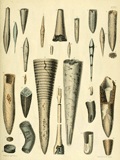 Abstract: A reinvestigation of the validity of the belemnite genus Belemnopsis Bayle is undertaken, together with a survey of the early history of the usage of the
names Belemnites sulcatus, Belemnopsis
Bayle and Belemnopsis Edwards.
Belemnites sulcatus Miller has been variously equated with either Belemnites
apiciconus Blainville or with the group of belemnites including
Belemnites Altdorfensis Blainville and B. Beaumontianus Orbigny. Riegraf (and not Phillips) subsequently designated a lectotype which may be
valid and, in case it is not, is validated here. The species concept for Belemnites
sulcatus, as based on this lectotype, places it in the genus Holcobeloides
Gustomesov. Belemnopsis Edwards has date priority over Belemnopsis Bayle, but must be interpreted
as an "incorrect original spelling" and, therefore, does not enter into homonymy according to the ICZN; Belemnopsis Bayle is thus a valid
genus. Douvillé subsequently nominated Belemnites sulcatus, which was figured as Belemnopsis sulcata by Bayle, and therefore is a valid designation because this species is
amongst the original species included in Belemnopsis by Bayle.
One of Bayle's figures of Belemnopsis
sulcata agrees with Belemnites apiciconus Blainville, but does not agree with Belemnites sulcatus as defined by its lectotype; as such this is a case of
misidentified type species. Belemnites apiciconus Blainville, the species involved in the misidentification,
is therefore designated type species of Belemnopsis Bayle here
and validated by citing the ICZN. The actions taken here maintain nomenclature
at the genus, family and suborder level in respect to the names Belemnopsis and Belemnosis and serve to stabilize the complicated nomenclature issues related to these taxa. Abstract: A reinvestigation of the validity of the belemnite genus Belemnopsis Bayle is undertaken, together with a survey of the early history of the usage of the
names Belemnites sulcatus, Belemnopsis
Bayle and Belemnopsis Edwards.
Belemnites sulcatus Miller has been variously equated with either Belemnites
apiciconus Blainville or with the group of belemnites including
Belemnites Altdorfensis Blainville and B. Beaumontianus Orbigny. Riegraf (and not Phillips) subsequently designated a lectotype which may be
valid and, in case it is not, is validated here. The species concept for Belemnites
sulcatus, as based on this lectotype, places it in the genus Holcobeloides
Gustomesov. Belemnopsis Edwards has date priority over Belemnopsis Bayle, but must be interpreted
as an "incorrect original spelling" and, therefore, does not enter into homonymy according to the ICZN; Belemnopsis Bayle is thus a valid
genus. Douvillé subsequently nominated Belemnites sulcatus, which was figured as Belemnopsis sulcata by Bayle, and therefore is a valid designation because this species is
amongst the original species included in Belemnopsis by Bayle.
One of Bayle's figures of Belemnopsis
sulcata agrees with Belemnites apiciconus Blainville, but does not agree with Belemnites sulcatus as defined by its lectotype; as such this is a case of
misidentified type species. Belemnites apiciconus Blainville, the species involved in the misidentification,
is therefore designated type species of Belemnopsis Bayle here
and validated by citing the ICZN. The actions taken here maintain nomenclature
at the genus, family and suborder level in respect to the names Belemnopsis and Belemnosis and serve to stabilize the complicated nomenclature issues related to these taxa.
|
|
Carnets Geol., vol. 15, no. 4, p. 31-39
Online since February 28, 2015
|
|
Earliest Aptian Caprinidae (Bivalvia, Hippuritida) from Lebanon
Jean-Pierre MASSE, Sibelle MAKSOUD, Mukerrem FENERCI-MASSE, Bruno GRANIER & Dany AZAR
| HTML  | PDF
| PDF  [1,585 KB]
| DOI: 10.4267/2042/56397 [1,585 KB]
| DOI: 10.4267/2042/56397
|
|
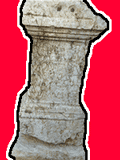 Abstract: The presence in Lebanon of Offneria murgensis and Offneria
nicolinae, two characteristic components of the Early Aptian Arabo-African
rudist faunas, fills a distributional gap of the corresponding assemblage
between the Arabic and African occurrences, on the one hand, and the Apulian
occurrences, on the other hand. This fauna bears out the palaeogeographic
placement of Lebanon on the southern Mediterranean Tethys margin established by
palaeostructural reconstructions. The associated micropaleontological elements
suggest an earliest Aptian age (early
Bedoulian) for the Offneria
murgensis - O. nicolinae assemblage
found in the "Falaise de Blanche"
stratigraphic interval, instead of a late Early Aptian age as proposed for most
of the peri-Adriatic and Middle East occurrences recognized so far. These
caprinid specimens are characterized by relatively modest sizes, moreover other
rudists commonly part of the assemblage are lacking. The dominance of caprinids
in the study area suggests a distal platform setting, i.e., close
proximity to the platform edge. Abstract: The presence in Lebanon of Offneria murgensis and Offneria
nicolinae, two characteristic components of the Early Aptian Arabo-African
rudist faunas, fills a distributional gap of the corresponding assemblage
between the Arabic and African occurrences, on the one hand, and the Apulian
occurrences, on the other hand. This fauna bears out the palaeogeographic
placement of Lebanon on the southern Mediterranean Tethys margin established by
palaeostructural reconstructions. The associated micropaleontological elements
suggest an earliest Aptian age (early
Bedoulian) for the Offneria
murgensis - O. nicolinae assemblage
found in the "Falaise de Blanche"
stratigraphic interval, instead of a late Early Aptian age as proposed for most
of the peri-Adriatic and Middle East occurrences recognized so far. These
caprinid specimens are characterized by relatively modest sizes, moreover other
rudists commonly part of the assemblage are lacking. The dominance of caprinids
in the study area suggests a distal platform setting, i.e., close
proximity to the platform edge.
|
|
Carnets Geol., vol. 15, no. 3, p. 21-30
Online since February 15, 2015
|
|
Simple and practical techniques to manage small databases, illustrated
by a case study: bibliographic data from the "Fossil Cnidaria & Porifera" newsletter (1972-2010)
Katarzyna ZALECKA, Tomasz WRZOŁEK & Bruno GRANIER
| HTML  | PDF
| PDF  [342 KB]
| DOI: 10.4267/2042/56249 [342 KB]
| DOI: 10.4267/2042/56249
|
|
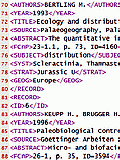 Abstract: Small databases, i.e., with less than 15,000 entries, are
sometimes handled using
inappropriate, complex, and often expensive data management systems. We
present and briefly discuss a few types of proprietary and open-source,
relational and non-relational, server-based versus portable databases and
specific tools to handle the latter. With a collection of nearly
7,000 bibliographic notes during its 40-year history "Fossil Cnidaria &
Porifera (FC&P)", the newsletter of the "International Association for Study
of Fossil Cnidaria and Porifera", was chosen as a case study. The analysis of the
temporal trends in the FC&P bibliographic database shows a decrease over the
years in the number of publications effectively reported in FC&P. Almost all
relevant papers for the decade 1981-1990 are reported, but this good
coverage ratio falls down to less than 50% after 2000; accordingly, the concern about the
data representativeness is addressed in our interpretation. Besides the classical
database management systems and spreadsheet software, which were originally used
with the FC&P case study, we present two discrete,
open-source, flat and portable options where data can be displayed using any
widely available Internet browser, and that are suitable to handle most small
databases (XML or JS files) as documented herein. Abstract: Small databases, i.e., with less than 15,000 entries, are
sometimes handled using
inappropriate, complex, and often expensive data management systems. We
present and briefly discuss a few types of proprietary and open-source,
relational and non-relational, server-based versus portable databases and
specific tools to handle the latter. With a collection of nearly
7,000 bibliographic notes during its 40-year history "Fossil Cnidaria &
Porifera (FC&P)", the newsletter of the "International Association for Study
of Fossil Cnidaria and Porifera", was chosen as a case study. The analysis of the
temporal trends in the FC&P bibliographic database shows a decrease over the
years in the number of publications effectively reported in FC&P. Almost all
relevant papers for the decade 1981-1990 are reported, but this good
coverage ratio falls down to less than 50% after 2000; accordingly, the concern about the
data representativeness is addressed in our interpretation. Besides the classical
database management systems and spreadsheet software, which were originally used
with the FC&P case study, we present two discrete,
open-source, flat and portable options where data can be displayed using any
widely available Internet browser, and that are suitable to handle most small
databases (XML or JS files) as documented herein.
|
|
Carnets Geol., vol. 15, no. 2, p. 13-19
Online since January 14, 2015
|
|
Lower Aptian ammonites of the Sierra de Parras, Coahuila State, northern Mexico
José R. OVANDO-FIGUEROA, Josep A. MORENO-BEDMAR Gabriel, CHÁVEZ-CABELLO & Keith P. MINOR
| HTML  | PDF
| PDF  [2,356 KB]
| DOI: 10.4267/2042/56250 [2,356 KB]
| DOI: 10.4267/2042/56250
|
|
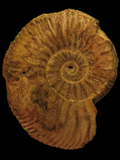 Abstract: We report an
interesting Aptian ammonite record from the La Peña Formation in the Sierra de
Parras, Coahuila State. This assemblage is analyzed from a paleoecological
perspective. It contains the first reported occurrence of a macroconch of Dufrenoyia
from Mexico, and the largest known specimen of 'Gargasiceras'
adkinsi. Such an assemblage yielding
large ammonites is unusual in deposits of this age in Mexico. To properly
document this ammonite record, we review 'Gargasiceras'
adkinsi, formerly misidentified as Rhytidoplites
robertsi, and allied taxa. From our analysis, we conclude that 'Gargasiceras'
adkinsi exhibits strong intraspecific
variability. We also analyze in detail the differences that exist between 'Gargasiceras'
adkinsi and Rhytidoplites
robertsi, and emend the concept of the genus Rhytidoplites. These revisions are important from a biostratigraphic
point of view since 'Gargasiceras'
adkinsi is an index species for the
lower Aptian ammonite zonation of Mexico. Abstract: We report an
interesting Aptian ammonite record from the La Peña Formation in the Sierra de
Parras, Coahuila State. This assemblage is analyzed from a paleoecological
perspective. It contains the first reported occurrence of a macroconch of Dufrenoyia
from Mexico, and the largest known specimen of 'Gargasiceras'
adkinsi. Such an assemblage yielding
large ammonites is unusual in deposits of this age in Mexico. To properly
document this ammonite record, we review 'Gargasiceras'
adkinsi, formerly misidentified as Rhytidoplites
robertsi, and allied taxa. From our analysis, we conclude that 'Gargasiceras'
adkinsi exhibits strong intraspecific
variability. We also analyze in detail the differences that exist between 'Gargasiceras'
adkinsi and Rhytidoplites
robertsi, and emend the concept of the genus Rhytidoplites. These revisions are important from a biostratigraphic
point of view since 'Gargasiceras'
adkinsi is an index species for the
lower Aptian ammonite zonation of Mexico.
|
|
Carnets Geol., vol. 15, no. 1, p. 1-11
Online since January 14, 2015
|

|
|
2014 (vol. 14)
|
|
In memoriam of my colleague and friend Guy Tronchetti (1938-2014)
Michel MOULLADE
| HTML  | PDF
| PDF  [112 KB]
| DOI:
10.4267/2042/56047
[112 KB]
| DOI:
10.4267/2042/56047
|
|
 The chief editor of a prestigious scientific journal, who is about to publish a major article of which Guy is one of the lead authors, replied to the news of his passing:
"I am very sorry to hear about that. I have known Guy Tronchetti from publications, for a long time. It is really
sad." This quote and Googling his name show that, according to his publications, some of them very recent, Guy was still both at the cutting edges of research and a scientist at an international level. His great modesty did not allow people to necessarily acknowledge this, especially those who did not attempt to overcome such an obstacle. (...) The chief editor of a prestigious scientific journal, who is about to publish a major article of which Guy is one of the lead authors, replied to the news of his passing:
"I am very sorry to hear about that. I have known Guy Tronchetti from publications, for a long time. It is really
sad." This quote and Googling his name show that, according to his publications, some of them very recent, Guy was still both at the cutting edges of research and a scientist at an international level. His great modesty did not allow people to necessarily acknowledge this, especially those who did not attempt to overcome such an obstacle. (...)
|
|
Carnets Geol., vol. 14, Obituary notice, p. 483-487
Manuscript online since December 24, 2014
|
|
Significance of partial leaching in calcareous ooids: The case study of Hauterivian oolites in Switzerland
Bruno GRANIER, Vincent BARBIN & Jean CHAROLLAIS
| HTML  | PDF
| PDF  [1,312 KB]
| DOI:
10.4267/2042/56045 [1,312 KB]
| DOI:
10.4267/2042/56045
|
|
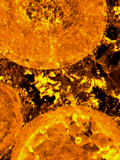 Abstract: In the Canton of Vaud (Switzerland), two Hauterivian oolitic units were penetrated by a borehole. In both units, the ooids are partly leached. More specifically, the ooid cortices were partly leached and some ooid nuclei appear suspended in the middle of cortical moldic cavities created by leaching, rather than having fallen to the bottom of these cavities before the final cementation take place. We demonstrate that these ooids were originally calcitic, not aragonitic, not "two-phase" nor "bimineral". This leaching is not an early diagenetic feature related to subaerial exposure, but a late diagenetic feature, possibly related to the migration of acidic pore waters, brought about by Alpine tectonics and/or karstification. Abstract: In the Canton of Vaud (Switzerland), two Hauterivian oolitic units were penetrated by a borehole. In both units, the ooids are partly leached. More specifically, the ooid cortices were partly leached and some ooid nuclei appear suspended in the middle of cortical moldic cavities created by leaching, rather than having fallen to the bottom of these cavities before the final cementation take place. We demonstrate that these ooids were originally calcitic, not aragonitic, not "two-phase" nor "bimineral". This leaching is not an early diagenetic feature related to subaerial exposure, but a late diagenetic feature, possibly related to the migration of acidic pore waters, brought about by Alpine tectonics and/or karstification.
|
|
Carnets Geol., vol. 14, no. 22, p. 471-481
Published online in final form (pdf) on December 24, 2014
|
|
Borings and etchings in the Upper Bathonian-Lower Callovian oolite of the Paris Basin (France)
Bruno GRANIER
| HTML  | PDF
| PDF  [1,250 KB]
| DOI:
10.4267/2042/56043 [1,250 KB]
| DOI:
10.4267/2042/56043
|
|
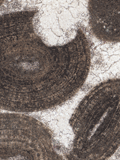 Abstract: The
oolite of the "Dalle Nacrée" Formation in the Paris Basin is made of marine
calcareous ooids with, from base to top, radial (and therefore likely to have
been calcite), concentric and micritic fabrics, each corresponding to a discrete
stratigraphic unit. Several hardgrounds and oolitic pebble-cobble layers in the succession are encrusted and bored. Three
main types of boring have been identified ranging in sizes from some tens
of µm (sponge borings) to centimeters (bivalve borings), with an intermediate
category (worm borings). Some worm borings have rough walls, where early marine
fibrous cement is less corroded than the cortices of cemented ooids. The key to
understanding this differential dissolution could be related to organic matter,
present within the ooid cortices but lacking in the fibrous cement. Polychaete
worms that use chemical means (enzymes or acids) to bore are probably
responsible for these peculiar borings. A secondary conclusion is that partly or fully leached ooid cortices do not necessarily
indicate an original aragonitic mineralogy of the dissolved parts. Abstract: The
oolite of the "Dalle Nacrée" Formation in the Paris Basin is made of marine
calcareous ooids with, from base to top, radial (and therefore likely to have
been calcite), concentric and micritic fabrics, each corresponding to a discrete
stratigraphic unit. Several hardgrounds and oolitic pebble-cobble layers in the succession are encrusted and bored. Three
main types of boring have been identified ranging in sizes from some tens
of µm (sponge borings) to centimeters (bivalve borings), with an intermediate
category (worm borings). Some worm borings have rough walls, where early marine
fibrous cement is less corroded than the cortices of cemented ooids. The key to
understanding this differential dissolution could be related to organic matter,
present within the ooid cortices but lacking in the fibrous cement. Polychaete
worms that use chemical means (enzymes or acids) to bore are probably
responsible for these peculiar borings. A secondary conclusion is that partly or fully leached ooid cortices do not necessarily
indicate an original aragonitic mineralogy of the dissolved parts.
|
|
Carnets Geol., vol. 14, no. 21, p. 461-469
Published online in final form (pdf) on December 24, 2014
|
|
Devonian Phillipsastreid tetracorals of the genus Rozkowskaella from the Holy Cross Mountains, Poland
Tomasz WRZOŁEK
| HTML  | PDF
| PDF  [9,340 KB]
| DOI:
10.4267/2042/56041 [9,340 KB]
| DOI:
10.4267/2042/56041
|
|
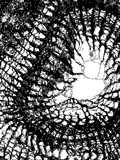 Abstract: Solitary or weakly colonial Phillipsastreid tetracorals of the Upper Frasnian of Holy Cross
Mountains, Poland, with triangular to oval shape of transverse-section and tendency towards reduction of the horseshoe
dissepiments, are included here in the genus Rozkowskaella, with Rozkowskaella sandaliformis, R. cf. sandaliformis and Rozkowskaella sp. Abstract: Solitary or weakly colonial Phillipsastreid tetracorals of the Upper Frasnian of Holy Cross
Mountains, Poland, with triangular to oval shape of transverse-section and tendency towards reduction of the horseshoe
dissepiments, are included here in the genus Rozkowskaella, with Rozkowskaella sandaliformis, R. cf. sandaliformis and Rozkowskaella sp.
|
|
Carnets Geol., vol. 14, no. 20, p. 439-459
Published online in final form (pdf) on December 24, 2014
|
|
Two new species of Early Pleistocene marine ostracods from Southeast Sicily
Francesco SCIUTO
| HTML  | PDF
| PDF  [1,769 KB]
| DOI:
10.4267/2042/56039 [1,769 KB]
| DOI:
10.4267/2042/56039
|
|
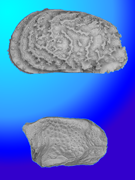 Abstract: Two fossil species of Ostracoda belonging to the genera Urocythereis Ruggieri,
1950, and Semicytherura Wagner,
1957, discovered in the Lower Pleistocene shallow marine sandy-silty sediments outcropping at
"Cartiera Molino" (F. 276, IV NO, Vittoria, Southeast Sicily) are described and figured. Abstract: Two fossil species of Ostracoda belonging to the genera Urocythereis Ruggieri,
1950, and Semicytherura Wagner,
1957, discovered in the Lower Pleistocene shallow marine sandy-silty sediments outcropping at
"Cartiera Molino" (F. 276, IV NO, Vittoria, Southeast Sicily) are described and figured.
|
|
Carnets Geol., vol. 14, no. 19, p. 429-437
Published online in final form (pdf) on December 24, 2014
|
|
Revision of "Falaise de Blanche" (Lower Cretaceous) in Lebanon, with the definition of a Jezzinian Regional Stage
Sibelle MAKSOUD, Bruno GRANIER, Dany AZAR, Raymond GÈZE, Jean-Claude PAICHELER & Josep A. MORENO-BEDMAR
| HTML  | PDF
| PDF  [4,404 KB]
| DOI:
10.4267/2042/54359 [4,404 KB]
| DOI:
10.4267/2042/54359
|
|
 Abstract: The "Falaise de Blanche"
is a prominent cliff, consisting mostly of Lower Cretaceous limestones that extends as linear outcrops over most of the Lebanese territory and provides geologists a remarkable reference for stratigraphic studies. However, until now, this unit was lacking a clear definition. We introduce herein the Jezzinian Regional Stage, the type-locality of which is
at Jezzine. It equates as an unconformity-bounded unit and, per definition, it is framed by two discontinuities. Because we identified an additional, median sequence-boundary, poorly-expressed in the type-section but better at
Aazour, only 4.5 km westward of Jezzine, the new regional stage implicitly spans two sequences. The lithostratigraphic framework being properly redefined, we were able to investigate time-constrained micropaleontological assemblages, consisting mostly of benthic foraminifers and calcareous algae. Typically Southern
Tethysian, these assemblages contribute to high-resolution, holostratigraphic correlations with the Persian Gulf area, on the
eastern part of the Arabian Plate. The Jezzinian interval correlates with the upper part of the Kharaibian Regional Stage (also known as "Thamama II" reservoir unit in the oil industry). In turn, the Jezzinian is indirectly correlated with the Northern Tethysian Urgonian stratigraphic units where it corresponds to a rather short interval encompassing the standard Barremian - Bedoulian stage boundary. Locally the upper discontinuity is associated to a significant intra-Bedoulian hiatus. The macrofossil assemblages found in the Jezzinian (echinids) and above it (ammonites) support, or at least do not contradict, our micropaleontological dating. Abstract: The "Falaise de Blanche"
is a prominent cliff, consisting mostly of Lower Cretaceous limestones that extends as linear outcrops over most of the Lebanese territory and provides geologists a remarkable reference for stratigraphic studies. However, until now, this unit was lacking a clear definition. We introduce herein the Jezzinian Regional Stage, the type-locality of which is
at Jezzine. It equates as an unconformity-bounded unit and, per definition, it is framed by two discontinuities. Because we identified an additional, median sequence-boundary, poorly-expressed in the type-section but better at
Aazour, only 4.5 km westward of Jezzine, the new regional stage implicitly spans two sequences. The lithostratigraphic framework being properly redefined, we were able to investigate time-constrained micropaleontological assemblages, consisting mostly of benthic foraminifers and calcareous algae. Typically Southern
Tethysian, these assemblages contribute to high-resolution, holostratigraphic correlations with the Persian Gulf area, on the
eastern part of the Arabian Plate. The Jezzinian interval correlates with the upper part of the Kharaibian Regional Stage (also known as "Thamama II" reservoir unit in the oil industry). In turn, the Jezzinian is indirectly correlated with the Northern Tethysian Urgonian stratigraphic units where it corresponds to a rather short interval encompassing the standard Barremian - Bedoulian stage boundary. Locally the upper discontinuity is associated to a significant intra-Bedoulian hiatus. The macrofossil assemblages found in the Jezzinian (echinids) and above it (ammonites) support, or at least do not contradict, our micropaleontological dating.
|
|
Carnets Geol., vol. 14, no. 18, p. 401-427
Published online in final form (pdf) on November 14, 2014
|
|
The genera Subgrossouvria Spath and Orionoides Spath (Ammonitina, Perisphinctidae) from the Leckenbyi Horizon (Upper Callovian, Athleta Zone) of Montreuil-Bellay (Maine-et-Loire, France)
Alain BONNOT, Pierre-Yves BOURSICOT & Patrice FERCHAUD
| HTML  | PDF
| PDF  [11,574 KB]
| DOI:
10.4267/2042/54363 [11,574 KB]
| DOI:
10.4267/2042/54363
|
|
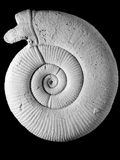 Abstract: In the Montreuil-Bellay area (Maine-et-Loire, France), the lowermost bed of the Upper Callovian (Leckenbyi Horizon) contains a very abundant ammonite fauna (N=3275).
The Family Perisphinctidae is represented by Choffatia isabellae Bonnot et al., the
genus Pseudopeltoceras Spath, the genus Subgrossouvria Spath,
which includes S. famula (Bean in Spath) and S. crassa Gérard & Contaut,
and the genus Orionoides Spath, which comprises O. indicus Spath. Thanks to the abundance and quality of the material, it was possible to describe and figure macroconchs and microconchs of these three species, including adult specimens with preserved peristome. The stratigraphical ranges of these
taxa are also specified and their potential descendants can be considered. These species are unknown in the uppermost Middle Callovian, and we assume that they
colonized the northwestern part of the European platform via the southern margin of the Tethys, as
did Peltoceras marysae Bonnot et al. and Choffatia isabellae Bonnot et al. Abstract: In the Montreuil-Bellay area (Maine-et-Loire, France), the lowermost bed of the Upper Callovian (Leckenbyi Horizon) contains a very abundant ammonite fauna (N=3275).
The Family Perisphinctidae is represented by Choffatia isabellae Bonnot et al., the
genus Pseudopeltoceras Spath, the genus Subgrossouvria Spath,
which includes S. famula (Bean in Spath) and S. crassa Gérard & Contaut,
and the genus Orionoides Spath, which comprises O. indicus Spath. Thanks to the abundance and quality of the material, it was possible to describe and figure macroconchs and microconchs of these three species, including adult specimens with preserved peristome. The stratigraphical ranges of these
taxa are also specified and their potential descendants can be considered. These species are unknown in the uppermost Middle Callovian, and we assume that they
colonized the northwestern part of the European platform via the southern margin of the Tethys, as
did Peltoceras marysae Bonnot et al. and Choffatia isabellae Bonnot et al.
|
|
Carnets Geol., vol. 14, no. 17, p. 351-399
Published online in final form (pdf) on November 14, 2014
|
|
Nannofossils and foraminifera from the Salamanca Formation (Paleocene) in Punta Peligro Norte (Chubut, Argentina)
Margarita SIMEONI
| HTML  | PDF
| PDF  [1,700 KB]
| DOI:
10.4267/2042/54361 [1,700 KB]
| DOI:
10.4267/2042/54361
|
|
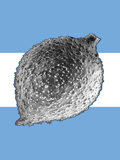 Abstract: An assemblage of nannofossils from the Salamanca Formation is reported for the first time from the Punta Peligro Norte locality in the San Jorge Gulf Basin, Argentina. Several recognized nannofossils have a stratigraphic distribution within the lower Danian. The assemblage of nannofossils and associated foraminifera is here discussed taking into account biostratigraphic and paleoecological
aspects. Abstract: An assemblage of nannofossils from the Salamanca Formation is reported for the first time from the Punta Peligro Norte locality in the San Jorge Gulf Basin, Argentina. Several recognized nannofossils have a stratigraphic distribution within the lower Danian. The assemblage of nannofossils and associated foraminifera is here discussed taking into account biostratigraphic and paleoecological
aspects.
|
|
Carnets Geol., vol. 14, no. 16, p. 343-349
Published online in final form (pdf) on November 14, 2014
|
|
Ostracodes from the Upper Cretaceous deposits of the Potiguar Basin, northeastern Brazil: taxonomy, paleoecology and paleobiogeography. Part 2: Santonian-Campanian
Enelise K. PIOVESAN, Maria Cristina CABRAL, Jean-Paul COLIN, Gerson FAUTH & Cristianini TRESCASTRO BERGUE
| HTML  | PDF
| PDF  [8,480 KB]
| DOI:
10.4267/2042/54151
[8,480 KB]
| DOI:
10.4267/2042/54151
|
|
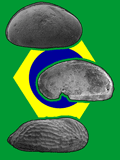 Abstract: Sixty-four Ostracoda taxa were recorded from the Santonian–Campanian of Potiguar Basin, northeastern Brazil. The following new species were described: Triebelina anterotuberculata, Triebelina obliquocostata, Cophinia ovalis, Fossocytheridea potiguarensis, Ovocytheridea anterocompressa, Ovocytheridea triangularis, Perissocytheridea jandairensis, Semicytherura musacchioi and Protocosta babinoti. The faunal association indicates predominantly shallow marine environments, intercalated with typically mixohaline levels. These species are mostly endemic, although the presence of six species common to West and North Africa shows that migration was still possible by the end of the Cretaceous. Abstract: Sixty-four Ostracoda taxa were recorded from the Santonian–Campanian of Potiguar Basin, northeastern Brazil. The following new species were described: Triebelina anterotuberculata, Triebelina obliquocostata, Cophinia ovalis, Fossocytheridea potiguarensis, Ovocytheridea anterocompressa, Ovocytheridea triangularis, Perissocytheridea jandairensis, Semicytherura musacchioi and Protocosta babinoti. The faunal association indicates predominantly shallow marine environments, intercalated with typically mixohaline levels. These species are mostly endemic, although the presence of six species common to West and North Africa shows that migration was still possible by the end of the Cretaceous.
|
|
Carnets Geol., vol. 14, no. 15, p. 315-341
Published online in final form (pdf) on October 14, 2014
|
|
Temporal and latitudinal trends in the biodiversity of European Atlantic Cenozoic gastropod (Mollusca) faunas. A base for the history of biogeographic provinces
Pierre LOZOUET
| HTML  | PDF
| PDF  [2,328 KB]
| DOI:
10.4267/2042/54150
[2,328 KB]
| DOI:
10.4267/2042/54150
|
|
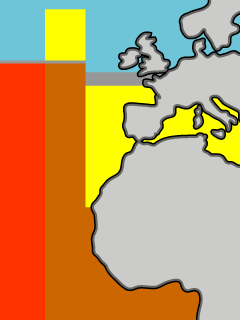 Abstract: A general overview of the biodiversity of the marine fauna during the Tertiary period is developed in the context of the biogeographical evolution of the European realm. This study combines a reappraisal of the literature with a unique first-hand source of data on the richest marine group (the gastropods) from over a 25 million year period (Early Oligocene to Late Miocene). In total the French deposits have yielded more than 10,000 species from the Eocene to the
Upper Miocene. Evidence of significant bias in the fossil record is pointed out for the Palaeocene (Danian) and Upper Eocene
(Priabonian). For the period considered (Palaeocene to Late Miocene, ca 50 million years) the second highest diversity is reported in the Late Oligocene. This study reveals also the importance of pre-Miocene extinctions of genera. The Oligocene was when the latitudinal differentiation of the faunas was greatest. The local generic gastropod richness ranges from 59 (Rupelian of Belgium) to 494 (Chattian of
Aquitaine). A clear trend towards homogenization appears in the Late Oligocene which leads
to the development of a vast biogeographical region named Euro-West Africa. This faunal evolutionary pattern has never been demonstrated before and is a novel feature of the biogeography of the Eastern-Atlantic region. Abstract: A general overview of the biodiversity of the marine fauna during the Tertiary period is developed in the context of the biogeographical evolution of the European realm. This study combines a reappraisal of the literature with a unique first-hand source of data on the richest marine group (the gastropods) from over a 25 million year period (Early Oligocene to Late Miocene). In total the French deposits have yielded more than 10,000 species from the Eocene to the
Upper Miocene. Evidence of significant bias in the fossil record is pointed out for the Palaeocene (Danian) and Upper Eocene
(Priabonian). For the period considered (Palaeocene to Late Miocene, ca 50 million years) the second highest diversity is reported in the Late Oligocene. This study reveals also the importance of pre-Miocene extinctions of genera. The Oligocene was when the latitudinal differentiation of the faunas was greatest. The local generic gastropod richness ranges from 59 (Rupelian of Belgium) to 494 (Chattian of
Aquitaine). A clear trend towards homogenization appears in the Late Oligocene which leads
to the development of a vast biogeographical region named Euro-West Africa. This faunal evolutionary pattern has never been demonstrated before and is a novel feature of the biogeography of the Eastern-Atlantic region.
|
|
Carnets Geol., vol. 14, no. 14, p. 273-314
Published online in final form (pdf) on October 14, 2014
|
|
Origin of the Tethyan Hemihoplitidae tested with cladistics (Ancyloceratina, Ammonoidea, Early Cretaceous): an immigration event?
Didier BERT & Stéphane BERSAC
| HTML  | PDF
| PDF  [612 KB]
| DOI:
10.4267/2042/54149
[612 KB]
| DOI:
10.4267/2042/54149
|
|
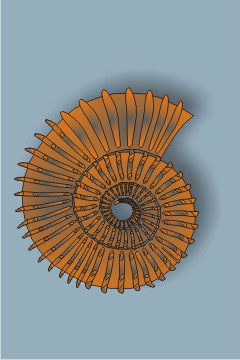 Abstract: The Late Barremian Hemihoplitidae (Ancyloceratina, Ammonoidea) are
widely known in the northern Tethyan Margin and the Essaouira-Agadir Basin (Morocco). Their rapid evolution and diversification make them one of the key groups for that period, but their origin remains
poorly known and several competing hypotheses have been published. These hypotheses are tested here with cladistic analysis in order to reject those receiving the least support and discuss
those well supported. The analysis discards the Crioceratitidae, Emericiceratidae (Emericiceras and Honnoratia) and Toxancyloceras as stem-groups of the Hemihoplitidae (Gassendiceras). The Toxancyloceras appear
instead to be a sister-taxon of the Moutoniceras, so we propose the latter to be classified
with the Ancyloceratidae rather than with the Heteroceratidae. The best supported hypothesis assumes that the Hemihoplitidae first appeared suddenly in the Essaouira-Agadir Basin at the end of the Early Barremian from small populations of
Boreal Paracrioceras. These latter could have migrated southward episodically before invading the northern Tethyan margin at the beginning of the Late Barremian. As a consequence, the Paracrioceratidae fam. nov. is proposed to
include the Boreal groups Fissicostaticeras / Paracrioceras / Parancyloceras, and Gassendiceras essaouirae sp. nov. is proposed as a new name for the Moroccan endemic "Barrancyloceras" maghrebiense sensu Company et al.,
2008, non Immel, 1978. Abstract: The Late Barremian Hemihoplitidae (Ancyloceratina, Ammonoidea) are
widely known in the northern Tethyan Margin and the Essaouira-Agadir Basin (Morocco). Their rapid evolution and diversification make them one of the key groups for that period, but their origin remains
poorly known and several competing hypotheses have been published. These hypotheses are tested here with cladistic analysis in order to reject those receiving the least support and discuss
those well supported. The analysis discards the Crioceratitidae, Emericiceratidae (Emericiceras and Honnoratia) and Toxancyloceras as stem-groups of the Hemihoplitidae (Gassendiceras). The Toxancyloceras appear
instead to be a sister-taxon of the Moutoniceras, so we propose the latter to be classified
with the Ancyloceratidae rather than with the Heteroceratidae. The best supported hypothesis assumes that the Hemihoplitidae first appeared suddenly in the Essaouira-Agadir Basin at the end of the Early Barremian from small populations of
Boreal Paracrioceras. These latter could have migrated southward episodically before invading the northern Tethyan margin at the beginning of the Late Barremian. As a consequence, the Paracrioceratidae fam. nov. is proposed to
include the Boreal groups Fissicostaticeras / Paracrioceras / Parancyloceras, and Gassendiceras essaouirae sp. nov. is proposed as a new name for the Moroccan endemic "Barrancyloceras" maghrebiense sensu Company et al.,
2008, non Immel, 1978.
|
|
Carnets Geol., vol. 14, no. 13, p. 255-272
Published online in final form (pdf) on October 14, 2014
|
|
Ostracodes from the Upper Cretaceous deposits of the Potiguar Basin, northeastern Brazil: taxonomy, paleoecology and paleobiogeography. Part 1: Turonian
Enelise K. PIOVESAN, Maria Cristina CABRAL, Jean-Paul COLIN, Gerson FAUTH & Cristianini TRESCASTRO BERGUE
| HTML  | PDF
| PDF  [7,882 KB]
| DOI:
10.4267/2042/54003 [7,882 KB]
| DOI:
10.4267/2042/54003
|
|
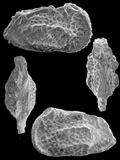 Abstract: This paper describes thirteen new species and
two new genera of marine and brackish water ostracodes from the Turonian
deposits of Potiguar Basin, NE Brazil, among a total of 53 taxa. The new
species include Cophinia grekoffi, Fossocytheridea tiberti, Haughtonileberis dinglei, Hemicytherura viviersae,
Jandairella obesa (new genus and species), Loxocorniculum? narendrai, Ovocytheridea posteroprojecta, O. reymenti, Perissocytheridea caudata,
P. mossoroensis, Potiguarella grosdidieri (new genus and species), P. coimbrai and Procytherura ballentae.
The diversity and dominance indexes vary according to the paleoenvironment.
Three assemblages were identified: a predominantly mixohaline fauna in the
basal part of the section, followed by a diversified shallow marine fauna and,
in the upper part, a marine and brackish water ostracode fauna. Most of the
recorded species are endemic. Eight species are common to Northwest and North
Africa, indicating a faunal link during the Turonian. The study of the Turonian
faunas of the Potiguar Basin represents a significant improvement to understand
the dynamic evolution of the Brazilian basins and the paleobiogeographical
relationship with other regions. Abstract: This paper describes thirteen new species and
two new genera of marine and brackish water ostracodes from the Turonian
deposits of Potiguar Basin, NE Brazil, among a total of 53 taxa. The new
species include Cophinia grekoffi, Fossocytheridea tiberti, Haughtonileberis dinglei, Hemicytherura viviersae,
Jandairella obesa (new genus and species), Loxocorniculum? narendrai, Ovocytheridea posteroprojecta, O. reymenti, Perissocytheridea caudata,
P. mossoroensis, Potiguarella grosdidieri (new genus and species), P. coimbrai and Procytherura ballentae.
The diversity and dominance indexes vary according to the paleoenvironment.
Three assemblages were identified: a predominantly mixohaline fauna in the
basal part of the section, followed by a diversified shallow marine fauna and,
in the upper part, a marine and brackish water ostracode fauna. Most of the
recorded species are endemic. Eight species are common to Northwest and North
Africa, indicating a faunal link during the Turonian. The study of the Turonian
faunas of the Potiguar Basin represents a significant improvement to understand
the dynamic evolution of the Brazilian basins and the paleobiogeographical
relationship with other regions.
|
|
Carnets Geol., vol. 14, no. 12, p. 211-252
Published online in final form (pdf) on July 3, 2014
|
|
Erratum: The
table rows of Appendix 2 (i.e.,
"Distribution of the ostracode species, with their abundances") should
have included numbers.
|
|
Format [PDF
78 KB]
Online since July 27, 2014
|
|
First record of lowermost Cretaceous shallow-water limestones in the basement of the Transylvanian Depression (Romania)
Ioan I. BUCUR, Adriana PĂCURARIU, Emanoil SĂSĂRAN, Sorin FILIPESCU & Rodica FILIPESCU
| HTML  | PDF
| PDF  [1,655 KB]
| DOI:
10.4267/2042/54001 [1,655 KB]
| DOI:
10.4267/2042/54001
|
|
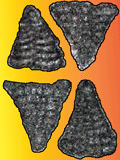 Abstract: Triassic,
Upper Jurassic and upper Lower Cretaceous sedimentary formations were previously
studied from the Transylvanian Depression basement, but the presence of
lowermost Cretaceous (Berriasian-Valanginian) has not been confirmed paleontologically. The carbonate sequence cored from a borehole drilled in the
central part of the Transylvanian Depression yields microfossil assemblages dominated by benthic
foraminifera. These new data unequivocally document the presence of characteristic Berriasian-Valanginian
taxa in these deposits. Abstract: Triassic,
Upper Jurassic and upper Lower Cretaceous sedimentary formations were previously
studied from the Transylvanian Depression basement, but the presence of
lowermost Cretaceous (Berriasian-Valanginian) has not been confirmed paleontologically. The carbonate sequence cored from a borehole drilled in the
central part of the Transylvanian Depression yields microfossil assemblages dominated by benthic
foraminifera. These new data unequivocally document the presence of characteristic Berriasian-Valanginian
taxa in these deposits.
|
|
Carnets Geol., vol. 14, no. 11, p. 199-210
Published online in final form (pdf) on July 3, 2014
|
|
Erratum: The
table rows of Appendix 2 (i.e.,
"Distribution of the ostracode species, with their abundances") should
have included numbers.
|
|
Format [PDF
78 KB]
Online since July 27, 2014
|
|
A new type of entombment of Peronopsis (Agnostida) in a hyolithid conch
Oldřich FATKA & Vladislav KOZÁK
| HTML  | PDF
| PDF  [592 KB]
| DOI:
10.4267/2042/54000 [592 KB]
| DOI:
10.4267/2042/54000
|
|
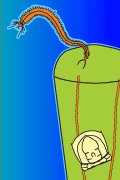 Abstract: An enrolled exoskeleton of the holaspid specimen of a tiny agnostid Peronopsis integra (Beyrich,
1845) entombed inside a conch of the hyolithid ?Buchavalites sp. is described from the middle Cambrian (Drumian) Jince Formation of the Příbram-Jince Basin (Czech Republic). The agnostid is associated with an ichnofossil of the feeding trace classified as Arachnostega-type behaviour. The enrolled attitude of the agnostid exoskeleton suggests that the specimen is a carcass rather than moult. Either the storm disturbance and/or well-protected source of food
hypotheses could explain the entombed agnostid. This additional example supports a benthic mode of life in the agnostid P. integra. The studied association of feeding tunnels of an unknown Arachnostega-strategist and Peronopsis preserved inside a hyolithid conch is a case of "frozen" behaviour. Abstract: An enrolled exoskeleton of the holaspid specimen of a tiny agnostid Peronopsis integra (Beyrich,
1845) entombed inside a conch of the hyolithid ?Buchavalites sp. is described from the middle Cambrian (Drumian) Jince Formation of the Příbram-Jince Basin (Czech Republic). The agnostid is associated with an ichnofossil of the feeding trace classified as Arachnostega-type behaviour. The enrolled attitude of the agnostid exoskeleton suggests that the specimen is a carcass rather than moult. Either the storm disturbance and/or well-protected source of food
hypotheses could explain the entombed agnostid. This additional example supports a benthic mode of life in the agnostid P. integra. The studied association of feeding tunnels of an unknown Arachnostega-strategist and Peronopsis preserved inside a hyolithid conch is a case of "frozen" behaviour.
|
|
Carnets Geol., vol. 14, no. 10, p. 191-198
Published online in final form (pdf) on July 3, 2014
|
|
The Cretaceous-Paleogene boundary and its 405-kyr eccentricity cycle phase: a new constraint on radiometric dating and astrochronology
Michel HENNEBERT
| HTML  | PDF
| PDF  [547 KB]
| DOI:
10.4267/2042/53981 [547 KB]
| DOI:
10.4267/2042/53981
|
|
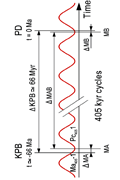 Abstract: Radiometric dating and astrochronologic dating still suffer discrepancies without knowing which one gives the most reliable results. A new tool is proposed to constrain both the approaches. The phase of the 405-kyr signal with respect to the Cretaceous - Paleogene boundary event has been determined in the Aïn Settara section (Kalaat Senan, central Tunisia). We use this phase value (Option 2), as well as an average of phase values obtained from the literature (Option 1), to examine the relationship linking both the radiometric (absolute) age assigned to the K-Pg boundary and the Cenozoic average-value of the ~405-kyr eccentricity period. A new useful constraint emerges: to any absolute age assumed for the K-Pg boundary corresponds a value of the mean Cenozoic 405-kyr period, and vice versa. Abstract: Radiometric dating and astrochronologic dating still suffer discrepancies without knowing which one gives the most reliable results. A new tool is proposed to constrain both the approaches. The phase of the 405-kyr signal with respect to the Cretaceous - Paleogene boundary event has been determined in the Aïn Settara section (Kalaat Senan, central Tunisia). We use this phase value (Option 2), as well as an average of phase values obtained from the literature (Option 1), to examine the relationship linking both the radiometric (absolute) age assigned to the K-Pg boundary and the Cenozoic average-value of the ~405-kyr eccentricity period. A new useful constraint emerges: to any absolute age assumed for the K-Pg boundary corresponds a value of the mean Cenozoic 405-kyr period, and vice versa.
Supposing a K-Pg boundary radiometric age in the vicinity of 66.0 Ma, then the number of entire cycles (comprised between two minima of the 405-kyr eccentricity signal) within the Cenozoic Period could only be equal to 163. When adding to this figure the parts of the cycles preceding and following these 163 entire cycles the total duration of the Cenozoic Era becomes equal to 163.168 cycles (Option 1) or 163.081 cycles (Option 2).
We propose to grant a special interest to the determination of the 405-kyr cycle phase at stratigraphically well documented levels, particularly those that correspond to world-wide, sudden and catastrophic events, that are well located in time by reliable radiometric dates.
|
|
Carnets Geol., vol. 14, no. 9, p. 173-189
Published online in final form (pdf) on June 19, 2014
|
|
Novocrania turbinata synonym of N. anomala
Christian C. EMIG
| HTML  | PDF
| PDF  [2,664 KB]
| DOI:
10.4267/2042/53979 [2,664 KB]
| DOI:
10.4267/2042/53979
|
|
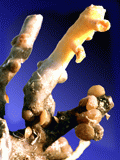 Abstract: Anomia turbinata, or conical Anomia (= Novocrania turbinata), was described by Poli
(1795) in the
bathyal environment off the coast of the Kingdom of the Two Sicilies, Patella anomala Müller, 1776 (= N. anomala)
being considered a synonym. The history of this species, commonly considered as the Mediterranean form of N. anomala,
will be described. Recently, several authors have described N. turbinata as a valid species on the basis of shell variations,
as compared to N. anomala. After analysis of the taxonomic
validity of these characters, both species are considered as
synonymous. That is supported by their occurrence in various localities, mainly
in the continental shelf. Their synonymy has been corroborated by molecular
analyses and is discussed with reference to the characteristics of the Mediterranean basins and their history since the
Miocene. Abstract: Anomia turbinata, or conical Anomia (= Novocrania turbinata), was described by Poli
(1795) in the
bathyal environment off the coast of the Kingdom of the Two Sicilies, Patella anomala Müller, 1776 (= N. anomala)
being considered a synonym. The history of this species, commonly considered as the Mediterranean form of N. anomala,
will be described. Recently, several authors have described N. turbinata as a valid species on the basis of shell variations,
as compared to N. anomala. After analysis of the taxonomic
validity of these characters, both species are considered as
synonymous. That is supported by their occurrence in various localities, mainly
in the continental shelf. Their synonymy has been corroborated by molecular
analyses and is discussed with reference to the characteristics of the Mediterranean basins and their history since the
Miocene.
|
|
Carnets Geol., vol. 14, no. 8, p. 159-171
Published online in final form (pdf) on June 19, 2014
|
|
Heydrichia (?) poignantii, sp. nov. (Sporolithaceae, Sporolithales, Rhodophyta), a 100 million year old fossil coralline red alga from north-eastern Brazil, and a new Hauterivian record of Sporolithon from Switzerland
William J. WOELKERLING, Bruno GRANIER & Dimas DIAS-BRITO
| HTML  | PDF
| PDF  [4,062 KB]
| DOI:
10.4267/2042/53736 [4,062 KB]
| DOI:
10.4267/2042/53736
|
|
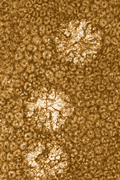 Abstract: Fossil
specimens of Heydrichia (?) poignantii, sp. nov. (Sporolithaceae,
Sporolithales, Rhodophyta), representing the first confirmation of the genus in
the fossil record, were discovered in thin sections of Albian limestones from
the Riachuelo Formation, Sergipe Basin, and in thin sections of Albian -
Cenomanian limestones from the Ponta do Mel Formation, Potiguar Basin in
north-eastern Brazil. A detailed morphological-anatomical account of the species
is provided, and its placement in Heydrichia is discussed in relation to
current classification proposals. Comparisons with the four other known species
of the genus, all non-fossil, show that H. poignantii is the only known
species of Heydrichia in which thalli are encrusting to sparsely warty to
horizontally layered with overlapping lamellate branches that commonly appear
variously curved or arched, and in which thalli have sporangial complexes that
become buried in the thallus. The evolutionary history of Heydrichia
remains uncertain, but available data suggest that the genus may have diverged
from the sporolithacean genus Sporolithon, known as early as Hauterivian
times (c. 129.4-132.9 ± 1 Ma) from Spain (and newly reported here from
Switzerland), or it may have arisen from a graticulacean alga such as Graticula,
dating from mid-Silurian times (c. 427-435 Ma). Current data also suggest
that Heydrichia is more likely to have arrived in Brazil from Central
Atlantic waters than from higher latitude South Atlantic waters. This implies
that currently living species in southern Africa probably arose later from
ancestors further equatorward in the South Atlantic, although confirming studies
are needed. All non-fossil species of Heydrichia are known only from the
southern hemisphere. Abstract: Fossil
specimens of Heydrichia (?) poignantii, sp. nov. (Sporolithaceae,
Sporolithales, Rhodophyta), representing the first confirmation of the genus in
the fossil record, were discovered in thin sections of Albian limestones from
the Riachuelo Formation, Sergipe Basin, and in thin sections of Albian -
Cenomanian limestones from the Ponta do Mel Formation, Potiguar Basin in
north-eastern Brazil. A detailed morphological-anatomical account of the species
is provided, and its placement in Heydrichia is discussed in relation to
current classification proposals. Comparisons with the four other known species
of the genus, all non-fossil, show that H. poignantii is the only known
species of Heydrichia in which thalli are encrusting to sparsely warty to
horizontally layered with overlapping lamellate branches that commonly appear
variously curved or arched, and in which thalli have sporangial complexes that
become buried in the thallus. The evolutionary history of Heydrichia
remains uncertain, but available data suggest that the genus may have diverged
from the sporolithacean genus Sporolithon, known as early as Hauterivian
times (c. 129.4-132.9 ± 1 Ma) from Spain (and newly reported here from
Switzerland), or it may have arisen from a graticulacean alga such as Graticula,
dating from mid-Silurian times (c. 427-435 Ma). Current data also suggest
that Heydrichia is more likely to have arrived in Brazil from Central
Atlantic waters than from higher latitude South Atlantic waters. This implies
that currently living species in southern Africa probably arose later from
ancestors further equatorward in the South Atlantic, although confirming studies
are needed. All non-fossil species of Heydrichia are known only from the
southern hemisphere.
|
|
Carnets Geol., vol. 14, no. 7, p. 139-158
Published online in final form (pdf) on May 8, 2014
|
|
A negative carbon isotope excursion within the Dufrenoyia furcata Zone: proposal for a new episode for chemo-stratigraphic correlation in the Aptian
Fernando NUÑEZ-USECHE, Josep Anton MORENO-BEDMAR, Miguel COMPANY & Ricardo BARRAGÁN
| HTML  | PDF
| PDF  [500 KB]
| DOI:
10.4267/2042/53734 [500 KB]
| DOI:
10.4267/2042/53734
|
|
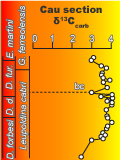 Abstract: In this work we discuss a proposed updated division of the C7 isotope segment of Menegatti et al. (1998). The new standard division of the segment C7 is based on a revision of published Barremian-Aptian carbon isotope curves from stratigraphic sections of the Prebetic
Domain in Spain. It includes four distinct isotopic subunits labeled C7a to C7d, with a characteristic negative carbon isotope excursion at the base of the segment and which correlates with the Dufrenoyia furcata ammonite Zone. The negative excursion is recognized on a regional
extent, and the term Intra-Furcata Negative Excursion (IFNE) is proposed to identify it. We provide possible sites correlatable with the IFNE in both the Old and New
worlds, which suggest its potential use as an even global chemostratigraphic marker for the Aptian record. Abstract: In this work we discuss a proposed updated division of the C7 isotope segment of Menegatti et al. (1998). The new standard division of the segment C7 is based on a revision of published Barremian-Aptian carbon isotope curves from stratigraphic sections of the Prebetic
Domain in Spain. It includes four distinct isotopic subunits labeled C7a to C7d, with a characteristic negative carbon isotope excursion at the base of the segment and which correlates with the Dufrenoyia furcata ammonite Zone. The negative excursion is recognized on a regional
extent, and the term Intra-Furcata Negative Excursion (IFNE) is proposed to identify it. We provide possible sites correlatable with the IFNE in both the Old and New
worlds, which suggest its potential use as an even global chemostratigraphic marker for the Aptian record.
|
|
Carnets Geol., vol. 14, no. 6, p. 129-137
Online since May 8, 2014
|
|
The Albian Stage in its type area, the Aube (France): a synthesis in a global sedimentary context
Francis AMÉDRO & Bertrand MATRION
| HTML  | PDF
| PDF  [2,810 KB]
| DOI:
10.4267/2042/53732 [2,810 KB]
| DOI:
10.4267/2042/53732
|
|
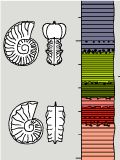 Abstract: The Aube department is the type locality of the Albian stage created by d'Orbigny
(1842). Two formations are recognised in the clay facies
(the "Gault" auct.) of the stratotype, the Argiles tégulines de Courcelles (82 m), which is overlain by the Marnes de Brienne (43 m). The boundary between the two formations is defined at the top of an indurated bed (hardground
L'Étape) that is readily identifiable, both in the field, and from boreholes. The type area of the Albian stage is of great interest because of the size of the clay facies (more than 120 m) unique in the Anglo-Paris basin.
Today, 82 % of the lithological succession is documented accurately from 16
outcrops. In two intervals of respectively 33 m and 28.50 m thick, composite sections are made of overlapping sections which are correlated in the field with the help of lithological marker
beds. Six successive facies are described: in the Argiles tégulines de Courcelles and from bottom to top: 1 - phosphatic nodules
bed; 2 - silty clays; 3 - clays and limestone beds; in the Marnes de Brienne: 4 - clay
marls; 5 - gaize; 6 - clay marls. On a smaller scale, a decimetre to metre-scale rhythmicity can be identified in the
sedimentation. This is reflected in the Argiles tégulines de Courcelles by pluri-decimetric cycles that start with a silty level and are bounded at the top by a bored surface. In the Marnes de Brienne, the metric cycles
(except for the gaize where they are decimetric) exhibit alternating dark grey clay marl and a pale grey marl that herald the rhythmic chalks of the Cenomanian. Individual couplets probably represent the precession cycles (20
kyr). On the other hand, 13 lithoevents as phosphatic nodules beds, hardgrounds, glauconitic and sandy beds and ecoevents characterised by the brief abundance of
some fossils. These marker beds are very useful for fine correlations across the basin. A comparison is proposed between sandy units of Yonne and clay facies of Aube. The continuity of several phosphatic nodules beds is shown from Yonne in the South West to Aube and Perthois in the North
East, that is a distance exceeding 130 km. These marker beds are interpreted as Flooding Surfaces of 3rd-order cycles.
Finally, a detailed study of the lithology, complemented with the analysis of the ammonite and inoceramid
faunas, is used for a depositional sequence interpretation. As a result, eight sequences are identified in the upper half of the Argiles tégulines de Courcelles and in the Marnes de Brienne in the type area of the Albian stage, including two new sequences indexed AL 5a and AL
6a. Abstract: The Aube department is the type locality of the Albian stage created by d'Orbigny
(1842). Two formations are recognised in the clay facies
(the "Gault" auct.) of the stratotype, the Argiles tégulines de Courcelles (82 m), which is overlain by the Marnes de Brienne (43 m). The boundary between the two formations is defined at the top of an indurated bed (hardground
L'Étape) that is readily identifiable, both in the field, and from boreholes. The type area of the Albian stage is of great interest because of the size of the clay facies (more than 120 m) unique in the Anglo-Paris basin.
Today, 82 % of the lithological succession is documented accurately from 16
outcrops. In two intervals of respectively 33 m and 28.50 m thick, composite sections are made of overlapping sections which are correlated in the field with the help of lithological marker
beds. Six successive facies are described: in the Argiles tégulines de Courcelles and from bottom to top: 1 - phosphatic nodules
bed; 2 - silty clays; 3 - clays and limestone beds; in the Marnes de Brienne: 4 - clay
marls; 5 - gaize; 6 - clay marls. On a smaller scale, a decimetre to metre-scale rhythmicity can be identified in the
sedimentation. This is reflected in the Argiles tégulines de Courcelles by pluri-decimetric cycles that start with a silty level and are bounded at the top by a bored surface. In the Marnes de Brienne, the metric cycles
(except for the gaize where they are decimetric) exhibit alternating dark grey clay marl and a pale grey marl that herald the rhythmic chalks of the Cenomanian. Individual couplets probably represent the precession cycles (20
kyr). On the other hand, 13 lithoevents as phosphatic nodules beds, hardgrounds, glauconitic and sandy beds and ecoevents characterised by the brief abundance of
some fossils. These marker beds are very useful for fine correlations across the basin. A comparison is proposed between sandy units of Yonne and clay facies of Aube. The continuity of several phosphatic nodules beds is shown from Yonne in the South West to Aube and Perthois in the North
East, that is a distance exceeding 130 km. These marker beds are interpreted as Flooding Surfaces of 3rd-order cycles.
Finally, a detailed study of the lithology, complemented with the analysis of the ammonite and inoceramid
faunas, is used for a depositional sequence interpretation. As a result, eight sequences are identified in the upper half of the Argiles tégulines de Courcelles and in the Marnes de Brienne in the type area of the Albian stage, including two new sequences indexed AL 5a and AL
6a.
|
|
Carnets Geol., vol. 14, no. 5, p. 69-128
Online since May 8, 2014
|
|
Paleocene larger foraminifera from the Yucatán Peninsula (SE Mexico)
Vicent VICEDO, José Antonio BERLANGA & Josep SERRA-KIEL
| HTML  | PDF
| PDF  [11,544 KB]
| DOI: 10.4267/2042/53527 [11,544 KB]
| DOI: 10.4267/2042/53527
|
|
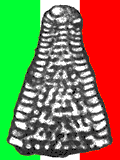 Abstract: The
larger foraminifera found in the material from the Chichen Itzá Formation of
Campeche (SE Mexico) were studied in detail. The architectural analyses allow
the description of four new species and a new genus, namely, two agglutinated
conical foraminifera, Coskinolina yucatanensis n.sp. and Pseudofallotella
drobneae n. gen. n.sp., one new alveolinid, Borelis hottingeri n.sp.,
and one new rotaliid, Dictyoconoides boneti n.sp. The larger foraminifera
of the Chichen Itzá Formation are distributed across two different
associations: one includes Pseudofallotella drobneae, Neotaberina
sp., Rhabdorites sp., Borelis hottingeri, Dictyoconoides boneti,
Kathina sp., Miscellaneidae, Ranikothalia soldadensis and Hexagonocyclina
cristensis, while the other assemblage is composed of Coskinolina
yucatensis, Fallotella causae, Rhabdorites sp., Borelis
floridanus and Cincoriola cf. ovoidea. Some of these genera,
including Neotaberina and Dictyoconoides, are cited in the
Caribbean paleobioprovince for the first time in this paper. The first
association is dated as Thanetian (SBZ 3? to SBZ 4) by the presence of
Ranikothalia soldadensis. Though the age of the second association
remains uncertain, a similar age has been inferred. Abstract: The
larger foraminifera found in the material from the Chichen Itzá Formation of
Campeche (SE Mexico) were studied in detail. The architectural analyses allow
the description of four new species and a new genus, namely, two agglutinated
conical foraminifera, Coskinolina yucatanensis n.sp. and Pseudofallotella
drobneae n. gen. n.sp., one new alveolinid, Borelis hottingeri n.sp.,
and one new rotaliid, Dictyoconoides boneti n.sp. The larger foraminifera
of the Chichen Itzá Formation are distributed across two different
associations: one includes Pseudofallotella drobneae, Neotaberina
sp., Rhabdorites sp., Borelis hottingeri, Dictyoconoides boneti,
Kathina sp., Miscellaneidae, Ranikothalia soldadensis and Hexagonocyclina
cristensis, while the other assemblage is composed of Coskinolina
yucatensis, Fallotella causae, Rhabdorites sp., Borelis
floridanus and Cincoriola cf. ovoidea. Some of these genera,
including Neotaberina and Dictyoconoides, are cited in the
Caribbean paleobioprovince for the first time in this paper. The first
association is dated as Thanetian (SBZ 3? to SBZ 4) by the presence of
Ranikothalia soldadensis. Though the age of the second association
remains uncertain, a similar age has been inferred.
|
|
Carnets Geol., vol. 14, no. 4, p. 41-68
Online since March 17, 2014
|
|
Acanthocythereis colini nomen novum for A. reticulata Sciuto, 2014
Francesco SCIUTO
| HTML  | PDF
| PDF  [27 KB]
| DOI: 10.4267/2042/53523 [27 KB]
| DOI: 10.4267/2042/53523
|
|
Excerpt: In Sciuto (2014), a new species, Acanthocythereis reticulata, was described from the Upper Pliocene sediments of NE Sicily and belonging to the
Family Trachyleberididae Sylvester-Bradley, 1948.. (...)
|
|
Carnets Geol., vol. 14, no. 3, p. 39
Online since February 28, 2014
|
|
A Cretaceous chronostratigraphic database: construction and applications
Robert W. SCOTT
| HTML  | PDF
| PDF  [1,718 KB]
| DOI: 10.4267/2042/53522 [1,718 KB]
| DOI: 10.4267/2042/53522
|
|
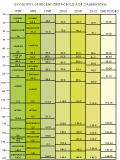 Abstract: Timing and rates of tectonic events, evolutionary processes, and oceanographic and paleoclimatic changes must be based on high-precision numerical age calibration of stages defined in Global Stratotype and Section Points (GSSPs). The Cretaceous Chronostratigraphic Database (CRETCSDB3) is an objective, testable database that calibrates select Cretaceous events and enables high-resolution chronostratigraphic correlations. Abstract: Timing and rates of tectonic events, evolutionary processes, and oceanographic and paleoclimatic changes must be based on high-precision numerical age calibration of stages defined in Global Stratotype and Section Points (GSSPs). The Cretaceous Chronostratigraphic Database (CRETCSDB3) is an objective, testable database that calibrates select Cretaceous events and enables high-resolution chronostratigraphic correlations.
CRETCSDB3 is a compilation of more than 3500 taxa and marker beds in
nearly 300 published sections calibrated to a mega-annum
(Ma) scale. The database spans the Jurassic/Cretaceous and the Cretaceous/Paleogene boundaries. Construction of CRETCSDB3 began by plotting bioevents in the Kalaat Senan, Tunisia, Cenomanian-Turonian section to the 1989 time scale. The sedimentology, sequence stratigraphy, and biostratigraphy of this section were precisely documented and stage boundaries defined biostratigraphically. Additional sections with radiometrically dated beds were graphed to constrain the accuracy of the numerical scale. Ranges of first and last occurrences are calibrated to mega-annums of Cretaceous stages defined by GSSPs or reference sections. This database serves as a look-up table for interpolation and age calibration of other stratigraphic sections. The age ranges of some taxa and marker beds are preliminary and may be extended as new sections are added to the database.
CRETCSDB3 tested the numeric age calibration of the Albian/Cenomanian boundary. This boundary in North Texas accurately correlates with the GSSP in France by ammonites, planktic foraminifers and dinoflagellates. This stage boundary in North Texas correlates with the 97.88±0.69 Ma Clay Spur Bentonite in Wyoming by sequence stratigraphy and cosmopolitan dinoflagellates. The inconsistency between this age and the current 100.5 Ma date of the 2012 Geologic Time Scale remains to be evaluated independently.
|
|
Carnets Geol., vol. 14, no. 2, p. 15-37
Online since February 28, 2014
|
|
Ostracods of the Upper Pliocene - Pleistocene Punta Mazza succession (NE Sicily) with special focus on the Family Trachyleberididae Sylvester-Bradley, 1948, and description of a new species
Francesco SCIUTO
| HTML  | PDF
| PDF  [1,980 KB]
| DOI: 10.4267/2042/53172 [1,980 KB]
| DOI: 10.4267/2042/53172
|
|
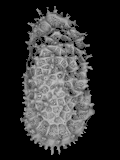 Abstract: The ostracod associations of the Upper Pliocene-Pleistocene sedimentary succession out-cropping at Punta Mazza (Milazzo, Sicily NE) have been investigated. The ostracod fauna is often well-preserved and well-diversified:
there 42 species belonging to 24 genera have been found. The association consists almost exclusively of bathyal taxa such as Bythocypris obtusata (Sars), B. bosquetiana (Brady), Henryhowella ex H. profunda Bonaduce et al. group, Quasibuntonia radiatopora (Seguenza), Retibythere (Bathybythere) scaberrima Brady, Pseudocythere caudata Sars and Bythocythere mylaensis Sciuto. Also, the Krithe group is well-represented with Krithe compressa (Seguenza) and K. pernoides (Bornemann). Further taxa such as Cytheropteron testudo Sars are rare. Almost all species, especially those belonging to Trachyleberididae Sylvester-Bradley
are described, illustrated and commented on, including a new species, Acanthocythereis reticulata n.sp., found in the lower part of the section
in Upper Pliocene sediment, is proposed as new. Finally, a
specimen belonging to the genus Quasibuntonia Ruggieri is currently given in open nomenclature. Abstract: The ostracod associations of the Upper Pliocene-Pleistocene sedimentary succession out-cropping at Punta Mazza (Milazzo, Sicily NE) have been investigated. The ostracod fauna is often well-preserved and well-diversified:
there 42 species belonging to 24 genera have been found. The association consists almost exclusively of bathyal taxa such as Bythocypris obtusata (Sars), B. bosquetiana (Brady), Henryhowella ex H. profunda Bonaduce et al. group, Quasibuntonia radiatopora (Seguenza), Retibythere (Bathybythere) scaberrima Brady, Pseudocythere caudata Sars and Bythocythere mylaensis Sciuto. Also, the Krithe group is well-represented with Krithe compressa (Seguenza) and K. pernoides (Bornemann). Further taxa such as Cytheropteron testudo Sars are rare. Almost all species, especially those belonging to Trachyleberididae Sylvester-Bradley
are described, illustrated and commented on, including a new species, Acanthocythereis reticulata n.sp., found in the lower part of the section
in Upper Pliocene sediment, is proposed as new. Finally, a
specimen belonging to the genus Quasibuntonia Ruggieri is currently given in open nomenclature.
|
|
Carnets Geol., vol. 14, no. 1, p. 1-13
Online since January 25, 2014
|

|
|
2013 (vol. 13)
|
|
Article 9 [2013]: Silurian cornulitids of Estonia (Baltica), by Olev VINN & Mark A. WILSON.-
Format [HTML] or [PDF
1,050 KB]
Reference: [CG2013_A09]
DOI: 10.4267/2042/53034
Lang.:
|
|
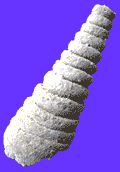 Abstract: Seven species of cornulitids are systematically described from the Silurian of Saaremaa and Hiiumaa islands, Estonia. There are three species of cornulitids in the Rhuddanian, three in the Sheinwoodian, single species in the Gorstian and Ludfordian, and three species in the Pridoli. Cornulitids have a facies range from pelletal limestones of shoal environments to deeper ramp marls. Endobiotic cornulitid symbionts occur in stromatoporoids found in shoal and open shelf zones. Gregarious aggregates are restricted to the limestones of the open shelf zone possibly because of higher nutrient levels in open shelf zone waters as compared to those of the deeper ramp. Unattached free forms are especially common in offshore deeper ramp marls presumably due to their adaption to life on a soft bottom. Solitary attached forms occur in all facies zones where cornulitids are present. Because the life modes of cornulitids are closely associated with particular facies zones, they are useful tools for paleoecological reconstructions. Abstract: Seven species of cornulitids are systematically described from the Silurian of Saaremaa and Hiiumaa islands, Estonia. There are three species of cornulitids in the Rhuddanian, three in the Sheinwoodian, single species in the Gorstian and Ludfordian, and three species in the Pridoli. Cornulitids have a facies range from pelletal limestones of shoal environments to deeper ramp marls. Endobiotic cornulitid symbionts occur in stromatoporoids found in shoal and open shelf zones. Gregarious aggregates are restricted to the limestones of the open shelf zone possibly because of higher nutrient levels in open shelf zone waters as compared to those of the deeper ramp. Unattached free forms are especially common in offshore deeper ramp marls presumably due to their adaption to life on a soft bottom. Solitary attached forms occur in all facies zones where cornulitids are present. Because the life modes of cornulitids are closely associated with particular facies zones, they are useful tools for paleoecological reconstructions.
|
|
Online since December 25, 2013
|
|
Letter 7 [2013]: Dissocladella hauteriviana
MASSE in MASSE et al., 1999 (non MASSE, 1976), another lower
Urgonian Dasycladalean alga revisited, by Bruno GRANIER.-
Format [HTML] or [PDF
1,990 KB]
Reference: [CG2013_L07]
DOI: 10.4267/2042/53035
Lang.:
|
|
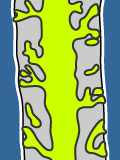 Abstract:
First ascribed to the Triploporellacean genus Dissocladella (Pia
in Rao & Pia,
1936), the species D. hauteriviana Masse in
Masse et al., 1999, was supposedly
characterized by a thallus bearing whorls of laterals each consisting of a
stumpy primary with a tuft of four slim secondaries at its top. A restudy of the
laterals proves that they split, not only once, but several times, and
stepwisely decrease in diameter. The species is re-ascribed to the Family
Thyrsoporellaceae in a new combination to the genus Deloffrella Granier
& Michaud, 1987. Its known stratigraphic range
is rather short (Late Valanginian-earliest Barremian). In addition, it
disappears earlier than its companion Polyphysacean alga, i.e., Clypeina
paucicalcarea (Conrad, 1970), and its
geographical distribution is broader, which makes it a good index fossil for
lower Urgonian carbonate platform series. Abstract:
First ascribed to the Triploporellacean genus Dissocladella (Pia
in Rao & Pia,
1936), the species D. hauteriviana Masse in
Masse et al., 1999, was supposedly
characterized by a thallus bearing whorls of laterals each consisting of a
stumpy primary with a tuft of four slim secondaries at its top. A restudy of the
laterals proves that they split, not only once, but several times, and
stepwisely decrease in diameter. The species is re-ascribed to the Family
Thyrsoporellaceae in a new combination to the genus Deloffrella Granier
& Michaud, 1987. Its known stratigraphic range
is rather short (Late Valanginian-earliest Barremian). In addition, it
disappears earlier than its companion Polyphysacean alga, i.e., Clypeina
paucicalcarea (Conrad, 1970), and its
geographical distribution is broader, which makes it a good index fossil for
lower Urgonian carbonate platform series.
|
|
Online since December 25, 2013
|
|
Obituary notice: Jean-Paul COLIN.-
Format [HTML] or [PDF
245 KB]
Reference: [Jean-Paul_Colin]
DOI:
10.4267/2042/51849
Lang.:
|
|
 Jean-Paul COLIN
(1948 - 2013) passed away at the end of this summer and his departure is a
cruel loss for our community, not only as a scientist of international repute,
but also as an outstanding organizer and, for a number of us, as a good friend. Jean-Paul COLIN
(1948 - 2013) passed away at the end of this summer and his departure is a
cruel loss for our community, not only as a scientist of international repute,
but also as an outstanding organizer and, for a number of us, as a good friend.
Following his PhD degree in micropaleontology from the University of Paris VI in
1973, he spent his entire career in the exploration branch of the oil industry,
first with EXXON in Houston and Bègles from 1974 to 1989, and then with
ESSO
REP in Bègles from 1989 to 2000. (...)
Jean-Paul COLIN was a great field and laboratory naturalist and as a scientific
partner was always open to often lively discussion. His enthusiasm for the
ostracods was huge and it was a pleasure to discuss with him. (...)
Being a very friendly
person, he helped ostracodologists worldwide who went to him with questions,
particularly the young.
Besides these activities, Jean-Paul COLIN was member of the editorial board
of several international journals. (...) He was Associate Editor of Carnets de
Géologie [Notebooks on Geology].
|
|
Online since November 22, 2013
|
|
Addendum: In order to
be complete the bibliographic list of Jean-Paul Colin
should also have included the following missing reference (Fida Medina,
personal communication): Medina F., Vachard
D., Colin J.-P., Ouarhache
D. & Ahmamou M'F. (2001).-
Charophytes et ostracodes du niveau carbonate de Taourirt Imzilen (Membre
d'Aglegal, Trias d'Argana) : implications stratigraphiques.- Bulletin
de l'Institut scientifique, Rabat, (section Sciences de la Terre), n°
23, p. 21-26.
|
|
Format [HTML]
or [PDF
17 KB]
Online since February 28, 2014
|
|
Letter 6 [2013]: About the generic attribution of Megatyloceras casei HUMPHREY, 1949 (Ammonoidea, Ancyloceratina), from the Aptian of Mexico, by Josep A. MORENO-BEDMAR & Gérard DELANOY.-
Format [HTML] or [PDF
2,824 KB]
Reference: [CG2013_L06]
DOI: 10.4267/2042/51826
Lang.:
|
|
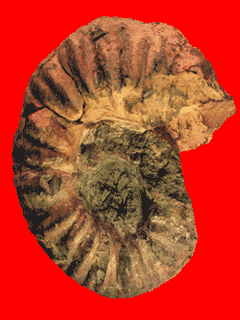 Abstract:
In the present work we review the generic attribution of the Mexican ammonoid species Megatyloceras casei Humphrey,
1949, through a careful examination of the holotype housed in the University of Michigan and with reference to new biostratigraphic data from the type locality. We assign
here this species to the subfamily Cheloniceratinae and to the genus Epicheloniceras Casey,
1954. Abstract:
In the present work we review the generic attribution of the Mexican ammonoid species Megatyloceras casei Humphrey,
1949, through a careful examination of the holotype housed in the University of Michigan and with reference to new biostratigraphic data from the type locality. We assign
here this species to the subfamily Cheloniceratinae and to the genus Epicheloniceras Casey,
1954.
|
|
Online since November 11, 2013
|
|
Article 8 [2013]: Daniel ŒHLERT (1849-1920): scientific biography and bibliography,
by Christian C. EMIG.-
Format [HTML] or [PDF
455 KB]
Reference: [CG2013_A08]
DOI: 10.4267/2042/51825
Lang.:
|
|
 Abstract: Daniel Œhlert (1849-1920): scientific biography and bibliography.- Daniel Œhlert (1849-1920) spent his entire career in Laval (Mayenne, France). His duties as a librarian of the city of Laval, then as curator of the museums of archaeology and natural history of Laval, allowed him freedom to focus on palaeontology and geology. He worked with his wife Pauline both in the field in the
departments of Mayenne and Sarthe. In between field trips in the Mayenne and Sarthe, they shared the
research during their long stays in Paris, working at the Sorbonne. Œhlert's studies focused mainly on faunas of
the Palaeozoic seas of Maine, Anjou and Cotentin. Œhlert devoted
himself primarily on describing crinoids, trilobites and brachiopods. In his collection, located in the "Musée des Sciences"
(Laval, Mayenne, France), more than 20 new genera with more than 150 new invertebrate species have been described. His geological and stratigraphical work is largely original, involving almost exclusively Palaeozoic areas in the departments of Mayenne and Sarthe, and secondarily in the departments of Orne and Ille-et-Vilaine. In 1884, he took a position at the "Service de la Carte géologique de France". More
than a hundred publications spread out from 1877 ended abruptly in 1911 with the death of his wife Pauline. A list of all his works is provided. Abstract: Daniel Œhlert (1849-1920): scientific biography and bibliography.- Daniel Œhlert (1849-1920) spent his entire career in Laval (Mayenne, France). His duties as a librarian of the city of Laval, then as curator of the museums of archaeology and natural history of Laval, allowed him freedom to focus on palaeontology and geology. He worked with his wife Pauline both in the field in the
departments of Mayenne and Sarthe. In between field trips in the Mayenne and Sarthe, they shared the
research during their long stays in Paris, working at the Sorbonne. Œhlert's studies focused mainly on faunas of
the Palaeozoic seas of Maine, Anjou and Cotentin. Œhlert devoted
himself primarily on describing crinoids, trilobites and brachiopods. In his collection, located in the "Musée des Sciences"
(Laval, Mayenne, France), more than 20 new genera with more than 150 new invertebrate species have been described. His geological and stratigraphical work is largely original, involving almost exclusively Palaeozoic areas in the departments of Mayenne and Sarthe, and secondarily in the departments of Orne and Ille-et-Vilaine. In 1884, he took a position at the "Service de la Carte géologique de France". More
than a hundred publications spread out from 1877 ended abruptly in 1911 with the death of his wife Pauline. A list of all his works is provided.
|
|
Online since November 11, 2013
|
|
Article 7 [2013]: Revision of the Jesse Harlan JOHNSON Collection. Part 1. Some fossil Dasycladales from Guatemala,
by Bruno GRANIER, Rajka RADOIČIĆ & Katica DROBNE.-
Format [HTML] or [PDF
7,459 KB]
Reference: [CG2013_A07]
DOI: 10.4267/2042/51824
Lang.:
|
|
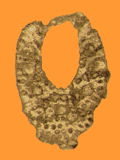 Abstract: This first report is a revision of fossil calcareous green algae
(Dasycladales) described from the Upper
Cretaceous and Paleocene series of Guatemala. Among other things in their 1965
paper J.H. Johnson and H.V. Kaska introduced three new species originally referred to the genera Acroporella, Cylindroporella, and Cymopolia.
One species, which has previously been referred to the genus Cylindroporella, is a foraminifer. Abstract: This first report is a revision of fossil calcareous green algae
(Dasycladales) described from the Upper
Cretaceous and Paleocene series of Guatemala. Among other things in their 1965
paper J.H. Johnson and H.V. Kaska introduced three new species originally referred to the genera Acroporella, Cylindroporella, and Cymopolia.
One species, which has previously been referred to the genus Cylindroporella, is a foraminifer.
|
|
Supplementary material: Color
plates [PDF
1,368 KB]
|
|
Online since November 11, 2013
|
|
Letter 5 [2013]: Paleotropical pollen grains from the Neuquén Group, Patagonia, Argentina, by
Patricia VALLATI.-
Format [HTML] or [PDF
297 KB]
Reference: [CG2013_L05]
DOI: 10.4267/2042/51218
Lang.:
|
|
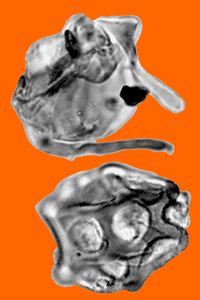 Abstract: This paper discusses the presence of elater-bearing pollen grains and other characteristic paleotropical palynomorphs in the mid to Late Cretaceous Neuquén Group at the El Zampal locality, south of Mendoza Province, Argentina. Abstract: This paper discusses the presence of elater-bearing pollen grains and other characteristic paleotropical palynomorphs in the mid to Late Cretaceous Neuquén Group at the El Zampal locality, south of Mendoza Province, Argentina.
The elaterates characterize the equatorial paleofloristic province in the Albian-Cenomanian. The species Elateroplicites africaensis is present in the pollen assemblage recovered from the lower section of the Huincul Formation, a basal unit of the studied Neuquén Group. It represents the first record of elater-bearing pollen grains in Argentina and marks their southernmost extension. Other conspicuous paleotropical elements recorded in different lithostratigraphic units of the Neuquén Group include gymnospermous polyplicate pollen grains and angiosperm pollen, including two species of the periporate pollen genus Cretacaeiporites and the triporate pollen species Confossia vulgaris. The paleobiogeographic and biostratigraphic significance of the paleotropical sporomorph record in the Cretaceous palynofloras of the Neuquén Group at El Zampal is herein discussed.
|
|
Online since August 2, 2013
|
|
Letter 4 [2013]: Praeorbitolina claveli
n.sp. (benthic Foraminifera) from the Lower Aptian sensu lato (Bedoulian) of Central Iran, by Felix SCHLAGINTWEIT, Ioan I. BUCUR, Koorosh RASHIDI & Behnam SABERZADEH.-
Format [HTML] or [PDF
1,755 KB]
Reference: [CG2013_L04]
DOI: 10.4267/2042/51217
Lang.:
|
|
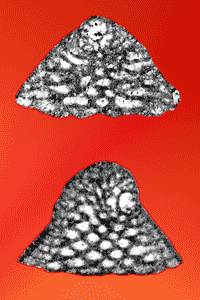 Abstract: The new orbitolinid foraminifer, Praeorbitolina claveli
n.sp., is described
from the Lower Aptian (Bedoulian) of Central Iran. It is characterized by an eccentric
embryonic apparatus displaying both a subdivided subembryonic zone and a
deuteroconch. The Barremian-Aptian orbitolinid association of this area has a typical
northern Tethyan character (e.g., "association à Valserina"
of Cherchi and Schroeder,
1973). Abstract: The new orbitolinid foraminifer, Praeorbitolina claveli
n.sp., is described
from the Lower Aptian (Bedoulian) of Central Iran. It is characterized by an eccentric
embryonic apparatus displaying both a subdivided subembryonic zone and a
deuteroconch. The Barremian-Aptian orbitolinid association of this area has a typical
northern Tethyan character (e.g., "association à Valserina"
of Cherchi and Schroeder,
1973).
|
|
Online since August 2, 2013
|
|
Article 6 [2013]: New data on the Valanginian - Hauterivian Ammonites from the stratotypical area of Neuchâtel (Swiss Jura Mountains) : biostratigraphic
implications,
by Pierre-Olivier MOJON, Antonio MUSOLINO, Stefan BUCHER & Bernard CLAUDE.-
Format [HTML] or [PDF
1,254 KB]
Reference: [CG2013_A06]
DOI: 10.4267/2042/51216
Lang.:
|
|
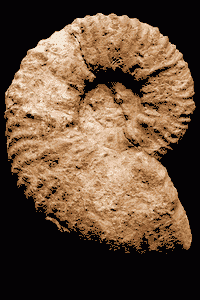 Abstract: New collections of Upper Valanginian - Lower Hauterivian ammonites yield precisions about the biostratigraphical scheme of the Lower Cretaceous in the stratotypical area of Neuchâtel (Swiss Jura Mountains). Thus, Stoicoceras pitrei (Busnardo,
1966) from the "Calcaire roux limoniteux" is reported
in the upper Saynoceras verrucosum Biozone (Karakaschiceras pronecostatum Subzone) of the Upper Valanginian. In the Lower Hauterivian, Olcostephanus (O.) variegatus Paquier, 1900, from the upper part of the "Marnes bleues d'Hauterive" and Saynella cf. clypeiformis (d'Orbigny,
1841) from the "Marnes d'Uttins" (top of the lower part of the "Pierre jaune de Neuchâtel") extend
greatly the range of the Lyticoceras nodosoplicatum Biozone compared to a more reduced Crioceratites loryi Biozone indicated by Saynella neocomiensis (Baumberger, 1905) and
a unique specimen of Crioceratites cf. gr. loryi (Sarkar,
1955) found in 1907. Abstract: New collections of Upper Valanginian - Lower Hauterivian ammonites yield precisions about the biostratigraphical scheme of the Lower Cretaceous in the stratotypical area of Neuchâtel (Swiss Jura Mountains). Thus, Stoicoceras pitrei (Busnardo,
1966) from the "Calcaire roux limoniteux" is reported
in the upper Saynoceras verrucosum Biozone (Karakaschiceras pronecostatum Subzone) of the Upper Valanginian. In the Lower Hauterivian, Olcostephanus (O.) variegatus Paquier, 1900, from the upper part of the "Marnes bleues d'Hauterive" and Saynella cf. clypeiformis (d'Orbigny,
1841) from the "Marnes d'Uttins" (top of the lower part of the "Pierre jaune de Neuchâtel") extend
greatly the range of the Lyticoceras nodosoplicatum Biozone compared to a more reduced Crioceratites loryi Biozone indicated by Saynella neocomiensis (Baumberger, 1905) and
a unique specimen of Crioceratites cf. gr. loryi (Sarkar,
1955) found in 1907.
|
|
Online since August 2, 2013
|
|
Article 5 [2013]: Study of the species Ochetoceras (Ochetoceras)
canaliculatum (de Buch, 1831) (Middle Oxfordian, Transversarium Zone), by
Philippe QUEREILHAC.-
Format [HTML] or [PDF
4,465 KB]
Reference: [CG2013_A05]
DOI: 10.4267/2042/51215
Lang.:
|
|
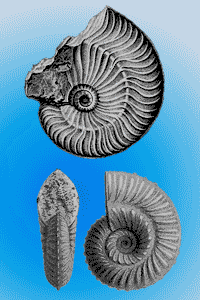 Abstract:
The species Ochetoceras (Ochetoceras) canaliculatum (de Buch, 1830
[1831]), discussed here, is certainly the most representative of the
Transversarium Zone (Middle
Oxfordian) in the Tethyian domain (Mediterranean Province). It appears in the Parandieri Subzone and seems to
go extinct in the Stenocycloides Subzone (Late
Oxfordian, base of the Bifurcatus Zone). It is abundantly represented in the ammonite populations and has a wide geographical range
and has a wide geographical spread. Analysis shows that it
is always associated with species referred to Ochetoceras (Ochetoceras) hispidum [M] (Oppel, 1863) and Glochiceras (Glochiceras) subclausum [m] (Oppel, 1863) ;
many authors have long thought that it was a single
species. These three "species" are thus here united under the name Ochetoceras (Ochetoceras) canaliculatum (de Buch,
1831): macroconchs corresponding to the "morphs"
canaliculatum and hispidum are polymorphic evolving from a
narrow to a wide whorl cross section whereas the "morph"
subclausum is a sexual dimorphic microconch. Abstract:
The species Ochetoceras (Ochetoceras) canaliculatum (de Buch, 1830
[1831]), discussed here, is certainly the most representative of the
Transversarium Zone (Middle
Oxfordian) in the Tethyian domain (Mediterranean Province). It appears in the Parandieri Subzone and seems to
go extinct in the Stenocycloides Subzone (Late
Oxfordian, base of the Bifurcatus Zone). It is abundantly represented in the ammonite populations and has a wide geographical range
and has a wide geographical spread. Analysis shows that it
is always associated with species referred to Ochetoceras (Ochetoceras) hispidum [M] (Oppel, 1863) and Glochiceras (Glochiceras) subclausum [m] (Oppel, 1863) ;
many authors have long thought that it was a single
species. These three "species" are thus here united under the name Ochetoceras (Ochetoceras) canaliculatum (de Buch,
1831): macroconchs corresponding to the "morphs"
canaliculatum and hispidum are polymorphic evolving from a
narrow to a wide whorl cross section whereas the "morph"
subclausum is a sexual dimorphic microconch.
|
|
Online since August 2, 2013
|
|
Erratum: On page 219, one should read:
"À la lecture d'anciennes publications, il est apparu que le nom d'auteur (de Buch) avait été mal transcrit. L'Ammonites canaliculatus Graf von Münster,
de Buch, 1831, l'Ammonites hispidus Oppel,
1863,
et l'Ammonites subclausus Oppel, 1863, sont maintenant réunies sous l'appellation Ochetoceras (Ochetoceras) canaliculatum (de Buch,
1831)",
instead of:
"À la lecture d'anciennes publications, il est apparu que le nom d'auteur (de Buch) avait été mal transcrit et que la date de création de l'espèce (1831) était erronée : ces faits
ont été mis en évidence à l'aide de l'I.C.Z.N. (4ème édition,
1999), inconnu à l'époque. L'application des articles de ce dernier a permis de corriger ces erreurs. L'Ammonites canaliculatus Graf von Münster
-- figurée dans la publication de von Zieten datée de
1832 --, l'Ammonites hispidus Oppel, 1863 et l'Ammonites subclausus Oppel,
1863
-- toutes deux figurées et décrites par cet auteur --, sont maintenant réunies sous l'appellation Ochetoceras (Ochetoceras) canaliculatum (de Buch,
1831)".
|
|
Format [HTML]
or [PDF
30 KB]
Online since August 4, 2013
|
|
Article 4 [2013]: L'Estellon (Baronnies, France), a "Rosetta Stone" for the Urgonian biostratigraphy,
by Bruno GRANIER, Bernard CLAVEL, Michel MOULLADE, Robert BUSNARDO, Jean CHAROLLAIS, Guy TRONCHETTI & Pierre DESJACQUES.-
Format [HTML] or [PDF
8,169 KB]
Reference: [CG2013_A04]
DOI: 10.4267/2042/51213
Lang.:
|
|
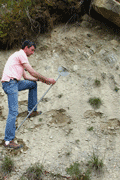 Abstract: Shallow-water assemblages of transported (freshly reworked) bioclasts (mainly orbitolinids and dasycladales) are observed in the deeper facies of the
"Vocontian Trough" (SE France). There these benthic assemblages can be directly correlated with ammonite zones. These new finds give an Early Barremian age to the earliest record of
Palorbitolina lenticularis as well as those of four so-called typical Early Aptian representatives of the genus
Orbitolinopsis. Actually most orbitolinid species recorded from the Late Barremian interval are now found present in Lower Barremian strata at L'Estellon. Some currently used correlation schemes for the Urgonian platforms, that are based on partial stratigraphic distribution ranges for the orbitolinids, --and consequently derived conclusions and hypotheses-- require at least in-depth revisions when they are not definitively refuted. Abstract: Shallow-water assemblages of transported (freshly reworked) bioclasts (mainly orbitolinids and dasycladales) are observed in the deeper facies of the
"Vocontian Trough" (SE France). There these benthic assemblages can be directly correlated with ammonite zones. These new finds give an Early Barremian age to the earliest record of
Palorbitolina lenticularis as well as those of four so-called typical Early Aptian representatives of the genus
Orbitolinopsis. Actually most orbitolinid species recorded from the Late Barremian interval are now found present in Lower Barremian strata at L'Estellon. Some currently used correlation schemes for the Urgonian platforms, that are based on partial stratigraphic distribution ranges for the orbitolinids, --and consequently derived conclusions and hypotheses-- require at least in-depth revisions when they are not definitively refuted.
|
|
Online since July 22, 2013
|
|
Erratum: On page 175, first column
(bottom), one should read: "2) Genus Dictyoconus Blanckenhorn,
1900", instead of: "2) Genus Dictyorbitolina Blanckenhorn,
1900".
On page 175, second column (top), one should read: "Provisionally attributed to the genus Dictyoconus", instead of: " Provisionally attributed to the genus Dictyorbitolina".
On page 179, second column, one should read: "nor between Dictyoconus ? vercorii and Dictyoconus aff. vercorii", instead of: "nor between Dictyorbitolina ? vercorii and Dictyorbitolina aff. Vercorii".
Similarly, on Plate 8, figs. 10-12, Plate 9, fig. 7, and Plate 10, fig. 4, one should read "Dictyoconus ? vercorii" instead of "Dictyorbitolina ? vercorii".
|
|
Format [HTML]
or [PDF
27 KB]
Online since December 25, 2013
|
|
Article 3 [2013]: Barremian ammonite fauna from L'Estellon section (Baronnies, SE France): preliminary biostratigraphic results, by
Robert BUSNARDO, Bruno GRANIER, Bernard CLAVEL & Jean CHAROLLAIS.-
Format [HTML] or [PDF
4,565 KB]
Reference: [CG2013_A03]
DOI: 10.4267/2042/51212
Lang.:
|
|
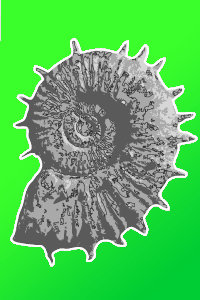 Abstract:
The study of the ammonite fauna in the L'Estellon section (Drôme department, SE France) allows us to date episodes with gravitational deposition in this area
of the "Vocontian Trough". They span most of the Barremian Stage, from the Nicklesi Zone up to the Giraudi Zone. We did not identify any Bedoulian redeposits,
the "Bedoulian ridge" auct. being latest Barremian in age. Abstract:
The study of the ammonite fauna in the L'Estellon section (Drôme department, SE France) allows us to date episodes with gravitational deposition in this area
of the "Vocontian Trough". They span most of the Barremian Stage, from the Nicklesi Zone up to the Giraudi Zone. We did not identify any Bedoulian redeposits,
the "Bedoulian ridge" auct. being latest Barremian in age.
|
|
Online since July 22, 2013
|
|
Letter 3 [2013]: Cornulitid tubeworms from the Ordovician of eastern Baltic, by Olev VINN.-
Format [HTML] or [PDF
635 KB]
Reference: [CG2013_L03]
DOI: 10.4267/2042/51214
Lang.:
|
|
 Abstract: Nine species of cornulitids are systematically described here from the Ordovician of Estonia. The earliest species,
Cornulites semiapertus, appears in the late Darriwilian (Middle Ordovician), the next two species appear in the Sandbian and there are a further six new species in the Katian, which indicates a rapid diversification of cornulitids in the Late Ordovician of Baltica. All the studied cornulitids from the Ordovician of Estonia occur in relatively shallow-water normal-marine sediments of a carbonate platform. The cornulitids are found encrusting mostly brachiopod shells (both syn vivo and post mortem). Abstract: Nine species of cornulitids are systematically described here from the Ordovician of Estonia. The earliest species,
Cornulites semiapertus, appears in the late Darriwilian (Middle Ordovician), the next two species appear in the Sandbian and there are a further six new species in the Katian, which indicates a rapid diversification of cornulitids in the Late Ordovician of Baltica. All the studied cornulitids from the Ordovician of Estonia occur in relatively shallow-water normal-marine sediments of a carbonate platform. The cornulitids are found encrusting mostly brachiopod shells (both syn vivo and post mortem).
|
|
Online since July 22, 2013
|
|
Memoir
2 [2013]: Priabonian mammals and reptiles from the Platé Massif
(Savoy, France), by Michel DELAMETTE & Jean A. REMY.-
Format [HTML]
or [PDF
5,875 KB]
Reference: [CG2013_M02]
DOI: 10.4267/2042/50056
Lang.:
|
|
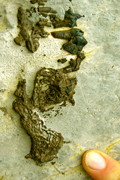 Abstract: A lens of marly limestone at the bottom of the Tertiary series of the Grandes
Platières (Platé Massif, Savoy) has yielded the most important collection
of fossil vertebrates so far known from the Paleogene of Western Alps. Ungulate
mammals are represented by 35 teeth to be referred to 9 taxa (4 perissodactyls and 5
artiodactyls). This new fauna appears contemporaneous with that of
La Débruge (MP 18 level), dated at about 35.5 My old. The new locality, called "gisement des Perdrix", is stratigraphically located 20-35 m underneath the other one in which Weidmann
et al. (1991) had found mammals to be attributed to the MP 20 level. So the new fauna is about 1.5 My older
than this latter. Its faunal composition and the swampy nature of the
deposit suggest that the occurring mammals were living in variegated surroundings, with woody
areas close to wet marshy ones. Abstract: A lens of marly limestone at the bottom of the Tertiary series of the Grandes
Platières (Platé Massif, Savoy) has yielded the most important collection
of fossil vertebrates so far known from the Paleogene of Western Alps. Ungulate
mammals are represented by 35 teeth to be referred to 9 taxa (4 perissodactyls and 5
artiodactyls). This new fauna appears contemporaneous with that of
La Débruge (MP 18 level), dated at about 35.5 My old. The new locality, called "gisement des Perdrix", is stratigraphically located 20-35 m underneath the other one in which Weidmann
et al. (1991) had found mammals to be attributed to the MP 20 level. So the new fauna is about 1.5 My older
than this latter. Its faunal composition and the swampy nature of the
deposit suggest that the occurring mammals were living in variegated surroundings, with woody
areas close to wet marshy ones.
|
|
Online since May 17, 2013
|
|
Article 2 [2013]: Xerticeras gen. nov., a new genus of micromorphic heteromorph ammonite (Ancyloceratina, Ancyloceratidae) from the lower Aptian of Spain,
by Gérard DELANOY, Josep A. MORENO-BEDMAR, José J. RUIZ & Domingo TOLÓS LLÁDSER.-
Format [HTML] or [PDF
4,285 KB]
Reference: [CG2013_A02]
DOI:
10.4267/2042/49315
Lang.:
|
|
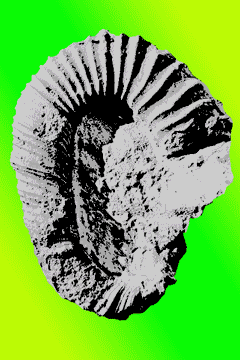 Abstract: Biostratigraphical and paleontological studies of lower
Aptian material from the Eastern Iberian Chain (Spain) have revealed the
presence of a new genus of micromorphic heteromorph ammonite: Xerticeras
gen. nov. (type species: Xerticeras salasi
sp. nov.). This new taxon comes from the Deshayesites
deshayesi and Dufrenoya furcata
ammonite zones. The size difference observed in the
population is considered due to sexual dimorphism. Abstract: Biostratigraphical and paleontological studies of lower
Aptian material from the Eastern Iberian Chain (Spain) have revealed the
presence of a new genus of micromorphic heteromorph ammonite: Xerticeras
gen. nov. (type species: Xerticeras salasi
sp. nov.). This new taxon comes from the Deshayesites
deshayesi and Dufrenoya furcata
ammonite zones. The size difference observed in the
population is considered due to sexual dimorphism.
|
|
Online since April 24, 2013
|
|
Letter 2 [2013]: An event bed with abundant Skolithos burrows from the late Pridoli (Silurian) of Saaremaa (Estonia), by Olev VINN & Mark A. WILSON.-
Format [HTML] or [PDF
1,833 KB]
Reference: [CG2013_L02]
DOI:
10.4267/2042/49316
Lang.:
|
|
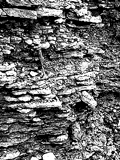 Abstract: Abundant Skolithos burrows are here described from a possible regressive event bed at Ohesaare cliff (Pridoli), Saaremaa, Estonia. The vertical, cylindrical burrows are identified as Skolithos rather than Trypanites because they intercept and bypass rather than cut bioclasts in the limestone matrix. The absence of encrustation on the upper bedding surface also is evidence that these traces are soft-sediment burrows rather than hardground borings. We interpret this intensive bioturbation by Skolithos-producing organisms as an indicator of a shallow water paleoenvironment with high hydrodynamic energy. Abstract: Abundant Skolithos burrows are here described from a possible regressive event bed at Ohesaare cliff (Pridoli), Saaremaa, Estonia. The vertical, cylindrical burrows are identified as Skolithos rather than Trypanites because they intercept and bypass rather than cut bioclasts in the limestone matrix. The absence of encrustation on the upper bedding surface also is evidence that these traces are soft-sediment burrows rather than hardground borings. We interpret this intensive bioturbation by Skolithos-producing organisms as an indicator of a shallow water paleoenvironment with high hydrodynamic energy.
|
|
Online since April 24, 2013
|
|
Article 1 [2013]: New paleontological and stratigraphical data at the Aptian - Albian transition in the Ariege Pyrenees (France),
by Jacques REY, Josep Anton MORENO-BEDMAR, Michel BILOTTE & Ricardo MARTÍNEZ.-
Format [HTML] or [PDF
1,089 KB]
Reference: [CG2013_A01]
DOI:
10.4267/2042/48733
Lang.:
|
|
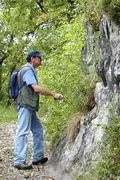 Abstract: The discovery of ammonites of the Aptian - Albian transition (Hypacanthoplites jacobi and Leymeriella tardefurcata biozones) in the Urgonian series from the
sedimentary section exposed in the Arize massif invalidates their former attribution to the lower Clansayesian which was proposed on the basis of
unconstrained paleontological arguments. Abstract: The discovery of ammonites of the Aptian - Albian transition (Hypacanthoplites jacobi and Leymeriella tardefurcata biozones) in the Urgonian series from the
sedimentary section exposed in the Arize massif invalidates their former attribution to the lower Clansayesian which was proposed on the basis of
unconstrained paleontological arguments.
|
|
Online since February 28, 2013
|
|
Letter 1 [2013]: Heteroporella ? paucicalcarea (Conrad, 1970), an Urgonian Dasycladalean alga revisited, by Bruno GRANIER.-
Format [HTML] or [PDF
1,412 KB]
Reference: [CG2013_L01]
DOI:
10.4267/2042/48737
Lang.:
|
|
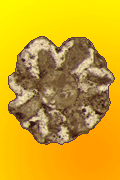 Abstract: When the species Heteroporella ? paucicalcarea (Conrad,
1970) was erected it was left in open nomenclature. Later on new combinations
were introduced but did not meet a general agreement among paleophycologists.
Considering the current acception of the Dasycladalean families, we ascribe it
to the Family Polyphysaceae and subsequently to the genus Clypeina (Michelin,
1845). Its known stratigraphic range is rather brief (Late Hauterivian-Early
Barremian), which makes it a good index fossil in Urgonian carbonate platform
series. Its geographical distribution is apparently restricted to Western
Europe (France, Spain and Switzerland). Abstract: When the species Heteroporella ? paucicalcarea (Conrad,
1970) was erected it was left in open nomenclature. Later on new combinations
were introduced but did not meet a general agreement among paleophycologists.
Considering the current acception of the Dasycladalean families, we ascribe it
to the Family Polyphysaceae and subsequently to the genus Clypeina (Michelin,
1845). Its known stratigraphic range is rather brief (Late Hauterivian-Early
Barremian), which makes it a good index fossil in Urgonian carbonate platform
series. Its geographical distribution is apparently restricted to Western
Europe (France, Spain and Switzerland).
|
|
Online since February 28, 2013
|
|
Memoir
1 [2013]: Revision of the species Hemidiadema rugosum Agassiz,
1846, and H. neocomiense (Cotteau, 1869) (Euechinoidea, Camarodonta, Glyphocyphidae) from the Lower Cretaceous of the Basin of Paris (France), by Arnaud CLÉMENT.-
Format [HTML]
or [PDF
2,725 KB]
Reference: [CG2013_M01]
DOI: 10.4267/2042/48481
Lang.:
|
|
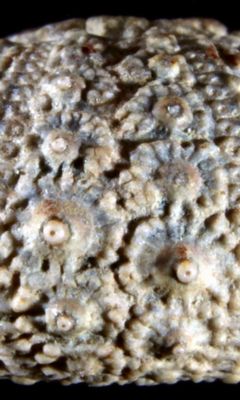 Abstract: Hemidiadema rugosum Agassiz,
1846, and H. neocomiense (Cotteau, 1869) are small and poorly known "regular" echinoid species. They were the
source of much confusion due to their rarity and the inadequacy of their original descriptions. Both species are revised here to clarify their differences and taxonomic status. This revision is based on six specimens of H. rugosum (including the holotype, not shown by its original author), all from the locus typicus and stratum typicum
(Clansayesian [Upper Aptian sensu gallico] "Grès ferrugineux" from Grandpré,
Ardennes) and on a single specimen of H. neocomiense from the stratum typicum (Lower Hauterivian (? Lyticoceras nodosoplicatum Zone) "Calcaire à Spatangues" from Ville-sur-Saulx (Meuse), a locality near to the locus typicus (Auxerre,
Yonne)). For this latter species, a neotype is designated to replace the holotype
that is lost. Remarks on the paleoecology and stratigraphic and geographic distributions of these two species are given. The revision of these two species provides an opportunity to propose an emended diagnosis of the genus Hemidiadema Agassiz,
1846, a poorly known member of the Glyphocyphidae. Abstract: Hemidiadema rugosum Agassiz,
1846, and H. neocomiense (Cotteau, 1869) are small and poorly known "regular" echinoid species. They were the
source of much confusion due to their rarity and the inadequacy of their original descriptions. Both species are revised here to clarify their differences and taxonomic status. This revision is based on six specimens of H. rugosum (including the holotype, not shown by its original author), all from the locus typicus and stratum typicum
(Clansayesian [Upper Aptian sensu gallico] "Grès ferrugineux" from Grandpré,
Ardennes) and on a single specimen of H. neocomiense from the stratum typicum (Lower Hauterivian (? Lyticoceras nodosoplicatum Zone) "Calcaire à Spatangues" from Ville-sur-Saulx (Meuse), a locality near to the locus typicus (Auxerre,
Yonne)). For this latter species, a neotype is designated to replace the holotype
that is lost. Remarks on the paleoecology and stratigraphic and geographic distributions of these two species are given. The revision of these two species provides an opportunity to propose an emended diagnosis of the genus Hemidiadema Agassiz,
1846, a poorly known member of the Glyphocyphidae.
|
|
Online since January 21, 2013
|

|
|
2012 (vol. 12)
|
|
Letter 4 [2012]: Inflation in the number of monospecific genera in brachiopod: progress or regression? A trivial approach to a real problem, by Rémy GOURVENNEC.-
Format [HTML] or [PDF
302 KB]
Reference: [CG2012_L04]
DOI: 10.4267/2042/48396
Lang.:
|
|
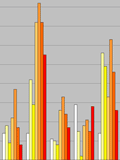 Abstract: Since the 19th century, about 1800 brachiopod genera or subgenera have been erected for the period covering the Silurian to the Devonian. In recent years, there has been a pronounced increase in the number of genera containing a single species. Without questioning the technological advances, one can, however, question the value and usefulness of monospecific genera both for systematics and palaeogeographical studies. Some editorial policy regarding erection of new monospecific genera and/or the evaluation of calls for projects are now needed. Abstract: Since the 19th century, about 1800 brachiopod genera or subgenera have been erected for the period covering the Silurian to the Devonian. In recent years, there has been a pronounced increase in the number of genera containing a single species. Without questioning the technological advances, one can, however, question the value and usefulness of monospecific genera both for systematics and palaeogeographical studies. Some editorial policy regarding erection of new monospecific genera and/or the evaluation of calls for projects are now needed.
|
|
Online since December 25, 2012
|
|
Article 8 [2012]: On the origin of the genus name Thecidea, a review, by Christian C. EMIG.-
Format [HTML] or [PDF
812 KB]
Reference: [CG2012_A08]
DOI:
10.4267/2042/48306
Lang.:
|
|
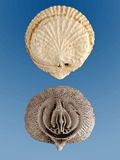 Abstract: The genus Thecidea has been figured before it was described that gave rise to various and erroneous interpretations, in particular by English-writing authors. It must be undoubtedly attributed to Defrance in Cuvier & Brongniart (1822). Four other descriptions derived from the original name Thecidea are nomen nullum, and are partially responsible for confusion before Thecidea was split in several new genera. Finally, only fossil species belong today to Thecidea. The history of the attribution of the author's name to Thecidea is described in detail. The type species and its synonyms, as well as the classification of the Thecidea are given. Abstract: The genus Thecidea has been figured before it was described that gave rise to various and erroneous interpretations, in particular by English-writing authors. It must be undoubtedly attributed to Defrance in Cuvier & Brongniart (1822). Four other descriptions derived from the original name Thecidea are nomen nullum, and are partially responsible for confusion before Thecidea was split in several new genera. Finally, only fossil species belong today to Thecidea. The history of the attribution of the author's name to Thecidea is described in detail. The type species and its synonyms, as well as the classification of the Thecidea are given.
|
|
Online since December 10, 2012
|
|
Memoir 2 [2012]: Mediterranean Neocomian belemnites, part 4: belemnites of the Barremian stratotype section, by Nico M.M. JANSSEN, Arnaud CLÉMENT & Willem BONT.-
Format [HTML]
or [PDF
10,329 KB]
Reference: [CG2012_M02]
DOI: 10.4267/2042/48307
Lang.:
|
|
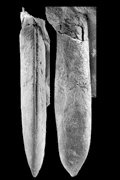 Abstract: This paper deals with the distribution of belemnites in the latest Hauterivian to early Bedoulian of the Angles Barremian Stratotype Section (ABSS). The distribution of the belemnites in the ABSS is not uniform, mainly due to the inaccessibility of certain beds. To cover this, and to compare the distribution with more proximal settings, we investigated a section to the north of Le Bourguet. The latest Hauterivian sediments mainly yield Hibolithes ex gr. subfusiformis besides some Duvalia ex gr. dilatata. The earliest Barremian sediments deliver a richer association that yields the last Hibolithes spp. The first typical Barremian belemnites occur just one bed above the Hauterivian-Barremian boundary based on ammonites. This belemnite association (BaBA1) consists of Duvalia ex gr. silesiaca-gagrica, Duvalia pontica and several species of Hibolithes. At the boundary between the Nicklesia pulchella and the Kotetishvilia compressissima zones the diversity increases and the first classical Barremian belemnites occur. These were formerly attributed to Mesohibolites (BaBA2). These species are herein attributed to a new genus Shvetsovia. Together with the duvaliids from BaBA1 they were first described from Abkhasia by Shvetsov (1913).
The latest Early Barremian (BaBA3) and the earliest Late Barremian (BaBA4) show well diversified belemnite associations, with many classical species, dominated by few genera closely resembling the true Mesohibolites. Eventually, these belemnite associations are compared to more proximal sections within the Vocontian Basin, and areas outside the Vocontian Basin (chiefly Hungary and Georgia). Some differences in the frequency and abundance of several species in these different palaeogeographical settings are believed to indicate differences in natural habitat. Duvalia ex gr. grasiana appears to be more abundant in more distal sections, while juvenile Mesohibolitidae, Conohibolites and Curtohibolites appear to be more abundant in the more proximal environments. Finally, a biozonation is presented and defined based on the distribution of the belemnites in the ABSS. This biozonation appears applicable in the more proximal sections, although some biozones are diachronous. The first Mesohibolites occur in the Upper Barremian Imerites giraudi Zone. In the Barremian-Bedoulian boundary sediments, as defined in the ABSS, Neohibolites first occurs, but the latter is only dominant in the marly sediments above the "calcareous Bedoulian". In the Late Barremian-early Bedoulian seven main belemnite associations can be distinguished, viz. BaBA5, BaBA6, BaBA7, BdBA1, BdBA2, BdBA3 and BdBA4. The following new species and genera are described: Hibolithes keleptrishvilii sp. nov. (latest Hauterivian), Duvalia vermeuleni sp. nov. (Early Barremian), Curtohibolites (?) bourguetensis sp. nov. (Early Barremian), and Shvetsovia gen. nov. (late Early-early Late Barremian). Besides, the Late Barremian yields the new species Mesohibolites anglesensis. Moreover, eleven species are described in open-nomenclature. Abstract: This paper deals with the distribution of belemnites in the latest Hauterivian to early Bedoulian of the Angles Barremian Stratotype Section (ABSS). The distribution of the belemnites in the ABSS is not uniform, mainly due to the inaccessibility of certain beds. To cover this, and to compare the distribution with more proximal settings, we investigated a section to the north of Le Bourguet. The latest Hauterivian sediments mainly yield Hibolithes ex gr. subfusiformis besides some Duvalia ex gr. dilatata. The earliest Barremian sediments deliver a richer association that yields the last Hibolithes spp. The first typical Barremian belemnites occur just one bed above the Hauterivian-Barremian boundary based on ammonites. This belemnite association (BaBA1) consists of Duvalia ex gr. silesiaca-gagrica, Duvalia pontica and several species of Hibolithes. At the boundary between the Nicklesia pulchella and the Kotetishvilia compressissima zones the diversity increases and the first classical Barremian belemnites occur. These were formerly attributed to Mesohibolites (BaBA2). These species are herein attributed to a new genus Shvetsovia. Together with the duvaliids from BaBA1 they were first described from Abkhasia by Shvetsov (1913).
The latest Early Barremian (BaBA3) and the earliest Late Barremian (BaBA4) show well diversified belemnite associations, with many classical species, dominated by few genera closely resembling the true Mesohibolites. Eventually, these belemnite associations are compared to more proximal sections within the Vocontian Basin, and areas outside the Vocontian Basin (chiefly Hungary and Georgia). Some differences in the frequency and abundance of several species in these different palaeogeographical settings are believed to indicate differences in natural habitat. Duvalia ex gr. grasiana appears to be more abundant in more distal sections, while juvenile Mesohibolitidae, Conohibolites and Curtohibolites appear to be more abundant in the more proximal environments. Finally, a biozonation is presented and defined based on the distribution of the belemnites in the ABSS. This biozonation appears applicable in the more proximal sections, although some biozones are diachronous. The first Mesohibolites occur in the Upper Barremian Imerites giraudi Zone. In the Barremian-Bedoulian boundary sediments, as defined in the ABSS, Neohibolites first occurs, but the latter is only dominant in the marly sediments above the "calcareous Bedoulian". In the Late Barremian-early Bedoulian seven main belemnite associations can be distinguished, viz. BaBA5, BaBA6, BaBA7, BdBA1, BdBA2, BdBA3 and BdBA4. The following new species and genera are described: Hibolithes keleptrishvilii sp. nov. (latest Hauterivian), Duvalia vermeuleni sp. nov. (Early Barremian), Curtohibolites (?) bourguetensis sp. nov. (Early Barremian), and Shvetsovia gen. nov. (late Early-early Late Barremian). Besides, the Late Barremian yields the new species Mesohibolites anglesensis. Moreover, eleven species are described in open-nomenclature.
|
|
Online since December 10, 2012
|
|
Letter 3 [2012]: A new upper Bedoulian section in the Aptian stratotypic area: Croagnes (5 km NW of Gargas, Vaucluse, SE France), by Michel MOULLADE, Guy TRONCHETTI, Christine BALME & Pascal MAUROUX.-
Format [HTML] or [PDF
1,105 KB]
Reference: [CG2012_L03]
DOI: 10.4267/2042/47550
Lang.:
|
|
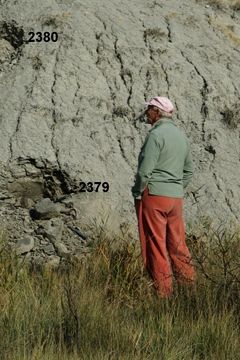 Abstract: The discovery and
exploitation of a new outcrop of the "A1 Unit of yellow marls and marly limestones" of Leenhardt
(1883), comprised between the Urgonian limestones and the "Aptian marls" of
the authors, leads to question the generalized attribution of this formation to
the Deshayesites grandis ammonite Subzone.
Data from this section at Croagnes rather lead to place A1, at least locally in the stratotypic area of the
surroundings of Apt, at the level of the onset of the anoxic event OAE1a, just
below the Roloboceras hambrovi Subzone. The assumed isochroneity of this Unit is also questioned. Abstract: The discovery and
exploitation of a new outcrop of the "A1 Unit of yellow marls and marly limestones" of Leenhardt
(1883), comprised between the Urgonian limestones and the "Aptian marls" of
the authors, leads to question the generalized attribution of this formation to
the Deshayesites grandis ammonite Subzone.
Data from this section at Croagnes rather lead to place A1, at least locally in the stratotypic area of the
surroundings of Apt, at the level of the onset of the anoxic event OAE1a, just
below the Roloboceras hambrovi Subzone. The assumed isochroneity of this Unit is also questioned.
|
|
Online since October 2, 2012
|
|
Article 7 [2012]: Encrustation and bioerosion on late Sheinwoodian (Wenlock, Silurian) stromatoporoids from Saaremaa, Estonia, by Olev VINN & Mark A. WILSON.-
Format [HTML] or [PDF
2,048 KB]
Reference: [CG2012_A07]
DOI:
10.4267/2042/47551
Lang.:
|
|
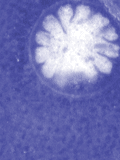 Abstract: A shallow shelf carbonate platform (pelletal limestone facies) stromatoporoid association from the late Sheinwoodian of Saaremaa (Baltica) contains a diverse assemblage of sclerobionts (both
epi- and endobionts). The studied stromatoporoids vary from low domical to extended domical shapes. Cornulites sp.
aff. C. stromatoporoides, Conchicolites sp., Anticalyptraea calyptrata,
microconchids, tabulate (Aulopora sp., Catenipora sp. and
favositids) and rugose corals, sheet-like trepostome bryozoans, and discoidal crinoid holdfasts encrust the stromatoporoids. The dominant sclerozoans were tabulate and rugose corals, which is significantly different from several analogous Silurian sclerobiont communities. There may have been taxonomic polarity between an upper surface and a cryptic sclerozoan community. Bioerosion occurs as macroborings in 45.5 % of studied (N=22) stromatoporoids. Endobionts were represented by Trypanites and Palaeosabella borings, as well as embedded symbiotic
rugose corals and Cornulites stromatoporoides. Abstract: A shallow shelf carbonate platform (pelletal limestone facies) stromatoporoid association from the late Sheinwoodian of Saaremaa (Baltica) contains a diverse assemblage of sclerobionts (both
epi- and endobionts). The studied stromatoporoids vary from low domical to extended domical shapes. Cornulites sp.
aff. C. stromatoporoides, Conchicolites sp., Anticalyptraea calyptrata,
microconchids, tabulate (Aulopora sp., Catenipora sp. and
favositids) and rugose corals, sheet-like trepostome bryozoans, and discoidal crinoid holdfasts encrust the stromatoporoids. The dominant sclerozoans were tabulate and rugose corals, which is significantly different from several analogous Silurian sclerobiont communities. There may have been taxonomic polarity between an upper surface and a cryptic sclerozoan community. Bioerosion occurs as macroborings in 45.5 % of studied (N=22) stromatoporoids. Endobionts were represented by Trypanites and Palaeosabella borings, as well as embedded symbiotic
rugose corals and Cornulites stromatoporoides.
|
|
Online since October 2, 2012
|
|
Letter 2 [2012]: Presence of Frambocythere
COLIN, 1980, (limnic ostracode) in the Maastrichtian of the Zagros Mountains, Iran: a newly recognized link between southern Europe and the Far East, by Jean-Paul COLIN, Hossein VAZIRI-MOGHADDAM, Amrollah SAFARI & Samira SHARIARI GRAI.-
Format [HTML] or [PDF
1,185 KB]
Reference: [CG2012_L02]
DOI: 10.4267/2042/47503
Lang.:
|
|
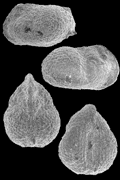 Abstract: The limnic ostracode Frambocythere tumiensis zagrosensis
subsp. nov. (Limnocytheridae, Timiriaseviinae), has been found for the first time in Iran. The
strata containing this species are in the lower part of the Tarbur Formation in the interior Fars of the Zagros Mountains. The
Late Maastrichtian age is indicated by rudists, larger foraminifers (Omphalocyclus macroporus, Loftusia spp.) and planktonic
foraminifers (Contusotruncana contusa-Racemiguembelina fructicosa Zone) present in the upper part of the Tarbur Formation. The Maastrichtian age is confirmed by the occurrence in the same
strata of the charophytes Platychara shanii, Peckichara cristellata and Stephanochara cf. producta. The genus Frambocythere Colin, 1980, was until now known mostly from the Upper Maastrichtian to Middle Eocene of southern Europe, India and China, as well
as the Albian of the Democratic Republic of Congo. The presence of Frambocythere gr. tumiensis in Iran is therefore a newly recognized link between southern Europe and the Far East (China). Abstract: The limnic ostracode Frambocythere tumiensis zagrosensis
subsp. nov. (Limnocytheridae, Timiriaseviinae), has been found for the first time in Iran. The
strata containing this species are in the lower part of the Tarbur Formation in the interior Fars of the Zagros Mountains. The
Late Maastrichtian age is indicated by rudists, larger foraminifers (Omphalocyclus macroporus, Loftusia spp.) and planktonic
foraminifers (Contusotruncana contusa-Racemiguembelina fructicosa Zone) present in the upper part of the Tarbur Formation. The Maastrichtian age is confirmed by the occurrence in the same
strata of the charophytes Platychara shanii, Peckichara cristellata and Stephanochara cf. producta. The genus Frambocythere Colin, 1980, was until now known mostly from the Upper Maastrichtian to Middle Eocene of southern Europe, India and China, as well
as the Albian of the Democratic Republic of Congo. The presence of Frambocythere gr. tumiensis in Iran is therefore a newly recognized link between southern Europe and the Far East (China).
|
|
Online since September 17, 2012
|
|
Memoir
1 [2012]: Study of the Phylloceratoidea fauna of
the Valanginian marls of Senez-Lioux (Alpes-de-Haute-Provence, France).
Comparison with some Drôme and Ardèche Valanginian localities, by Bernard JOLY & Philippe MERCIER.-
Format [HTML]
or [PDF
7,154 KB]
Reference: [CG2012_M01]
DOI: 10.4267/2042/47505
Lang.:
|
|
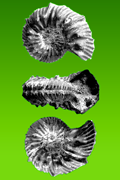 Abstract: The recent
"Révision de la Paléontologie française de d'Orbigny
(1840-42, tome premier, Terrains crétacés)" has allowed
a better understanding of Ammonites calypso (d'Orbigny,
1841), so that a more accurate age of the species
is known at its type-locality. At first the authors of this memoir had searched
for other specimens in the Valanginian marls of Senez-Lioux in order to give it the most correct age. Abstract: The recent
"Révision de la Paléontologie française de d'Orbigny
(1840-42, tome premier, Terrains crétacés)" has allowed
a better understanding of Ammonites calypso (d'Orbigny,
1841), so that a more accurate age of the species
is known at its type-locality. At first the authors of this memoir had searched
for other specimens in the Valanginian marls of Senez-Lioux in order to give it the most correct age.
The Phylloceratoidea do not give a precise age of the
strata from which the specimens were collected so the authors have determined the ammonites
from five successive horizons. This work has shown the Lower Valanginian and two zones of Upper Valanginian
(the zone with Verrucosum and the zone with Peregrinus ?, the presence of this last zone is
less certain). The zone with Furcillata of Upper Valanginian has not been proved.
The Phylloceratoidea are abundant in Senez-Lioux. Six species have been identified: Phylloceras (Hypophylloceras) serum (Oppel,
1865), Phylloceras (Hypophylloceras) tethys (d'Orbigny,
1841), Sowerbyceras calypso (d'Orbigny,
1841), Ptychophylloceras (Semisulcatoceras) semisulcatum semisulcatum (d'Orbigny,
1841), Ptychophylloceras (Semisulcatoceras) semisulcatum (d'Orbigny,
1841) diphyllum (d'Orbigny,
1841), Phyllopachyceras rogersi (Kitchin,
1908) and a new species: Phylloceras (Goretophylloceras) liouxense n. sp. This
new species was found in the Alpes-de-Haute-Provence (material collected by Philippe Mercier and Bernard Joly) and
in the Drôme area (material collected by Laurent Vareilles and Philippe Mercier).
These ammonites are small (diameter 5-28 mm) and seem to belong to the
juvenile stage. For a long time the Vocontian basin seems to have been the
egg-laying area of these Cephalopods. In the Valanginian marls there are specimens whose diameter is
less than 5 mm. They have not been determined in this study. However their presence is
significant. The pyritic specimens and the iron oxide specimens (for example the
limonitic specimens) are not necessarily small in size. In the marly facies there are very large
pyritic specimens, which are among the largest known (Joly,
2000, p. 173). In Senez-Lioux the smallest specimens are not the nuclei of the
largest ones. They are not small adults because we are unable to see the contraction of the last septa
showing the slowing down of their growth. The beginning of the body chamber,
which is present in many of the specimens, proves that these specimens were
merely not nuclei and definitely they have not attained sexual maturity.
The many specimens gathered permitted a statistical study of the populations especially of the species Phylloceras (Hypophylloceras) serum (Oppel,
1865), Phylloceras (Hypophylloceras) tethys (d'Orbigny,
1841), Phylloceras (Goretophylloceras) liouxense n. sp., Ptychophylloceras (Semisulcatoceras) semisulcatum semisulcatum (d'Orbigny,
1841), and Ptychophylloceras (Semisulcatoceras) semisulcatum (d'Orbigny,
1841) diphyllum (d'Orbigny,
1841). The species Sowerbyceras calypso (d'Orbigny,
1841) and Phyllopachyceras rogersi (Kitchin,
1908) are represented by very few specimens.
The fossils gathered in some deposits from the Drôme and Ardèche area have
allowed us to further our knowledge about the Valanginian faunas of the Vocontian
Basin. In particular they have permitted the statistical study of a population of the very rare species Ptychophylloceras (Semisulcatoceras) semisulcatum semisulcatum (d'Orbigny,
1841) as only one specimen was identified among the fossils gathered in the deposits of
Senez-Lioux but is more abundant in the Valanginian from the Drôme.
|
|
Online since September 17, 2012
|
|
Article 6 [2012]: Proposal for the Thuoux section as a candidate for the GSSP of the base of the Oxfordian stage, by Dominique FORTWENGLER, Didier MARCHAND, Alain BONNOT, Rémi JARDAT & Daniel RAYNAUD.-
Format [HTML] or [PDF
1,097 KB]
Reference: [CG2012_A06]
DOI:
10.4267/2042/47431
Lang.:
|
|
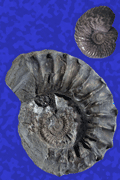 Abstract: The Thuoux section, located in South-Eastern Basin of France (coordinates: 44°30'55"E; 5°42'25"N), is a section that satisfies numerous demanding criteria as reference section (GSSP) for the base of the Oxfordian stage. Sedimentation was continuous in that the abundant ammonitic fauna yields no detectable hiatuses. The stratigraphic boundary is located between the Lamberti Zone and the Mariae Zone or more precisely between the Paucicostatum horizon (Marchand,
1979) and the Thuouxensis horizon (Fortwengler & Marchand,
1994a). In this section, there is a perfect
mixing between Boreal ammonites (Cardioceratinae) whose species are used as stratigraphic
markers and Submediterranean/Subboreal ammonites (Hecticoceratinae, Peltoceratinae and Perisphinctinae) that provide further possibilities for wide correlation of this boundary. Finally, parallel
ammonite zonations have been established with
great precision (biohorizons and sometimes "sub-biohorizons") in various areas of France, with different
palaeoenvironments. The Thuoux section permits correlations with central and eastern Europe as well as North America, based on Cardioceratinae successions, and with South America, using Peltoceratinae. Thickness of the Callovian-Oxfordian transitional beds in the Thuoux section has allowed
detailed sedimentological studies and astronomical calibration of the Lower Oxfordian (Boulila,
2008; Boulila et al., 2008).
The Thuoux section is located at the centre of a set of more than thirty sections where the base of
the Oxfordian stage is visible (Fortwengler, 1989; Fortwengler
& Marchand, 1994a, b, c, d). Abstract: The Thuoux section, located in South-Eastern Basin of France (coordinates: 44°30'55"E; 5°42'25"N), is a section that satisfies numerous demanding criteria as reference section (GSSP) for the base of the Oxfordian stage. Sedimentation was continuous in that the abundant ammonitic fauna yields no detectable hiatuses. The stratigraphic boundary is located between the Lamberti Zone and the Mariae Zone or more precisely between the Paucicostatum horizon (Marchand,
1979) and the Thuouxensis horizon (Fortwengler & Marchand,
1994a). In this section, there is a perfect
mixing between Boreal ammonites (Cardioceratinae) whose species are used as stratigraphic
markers and Submediterranean/Subboreal ammonites (Hecticoceratinae, Peltoceratinae and Perisphinctinae) that provide further possibilities for wide correlation of this boundary. Finally, parallel
ammonite zonations have been established with
great precision (biohorizons and sometimes "sub-biohorizons") in various areas of France, with different
palaeoenvironments. The Thuoux section permits correlations with central and eastern Europe as well as North America, based on Cardioceratinae successions, and with South America, using Peltoceratinae. Thickness of the Callovian-Oxfordian transitional beds in the Thuoux section has allowed
detailed sedimentological studies and astronomical calibration of the Lower Oxfordian (Boulila,
2008; Boulila et al., 2008).
The Thuoux section is located at the centre of a set of more than thirty sections where the base of
the Oxfordian stage is visible (Fortwengler, 1989; Fortwengler
& Marchand, 1994a, b, c, d).
|
|
Online since July 14, 2012
|
|
Article 5 [2012]: Hunting for the 405-kyr eccentricity cycle phase at the Cretaceous-Paleogene boundary in the Aïn Settara section (Kalaat Senan, central Tunisia), by Michel HENNEBERT.-
Format [HTML] or [PDF
2,077 KB]
Reference: [CG2012_A05]
DOI:
10.4267/2042/47314
Lang.:
|
|
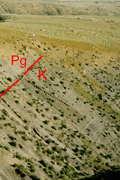 Abstract: The Aïn Settara section (Kalaat Senan, central Tunisia) shows a continuous and well exposed marl-limestone alternation, extending from the Upper Maastrichtian to the basal Danian. The section reveals the superposition of several cycles, which correspond to the combined astro-climatic effect of both eccentricity and precession. Based on the ~100-kyr eccentricity and the ~21-kyr precession cycles, a floating chronometric scale is proposed. Thanks to this scale, the sedimentary and biological events of the section are dated with respect to the Cretaceous-Paleogene (K-Pg) boundary taken as the reference. Highlighting the very stable 405-kyr eccentricity cycle allows on one side to confirm the relevance of the established time scale and on the other side to determine the phase of this important signal with respect to the K-Pg boundary event. Abstract: The Aïn Settara section (Kalaat Senan, central Tunisia) shows a continuous and well exposed marl-limestone alternation, extending from the Upper Maastrichtian to the basal Danian. The section reveals the superposition of several cycles, which correspond to the combined astro-climatic effect of both eccentricity and precession. Based on the ~100-kyr eccentricity and the ~21-kyr precession cycles, a floating chronometric scale is proposed. Thanks to this scale, the sedimentary and biological events of the section are dated with respect to the Cretaceous-Paleogene (K-Pg) boundary taken as the reference. Highlighting the very stable 405-kyr eccentricity cycle allows on one side to confirm the relevance of the established time scale and on the other side to determine the phase of this important signal with respect to the K-Pg boundary event.
|
|
Online since May 21, 2012
|
|
Article 4 [2012]: Paleontologic and stratigraphic overview of the Paleogene in eastern Saudi Arabia, by Nestor J. SANDER.-
Format [HTML] or [PDF
1,387 KB]
Reference: [CG2012_A04]
DOI:
10.4267/2042/47293
Lang.:
|
|
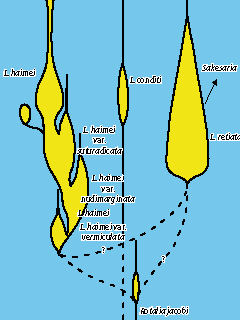 Abstract: The beds of early Tertiary age in eastern Saudi Arabia are in large part chemical precipitates laid down in a shallow epicontinental sea. The sequence is divided into three formations, each clearly differentiated in both lithology and fauna. From bottom to top they have been named the Umm er Radhuma, Rus and Dammam formations. Ecologic conditions remained more or less uniform for considerable lengths of time. Consequently, the fauna, made up mainly of Foraminifera, became well adapted to the environment, as demonstrated by the abundance of some species. The great number of individuals of these species have a range of variability much broader that that seen in other areas of their occurrence. The detailed study of these variations has demonstrated that species have often been defined on too small a number of individuals. The abundance of specimens has allowed evolutionary trends in species to be traced even to the extent that in the end some variants must be classed as a discrete genus. Abstract: The beds of early Tertiary age in eastern Saudi Arabia are in large part chemical precipitates laid down in a shallow epicontinental sea. The sequence is divided into three formations, each clearly differentiated in both lithology and fauna. From bottom to top they have been named the Umm er Radhuma, Rus and Dammam formations. Ecologic conditions remained more or less uniform for considerable lengths of time. Consequently, the fauna, made up mainly of Foraminifera, became well adapted to the environment, as demonstrated by the abundance of some species. The great number of individuals of these species have a range of variability much broader that that seen in other areas of their occurrence. The detailed study of these variations has demonstrated that species have often been defined on too small a number of individuals. The abundance of specimens has allowed evolutionary trends in species to be traced even to the extent that in the end some variants must be classed as a discrete genus.
|
|
Online since May 11, 2012
|
|
Obituary notice : Nestor J. SANDER.-
Format [HTML] or [PDF
424 KB]
Reference : [Nestor_Sander]
DOI:
10.4267/2042/48262
Lang.:
|
|
 Nestor
John SANDER (December 5, 1914 - February 11, 2012), "Sandy" for
his friends, was a living history book, describing himself as a positivist.
(...) Nestor was sent as a junior geologist for his first assignment to Saudi
Arabia (...). That was before World War II started and much before the country
became known as the major worldwide oil producer. (...) Nestor was one of the founders of
Carnets de Géologie: many non-native English speakers will remember him as a very kind
and generous person who, for instance, helped them polish their manuscripts. Nestor
John SANDER (December 5, 1914 - February 11, 2012), "Sandy" for
his friends, was a living history book, describing himself as a positivist.
(...) Nestor was sent as a junior geologist for his first assignment to Saudi
Arabia (...). That was before World War II started and much before the country
became known as the major worldwide oil producer. (...) Nestor was one of the founders of
Carnets de Géologie: many non-native English speakers will remember him as a very kind
and generous person who, for instance, helped them polish their manuscripts.
|
|
Online since March 11, 2012
|
|
Article 3 [2012]: Inconsistencies in proposed annelid affinities of early biomineralized organism Cloudina (Ediacaran): structural and ontogenetic evidences, by Olev VINN & Michał ZATOŃ.-
Format [HTML] or [PDF
1,036 KB]
Reference: [CG2012_A03]
DOI:
10.4267/2042/46095
Lang.:
|
|
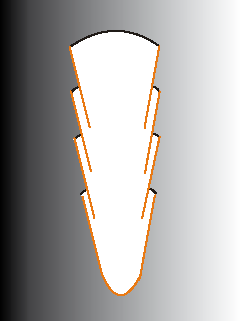 Abstract: Cloudina, an important Ediacaran index fossil, is considered as one of the earliest biomineralizing organisms. Its biological affinities have not been fully resolved and phylogenetic links with both annelids and cnidarians have traditionally been suggested. Differences in tube morphology, ultrastructure and biomineralization suggest that Cloudina is not closely related to any recent skeletal annelid
(e.g., serpulids, sabellids and cirratulids) and their skeletons are not homologous. The way of asexual reproduction in Cloudina resembles more that of cnidarians. The presence of a closed tube origin (base) in Cloudina is also compatible with the hypothesis of an animal of cnidarian grade. Abstract: Cloudina, an important Ediacaran index fossil, is considered as one of the earliest biomineralizing organisms. Its biological affinities have not been fully resolved and phylogenetic links with both annelids and cnidarians have traditionally been suggested. Differences in tube morphology, ultrastructure and biomineralization suggest that Cloudina is not closely related to any recent skeletal annelid
(e.g., serpulids, sabellids and cirratulids) and their skeletons are not homologous. The way of asexual reproduction in Cloudina resembles more that of cnidarians. The presence of a closed tube origin (base) in Cloudina is also compatible with the hypothesis of an animal of cnidarian grade.
|
|
Online since March 12, 2012
|
|
Letter 1 [2012]: Shell repair in Anticalyptraea (Tentaculita) in the late Silurian (Pridoli) of Baltica, by Olev VINN.-
Format [HTML] or [PDF
1,005 KB]
Reference: [CG2012_L01]
DOI:
10.4267/2042/46096
Lang.:
|
|
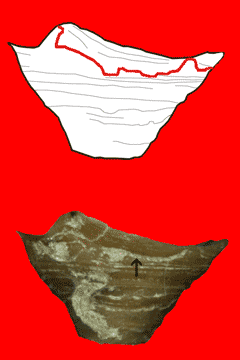 Abstract: Shell repair is common in the late Silurian (Pridoli) encrusting tentaculitoid tubeworm Anticalyptraea calyptrata from Saaremaa,
Estonia (Baltica), and is interpreted here as a result of failed predation. A. calyptrata has a shell repair frequency of 29 % (individuals with scars) with 17 specimens. There is probably an antipredatory adaptation,
i.e. extremely thick vesicular walls, in the morphology of Silurian Anticalyptraea. The morphological and ecological evolution of Anticalyptraea could thus have been partially driven by predation. Abstract: Shell repair is common in the late Silurian (Pridoli) encrusting tentaculitoid tubeworm Anticalyptraea calyptrata from Saaremaa,
Estonia (Baltica), and is interpreted here as a result of failed predation. A. calyptrata has a shell repair frequency of 29 % (individuals with scars) with 17 specimens. There is probably an antipredatory adaptation,
i.e. extremely thick vesicular walls, in the morphology of Silurian Anticalyptraea. The morphological and ecological evolution of Anticalyptraea could thus have been partially driven by predation.
|
|
Online since March 12, 2012
|
|
Article 2 [2012]: Revision of the brachiopod species described by A. RISSO, by Christian C. EMIG.-
Format [HTML] or [PDF
674 KB]
Reference: [CG2012_A02]
DOI:
10.4267/2042/45933
Lang.:
|
|
 Abstract: Although Risso's collection has not been found, the current list of twelve recent brachiopod species and thirteen fossil ones identified and described by Risso (1826) in the marine and terrestrial vicinities of Nice deserves revision by taking into account the synonyms accepted today. Adding Argyrotheca cistellula reported in 1920, the list of the extant species of brachiopods collected in the Mediterranean Sea has remained the same until 1994, date from which it increases by two species. Three of the species described by Risso as belonging to Terebratula have been attributed as new species to him: Joania cordata, Argyrotheca cuneata, Lacazella mediterranea, all three are type species of their genus. For the fossil species, only two were identified as synonyms for Terebratula terebratula. Criticized several times, sometimes too severely, for his works on the Mollusca, to which the Brachiopoda were attributed, Risso (1826) as an amateur naturalist completed a honourable work on this latter group, entirely comparable with those of the majority of its contemporaries and more recent authors on this group. Abstract: Although Risso's collection has not been found, the current list of twelve recent brachiopod species and thirteen fossil ones identified and described by Risso (1826) in the marine and terrestrial vicinities of Nice deserves revision by taking into account the synonyms accepted today. Adding Argyrotheca cistellula reported in 1920, the list of the extant species of brachiopods collected in the Mediterranean Sea has remained the same until 1994, date from which it increases by two species. Three of the species described by Risso as belonging to Terebratula have been attributed as new species to him: Joania cordata, Argyrotheca cuneata, Lacazella mediterranea, all three are type species of their genus. For the fossil species, only two were identified as synonyms for Terebratula terebratula. Criticized several times, sometimes too severely, for his works on the Mollusca, to which the Brachiopoda were attributed, Risso (1826) as an amateur naturalist completed a honourable work on this latter group, entirely comparable with those of the majority of its contemporaries and more recent authors on this group.
|
|
Online since February 15, 2012
|
|
Article 1 [2012]: Distribution of brachiopod assemblages in Oxfordian strata of central France, by Annick BOULLIER & Rosemarie FILIPPI.-
Format [HTML] or [PDF
2,153 KB]
Reference: [CG2012_A01]
DOI:
10.4267/2042/45932
Lang.:
|
|
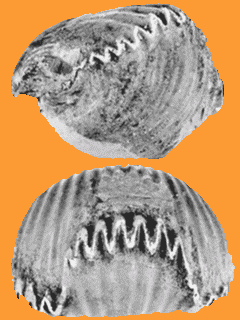 Abstract: In the Berry area, situated in the center of France, the Oxfordian deposits are represented by successions of well individualized and dated formations in which brachiopods have been studied in detail. Several assemblages of brachiopods were found that have given indications on the age of the levels. Some have been recognized within areas more or less far away allowing us to establish correlations. Abstract: In the Berry area, situated in the center of France, the Oxfordian deposits are represented by successions of well individualized and dated formations in which brachiopods have been studied in detail. Several assemblages of brachiopods were found that have given indications on the age of the levels. Some have been recognized within areas more or less far away allowing us to establish correlations.
|
|
Online since February 15, 2012
|

|
|
2010 (vol. 11)
|
|
Article 5 [2011]: Xenobrochus norfolkensis (Brachiopoda: Dyscoliidae), a new species from the Norfolk Ridge, New Caledonia, South-West Pacific, by Maria Aleksandra BITNER.-
Format [HTML] or [PDF
2,151 KB]
Reference: [CG2011_A05]
DOI: 10.4267/2042/45792
Lang.:
|
|
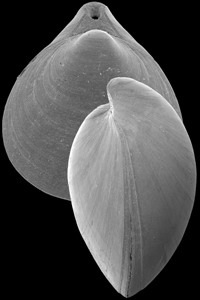 Abstract: The genus Xenobrochus, with the type species Gryphus africanus Cooper,
1973, was erected for short-looped brachiopods of small size, rectimarginate and having a loop with anteriorly convex transverse band. A new species of Xenobrochus, X. norfolkensis sp. nov. has been identified in the material collected during the French cruises SMIB 8, NORFOLK 1 and NORFOLK 2 to the Norfolk Ridge, New Caledonia, SW Pacific. This species differs from those hitherto described in the absence of cardinal process and relatively wide outer hinge plates. The genus, represented now by nine species, has a distribution restricted to the Indian Ocean and West Pacific. Abstract: The genus Xenobrochus, with the type species Gryphus africanus Cooper,
1973, was erected for short-looped brachiopods of small size, rectimarginate and having a loop with anteriorly convex transverse band. A new species of Xenobrochus, X. norfolkensis sp. nov. has been identified in the material collected during the French cruises SMIB 8, NORFOLK 1 and NORFOLK 2 to the Norfolk Ridge, New Caledonia, SW Pacific. This species differs from those hitherto described in the absence of cardinal process and relatively wide outer hinge plates. The genus, represented now by nine species, has a distribution restricted to the Indian Ocean and West Pacific.
|
|
Online since December 31, 2011
|
|
Memoir 2 [2011]: The Early Aptian (Early Cretaceous) ammonites from the Aralar Mountains, Basque-Cantabrian Basin, Northern Spain, by
Seyed Naser RAISOSSADAT.-
Format [HTML] or [PDF
1,498 KB]
Reference: [CG2011_M02]
DOI:
10.4267/2042/45794
Lang.:
|
|
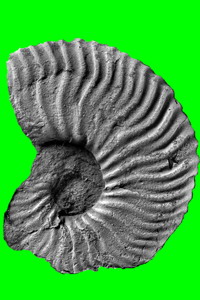 Abstract: The Aralar Mountains located in northern Spain exposes a 983-m-thick succession of sediments of Early Aptian age. The lithological succession evolves from lutites, marls, and calcarenites of the Errenaga Formation to rudist micritic limestones of the Sarastarri Formation, and finally marls, lutites, and sandstones of the Lareo Formation. Based on ammonite assemblage faunas, the Deshayesites oglanlensis, D. weissi, D. deshayesi, and Dufrenoyia furcata biozones have been identified. A transition between the deshayesi and furcata zones with the co-occurrence of the ammonite genera Deshayesites and Dufrenoyia is described in the Aralar succession and is currently unique. The ammonites are described here and correlations are made with other Tethyan regions. Abstract: The Aralar Mountains located in northern Spain exposes a 983-m-thick succession of sediments of Early Aptian age. The lithological succession evolves from lutites, marls, and calcarenites of the Errenaga Formation to rudist micritic limestones of the Sarastarri Formation, and finally marls, lutites, and sandstones of the Lareo Formation. Based on ammonite assemblage faunas, the Deshayesites oglanlensis, D. weissi, D. deshayesi, and Dufrenoyia furcata biozones have been identified. A transition between the deshayesi and furcata zones with the co-occurrence of the ammonite genera Deshayesites and Dufrenoyia is described in the Aralar succession and is currently unique. The ammonites are described here and correlations are made with other Tethyan regions.
|
|
Online since December 31, 2011
|
|
Letter 6 [2011]: The sauropod dinosaur Cetiosaurus OWEN in the Bathonian (Middle Jurassic) of the Ardennes (NE France): insular, but not dwarf, by Eric BUFFETAUT, Bernard GIBOUT, Isabelle LAUNOIS & Claude DELACROIX.-
Format [HTML] or [PDF
389 KB]
Reference: [CG2011_L06]
DOI: 10.4267/2042/43897
Lang.:
|
|
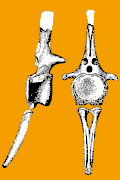 Abstract: A chevron bone from a Lower Bathonian oolitic limestone in the Ardennes (NE France) is referred to the sauropod dinosaur Cetiosaurus Owen, previously known from the Middle Jurassic of England, on the basis of its rod-like distal end. This is the first well attested occurrence of Cetiosaurus in France. The presence of Cetiosaurus remains in the Bathonian of both Oxfordshire and the Ardennes is explainable by the fact that these regions were situated on the margin of the London-Brabant Massif land area, on which sauropod populations apparently lived. Contrary to the condition observed in other sauropods found in insular environments, there is no evidence of dwarfism in Cetiosaurus from the London-Brabant Massif, probably because this emergent area was connected to the much larger Fenno-Scandian Shield. Abstract: A chevron bone from a Lower Bathonian oolitic limestone in the Ardennes (NE France) is referred to the sauropod dinosaur Cetiosaurus Owen, previously known from the Middle Jurassic of England, on the basis of its rod-like distal end. This is the first well attested occurrence of Cetiosaurus in France. The presence of Cetiosaurus remains in the Bathonian of both Oxfordshire and the Ardennes is explainable by the fact that these regions were situated on the margin of the London-Brabant Massif land area, on which sauropod populations apparently lived. Contrary to the condition observed in other sauropods found in insular environments, there is no evidence of dwarfism in Cetiosaurus from the London-Brabant Massif, probably because this emergent area was connected to the much larger Fenno-Scandian Shield.
|
|
Online since October 10, 2011
|
|
Letter 5 [2011]: Evolution of a dense outer protective tube layer in serpulids (Polychaeta, Annelida), by Olev VINN & Elena K. KUPRIYANOVA.-
Format [HTML] or [PDF
1,145 KB]
Reference: [CG2011_L05]
DOI: 10.4267/2042/43896
Lang.:
|
|
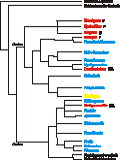 Abstract: Although the walls of most serpulid tubes are homogeneous, tubes of certain species may contain up to four ultrastructurally distinct layers. Some of these layers are made of densely packed large crystals and others are composed of sparsely packed fine crystals. In almost all (16 of 17) examined species having layered tubes, the dense layer is located in the outer wall part and the layer(s) composed of fine and relatively sparsely packed crystals are positioned in the inner wall part. Two species have transparent tube walls made entirely of densely packed crystals. Fossil serpulid tubes with dense outer layers (DOL) are known from the Late Cretaceous (Pentaditrupa subtorquata) and the Eocene (Pyrgopolon cf.
mellevillei and Rotularia spirulaea). DOL gives a characteristic smooth shiny appearance to the tube surface and presumably evolved as an adaptation against drilling predation by gastropods and to delay shell dissolution
in the waters of the deep-sea under-saturated with calcium carbonate. Abstract: Although the walls of most serpulid tubes are homogeneous, tubes of certain species may contain up to four ultrastructurally distinct layers. Some of these layers are made of densely packed large crystals and others are composed of sparsely packed fine crystals. In almost all (16 of 17) examined species having layered tubes, the dense layer is located in the outer wall part and the layer(s) composed of fine and relatively sparsely packed crystals are positioned in the inner wall part. Two species have transparent tube walls made entirely of densely packed crystals. Fossil serpulid tubes with dense outer layers (DOL) are known from the Late Cretaceous (Pentaditrupa subtorquata) and the Eocene (Pyrgopolon cf.
mellevillei and Rotularia spirulaea). DOL gives a characteristic smooth shiny appearance to the tube surface and presumably evolved as an adaptation against drilling predation by gastropods and to delay shell dissolution
in the waters of the deep-sea under-saturated with calcium carbonate.
|
|
Online since October 10, 2011
|
|
Letter 4 [2011]: Aptian ammonites of Abu Dhabi (United Arab Emirates), by Robert BUSNARDO & Bruno GRANIER.-
Format [HTML] or [PDF
2,150 KB]
Reference: [CG2011_L04]
DOI: 10.4267/2042/43895
Lang.:
|
|
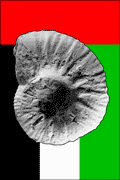 Abstract: The identification of some twenty ammonite fragments from oil wells drilled in offshore Abu Dhabi revealed the presence of six Aptian genera: Cheloniceras, Epicheloniceras, Gargasiceras, Colombiceras, Pseudohaploceras, and Macroscaphites. These ammonites indicate the Furcata Zone and the succeeding Martini Zone. The Gargasian age of the upper part (HST) of the Shu'aiba as well as that of the whole of the Bab are thus firmly established. Abstract: The identification of some twenty ammonite fragments from oil wells drilled in offshore Abu Dhabi revealed the presence of six Aptian genera: Cheloniceras, Epicheloniceras, Gargasiceras, Colombiceras, Pseudohaploceras, and Macroscaphites. These ammonites indicate the Furcata Zone and the succeeding Martini Zone. The Gargasian age of the upper part (HST) of the Shu'aiba as well as that of the whole of the Bab are thus firmly established.
|
|
Online since October 10, 2011
|
|
Letter 3 [2011]: Source and evolution of the clinopyroxenes in the Loire and Seine basins (France) based on grain morphology and color, by Robert ÉTIENNE & Jean-Pierre LARUE.-
Format [HTML] or [PDF
439 KB]
Reference: [CG2011_L03]
DOI: 10.4267/2042/43894
Lang.:
|
|
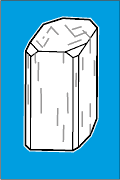 Abstract: Variation in the characteristics (color, morphology) of clinopyroxene grains (CPX) in alluvial deposits and other surficial formations in the Loire valley, the Gâtinais and the Beauce show that many are pristine and come directly from recent volcanic eruptions, whereas weathered grains, clearly reworked, come from erosion of Cenozoic and Pleistocene volcanic rocks of the French Massif Central. After deposition, the CPX have been increasingly altered by longer exposures. Weathering of brown CPX yields paler minerals which are greenish-brown, colourless or two-coloured. Similarly, the CPX found in the Seine basin are from recent volcanic ash or old Sologne deposits, and not from Loire alluvial deposits, so that a Pleistocene palaeo-Loire-Seine river is improbable. Abstract: Variation in the characteristics (color, morphology) of clinopyroxene grains (CPX) in alluvial deposits and other surficial formations in the Loire valley, the Gâtinais and the Beauce show that many are pristine and come directly from recent volcanic eruptions, whereas weathered grains, clearly reworked, come from erosion of Cenozoic and Pleistocene volcanic rocks of the French Massif Central. After deposition, the CPX have been increasingly altered by longer exposures. Weathering of brown CPX yields paler minerals which are greenish-brown, colourless or two-coloured. Similarly, the CPX found in the Seine basin are from recent volcanic ash or old Sologne deposits, and not from Loire alluvial deposits, so that a Pleistocene palaeo-Loire-Seine river is improbable.
|
|
Online since October 10, 2011
|
|
Letter 2 [2011]: Computer-aided identification of the Archaeocyatha genera now available
online, by Adeline KERNER, Régine VIGNES LEBBE & Françoise DEBRENNE.-
Format [HTML] or [PDF
965 KB]
Reference: [CG2011_L02]
DOI: 10.4267/2042/42329
Lang.:
|
|
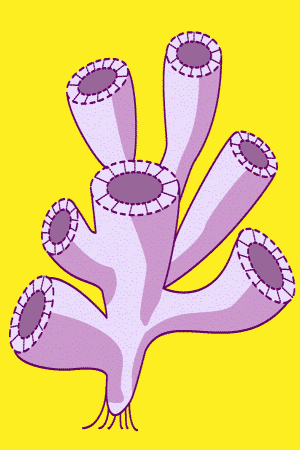 Abstract: The Archaeocyatha are a key group in several of the many discrete disciplines that together make feasible a valid history of the Earth: they are the oldest of the calcified sponges, the first metazoans to build reefs (in association with
calcimicrobes), are characteristic fossils used for the biozonation of the first,
pre-trilobitic Cambrian stage (Tommotian)… To date, a valid key to their identification has not been available, so a tool for that purpose has been devised: it was created using the software XPER2, and is now available free, online. Published in English, the knowledge base includes the 307 valid described genera identified by 120 descriptors (85 morphological and ontogenetic, 8 stratigraphic and geographic and 27 taxonomic). A key to identification is supplemented by detailed descriptive cards with images of type specimens of each genus and details of their morphology that aid identification. Abstract: The Archaeocyatha are a key group in several of the many discrete disciplines that together make feasible a valid history of the Earth: they are the oldest of the calcified sponges, the first metazoans to build reefs (in association with
calcimicrobes), are characteristic fossils used for the biozonation of the first,
pre-trilobitic Cambrian stage (Tommotian)… To date, a valid key to their identification has not been available, so a tool for that purpose has been devised: it was created using the software XPER2, and is now available free, online. Published in English, the knowledge base includes the 307 valid described genera identified by 120 descriptors (85 morphological and ontogenetic, 8 stratigraphic and geographic and 27 taxonomic). A key to identification is supplemented by detailed descriptive cards with images of type specimens of each genus and details of their morphology that aid identification.
|
|
Online since July 5, 2011
|
|
Article 4 [2011]: An outcrop with non-marine
ostracodes in the Early Eocene of Djebel Amour, central Saharian Atlas, Algeria:
taxonomy, palaeoecology and palaeobiogeography, by Fateh MEBROUK, Jean-Paul COLIN &
Fatima HENNACHE.-
Format [HTML] or [PDF
1,866 KB]
Reference: [CG2011_A04]
DOI: 10.4267/2042/42328
Lang.:
|
|
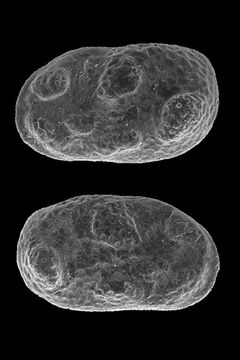 Abstract: An outcrop with non-marine ostracods in the Early Eocene of
Djebel Amour, an outcrop well dated by a rich charophyta microflora characterizing the Peckichara disermas Zone of the Early Eocene (Lower Ypresian = Ilerdian), has yielded an interesting non-marine ostracode fauna in the Djebel Amour, Western Saharian Atlas, in Algeria. This fauna is characterized by the dominance of the genus Neocyprideis with the new species Neocyprideis meguerchiensis nov. sp., and the occasional occurrence of the genera Hemicyprideis, Perissocytheridea (P. algeriensis nov. sp.) and Limnocythere. It is the second discovery of the genus Neocyprideis in the Palaeogene of the African continent, the first one being in the Early Eocene of Senegal. The Neocyprideis are represented by 75 % of smooth and normally calcified carapaces, 20 % by reticulate-noded specimens and 5 % of only reticulate forms. This polymorphism suggests a marked seasonality with fluctuating salinity. The dominance of smooth and well calcified morphs indicates an environment with an equilibrium
Ca++ / Mg++, the reticulate morphs characterizing waters richer in
Mg++. The presence of noded-reticulate forms suggests seasonal influxes of organo-siliceous material from the continent and a salinity which could temporarily reach values lower or equal to 5 psu. Abstract: An outcrop with non-marine ostracods in the Early Eocene of
Djebel Amour, an outcrop well dated by a rich charophyta microflora characterizing the Peckichara disermas Zone of the Early Eocene (Lower Ypresian = Ilerdian), has yielded an interesting non-marine ostracode fauna in the Djebel Amour, Western Saharian Atlas, in Algeria. This fauna is characterized by the dominance of the genus Neocyprideis with the new species Neocyprideis meguerchiensis nov. sp., and the occasional occurrence of the genera Hemicyprideis, Perissocytheridea (P. algeriensis nov. sp.) and Limnocythere. It is the second discovery of the genus Neocyprideis in the Palaeogene of the African continent, the first one being in the Early Eocene of Senegal. The Neocyprideis are represented by 75 % of smooth and normally calcified carapaces, 20 % by reticulate-noded specimens and 5 % of only reticulate forms. This polymorphism suggests a marked seasonality with fluctuating salinity. The dominance of smooth and well calcified morphs indicates an environment with an equilibrium
Ca++ / Mg++, the reticulate morphs characterizing waters richer in
Mg++. The presence of noded-reticulate forms suggests seasonal influxes of organo-siliceous material from the continent and a salinity which could temporarily reach values lower or equal to 5 psu.
|
|
Online since July 5, 2011
|
|
Article 3 [2011]: Ostracods distribution in the
subsurface sediments of El-Guettiate Sebkha (Skhira, gulf of Gabes). Interest
for Holocene palaeoenvironmental reconstruction, by
Chahira ZAÎBI, Fekri KAMOUN, Pierre CARBONEL & Mabrouk MONTACER.-
Format [HTML] or [PDF
1,598 KB]
Reference: [CG2011_A03]
DOI: 10.4267/2042/42327
Lang.:
|
|
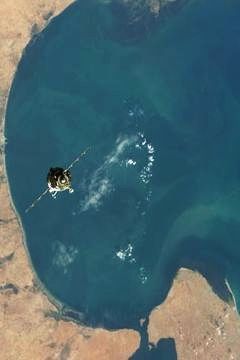 Abstract:
A quantitative and qualitative study of the ostracods from the SG1 and BSC2 cores
of El-Guettiate Sebkha of Skhira (southeastern Tunisia) has allowed the identification of different associations and the reconstruction of the Holocene palaeoenvironments. Ostracods, rich in species, provide three associations: (i)
a marine association containing Aurila prasina Barbieto-Gonzalez, 1971, Cushmanidea
elongata (Brady, 1868), Urocythereis oblonga (Brady, 1866), U.
favosa (Roemer, 1838) (coastal marine), Basselerites berchoni (Brady, 1869), Semicytherura incongruens (G.W. Müller, 1894), S.
paradoxa (G.W. Müller, 1894), S.
sella (Sars, 1866), S. ruggierii (Pucci, 1955), Carinocythereis carinata (Roemer, 1838)
and Paracytheridea depressa (G.W. Müller, 1894) (open
marine); (ii) lagoonal association, of variable salinity, comprising Xestoleberis aurantia (Baird, 1838), Leptocythere fabaeformis (G.W. Müller, 1894) and Cytherois fischeri (Sars, 1866); (iii) brackish estuarine association
subject to estuarine influence as indicated by Cyprideis torosa (Jones, 1850) and Loxoconcha elliptica Brady, 1868. The ostracods
from El-Guettiate Sebkha allow us to recognize discrete palaeoenvironments that can be grouped in three phases: i) the first (6595 ± 120 - 6055 ± 30 years BP) begins with an open lagoon rich in marine ostracods followed by an estuarine lagoon (towards 6595 years BP) characterized by the richness of brackish ostracods and high energy. In the last lagoonal environment (installed towards 6055 years BP), brackish species are dominant and associated with lagoonal taxa; ii) the second phase (6055 ± 30 years BP - 5150 ± 30 years BP)
is an estuarine lagoon, subject to a large marine influence in which brackish marine and lagoonal species are present
in the same percentages. In this environment, littoral drift currents were responsible for the genesis of sand
spits, the termination of environments and the dominance of brackish-water ostracods; iii) The last phase (5150 ± 50 years BP - recent)
represents a restricted lagoon (about 5150 years BP) and finally a brackish
lagoon evolved towards the sebkha environment under investigation here. This phase includes an unstable period with washover deposits resulting from an extreme climatic
event. Abstract:
A quantitative and qualitative study of the ostracods from the SG1 and BSC2 cores
of El-Guettiate Sebkha of Skhira (southeastern Tunisia) has allowed the identification of different associations and the reconstruction of the Holocene palaeoenvironments. Ostracods, rich in species, provide three associations: (i)
a marine association containing Aurila prasina Barbieto-Gonzalez, 1971, Cushmanidea
elongata (Brady, 1868), Urocythereis oblonga (Brady, 1866), U.
favosa (Roemer, 1838) (coastal marine), Basselerites berchoni (Brady, 1869), Semicytherura incongruens (G.W. Müller, 1894), S.
paradoxa (G.W. Müller, 1894), S.
sella (Sars, 1866), S. ruggierii (Pucci, 1955), Carinocythereis carinata (Roemer, 1838)
and Paracytheridea depressa (G.W. Müller, 1894) (open
marine); (ii) lagoonal association, of variable salinity, comprising Xestoleberis aurantia (Baird, 1838), Leptocythere fabaeformis (G.W. Müller, 1894) and Cytherois fischeri (Sars, 1866); (iii) brackish estuarine association
subject to estuarine influence as indicated by Cyprideis torosa (Jones, 1850) and Loxoconcha elliptica Brady, 1868. The ostracods
from El-Guettiate Sebkha allow us to recognize discrete palaeoenvironments that can be grouped in three phases: i) the first (6595 ± 120 - 6055 ± 30 years BP) begins with an open lagoon rich in marine ostracods followed by an estuarine lagoon (towards 6595 years BP) characterized by the richness of brackish ostracods and high energy. In the last lagoonal environment (installed towards 6055 years BP), brackish species are dominant and associated with lagoonal taxa; ii) the second phase (6055 ± 30 years BP - 5150 ± 30 years BP)
is an estuarine lagoon, subject to a large marine influence in which brackish marine and lagoonal species are present
in the same percentages. In this environment, littoral drift currents were responsible for the genesis of sand
spits, the termination of environments and the dominance of brackish-water ostracods; iii) The last phase (5150 ± 50 years BP - recent)
represents a restricted lagoon (about 5150 years BP) and finally a brackish
lagoon evolved towards the sebkha environment under investigation here. This phase includes an unstable period with washover deposits resulting from an extreme climatic
event.
|
|
Online since July 5, 2011
|
|
Memoir 1 [2011]: The "Theoi Marls" of
Pamproux (Deux-Sèvres, France), Antecedens sub-zone (Middle Oxfordian,
Plicatilis Zone): faunal diversity and discovery of new ammonite species, by
Philippe QUEREILHAC & Yvon GUINOT.-
Format [HTML] or [PDF
3,154 KB]
Reference: [CG2011_M01]
DOI:
10.4267/2042/42331
Lang.:
|
|
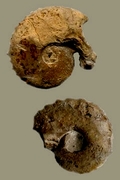 Abstract: Two road cuts at Doux and Pamproux in the Department of Deux Sèvres (Poitoux, France) exposed the base of the middle Oxfordian (Plicatilis Zone). Only the Pamproux section (on the Pampr'oeuf factory site) was studied in detail. There, the Plicatilis Zone is represented only by the Antecedens sudzone. Collections were made in situ and from rubble consisting solely of marls from the Antecedens Sub-zone. Sediment washing resulted in the collection of a very large number of very diversified and extremely small fossils. So a great number of individuals of two new species of Taramelliceratinae were discovered, along with two new species of "Glochiceras", their adult forms very different in size, resembling nothing so much as Ochetoceras (Ochetoceras) canaliculatum (von Buch,
1831) in the morph subclausum [m] Oppel, 1863. The sub-family Taramelliceratinae dominates the ammonite
fauna. Abstract: Two road cuts at Doux and Pamproux in the Department of Deux Sèvres (Poitoux, France) exposed the base of the middle Oxfordian (Plicatilis Zone). Only the Pamproux section (on the Pampr'oeuf factory site) was studied in detail. There, the Plicatilis Zone is represented only by the Antecedens sudzone. Collections were made in situ and from rubble consisting solely of marls from the Antecedens Sub-zone. Sediment washing resulted in the collection of a very large number of very diversified and extremely small fossils. So a great number of individuals of two new species of Taramelliceratinae were discovered, along with two new species of "Glochiceras", their adult forms very different in size, resembling nothing so much as Ochetoceras (Ochetoceras) canaliculatum (von Buch,
1831) in the morph subclausum [m] Oppel, 1863. The sub-family Taramelliceratinae dominates the ammonite
fauna.
|
|
Online since July 5, 2011
|
|
Article 2 [2011]: Difficulties in dating
Pleistocene marine levels using fossil mollusk shells: the Ouljian level on the
High Atlas shore, Morocco, by Abdelmajid
Choukri, Oum-Keltoum
HaKam
& Jean-Louis Reyss.-
Format [HTML] or [PDF
2,196 KB]
Reference: [CG2011_A02]
DOI:
10.4267/2042/39245
Lang.:
|
|
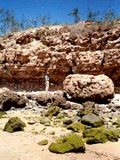 Abstract: In order to comprehend the difficulty of dating marine strata using samples of mollusks
shells and in an attempt to establish criteria that help in judging the validity of a
230Th /234U age determination, we present here the
results of a radioactive element analysis of some 80 samples of mollusk shells.
The shells were taken from fossil marine beaches between 4 and 8 meters above
current sea level. When compared with the Egyptian shore of the Red Sea these levels
are taken to be related to climate stage 5 dated as about 122,000 years ago. The ages obtained are often
rejuvenated regardless of site, the incidence of calcite, the amount of uranium and the
relationships of 234U/238U. Abstract: In order to comprehend the difficulty of dating marine strata using samples of mollusks
shells and in an attempt to establish criteria that help in judging the validity of a
230Th /234U age determination, we present here the
results of a radioactive element analysis of some 80 samples of mollusk shells.
The shells were taken from fossil marine beaches between 4 and 8 meters above
current sea level. When compared with the Egyptian shore of the Red Sea these levels
are taken to be related to climate stage 5 dated as about 122,000 years ago. The ages obtained are often
rejuvenated regardless of site, the incidence of calcite, the amount of uranium and the
relationships of 234U/238U.
Unlike coral, mineralogical criteria cannot be used to select mollusk
shells unaffected by recrystallization, for present-day shells may be composed
of aragonite, others are calcitic, and others contain both minerals. In any case,
the rules concerning their effects of composition on radioactivity are as yet poorly
understood. With these problems in mind, we made multiple analyses on several
species of of mollusks, always collected from the same sites, in order to
understand progressive changes in the process of age rejuvenation and to
attempt eventually to determine systematic criteria providing information on the
validity of the calculated age. Possible mechanisms that may influence the
incorporation of uranium in rejuvenation have been conceived and are discussed.
|
|
Online since April 27, 2011
|
|
Discussion of the Article CG2010_A01 [2011]: Discussion
of: Problems in the identity of "Crioceras" barremense Kilian, 1895 (Ancyloceratida, Late Barremian), and their proposed
resolution, by D. BERT et alii (CG2010_A01)
[Alternative title: The nomenclatural status and the acceptation
of the genus Barrancyloceras
VERMEULEN, 2000, and of
its type species], by Jean VERMEULEN.-
Format [HTML] or [PDF
165 KB]
Reference: [CG2010_A01R]
DOI:
10.4267/2042/39244
Lang.:
|
|
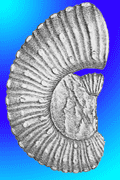 Abstract: This
work is a reply to the paper of Bert et
alii (2010) who contested the validity of the genus Barrancyloceras
and its type species. The answers and precisions brought up herein deal with: Abstract: This
work is a reply to the paper of Bert et
alii (2010) who contested the validity of the genus Barrancyloceras
and its type species. The answers and precisions brought up herein deal with:
- the nomenclatural status of Barrancyloceras
barremense (Kilian, 1895);
- the nomenclatural status of the genus Barrancyloceras
Vermeulen, 2000;
- the understanding of the species Barrancyloceras
barremense (Kilian, 1895);
- the value, as a subzone index species of subzone, of Barrancyloceras
barremense and B. alpinum.
|
|
Online since April 27, 2011
|
|
Letter 1 [2011]: The role of an internal organic tube lining in the biomineralization of serpulid tubes, by Olev VINN.-
Format [HTML] or [PDF
795 KB]
Reference: [CG2011_L01]
DOI:
10.4267/2042/38798
Lang.:
|
|
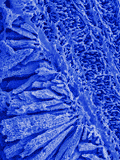 Abstract: Most
known serpulid tube ultrastructures in contact with an organic inner tube lining
do not show the direction in which they developed. But spherulitic prismatic
structures found in the innermost part of the tube wall of Recent Crucigera
websteri, C. zygophora, Floriprotis sabiuraensis, and Pyrgopolon
ctenactis indicate that the structure grew toward the organic inner tube
lining and also toward the tube's lumen. Similar directions of growth for this
structure are seen in Hydroides sp. from the Miocene of Austria. Growth
towards the tube's lumen is opposite to what one would expect if the organic
inner tube lining is being used as a scaffold for the biomineralization of CaCO3. Abstract: Most
known serpulid tube ultrastructures in contact with an organic inner tube lining
do not show the direction in which they developed. But spherulitic prismatic
structures found in the innermost part of the tube wall of Recent Crucigera
websteri, C. zygophora, Floriprotis sabiuraensis, and Pyrgopolon
ctenactis indicate that the structure grew toward the organic inner tube
lining and also toward the tube's lumen. Similar directions of growth for this
structure are seen in Hydroides sp. from the Miocene of Austria. Growth
towards the tube's lumen is opposite to what one would expect if the organic
inner tube lining is being used as a scaffold for the biomineralization of CaCO3.
|
|
Online since March 15, 2011
|
|
Article 1 [2011]: The Dichotomus Horizon: proposal for a new biochronologic unit of the Giraudi Zone of the Upper Barremian of southeastern France, and considerations regarding the genus Imerites Rouchadzé (Ammonoidea, Gassendiceratinae), by Didier BERT, Gérard DELANOY & Stéphane BERSAC.-
Format [HTML] or [PDF
786 KB]
Reference: [CG2011_A01]
DOI:
10.4267/2042/36091
Lang.:
|
|
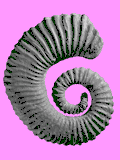 Abstract: Recent revisions of the genus Imerites Rouchadzé make it possible to introduce a new biochronologic horizon to define more precisely the lower boundary of the Giraudi Zone: the Dichotomus Horizon. Using the concept of 'interval zone', this new horizon maintains the current lower boundary of the Giraudi Zone as accepted by authors, and thus contributes to the stabilization of the Barremian zonal system. This stabilization is also strengthened by abandonment of the use of
"Crioceras" cristatus d'Orbigny (nomen dubium) that ought not be used as an index species in detriment of Imerites giraudi (Kilian). The classification, origin, and intraspecific variation of the genus Imerites Rouchadzé are examined. Abstract: Recent revisions of the genus Imerites Rouchadzé make it possible to introduce a new biochronologic horizon to define more precisely the lower boundary of the Giraudi Zone: the Dichotomus Horizon. Using the concept of 'interval zone', this new horizon maintains the current lower boundary of the Giraudi Zone as accepted by authors, and thus contributes to the stabilization of the Barremian zonal system. This stabilization is also strengthened by abandonment of the use of
"Crioceras" cristatus d'Orbigny (nomen dubium) that ought not be used as an index species in detriment of Imerites giraudi (Kilian). The classification, origin, and intraspecific variation of the genus Imerites Rouchadzé are examined.
|
|
Online since January 17, 2011
|

|
|
2010 (vol. 10)
|
|
Article 9 [2010]: Lower Devonian faunas and palynomorphs from the Dornes Syncline (Central Iberian Zone, Portugal): stratigraphical and paleogeographical
implications, by Rémy GOURVENNEC, José Manuel PIÇARRA, Yves PLUSQUELLEC, Zélia PEREIRA, José Tomás OLIVEIRA & Michel ROBARDET.-
Format [HTML] or [PDF
2,012 KB]
Reference: [CG2010_A09]
DOI: 10.4267/2042/35627
Lang.:
|
|
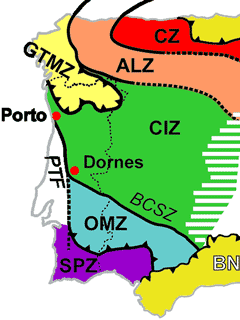 Abstract: In the Dornes syncline, southern Central Iberian Zone, Portugal, the uppermost levels of the Serra do Luação Formation up to now have been considered to be of
Pridoli-Lochkovian? age because they lie immediately under the Dornes Formation, which is of Pragian age and is well defined
stratigraphically. New paleontological elements including benthic faunas and palynomorphs allow us to confirm that the top of the Serra do Luação Formation is securely
Lochkovian, for upper Lochkovian strata are present although relatively thin. The transition from the Serra do Luação to the Dornes formations and their lithostratigraphical relationship are now clear: the terrigenous succession belongs to the Serra do Luação Formation and the limestones represent the Dornes Formation. The benthic faunas clearly have
North-Gondwanan affinities. Abstract: In the Dornes syncline, southern Central Iberian Zone, Portugal, the uppermost levels of the Serra do Luação Formation up to now have been considered to be of
Pridoli-Lochkovian? age because they lie immediately under the Dornes Formation, which is of Pragian age and is well defined
stratigraphically. New paleontological elements including benthic faunas and palynomorphs allow us to confirm that the top of the Serra do Luação Formation is securely
Lochkovian, for upper Lochkovian strata are present although relatively thin. The transition from the Serra do Luação to the Dornes formations and their lithostratigraphical relationship are now clear: the terrigenous succession belongs to the Serra do Luação Formation and the limestones represent the Dornes Formation. The benthic faunas clearly have
North-Gondwanan affinities.
|
|
Online since December 31, 2010
|
|
Article 8 [2010]: Systematics, phylogeny and homeomorphy of the Engonoceratidae Hyatt, 1900 (Ammonoidea, Cretaceous) and revision of
Engonoceras duboisi Latil, 1989, by László BUJTOR.-
Format [HTML] or [PDF
6,671 KB]
Reference: [CG2010_A08]
DOI: 10.4267/2042/35626
Lang.:
|
|
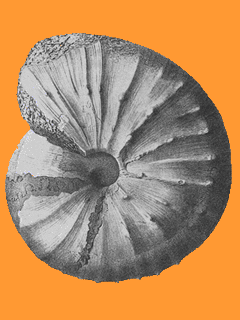 Abstract: The Engonoceratidae may well have originated on the shallow marine carbonate platforms of the southern margin of the Mediterranean Province of the Tethyan Realm during the
earliest Albian (?latest Aptian). In the entire Tethyan Realm and beyond adaptive radiation of the group was rapid and successful during the early Albian as indicated by endemic centres in the Peruvian Basin and the Western Interior Sea (USA). Later the group successfully enlarged its distribution, and invaded some provinces
(Mowry Sea, Canada) of the Boreal Realm. The mode of life of engonoceratids seems to have been
nektoplanktonic, epipelagic, and stenohaline, restricted to shallow water and platform or in some cases extremely shallow (littoral and
lagoonal) facies which may have helped their radiation. The group is distinctive and consists of nine genera and up to a hundred species, although its origin is still obscure. Their appearance may have been triggered by the oceanic anoxic event
(OAE 1b) and their rapid rise may have been helped by their shallow water mode of life and the global mid-Cretaceous warming and rise in sea level. The fall of the engonoceratids coincides with the
end-Cenomanian rapid transgression, which may have changed their shallow water habitats. Today the group is considered to have been a successful colonizer, a reliable stratigraphical indicator for shallow marine environments and a pioneer taxon for recognition of transgressive phases. Abstract: The Engonoceratidae may well have originated on the shallow marine carbonate platforms of the southern margin of the Mediterranean Province of the Tethyan Realm during the
earliest Albian (?latest Aptian). In the entire Tethyan Realm and beyond adaptive radiation of the group was rapid and successful during the early Albian as indicated by endemic centres in the Peruvian Basin and the Western Interior Sea (USA). Later the group successfully enlarged its distribution, and invaded some provinces
(Mowry Sea, Canada) of the Boreal Realm. The mode of life of engonoceratids seems to have been
nektoplanktonic, epipelagic, and stenohaline, restricted to shallow water and platform or in some cases extremely shallow (littoral and
lagoonal) facies which may have helped their radiation. The group is distinctive and consists of nine genera and up to a hundred species, although its origin is still obscure. Their appearance may have been triggered by the oceanic anoxic event
(OAE 1b) and their rapid rise may have been helped by their shallow water mode of life and the global mid-Cretaceous warming and rise in sea level. The fall of the engonoceratids coincides with the
end-Cenomanian rapid transgression, which may have changed their shallow water habitats. Today the group is considered to have been a successful colonizer, a reliable stratigraphical indicator for shallow marine environments and a pioneer taxon for recognition of transgressive phases.
Based on new material and sutural analysis, Engonoceras duboisi is revised and assigned to Parengonoceras. A set of features consisting of a simplified ceratitid suture, lanceolate and compressed oxycone shell together comprising a shallow marine ecotype is pointed out as a successful and repeated morphotype among Mesozoic
Ammonoidea, for it was repeated three times during ammonoid evolution.
|
|
Online since December 24, 2010
|
|
Letter 4 [2010]: Early large borings from a hardground of Floian-Dapingian age (Early and Middle Ordovician) in northeastern Estonia
(Baltica), by Olev VINN & Mark A. WILSON.-
Format [HTML] or [PDF
330 KB]
Reference: [CG2010_L04]
DOI: 10.4267/2042/35594
Lang.:
|
|
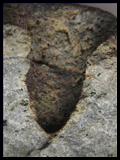 Abstract: Large plug- or slightly amphora-shaped borings have been found in the hardground marking the boundary between Early and Middle Ordovician rocks in northeastern Estonia. These borings cut large bioclasts of the trilobite
Megistaspis and cannot be assigned with certainty to any known ichnotaxon. They indicate that the diversity of early borings may have been greater than was recognized previously. Abstract: Large plug- or slightly amphora-shaped borings have been found in the hardground marking the boundary between Early and Middle Ordovician rocks in northeastern Estonia. These borings cut large bioclasts of the trilobite
Megistaspis and cannot be assigned with certainty to any known ichnotaxon. They indicate that the diversity of early borings may have been greater than was recognized previously.
|
|
Online since December 14, 2010
|
|
Letter 3 [2010]: Fossil Phoronida and their inferred ichnotaxa, by Christian C. EMIG.-
Format [HTML] or [PDF
779 KB]
Reference: [CG2010_L03]
DOI: 10.4267/2042/35531
Lang.:
|
|
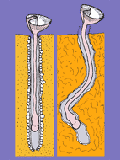 Abstract: Various ichnotaxa found in hard substrates are interpreted as
"phoronid" trace fossils. Their records are briefly reviewed. An interpretation of Diorygma found in the shells of brachiopods is not compatible with phoronid morphology and anatomy. Criteria for the discrimination of phoronid burrows and borings from those of similar organisms from others are difficult to establish even when the evidence and conclusions made therefrom are
sound. Abstract: Various ichnotaxa found in hard substrates are interpreted as
"phoronid" trace fossils. Their records are briefly reviewed. An interpretation of Diorygma found in the shells of brachiopods is not compatible with phoronid morphology and anatomy. Criteria for the discrimination of phoronid burrows and borings from those of similar organisms from others are difficult to establish even when the evidence and conclusions made therefrom are
sound.
|
|
Online since November 30, 2010
|
|
Article 7 [2010]: The evolution of ammonite associations
during the Early Oxfordian (Mariae and Cordatum zones) in the Jura area (eastern
France), by Rémi JARDAT.-
Format [HTML] or [PDF
2,174 KB]
Reference: [CG2010_A07]
DOI: 10.4267/2042/35492
Lang.:
|
|
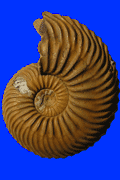 Abstract: The study of more than 40 sections in the "Creniceras renggeri
marls" of the French Jura Range (Lower Oxfordian) has found: Abstract: The study of more than 40 sections in the "Creniceras renggeri
marls" of the French Jura Range (Lower Oxfordian) has found:
- a precise biochronostratigraphic subdivison
of 16 successive populations or associations which appears to be stable over the whole geographic
area concerned;
- the correlation of these populations with the
Lower Oxfordian zones of the GFÉJ (French Research Jurassic
Group) and with those of southern England (Weymouth) and Poland (Cracow area);
- an autecologic and synecologic analysis of Oxfordian
ammonite associations in the Jura Mountains;
- an interpretation of these faunas in terms of palaeo-depth and sequence stratigraphy
units.
The main results of the study are the following:
- identification of the Costicardia Subzone;
- validation of the subdivision of the Mariae Zone established by Fortwengler and Marchand
(1994), with a woodhamense horizon above a scarburgense
horizon;
- division of the woodhamense horizon into two
units: the lower one is the woodhamense s.s. unit and the upper one
includes abundant specimens of woodhamense var. normandiana Spath;
- correlation of tectonic units on either side of the Salins
fault and of some characteristics of the ammonite populations;
- identification of five steps of changes
in depth in the Jura area which may be interpreted as sequence stratigraphic
units: a first episode
of deepening during the period bounded by the scarburgense
and praemartini horizons, an episode of stability bounded by the
beginning and the end of
the alphacordatum horizon, a slight regressive trend that lasted
throughout the
duration of the praecordatum horizon, a second episode of stability that
persisted from the Bukowskii Subzone to the Costicardia Subzone, and a third
deepening trend during the existence of the Cordatum Subzone.
|
|
Online since November 22, 2010
|
|
Article 6 [2010]: Biostratigraphic distribution of
orbitolinids in the ammonite biozones (Urgonian platform of southeastern France).
Part 1: Upper Hauterivian-lowermost Barremian, by Bernard CLAVEL, Robert BUSNARDO, Jean CHAROLLAIS, Marc André CONRAD & Bruno GRANIER.-
Format [HTML] or [PDF
34,646 KB]
Reference: [CG2010_A06]
DOI: 10.4267/2042/33369
Lang.:
|
|
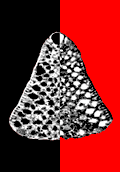 Abstract: The proposed biostratigraphic distribution of
orbitolinids from the Upper Hauterivian and the lowermost Barremian of SE
France is correlated with the ammonite biozonation. It is based on the
detailed study of eight sections which delivered orbitolinids intercalated with or
capped by levels with ammonites and, in some cases, echinids and dasycladales. Among the 24 species of orbitolinids
present during that period, 3 are restricted to the Late Hauterivian: Praedictyorbitolina busnardoi, Paleodictyoconus beckerae
and Valserina primitiva. Abstract: The proposed biostratigraphic distribution of
orbitolinids from the Upper Hauterivian and the lowermost Barremian of SE
France is correlated with the ammonite biozonation. It is based on the
detailed study of eight sections which delivered orbitolinids intercalated with or
capped by levels with ammonites and, in some cases, echinids and dasycladales. Among the 24 species of orbitolinids
present during that period, 3 are restricted to the Late Hauterivian: Praedictyorbitolina busnardoi, Paleodictyoconus beckerae
and Valserina primitiva.
|
|
Online since August 27, 2010
|
|
Article 5 [2010]: Barremian-Aptian Dasycladalean algae, new and revisited, from the Tirgan Formation in the Kopet Dagh, NE Iran, by Morteza TAHERPOUR KHALIL ABAD, Marc André CONRAD, Ali Asghar ARYAEI Aryaei & Ali Reza ASHOURI.-
Format [HTML] or [PDF
6,671 KB]
Reference: [CG2010_A05]
DOI: 10.4267/2042/33368
Lang.:
|
|
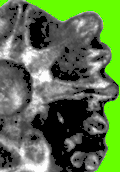 Abstract: Abundant, diversified algal assemblages comprising
more than 25 species of Dasycladales are described from Barremian-Aptian limestone deposits of the Tirgan
Formation in NE Iran. New species are described: one of them possibly belongs to a new endosporate genus, tentatively assigned the
Triploporellaceae; two others, Clypeina ? sp. 1 and Rajkaella ? sp.
1, are left in open nomenclature. The widely distributed, locally abundant Montiella ? elitzae is revisited,
because of the presence of a complete, exceptionally well preserved specimen. Yet to be demonstrated, the species is a junior synonym of Turkmenaria adducta Maslov, also
originally described from the Kopet
Dagh. Other species found in the Arkan section have already been reported from remote locations, primarily in Europe, in areas corresponding to the Northern and/or Southern Tethyan domains. Some of them are known only from the Hauterivian and/or the Barremian, excluding the Aptian, thus
dating the lower part of the Arkan section as Barremian, but not excluding the Late Hauterivian. Abstract: Abundant, diversified algal assemblages comprising
more than 25 species of Dasycladales are described from Barremian-Aptian limestone deposits of the Tirgan
Formation in NE Iran. New species are described: one of them possibly belongs to a new endosporate genus, tentatively assigned the
Triploporellaceae; two others, Clypeina ? sp. 1 and Rajkaella ? sp.
1, are left in open nomenclature. The widely distributed, locally abundant Montiella ? elitzae is revisited,
because of the presence of a complete, exceptionally well preserved specimen. Yet to be demonstrated, the species is a junior synonym of Turkmenaria adducta Maslov, also
originally described from the Kopet
Dagh. Other species found in the Arkan section have already been reported from remote locations, primarily in Europe, in areas corresponding to the Northern and/or Southern Tethyan domains. Some of them are known only from the Hauterivian and/or the Barremian, excluding the Aptian, thus
dating the lower part of the Arkan section as Barremian, but not excluding the Late Hauterivian.
|
|
Online since August 27, 2010
|
|
Article 4 [2010]: The Abiod at Ellès (Tunisia):
stratigraphies, Campanian-Maastrichtian boundary, correlation, by Francis ROBASZYNSKI & Moncef MZOUGHI.-
Format [HTML] or [PDF
5,932 KB]
Reference: [CG2010_A04]
DOI: 10.4267/2042/33367
Lang.:
|
|
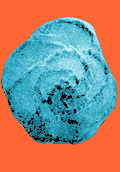 Abstract: [The Abiod Formation at Ellès (Tunisia): tripartite lithology, biohorizons based on globotruncanids and ammonites, duration, location of Campanian-Maastrichtian boundary, correlation with Kalaat Senan and the Tercis (France) stratotype] Abstract: [The Abiod Formation at Ellès (Tunisia): tripartite lithology, biohorizons based on globotruncanids and ammonites, duration, location of Campanian-Maastrichtian boundary, correlation with Kalaat Senan and the Tercis (France) stratotype]
In central Tunisia near the village of Ellès is Wadi Ed Dam.
There the Abiod Formation, underlain by the Kef marls and capped by the El Haria marls, crops out in an almost uninterrupted exposure about 286 m thick. In view of its possible use as a regional litho- and bio- stratigraphic reference section for the southern border of the Tunisian trough it is examined in detail here. Fossils studied include foraminifera (115 samples representing 6 micropaleontologic zones, see chart) and ammonites. The biohorizons established are based on the first (FO) or last occurrence (LO) of certain species of planktonic foraminifers in addition to the FO of already established foraminiferal zonal markers. Ammonite markers found include both the FO and LO of some forms, or just one or the other.
The location of the Campanian-Maastrichtian (Cp-Ma) boundary time line at Ellès is established by comparison with that determined at Kalaat-Senan and with that of the international stratotype of Tercis (France), ratified by the International Union of Geological Sciences.
At Kalaat-Senan the Cp-Ma boundary is set at the lower third of
the upper indurated limestone bar of the Abiod Formation - the Ncham Member. Its location at Kalaat-Senan is based on the upper limit of occurrence of Nostoceras (Nostoceras) hyatti and Pseudokossmaticeras brandti together with the FO of Nostoceras magdadiae, a Maastrichtian
ammonite. At Ellès several of these same markers are present, along with the respective planktonic foraminiferal zones.
The length in years of some lithologic units and paleontologic zones in the Upper Cretaceous succession of wadi Ed Dam was calculated using
cyclostratigraphy. The Abiod Formation represents 13.2 Ma, the Radotruncana calcarata
Zone 0.79 Ma, and the Nostoceras (Bostrychoceras) polyplocum
Zone 0.97 Ma. A proposed subdivision of the Upper Campanian is recommended at the base of the Bostrychoceras
Zone.
Li et alii's 1999 proposal for fixing the location of the Cp-Ma boundary at the top of a limestone bed in the El Haria marls is reviewed.
|
|
Online since August 27, 2010
|
|
Article 3 [2010]: Bucurella,
a new genus of the Thyrsoporelleae (fossil Dasycladalean algae), by Bruno GRANIER.-
Format [HTML] or [PDF
2,462 KB]
Reference: [CG2010_A03]
DOI: 10.4267/2042/32425
Lang.:
|
|
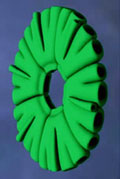 Abstract:
A new genus, Bucurella, is described and
figured; it is based on Macroporella espichelensis Deloffre et Ramalho, 1971, a taxon known only from the Late Jurassic. It is characterized by the
presence of distinctive whorls, each with three thick and broad (fertile) ramifications. The lateral division formula is 1 F:
3 F: (3x2) F: (3x2x2) F = (1: 3: 6: 12); that is the primary ramification divides into three secondaries which in turn branch
dichotomously into tertiaries and again into quaternaries. It and its descendant, Zergabriella,
are assigned to the Tribe Thyrsoporelleae. Abstract:
A new genus, Bucurella, is described and
figured; it is based on Macroporella espichelensis Deloffre et Ramalho, 1971, a taxon known only from the Late Jurassic. It is characterized by the
presence of distinctive whorls, each with three thick and broad (fertile) ramifications. The lateral division formula is 1 F:
3 F: (3x2) F: (3x2x2) F = (1: 3: 6: 12); that is the primary ramification divides into three secondaries which in turn branch
dichotomously into tertiaries and again into quaternaries. It and its descendant, Zergabriella,
are assigned to the Tribe Thyrsoporelleae.
|
|
Online since May 31, 2010
|
|
Article 2 [2010]: Traces of explosive volcanism in the Pyrenean Campanian around the Campanian-Maastrichtian boundary type section at Tercis (SW France, N Spain).
Biostratigraphy with emphasis on the foraminifer Radotruncana calcarata, by Gilles Serge ODIN.-
Format [HTML] or [PDF
6,809 KB]
Reference: [CG2010_A02]
DOI: 10.4267/2042/32424
Lang.:
|
|
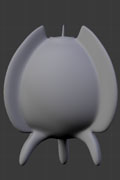 Abstract: Pyroclastic material including idiomorphic crystals of sanidine, biotite, and apatite, first identified in the type section at Tercis are contemporaneous with the Radotruncana calcarata (planktonic foraminifer) total range zone. A search was undertaken to define the palaeogeographical extent and to determine the importance of these remains of a previously unknown Campanian regional alkaline volcanic episode. A preliminary biostratigraphical search was carried out in the Tercis area and in the western Pyrenees followed by detailed micropalaeontological studies in southwestern France and northern Spain. The findings from five upper Campanian platform and flysch facies are reported in detail and deductions from three others are summarized. First, The microfaunal count of the boundary stratotype at Tercis has been increased by the use of acetolytic techniques to disaggregate indurated carbonates. So isolated tests of some key biostratigraphic markers are documented for the first time. The paucity in specimens of Radotruncana calcarata previously seen in thin sections from the type outcrop is not due to a scarcity of this particular taxon but to a general dearth of globotruncanids in the platform facies deposits of the Aturian Basin. The study shows that acetolysis multiplies the power of investigation of indurated limestones. Thus, the abundance and diversity of microproblematica discovered and studied in the stratotype section since 2006 has been confirmed and two new forms of incertae sedis are reported, one of which is called here Velafer ovatus. Today, 70 species of microproblematica are recognized at Tercis. These microproblematica allow a chronologic calibration of the deposits like or even more precise than those obtainable using ammonites or planktonic foraminifers. Sections sampled in the western Pyrenean flysch facies include the stratigraphic interval comprising the total range zone of Rd. calcarata for which we suggest here a duration of0.80 ±0.05 Ma. No microproblematica were found in these deep detrital facies. Abstract: Pyroclastic material including idiomorphic crystals of sanidine, biotite, and apatite, first identified in the type section at Tercis are contemporaneous with the Radotruncana calcarata (planktonic foraminifer) total range zone. A search was undertaken to define the palaeogeographical extent and to determine the importance of these remains of a previously unknown Campanian regional alkaline volcanic episode. A preliminary biostratigraphical search was carried out in the Tercis area and in the western Pyrenees followed by detailed micropalaeontological studies in southwestern France and northern Spain. The findings from five upper Campanian platform and flysch facies are reported in detail and deductions from three others are summarized. First, The microfaunal count of the boundary stratotype at Tercis has been increased by the use of acetolytic techniques to disaggregate indurated carbonates. So isolated tests of some key biostratigraphic markers are documented for the first time. The paucity in specimens of Radotruncana calcarata previously seen in thin sections from the type outcrop is not due to a scarcity of this particular taxon but to a general dearth of globotruncanids in the platform facies deposits of the Aturian Basin. The study shows that acetolysis multiplies the power of investigation of indurated limestones. Thus, the abundance and diversity of microproblematica discovered and studied in the stratotype section since 2006 has been confirmed and two new forms of incertae sedis are reported, one of which is called here Velafer ovatus. Today, 70 species of microproblematica are recognized at Tercis. These microproblematica allow a chronologic calibration of the deposits like or even more precise than those obtainable using ammonites or planktonic foraminifers. Sections sampled in the western Pyrenean flysch facies include the stratigraphic interval comprising the total range zone of Rd. calcarata for which we suggest here a duration of0.80 ±0.05 Ma. No microproblematica were found in these deep detrital facies.
All sections reaching the Campanian-Maastrichtian boundary contain a Contusotruncana (foraminifer) of which the morphology, illustrated anew from 3 discrete sections, is consistent with that of the specimens identified at this level in the Tercis type-section; they were called C. contusa or C. contusa?/C. patelliformis? These micropalaeontological studies substantiate the choice of Tercis as the best section in the world for location of the stratotype of the Campanian-Maastrichtian stage boundary; they show again its striking regional and global correlative power thanks to the unique diversity of its biological record of the late Cretaceous. In addition, it justifies the choice of a boundary level selected using the near-coincidence of a variety of key events bracketting a guide-event; 12 were clustered around the mid-level 115.2 of the type section where the GSSP of the Campanian-Maastrichtian boundary has been recognized internationally. Consequently, the selected level does not depend on a unique "magic marker" with its inherent uncertainty caused by difficulty in identification and scarcity locally and in other localities and environments. This may well be the case for the guide-ammonite Pachydiscus neubergicus as commonly used as a marker of the Campanian-Maastrichtian
boundary.
The biostratigraphical study precisely locates the pyroclastic material observed at Tercis as within the range of Rd. calcarata, immediately above the last occurrence of Tubellus hunzikeri, the first occurrences of Lucernellus aubouini and Aquilegiella varia, 3 microproblematica of which the distribution is well documented at Tercis. Previously reported evidences of volcanism at Tercis: the presence of kaolinite in the clay size fraction and of microcrystals of sanidine, biotite, zircon, apatite are supplemented here by the discovery of slightly calcic and sodic siliceous spherules with traces of magnesium, aluminum and potassium. Kaolinite and sanidine have also been found in contemporaneous levels at Peyrata, in the vicinity of the type section. Farther away in the flysch facies, the contemporaneous deposits contain pyroclastic biotite mica flakes, idiomorphic zircon crystals and, more rarely, apatite crystals of which the morphology is consistent with a volcanic origin. The presence of traces of a volcanic episode in Campanian levels representing about 1 Ma of deposition are thus confirmed but in the Pyrenees no information is available concerning the site of its origin. In fact, the explanations for the presence of the pyroclastic material involves two possibilities: either there was Campanian alkaline volcanic activity in the Pyrenees similar to that associated with subduction (which has not been identified and is not consistent with the accepted geodynamical model of the area) or the pyroclastic material comes from North America, distant some 5000 km. Such long distance transport would involve an west-east eolian conveyance of mm sized volcanic elements for 1 Ma (a hypothesis to our knowledge
undocumented).
|
|
Online since May 31, 2010
|
|
Letter 2 [2010]: Hadrosaur remains in the Late Cretaceous marine sediments of Larcan (Petites Pyrenees, Haute-Garonne, France), by Michel BILOTTE, Yves LAURENT & Dominique TÉODORI.-
Format [HTML] or [PDF
1,166 KB]
Reference: [CG2010_L02]
DOI: 10.4267/2042/32428
Lang.:
|
|
 Abstract: The discovery of two hadrosaur fragments (maxilla and quadrate) in marine sediments of the end of the Cretaceous (uppermost Maastrichtian) is reported. Although this type of taphocoenosis is not exceptional for continental organisms, its situation at approximately
1 m under the iridium zone of the K/T boundary deserves to be emphasized. Abstract: The discovery of two hadrosaur fragments (maxilla and quadrate) in marine sediments of the end of the Cretaceous (uppermost Maastrichtian) is reported. Although this type of taphocoenosis is not exceptional for continental organisms, its situation at approximately
1 m under the iridium zone of the K/T boundary deserves to be emphasized.
|
|
Online since May 31, 2010
|
|
Article 1 [2010]: Problems in the identity of "Crioceras" barremense Kilian, 1895 (Ancyloceratida, Late Barremian), and their proposed resolution, by Didier BERT, Robert BUSNARDO, Gérard DELANOY & Stéphane BERSAC.-
Format [HTML] or [PDF
1,983 KB]
Reference: [CG2010_A01]
DOI: 10.4267/2042/32967
Lang.:
|
|
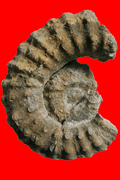 Abstract: The study of "Crioceras" barremense Kilian
was undertaken as a part of the revision of the Hemihoplitidae. This species was
considered "classic" and has been used as the index of an Upper
Barremian subzone; this usage raises a number of problems. The type specimen
from Tyrol was a fragment described and illustrated by Uhlig
as Crioceras sp. ind. aff. roemeri. This specimen could not be
retrieved, and a topotype could not be collected. Our study revealed that there
is both a biostratigraphic hiatus and important differences between conceptions
of this species: (1) that ascribed Uhlig's type
specimen (Upper Barremian, Tyrol), (2) Kilian's
concept of the specimen he found and named "Crioceras" barremense
(probably a Camereiceras from the uppermost levels of the Vandenheckei
Subzone or from the basal Sartousiana subzone of the Nauvin site, southeastern
France) and (3) current interpretations of authors, who often synonymize the
type specimen with Gassendiceras alpinum (d'Orbigny),
which occurs in the middle of the Vandenheckei Subzone. So there is a real
confusion concerning the synonymy of "Crioceras" barremense.
The age of Uhlig's type specimen is too imprecise
and its preservation too fragmentary to be reliably identifiable, because the
same morphology and ornamentation exist in several species of other genera.
Therefore, we recommend the use of the species "Crioceras" barremense Kilian
be avoided, in particular as an index, along with that of the genus Barrancyloceras Vermeulen
for which "C." barremense is used as reference. Some
species formerly assigned to this genus have been referred to the genus Gassendiceras Bert et alii.
Consequently, we also recommend the Barremense auctorum Subzone be
renamed the Alpinum Subzone (new) [index-species: Gassendiceras alpinum
(d'Orbigny)], without changing its limits as
currently defined. The lower limit of this subzone is indicated by the first
occurrence of Gassendiceras alpinum (a new biohorizon, introduced here),
a common, easily identifiable species with a well-defined stratigraphic range. Abstract: The study of "Crioceras" barremense Kilian
was undertaken as a part of the revision of the Hemihoplitidae. This species was
considered "classic" and has been used as the index of an Upper
Barremian subzone; this usage raises a number of problems. The type specimen
from Tyrol was a fragment described and illustrated by Uhlig
as Crioceras sp. ind. aff. roemeri. This specimen could not be
retrieved, and a topotype could not be collected. Our study revealed that there
is both a biostratigraphic hiatus and important differences between conceptions
of this species: (1) that ascribed Uhlig's type
specimen (Upper Barremian, Tyrol), (2) Kilian's
concept of the specimen he found and named "Crioceras" barremense
(probably a Camereiceras from the uppermost levels of the Vandenheckei
Subzone or from the basal Sartousiana subzone of the Nauvin site, southeastern
France) and (3) current interpretations of authors, who often synonymize the
type specimen with Gassendiceras alpinum (d'Orbigny),
which occurs in the middle of the Vandenheckei Subzone. So there is a real
confusion concerning the synonymy of "Crioceras" barremense.
The age of Uhlig's type specimen is too imprecise
and its preservation too fragmentary to be reliably identifiable, because the
same morphology and ornamentation exist in several species of other genera.
Therefore, we recommend the use of the species "Crioceras" barremense Kilian
be avoided, in particular as an index, along with that of the genus Barrancyloceras Vermeulen
for which "C." barremense is used as reference. Some
species formerly assigned to this genus have been referred to the genus Gassendiceras Bert et alii.
Consequently, we also recommend the Barremense auctorum Subzone be
renamed the Alpinum Subzone (new) [index-species: Gassendiceras alpinum
(d'Orbigny)], without changing its limits as
currently defined. The lower limit of this subzone is indicated by the first
occurrence of Gassendiceras alpinum (a new biohorizon, introduced here),
a common, easily identifiable species with a well-defined stratigraphic range.
|
|
Online since April 4, 2010
|
|
Letter 1 [2010]: A pterosaur from the Toarcian (Early Jurassic) of the Ardennes (north-eastern France), by Eric BUFFETAUT, Bernard GIBOUT & Danielle DROUIN.-
Format [HTML] or [PDF
735 KB]
Reference: [CG2010_L01]
DOI: 10.4267/2042/32427
Lang.:
|
|
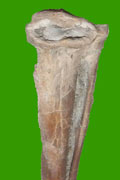 Abstract: A pterosaur tibia-fibula is described from Toarcian shales ("Marne de
Flize") near the city of Charleville-Mézières (Ardennes, northeastern France). The morphology of this element, especially the reduced fibula partially fused to the tibia, suggests that it belongs to the rhamphorhynchid Dorygnathus, which is well represented in the Toarcian Posidonienschiefer of Germany and has also been reported from the Toarcian of Nancy (eastern France). Abstract: A pterosaur tibia-fibula is described from Toarcian shales ("Marne de
Flize") near the city of Charleville-Mézières (Ardennes, northeastern France). The morphology of this element, especially the reduced fibula partially fused to the tibia, suggests that it belongs to the rhamphorhynchid Dorygnathus, which is well represented in the Toarcian Posidonienschiefer of Germany and has also been reported from the Toarcian of Nancy (eastern France).
|
|
Online since February 15, 2010
|

|
|
2009 (vol. 9)
|
|
Article 10 [2009]: The Gargasian of Gargas (Vaucluse, SE France): Synthesis of field data and revision of the foraminiferal and ostracodal microfauna, by Michel MOULLADE, Guy TRONCHETTI & Jean-François BABINOT.-
Format [HTML] or [PDF
975 KB]
Reference: [CG2009_A10]
DOI: 10.4267/2042/30051
Lang.:
|
|
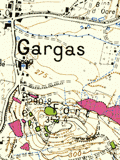 Abstract: Because of urbanization the section at Gargas, historical stratotype of the Aptian stage and of the Gargasian substage, is no longer accessible. However, samples taken there in 1966 by one of us make feasible a reinterpretation of this series in the light of taxonomic and biostratigraphic data from a recent study of Aptian microfaunas from La Tuilière area, some 5 km away. Abstract: Because of urbanization the section at Gargas, historical stratotype of the Aptian stage and of the Gargasian substage, is no longer accessible. However, samples taken there in 1966 by one of us make feasible a reinterpretation of this series in the light of taxonomic and biostratigraphic data from a recent study of Aptian microfaunas from La Tuilière area, some 5 km away.
This new micropaleontologic interpretation shows that the historical section is truncated at its base : the lower (not lowermost) Gargasian is in quasi-direct contact with Urgonian limestones ; the uppermost (marly) Bedoulian, known to be present westward towards Le Chêne as well as at La Tuilière, is absent in the stratotype outcrop. In the samples from the stratotypic succession we have identified (bottom upward):
• the upper part of the Praehedbergella luterbacheri zone and the Globigerinelloides ferreolensis zone,
• the G. barri zone,
• the beginning of the G. algerianus zone,
i.e. these zones comprise the major part of the lower Gargasian, the middle Gargasian and the transition to the upper Gargasian.
The upper part of the G. barri zone and the passage to the G. algerianus zone are in sandy marls of which the upper terms were said to have yielded ammonites of the
"Clansayes horizon" (sensu ante). The microfauna does not resolve this apparent discrepancy, for its state of preservation degrades rapidly in the detrital levels, to the point of quasi-disappearance in sands overlying the Clansayesian auct. A comparison with the sector of Banon, only some 10 km away, led us to suggest that these sands cropping out at top of the Gargas Hill might be of
Late Albian-Vraconnian age.
|
|
Online since December 31, 2009
|
|
Article 9 [2009]: Size variations of the vestibula of Krithe gnoma Do Carmo & Sanguinetti, 1999 (Ostracoda): a new procedure for their analysis, by Dermeval Aparecido D0 CARMO, Ricardo Piazza MEIRELES, Paulo Anselmo Ziani SUAREZ & Vinicius Moreira MELLO.-
Format [HTML] or [PDF
895 KB]
Reference: [CG2009_A09]
DOI: 10.4267/2042/30050
Lang.:
|
|
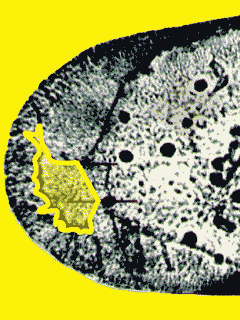 Abstract: The species Krithe gnoma was described from Holocene sediments
on the continental margin of Brazil, where it occurs on both shelf and slope. The shelf distribution of this species is restricted to
those areas influenced by the Malvinas current between 32°11' and
22°31'S. K. gnoma was selected due to the excellent resolution
of images of the anterior vestibule. So the range in size of the vestibula of
this species was used to determine whether or not the dimensions of the anterior
vestibule were to some degree related to amount of dissolved oxygen in the water at the
sampling site. Female valves of the 7th and 8th instars were measured and their sizes and those of the anterior vestibule
were compared. These valves and the reference carapace were collected at six
localities in the southern shelf area. The anterior vestibule of right and left valves of the 7th instar
and one of the 8th instar from discrete localities were measured. In the
reference carapace, the larger left valve also has the larger vestibule. A
gerontic 8th instar has valves larger than those of the previous instars, but
its vestibula are smaller than those of the 7th instar. The vestibula of the left valves of the 7th
instar collected at discrete localities showed consistent differences in size
related to the oxygen content of the sampling site. The relationship between vestibule size and oxygen
content is inversely proportional.However, the poor correlation factor (R2<<1) of these results are not
precise enough to support Peypouquet's hypothesis.
But the size of the vestibula of K. gnoma does show some degree of
relationship to oxygen content. So it is important to measure the vestibula of species of Krithe
using the procedure described here. Rigorous application of this procedure will
eliminate the possibility of discrimination based on variations in size due to ontogeny and dimorphism
leaving only those related to actual valve size. In any case, variations in the size of vestibula may have a phenotypic origin. Abstract: The species Krithe gnoma was described from Holocene sediments
on the continental margin of Brazil, where it occurs on both shelf and slope. The shelf distribution of this species is restricted to
those areas influenced by the Malvinas current between 32°11' and
22°31'S. K. gnoma was selected due to the excellent resolution
of images of the anterior vestibule. So the range in size of the vestibula of
this species was used to determine whether or not the dimensions of the anterior
vestibule were to some degree related to amount of dissolved oxygen in the water at the
sampling site. Female valves of the 7th and 8th instars were measured and their sizes and those of the anterior vestibule
were compared. These valves and the reference carapace were collected at six
localities in the southern shelf area. The anterior vestibule of right and left valves of the 7th instar
and one of the 8th instar from discrete localities were measured. In the
reference carapace, the larger left valve also has the larger vestibule. A
gerontic 8th instar has valves larger than those of the previous instars, but
its vestibula are smaller than those of the 7th instar. The vestibula of the left valves of the 7th
instar collected at discrete localities showed consistent differences in size
related to the oxygen content of the sampling site. The relationship between vestibule size and oxygen
content is inversely proportional.However, the poor correlation factor (R2<<1) of these results are not
precise enough to support Peypouquet's hypothesis.
But the size of the vestibula of K. gnoma does show some degree of
relationship to oxygen content. So it is important to measure the vestibula of species of Krithe
using the procedure described here. Rigorous application of this procedure will
eliminate the possibility of discrimination based on variations in size due to ontogeny and dimorphism
leaving only those related to actual valve size. In any case, variations in the size of vestibula may have a phenotypic origin.
|
|
Online since December 31, 2009
|
|
Article 8 [2009]: Nummulus brattenburgensis and Crania craniolaris (Brachiopoda, Craniidae), by Christian C. EMIG.-
Format [HTML] or [PDF
1.590 KB]
Reference: [CG2009_A08]
DOI: 10.4267/2042/29780
Lang.:
|
|
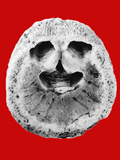 Abstract: The Brattingsborg pennies are mentioned in medieval texts dating from the middle of the first millennium and many popular medieval legends refer to their occurrence on Ivö Island in the Scania region (Sweden) as brattingsborgpenningar or in Latin as Nummulus brattenburgensis. Actually they are valves of the fossil brachiopod Crania craniolaris originally described by Linnaeus (1758) as Anomia craniolaris from the Upper Cretaceous. Later Retzius (1781) created the genus Crania based on these specimens from Ivö Island and on another species he described under Crania (now Isocrania) egnabergensis from Ignaberga in the Scania region. The scientific history of those two species is reviewed along with that of Danocrania tuberculata (Nilsson,
1826), formerly figured as Craniolites brattenburgicus, from the Danian of Scania. Two legends about these "pennies" are included. Abstract: The Brattingsborg pennies are mentioned in medieval texts dating from the middle of the first millennium and many popular medieval legends refer to their occurrence on Ivö Island in the Scania region (Sweden) as brattingsborgpenningar or in Latin as Nummulus brattenburgensis. Actually they are valves of the fossil brachiopod Crania craniolaris originally described by Linnaeus (1758) as Anomia craniolaris from the Upper Cretaceous. Later Retzius (1781) created the genus Crania based on these specimens from Ivö Island and on another species he described under Crania (now Isocrania) egnabergensis from Ignaberga in the Scania region. The scientific history of those two species is reviewed along with that of Danocrania tuberculata (Nilsson,
1826), formerly figured as Craniolites brattenburgicus, from the Danian of Scania. Two legends about these "pennies" are included.
|
|
Online since October 31, 2009
|
|
Memoir
3 [2009]: New data on the Middle-Upper Jurassic - Lower Cretaceous Charophytes and Ostracods from the Moroccan Atlas, by Pierre-Olivier MOJON, Hamid HADDOUMI & André CHARRIÈRE.-
Format [HTML]
or [PDF
7,487 KB, plates with a coloured background] or [PDF
8,353 KB with black & white plates]
Reference: [CG2009_M03]
Lang.:
|
|
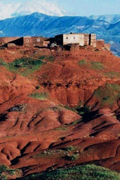 Abstract: The Middle Jurassic-Lower Cretaceous continental "Red Beds" of the Moroccan Atlas have provided very interesting new taxa of charophytes and lacustrine ostracods: Aclistochara africana n.sp. (Bathonian), Feistiella atlantis n.sp. (Hauterivian-Lower Barremian), Cypridea suprajurassica n.sp., Cypridea mohandi n.sp. and Cypridea demnatensis n.sp. (Oxfordian ? - Kimmeridgian), Harbinia atlasica n.sp. (Hauterivian ? - Lower Barremian). Micropaleontological data obtained after 2002 contributed the following: Abstract: The Middle Jurassic-Lower Cretaceous continental "Red Beds" of the Moroccan Atlas have provided very interesting new taxa of charophytes and lacustrine ostracods: Aclistochara africana n.sp. (Bathonian), Feistiella atlantis n.sp. (Hauterivian-Lower Barremian), Cypridea suprajurassica n.sp., Cypridea mohandi n.sp. and Cypridea demnatensis n.sp. (Oxfordian ? - Kimmeridgian), Harbinia atlasica n.sp. (Hauterivian ? - Lower Barremian). Micropaleontological data obtained after 2002 contributed the following:
• In the central High-Atlas, discovery of Upper Jurassic charophytes and freshwater ostracods (Dictyoclavator ramalhoi, Porochara kimmeridgensis, Aclistochara bransoni, Cypridea suprajurassica, Cypridea mohandi, Cypridea demnatensis) evince a Barremian ingression, its restricted marine character attested by lagoonal-brackish water ostracods (Harbinia atlasica) and presumed marine ostracods Trachyleberididae (cf. Strigosocythere strigosa, Cythereis ? sp., Protocythere ? sp.) associated with well-developed gypsiferous evaporites.
• In the eastern High-Atlas, charophytes have been found at levels related to the Jurassic/Cretaceous boundary (Upper Tithonian–Berriasian Porochara maxima).
• In the non-marine Lower Cretaceous (Hauterivian ? - Barremian) of the central High-Atlas, mixed Eurasian e and Gondwanian g assemblages of charophytes: Globator (e) and Feistiella (g), and brackish-lacustrine ostracods: (Fabanella-Cetacella (e), Darwinula-Cypridea-Harbinia (e & g) and Salvadoriella-Petrobrasia-Reconcavona-Paracypridea (g), were discovered.
• Complementary data for the Lower Cretaceous charophyte biozonation (Upper Valanginian-Lower Barremian interval) with Globator hemiglobatoroides Mojon n.sp. (Cenozone M7a, NE-Spain) and Globator mutabilis (Cenozone M7b) from NE-Spain and Morocco (central High-Atlas) were obtained.
• In the Moroccan Atlas area several stages in the breaking up of Pangea and the opening of the Atlantic Ocean have been recognized. These dislocations took place mainly during Bathonian times but also involved portions of the Kimmeridgian and Barremian.
|
|
Online since October 31, 2009
|
|
Article 7 [2009]: Quick look cathodoluminescence analyses and their impact on the interpretation of carbonate reservoirs. Case study of mid-Jurassic oolitic reservoirs in the Paris Basin, by Bruno GRANIER & Christian STAFFELBACH.-
Format [HTML] or [PDF
716 KB]
Reference: [CG2009_A07]
DOI: 10.4267/2042/28795
Lang.:
|
|
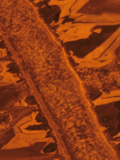 Abstract: Cathodoluminescence analyses on samples from
Middle Jurassic oolitic limestones allow us to reconstruct the diagenetic history of these oil and gas reservoirs: a succession of events starting with the early, synsedimentary
phases of marine cementation and ending with the addition of hydrocarbons to the reservoir. Constraints on the timing of events are derived from their calibration
with the chronology of the well-known regional tectonic calendar. Fracturing, due first to the post-Pyrenean extension and then to the Alpine compression, led respectively in Oligocene
times to a recharge of the aquifer and a correlative change in cementation, and in Miocene times to the addition of hydrocarbons into the same
flow units, this last event blocking diagenesis, at least in the zone above the oil-water contact. Distributions of cements and residual porosity
within sedimentary units without stratigraphic significance, called here "pseudo-parasequences", were for the most part inherited from
the original depositional facies. Abstract: Cathodoluminescence analyses on samples from
Middle Jurassic oolitic limestones allow us to reconstruct the diagenetic history of these oil and gas reservoirs: a succession of events starting with the early, synsedimentary
phases of marine cementation and ending with the addition of hydrocarbons to the reservoir. Constraints on the timing of events are derived from their calibration
with the chronology of the well-known regional tectonic calendar. Fracturing, due first to the post-Pyrenean extension and then to the Alpine compression, led respectively in Oligocene
times to a recharge of the aquifer and a correlative change in cementation, and in Miocene times to the addition of hydrocarbons into the same
flow units, this last event blocking diagenesis, at least in the zone above the oil-water contact. Distributions of cements and residual porosity
within sedimentary units without stratigraphic significance, called here "pseudo-parasequences", were for the most part inherited from
the original depositional facies.
|
|
Online since September 30, 2009
|
|
Article 6 [2009]: The Paleocene and earliest Eocene foraminiferal Family Miscellaneidae: neither nummulitids nor rotaliids, by Lukas HOTTINGER.-
Format [HTML] or [PDF
27,417 KB]
Reference: [CG2009_A06]
DOI: 10.4267/2042/28794
Lang.:
|
|
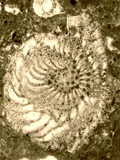 Abstract: The Miscellaneidae are divided into two groups of species: forms with a single intercameral foramen and forms with two or a row of multiple foramina. Ten taxa ascribed to this family are revised, amply illustrated and discussed considering both micro- and megalospheric
generations. The Family Miscellaneidae is assigned to the Superfamily Nonionacea by reason of their planispiral-involute coiling combined with an interiomarginal position of the foramina. Their combined range covers SBZ zones 2-5 and an area comprising the Central and Western Neotethys including the Pyrenean Gulf. They do not reach the western shores of the Atlantic. Miscellanites meandrinus and Bolkarina aksarayi exhibit extreme morphological features, respectively meandrine alar
extensions and expanse chambers. These features are of general interest for the comparative anatomy of the shells of the larger foraminifera in order to understand their biological significance. Abstract: The Miscellaneidae are divided into two groups of species: forms with a single intercameral foramen and forms with two or a row of multiple foramina. Ten taxa ascribed to this family are revised, amply illustrated and discussed considering both micro- and megalospheric
generations. The Family Miscellaneidae is assigned to the Superfamily Nonionacea by reason of their planispiral-involute coiling combined with an interiomarginal position of the foramina. Their combined range covers SBZ zones 2-5 and an area comprising the Central and Western Neotethys including the Pyrenean Gulf. They do not reach the western shores of the Atlantic. Miscellanites meandrinus and Bolkarina aksarayi exhibit extreme morphological features, respectively meandrine alar
extensions and expanse chambers. These features are of general interest for the comparative anatomy of the shells of the larger foraminifera in order to understand their biological significance.
|
|
Online since September 30, 2009
|
|
Article 5 [2009]: The ammonite fauna of the 'marls with ferruginous fossils' from the Niort region, France (Lower
Oxfordian, Cordatum Zone, Cordatum Subzone), by Philippe QUEREILHAC, Didier
MARCHAND, Rémi JARDAT, Alain BONNOT, Dominique FORTWENGLER & Philippe
COURVILLE.-
Format [HTML] or [PDF
4,284 KB]
Reference: [CG2009_A05]
DOI: 10.4267/2042/28697
Lang.:
|
|
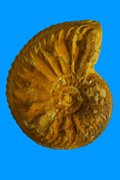 Abstract: A new collection of ammonites from the 'marls with ferruginous ammonites' in the Niort region (France), previously studied by Grossouvre
(1922), provides a large amount of biostratigraphic, paleoenvironmental and paleogeographic information. The fauna is dated Lower Oxfordian: Cordatum Zone, Cordatum Subzone, probably the lower part of it. In addition, it is unique in western Europe owing to: 1) the species found of which some appear to be known only in this deposit 2) by the extremely atypical domination of the couple Taramelliceras
- Creniceras which represent 2/3 of the specimens. Furthermore, the aspect of the fauna strongly suggests that the habitat was a distal platform unknown in other European strata of the same age. A detailed description of the several species is given, sometimes accompanied by a new taxonomic interpretation. Abstract: A new collection of ammonites from the 'marls with ferruginous ammonites' in the Niort region (France), previously studied by Grossouvre
(1922), provides a large amount of biostratigraphic, paleoenvironmental and paleogeographic information. The fauna is dated Lower Oxfordian: Cordatum Zone, Cordatum Subzone, probably the lower part of it. In addition, it is unique in western Europe owing to: 1) the species found of which some appear to be known only in this deposit 2) by the extremely atypical domination of the couple Taramelliceras
- Creniceras which represent 2/3 of the specimens. Furthermore, the aspect of the fauna strongly suggests that the habitat was a distal platform unknown in other European strata of the same age. A detailed description of the several species is given, sometimes accompanied by a new taxonomic interpretation.
|
|
Online since September 15, 2009
|
|
Memoir 2 [2009]: Subfamily Taramelliceratinae (Ammonitina, Haploceratoidea, Oppeliidae) from Middle and Upper Oxfordian strata (Plicatilis Zone, Vertebrale Subzone - Bimammatum Zone, Berrense Subzone) of N Vienne, France (submediterranean province), by Philippe QUEREILHAC.-
Format [HTML] or [PDF
17,578 KB]
Reference: [CG2009_M02]
DOI: 10.4267/2042/28698
Lang.:
|
|
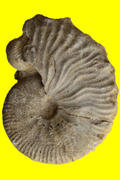 Abstract: In the area of northern Poitou studied Taramelliceratinae are present at every level except in the Schilli Subzone, itself possibly absent, and the Stenocycloides Subzone in which only Perisphinctidae and Trimarginites sp. occur. Although some species are known and cited in the literature often, they are figured infrequently or not at all: Taramelliceras (Taramelliceras) dentostriatum (Quenstedt), T. (T.) callicerum (Oppel), T. (Proscaphites) anar (Oppel). Here, the ranges of these species in the stratigraphic succession were determined through their association with other faunas in the same collections, using the presence or absence of known precise stratigraphic markers (for example: Neomorphoceras chapuisi (Oppel) = Transversarium Zone, Luciaeformis Subzone; Taramelliceras (? Taramelliceras) colleti (Lee) = Rotoides Subzone; "Epipeltoceras semimammatum" (Quenstedt) = Bimammatum Zone, "Berrense" Subzone, Semimammatum horizon) and/or the disappearance of species with longer ranges (for example: the disappearance of Neoprionoceras lautlingensis (Rollier) which is present in the Parandieri Subzone, but absent in the overlying Luciaeformis Subzone). The ranges of certain species that had been incorrectly located stratigraphically : T. (T.) dentostriatum (Quenstedt), T. (T.) callicerum (Oppel), T. (T.) externnodosum Dorn, have been restored to their true location as determined from their occurrences in the author's collections and in those of other collectors who had noted their stratigraphic relationships to other taxa. Abstract: In the area of northern Poitou studied Taramelliceratinae are present at every level except in the Schilli Subzone, itself possibly absent, and the Stenocycloides Subzone in which only Perisphinctidae and Trimarginites sp. occur. Although some species are known and cited in the literature often, they are figured infrequently or not at all: Taramelliceras (Taramelliceras) dentostriatum (Quenstedt), T. (T.) callicerum (Oppel), T. (Proscaphites) anar (Oppel). Here, the ranges of these species in the stratigraphic succession were determined through their association with other faunas in the same collections, using the presence or absence of known precise stratigraphic markers (for example: Neomorphoceras chapuisi (Oppel) = Transversarium Zone, Luciaeformis Subzone; Taramelliceras (? Taramelliceras) colleti (Lee) = Rotoides Subzone; "Epipeltoceras semimammatum" (Quenstedt) = Bimammatum Zone, "Berrense" Subzone, Semimammatum horizon) and/or the disappearance of species with longer ranges (for example: the disappearance of Neoprionoceras lautlingensis (Rollier) which is present in the Parandieri Subzone, but absent in the overlying Luciaeformis Subzone). The ranges of certain species that had been incorrectly located stratigraphically : T. (T.) dentostriatum (Quenstedt), T. (T.) callicerum (Oppel), T. (T.) externnodosum Dorn, have been restored to their true location as determined from their occurrences in the author's collections and in those of other collectors who had noted their stratigraphic relationships to other taxa.
It is recommended that the date of creation of the Luciaeformis Subzone and the Nectobrigensis, Luciaeformis and Subschilli horizons (Middle Oxfordian, Transversarium Zone) should be rectified. Currently, these are indicated as having been created in
1984. However, if the author's name, G. Melendez, is correct the date of their creation cannot have been
1984, the year in which the G. Melendez thesis was defended, for the manuscript was published only in
1989. It is also proposed that the Duongi horizon Melendez,
1989, be renamed as the Duongae horizon Melendez, 1989, because the index form, Perisphinctes (Dichotomoceras) duongi Melendez,
1989, is an ammonite species named to honor of A.N. Duong, a woman.
The study involved more than fifteen hundred individuals, all collected in the zone investigated. Only the most representative are figured here. The poor state of preservation of the ammonites (encrusted, often worn on one face, with the umbilicus not accessible) did not permit measurement (hence no table) except that of the diameter and sometimes the thickness. Previous studies of this subfamily or these species (Oppel,
1863; Quenstedt, 1887; Loriol,
1902; Lee, 1905; Dorn, 1931; Hölder,
1955) are old. References to this subfamily or its representatives in more recent works are only incidental and rarely include descriptions, drawing or photographs. The existence of many ammonites comprising homogeneous groups but without characteristics in common with known species justifies the creation of new species. Some microconchs have been definitely associated with a macroconch species. For others, a lack of material did not permit the establishment of such a direct link so they have been attached to the supposedly related species with the mention, "aff." (for "affinis"). Nevertheless, although described and figured, these forms remain in open nomenclature. There are some "groups" of ammonites with new characteristics that are here associated with a known species because the differences were not sufficient to create new ones; they are distinguished by "var." (for "variety"). There are also some that are referred to a previously known species because they were based only on a fragment (polymorphism?). In addition, in the zone studied the several taxa of this subfamily permit a relatively detailed stratigraphic breakdown because their existence is limited at a maximum to a subzone. However, an exception is the species Taramelliceras (Proscaphites) anar (Oppel,
1863) which ranges from the Antecedens Subzone through the Rotoides Subzone.
|
|
Online since September 15, 2009
|
|
Letter 3 [2009]: An additional hadrosaurid specimen (Dinosauria: Ornithischia) from the marine Maastrichtian deposits of the Maastricht area, by Eric BUFFETAUT.-
Format [HTML] or [PDF
730 KB]
Reference: [CG2009_L03]
DOI: 10.4267/2042/28153
Lang.:
|
|
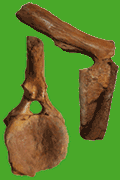 Abstract: An isolated dinosaur
vertebra from the marine deposits of the Maastrichtian type area, near the city
of Maastricht (The Netherlands), collected during the 19th century and kept in
the palaeontological collection of the Museum für Naturkunde in Berlin, is
described as a caudal vertebra of a hadrosaurid ornithopod. Although it cannot
be identified with greater accuracy, this specimen is an addition to the still
scanty, but growing, record of non-avian dinosaurs from the Maastrichtian type
area. This record is heavily dominated by hadrosaurs, which probably reflects a
real abundance of this group of dinosaurs in the late Maastrichtian of Europe. Abstract: An isolated dinosaur
vertebra from the marine deposits of the Maastrichtian type area, near the city
of Maastricht (The Netherlands), collected during the 19th century and kept in
the palaeontological collection of the Museum für Naturkunde in Berlin, is
described as a caudal vertebra of a hadrosaurid ornithopod. Although it cannot
be identified with greater accuracy, this specimen is an addition to the still
scanty, but growing, record of non-avian dinosaurs from the Maastrichtian type
area. This record is heavily dominated by hadrosaurs, which probably reflects a
real abundance of this group of dinosaurs in the late Maastrichtian of Europe.
|
|
Online since August 1, 2009
|
|
Letter 2 [2009]: Evidence of predation on the vertebra of a hadrosaurid dinosaur from the Upper Cretaceous (Campanian) of Coahuila, Mexico, by Héctor E. RIVERA-SYLVA, Eberhard FREY & José Rubén GUZMÁN-GUTIÉRREZ.-
Format [HTML] or [PDF
1,788 KB]
Reference: [CG2009_L02]
DOI: 10.4267/2042/28152
Lang.:
|
|
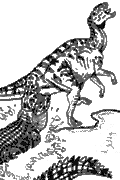 Abstract: In sediments of the
Aguja Formation (Late Cretaceous: Campanian) at La Salada in northern part of
the state of Coahuila, Mexico, numerous fossils of vertebrates have been
discovered including Hadrosauridae. One hadrosaur vertebra provides evidence of
predation probably by a giant alligator Deinosuchus riograndensis. Abstract: In sediments of the
Aguja Formation (Late Cretaceous: Campanian) at La Salada in northern part of
the state of Coahuila, Mexico, numerous fossils of vertebrates have been
discovered including Hadrosauridae. One hadrosaur vertebra provides evidence of
predation probably by a giant alligator Deinosuchus riograndensis.
|
|
Online since August 1, 2009
|
|
Article 4 [2009]: The IMAM case. Additional investigation of a micropaleontological fraud, by Bruno GRANIER, Monique FEIST, Edward HENNESSEY, Ioan BUCUR & Baba SENOWBARI-DARYAN.-
Format [HTML] or [PDF
1,916 KB]
Reference: [CG2009_A04]
DOI: 10.4267/2042/25073
Lang.:
|
|
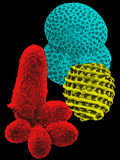 Abstract: Starting in 1996 and for almost a decade,
M.M. Imam contributed to twelve papers published in international geological journals. These papers dealt with the micropaleontology and biostratigraphy of Cretaceous to Miocene
series from Egypt and Libya. They were abundantly illustrated in order to
support the author's findings and interpretations. However most photographic
illustrations (189 at least) were fabricated with material lifted from the publications of
other authors, commonly from localities or stratigraphic intervals other than
those indicated by M.M. Imam. Abstract: Starting in 1996 and for almost a decade,
M.M. Imam contributed to twelve papers published in international geological journals. These papers dealt with the micropaleontology and biostratigraphy of Cretaceous to Miocene
series from Egypt and Libya. They were abundantly illustrated in order to
support the author's findings and interpretations. However most photographic
illustrations (189 at least) were fabricated with material lifted from the publications of
other authors, commonly from localities or stratigraphic intervals other than
those indicated by M.M. Imam.
|
|
Online since May 18, 2009
|
|
Article 3 [2009]: Uppermost Albian biostratigraphy and chronostratigraphy, by Robert W. SCOTT.-
Format [HTML] or [PDF
428 KB]
Reference: [CG2009_A03]
DOI: 10.4267/2042/24969
Lang.:
|
|
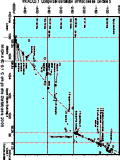 Abstract: The Albian Stage is the
highest chronostratigraphic unit of the Lower Cretaceous Series and underlies
the Cenomanian Stage of the Upper Cretaceous Series. The Albian is divided into
three substages, each of which is composed of two or three zones based on
distinctive and phylogenetically related ammonite assemblages. The uppermost
zone of the Upper Albian Substage, the Stoliczkaia dispar Zone, is found
in many Western European condensed sections. The ammonite assemblage in the thin
glauconitic sandstone near La Vraconne, Switzerland, was defined as the
'Vraconnian Stage' in 1868. However this concept has been little used and was
abandoned in 1963 as part of the Cretaceous chronostratigraphic scale. A recent
proposal to resurrect and redefine this stage is based on a number of criteria
and very detailed and reliable stratigraphic data. A quantitative
biostratigraphic analysis of the ammonite ranges in the key sections shows that
the proposed subzones of the S. dispar Zone have discordant ranges.
Furthermore, the utility of a 'Vraconnian Stage' between the Albian and
Cenomanian stages is geographically limited and the concept embraces one of many
depositional sequence cycles of the Albian. The reinstatement of a 'Vraconnian
Stage' is not recommended. Abstract: The Albian Stage is the
highest chronostratigraphic unit of the Lower Cretaceous Series and underlies
the Cenomanian Stage of the Upper Cretaceous Series. The Albian is divided into
three substages, each of which is composed of two or three zones based on
distinctive and phylogenetically related ammonite assemblages. The uppermost
zone of the Upper Albian Substage, the Stoliczkaia dispar Zone, is found
in many Western European condensed sections. The ammonite assemblage in the thin
glauconitic sandstone near La Vraconne, Switzerland, was defined as the
'Vraconnian Stage' in 1868. However this concept has been little used and was
abandoned in 1963 as part of the Cretaceous chronostratigraphic scale. A recent
proposal to resurrect and redefine this stage is based on a number of criteria
and very detailed and reliable stratigraphic data. A quantitative
biostratigraphic analysis of the ammonite ranges in the key sections shows that
the proposed subzones of the S. dispar Zone have discordant ranges.
Furthermore, the utility of a 'Vraconnian Stage' between the Albian and
Cenomanian stages is geographically limited and the concept embraces one of many
depositional sequence cycles of the Albian. The reinstatement of a 'Vraconnian
Stage' is not recommended.
|
|
Online since April 22, 2009
|
|
Article 2 [2009]: Pseudoshasticrioceras bersaci nov. sp. (Ammonoidea, Gassendiceratinae), and new ammonite biohorizon for the Upper Barremian of southeastern France, by Didier BERT & Gérard DELANOY.-
Format [HTML] or [PDF
1,7600 KB]
Reference: [CG2009_A02]
DOI: 10.4267/2042/23733
Lang.:
|
|
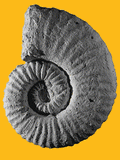 Abstract: Research in the Feraudianus Subzone of the Sartousiana Zone of the Barremian stage led to the discovery of a new species of Pseudoshasticrioceras: P. bersaci
nov. sp. Its study provides evidence concerning the developments of the latest Gassendiceratinae Bert et alii, 2006, and the relationship between the genus Pseudoshasticrioceras Delanoy, 1998, and Gassendiceras Bert et alii, 2006. In particular, this new species is derived from Pseudoshasticrioceras magnini (Delanoy, 1992) by a minor revision in the processes of ontogenesis (retardation of ornamentation -
neoteny). However, the evolution towards Pseudoshasticrioceras autrani Delanoy, 1998, implies a "failure" in this process that may possibly be related to parallel changes in environmental conditions. On the other hand, the very closely defined stratigraphic position of Pseudoshasticrioceras bersaci
nov. sp., and its position in the anagenetic lineage of Pseudoshasticrioceras, demonstrates its interest as a biostratigraphic marker: a new Bersaci Biohorizon is proposed; it is located between the Magnini and the Autrani
biohorizons. Abstract: Research in the Feraudianus Subzone of the Sartousiana Zone of the Barremian stage led to the discovery of a new species of Pseudoshasticrioceras: P. bersaci
nov. sp. Its study provides evidence concerning the developments of the latest Gassendiceratinae Bert et alii, 2006, and the relationship between the genus Pseudoshasticrioceras Delanoy, 1998, and Gassendiceras Bert et alii, 2006. In particular, this new species is derived from Pseudoshasticrioceras magnini (Delanoy, 1992) by a minor revision in the processes of ontogenesis (retardation of ornamentation -
neoteny). However, the evolution towards Pseudoshasticrioceras autrani Delanoy, 1998, implies a "failure" in this process that may possibly be related to parallel changes in environmental conditions. On the other hand, the very closely defined stratigraphic position of Pseudoshasticrioceras bersaci
nov. sp., and its position in the anagenetic lineage of Pseudoshasticrioceras, demonstrates its interest as a biostratigraphic marker: a new Bersaci Biohorizon is proposed; it is located between the Magnini and the Autrani
biohorizons.
|
|
Online since April 4, 2009
|
|
Article 1 [2009]: Albian-Middle Turonian ostracodes from the Antsiranana region (northern Madagascar): systematics, palaeoecology and palaeobiogeography, by Jean-François BABINOT, Jean-Paul COLIN & Auran RANDRIANASOLO.-
Format [HTML] or [PDF
3,284 KB]
Reference: [CG2009_A01]
DOI: 10.4267/2042/23730
Lang.:
|
|
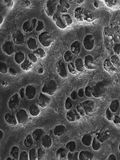 Abstract: Ostracode associations from the Antsiranana region, formerly Diego-Suarez, in northern Madagascar have been studied at a taxonomic level. In the Albian-middle Turonian interval, 29 species belonging to 21 genera have been recognized, 10 new species, one new genus (Malagasyella) and a new sub-genus (Hemiglenocythere) have been erected. From a palaeoecological stand point, the succession of ostracode faunas shows a progressive shallowing trend, from basin-slope during Albian times to outer shelf during the Turonian. During these periods, the ostracode faunas of Madagascar show strong affinities with those of India (Rajasthan). This leads to a proposal for the existence of an
indo-malagasy ostracode faunal province. Abstract: Ostracode associations from the Antsiranana region, formerly Diego-Suarez, in northern Madagascar have been studied at a taxonomic level. In the Albian-middle Turonian interval, 29 species belonging to 21 genera have been recognized, 10 new species, one new genus (Malagasyella) and a new sub-genus (Hemiglenocythere) have been erected. From a palaeoecological stand point, the succession of ostracode faunas shows a progressive shallowing trend, from basin-slope during Albian times to outer shelf during the Turonian. During these periods, the ostracode faunas of Madagascar show strong affinities with those of India (Rajasthan). This leads to a proposal for the existence of an
indo-malagasy ostracode faunal province.
|
|
Online since April 4, 2009
|
|
Letter 1 [2009]: Serravallian (Miocene) nannofossils in Patagonia, Argentina, by Margarita SIMEONI.-
Format [HTML] or [PDF
689 KB]
Reference: [CG2009_L01]
DOI: 10.4267/2042/23731
Lang.:
|
|
 Abstract: For the first time, nannofossils found in the marine stratigraphic unit named
"Patagoniano" which crops out at Cerro Chenque and Cerro Hermitte in southeastern Chubut, Argentina, are documented. They were recovered from pelitic levels
in the lower part of coarsening-upward siliciclastic sedimentary
sequences. The nannofossils are assigned in part to the Discoaster kugleri Zone NN7 (Martini,
1971) and CN5b (Bukry, 1971, 1973) thus allowing correlation of the productive levels with the Serravallian Stage (upper Middle Miocene). Abstract: For the first time, nannofossils found in the marine stratigraphic unit named
"Patagoniano" which crops out at Cerro Chenque and Cerro Hermitte in southeastern Chubut, Argentina, are documented. They were recovered from pelitic levels
in the lower part of coarsening-upward siliciclastic sedimentary
sequences. The nannofossils are assigned in part to the Discoaster kugleri Zone NN7 (Martini,
1971) and CN5b (Bukry, 1971, 1973) thus allowing correlation of the productive levels with the Serravallian Stage (upper Middle Miocene).
|
|
Nota breve 1 [2009]: Nannofósiles del Serravalliano (Mioceno) en Patagonia, Argentina, de Margarita SIMEONI.-
Formato [HTML] o [PDF
689 KB]
Referencia: [CG2009_L01]
Idioma:
|
|
Resumen: Se documenta el primer hallazgo de
nannofósiles en el "Patagoniano", unidad estratigráfica marina
aflorante en Cerro Chenque y Cerro Hermitte, al sudeste de Chubut, Argentina.
Los nannofósiles fueron recuperados en niveles pelíticos inferiores de
diferentes ciclos sedimentarios, grano-crecientes hacia la parte superior,
formados por rocas siliciclásticas. Los nannofósiles pertenecen, en parte, a
la Zona de Discoaster kugleri NN7 (Martini,
1971) and CN5b (Bukry, 1971,
1973) permitiendo la correlación de los niveles
fértiles con el Piso Serravalliano (Mioceno Medio superior).
|
|
Online since March 31, 2009
En línea desde el 31 de Marzo de 2009
|
|
Memoir
1 [2009]: Mediterranean Neocomian belemnites, part 3: Valanginian-Hauterivian belemnites, by Nico M.M. JANSSEN.-
Format [HTML]
or [PDF
2,898 KB]
Reference: [CG2009_M01]
DOI: 10.4267/2042/23732
Lang.:
|
|
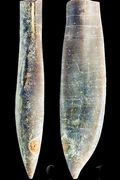 Abstract: The classical papers of Raspail
(1829, 1830) and Duval-Jouve (1841) described a wide range of belemnite
species, mainly from the Lower Cretaceous of the Castellane-Peyroules area (Alpes de
Haute-Provence, France). The present work focuses mainly on the biostratigraphy of these previously described
belemnite taxa for their stratigraphic relationships had not been determined precisely.
Here, biostratigraphy is related to the lithologic successions and faunal associations
(ammonites) of various outcrops in the area studied. Complementary data were obtained from the La
Lagne, Les Allaves and Pas d'Escale sections (Alpes de
Haute-Provence, France). And, in order to attain a better understanding of the stratigraphic distribution of
Late Valanginian belemnites in condensed glauconitic
deposits, these assemblages are compared with belemnites from deeper water successions in the Angles, Source de l'Asse de
Moriez, Cheiron areas and those in the vicinity of La Charce and Vergol that are even deeper. Abstract: The classical papers of Raspail
(1829, 1830) and Duval-Jouve (1841) described a wide range of belemnite
species, mainly from the Lower Cretaceous of the Castellane-Peyroules area (Alpes de
Haute-Provence, France). The present work focuses mainly on the biostratigraphy of these previously described
belemnite taxa for their stratigraphic relationships had not been determined precisely.
Here, biostratigraphy is related to the lithologic successions and faunal associations
(ammonites) of various outcrops in the area studied. Complementary data were obtained from the La
Lagne, Les Allaves and Pas d'Escale sections (Alpes de
Haute-Provence, France). And, in order to attain a better understanding of the stratigraphic distribution of
Late Valanginian belemnites in condensed glauconitic
deposits, these assemblages are compared with belemnites from deeper water successions in the Angles, Source de l'Asse de
Moriez, Cheiron areas and those in the vicinity of La Charce and Vergol that are even deeper.
|
|
Online since March 31, 2009
|

|
|
2008 (vol. 8)
|
|
Article 9 [2008]: Spirochetes and salt marsh microbial mat geochemistry: Implications for the fossil record, by Elizabeth A. STEPHENS, Olivier BRAISSANT & Pieter T. VISSCHER.-
Format [HTML]
or [PDF
315 KB]
Reference: [CG2008_A09]
DOI:
10.4267/2042/20045
Lang.:
|
|
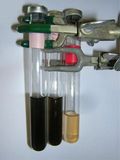 Abstract: Microbial mats are
synergistic microbial consortia through which major elements, including sulfur,
are cycled due to microbial and geological processes. Depth profiles of pH, O2,
sulfide, exopolymeric substances (EPS), and the rate of sulfate reduction were
determined in an Oscillatoria sp. and Microcoleus-dominated marine
microbial mat at the Great Sippewissett salt marsh, Massachusetts. In addition,
measurements in spirochete enrichments and Spirochaetae litoralis
cultures showed sulfide consumption during which polysulfides, thiosulfate, and
presumably sulfate formed. These data suggest that spirochetes can play a role
in the cycling of sulfur in these mats. The obligate to facultative anaerobic
spirochetes may consume sulfide to remove oxygen. Furthermore, spirochetes may
enhance preservation of microbial mats within the rock record by degrading EPS
and producing low molecular weight organic compounds (LMWOC). Both sulfide
oxidation (i.e., oxygen removal) and EPS degradation (i.e.,
production of LMW organic compounds) stimulate the activity of sulfate-reducing
bacteria (SRB), which are responsible for the precipitation of calcium carbonate
in most lithifying mats. Abstract: Microbial mats are
synergistic microbial consortia through which major elements, including sulfur,
are cycled due to microbial and geological processes. Depth profiles of pH, O2,
sulfide, exopolymeric substances (EPS), and the rate of sulfate reduction were
determined in an Oscillatoria sp. and Microcoleus-dominated marine
microbial mat at the Great Sippewissett salt marsh, Massachusetts. In addition,
measurements in spirochete enrichments and Spirochaetae litoralis
cultures showed sulfide consumption during which polysulfides, thiosulfate, and
presumably sulfate formed. These data suggest that spirochetes can play a role
in the cycling of sulfur in these mats. The obligate to facultative anaerobic
spirochetes may consume sulfide to remove oxygen. Furthermore, spirochetes may
enhance preservation of microbial mats within the rock record by degrading EPS
and producing low molecular weight organic compounds (LMWOC). Both sulfide
oxidation (i.e., oxygen removal) and EPS degradation (i.e.,
production of LMW organic compounds) stimulate the activity of sulfate-reducing
bacteria (SRB), which are responsible for the precipitation of calcium carbonate
in most lithifying mats.
|
|
Online since December 10, 2008
|
|
Article 8 [2008]: On the history of the names Lingula, anatina, and on the confusion of the forms assigned them among the Brachiopoda, by Christian C. EMIG.-
Format [HTML]
or [PDF
1,225 KB]
Reference: [CG2008_A08]
DOI:
10.4267/2042/20044
Lang.:
|
|
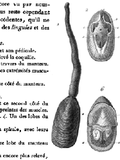 Abstract: The The first
descriptions of Lingula were made from then extant specimens by three
famous French scientists: Bruguière, Cuvier,
and Lamarck. The genus Lingula was created in
1791 (not 1797) by Bruguière and in 1801 Lamarck
named the first species L. anatina, which was then studied by Cuvier
(1802). In 1812 the first fossil lingulids were discovered in the Mesozoic and
Palaeozoic strata of the U.K. and were referred to Lingula on the basis
of similarity in the form of the shell. In the 1840's other linguliform
brachiopods from the Palaeozoic were described. The similarity of the shell form
of the extant Lingula and these fossils led Darwin
in 1859 to create the description "living fossil" in his book "On
the Origin of Species". Thereafter, this Darwinian concept became
traditional in that Lingula was considered to lack morphological
evolutionary changes. Although denounced as scientifically incorrect for more
than two decades, the concept still remains in many books, publications and Web
sites, perhaps a witness to palaeontological conservatism. Abstract: The The first
descriptions of Lingula were made from then extant specimens by three
famous French scientists: Bruguière, Cuvier,
and Lamarck. The genus Lingula was created in
1791 (not 1797) by Bruguière and in 1801 Lamarck
named the first species L. anatina, which was then studied by Cuvier
(1802). In 1812 the first fossil lingulids were discovered in the Mesozoic and
Palaeozoic strata of the U.K. and were referred to Lingula on the basis
of similarity in the form of the shell. In the 1840's other linguliform
brachiopods from the Palaeozoic were described. The similarity of the shell form
of the extant Lingula and these fossils led Darwin
in 1859 to create the description "living fossil" in his book "On
the Origin of Species". Thereafter, this Darwinian concept became
traditional in that Lingula was considered to lack morphological
evolutionary changes. Although denounced as scientifically incorrect for more
than two decades, the concept still remains in many books, publications and Web
sites, perhaps a witness to palaeontological conservatism.
|
|
Online since December 10, 2008
|
|
Memoir 4 [2008]: Aptian and Albian Phylloceratids (Ammonoidea) from the Vocontian Basin (SE France), by Bernard JOLY & Michel DELAMETTE.-
Format [HTML]
or [PDF
6,688 KB]
Reference: [CG2008_M04]
DOI:
10.4267/2042/19113
Lang.:
|
|
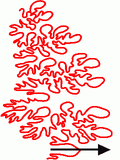 Extended English abstract: More than 2,200 pyritized ammonites of the Superfamily Phylloceratatoidea
have been collected in consonance with the scale of the ammonite zonation of the
expanded Marnes Bleues Fm in the Vocontian Basin (SE France). This abundant material allows the description and the figuration
(specimens and sutures) of 28 taxa of which 4 are new: Extended English abstract: More than 2,200 pyritized ammonites of the Superfamily Phylloceratatoidea
have been collected in consonance with the scale of the ammonite zonation of the
expanded Marnes Bleues Fm in the Vocontian Basin (SE France). This abundant material allows the description and the figuration
(specimens and sutures) of 28 taxa of which 4 are new:
- Phylloceras (Hypophylloceras) moriezense Sayn, 1920
subsp. tenuicostulata nov. Diagnosis: variant of P. (H.) moriezense distinguished by a subrectangular section of the whorl and
a flattening of the sides less accentuated than on the typical form, with a
very fine costulation that descends almost to the middle of the side (early late Aptian);
- Phylloceras (Goretophylloceras) vocontium nov. sp. Diagnosis: thick
shell, convex sides, rounded and compressed
venter, maximum thickness of the whorl near the umbilicus, open umbilicus, constrictions at least at the beginning of the last
whorl, oval whorl section, suture line of subgenus Goretophylloceras
(mid middle Aptian to earliest Albian);
- Salfeldiella (Gyrophyllites) falloti nov. sp. Diagnosis: shell with a finely
costulate test, smooth internal mold, open umbilicus, nearly flat sides, rounded
venter, subquadratic whorl section, proverse constrictions of the internal
mold, radial constrictions
in small specimens, a ventral sinus in the largest specimens, suture line
like that of the genus Gyrophyllites (late Early Aptian to late Aptian);
- Phyllopachyceras brehereti nov. sp. Diagnosis: thick shell, flat
sides, venter flat or slightly convex, whorl quadratic in section, suture lines like those of the genus Phyllopachyceras with tetraphyllic spatulate elongated saddles
(early mid-Aptian to early late Aptian).
Owing to the abundance of the Phylloceratoidea and the variations of specific
diversity in 9 fossiliferous levels ranging in age from the late Early Aptian to
the end of the Albian it is possible to identify 3 peaks of abundance:
- peak 1 during the early mid-Aptian (base of the Martini zone),
- peak 2 near the Aptian and Albian boundary, a few meters below the anoxic Paquier level,
- peak 3 during the latest Albian (Blancheti zone).
Of these 3 peaks the first is the most important probably because the Vocontian Basin
attained its maximum depth during this time. The peaks appear to be correlated with the maximum flooding intervals of depositional
sequences. But high sea-levels
were not always favourable for the Phylloceratoidea. The very fossiliferous Paquier
level, although it took place during a high in sea-level, is characterised by the virtual absence of the deep-water ammonites, e.g.
Phylloceratids, Tetragonids and Lytoceratids. This fact is explained by the presence of
a deep-water anoxia. Another depletion of Phylloceratoidea in conjonction with a great abundance of
Desmoceratid and Mortoniceratid ammonites and benthic fauna (Inoceramids Bivalves) occurred during the early Late Albian. At that time, the
Vocontian area appears to have reached a minimal depth resulting from a pause in the rate of subsidence associated
with an influx of siliciclastic material that attained the center of the basin.
After a last episode during the Early Cenomanian of the Vocontian Basin when the Phylloceratoidea occurred
significant number, this group of ammonites shows a drastic decrease in
abundance. This evolution is correlated with the filling of the basin from west to
east, thus restricting the Phylloceratoidea and the other deep-water ammonites to a small eastern area (Leiostraca area of Thomel,
1965, 1980).
|
|
Online since September 28, 2008
|
|
Article 7 [2008]: Holostratigraphy of the Kahmah regional Series in Oman, Qatar, and the United Arab Emirates, by Bruno GRANIER.-
Format [HTML]
or [PDF
2,154 KB]
Reference: [CG2008_A07]
DOI:
10.4267/2042/19112
Lang.:
|
|
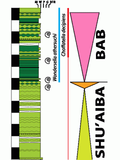 Abstract: The stratigraphic framework of the uppermost Jurassic - Lower Cretaceous interval of the Gulf area is revised
using both historical and recently acquired paleontological (ammonites,
calpionellids, foraminifers, 'calcareous' algae), sedimentological and sequential
information. The Kahmah regional Series ranging in age from Late Tithonian to Gargasian (= middle Aptian) times is subdivided into regional stages, named from bottom to top: Rayda (with two
substages, Bu Haseer and Belbazem), Salil, Zakum, Lekhwair, Kharaib, Hawar, and
Shu'aiba. The Kahmah rests
either on strata representing the Habshan regional Stage, which is the last term of the Sahtan regional Series
(locally absent due to a stratigraphic hiatus in basinal areas), or on much older
strata; it is followed either by the Bab regional Stage (locally absent due to a stratigraphic hiatus on platform areas), or by the Sabsab regional Substage (the lowermost part of the Nahr Umr regional Stage), both of which are assigned the Wasi'a regional Series. The Kahmah succession
(as well as those of the Sahtan below and the Wasi'a above) is
discontinuous, i.e. punctuated by sedimentary hiatuses due to forced regressions, some of significant importance (in the Zakum or in the
Bab, and those bounding the Hawar and the Shu'aiba). Abstract: The stratigraphic framework of the uppermost Jurassic - Lower Cretaceous interval of the Gulf area is revised
using both historical and recently acquired paleontological (ammonites,
calpionellids, foraminifers, 'calcareous' algae), sedimentological and sequential
information. The Kahmah regional Series ranging in age from Late Tithonian to Gargasian (= middle Aptian) times is subdivided into regional stages, named from bottom to top: Rayda (with two
substages, Bu Haseer and Belbazem), Salil, Zakum, Lekhwair, Kharaib, Hawar, and
Shu'aiba. The Kahmah rests
either on strata representing the Habshan regional Stage, which is the last term of the Sahtan regional Series
(locally absent due to a stratigraphic hiatus in basinal areas), or on much older
strata; it is followed either by the Bab regional Stage (locally absent due to a stratigraphic hiatus on platform areas), or by the Sabsab regional Substage (the lowermost part of the Nahr Umr regional Stage), both of which are assigned the Wasi'a regional Series. The Kahmah succession
(as well as those of the Sahtan below and the Wasi'a above) is
discontinuous, i.e. punctuated by sedimentary hiatuses due to forced regressions, some of significant importance (in the Zakum or in the
Bab, and those bounding the Hawar and the Shu'aiba).
|
|
Online since September 28, 2008
|
|
Article
7 [2008] - an extra video: Holostratigraphy of the Kahmah regional Series in Oman, Qatar, and the United Arab Emirates, by Bruno GRANIER.-
The video of Fig.
18  revisited revisited
|
|
|
|
Online since May 22, 2010
|
|
Letter 3 [2008]: About the stratigraphic position of the Lower Aptian Roloboceras hambrovi (Ammonoidea) level, by Pierre ROPOLO, Michel MOULLADE, Gabriel CONTE & Guy TRONCHETTI.-
Format [HTML] or [PDF
180 KB]
Reference: [CG2008_L03]
DOI:
10.4267/2042/18124
Lang.:
|
|
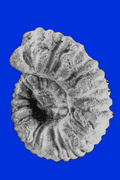 Abstract: In the stratotype of the Lower Aptian substage the position of the assemblage that includes Roloboceras spp. and Megatyloceras spp. has been clearly established as being in the middle part of the upper
Bedoulian. Some authors have erected this horizon as a subzone, or even a zone, with R. hambrovi as species-index. In other areas (southern England, eastern Spain, the Ardèche in southeastern France), where taphonomic conditions are not always as favourable as they are in the stratotype, the level at which this assemblage occurs seems to be confined to the upper part of the lower
Bedoulian. Various hypotheses are considered in an attempt to explain this divergence. Abstract: In the stratotype of the Lower Aptian substage the position of the assemblage that includes Roloboceras spp. and Megatyloceras spp. has been clearly established as being in the middle part of the upper
Bedoulian. Some authors have erected this horizon as a subzone, or even a zone, with R. hambrovi as species-index. In other areas (southern England, eastern Spain, the Ardèche in southeastern France), where taphonomic conditions are not always as favourable as they are in the stratotype, the level at which this assemblage occurs seems to be confined to the upper part of the lower
Bedoulian. Various hypotheses are considered in an attempt to explain this divergence.
|
|
Online since August 27, 2008
|
|
Memoir 3 [2008]: The Douvilleiceratidae (Ammonoidea) of the Lower Aptian historical stratotype area at Cassis-La Bédoule (SE France), by Pierre ROPOLO, Gabriel CONTE, Michel MOULLADE, Guy TRONCHETTI & Roland GONNET.-
Format [HTML]
or [PDF
6,688 KB]
Reference: [CG2008_M03]
DOI:
10.4267/2042/18125
Lang.:
|
|
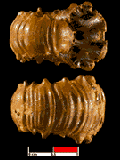 Abstract: Recent biostratigraphic research in the marly limestones of the Cassis-La Bédoule area (SE France) provided a rich macrofauna of Douvilleiceratidae Parona & Bonarelli,
1897. From the uppermost Barremian (Pseudocrioceras waagenoides Subzone) to the middle Aptian (Parahoplites melchioris Zone), specimens of Procheloniceras, Cheloniceras, Roloboceras, Megatyloceras and Epicheloniceras were collected in succession. In this paper we describe the various genera and species from this material and delimit precisely their stratigraphic positions. Our study shows that each genus or subgenus characterizes a discrete stratigraphic interval. In addition, the Cheloniceras meyendorffi
(upper Bedoulian), Epicheloniceras debile, Epicheloniceras gracile, and Epicheloniceras buxtorfi
(Gargasian = middle Aptian) subzones, originally defined in England by Casey (1961a), are identified for the first time in the
Lower Aptian stratotypic area of Cassis-La Bédoule. Abstract: Recent biostratigraphic research in the marly limestones of the Cassis-La Bédoule area (SE France) provided a rich macrofauna of Douvilleiceratidae Parona & Bonarelli,
1897. From the uppermost Barremian (Pseudocrioceras waagenoides Subzone) to the middle Aptian (Parahoplites melchioris Zone), specimens of Procheloniceras, Cheloniceras, Roloboceras, Megatyloceras and Epicheloniceras were collected in succession. In this paper we describe the various genera and species from this material and delimit precisely their stratigraphic positions. Our study shows that each genus or subgenus characterizes a discrete stratigraphic interval. In addition, the Cheloniceras meyendorffi
(upper Bedoulian), Epicheloniceras debile, Epicheloniceras gracile, and Epicheloniceras buxtorfi
(Gargasian = middle Aptian) subzones, originally defined in England by Casey (1961a), are identified for the first time in the
Lower Aptian stratotypic area of Cassis-La Bédoule.
|
|
Erratum: The photo of a specimen of Megatyloceras ricordeanum (d'Orbigny) from
the private collection of Cyril Baudouin and coming from the locality of Le Teil (Ardèche) is figured in the memoir of P. Ropolo et alii (2008, Pl. 08, fig. 3  )
instead of and in place of a specimen collected at La Bédoule. The first author
(P.R.) tells us that it was because of an error in the labeling
of his photographic archives that this unfortunate substitution could occur. He asks not just the owner of
the photograph and the ammonite, Cyril Baudouin,
but also his co-authors and the editors and readers of Carnets to be good enough to pardon him for this
unintentional error. )
instead of and in place of a specimen collected at La Bédoule. The first author
(P.R.) tells us that it was because of an error in the labeling
of his photographic archives that this unfortunate substitution could occur. He asks not just the owner of
the photograph and the ammonite, Cyril Baudouin,
but also his co-authors and the editors and readers of Carnets to be good enough to pardon him for this
unintentional error.
We remind you that the whole of the material illustrated in
this memoir is already deposited or is being deposited, is catalogued or is
being catalogued in the Museum of Paleontology of the University of Provence
(Aix-Marseilles 1), St. Charles Campus.
|
|
Format [HTML]
ou [PDF
76 KB]
|
|
Online since August 27, 2008
|
|
Article 6 [2008]: Middle Jurassic to Lower
Cretaceous continental deposits from eastern High Atlas (Morocco): successive
paleoenvironments and paleogeographic significance, by Hamid HADDOUMI, André
CHARRIÈRE, Bernard ANDREU & Pierre-Olivier MOJON.-
Format [HTML]
or [PDF
2,069 KB]
Reference: [CG2008_A06]
DOI:
10.4267/2042/18122
Lang.:
|
|
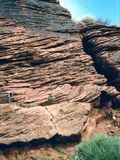 Abstract: In the eastern High Atlas (Morocco), continental "Red Beds" overlying the last marine deposits of Jurassic age consist of three main lithostratigraphic units: the Anoual Formation, the Ksar Metlili Formation and the Dekkar Group, bounded by two sharp sedimentary discontinuities. The Anoual Formation is a fluvial dominated deltaic plain deposit. It is followed by a final marine transgression of Early Bathonian age. The Ksar Metlili Formation found only in some subsident areas represents a renewal of
fluvio-deltaic environments with a flora of Late Tithonian-Early Berriasian
charophytes. The Dekkar Group occupies a larger area of sedimentation, its limits overlap the whole domain. From bottom to top, the succession indicates the existence of three
paleoenvironments: alluvial fans deposits locally associated with Barremian?-Aptian lacustrine sediments containing charophytes and
ostracods, alluvial plains deposits and finally, marine coastal to brackish plains deposits of the Cenomanian. Abstract: In the eastern High Atlas (Morocco), continental "Red Beds" overlying the last marine deposits of Jurassic age consist of three main lithostratigraphic units: the Anoual Formation, the Ksar Metlili Formation and the Dekkar Group, bounded by two sharp sedimentary discontinuities. The Anoual Formation is a fluvial dominated deltaic plain deposit. It is followed by a final marine transgression of Early Bathonian age. The Ksar Metlili Formation found only in some subsident areas represents a renewal of
fluvio-deltaic environments with a flora of Late Tithonian-Early Berriasian
charophytes. The Dekkar Group occupies a larger area of sedimentation, its limits overlap the whole domain. From bottom to top, the succession indicates the existence of three
paleoenvironments: alluvial fans deposits locally associated with Barremian?-Aptian lacustrine sediments containing charophytes and
ostracods, alluvial plains deposits and finally, marine coastal to brackish plains deposits of the Cenomanian.
After the closure of the Jurassic Atlasic marine trough, the eastern Atlasic "Red Beds" were deposited in response to three main geodynamic events:
• the filling of the Atlasic trough with very thick deposits in subsiding areas linked to tectonic rifting during the Early
Bathonian;
• the emergence of this area caused a hiatus in sedimentation involving strata ranging in age from Bathonian to Barremian?-Aptian. However, continental sediments are preserved in some onshore geomorphological depressions at the Jurassic/Cretaceous boundary;
• the opening of new basins, continental during the Barremian?-Aptian, that became marine during the Late Cenomanian as the result of Cenomanian-Turonian transgression.
A comparison of the succession of events recorded in different parts of the Atlasic belts allows reconstruction of the three phases of paleogeographic evolution in these southern Tethyan areas during Middle Jurassic to Late Cretaceous times.
|
|
Online since August 1, 2008
|
|
Letter 2 [2008]: Zonation by ammonites and foraminifers of the Vraconnian-Turonian interval: A comparison of the Boreal and Tethyan domains (NW Europe / Central Tunisia), by Francis AMÉDRO & Francis ROBASZYNSKI.-
Format [HTML] or [PDF
144 KB]
Reference: [CG2008_L02]
DOI:
10.4267/2042/17066
Lang.:
|
|
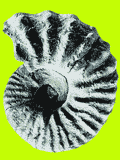 Abstract: Since the end of the 19th century the interval comprising the uppermost Upper Albian, the
Cenomamian, the Turonian and the basal Coniacian has been subdivided, first into ammonite zones, then, beginning in the middle of the 20th century, into zones of planktonic foraminifera. These two groups, one macrofossil, the other microfossil, are particularly effective for
bio-chronostratigraphy thanks to their rapid rates of evolution. But differences in the faunal makeup between the Boreal domain (northwestern Europe) and the Tethyan domain (Mediterranean) have for a long time hindered precise correlation of the two domains. Today, in a time interval covering about 16 million years, there are 29 ammonite zones in the Tethyan domain versus 24 in the Boreal one, of which 16 are common to both domains. For the planktonic foraminifera the Tethyan domain has 11 zones, the Boreal domain 10, with 7 in common. Abstract: Since the end of the 19th century the interval comprising the uppermost Upper Albian, the
Cenomamian, the Turonian and the basal Coniacian has been subdivided, first into ammonite zones, then, beginning in the middle of the 20th century, into zones of planktonic foraminifera. These two groups, one macrofossil, the other microfossil, are particularly effective for
bio-chronostratigraphy thanks to their rapid rates of evolution. But differences in the faunal makeup between the Boreal domain (northwestern Europe) and the Tethyan domain (Mediterranean) have for a long time hindered precise correlation of the two domains. Today, in a time interval covering about 16 million years, there are 29 ammonite zones in the Tethyan domain versus 24 in the Boreal one, of which 16 are common to both domains. For the planktonic foraminifera the Tethyan domain has 11 zones, the Boreal domain 10, with 7 in common.
|
|
Online since May 17, 2008
|
|
Memoir 2 [2008]: Support for a Vraconnian Stage between the Albian sensu stricto and the Cenomanian (Cretaceous System), by Francis AMÉDRO.-
Format [HTML] or [PDF
8,921 KB]
Reference: [CG2008_M02]
DOI:
10.4267/2042/17063
Lang.:
|
|
 Abstract: The geological scale for the middle Cretaceous currently used throughout the world was proposed by Alcide d'Orbigny in the XIXth century between the years 1842 and 1847 and establishes the succession of stages as Albian, Cenomanian and Turonian. In 1868 Renevier proposed that a supplemental chronostratigraphic division be intercalated between the Albian and the Cenomanian: the Vraconnian stage. This term was not generally accepted and after a period when it was referred to by Breistroffer (1936) as a substage constituting the upper part of the Albian, as an equivalent of the Stoliczkaia dispar ammonite Zone, its abandonment was "recommended" by the Conference on the Lower Cretaceous held in Lyon in 1963. The conditions that led to this "decision" will be discussed herein. Abstract: The geological scale for the middle Cretaceous currently used throughout the world was proposed by Alcide d'Orbigny in the XIXth century between the years 1842 and 1847 and establishes the succession of stages as Albian, Cenomanian and Turonian. In 1868 Renevier proposed that a supplemental chronostratigraphic division be intercalated between the Albian and the Cenomanian: the Vraconnian stage. This term was not generally accepted and after a period when it was referred to by Breistroffer (1936) as a substage constituting the upper part of the Albian, as an equivalent of the Stoliczkaia dispar ammonite Zone, its abandonment was "recommended" by the Conference on the Lower Cretaceous held in Lyon in 1963. The conditions that led to this "decision" will be discussed herein.
Historically, for almost a century the Vraconnian was studied only in the condensed levels of the platform where ammonites are abundant, but the succession is thin and not mappable. The type section of the Vraconnian in the Vaud canton of Switzerland is only 2 meters thick. In France the situation is the same in the northern Alps, in most of central Europe, in Russia, in the Crimea, and as far as the Caspian sea.
The examination of a certain number of sections located in other parts of the world: in the southeastern basin of France
(Salazac, Marcoule, Mont-Risou), in the Anglo-Paris basin (Folkestone, Merstham, Grandpré), in the Mons basin (Harchies, Strépy-Thieu), at the southern edge of the Tethys in central Tunisia
(Kaalat Senan), in Madagascar (Diégo Suarez) and North America in California (Dry Creek) demonstrates, however, that in a number of regions of the globe the sedimentary record of the Vraconnian is sometimes rather considerable, often much more important than that of the Albian sensu stricto.
In addition, the Vraconnian represents a very important eustatic event between an Albian transgression and the great Cenomanian transgression (third order cycle and the peak of transgression in a second order cycle). It involves a period of rapid ecologic expansion both as regards the macrofauna (ammonites in particular) and microfauna (planktonic foraminifera). These are the main reasons why a rehabilitation of the Vraconnian as a true stage is proposed here.
|
|
Online since May 17, 2008
|
|
Article 5 [2008]: Pseudoperisphinctinae (Ammonitina,
Perisphinctidae) from the Leckenbyi horizon (Upper Callovian, Athleta zone)
of Montreuil-Bellay (Maine-et-Loire, France) and description of a new
species, Choffatia isabellae, by Alain BONNOT, Pierre-Yves BOURSICOT, Patrice FERCHAUD & Didier MARCHAND.-
Format [HTML] or [PDF
2,045 KB]
Reference: [CG2008_A05]
DOI:
10.4267/2042/16929
Lang.:
|
|
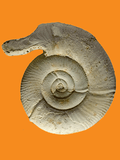 Abstract: Many outcrops exposing the
Mid-Callovian/Upper Callovian boundary have been found near Montreuil-Bellay (Maine-et-Loire). The
lowermost bed of the Upper Callovian has been dated as the Leckenbyi horizon. It contains an abundant ammonite fauna (3125 specimens), in which Perisphinctidae make up
just over half of the specimens. In company with reasonably well-known species such as Pseudopeltoceras leckenbyi (Bean), Orionoides pseudorion (Waagen), Subgrossouvria famulum (Bean) and S. crassa Gérard
et Contaut, occurs a species, previously unknown,
which is described in this article. Choffatia isabellae n. sp. differs markedly from contemporary
Perisphinctidae, for it is distinguished by : 1) a long, smooth juvenile stage, 2) weakly
developed ribbing, 3) the absence of parabolic ornamentation and 4) a high
frequency of constrictions. As this species is unknown in the fauna of the uppermost Middle
Callovian, along with many other species, including Peltoceras marysae Bonnot et alii, it must have colonised the northwestern part of the European platform via the southern margin of the
Tethys during the transgressive interval which started at the beginning of the Late
Callovian. This new species appears abruptly at the base of the Leckenbyi horizon, reaches its acme in the
middle of the horizon, where it probably represents half of the Perisphinctidae, before becoming rare in the upper part of the horizon, then
very rare in the Athleta horizon. Abstract: Many outcrops exposing the
Mid-Callovian/Upper Callovian boundary have been found near Montreuil-Bellay (Maine-et-Loire). The
lowermost bed of the Upper Callovian has been dated as the Leckenbyi horizon. It contains an abundant ammonite fauna (3125 specimens), in which Perisphinctidae make up
just over half of the specimens. In company with reasonably well-known species such as Pseudopeltoceras leckenbyi (Bean), Orionoides pseudorion (Waagen), Subgrossouvria famulum (Bean) and S. crassa Gérard
et Contaut, occurs a species, previously unknown,
which is described in this article. Choffatia isabellae n. sp. differs markedly from contemporary
Perisphinctidae, for it is distinguished by : 1) a long, smooth juvenile stage, 2) weakly
developed ribbing, 3) the absence of parabolic ornamentation and 4) a high
frequency of constrictions. As this species is unknown in the fauna of the uppermost Middle
Callovian, along with many other species, including Peltoceras marysae Bonnot et alii, it must have colonised the northwestern part of the European platform via the southern margin of the
Tethys during the transgressive interval which started at the beginning of the Late
Callovian. This new species appears abruptly at the base of the Leckenbyi horizon, reaches its acme in the
middle of the horizon, where it probably represents half of the Perisphinctidae, before becoming rare in the upper part of the horizon, then
very rare in the Athleta horizon.
|
|
Online since April 17, 2008
|
|
Memoir 1 [2008]: Description and illustration of forty-four
gilianelles (microproblematica) and ten other microproblematica of the
Cretaceous of the stratotype section at Tercis (Campanian-Maastrichtian
boundary), South-West France, by Gilles Serge ODIN.-
Format [HTML]
or [PDF
15.672 KB] / pages 45-75 with a coloured background [PDF
3,477 KB]
Reference: [CG2008_M01]
DOI:
10.4267/2042/16746
Lang.:
|
|
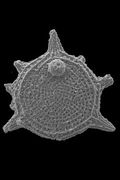 Abstract:
Following acetolysis, microproblematica were collected from indurated carbonates sampled from the stratotype section of the
Campanian-Maastrichtian boundary at Tercis (Landes, France). 44 taxa of the gilianelles group
(microproblematica probably pertaining to the Protista, Protozoans, Rhizopods) as well as ten other microproblematica were discriminated. To document the taxa in this paper 281 scanning electronic microscope images and 183 optical microscope images are presented. The gilianelles encompass 36 species, and 8 subspecies referred to 15 genera of which 14 are new. The new genera are: Tercensella, Azymella, Numismella, Aturella, Scutellella, Corniculum, Caccabella, Orculiella, Pennigerella, Corbella, Aquilegiella, Pocillella, Coraliella, Obbella. Among the other
microproblematica, nine species and one subspecies are proposed; they are referred to 7 new genera: Globulella, Piperella, Vasculum, Lucernellus, Cimicellus, Tubella, Pilella. This first general view uses normal taxonomic criteria to recognize and define a group of microfossils of which the identity and the consistency of occurrence are herewith established using the morphological characters of the body of the test, the presence and development of the expansions attached to that body, and its ornamentation. The use of these criteria in an ordered manner suggests that a rigorous taxonomic collocation is feasible, needing only a few other observations before becoming a formal classification. The statigraphic distribution of the taxa provides a means for establishment of a remarkable tool for relative dating in the stratotype section and its immediate vicinity ; microproblematica allow the sequence to be subdivided into intervals of deposition on the order of 0.1 Ma, a length of time shorter than the intervals obtained using the many microfossil or macrofossil groups previously employed to calibrate the stratotype. The Campanian-Maastrichtian boundary is within the limits of the genus Aturella lineage in the basal portion of the range of Aturella edentula. Abstract:
Following acetolysis, microproblematica were collected from indurated carbonates sampled from the stratotype section of the
Campanian-Maastrichtian boundary at Tercis (Landes, France). 44 taxa of the gilianelles group
(microproblematica probably pertaining to the Protista, Protozoans, Rhizopods) as well as ten other microproblematica were discriminated. To document the taxa in this paper 281 scanning electronic microscope images and 183 optical microscope images are presented. The gilianelles encompass 36 species, and 8 subspecies referred to 15 genera of which 14 are new. The new genera are: Tercensella, Azymella, Numismella, Aturella, Scutellella, Corniculum, Caccabella, Orculiella, Pennigerella, Corbella, Aquilegiella, Pocillella, Coraliella, Obbella. Among the other
microproblematica, nine species and one subspecies are proposed; they are referred to 7 new genera: Globulella, Piperella, Vasculum, Lucernellus, Cimicellus, Tubella, Pilella. This first general view uses normal taxonomic criteria to recognize and define a group of microfossils of which the identity and the consistency of occurrence are herewith established using the morphological characters of the body of the test, the presence and development of the expansions attached to that body, and its ornamentation. The use of these criteria in an ordered manner suggests that a rigorous taxonomic collocation is feasible, needing only a few other observations before becoming a formal classification. The statigraphic distribution of the taxa provides a means for establishment of a remarkable tool for relative dating in the stratotype section and its immediate vicinity ; microproblematica allow the sequence to be subdivided into intervals of deposition on the order of 0.1 Ma, a length of time shorter than the intervals obtained using the many microfossil or macrofossil groups previously employed to calibrate the stratotype. The Campanian-Maastrichtian boundary is within the limits of the genus Aturella lineage in the basal portion of the range of Aturella edentula.
|
|
Online since March 22, 2008
(Supplement online since March 27, 2008)
|
|
Article 4 [2008]: Diagenetic rejuvenation of raised coral reefs and precision of dating. The contribution of the Red Sea reefs to the question of reliability of the Uranium-series datings of middle to late Pleistocene key reef-terraces of the world, by Jean-Claude
PLAZIAT, Jean-Louis REYSS, Abdelmajid CHOUKRI & Charlotte CAZALA.-
Format [HTML] or [PDF
2,228 KB]
Reference: [CG2008_A04]
DOI:
10.4267/2042/16743
Lang.:
|
|
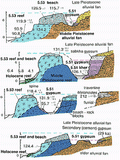 Abstract: This paper is a general review of the dating of reefs on the coasts of the Red
Sea, including those of Egypt, Jordan, Sudan, Eritrea, Saudi Arabia and Djibouti. New methods of sampling and dating
(U/Th) already tested on the reefs and associate deposits of the African coast of Egypt have demonstrated that processes of rejuvenation shown to exist in the best-preserved corals are attributable to the diagenesis of the organic material in their
bio-minerals, thus justifying a revision of a great many datings of corals supposedly younger or older than the age assigned to the high-level isotopic substage (δ18O) MIS 5.5 (= 5e). During this late Pleistocene
substage, a rapid lowering of sea level, short and limited to about ten meters, was detected and associated with a
glacio-eustatic episode of global influence. A comparison of these Middle East reef chronologies with those of New
Guinea, Australia and the western Atlantic that are referred only with difficulty to the δ18O global sea-level
curves, casts doubt on the reliability of many regional reconstructions. Moreover the most
"classic" reef chronologies, more or less out-of-phase with global isotopic records calls for a reexamination of the
chronologic basis of the reference curves derived from marine isotopic data. Abstract: This paper is a general review of the dating of reefs on the coasts of the Red
Sea, including those of Egypt, Jordan, Sudan, Eritrea, Saudi Arabia and Djibouti. New methods of sampling and dating
(U/Th) already tested on the reefs and associate deposits of the African coast of Egypt have demonstrated that processes of rejuvenation shown to exist in the best-preserved corals are attributable to the diagenesis of the organic material in their
bio-minerals, thus justifying a revision of a great many datings of corals supposedly younger or older than the age assigned to the high-level isotopic substage (δ18O) MIS 5.5 (= 5e). During this late Pleistocene
substage, a rapid lowering of sea level, short and limited to about ten meters, was detected and associated with a
glacio-eustatic episode of global influence. A comparison of these Middle East reef chronologies with those of New
Guinea, Australia and the western Atlantic that are referred only with difficulty to the δ18O global sea-level
curves, casts doubt on the reliability of many regional reconstructions. Moreover the most
"classic" reef chronologies, more or less out-of-phase with global isotopic records calls for a reexamination of the
chronologic basis of the reference curves derived from marine isotopic data.
|
|
Online since March 22, 2008
|
|
Article 3 [2008]: New biohorizons and proposal for a revision of the ammonite biozonation of the Upper Barremian of southeastern France, by Didier BERT, Gérard DELANOY & Stéphane BERSAC.-
Format [HTML] or [PDF
346 KB]
Reference: [CG2008_A03]
DOI:
10.4267/2042/16737
Lang.:
|
|
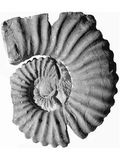 Abstract: New biohorizons and proposal for a revision of the ammonite biozonation of the Upper Barremian of southeastern France.-
A new ammonite biozonal scheme is proposed for the Upper Barremian of southeastern France. It takes into account faunal changes, sequence stratigraphy and historical data. Four new biohorizons are proposed. At present, three (formerly six) are accepted for the Upper
Barremian: the Vandenheckei, Sartousiana and Giraudi biozones. The first contains three subzones, the Uhligi (current status discussed), the Sayni and the Barremense subzones, and two new
biohorizons, the Marchandi and Breistrofferi biohorizons (top of the Barremense Subzone). The Sartousiana Biozone now includes the
Limentinus, Provincialis and Feraudianus subzones. This last one lost its status of biozone because of paleontologic and stratigraphic arguments. Six biohorizons are recognized in the Sartousiana Biozone: the
Limentinus, Provincialis, Casanovai, Feraudianus, Magnini and Autrani
biohorizons. The Giraudi Biozone includes the Giraudi, Sarasini and Waagenoides subzones and the
Giraudi, Emerici and Puzosianum biohorizons. Abstract: New biohorizons and proposal for a revision of the ammonite biozonation of the Upper Barremian of southeastern France.-
A new ammonite biozonal scheme is proposed for the Upper Barremian of southeastern France. It takes into account faunal changes, sequence stratigraphy and historical data. Four new biohorizons are proposed. At present, three (formerly six) are accepted for the Upper
Barremian: the Vandenheckei, Sartousiana and Giraudi biozones. The first contains three subzones, the Uhligi (current status discussed), the Sayni and the Barremense subzones, and two new
biohorizons, the Marchandi and Breistrofferi biohorizons (top of the Barremense Subzone). The Sartousiana Biozone now includes the
Limentinus, Provincialis and Feraudianus subzones. This last one lost its status of biozone because of paleontologic and stratigraphic arguments. Six biohorizons are recognized in the Sartousiana Biozone: the
Limentinus, Provincialis, Casanovai, Feraudianus, Magnini and Autrani
biohorizons. The Giraudi Biozone includes the Giraudi, Sarasini and Waagenoides subzones and the
Giraudi, Emerici and Puzosianum biohorizons.
|
|
Online since March 20, 2008
|
|
Letter 1 [2008]: Characterisation of the organic matter of upper Bedoulian and lower Gargasian strata in the historical stratotypes (Apt and Cassis-la-Bédoule areas, SE France), by François BAUDIN, Michel MOULLADE & Guy TRONCHETTI.-
Format [HTML] or [PDF
180 KB]
Reference: [CG2008_L01]
DOI:
10.4267/2042/14860
Lang.:
|
|
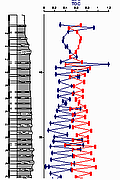 Abstract: The Total Organic Carbon (TOC) content of the Gargasian strata studied in their historical stratotype area is rather low (0.3% on average). Only a few levels show TOC values approaching 1.2%. This small amount of preserved organic matter, associated with low hydrogen index values (10 to 115 mg hydrocarbons/g TOC), argues for deposition in fully oxic conditions. This organic content is a mixture of land-derived organic particles and deeply
oxidized marine organic matter. The organic flux was strongly diluted by the autochthonous carbonate input. Abstract: The Total Organic Carbon (TOC) content of the Gargasian strata studied in their historical stratotype area is rather low (0.3% on average). Only a few levels show TOC values approaching 1.2%. This small amount of preserved organic matter, associated with low hydrogen index values (10 to 115 mg hydrocarbons/g TOC), argues for deposition in fully oxic conditions. This organic content is a mixture of land-derived organic particles and deeply
oxidized marine organic matter. The organic flux was strongly diluted by the autochthonous carbonate input.
|
|
Online since February 4, 2008
|
|
Article 2 [2008]: New micropalaeontological studies on the type section of the Campanian-Maastrichtian at Tercis (SW France): new ostracodes obtained using acetolysis, by Bernard ANDREU & Gilles Serge ODIN.-
Format [HTML] or [PDF
2,490 KB]
Reference: [CG2008_A02]
DOI:
10.4267/2042/14857
Lang.:
|
|
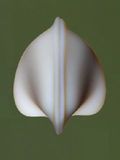 Abstract: Through the use of acetolysis new micropalaeontological studies on the type section of the
Campanian-Maastrichtian boundary at Tercis (SW France) we obtained additional information on
ostracodes. Acetolysis on hard carbonates levels of the Tercis quarry found 22 species in addition to those of the studies published in 2001. Today, 75 species are recognized: they represent 34 known genera, and 4 currently unidentified. Small species usually rare of the genera Aversovalva, Bythoceratina and Eucytherura were collected. All of the assemblages (of both genera and species) are characteristic of a
Campanian- Maastrichtian open carbonate platform environment. Abstract: Through the use of acetolysis new micropalaeontological studies on the type section of the
Campanian-Maastrichtian boundary at Tercis (SW France) we obtained additional information on
ostracodes. Acetolysis on hard carbonates levels of the Tercis quarry found 22 species in addition to those of the studies published in 2001. Today, 75 species are recognized: they represent 34 known genera, and 4 currently unidentified. Small species usually rare of the genera Aversovalva, Bythoceratina and Eucytherura were collected. All of the assemblages (of both genera and species) are characteristic of a
Campanian- Maastrichtian open carbonate platform environment.
|
|
Online since February 4, 2008
|
|
Article 1 [2008]: Planktonic and benthic foraminiferal assemblages and biostratigraphy of the uppermost Bedoulian and lower Gargasian of La Tuilière - St-Saturnin-lès-Apt (area of the Aptian stratotype, Vaucluse, SE France), by Michel
MOULLADE, Guy TRONCHETTI & Jean-Pierre BELLIER.-
Format [HTML] or [PDF
7,370 KB]
Reference: [CG2008_A01]
DOI:
10.4267/2042/14699
Lang.:
|
|
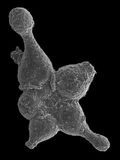 Abstract: Research on the Bedoulian and Gargasian of the Cassis-La Bédoule
(Bouches du Rhône, SE France) area is extended, by a study of four overlapping sections in the stratotypic area of the Aptian stage in the hamlet of La Tuilière (commune of
Saint-Saturnin-lès-Apt, Vaucluse, SE France). This new information permitted a detailed analysis of upper Bedoulian and lower Gargasian benthic (30
taxa) and planktonic (15 taxa) foraminiferal assemblages. Here we describe, illustrate and give the ranges and distribution of the most significant forms, and call attention to several benthic and
planktonic species that may serve as extra-regional markers. Abstract: Research on the Bedoulian and Gargasian of the Cassis-La Bédoule
(Bouches du Rhône, SE France) area is extended, by a study of four overlapping sections in the stratotypic area of the Aptian stage in the hamlet of La Tuilière (commune of
Saint-Saturnin-lès-Apt, Vaucluse, SE France). This new information permitted a detailed analysis of upper Bedoulian and lower Gargasian benthic (30
taxa) and planktonic (15 taxa) foraminiferal assemblages. Here we describe, illustrate and give the ranges and distribution of the most significant forms, and call attention to several benthic and
planktonic species that may serve as extra-regional markers.
The study of the planktonics in these expanded and continuous sections made it possible to strengthen the zonation which had been established in the Lower Aptian stratotype of Cassis-La
Bédoule, i.e. a succession of five zones (cabri, luterbacheri, ferreolensis, barri,
algerianus); this zonal scheme is improved by the addition of a horizon with Globigerinelloides ferreolensis heptacameratus
nov. subsp., which straddles the boundary between the luterbacheri and ferreolensis zones. We also show the temporal quasi-coincidence of: 1) the top of the Furcata ammonite
Zone, 2) the lithological change named "change of color" and 3) a triple micropaleontological datum (FAD of Praehedbergella luterbacheri, LAD of Protocythere bedoulensis and Lenticulina cf. nodosa) of which the importance in the stratotype of Cassis-La Bédoule had already been pointed out. All these data may be valuable in the definition of the
Bedoulian-Gargasian boundary.
Within the luterbacheri Zone of the early Gargasian, an episode probably of volcanic origin that we interpret as the equivalent of the Van Gogh Level (initially detected in the Vocontian domain), is marked by a strong crisis in the diversity of epibenthic and planktonic foraminifers, as well as in that of the ostracodes.
From a paleoecological and paleobiogeographical point of view, a comparison of the benthic and planktonic foraminiferal assemblages of La Tuilière with those of neighbouring areas reveals specific features related to paleodepth and shows affinities which appear to be closer with the microfaunas of certain boreal areas
(e.g. northern Germany) than with the Tethysian realm.
|
|
Online since January 28, 2008
|

|
|
2007 (vol. 7)
|
|
Article 7 [2007]: Facies development during late Early–Middle Cambrian
(Tayan Member, Burj Formation) transgression in the Dead Sea Rift valley, Jordan, by Olaf
ELICKI.-
Format [HTML] or [PDF
1,120 KB]
Reference: [CG2007_A07]
DOI:
10.4267/2042/9717
Lang.:
|
|
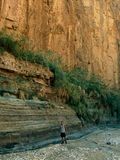 Abstract: The transgressive Tayan Member of the upper Lower to Middle Cambrian Burj Formation (Jordan) has been investigated in several localities of the Dead Sea Rift valley, Jordan. The lower portion of this member consists of low-energy siliciclastics with indications of temporary, early pedogenetic processes, pointing to some stagnation during transgression. The upper portion of the member was deposited under higher energy conditions. Stromatolites, desiccation cracks,
halite-pseudomorphs, laminated dolostones, and tepees, together with ripples,
mud-clasts and scours point to a shallow intertidal to supratidal sabkha-related environment in a climate of tropical to subtropical aridity. Abstract: The transgressive Tayan Member of the upper Lower to Middle Cambrian Burj Formation (Jordan) has been investigated in several localities of the Dead Sea Rift valley, Jordan. The lower portion of this member consists of low-energy siliciclastics with indications of temporary, early pedogenetic processes, pointing to some stagnation during transgression. The upper portion of the member was deposited under higher energy conditions. Stromatolites, desiccation cracks,
halite-pseudomorphs, laminated dolostones, and tepees, together with ripples,
mud-clasts and scours point to a shallow intertidal to supratidal sabkha-related environment in a climate of tropical to subtropical aridity.
The fossil content of the Tayan Member consists exclusively of trace fossils. Simple
endobentic, worm-like r-strategists are common in some horizons. For the first time, Treptichnus pedum has been reported from Jordan where it was found near the base of this member. The markedly reduced biodiversity together with sedimentological data led to the interpretation of a strongly stressed, paleoecologically unstable habitat.
Regional comparisons with high-energy transgressive environments laid down at the same time show that the main factors controlling facies development and the migration of facies belts are (1) the topography of the flooded surface and of the hinterland (mainly with only a local effect), (2) the configuration of the coast (local effect), (3) the rate of subsidence and transgression (local to regional effects), and (4) climate (large regional effects). The combination and overlap of these factors controlled facies gradients and may explain special differences between the facies of the Jordanian and those of the near-by Israeli transgressive deposits on the one hand, but, also the obvious general similarity of Lower to Middle Cambrian transgressive successions in the Middle East and the Mediterranean part of Gondwana on the other hand.
|
|
Online since November 1, 2007
|
|
Article 6 [2007]: Revision of the foraminiferal genus
Globoreticulina Rahaghi, 1978 and of its associated fauna of larger foraminifera from the late Middle Eocene of Iran, by Lukas
HOTTINGER.-
Format [HTML] or [PDF
7,274 KB]
Reference: [CG2007_A06]
DOI:
10.4267/2042/9213
Lang.:
Test a new tool available from the page "Plate
cross-comparison" (click, drag and drop)
|
|
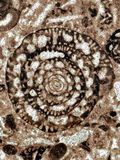 Abstract: The definition of the type species of the genus Globoreticulina Rahaghi, 1978, G. iranica Rahaghi, 1978, is emended and its age discussed in relation to those of 17 associated taxa of larger foraminifera, all from restricted shallow environments. These taxa represent porcelaneous groups of spiroline habit including Rhabdorites malatyaensis, archaiasines (Archaias operculiniformis and A. diyarbakirensis), agglutinated conicals (Coskinolina and Dictyoconus) and some rotaliids (Medocia and others). These taxa were revised where necessary and their biostratigraphic ranges discussed. In addition to the establishment of a new subfamily of the
Alveolinidae, the Malatyninae, the following new Linnaean names are introduced in order to conform with the revisions: Austrotrillina eocaenica n. sp., Neotaberina neaniconica n. gen. n. sp., Neorhipidionina spiralis n. gen. n. sp., Penarchaias n. gen. and Rotaliconus persicus n. gen. n. sp. The species Praerhapydionina huberi Henson is transferred to the genus Haymanella Sirel and the genus Praearchaias Sirel is suppressed. The age of the type level of Globoreticulina iranica is interpreted to be SBZ 18 (Late
Bartonian) according to the available local data but the possibility that its stratigraphic position is actually level SBZ 17 or SBZ16 can not be excluded with certainty. Abstract: The definition of the type species of the genus Globoreticulina Rahaghi, 1978, G. iranica Rahaghi, 1978, is emended and its age discussed in relation to those of 17 associated taxa of larger foraminifera, all from restricted shallow environments. These taxa represent porcelaneous groups of spiroline habit including Rhabdorites malatyaensis, archaiasines (Archaias operculiniformis and A. diyarbakirensis), agglutinated conicals (Coskinolina and Dictyoconus) and some rotaliids (Medocia and others). These taxa were revised where necessary and their biostratigraphic ranges discussed. In addition to the establishment of a new subfamily of the
Alveolinidae, the Malatyninae, the following new Linnaean names are introduced in order to conform with the revisions: Austrotrillina eocaenica n. sp., Neotaberina neaniconica n. gen. n. sp., Neorhipidionina spiralis n. gen. n. sp., Penarchaias n. gen. and Rotaliconus persicus n. gen. n. sp. The species Praerhapydionina huberi Henson is transferred to the genus Haymanella Sirel and the genus Praearchaias Sirel is suppressed. The age of the type level of Globoreticulina iranica is interpreted to be SBZ 18 (Late
Bartonian) according to the available local data but the possibility that its stratigraphic position is actually level SBZ 17 or SBZ16 can not be excluded with certainty.
|
|
Online since September 25, 2007
|
|
Article 5 [2007]: The upper Bedoulian and lower Gargasian Ostracoda of the Aptian stratotype: Taxonomy and biostratigraphic correlation, by Jean-François
BABINOT, Michel MOULLADE & Guy TRONCHETTI.-
Format [HTML] or [PDF 4,263 KB] / pages
8-9 in A3-sized pages [PDF
85 KB]
Reference : [CG2007_A05]
DOI: 10.4267/2042/8877
Lang. :
Reference : [CG2007_A05
(fr)]
DOI: 10.4267/2042/8878
Lang. :
|
|
Abstract: In the vicinity of Saint-Saturnin-lès-Apt (Vaucluse, SE France), which is included in the area of the historic Aptian stratotype of Apt-Gargas, are four sections in a succession that permits the study in a very detailed and continuous way of the last beds of the upper Bedoulian and those of the lower Gargasian. The
Ostracod content of the microfauna is relatively important and in a satisfactory state of preservation. 46 species have been indexed of which three are new: Cytherella circumrugosa nov. sp., Cytherelloidea bedouliana nov. sp. and Parexophthalmocythere (Parexophthalmocythere) sp.
Until the present day, our comprehension of this group of microfossils in this stratigraphic interval was very fragmentary, not just in the Apt region but also in the Bedoulian historic stratotype
area (Cassis-la Bédoule). This new study made it possible to determine a good number of species not previously reported in the stratotypes, to refine the generic status of many forms and to place some of them in open nomenclature.
The completion of a chronologic distribution chart collated with a recently published foraminiferal zonation (Cabri, Luterbacheri and Ferreolensis zones) shows very clearly the bipartite distribution of a good part of the
Ostracod fauna. Accordingly, two ensembles are recognized, one at the end of the upper Bedoulian (index species Protocythere bedoulensis), the other characterizing the lower Gargasian, identified by the appearance and development of Parataxodonta inornata. The two groups are sharply separated by an episode of impoverished microfaunas at the base of the Gargasian.
|
|
Online since July 25, 2007
|
|
Article 4 [2007]: Morphological variability of Globorotalia menardii
(planktonic foraminifera) in two DSDP cores from the Caribbean Sea and the Eastern Equatorial Pacific,
by Michael KNAPPERTSBUCH.-
Format [HTML] or [PDF
1,851 KB]
Reference: [CG2007_A04]
DOI:
10.4267/2042/8455
Lang.:
|
|
Abstract: Variability in the test of Globorotalia menardii
during the past 8 million years has been investigated at DSDP Site 502A (Caribbean Sea) and DSDP Site 503A (Eastern Equatorial Pacific).
Measurements were made of spire height (∂x), maximum diameter (∂y), the tangent angles of the upper and lower peripheral keels
(Φ1, Φ2, respectively), the number of chambers in the final whorl, and the area of the silhouette in keel view. Four morphotypes
alpha, beta, gamma, and delta were distinguished. Morphotype alpha was found in strata ranging in age
from the Late Miocene through the Holocene. It shows a continuous increase in ∂x and ∂y until the Late Pleistocene. During
and after the final closure of the ancient Central American Seaway (between 2.4 Ma and 1.8 Ma) there was a rapid increase in the area
of the test in keel view. At the Caribbean Sea site, morphotype beta evolved during the past 0.22 Ma. It is less inflated than
alpha and has a more delicate test. In the morphospace of ∂x vs. ∂y, morphotypes alpha and beta can be
distinguished by a separation line ∂y = 3.2 * ∂x - 160 (∂x and ∂y in µm). Plots of morphotype alpha
are below that line, those of beta are above it. Morphotype alpha is taken to be
Globorotalia menardii menardii Parker, Jones & Brady
(1865) and includes G. menardii 'A' Bolli (1970). Morphotype beta is identified as
G. menardii cultrata (d'Orbigny). Morphotypes gamma and delta are extinct Upper Miocene to Pliocene forms which evolved from morphotype alpha. They have a narrower Φ1 angle and more chambers (≥7) than morphotype alpha commonly with 5 to 6 chambers (7 in transitional forms). In contemporaneous samples morphotype delta can be distinguished from gamma by a smaller value of Φ1 and 8 or more chambers in the final whorl. Morphotype gamma is taken to be G. limbata (Fornasini,
1902) and includes the junior synonym G. menardii 'B' Bolli
(1970). Morphotype delta is G. multicamerata Cushman & Jarvis
(1930). With the exception of the Late Pleistocene development of G. menardii cultrataonly in the Caribbean the morphological changes of G. menardii at DSDP Sites 502A and 503A are similar. The development from the ancestral G. menardii menardii of the G. limbata - G. multicamerata lineage during the Pliocene and of G. menardii cultrata during the Late Pleistocene suggests responses at the two sites to a changing palaeoceanography during and after the formation of the Isthmus of Panama.
|
|
Online since July 2, 2007
|
|
Article 3 [2007]: Fluctuations of sea-water chemistry during Gargasian (Middle Aptian) time. Data from trace-element content (Mg,
Sr, Mn, Fe) in hemipelagic carbonates from La Marcouline Quarry (Cassis, SE France), by Maurice
RENARD, Marc de RAFÉLIS, Laurent EMMANUEL, Catherine BELTRAN, Michel
MOULLADE, & Guy TRONCHETTI.-
Format [HTML] or [PDF
1,165 KB]
Reference: [CG2007_A03]
DOI:
10.4267/2042/8454
Lang.:
|
|
Abstract: In the Lower Aptian historical stratotype area (Cassis-La Bédoule, SE France), a geochemical study of the Gargasian (Middle Aptian) marl-limestone alternations of the La Marcouline quarry complements data already obtained from Bedoulian
(Early Aptian) sediments there. Nannoconids are the main carbonate producers in both limestones and
marls. Although diagenetic minerals, such as ankerite (2.5%) are present in small amounts, the
trace-element content of bulk carbonate is very close to that of Nannoconus
spp. so geochemical sequences can be defined. The long-term evolution of trace-element content was not affected by diagenetic processes, variations in carbonate mineralogy, or a change of carbonate producers. An increase of around 500 ppm in the strontium content of bulk carbonate occurs between the base of the Cabri zone
(late Bedoulian) and the Algerianus zone (late Gargasian). This evolution is linked to fluctuations in seawater Sr/Ca ratios caused by variability in the influx of hydrothermal and river waters, by changes in the ratio of aragonite/calcite production and by shifts in sea level. The eustatic sequence Aptian 4, its parasequences and its key surfaces (sequence boundaries, maximum flooding surface) are clearly reflected in the evolution of
the bulk-carbonate contents of manganese.
|
|
Online since July 2, 2007
|
|
Article 2 [2007]: The Gargasian (Middle Aptian) of La Marcouline section at Cassis-La Bédoule (SE France): Stable isotope record and orbital
cyclicity, by Wolfgang KUHNT & Michel MOULLADE.-
Format [HTML] or [PDF 485 KB]
Reference: [CG2007_A02]
DOI:
10.4267/2042/8044
Lang.:
|
|
Abstract: Bulk rock stable isotope analysis of La Marcouline section (Cassis-La Bédoule area, SE France) revealed a general trend of decreasing δ13C and δ18O values from the bottom to the top of the section. The decrease in δ13C values reflects a global trend in Middle Aptian times, namely a return to pre-excursion values of δ13C values following a major, positive excursion in the Early
Aptian, which is a reflection of the Oceanic Anoxic Event (OAE) 1a.
Power spectra of the bedding rhythms suggest that precessional and long eccentricity cycles of the Milankovitch band controlled the deposition of marl-limestone bundles. This can be interpreted as the result of a forcing by insolation at low latitudes which resulted in a monsoon-controlled precipitation pattern, that in turn induced the deposition of clay-rich beds. Conversely, limestone beds were formed in periods of dryer climate. Higher sea-surface productivity during wet periods may have been caused by an increase in continental runoff and a consequent enhancement in the delivery of nutrients to epicontinental basins.
An orbital cyclicity in the sedimentary patterns in La Marcouline section provides the opportunity to calibrate the duration of the well-established G. ferreolensis foraminiferal Zone with that of orbital chronology. The G. ferreolensis Zone at Cassis-La Bédoule spans 33 precessional cycles and its duration is thus estimated to be approximately 760
ka. This length of time is significantly shorter than the estimates of published timescales for this zone and thus may be an argument for proposing that the Gargasian substage is significantly shorter than its currently accepted range.
|
|
Online since May 24, 2007
|
|
Memoir 2 [2007]:
Relations between the northern and southern margins of the Tethys ocean during the Cretaceous period, edited by Luc G. BULOT, Serge FERRY & Danièle GROSHENY.-
Format [HTML]
or [PDF 4,951 KB]
Reference:
[CG2007_M02]
DOI:
10.4267/2042/8029
|
|
Abstract:
The theme of the 2006 meeting of the Groupe Français du Crétacé (GFC)
was on a comparison of the northern and southern margins of the Tethyan ocean
during the nearly 80 million year span of the Cretaceous period, a time when this large,
meander-edged seaway was closed progressively by the movement of two major
tectonic plates. Consequently, during this slow closure sedimentary successions
near the northern and southern shores of the Tethys provide ideal sites for
testing a number of hypotheses. One of these is the degree of correlativity
between "events" in tracts far distant from one another. The "events"
could be paleontologic (faunal renewal vs. migration), sedimentologic (are
depositional sequences and specific lithologies such as black shale or
phosphates on either shore coeval?), eustatic vs. tectonic. On November
27-28, 2006, thirty earth scientists met in the École des Mines in Paris to
discuss these matters. Thirteen communications were presented, eleven of which
as abstracts or extended abstracts comprise this special publication by "Carnets".
1- Robaszynski F., Amédro F., González-Donoso J.M. & Linares D.
(2007).- Les bioévénements de la limite Albien (Vraconnien) - Cénomanien aux marges nord et sud de la Téthys (S.E. de la France et Tunisie
centrale) [Bioevents at the Albian (Vraconnian) - Cenomanian boundary at the
North and South margins of the Tethyan Ocean (SE France and Central Tunisia)].
Lang.:
2- Courville P. (2007).- Échanges et colonisations fauniques
(Ammonitina) entre Téthys et Atlantique sud
au Crétacé supérieur : voies atlantiques ou sahariennes ? [Late
Cretaceous faunal exchange and colonization (Ammonitina) between the Tethys and
the South Atlantic: Atlantic or Saharan routes?].
Lang.:
3- Westermann S., Föllmi K.B., Matera V. & Adatte T. (2007).- Phosphorus and trace-metal records during Cretaceous oceanic
anoxic events: Example of the Early Aptian OAE in the western Tethys [Évolution
de la concentration du phosphore et des métaux-traces durant les événements
anoxiques du Crétacé inférieur : exemple de l'événement de l'Aptien
inférieur (OAE 1a) dans la Téthys occidentale].
Lang.:
4- Jammes S., Manatschal G. & Ghienne J.-F.
(2007).- L'évolution tectono-sédimentaire du système "Golfe de
Gascogne/Pyrénées Occidentales" au Crétacé inférieur : un nouveau
regard [The tectonic and sedimentary evolution of the Bay of Biscay/Western
Pyrenees during the Early Cretaceous : a new point of view].
Lang.:
5- Bardet N., Houssaye A., Pereda Suberbiola X. & Rage J.-C. (2007).-
The marine squamates (reptiles) from the Cenomanian-Turonian of the Tethys: a noteworthy radiation [Les squamates (reptiles) marins
du Cénomanien-Turonien de la Téthys :
une radiation remarquable].
Lang.:
6- Yans J., Masure E., Dejax J.,
Pons D. & Amédro F. (2007).- Influences boréales dans le bassin de Mons
(Belgique)
à l'Albien [Boreal influences in the Mons basin (Belgium) during the Albian].
Lang.:
7- Granier B.
(2007).- On the track of a major trans-Tethyan discontinuity [Sur la
piste d'une discontinuité majeure trans-Téthys].
Lang.:
8- Ferry S., Merran Y.,
Grosheny D. & Mroueh M. (2007).-
The Cretaceous of Lebanon in the Middle East (Levant) context [Le Crétacé du Liban dans le cadre du Moyen-Orient
(Levant)].
Lang.:
9- Grosheny D., Chikhi-Aouimeur F., Ferry S., Jati M. , Herkat M., Atrops F., Redjimi W. & Benkerouf F. (2007).-
The Cenomanian-Turonian of the Saharan Atlas (Algeria) [Le Cénomanien-Turonien de l'Atlas saharien (Algérie)].
Lang.:
10- Bulot L.G. (2007).- Endémisme et
cosmopolitisme des faunes d'ammonites de la plaque arabique au Crétacé moyen (Aptien
- Turonien) [Endemism vs. cosmopolitanism of the ammonite faunas
from the Arabian plate during mid-Cretaceous times (Aptian – Turonian)].
Lang.:
11- Bulot L.G. & Ferry S. (2007).-
La discontinuité albienne à l'échelle globale et
ses implications paléobiogéographiques et biostratigraphiques [The Albian unconformity at a global scale and
its palaeobiogeographic and biostratigraphic implications].
Lang.:
|
|
Online since May 15, 2007
|
|
Letter 1 [2007]: Parsimony analysis of endemicity of enchodontoid fishes from the Cenomanian, by Hilda Maria Andrade da SILVA & Valéria GALLO.-
Format [HTML] or [PDF
111 KB]
Reference: [CG2007_L01]
DOI:
10.4267/2042/7146
Lang.:
|
|
Abstract: Parsimony analysis of endemicity was applied to analyze the distribution of enchodontoid fishes occurring strictly in the Cenomanian. The analysis was carried out using the computer program PAUP* 4.0b10, based on a data matrix built with 17 taxa and 12 areas. The rooting was made on an hypothetical all-zero outgroup. Applying the exact algorithm branch and bound, 47 trees were obtained with 26 steps, a consistency index of 0.73, and a retention index of 0.50. The topology found with a majority rule consensus was: [(Mexico) + (United States) + (Morocco + Italy) + (Lebanon + Israel) + (Italy-Slovenia) + (Brazil)] + (D.R. Congo) + (Sweden) + (Germany) + (England). The procedure delimited two areas of endemism in the Tethys Ocean. They are Morocco and southern Italy and Lebanon and Israel. The area of endemism formed by Morocco + Italy represents the North African region of the Tethys Ocean, and that formed by Lebanon + Israel is in the mid-Tethyan Ocean. Our results are in partial agreement with the patterns of geographical distribution of certain invertebrate biota.
|
|
Corrigendum: The fossil locality
Lesina referred to in this paper as being in Italy is in fact in Croatia: Lesina
is the former name of an island (Hvar). This correction does not affect the conclusions of the paper.
|
|
Online since April 4, 2007
|
|
Memoir
1 [2007]: Recent advances in palynology, edited by Philippe STEEMANS & Emmanuelle JAVAUX.-
Format [HTML]
or [PDF
5,762 KB]
Reference: [CG2007_M01]
DOI:
10.4267/2042/7042
|
|
Abstract:
A set of 11 abstracts and short papers (extended abstracts) of presentations
given at a meeting organized by the NFSR Working Group, "Micropaléontologie
végétale et Palynologie (MVP)", held on May 24, 2006 at the University of
Liège, Belgium. Most contributions are available only in English.
1- Breuer P., Filatoff J.
& Steemans P. (2007).- Some considerations
on Devonian miospore taxonomy.
Lang.:
2- Breuer P., Dislaire G., Filatoff J., Pirard E.
& Steemans P. (2007).- A classification of
spores by support vectors based on an analysis of their ornament spatial
distribution – An application to Emsian miospores from Saudi Arabia.
Lang.:
3- Dejax J., Dumax É., Damblon F.
& Yans J. (2007).- Palynology of Baudour
Clays Formation (Mons Basin, Belgium): correlation within the "stratotypic"
Wealden.
Lang.:
4- Gerards T., Yans J.
& Gerrienne P. (2007).- Quelques
implications paléoclimatiques de l'observation de bois fossiles du Wealdien du
bassin de Mons (Belgique)
Résultats préliminaires.
Lang.:
5- Grey K. (2007).- Advances in Ediacaran biostratigraphy in Australia.
Lang.:
6- Javaux E.J. (2007).- Patterns of diversification in early
eukaryotes.
Lang.:
7- Prestianni C., Streel M., Thorez J. & Gerrienne P. (2007).-
Strud: old quarry, new discoveries. Preliminary report.
Lang.:
8- Steemans P. & Breuer P. (2007).-
PalyWeb: A palynomorph database project on the web.
Lang.:
9- Streel M., Renson V. & Vleeschouwer F. de (2007).- Palynological and geochemical data in peat sediments alongside an old (Roman or
Merovingian) paved road in the Hautes-Fagnes.
Lang.:
10- Vanmeirhaeghe J. (2007).- Chitinozoans of the lower Llanvirn Huy and the middle Caradoc
Sart-Bernard formations (Middle to Upper Ordovician): implications for the stratigraphy of the Condroz Inlier (Belgium).
Lang.:
11- Ville de Goyet F. de, Breuer P., Gerrienne P., Prestianni C., Streel M. & Steemans P. (2007).- Middle Devonian
(Givetian) megaspores from Belgium (Ronquières) and Libya (A1-69 borehole).
Lang.:
|
|
Online since March 22, 2007
|
|
Article
1 [2007]: Environmental changes during marl-limestone formation: evidence from the Gargasian (Middle Aptian) of La Marcouline Quarry (Cassis, SE France), by Catherine BELTRAN, Marc de RAFÉLIS, Maurice
RENARD, Michel MOULLADE & Guy TRONCHETTI.-
Format [HTML] or [PDF 646 KB]
Reference: [CG2007_A01]
DOI:
10.4267/2042/6828
Lang.:
|
|
Abstract: Limestone-marl alternations are usually interpreted to reflect cyclic paleoenvironmental fluctuations linked to Milankovitch-scale climate variations. However, the impact of diagenesis on lithological differentiation can be overprinted on the primary signal.
In order to evaluate environmental variations during the deposition of the
Gargasian hemipelagic limestone-marl alternations from the "La
Marcouline" quarry (SE France), we have applied a multi-discipline approach (carbonate geochemistry, micropaleontology and mineralogy).
The work uses of a method of granulometric separation of the main carbonate particles which (1) allows the characterization and quantification of the compositions of the carbonate phases of both lithologies and (2) gives access to the geochemical signatures of similar carbonate (bio-) particles in each
lithology.
The quantifications show that micarb constitutes a significant portion (around 40 per cent) of the sediments. Their geochemical signatures indicate that most of them were formed by fine fragmentation of nannoconid tests. Based on these interpretations, our results indicate that nannoconids are the major constituents of both the marly limestone and the marl layers and that both lithologies are similar in composition.
The coccolith assemblages (mainly Watznaueria spp.) of the limestone and marl layers are similar and equally well-preserved. Changes in oxygen and carbon isotopic ratios express cyclic fertility and salinity/temperature variations in surface waters. The marls indicate higher fertility and lower salinity (or higher temperature) conditions than those denoted by the marly
limestones.
Although diagenesis has not altered these rhythmites no strong evidence has been found for linking classical processes such as dilution or productivity cycles to the composition of the sediments (carbonate constituents and clay mineralogy).
This study demonstrates that La Marcouline succession has retained, as recorded by geochemical proxy, its primary environmental variations. Nevertheless, the homogeneity in both lithotypes of sedimentological parameters (clay mineralogy, sediment composition,
...) seems to indicate that these fluctuations did not affect the ecosystem strongly enough to cause marked differences in the composition of marls and
marly-limestones.
|
|
Online since February 27, 2007
|

|
|
2006 (vol. 6)
|
|
Article 5 [2006]: New micropalaeontological studies on the stratotype of the Campanian-Maastrichtian boundary at Tercis (SW France): the gilianelles
(microproblematica) extracted through acetolysis, by Gilles Serge ODIN & Alexandre
LETHIERS.-
Format [HTML] or [PDF
4,212 KB]
Reference: [CG2006_A05]
DOI:
10.4267/2042/6697
Lang.:
|
|
Abstract: The Campanian-Maastrichtian stratotype section at Tercis (SW France)
consists mainly of hard calcareous levels. Their treatment using acetolysis
left residues among which for the first time well-preserved free microfossils were obtained
(These levels had been studied previously only through thin sections). Within these residues, a wealth of calcareous shells of unknown affinity (incertae sedis) occur. These
previously undescribed fossils are documented herein with photographs and drawings. Optical observations are synthesised in computer assisted drawings which depict 36
discrete forms. Scanning electron microscopy documented the nannostructures of these tests which
led to the recognition of 30 forms with a common organisation and
nannostructure. These are the microproblematica group called "gilianelles". The remaining six forms of incertae sedis do not
share the same characteristics. According to morphological observations, a planktonic
existence is inferred for most of the incertae sedis. The simple organisation and small size of the gilianelles suggest that they may represent a new Order of Rhizopod
Protozoans. Their stratigraphical distribution has been established in the stratotype section
of the "Grande Carrière" at Tercis (SW France). This distribution
shows an extraordinary rate of turn-over with some taxa having a range of less than 1 Ma.
|
|
Online since December 14, 2006
|
|
Article 4 [2006]: Schmidtites celatus
(Obolida, Brachiopoda) from the "Obolus sands" (Upper Cambrian - Lower Ordovician) of Estonia, by Christian C.
EMIG.-
Format [HTML] or [PDF 801 KB]
Reference: [CG2006_A04]
DOI:
10.4267/2042/5837
Lang.:
|
|
Abstract: Large collections of the brachiopod obolid Schmidtites celatus have been gathered from Upper Cambrian-Lower Ordovician strata in four northern Estonian localities. The morphological features and the taxonomic characters of the genus and of the single species representing it are
re-described and illustrated. New diagnoses are proposed based on characters of the shell and morphological traits that permit Schmidtites celatus to be compared with and distinguished from the other obolid genera occurring in the same samples or areas,
i.e. Ungula ingrica, Oepikites, and Obolus apollinis which now includes specimens formerly described as Ungula convexa. Schmidtites celatus differs from them mainly in the arrangement of its musculature.
|
|
Online since September 21, 2006
|
|
Article 3 [2006]: Are the green algae (phylum
Viridiplantae) two billion years old?, by Bernard TEYSSÈDRE.-
Format [HTML] or [PDF 303 KB]
Reference: [CG2006_A03]
DOI:
10.4267/2042/5836
Lang.:
|
|
Abstract: In his book, Life on a young planet,
A.H. Knoll states that the first documented fossils of green algae date back 750 Ma. However, according to B. Teyssèdre's
book, La vie invisible, they are much older.
Using a method which combines paleontology and molecular phylogeny, this paper is an inquiry into the Precambrian fossils of some "acritarchs" and of a
primitive clade of green algae, the Pyramimonadales. A paraphyletic group of unicellular green algae, named "Prasinophyceae", is represented at Thule (Greenland) ca. 1200 Ma by several morphotypes of the
monophyletic Pyramimonadales, including Tasmanites and Pterospermella
that are akin to algae still living today. These two, and others, probably had forerunners going back 1450 / 1550 Ma. Some acritarchs that may
represent Pyramimonadales producing "phycomas" which split open for dehiscence were
confusingly included in the polyphyletic pseudo-taxon "Leiosphaeridia" and are possibly already present at Chuanlinggou, China, ca. 1730 Ma. Many
acritarchs that Timofeev obtained by acid maceration of Russian samples dated between 1800 and 2000 Ma were probably unicellular Chlorophyta which
synthesized algaenans or other biopolymers resistant to acetolysis. Living Prasinophyceae are undoubtedly green algae (Viridiplantae). Thus, if Prasinophyceae fossils go back
certainly to 1200 Ma, probably to 1500 Ma and possibly to 1730 Ma, then the ancestor of green algae (Chlorophyta and Streptophyta) probably separated from the ancestor of red algae (Rhodophyta) as early as 2000 Ma.
|
|
Online since September 19, 2006
|
|
Memoir 2 [2006]: Illustrated glossary of terms used in foraminiferal research, by Lukas
HOTTINGER.-
Format [HTML]
or [ PDF
Text 739 KB + PDF
Figs. 2-27 8,827 KB + PDF
Figs. 28-46 7,391 KB + PDF
Figs. 47-68 6,805 KB + PDF
Figs. 69-83 6,454 KB]
Reference: [CG2006_M02]
DOI:
10.4267/2042/5832
Lang.:
|
|
Summary: An illustrated
glossary of terms used in the analysis of the shells of recent and fossil
foraminifera supplemented by a rigorous selection of terms that facilitate an
understanding of their biology and their use in ecology and biostratigraphy. The
glossary includes some 650 entries illustrated by 83 - often composite –
figures many of which are stereographs or 3D models. A taxonomic index lists the
140 taxa illustrated.
|
|
Online since September 8, 2006
|
|
Fig. 83  revisited revisited
|
|
Online since August 2, 2007
|
|
Letter 2 [2006]: Ankylosaurid
(Dinosauria: Thyreophora) osteoderms from the Upper Cretaceous Cerro del Pueblo Formation of
Coahuila, Mexico, by Héctor E. RIVERA-SYLVA & Belinda ESPINOSA-CHÁVEZ.-
Format [HTML] or [PDF 617 KB]
Reference: [CG2006_L02]
DOI:
10.4267/2042/4741
Lang.:
|
|
Abstract: Ankylosaurian dinosaur osteoderms have been discovered in the southeastern part of the State of Coahuila, Mexico, in the township of General Cepeda, in the locality known as El Palmar. The osteoderms were collected from rocks that had been correlated to the Cerro del Pueblo Formation (Late Cretaceous: Campanian) of the Difunta Group. The fossil material includes four dermal scutes and three associated fragments that at present cannot be identified. This is the first description of ostoederms and ankylosaurian material from Coahuila.
|
|
Online since May 11, 2006
|
|
Memoir 1 [2006]: The Deshayesitidae
STOYANOV, 1949 (Ammonoidea) of the Aptian historical stratotype region at Cassis-La Bédoule (SE France), by Pierre
ROPOLO, Michel MOULLADE, Roland GONNET, Gabriel CONTE & Guy TRONCHETTI.-
Format [HTML] or [PDF 15,159 KB]
Reference: [CG2006_M01]
DOI:
10.4267/2042/4744
Lang.:
|
|
Abstract:
One of the significant results of the multidisciplinary investigations carried out during recent years in the Lower Aptian historical stratotype of the Cassis-La Bédoule region (South-Eastern France) was a proposal to update the local Upper Barremian/Lower Aptian ammonite biozonation in order to be more consistent with the standard Mediterranean zonal subdivisions. So the lower and upper boundaries of the Lower Aptian (= Bedoulian substage of most French authors) as well as the boundaries of four biozones (Paradeshayesites tuarkyricus, P. weissi, Deshayesites deshayesi, Dufrenoyia furcata
zones) and two subzones (Roloboceras hambrovi and Paradeshayesites grandis
subzones) were identified and formally defined in the stratotype. However, to support this zonal
scheme additional descriptions and illustrations of the ammonites collected bed by bed in the several sections studied were still required. In this paper we describe the members of the most significant ammonite family found in the Lower Aptian of Cassis-La Bédoule, i.e. the Deshayesitidae, and delimit precisely their stratigraphic positions. As regards zonation, we have replaced the index ammonite of the earliest Bedoulian Zone, i.e. Paradeshayesites tuarkyricus (BOGDANOVA,
1983), by Paradeshayesites oglanlensis (BOGDANOVA, 1983), and re-established the Pseudocrioceras waagenoides Zone as a subzone.
|
|
Corrigendum: There is an error in the labeling of Plate 8 in the above Memoir.
Consequently, the above plate caption:
Fig. 2.- Deshayesites evolvens LUPPOV, 1952 (Abm311), Les Fourniers
section, bed 115. P. weissi Zone.
Fig. 3.- Deshayesites sp. gr. spathi/normani CASEY, 1964
(ABR340), Les Fourniers section, bed 111. P. weissi Zone.
Should read as follows:
Fig. 2.- Deshayesites sp. gr. spathi/normani CASEY, 1964 (ABR340), Les Fourniers
section, bed 111. P. weissi Zone.
Fig. 3.- Deshayesites evolvens LUPPOV, 1952 (Abm311), Les Fourniers section, bed
115. P. weissi Zone.
|
|
Online since May 11, 2006
|
|
Article 2 [2006]: Decastronema kotori gen.
nov., comb. nov.: a mat-forming cyanobacterium on Cretaceous carbonate platforms and its modern counterparts, by Stjepko
GOLUBIC, Rajka RADOIČIĆ & Lee SEONG-JOO.-
Format [HTML] or [PDF 1,061 KB]
Reference: [CG2006_A02]
DOI:
10.4267/2042/4674
Lang.:
|
|
Abstract: The fossil renamed here was first
described in 1959 as Aeolisaccus
kotori Radoičić, a new species of a
problematic fossil worm, Aeolisaccus
Elliott. In 1975 De Castro
recognized the true relationships of this microbial fossil: a cyanobacterium
related closely to the modern genus Scytonema. The fossil is common in
the sediments of the Mesozoic carbonate platforms of southern Europe. This
contribution confirmed De Castro's interpretation,
determined, using the high resolution of the SEM, the extent to which these
fossils have preserved their original architecture, and investigated their
presumed modern counterparts among the abundant mat-forming species of Scytonema
on the intertidal flats of Andros Island, a part of the Bahama carbonate
platform. The systematic affinities of the fossil and the environments it
inhabited were reconstructed by comparing the morphology of the fossils to that
of their modern counterparts, along with their respective sedimentary contexts.
Based on these comparisons, we conclude that the organism lived in a peritidal
environment and was buried and fossilized in the shallow waters of an ancient
carbonate platform. A formal transfer of the fossil to a new genus of fossil
cyanobacteria thereby designated as Decastronema gen. nov. is proposed,
honoring the contribution of Prof. Piero De Castro
to paleontology.
|
|
Online since March 15, 2006
|
|
Article 1 [2006]: Microbiofacies analysis of Cambrian offshore carbonates from Sardinia (Italy): environment reconstruction and development of a drowning carbonate platform, by Olaf
ELICKI.-
Format [HTML] or [PDF 1,558 KB] or [PDF 1,592 KB - A3-sized pages 10-11]
Reference: [CG2006_A01]
DOI:
10.4267/2042/4567
Lang.:
|
|
Abstract:
The Campo Pisano Formation of southwestern Sardinia is represented by an
offshore carbonate succession spanning the latest Early to late Middle Cambrian.
Paleogeographically, the fauna is characteristic of western Perigondwana, and
indicates faunal relations to France, Spain, and Turkey. Microfaunal
paleoecology reflects drowning of an isolated carbonate platform at tropical
latitudes. Sessile epibenthic filter feeders dominate at the base, succeeded
upward by sessile, epibenthic, suspension feeders. Upsection, a shift in the
ratio of faunal groups indicates increasing replacement by mobile epibenthos.
Autochthonous faunal elements decline near the top where allochthonous taxa
become important. In the basal portion of the formation the faunal succession
indicates relatively shallow neritic habitats with a moderate influx of
suspended sediment, followed by a period of slightly deeper neritic conditions.
Probably a shallow bathyal environment was established at the transition to the
overlying siliciclastic Cabitza Formation. The bathymetric and ecofacies changes
in the Campo Pisano Formation are interpreted as having been caused by a
discontinuous rise in eustatic sea-level, probably accompanied by subsidence due
to tensional tectonics. The depositional environment was that of a distal
open-marine shelf or ramp without strong relief. This interpretation is
supported by the lack of significant lateral changes in the fossil assemblages,
and an upward deepening of facies. The applied micropaleoecological approach is
proven a powerful tool in regional stratigraphy and in the reconstruction of
sedimentary realms in the Mediterranean Cambrian, particularly when
high-resolution biostratigraphic data and diagnostic sedimentary characteristics
are sparse.
|
|
Online since February 14, 2006
|
|
Letter 1 [2006]: The Gargasian (Middle Aptian) of La Tuilière -
St-Saturnin-lès-Apt (area of the Aptian historical stratotype, Vaucluse, SE France): geographic setting and outcrop correlation, by Michel
MOULLADE, Guy TRONCHETTI, Christine BALME & Georges KOUYOUMONTZAKIS.-
Format [HTML] or [PDF 553 KB]
Reference: [CG2006_L01]
DOI:
10.4267/2042/4564
Lang.:
|
|
Abstract: A stratonomic and micropaleontological analysis of the Aptian marls cropping out in the La Tuilière area near Saint-Saturnin-lès-Apt (Vaucluse, SE France), enabled us to reconstitute a continuous succession almost 120 m thick, that includes the upper terms of the Lower Aptian (Bedoulian) and the lower part of the Middle Aptian (Gargasian). These levels had never before been observed with such continuity in the Gargas region, the Aptian historical stratotype.
|
|
Online since January 30, 2006
|

|
|
2005 (vol. 5)
|
|
Memoir 2 [2005]:
Pre-Cambrian to Palaeozoic Palaeopalynology and Palaeobotany, edited by Philippe STEEMANS & Emmanuelle JAVAUX.-
Format [HTML]
or [PDF 142 KB]
Reference: [CG2005_M02]
DOI:10.4267/2042/4353
Lang.:
|
|
Abstract:
A set of 14 abstracts and short papers (extended abstracts) of presentations
given at a meeting organized by the NFSR Working Group, "Micropaléontologie végétale et Palynologie (MVP)",
held on May 11, 2005 at the University of Liège, Belgium. These
contributions are available only in English.
1- Breuer P., Al-Ghazi A., Filatoff J., Higgs K.T., Steemans P. & Wellman C.H.- Stratigraphic palynology of Devonian boreholes from northern Saudi Arabia.
DOI:10.4267/2042/4355
Lang.:
2- François L., Grard A. & Goddéris Y.- Modelling atmospheric CO2 changes at geological time scales.
DOI:10.4267/2042/4356
Lang.:
3- Gerrienne P., Meyer-Berthaud B. & Fairon-Demaret M.- The significance of Runcaria (Middle Devonian, Belgium) in the evolution of seed plants.
DOI:10.4267/2042/4357
Lang.:
4- Golubkova E. & Raevskaya E.- Main changes in microfossil communities during the Upper Proterozoic of Russia.
DOI:10.4267/2042/4358
Lang.:
5- Javaux E.J. & Marshall C.P.- Tracking the record of early life.
DOI:10.4267/2042/4359
Lang.:
6- Prestianni C.- Early diversification of seeds and seed-like structures.
DOI:10.4267/2042/4360
Lang.:
7- Raevskaya E.- Diversity and distribution of Cambrian acritarchs from the Siberian and East-European platforms - a generalized scheme.
DOI:10.4267/2042/4361
Lang.:
8- Ribecai C., Bagnoli G., Mazzarini F. & Musumeci G.- Paleontological evidence for Late Cambrian in the Arburese area, SW Sardinia.
DOI:10.4267/2042/4362
Lang.:
9- Rubinstein C.V.- Ordovician to Lower Silurian palynomorphs from the Sierras subandinas
(Subandean ranges), northwestern Argentina: a preliminary report.
DOI:10.4267/2042/4363
Lang.:
10- Streel M. & Hartkopf-Fröder C.- Late Famennian correlation by miospores between the Refrath 1 borehole
(Bergisch Gladbach-Paffrath Syncline, Germany) and the reference section of Chanxhe
(Dinant Syncline, Belgium).
DOI:10.4267/2042/4364
Lang.:
11- Vanguestaine M. & Brück P.M.- A Middle Cambrian age for the Ediacara fauna from the Booley Bay Formation, County Wexford, Ireland: new acritarch data and its implications.
DOI:10.4267/2042/4365
Lang.:
12- Vanmeirhaeghe J., Yans J., Préat A., Grassineau N. & Verniers J.- New evidence for the Hirnantian (Upper Ordovician) in Belgium? An integrated
isotopical, biostratigraphical and sedimentological approach.
DOI:10.4267/2042/4366
Lang.:
13- Vecoli M., Lehnert O. & Servais T.- The role of marine microphytoplankton in the Ordovician biodiversification event.
DOI:10.4267/2042/4367
Lang.:
14- Wauthoz B.- Correlation and biostratigraphy of the Kortrijk
(Sint-Antonius) and Kortrijk (Lust) boreholes (early Silurian, Belgium).
DOI:10.4267/2042/4368
Lang.:
|
|
Online since December 31, 2005
|
|
Article 4 [2005]: Early Aptian δ13C and manganese anomalies from the historical Cassis-La Bédoule stratotype sections (S.E. France): relationship with a methane hydrate dissociation event and stratigraphic implications,
by Maurice RENARD, Marc de RAFÉLIS, Laurent EMMANUEL, Michel MOULLADE, Jean-Pierre MASSE, Wolfgang
KUHNT, Jim A. BERGEN & Guy TRONCHETTI.-
Format [HTML]
or [PDF 866 KB]
Reference: [CG2005_A04]
DOI:10.4267/2042/3229
Lang.:
|
|
Abstract: Comparison of oxygen and
carbon isotope and manganese evolution curves in bulk carbonate from the
historical Bedoulian stratotype (Cassis-La Bédoule area, Provence, France)
reveals an important geochemical event (negative δ13C and high
Mn content) located within the D. deshayesi ammonite Zone and at the
base of the R. hambrowi ammonite Subzone. This worldwide event, which
can be observed in environments ranging from the fluvial to the pelagic realm (Selli/Goguel
level), seems to be related to methane hydrate destabilization. Scenarios for
manganese, carbon and oxygen evolutions are proposed for early Bedoulian oxic
conditions and for dysoxic/anoxic conditions related to methane hydrate
destabilization at the early/late Bedoulian transition. The impacts of this
global event on the biosphere (nannoconid crisis) and its stratigraphic
implications are considered. Comparison of geochemical and biostratigraphical
data from the Cassis-La Bédoule stratotype with that of the Cismon-Apticore
reference borehole shows that the La Bedoule sequence records geochemical
evolution during the Goguel/Selli Event in more detail than that of any other
previously published section.
|
|
Online since November 25, 2005
|
|
Article 3 [2005]: The distribution of worm borings in brachiopod
shells from the Caradoc Oil Shale of Estonia, by Olev VINN.-
Format [HTML]
or [PDF 2,396 KB]
Reference: [CG2005_A03]
DOI:10.4267/2042/2454
Lang.:
|
|
Abstract:
Abundant worm borings were found in some brachiopod shells (Clitambonites,
Estlandia, Nicolella) from the Ordovician (Caradoc) oil shale in North Estonia. 9 of 21 brachiopod genera (43 %) have been bored. Excluding the size and thickness of valves, no common morphological feature discriminates the brachiopods with borings from those without them. The
Trypanites are host-specific, and the frequency of bored valves varies from 6.5 % in
Bekkerina to 51 % in Estlandia. The worm larvae preferred hosts with thick lamellose shells, such as those of the clitambonitids, especially
Clitambonites schmidti. The boring organisms were size-selective; they preferred large adult specimens. The majority of the borings are oriented, and living hosts were preferred to dead shells. Some clitambonitidine brachiopods, like
C. schmidti tolerated a large number of the borer's shafts in their valves. Few bored valves have the blister-like shell-repair structures in their interior.
|
|
Online since October 6, 2005
|
|
Letter
1 [2005]: The "sauropod" from the Albian of Mesnil-Saint-Père
(Aube, France): a pliosaur, not a dinosaur, by Eric BUFFETAUT, Claude COLLETÉ, Bruno DUBUS & Jean-Louis PETIT.-
Format
[HTML]
or [PDF
528 KB]
Reference: [CG2005_L01]
DOI:10.4267/2042/2380
Lang.:
|
|
Abstract: A vertebra from the Albian of Mesnil-Saint-Père (Aube, eastern Paris Basin), previously identified as the first caudal of a sauropod dinosaur, is shown to be a dorsal vertebra of a large pliosaur. The specimen resembles vertebrae from the Albian of England and eastern France that have been referred to the pliosaur Polyptychodon, a taxon in need of revision.
|
|
A paper-printed version was published as : "Association
Géologique Auboise, Bulletin Annuel, Sainte-Savine, n° 26
(décembre
2005), p. 3-8.
|
|
Online since September 13, 2005
|
|
Memoir 1 [2005]: Discoaster zonation of the Miocene of the Kutei Basin, East
Kalimantan, Indonesia (Mahakam Delta Offshore),
by Bernard LAMBERT & Cécile LAPORTE-GALAA.-
Format [HTML]
or [PDF
9,897 KB]
Reference: [CG2005_M01]
DOI:10.4267/2042/1461
Lang.:
|
|
Abstract: Thirteen time-stratigraphic
associations of the nannofossil Discoaster have been defined and used in
the Miocene Kutei Basin of eastern Borneo to establish a regional stratigraphic
framework. The methodology used is discussed and the fossils employed are
figured and annotated. Their aid in resolving the timing, stages and details of
delta construction is presented graphically.
|
|
Online since May 26, 2005
|
|
Article 2 [2005]: The Gargasian (Middle Aptian) strata from Cassis-La Bédoule (Lower Aptian historical stratotype, SE
France): planktonic and benthic foraminiferal assemblages and biostratigraphy,
by Michel MOULLADE, Guy TRONCHETTI & Jean-Pierre BELLIER.-
Format [HTML]
or [PDF
3,038 KB]
Reference: [CG2005_A02]
DOI:10.4267/2042/1460
Lang.:
|
|
Abstract: This paper presents a thorough analysis of foraminiferal assemblages ranging in age from the Bedoulian-Gargasian transition to the middle Gargasian in the Cassis-La Bédoule area (SE France), the historical stratotype of the Lower Aptian substage. This region is particularly suitable for detailed studies of Aptian foraminifera owing
to rapid and continuous sediment depositional rates and well-diversified microfaunas. The ranges of benthic forms appear to be fairly stable but some species
(Praedorothia praeoxycona, Lenticulina cf. nodosa, Astacolus crepidularis, Globorotalites bartensteini) become extinct at the end of the Bedoulian and thus can be used to separate this substage from the Gargasian. The stratotypic area also offers an opportunity to follow the evolution of planktonic forms step by step at a crucial period of their history, when modalities of speciation and phylogenetic relationships appear to be particularly complex. The important morphologic variability of Aptian planktonic foraminifera does not help finding stable stratigraphic markers; nevertheless, we are able to propose a biozonation comprising five zones (Cabri, Luterbacheri, Ferreolensis, Barri, Algerianus) for the interval under consideration, usually subdivided into three zones. Our study of foraminiferal assemblages and species took into account the range of variability among populations and not just the characteristics of a single specimen, such as the holotype. As a result this paper provides new taxonomic precisions on certain planktonic species hitherto controversial or possibly of doubtful
validity.
|
|
Online since April 5, 2005
|
|
Article 1 [2005]: The modern environments of Molluscs in southern Mesopotamia, Iraq: A guide to paleogeographical reconstructions of Quaternary fluvial, palustrine and marine deposits,
by Jean-Claude PLAZIAT & Woujdan R. YOUNIS.-
Format [HTML]
or [High Resolution PDF
5,450 KB] or [Low Resolution PDF
3,130 KB]
Reference: [CG2005_A01]
DOI:10.4267/2042/1453
Lang.:
|
|
Abstract:
The Quaternary, mainly freshwater sediments of the Lower Mesopotamian plain include a thin transgressive marine unit which extends inland some 250 km from the present coastline, the Hammar Formation. The identity and respective areal extent of continental and transgressive units are based mainly on their molluscan faunas. Those faunas reflect the several environments of the Middle Eastern biogeographic province: fluviatile, lacustrine, estuarine and lagoonal. The ecological requirements of the more common subfossil and
living species of the malacofauna were studied during a month of field reconnaissance.
The freshwater portion comprises only four bivalve species (Corbicula, Unio,
Anodonta and Pseudodontopsis). The principal gastropods include Theodoxus
(Neritaea), Melanopsis, Melanoides, Bellamya, Gyraulus,
Lymnaea (Radix) spp. Corbicula characterizes both fluviatile channels and lacustrine environments;
Melanopsis, Melanoides, Theodoxus and the Unionaceae prefer shallow, sparsely vegetated,
freshwater lakes. The greatest diversity was seen in the slowly flowing water of the channels draining the marshes; small Planorbids are rarely abundant whereas viviparid and lymnaeids may accumulate near the margins of marshes due to floatation during floods.
The brackish water faunas are characterized by Neritina (Dostia), the potamid
Cerithidea (Cerithideopsilla), and Stenothyra. The new combination
Theora mesopotamica (Annandale, 1918) is introduced here as the exact equivalent of
Abra cadabra Eames et Wilkins,
1957. The abundance of these species is indicative of a restricted, low energy marine environment, confirmed by great
numbers of the foraminiferan Ammonia gr. beccarii and the ostracod
Cyprideis gr. torosa.
Reworked Hammar Fm marine fossils, first recorded by the Annandale
(1918) collection from a lacustrine deposit near Nassiriyah, have been observed in river, marsh and lake sediments too, usually in association with scarce foraminifera. The limited occurrence of these macrofossils (abundant in their life environment) indicates reworking.
|
|
Online since January 13, 2005
|

|
|
2004 (vol. 4)
|
|
Article 2 [2004]: Stage boundaries, global stratigraphy, and the
time scale: towards a simplification, by Gilles Serge ODIN, Silvia GARDIN, Francis ROBASZYNSKI & Jacques THIERRY.-
Format [HTML]
or [PDF
750 KB]
Reference: [CG2004_A02]
DOI:10.4267/2042/290
Lang.:
|
|
Abstract: This paper examines four facets of stratigraphic terminology and usage considered faulty and proposes corrective measures. The four perfectible areas are:
(1) The system of dual nomenclature requiring discrete terminologies for the superpositional and temporal aspects of rock units.
(2) The premise that a GSSP establishes the base of a stage as being coincident with the top of the preceding stage rather than simply defining it as the boundary between stages.
(3) The rejection of supplementary (auxiliary) sections that would broaden the knowledge of a GSSP and enlarge the area in which it is easily usable.
(4) The current dual system of nomenclature for Precambrian and Phanerozoic strata is accepted, but a third system is proposed for strata formed in the last 3 to 5 Ma.
In addition, the paper advocates a broader use of a limited number of conventions but warns against their proliferation; units shortened thereby would be more difficult to recognize. It points out the clear distinction between these conventions - a matter of administration and general compliance - and knowledge - a domain where free expression of opinion is indispensable -.
|
|
Errata: Some errors were encontoured in the above Article.
Corrections are listed below. Editors and authors apologize for any
inconvenience.
1- Abstract: The sentence "The current dual system
of nomenclature for Precambrian and Phanerozoic strata is accepted"
should read: "The current different system of
subdivision for Precambrian and Phanerozoic strata is accepted".
2- Figure 2: The words "Lower" and
"Upper" in the lower line should
obviously read "Early" and "Late"
respectively.
3- Figure 3: The words "Main Hierarchy",
lower line of the left column, should read "Sub
Hierarchy".
|
|
Online since December 3, 2004
|
|
Letter 5 [2004]: On a Deinotherium (Proboscidea) finding in the Neogene of Crete, by Athanassios ATHANASSIOU.-
Format [HTML]
or [PDF 353 KB]
Reference: [CG2004_L05]
DOI:10.4267/2042/311
Lang.:
|
|
Abstract: This paper reports the discovery of an incomplete proboscidean mandible near the village of Maroniá in eastern Crete. The fragment described here includes the first molar (m1) of a deinothere, that because of its large size is identified as
Deinotherium giganteum. The specimen was found in shallow-water marine sediments. The presence of
Deinotherium on the island, together with other Miocene vertebrate faunas, suggests that during that epoch Crete was connected to the mainland by a wide land bridge.
|
|
Online since November 25, 2004
|
|
Letter 4 [2004]: New data on the lophophore anatomy of Early Cambrian linguloids from the Chengjiang Lagerstätte, Southwest China, by Zhi-Fei ZHANG, De-Gan SHU, Jian HAN & Jian-Ni LIU.-
Format [HTML] or [PDF 530 KB]
Reference: [CG2004_L04]
DOI:10.4267/2042/310
Lang.:
|
|
Abstract: A succession of developmental types in the lophophores of lingulid brachiopods is reported from the Early Cambrian Chengjiang deposits of South China. These types range from trocholophe, schizolophe to simple coiled spirolophe. Of Atdabanian age, this succession of forms is mirrored in the ontogeny of the lophophore of Recent linguloids, thus demonstrating a close similarity in the development of the lophophores of Cambrian and Recent forms. We illustrate also more than 10 extraordinary specimens with aberrant dispositions of the lophophoral arms that extend to unusual lengths either inside or outside the shell.
|
|
Online since October 28, 2004
|
|
Letter 3 [2004]: Laboratory cultures of calcifying biomicrospheres generate ooids - A contribution to the origin of oolites, by Ulrike BREHM, Katarzyna A. PALINSKA & Wolfgang E. KRUMBEIN.-
Format [HTML] or [PDF 4,929 KB]
Reference: [CG2004_L03]
DOI:10.4267/2042/309
Lang.:
|
|
Abstract: The in vitro production of ooid-like structures as possible precursors of oolites has been observed in laboratory cultures of spherical microbial communities isolated from the Wadden Sea
(North Sea). The microbial spherulites consist of aggregated benthic diatoms (Navicula perminuta) enveloped by layers of filamentous cyanobacteria of the genus Phormidium
and a halo-like biofilm of heterotrophic bacteria. The development of the structures takes several months and these configurations appear to be stable, before they calcify. The precipitation starts on the surface of the spheres as clouds of small scattered crystals, which later increase in size and aggregate to form hollow spheres around the microbial assemblage. Here we report for the first time carbonate precipitation in defined spherical microbial communities.
|
|
Corrigendum: The authors take this opportunity to rectify a failure to credit
Professor-Doctor Heribert CYPIONKA of the Carl von Ossietzky University in
Oldenburg, Germany, as the author of the videofile "Cyanobacterial movement
inside a biomicrosphere". The videofile in question is one of a number of
interesting documents put online by Professor CYPIONKA at: http://www.icbm.de/pmbio/mikrobiologischer-garten/eng/index.php3
|
|
Online since June 20, 2004
|
|
Article 1 [2004]: The
Mediterranean deep-sea fauna: historical evolution, bathymetric variations
and geographical changes, by Christian C. EMIG & Patrick GEISTDOERFER.-
Format [HTML]
or [PDF
539 KB]
Reference: [CG2004_A01]
DOI:10.4267/2042/3230
Lang.:
|
|
Abstract:
The deep-water fauna of the Mediterranean is characterized by an absence
of distinctive characteristics and by a relative impoverishment. Both are
a result of events after the Messinian salinity crisis (Late Miocene). The
three main classes of phenomena involved in producing or recording these
effects are analysed and discussed:
- Historical: Sequential faunal changes during the Pliocene and thereafter
in particular those during the Quaternary glaciations and still in
progress.
- Bathymetric: Changes in the vertical aspects of the Bathyal and Abyssal
zones that took place under peculiar conditions, i.e. homothermy, a
relative oligotrophy, the barrier of the Gibraltar sill, and water mass
movement. The deeper the habitat of a species in the Mediterranean, the
more extensive is its distribution elsewhere.
- Geographical: There are strong affinities and relationships between
Mediterranean and Atlantic faunas. Endemic species remain a
biogeographical problem. Species always become smaller in size eastward
where they occupy a progressively deeper habitat.
Thus, the existing deep Mediterranean Sea appears to be younger than any
other deep-sea constituent of the World Ocean.
|
|
Online since April 12, 2004
|
|
Letter 2 [2004]: The Gargasian (Middle Aptian) of Cassis-La Bédoule (Lower Aptian historical stratotype, SE France): geographic location and lithostratigraphic correlations, by Michel MOULLADE, Guy TRONCHETTI, Wolfgang KUHNT, Maurice RENARD & Jean-Pierre BELLIER.- (...)
Format [HTML]
or [PDF
911 KB]
Reference: [CG2004_L02]
DOI:10.4267/2042/307
Lang.:
|
|
Online since March 21, 2004
|
|
Letter 1 [2004]: The Gargasian (Middle Aptian) substage in the Aptian historical stratotypes (SE France): General introduction, by Michel MOULLADE & Guy TRONCHETTI.- (...)
Format [HTML] or [PDF 135 KB]
Reference: [CG2004_L01]
DOI:10.4267/2042/306
Lang. :
|
|
Online since March 15, 2004
|

|
|
2003 (vol. 3)
|
|
Letter 3 [2003]: Note on magnesite formation (Studies on irreversible geochemical reactions Nº 9), by John C. DEELMAN.-
Format [HTML] or [PDF 250 KB]
Reference: [CG2003_L03]
DOI:10.4267/2042/305
Lang.:
|
|
Abstract: In recent laboratory experiments magnesite (MgC03) has been synthesized at a temperature of
313ºK (= 40ºC). The experiments have demonstrated that irreversible reactions are involved in the low-temperature formation of
magnesite. Fundamental to such irreversible reactions is a requirement for fluctuations, i.e., alternations between precipitation and dissolution. But unequivocal evidence for the necessity for fluctuations in order to produce such irreversible geochemical reactions can be demonstrated only by static control experiments. The present note describes several static control experiments on the low-temperature synthesis of
magnesite. The first experiment consisted of adding the total amount of ammonia (used in the original experiment in 14 different titration steps) in a single action: only magnesium hydroxide carbonate formed, not
magnesite. In the second experiment the possible reaction between magnesium chloride, ammonia and carbon dioxide in solution was studied at
318ºK (= 45ºC): magnesium hydroxide formed, not magnesite. The third static control experiment involved the reaction between magnesium chloride and ammonium carbamate; this time nesquehonite formed, not magnesite. The implications of these static control experiments in relation to the low-temperature formation of magnesite and dolomite in the sedimentary environment are discussed.
|
|
Online since December 4, 2003
|
|
Article 7 [2003]: Pristiograptus
(Graptoloidea) from the
perneri-lundgreni biozones (Silurian) of Lithuania, by Sigitas Radzevičius.-
Format [HTML]
or [PDF
1,749 KB]
Reference : [CG2003_A07]
DOI:10.4267/2042/300
Lang.:
|
|
Abstract:
Two new forms of Pristiograptus dubius, here designated as varieties
"A" and "B", are described and figured. Both were found in
core samples representing the
perneri through lundgreni biozones of the Wenlock epoch. The
cores are from boreholes Šiupyliai-69, Parovėja-9, Likėnai-396,
Paežeriai-222 and Sutkai-87 in central and northern Lithuania. The associated
graptolites Cyrtograptus perneri Bouček, C. radians Törnquist, C. lundgreni Tullberg,
Monograptus flemingii flemingii (Salter), M. testis
testis (Barrande), Monoclimacis flumendosae
(Gortani) and Pristiograptus
pseudodubius (Bouček) (= P. parvus)
are all indicative of the perneri, radians and
lundgreni biozones of the Wenlock. Two species of Pristiograptus
occur in this time-stratigraphic interval: P. dubius and P. lodenicensis.
In P. dubius the degree and manner of extension of the thecal apertural
lip (thecal hood) onto the succeeding theca distinguish it from otherwise very
similar taxa. The thecal morphology of P. lodenicensis differs from that
of a typical Pristiograptus in that the apertural lip has a central
depression and is rounded into small lobes laterally.
|
|
Online since November 22, 2003
|
|
Reply
to Article 6 [2003]:
Reply to L.E. Popov and L.E. Holmer (CG2003_A06):
Obolid taxonomy, by Christian C. EMIG.
Format
[HTML]
or [PDF
516 KB]
Reference : [CG2003_A06_Reply]
DOI:10.4267/2042/299
Lang.:
|
|
Online since October 4, 2003
|
|
Article 6 [2003]: Understanding linguloid brachiopods: Obolus and
Ungula as examples, by Leonid E. POPOV & Lars E. HOLMER.-
Format [HTML]
or [PDF
2,806 KB]
Reference: [CG2003_A06]
DOI:10.4267/2042/298
Lang.:
|
|
Abstract: EMIG (2002) re-examined the taxonomy
of the genus Obolus EICHWALD from the Middle Cambrian - earliest Ordovician of the
East Baltic region as part of a proposal for a wholesale revision of the
principles of linguloid systematics. He contended that previous taxonomic
studies on Obolus and related forms were carried out erroneously using characters
that have no taxonomic value. EMIG's proposed revision is based mainly on the
limited morphological diversity between fossil and Recent taxa within a single
linguloid Family, the Lingulidae. However, the present study demonstrates the
taxonomic validity of the diagnostic characters used for classification within
the mostly extinct families of the Superfamily Linguloidea, for they exhibit far
more variation in morphology. This study also shows that EMIG has provided no
satisfactory basis for his radical changes and revisions to the existing widely
accepted taxonomy of the Cambrian to earliest Ordovician Obolidae of the East
Baltic.
Obolus EICHWALD and Ungula PANDER are shown to constitute
distinctive and discrete genera comprising the species
Obolus apollinis EICHWALD, O. ruchini KHAZANOVITCH et POPOV, O. transversus
(PANDER), Ungula ingrica (EICHWALD), U. inornata (MICKWITZ),
and U. convexa PANDER.
|
|
Online since September 12, 2003
|
|
Article 5 [2003]: New insight on the stratigraphy of the "Upper Thamama" in offshore Abu Dhabi
(U.A.E.), by Bruno GRANIER, Ahmed Saqer AL SUWAIDI, Robert BUSNARDO, Sabah Karim
AZIZ & Rolf SCHROEDER.-
Format
[HTML]
or [PDF
7,938 KB]
Reference: [CG2003_A05]
DOI:10.4267/2042/297
Lang.:
|
|
Abstract:
An integrated case study of field "A" in offshore Abu Dhabi found that the
stratigraphic framework for the uppermost part of the so-called "Thamama
Group" required revision. Detailed sedimentological work permitted a subdivision of the
succession into lithostratigraphic units (more accurately "allostratigraphic
units") and the fossil content permitted their allocation to standard age-related units ranging from
Late Barremian through Middle Aptian times. Additional work focused on the so-called
"Shu'aiba Formation" and resulted in a new and comprehensive interpretation on a
regional scale which differs from published interpretations based on
onshore studies in Abu Dhabi, Qatar, and Oman.
|
|
Online since July 31, 2003
|
|
Article 4 [2003]: A new approach in rock-typing, documented by a case study
of layer-cake reservoirs in field "A", offshore Abu Dhabi (U.A.E.), by Bruno GRANIER.-
Format [HTML]
or [PDF 436 KB]
Reference: [CG2003_A04]
DOI:10.4267/2042/296
Lang.:
|
|
Abstract: In carbonate reservoirs,
the relationship between porosity Ø, a measure of the combined volumes of several kinds of pore space
(e.g. interparticle and separate-vug), and permeability K are neither
linear nor logarithmic, hence only weakly correlatable. Approaches to an estimation of permeability that employ both petrographical and petrophysical parameters, the so-called rock-typing techniques, have proven to be the most nearly precise. However in many studies
simple K/Ø cross-plots are used for each rock-type to provide trendlines from which K values are derived as a function of Ø values; this is common practice even though the coefficient
of correlation r2 departs significantly from 1.
This paper describes
and provides examples of an improved technique of rock-type classification in which each rock-type is characterized by a discrete and unique Gaussian distribution
of log K. It facilitates upscaling for it suggests the use of a single geometric mean value
for permeability and a corresponding standard deviation (variance, or coefficient of variation) for each rock-type.
This new technique can be used in uncored wells by extrapolating these
determinations into wireline logs as documented below in a case study of layer-cake reservoirs in a field
of the Abu Dhabi offshore (U.A.E.).
|
|
Online since July 12, 2003
|
|
Letter 2 [2003]: Lower sea levels in the Middle Cenomanian, by Jake M. HANCOCK.-
Format [HTML] or [PDF 280 KB]
Reference: [CG2003_L02]
DOI:10.4267/2042/304
Lang.:
|
|
Abstract: It has been known since the 1970's that the relatively high sea levels during the Cenomanian in southern England and northern France were interrupted by a strong fall in sea level early in the Middle Cenomanian. This was a eustatic trough whose effects can be found not only in north-west Europe, but also from western Kazakhstan in central Asia to Texas, Colorado and South Dakota in the U.S.A.
|
|
Online since July 3, 2003
|
|
Letter 1 [2003]: Proof that Lingula (Brachiopoda) is not a living-fossil,
and emended diagnoses of the Family Lingulidae, by Christian C. EMIG.-
Format [HTML]
or [PDF
1,204 KB]
Reference: [CG2003_L01]
DOI:10.4267/2042/303
Lang.:
|
|
Abstract: Lingula
is often considered a "living-fossil" based on its supposed lengthy
morphological conservatism owing to its absence of evolution, and its
remarkable survival for more than 550 M.Y. This conclusion is based on the
typical apparently unchanged "linguliform" shape of the shell.
However the taxa of the family Lingulidae show morphological evolutionary
changes despite the fact that the group appears panchronic among the Recent
Brachiopoda. Consequently, traditional opinion that Lingula is a "living-fossil"
should be rejected. Diagnoses of the Family Lingulidae and of its three genera are herewith emended.
|
|
Online since May 1, 2003
|
|
Article 3 [2003]: The Cretaceous of the Elbe valley in Saxony (Germany)
- a review, by Karl-Armin TRÖGER.-
Format [HTML]
or [PDF
377 KB]
Reference: [CG2003_A03]
DOI:10.4267/2042/295
Lang.:
|
|
Abstract: In Central Europe one of the most
important interchanges between the North Temperate Realm and the Tethyan Realm
took place during the Cenomanian along the course of the Elbe Valley Geosuture
that separates the Erzgebirge block (part of the Mid European Island during the
Cretaceous) from the Lusatian block (West Sudetic Island). Strata of the Lower
Cretaceous and the basal portion of Lower Cenomanian are absent in the Elbe
Valley Geosuture but a marine transgression in a NW-SE direction occupied a
portion of this tract during the late Early Cenomanian and a second incursion
from SE to NW occurred during the Late Cenomanian. These transgressions are
known to have occurred because of faunal migrations southwards from the North
Temperate Realm and northwards from the Tethyan Realm across the Bohemian Basin.
Sediments of the first transgression (Lower Cenomanian, dixoni zone) are
restricted to the northwestern part of the Elbe Valley Geosuture in the Meissen
area for at that time the fluvial Niederschöna Formation occupied the southern
part of the Elbe Valley Geosuture and the adjacent Erzgebirge block. Most of the
rivers in this system ran eastward but drained toward northern Bohemia. This
fluvial environment predominated in the southern part of the Elbe Valley
Geosuture and on the adjacent Erzgebirge block.
But the uppermost levels of the fluviatile Niederschöna strata are influenced
by marine ingressions. The main transgression from the North Temperate Realm
toward the Tethyan Realm took place in the basal Upper Cenomanian (naviculare
zone) along the Elbe Valley Geosuture. A small regression followed (plenus
event, geslinianum zone): Indications of this regression are visible on
the flanks of small islands in the Elbe Valley Geosuture. Four marine sequences
are recognized in strata dated Late Cenomanian - earliest Turonian.
These sequences are important for the comparison of Upper Cretaceous formations
in Saxony with those of the Upper Cretaceous in northern Bohemia and in the
peripheral areas of the NW German-Polish Basin, in the Münsterland,
Subhercynian, Eichsfeld regions and in the Anglo-Paris Basin. These sequences
are described and their influence on the changes in the paleogeography in the
Elbe Valley Geosuture is discussed. Slight variations in sea level as a
consequence of local tectonic movements in the Elbe Valley Geosuture cannot be precluded.
|
|
Online since April 26, 2003
|
|
Article 2 [2003]: Micropaleontological investigations in the modern Mahakam delta, East Kalimantan
(Indonesia), by Bernard LAMBERT.-
Format [HTML]
or [PDF
4,845 KB]
Reference: [CG2003_A02]
DOI:10.4267/2042/294
Lang.:
|
|
Abstract:
The Mahakam delta is a mixed, fluvial and wave dominated delta located in the eastern part of the island of Borneo (the East Kalimantan province of Indonesia). The distribution of benthic fauna in this delta system is influenced by the combined or antagonistic action of three main parameters: fluvial input of fresh water and sediment, tide, and a strong regional north to south drift current. A model of the present-day faunal distribution has been established taking into account the perturbations induced by the tide and by the regional drift current. This model has been extrapolated into the recent past through the study of shallow cores that permit the reconstruction of late Holocene deltaic regression patterns.
|
|
Online since March 8, 2003
|
|
Article 1 [2003]: The Cenomanian: stage of hindlimbed snakes, by
Jean-Claude RAGE & François ESCUILLIÉ.-
Format [HTML]
or [PDF
1,578 KB]
Reference: [CG2003_A01]
DOI:10.4267/2042/293
Lang.:
|
|
Abstract:
Three "snakes with legs" are known: Pachyrhachis problematicus, Haasiophis terrasanctus and Eupodophis descouensi. They have short posterior limbs but lack an anterior girdle and forelimbs. Moreover, Pachyophis woodwardi, Mesophis nopcsai and Simoliophis ssp. appear to be closely related to the hindlimbed taxa; consequently, although the presence of posterior limbs has not been demonstrated for these genera, it is presumed that they too were hindlimbed. All these snakes have been recovered only from the Cenomanian. Moreover, these six genera come from a restricted area (western Europe and
northwesternmost Africa to the Middle East). This limited geographic range suggests that snakes might have originated in the "Mediterranean" part of the Tethys, but the restricted stratigraphical range remains
unexplained.
|
|
Online since February 17, 2003
|

|
|
2002 (vol. 2)
|
|
Article 1 [2002]: Tools for linguloid taxonomy: the genus Obolus (Brachiopoda) as an
example, by Christian C. EMIG.-
Format [HTML]
or [PDF
637 KB]
Reference: [CG2002_A01]
DOI:10.4267/2042/301
Lang.:
|
|
Abstract:
This study points out some basic problems of linguloid systematics and proposes solutions for them. A taxonomic examination of the unique species of the genus
Obolus found in the Upper Cambrian of Estonia and Russia, O. apollinis (=
O. ruchini, O. transversus, O. rebrovi and Ungula convexa) is used as an example of a methodology employing all of the characters valid for distinguishing species of both extant and fossil Lingulidae. These characters are:
- umbonal region;
- body musculature;
- septa or ridges;
- main mantle canals - as established and figured by EMIG (1982, 1983) and BIERNAT and EMIG (1993). All of them have been determined to be taxonomically stable and have been studied and compared to take into account intraspecific variability; they should be used to describe or to redescribe any taxon of the superfamily Linguloidea. Characters of the shell and valves, such as shape, size, and dimensional ratios have no taxonomic value.
|
|
Online since November 27, 2002
|
|
Memoir 1 [2002]: Diatom based transfer function for estimating the chemical composition of fossil
water. Calibration based on salt lakes of the Lipez area in the southwestern Bolivian Altiplano, by Simone
SERVANT-VILDARY, François RISACHER & Maurice ROUX.-
Format [HTML]
Reference:
[CG2002_M01]
DOI:10.4267/2042/4566
Lang.:
|
|
Abstract:
Diatom assemblages and water chemistry were studied in 13 shallow salt lakes in the southern part of the Bolivian Altiplano. At each locality bottom sediment and water samples were collected simultaneously. Relationships between the composition of the diatom assemblages and variations in water chemistry were collated in order to permit the estimation of ancient water chemistries based on changes in the make up of fossil diatom associations in older sediments. Weighted Averages treated by Partial Least Squares regression (WA and WA-PLS methods) allowed an estimation of optima and the relative tolerances of 61 species to variations in salinity and to the relative quantities of the 15 chemical elements studied, among them boron and lithium.
|
|
Online since October 14, 2002
|
|
2nd edition: On January 30, 2006 we edited the pdf file of the first memoir either published in Carnets.
Format [PDF
885 KB]
Reference: [CG2002_M01]
Lang.:
|
|
Online since January 30, 2006
|

|
|
2001 (vol. 1)
|
|
|
|